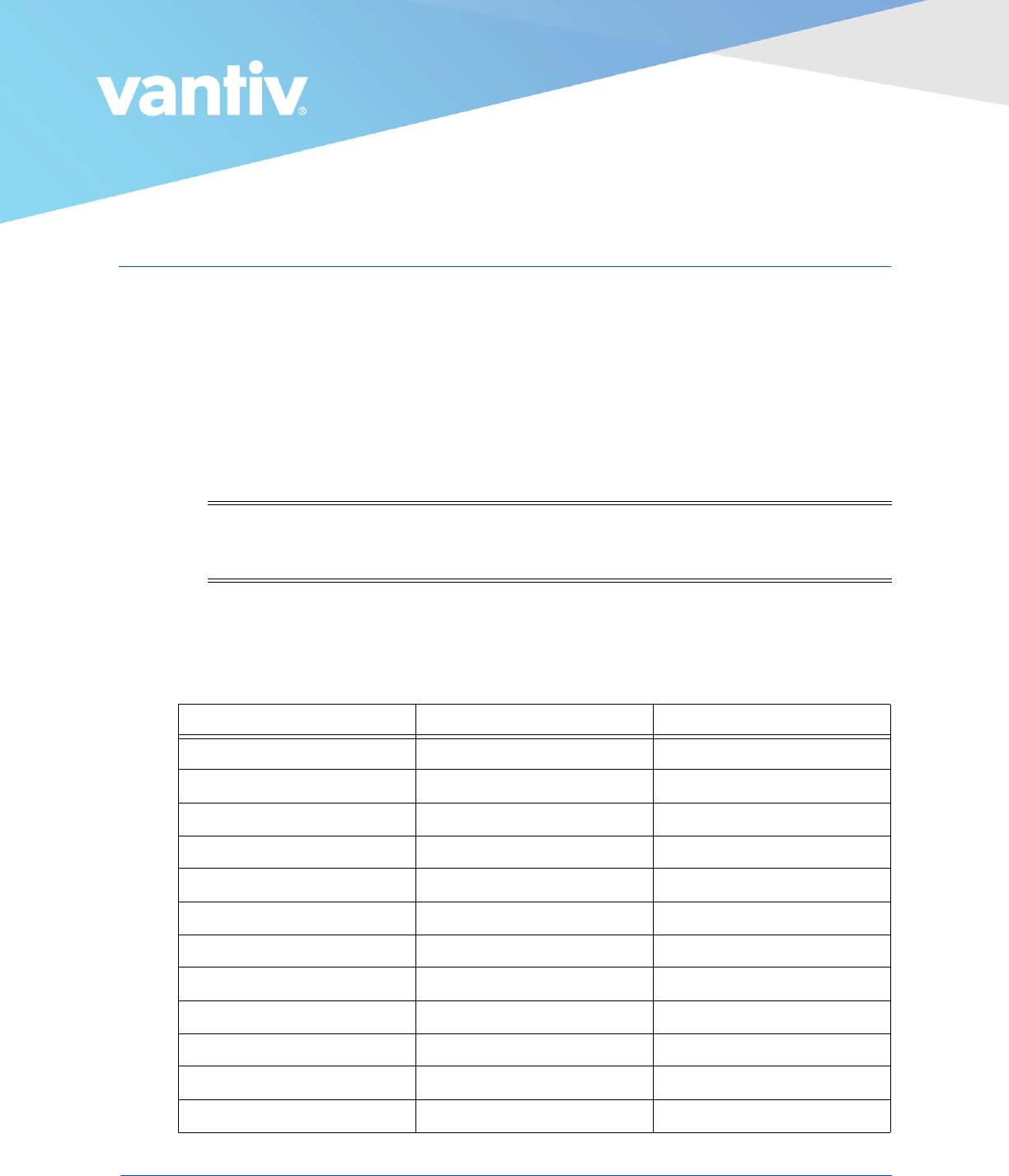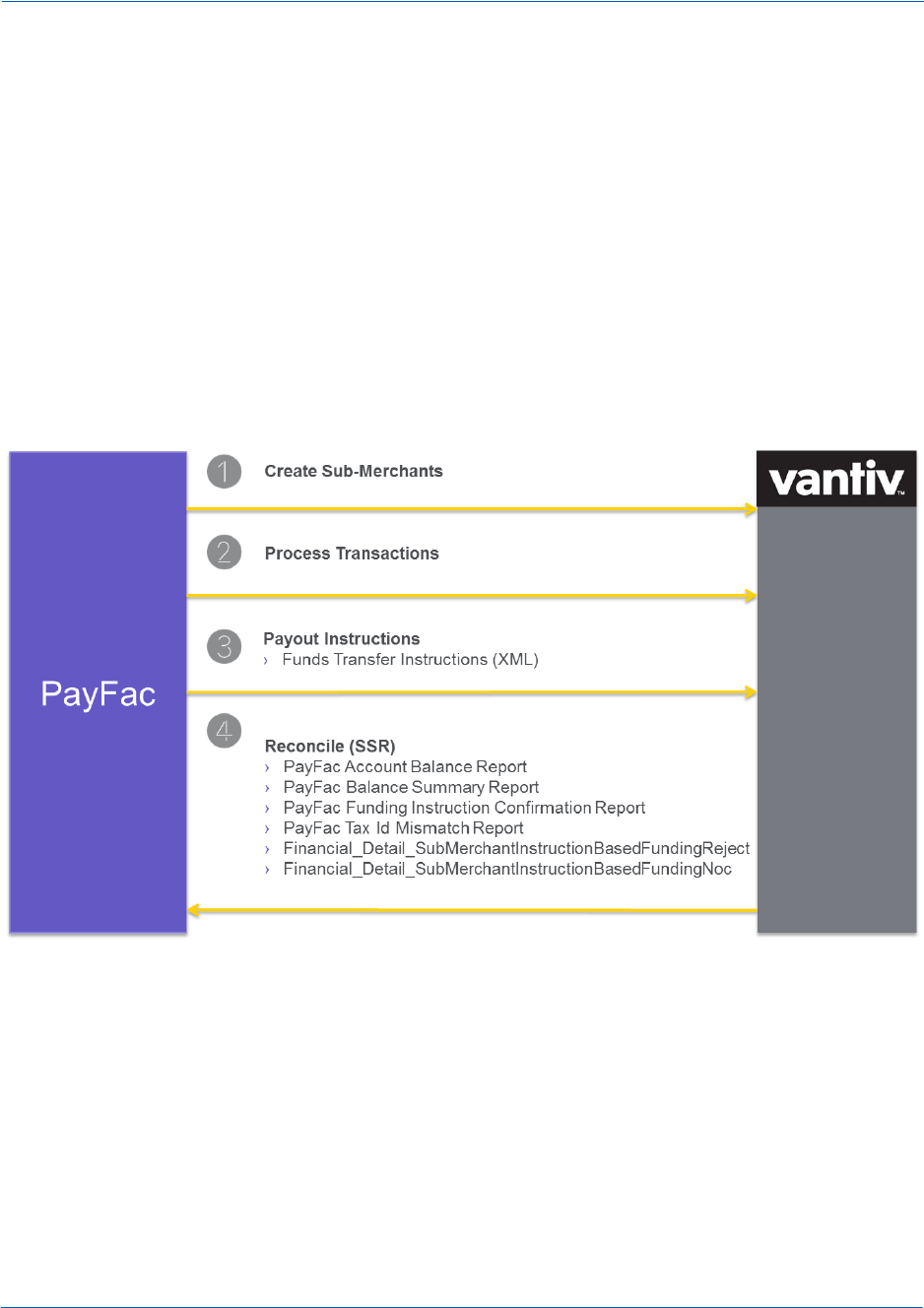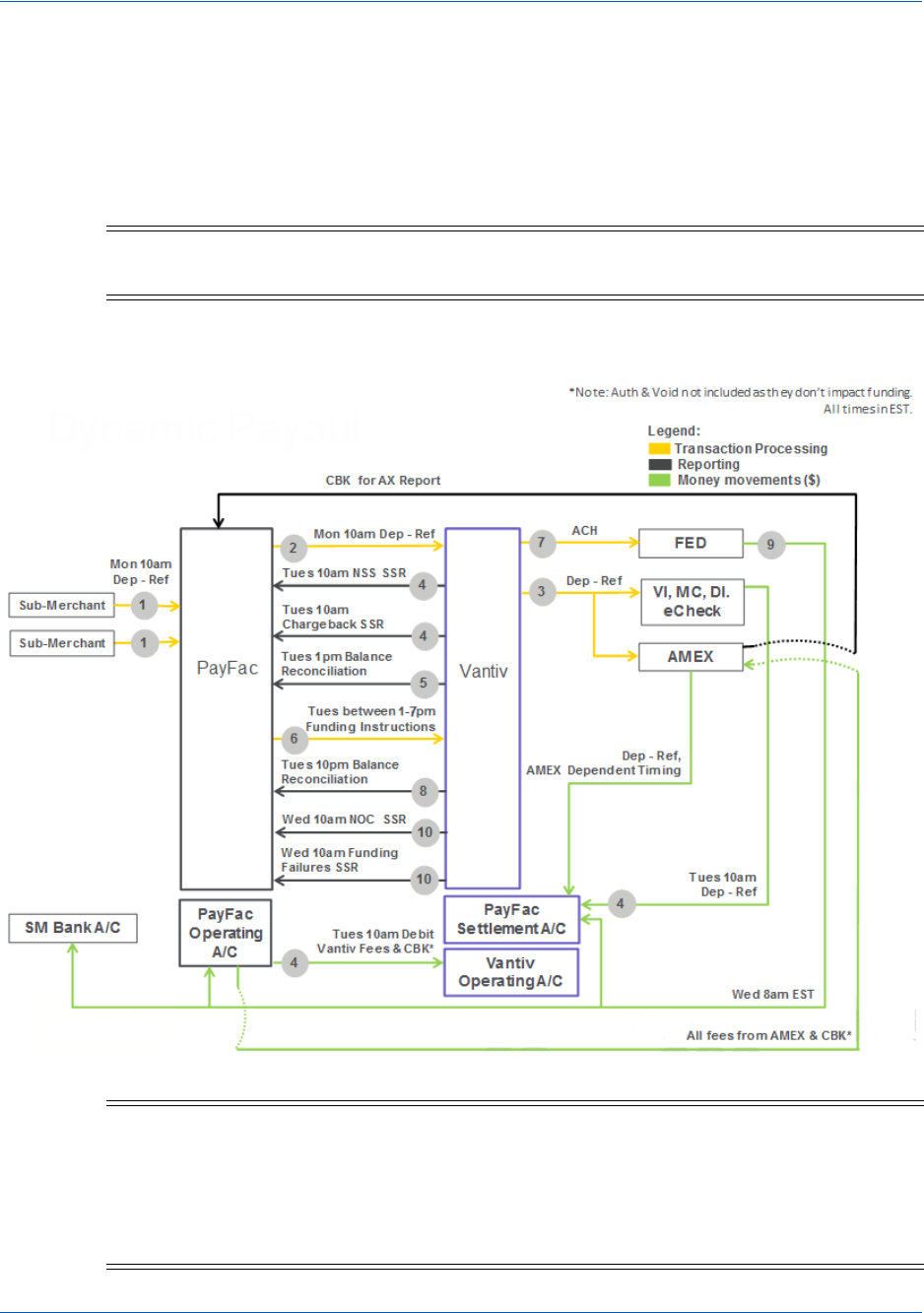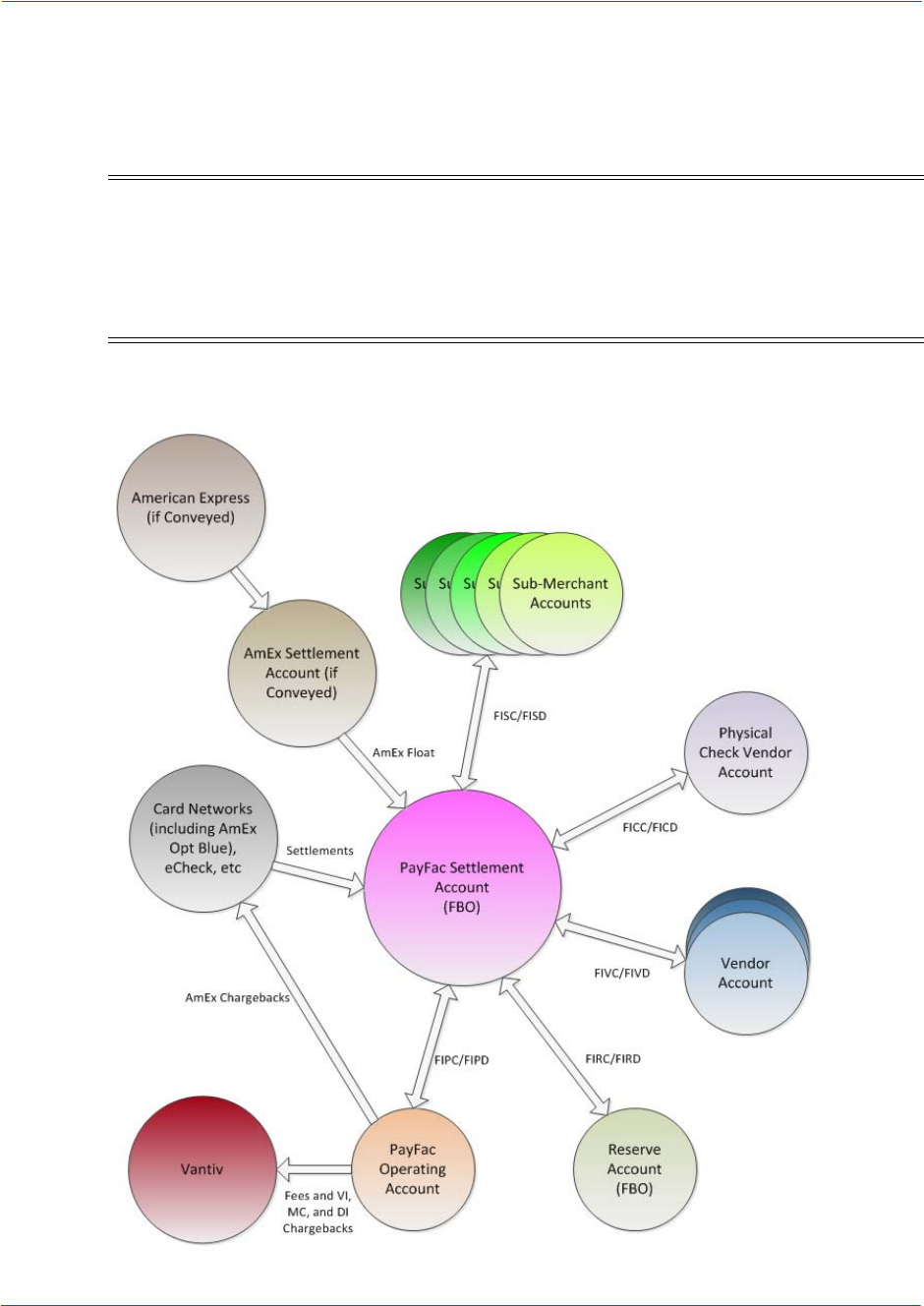Vantiv CnpAPI Reference Guide Cnp API API11.3 V1.8
User Manual: Pdf
Open the PDF directly: View PDF ![]() .
.
Page Count: 944 [warning: Documents this large are best viewed by clicking the View PDF Link!]
- cnpAPI Reference Guide
- About This Guide
- 1 Introduction
- 1.1 The cnpAPI Data Format
- 1.2 Batch Transaction Processing
- 1.3 Payment Integration Platform (cnpAPI SDKs)
- 1.4 Duplicate Transaction Detection
- 1.5 Coding for Report Groups
- 1.6 Recovery
- 1.7 Recurring Engine
- 1.8 Issuer Insights
- 1.9 Fraud Toolkit
- 1.9.1 Essential Tier
- 1.9.1.1 Prepaid Card Filtering
- 1.9.1.2 International BIN Filtering
- 1.9.1.3 Prior Chargeback Filtering
- 1.9.1.4 Security Code No-Match Filter
- 1.9.1.5 Card Velocity Filtering
- 1.9.1.6 Prior Fraud Advice Filtering
- 1.9.1.7 AVS Filter
- 1.9.1.8 Email Velocity Filter
- 1.9.1.9 Phone Velocity Filter
- 1.9.1.10 IP Velocity Filter
- 1.9.1.11 Device Velocity Filter
- 1.9.1.12 Application of Filters - Filtering Rules
- 1.9.2 Extended Tier
- 1.9.3 Premium Tier
- 1.9.4 Modifications to Your Web Page
- 1.9.1 Essential Tier
- 1.10 Tokenization Feature
- 1.11 eCheck Processing
- 1.12 SEPA Direct Debit
- 1.13 iDEAL, SOFORT, and Giropay
- 1.14 eCommerce Solution for Apple Pay™
- 1.15 eCommerce Solution for Android Pay™
- 1.16 Supported Transaction Types
- 1.16.1 Authorization Transaction
- 1.16.2 Authorization Reversal Transactions
- 1.16.3 Activate Transaction
- 1.16.4 Activate Reversal Transaction (Online Only)
- 1.16.5 Balance Inquiry Transaction
- 1.16.6 Cancel Subscription Transaction
- 1.16.7 Capture Transaction
- 1.16.8 Capture Given Auth Transaction
- 1.16.9 Create Plan Transaction
- 1.16.10 Credit Transaction
- 1.16.11 Deactivate Transaction
- 1.16.12 Deactivate Reversal Transaction (Online Only)
- 1.16.13 Deposit Reversal Transaction (Online Only)
- 1.16.14 eCheck Credit Transaction
- 1.16.15 eCheck Prenotification Credit Transaction
- 1.16.16 eCheck Prenotification Sale Transaction
- 1.16.17 eCheck Redeposit Transaction
- 1.16.18 eCheck Sales Transaction
- 1.16.19 eCheck Verification Transaction
- 1.16.20 eCheck Void Transaction (Online Only)
- 1.16.21 Force Capture Transaction
- 1.16.22 Gift Card Auth Reversal
- 1.16.23 Gift Card Capture
- 1.16.24 Gift Card Credit
- 1.16.25 Load Transaction
- 1.16.26 Load Reversal Transaction (Online Only)
- 1.16.27 Refund Reversal Transaction (Online Only)
- 1.16.28 Register Token Transaction
- 1.16.29 Sale Transaction
- 1.16.30 Status Query Transaction
- 1.16.31 Unload Transaction
- 1.16.32 Unload Reversal Transaction (Online Only)
- 1.16.33 Update Card Validation Number Transaction
- 1.16.34 Update Plan Transaction
- 1.16.35 Update Subscription Transaction
- 1.16.36 Void Transaction (Online Only)
- 1.16.37 Instruction-Based Dynamic Payout Transactions
- 2 Testing Your cnpAPI Transactions
- 2.1 Certification and Testing Environments
- 2.2 Overview of Testing
- 2.3 Transferring Files
- 2.4 Performing the Required Certification Tests
- 2.4.1 Testing Authorization (including Indicators), AVS Only, Capture, Credit, Sale, and Void Transactions
- 2.4.2 Testing Authorization Reversal Transactions
- 2.4.3 Testing eCheck Transactions
- 2.4.4 Testing Token Transactions
- 2.4.5 Testing Query Transactions
- 2.4.6 Testing Online Duplicate Transaction Processing
- 2.5 Performing the Optional Tests
- 2.5.1 Testing AVS and Card Validation
- 2.5.2 Testing Address Responses
- 2.5.3 Testing Advanced AVS Response Codes
- 2.5.4 Testing Response Reason Codes and Messages
- 2.5.5 Testing 3DS Responses
- 2.5.6 Testing the Prepaid Filtering Feature
- 2.5.7 Testing the International Card Filter Feature
- 2.5.8 Testing Security Code No-Match Filtering
- 2.5.9 Testing Advanced Fraud Tools
- 2.5.10 Testing Account Updater
- 2.5.11 Testing Tax Billing
- 2.5.12 Testing Convenience Fees
- 2.5.13 Testing the Recycling Engine
- 2.5.14 Testing Recurring Engine Transactions
- 2.5.15 Testing Gift Card Transactions
- 2.5.16 Testing MasterPass Transactions
- 2.5.17 Testing Apple Pay Transaction Processing
- 2.5.18 Testing Android Pay Transaction Processing
- 2.5.19 Testing checkoutId
- 2.5.20 Testing SEPA Direct Debit Transaction
- 2.5.21 Testing iDEAL Transactions
- 2.5.22 Testing Giropay Transactions
- 2.5.23 Testing SOFORT Transactions
- 2.5.24 Testing Transaction Volume Capacity
- 3 cnpAPI Transaction Examples
- 3.1 Overview of Online and Batch Processing Formats
- 3.2 Online Processing Format
- 3.3 Transaction Types and Examples
- 3.3.1 Authorization Transactions
- 3.3.2 Authorization Reversal Transactions
- 3.3.3 Activate Transactions
- 3.3.4 Activate Reversal Transactions (Online Only)
- 3.3.5 Balance Inquiry Transactions
- 3.3.6 Cancel Subscription Transactions
- 3.3.7 Capture Transactions
- 3.3.8 Capture Given Auth Transactions
- 3.3.9 Create Plan Transactions
- 3.3.10 Credit Transactions
- 3.3.11 Deactivate Transactions
- 3.3.12 Deactivate Reversal Transactions (Online Only)
- 3.3.13 Deposit Reversal Transactions (Online Only)
- 3.3.14 eCheck Credit Transactions
- 3.3.15 eCheck Prenotification Credit Transactions (Batch Only)
- 3.3.16 eCheck Prenotification Sale Transactions (Batch Only)
- 3.3.17 eCheck Redeposit Transactions
- 3.3.18 eCheck Sale Transactions
- 3.3.19 eCheck Verification Transactions
- 3.3.20 eCheck Void Transactions (Online Only)
- 3.3.21 Force Capture Transactions
- 3.3.22 Fraud Check Transaction
- 3.3.23 Gift Card Auth Reversal Transactions
- 3.3.24 Gift Card Capture Transactions
- 3.3.25 Gift Card Credit Transactions
- 3.3.26 Load Transactions
- 3.3.27 Load Reversal Transactions (Online Only)
- 3.3.28 Status Query Transactions (Online Only)
- 3.3.29 Refund Reversal Transactions (Online Only)
- 3.3.30 Register Token Transactions
- 3.3.31 RFR Transactions (Batch Only)
- 3.3.32 Sale Transactions
- 3.3.33 Unload Transactions
- 3.3.34 Unload Reversal Transactions (Online Only)
- 3.3.35 Update Plan Transactions
- 3.3.36 Update Subscription Transactions
- 3.3.37 Update Card Validation Number Transactions
- 3.3.38 Void Transactions (Online Only)
- 4 cnpAPI Elements
- 4.1 accNum
- 4.2 accountInfo
- 4.3 accountInformation
- 4.4 accountNumber
- 4.5 accountNumberLength
- 4.6 accountUpdate
- 4.7 accountUpdateFileRequestData
- 4.8 accountUpdater
- 4.9 accountUpdateResponse
- 4.10 accType
- 4.11 actionReason
- 4.12 activate
- 4.13 activateResponse
- 4.14 activateReversal
- 4.15 activateReversalResponse
- 4.16 active
- 4.17 addOnCode
- 4.18 addressIndicator
- 4.19 addressLine1, addressLine2, addressLine3
- 4.20 advancedAVSResult
- 4.21 advancedFraudChecks
- 4.22 advancedFraudResults
- 4.23 affiliate
- 4.24 affluence
- 4.25 allowPartialAuth
- 4.26 amexAggregatorData
- 4.27 amount
- 4.28 androidpayResponse
- 4.29 applepay
- 4.30 applepayResponse
- 4.31 applicationData
- 4.32 applicationExpirationDate
- 4.33 applicationPrimaryAccountNumber
- 4.34 approvedAmount
- 4.35 authAmount
- 4.36 authCode
- 4.37 authDate
- 4.38 authenticatedByMerchant
- 4.39 authentication
- 4.40 authenticationResult
- 4.41 authenticationTransactionId
- 4.42 authenticationValue
- 4.43 authInformation
- 4.44 authorization
- 4.45 authorizationResponse
- 4.46 authorizationSourcePlatform
- 4.47 authReversal
- 4.48 authReversalResponse
- 4.49 availableBalance
- 4.50 avsResult
- 4.51 balanceInquiry
- 4.52 balanceInquiryResponse
- 4.53 batchRequest
- 4.54 batchResponse
- 4.55 beginningBalance
- 4.56 billingDate
- 4.57 billMeLaterRequest
- 4.58 billMeLaterResponseData
- 4.59 billToAddress
- 4.60 bin
- 4.61 bmlMerchantId
- 4.62 bmlProductType
- 4.63 bypassVelocityCheck
- 4.64 campaign
- 4.65 cancelSubscription
- 4.66 cancelSubscriptionResponse
- 4.67 capability
- 4.68 capture
- 4.69 captureAmount
- 4.70 captureGivenAuth
- 4.71 captureGivenAuthResponse
- 4.72 captureResponse
- 4.73 card
- 4.74 cardAcceptorTaxId
- 4.75 cardholderAuthentication
- 4.76 cardholderId
- 4.77 cardholderName
- 4.78 cardOrToken
- 4.79 cardProductType
- 4.80 cardSuffix
- 4.81 cardValidationNum
- 4.82 cardValidationResult
- 4.83 cashBackAmount
- 4.84 catLevel
- 4.85 ccdPaymentInformation
- 4.86 chargeback
- 4.87 checkNum
- 4.88 checkoutId
- 4.89 city
- 4.90 clinicOtherAmount
- 4.91 code
- 4.92 commodityCode
- 4.93 companyName
- 4.94 country
- 4.95 createAddOn
- 4.96 createDiscount
- 4.97 createPlan
- 4.98 createPlanResponse
- 4.99 credit
- 4.100 creditAmount
- 4.101 creditLine
- 4.102 creditLitleTxnId
- 4.103 creditResponse
- 4.104 cryptogram
- 4.105 currencyCode
- 4.106 customAttribute1
- 4.107 customBilling
- 4.108 customIdentifier
- 4.109 customerInfo
- 4.110 customerIpAddress
- 4.111 customerReference
- 4.112 customerRegistrationDate
- 4.113 customerType
- 4.114 customerWorkTelephone
- 4.115 data
- 4.116 deactivate
- 4.117 deactivateResponse
- 4.118 deactivateReversal
- 4.119 deactivateReversalResponse
- 4.120 debtRepayment
- 4.121 deleteAddOn
- 4.122 deleteDiscount
- 4.123 deliveryType
- 4.124 dentalAmount
- 4.125 depositReversal
- 4.126 depositReversalResponse
- 4.127 description
- 4.128 descriptor
- 4.129 destinationCountryCode
- 4.130 destinationPostalCode
- 4.131 detailTax
- 4.132 deviceManufacturerIdentifier
- 4.133 deviceReputationScore
- 4.134 deviceReviewStatus
- 4.135 discountAmount
- 4.136 discountCode
- 4.137 dob
- 4.138 dutyAmount
- 4.139 echeck
- 4.140 eCheckAccountSuffix
- 4.141 echeckCredit
- 4.142 echeckCreditResponse
- 4.143 echeckForToken
- 4.144 echeckOrEcheckToken
- 4.145 echeckPreNoteCredit
- 4.146 echeckPreNoteCreditResponse
- 4.147 echeckPreNoteSale
- 4.148 echeckPreNoteSaleResponse
- 4.149 echeckRedeposit
- 4.150 echeckRedepositResponse
- 4.151 echeckSale
- 4.152 echeckSalesResponse
- 4.153 echeckToken
- 4.154 echeckVerification
- 4.155 echeckVerificationResponse
- 4.156 echeckVoid
- 4.157 echeckVoidResponse
- 4.158 eciIndicator
- 4.159 email
- 4.160 employerName
- 4.161 encryptedTrack
- 4.162 endDate
- 4.163 endingBalance
- 4.164 endpoint
- 4.165 enhancedAuthResponse
- 4.166 enhancedData
- 4.167 entryMode
- 4.168 ephemeralPublicKey
- 4.169 expDate
- 4.170 expMonth
- 4.171 expYear
- 4.172 extendedCardResponse
- 4.173 fastAccessFunding
- 4.174 fastAccessFundingResponse
- 4.175 fieldValue
- 4.176 filtering
- 4.177 finalPayment
- 4.178 firstName
- 4.179 forceCapture
- 4.180 forceCaptureResponse
- 4.181 formatId
- 4.182 fraudCheck
- 4.183 fraudCheckResponse
- 4.184 fraudFilterOverride
- 4.185 fraudResult
- 4.186 fundingInstructionVoid
- 4.187 fundingInstructionVoidResponse
- 4.188 fundingSource
- 4.189 fundingSubmerchantId
- 4.190 fundsTransferId
- 4.191 giftCardAuthReversal
- 4.192 giftCardAuthReversalResponse
- 4.193 giftCardBin
- 4.194 giftCardCapture
- 4.195 giftCardCaptureResponse
- 4.196 giftCardCredit
- 4.197 giftCardCreditResponse
- 4.198 giftCardResponse
- 4.199 giropay
- 4.200 giropayResponse
- 4.201 header
- 4.202 healthcareAmounts
- 4.203 healthcareIIAS
- 4.204 iban
- 4.205 ideal
- 4.206 idealResponse
- 4.207 IIASFlag
- 4.208 incomeAmount
- 4.209 incomeCurrency
- 4.210 international
- 4.211 intervalType
- 4.212 invoiceReferenceNumber
- 4.213 issuerCountry
- 4.214 itemCategoryCode
- 4.215 itemDescription
- 4.216 itemDiscountAmount
- 4.217 itemSequenceNumber
- 4.218 ksn
- 4.219 lastName
- 4.220 lineItemData
- 4.221 lineItemTotal
- 4.222 lineItemTotalWithTax
- 4.223 litleInternalRecurringRequest
- 4.224 litleOnlineRequest
- 4.225 litleOnlineResponse
- 4.226 litleRequest
- 4.227 litleResponse
- 4.228 litleSessionId
- 4.229 litleToken
- 4.230 litleTxnId
- 4.231 load
- 4.232 loadResponse
- 4.233 loadReversal
- 4.234 loadReversalResponse
- 4.235 mandateProvider
- 4.236 mandateReference
- 4.237 mandateSignatureDate
- 4.238 mandateURL
- 4.239 matchCount
- 4.240 merchantData
- 4.241 merchantGroupingId
- 4.242 merchantId
- 4.243 message
- 4.244 middleInitial
- 4.245 mpos
- 4.246 name
- 4.247 networkField
- 4.248 networkResponse
- 4.249 networkSubField
- 4.250 networkTransactionId
- 4.251 newAccountInfo
- 4.252 newCardInfo
- 4.253 newCardTokenInfo
- 4.254 newTokenInfo
- 4.255 nextRecycleTime
- 4.256 number
- 4.257 numberOfPayments
- 4.258 onlinePaymentCryptogram
- 4.259 orderDate
- 4.260 orderId
- 4.261 orderSource
- 4.262 originalAccountInfo
- 4.263 origAccountNumber
- 4.264 origActionType
- 4.265 origId
- 4.266 originalAmount
- 4.267 originalCard
- 4.268 originalCardInfo
- 4.269 originalCardTokenInfo
- 4.270 originalNetworkTransactionId
- 4.271 originalRefCode
- 4.272 originalSequenceNumber
- 4.273 originalSystemTraceId
- 4.274 originalToken
- 4.275 originalTokenInfo
- 4.276 originalTransactionAmount
- 4.277 originalTxnTime
- 4.278 origLitleTxnId
- 4.279 origOrderId
- 4.280 password
- 4.281 payerId
- 4.282 payFacCredit
- 4.283 payFacCreditResponse
- 4.284 payFacDebit
- 4.285 payFacDebitResponse
- 4.286 paymentDataType
- 4.287 paymentPurpose
- 4.288 paypage
- 4.289 paypageRegistrationId
- 4.290 paypal
- 4.291 payPalNotes
- 4.292 payPalOrderComplete
- 4.293 phone
- 4.294 physicalCheckCredit
- 4.295 physicalCheckCreditResponse
- 4.296 physicalCheckDebit
- 4.297 physicalCheckDebitResponse
- 4.298 pin
- 4.299 planCode
- 4.300 pos
- 4.301 postDate
- 4.302 postDay
- 4.303 preapprovalNumber
- 4.304 preferredLanguage
- 4.305 prepaid
- 4.306 prepaidCardType
- 4.307 processingInstructions
- 4.308 processingType
- 4.309 productCode
- 4.310 publicKeyHash
- 4.311 quantity
- 4.312 queryTransaction
- 4.313 queryTransactionResponse
- 4.314 queryTransactionUnavailableResponse
- 4.315 recurringRequest
- 4.316 recurringResponse
- 4.317 recurringTxnId
- 4.318 recycleAdvice
- 4.319 recycleAdviceEnd
- 4.320 recycleBy
- 4.321 recycleEngineActive
- 4.322 recycleId
- 4.323 recycling
- 4.324 recyclingRequest
- 4.325 redirectToken
- 4.326 redirectUrl
- 4.327 refCode
- 4.328 refundReversal
- 4.329 refundReversalResponse
- 4.330 registerTokenRequest
- 4.331 registerTokenResponse
- 4.332 reloadable
- 4.333 reserveCredit
- 4.334 reserveCreditResponse
- 4.335 reserveDebit
- 4.336 reserveDebitResponse
- 4.337 residenceStatus
- 4.338 response
- 4.339 responseCode
- 4.340 responseMessage
- 4.341 responseTime
- 4.342 results_Max10
- 4.343 RFRRequest
- 4.344 RFRResponse
- 4.345 routingNum
- 4.346 RxAmount
- 4.347 sale
- 4.348 saleResponse
- 4.349 salesTax
- 4.350 secondaryAmount
- 4.351 sellerId
- 4.352 sellerMerchantCategoryCode
- 4.353 sepaDirectDebit
- 4.354 sepaDirectDebitResponse
- 4.355 sequenceNumber
- 4.356 sequenceType
- 4.357 shipFromPostalCode
- 4.358 shippingAmount
- 4.359 shipToAddress
- 4.360 signature
- 4.361 sofort
- 4.362 sofortResponse
- 4.363 ssn
- 4.364 startDate
- 4.365 state
- 4.366 submerchantCredit
- 4.367 submerchantCreditResponse
- 4.368 submerchantDebit
- 4.369 submerchantDebitResponse
- 4.370 submerchantName
- 4.371 subscription
- 4.372 subscriptionId
- 4.373 surchargeAmount
- 4.374 systemTraceId
- 4.375 taxAmount
- 4.376 taxExempt
- 4.377 taxIncludedInTotal
- 4.378 taxRate
- 4.379 taxType
- 4.380 taxTypeIdentifier
- 4.381 terminalId
- 4.382 termsAndConditions
- 4.383 threatMetrixSessionId
- 4.384 token
- 4.385 tokenMessage
- 4.386 tokenResponse
- 4.387 tokenResponseCode
- 4.388 totalHealthcareAmount
- 4.389 track
- 4.390 track1Status
- 4.391 track2Status
- 4.392 transactionAmount
- 4.393 transactionId
- 4.394 trialIntervalType
- 4.395 trialNumberOfIntervals
- 4.396 triggeredRule
- 4.397 txnTime
- 4.398 type
- 4.399 unitCost
- 4.400 unitOfMeasure
- 4.401 unload
- 4.402 unloadResponse
- 4.403 unloadReversal
- 4.404 unloadReversalResponse
- 4.405 updateAddOn
- 4.406 updatedCard
- 4.407 updateCardValidationNumOnToken
- 4.408 updateCardValidationNumOnTokenResponse
- 4.409 updateDiscount
- 4.410 updatePlan
- 4.411 updatePlanResponse
- 4.412 updateSubscription
- 4.413 updateSubscriptionResponse
- 4.414 updatedToken
- 4.415 url
- 4.416 user
- 4.417 vendorCredit
- 4.418 vendorCreditResponse
- 4.419 vendorDebit
- 4.420 vendorDebitResponse
- 4.421 vendorName
- 4.422 verificationCode
- 4.423 verify
- 4.424 version
- 4.425 virtualAccountNumber
- 4.426 virtualAuthenticationKeyData
- 4.427 virtualAuthenticationKeyPresenceIndicator
- 4.428 virtualGiftCard
- 4.429 virtualGiftCardBin
- 4.430 virtualGiftCardResponse
- 4.431 visionAmount
- 4.432 void
- 4.433 voidResponse
- 4.434 wallet
- 4.435 walletSourceType
- 4.436 walletSourceTypeId
- 4.437 yearsAtEmployer
- 4.438 yearsAtResidence
- 4.439 zip
- A Payment Transaction Response Codes
- A.1 Payment Transaction Response Codes
- A.2 3DS Authentication Result Codes
- A.3 AVS Response Codes
- A.4 AAVS Response Codes
- A.5 Card Validation Response Codes
- A.6 Advanced Fraud Tools Triggered Rules
- A.7 XML Validation Error Messages
- A.8 Additional Response Header Error Messages
- A.9 ACH Return Reason Codes
- A.10 ACH NoC Change Codes
- A.11 Canadian eCheck Return Codes
- B Credit Card Number Formats
- C Test Card Numbers
- D PayFac™ Dynamic Payout

cnpAPI Reference Guide
November 2017
cnpAPI Release: 11.3
Document Version: 1.8
Vantiv cnpAPI Reference Guide Document Version: 1.8
All information whether text or graphics, contained in this manual is confidential and proprietary information of Vantiv, LLC and is
provided to you solely for the purpose of assisting you in using a Vantiv, LLC product. All such information is protected by copyright laws
and international treaties. No part of this manual may be reproduced or transmitted in any form or by any means, electronic, mechanical or
otherwise for any purpose without the express written permission of Vantiv, LLC. The possession, viewing, or use of the information
contained in this manual does not transfer any intellectual property rights or grant a license to use this information or any software
application referred to herein for any purpose other than that for which it was provided. Information in this manual is presented "as is" and
neither Vantiv, LLC or any other party assumes responsibility for typographical errors, technical errors, or other inaccuracies contained in
this document. This manual is subject to change without notice and does not represent a commitment on the part Vantiv, LLC or any other
party. Vantiv, LLC does not warrant that the information contained herein is accurate or complete.
All trademarks are the property of their respective owners and all parties herein have consented to their trademarks appearing in this
manual. Any use by you of the trademarks included herein must have express written permission of the respective owner.
Copyright © 2003-2017, Vantiv, LLC - ALL RIGHTS RESERVED.

Document Version: 1.8 — cnpAPI Release: 11.3 iii
CONTENTS
© 2017 Vantiv, LLC - All Rights Reserved.
About This Guide
Intended Audience........................................................................................................ xxiii
Revision History............................................................................................................ xxiii
Document Structure...................................................................................................... xxvi
Documentation Set ....................................................................................................... xxvi
Typographical Conventions .........................................................................................xxviii
Contact Information....................................................................................................... xxix
Chapter 1 Introduction
The cnpAPI Data Format .................................................................................................. 2
Communications Protocols ......................................................................................... 2
General XML Coding Requirements ........................................................................... 3
Other XML Resources................................................................................................. 4
Batch Transaction Processing .......................................................................................... 5
Recommended Session File Size ............................................................................... 5
Payment Integration Platform (cnpAPI SDKs) .................................................................. 6
Duplicate Transaction Detection....................................................................................... 7
Batch Duplicate Checking........................................................................................... 7
Batch Dupe Checking for Dynamic Payout Funding Instructions.......................... 8
Online Duplicate Checking.......................................................................................... 8
Coding for Report Groups............................................................................................... 10
Additional/Alternate Methods of Tagging Transactions ............................................ 11
Recovery......................................................................................................................... 12
Authorization/Sale Recycling .................................................................................... 12
Recycling Engine ............................................................................................... 12
Account Updater Service ......................................................................................... 14
Match Back ......................................................................................................... 15
Merchant Requirements...................................................................................... 16
Account Updater Features .................................................................................. 17
Recurring Engine ........................................................................................................... 18
Payment Plans.......................................................................................................... 18
Subscriptions............................................................................................................. 19
Add Ons and Discounts ...................................................................................... 21
Recurring Reports..................................................................................................... 21
Transaction Types and Uses .................................................................................... 22
Issuer Insights.................................................................................................................24
Issuer Insights Secure Scheduled Report................................................................. 24
Real Time Indicators ................................................................................................. 24

cnpAPI Reference Guide Contents
iv Document Version: 1.8 — cnpAPI Release: 11.3
© 2017 Vantiv, LLC - All Rights Reserved.
Prepaid Indicator................................................................................................. 24
Affluence Indicator .............................................................................................. 25
Issuer Country Indicator...................................................................................... 26
Cardholder Type Indicator................................................................................... 26
Extended Network Data ............................................................................................ 26
Insights Analytics Dashboard.................................................................................... 28
Fraud Toolkit ..................................................................................................................29
Essential Tier ............................................................................................................ 30
Prepaid Card Filtering ........................................................................................ 30
International BIN Filtering ................................................................................... 31
Prior Chargeback Filtering ................................................................................. 31
Security Code No-Match Filter ........................................................................... 31
Card Velocity Filtering ........................................................................................ 32
Prior Fraud Advice Filtering ................................................................................ 32
AVS Filter ........................................................................................................... 32
Email Velocity Filter............................................................................................. 33
Phone Velocity Filter ........................................................................................... 33
IP Velocity Filter .................................................................................................. 33
Device Velocity Filter........................................................................................... 34
Application of Filters - Filtering Rules ................................................................. 34
Extended Tier............................................................................................................ 35
Premium Tier............................................................................................................. 36
Modifications to Your Web Page............................................................................... 36
cnpAPI Transactions........................................................................................... 37
Information Only Option ...................................................................................... 39
Fraud Check Transactions ................................................................................. 39
Tokenization Feature ...................................................................................................... 40
How Tokenization Works .......................................................................................... 41
Token Formats.......................................................................................................... 42
Obtaining Tokens...................................................................................................... 42
Bulk Token Registration...................................................................................... 43
Supported Token Transactions................................................................................. 44
Compliance with Visa Best Practices for Tokenization ............................................. 45
eCheck Processing......................................................................................................... 46
Validation Feature..................................................................................................... 46
Verification Feature................................................................................................... 46
Required Contents of Decline Notice.................................................................. 47
Automatic Notice of Change (NoC) Updates ............................................................ 48
Auto Redeposit Feature ............................................................................................ 48
eCheck Prenotification .............................................................................................. 49
SEPA Direct Debit .......................................................................................................... 51

cnpAPI Reference Guide Contents
Document Version: 1.8 — cnpAPI Release: 11.3 v
© 2017 Vantiv, LLC - All Rights Reserved.
SEPA Direct Debit - Vantiv Supplied Mandate.......................................................... 51
SEPA Direct Debit - Merchant Supplied Mandate..................................................... 54
iDEAL, SOFORT, and Giropay ....................................................................................... 57
eCommerce Solution for Apple Pay™ ............................................................................ 60
Overview of Apple Pay Operation............................................................................. 60
Vantiv Decryption of Apple Pay PKPaymentToken................................................... 61
Using the Browser JavaScript API for Apple Pay on the Web ............................ 61
Using the Vantiv Mobile API for Apple Pay......................................................... 63
Submitting the Apple Pay PKPaymentToken in a cnpAPI Message................... 64
Merchant Decryption of Apple Pay PKPaymentToken........................................ 65
Recurring Payments with Apple Pay......................................................................... 67
eCommerce Solution for Android Pay™......................................................................... 68
Android Pay using eProtect....................................................................................... 68
Merchant Decryption Method.................................................................................... 71
Recurring Payments with Android Pay...................................................................... 74
Supported Transaction Types......................................................................................... 75
Authorization Transaction ......................................................................................... 75
AVS Only Transaction......................................................................................... 76
Authorization Reversal Transactions ........................................................................ 76
Notes on the Use of Authorization Reversal Transactions.................................. 77
Using Authorization Reversal to Halt Recycling Engine...................................... 78
Activate Transaction.................................................................................................. 78
Activate Reversal Transaction (Online Only) ............................................................ 79
Balance Inquiry Transaction...................................................................................... 79
Cancel Subscription Transaction .............................................................................. 79
Capture Transaction.................................................................................................. 79
Capture Given Auth Transaction............................................................................... 79
Create Plan Transaction ........................................................................................... 80
Credit Transaction..................................................................................................... 80
Deactivate Transaction ............................................................................................. 81
Deactivate Reversal Transaction (Online Only)........................................................ 81
Deposit Reversal Transaction (Online Only)............................................................. 81
eCheck Credit Transaction........................................................................................ 81
eCheck Prenotification Credit Transaction................................................................ 81
eCheck Prenotification Sale Transaction .................................................................. 82
eCheck Redeposit Transaction................................................................................. 82
eCheck Sales Transaction ........................................................................................ 82
eCheck Verification Transaction ............................................................................... 82
eCheck Void Transaction (Online Only).................................................................... 82
Force Capture Transaction ....................................................................................... 83
Gift Card Auth Reversal ............................................................................................ 83

cnpAPI Reference Guide Contents
vi Document Version: 1.8 — cnpAPI Release: 11.3
© 2017 Vantiv, LLC - All Rights Reserved.
Gift Card Capture...................................................................................................... 83
Gift Card Credit ......................................................................................................... 83
Load Transaction ...................................................................................................... 83
Load Reversal Transaction (Online Only)................................................................. 83
Refund Reversal Transaction (Online Only) ............................................................. 84
Register Token Transaction...................................................................................... 84
Sale Transaction ....................................................................................................... 84
Status Query Transaction ........................................................................................ 84
Unload Transaction................................................................................................... 85
Unload Reversal Transaction (Online Only).............................................................. 85
Update Card Validation Number Transaction ........................................................... 85
Update Plan Transaction........................................................................................... 85
Update Subscription Transaction.............................................................................. 85
Void Transaction (Online Only)................................................................................. 86
Using Void to Halt Recycling Engine................................................................... 86
Instruction-Based Dynamic Payout Transactions .................................................... 86
Chapter 2 Testing Your cnpAPI Transactions
Certification and Testing Environments .......................................................................... 90
Sandbox Environment............................................................................................... 90
Pre-Live Environment................................................................................................ 90
Pre-Live Environment Limitations and Maintenance Schedules......................... 91
Post-Live Environment.............................................................................................. 91
Post-Live Environment Limitations and Maintenance Schedules ....................... 91
Overview of Testing ........................................................................................................ 93
Planning for Certification Testing .............................................................................. 93
Required Certification Testing................................................................................... 94
Optional Testing........................................................................................................ 94
System Doctor........................................................................................................... 94
Transferring Files............................................................................................................ 97
Transferring Session Files ........................................................................................ 97
Submitting a Session File for Processing............................................................ 97
Retrieving Processed Session Files.................................................................... 98
Transferring Online Files........................................................................................... 98
ASP Programming Example ............................................................................... 99
Java Programming Example ............................................................................. 100
Notes on Timeout Settings................................................................................ 101
Notes on Persistent Connections...................................................................... 101
Helpful Web Sites.............................................................................................. 102
Performing the Required Certification Tests ................................................................. 103

cnpAPI Reference Guide Contents
Document Version: 1.8 — cnpAPI Release: 11.3 vii
© 2017 Vantiv, LLC - All Rights Reserved.
Testing Authorization (including Indicators), AVS Only, Capture, Credit, Sale, and Void
Transactions............................................................................................................ 103
Testing Authorization Reversal Transactions.......................................................... 116
Testing eCheck Transactions.................................................................................. 119
Testing Token Transactions.................................................................................... 126
Testing Query Transactions.................................................................................... 131
Testing Online Duplicate Transaction Processing .................................................. 132
Performing the Optional Tests ...................................................................................... 134
Testing AVS and Card Validation............................................................................ 135
Testing Address Responses ................................................................................... 136
Testing Advanced AVS Response Codes............................................................... 138
Testing Response Reason Codes and Messages.................................................. 139
Testing 3DS Responses ......................................................................................... 142
Testing the Prepaid Filtering Feature...................................................................... 144
Testing the International Card Filter Feature .......................................................... 146
Testing Security Code No-Match Filtering .............................................................. 147
Testing Advanced Fraud Tools ............................................................................... 149
Testing Account Updater......................................................................................... 151
Testing Account Updater Extended Response Codes...................................... 152
Testing Account Updater for Tokenized Merchants.......................................... 153
Testing Tax Billing................................................................................................... 153
Testing Convenience Fees ..................................................................................... 154
Testing the Recycling Engine.................................................................................. 156
Testing Recycling Engine Cancellation............................................................. 164
Testing Recurring Engine Transactions.................................................................. 166
Testing Gift Card Transactions ............................................................................... 179
Testing MasterPass Transactions........................................................................... 189
Testing Apple Pay Transaction Processing ............................................................ 189
Testing the Submission of the Decrypted PKPaymentToken in cnpAPI........... 190
Testing the Submission of PKPaymentToken in cnpAPI .................................. 190
Testing Android Pay Transaction Processing ......................................................... 192
Testing Android Pay using eProtect.................................................................. 192
Testing checkoutId.................................................................................................. 193
Testing SEPA Direct Debit Transaction .................................................................. 195
Testing iDEAL Transactions.................................................................................... 197
Testing Giropay Transactions ................................................................................. 198
Testing SOFORT Transactions............................................................................... 199
Testing Transaction Volume Capacity .................................................................... 200
Chapter 3 cnpAPI Transaction Examples
Overview of Online and Batch Processing Formats ..................................................... 202

cnpAPI Reference Guide Contents
viii Document Version: 1.8 — cnpAPI Release: 11.3
© 2017 Vantiv, LLC - All Rights Reserved.
Batch Process Format............................................................................................. 202
Supported Communication Protocols................................................................ 203
Batch Processing Request Format ................................................................... 203
Batch Processing Response Format................................................................. 203
Online Processing Format ............................................................................................ 204
Supported Communication Protocols...................................................................... 205
Online Processing Request Format ........................................................................ 205
Online Processing Response Format ..................................................................... 205
Transaction Types and Examples................................................................................. 206
Authorization Transactions...................................................................................... 208
Authorization Request Structure ....................................................................... 208
Authorization Response Structure .................................................................... 215
Authorization Reversal Transactions ...................................................................... 220
Authorization Reversal Requests...................................................................... 220
Authorization Reversal Responses................................................................... 222
Activate Transactions.............................................................................................. 223
Activate Request............................................................................................... 223
Activate Response ............................................................................................ 224
Activate Reversal Transactions (Online Only) ........................................................ 226
Activate Reversal Request................................................................................ 226
Activate Reversal Response ............................................................................. 227
Balance Inquiry Transactions.................................................................................. 228
Balance Inquiry Request................................................................................... 228
Balance Inquiry Response ................................................................................ 229
Cancel Subscription Transactions........................................................................... 230
Cancel Subscription Request............................................................................ 230
Cancel Subscription Response......................................................................... 231
Capture Transactions.............................................................................................. 231
Capture Request............................................................................................... 232
Capture Response ............................................................................................ 239
Capture Given Auth Transactions........................................................................... 240
Capture Given Auth Request ............................................................................ 240
Capture Given Auth Response ......................................................................... 244
Create Plan Transactions........................................................................................ 246
Create Plan Request......................................................................................... 246
Create Plan Response...................................................................................... 247
Credit Transactions................................................................................................. 247
Credit Request for a Vantiv Processed Transaction ......................................... 248
Credit Request for a Non-Vantiv Processed Transaction ................................. 252
Credit Response ............................................................................................... 256
Deactivate Transactions.......................................................................................... 257

cnpAPI Reference Guide Contents
Document Version: 1.8 — cnpAPI Release: 11.3 ix
© 2017 Vantiv, LLC - All Rights Reserved.
Deactivate Request........................................................................................... 257
Deactivate Response ........................................................................................ 258
Deactivate Reversal Transactions (Online Only) .................................................... 259
Deactivate Reversal Request............................................................................ 259
Deactivate Reversal Response......................................................................... 260
Deposit Reversal Transactions (Online Only)......................................................... 261
Deposit Reversal Request ................................................................................ 261
Deposit Reversal Response.............................................................................. 262
eCheck Credit Transactions.................................................................................... 263
eCheck Credit Request Against a Vantiv Transaction ...................................... 263
eCheck Credit Request for a Non-Vantiv Processed Sale................................ 265
eCheck Credit Response .................................................................................. 266
eCheck Prenotification Credit Transactions (Batch Only)....................................... 266
eCheck Prenotification Credit Request ............................................................. 267
eCheck Prenotification Credit Response .......................................................... 268
eCheck Prenotification Sale Transactions (Batch Only) ......................................... 269
eCheck Prenotification Sale Request................................................................ 269
eCheck Prenotification Sale Response............................................................. 270
eCheck Redeposit Transactions ............................................................................. 271
eCheck Redeposit Request .............................................................................. 271
eCheck Redeposit Response............................................................................ 273
eCheck Sale Transactions ...................................................................................... 274
eCheck Sale Request ....................................................................................... 274
eCheck Sale Response..................................................................................... 276
eCheck Verification Transactions............................................................................ 277
eCheck Verification Request............................................................................. 278
eCheck Verification Response.......................................................................... 280
eCheck Void Transactions (Online Only)................................................................ 281
eCheck Void Request ....................................................................................... 281
eCheck Void Response..................................................................................... 282
Force Capture Transactions.................................................................................... 283
Force Capture Request..................................................................................... 283
Force Capture Response.................................................................................. 286
Fraud Check Transaction........................................................................................ 288
Fraud Check Request ....................................................................................... 288
Fraud Check Response .................................................................................... 289
Gift Card Auth Reversal Transactions..................................................................... 290
Gift Card Auth Reversal Request...................................................................... 290
Gift Card Auth Reversal Response................................................................... 291
Gift Card Capture Transactions .............................................................................. 292
Gift Card Capture Request................................................................................ 292

cnpAPI Reference Guide Contents
xDocument Version: 1.8 — cnpAPI Release: 11.3
© 2017 Vantiv, LLC - All Rights Reserved.
Gift Card Capture Response............................................................................. 293
Gift Card Credit Transactions.................................................................................. 294
Gift Card Credit Request................................................................................... 294
Gift Card Credit Response................................................................................ 295
Load Transactions................................................................................................... 296
Load Request.................................................................................................... 296
Load Response................................................................................................. 297
Load Reversal Transactions (Online Only) ............................................................. 298
Load Reversal Request..................................................................................... 298
Load Reversal Response.................................................................................. 299
Status Query Transactions (Online Only) .............................................................. 300
Query Transaction Request .............................................................................. 301
Query Transaction Response ........................................................................... 301
Refund Reversal Transactions (Online Only).......................................................... 304
Refund Reversal Request................................................................................. 305
Refund Reversal Response .............................................................................. 306
Register Token Transactions .................................................................................. 307
Register Token Request ................................................................................... 307
Register Token Response................................................................................. 310
RFR Transactions (Batch Only) .............................................................................. 312
RFR Request .................................................................................................... 312
RFR Response.................................................................................................. 313
Sale Transactions ................................................................................................... 314
Sale Request..................................................................................................... 314
Sale Response.................................................................................................. 319
Unload Transactions ............................................................................................... 325
Unload Request ................................................................................................ 325
Unload Response.............................................................................................. 326
Unload Reversal Transactions (Online Only).......................................................... 326
Unload Reversal Request ................................................................................. 327
Unload Reversal Response .............................................................................. 328
Update Plan Transactions....................................................................................... 329
Update Plan Request........................................................................................ 329
Update Plan Response ..................................................................................... 329
Update Subscription Transactions .......................................................................... 330
Update Subscription Request ........................................................................... 330
Update Subscription Response......................................................................... 332
Update Card Validation Number Transactions........................................................ 332
Update Card Validation Number Request......................................................... 333
Update Card Validation Number Response ...................................................... 333
Void Transactions (Online Only) ............................................................................. 334

cnpAPI Reference Guide Contents
Document Version: 1.8 — cnpAPI Release: 11.3 xi
© 2017 Vantiv, LLC - All Rights Reserved.
Void Request..................................................................................................... 335
Void Response.................................................................................................. 335
Chapter 4 cnpAPI Elements
accNum ........................................................................................................................ 338
accountInfo .................................................................................................................. 339
accountInformation ...................................................................................................... 340
accountNumber ............................................................................................................ 341
accountNumberLength ................................................................................................. 342
accountUpdate ............................................................................................................. 343
accountUpdateFileRequestData .................................................................................. 344
accountUpdater ............................................................................................................ 345
accountUpdateResponse ............................................................................................. 349
accType ........................................................................................................................ 350
actionReason ............................................................................................................... 351
activate ......................................................................................................................... 352
activateResponse ........................................................................................................ 353
activateReversal .......................................................................................................... 354
activateReversalResponse .......................................................................................... 355
active ............................................................................................................................ 356
addOnCode .................................................................................................................. 357
addressIndicator ........................................................................................................... 358
addressLine1, addressLine2, addressLine3 ................................................................. 359
advancedAVSResult ..................................................................................................... 360
advancedFraudChecks ................................................................................................ 361
advancedFraudResults ................................................................................................ 362
affiliate........................................................................................................................... 363
affluence .......................................................................................................................364
allowPartialAuth ............................................................................................................ 365
amexAggregatorData.................................................................................................... 366
amount..........................................................................................................................367
androidpayResponse ................................................................................................... 369
applepay ....................................................................................................................... 370
applepayResponse ....................................................................................................... 371
applicationData ............................................................................................................. 372
applicationExpirationDate ............................................................................................. 373
applicationPrimaryAccountNumber............................................................................... 374
approvedAmount........................................................................................................... 375
authAmount................................................................................................................... 376
authCode ...................................................................................................................... 377
authDate ....................................................................................................................... 378

cnpAPI Reference Guide Contents
xii Document Version: 1.8 — cnpAPI Release: 11.3
© 2017 Vantiv, LLC - All Rights Reserved.
authenticatedByMerchant ............................................................................................. 379
authentication................................................................................................................ 380
authenticationResult ..................................................................................................... 381
authenticationTransactionId.......................................................................................... 382
authenticationValue ...................................................................................................... 383
authInformation ............................................................................................................. 384
authorization ................................................................................................................. 385
authorizationResponse ................................................................................................. 386
authorizationSourcePlatform......................................................................................... 387
authReversal................................................................................................................. 388
authReversalResponse................................................................................................. 389
availableBalance........................................................................................................... 390
avsResult ...................................................................................................................... 391
balanceInquiry .............................................................................................................. 392
balanceInquiryResponse ............................................................................................. 393
batchRequest................................................................................................................ 394
batchResponse ............................................................................................................. 402
beginningBalance ........................................................................................................ 403
billingDate ....................................................................................................................404
billMeLaterRequest ....................................................................................................... 405
billMeLaterResponseData............................................................................................. 407
billToAddress ................................................................................................................ 408
bin ................................................................................................................................. 410
bmlMerchantId .............................................................................................................. 411
bmlProductType............................................................................................................ 412
bypassVelocityCheck.................................................................................................... 413
campaign ...................................................................................................................... 414
cancelSubscription ....................................................................................................... 415
cancelSubscriptionResponse ....................................................................................... 416
capability ....................................................................................................................... 417
capture.......................................................................................................................... 418
captureAmount.............................................................................................................. 419
captureGivenAuth ......................................................................................................... 420
captureGivenAuthResponse ......................................................................................... 421
captureResponse.......................................................................................................... 422
card............................................................................................................................... 423
cardAcceptorTaxId........................................................................................................ 425
cardholderAuthentication .............................................................................................. 426
cardholderId.................................................................................................................. 427
cardholderName ........................................................................................................... 428
cardOrToken ................................................................................................................. 429

cnpAPI Reference Guide Contents
Document Version: 1.8 — cnpAPI Release: 11.3 xiii
© 2017 Vantiv, LLC - All Rights Reserved.
cardProductType........................................................................................................... 430
cardSuffix .....................................................................................................................431
cardValidationNum........................................................................................................ 432
cardValidationResult ..................................................................................................... 433
cashBackAmount ......................................................................................................... 434
catLevel ........................................................................................................................ 435
ccdPaymentInformation ............................................................................................... 436
chargeback ................................................................................................................... 437
checkNum .................................................................................................................... 438
checkoutId .................................................................................................................... 439
city................................................................................................................................. 440
clinicOtherAmount......................................................................................................... 441
code .............................................................................................................................. 442
commodityCode............................................................................................................ 443
companyName.............................................................................................................. 444
country .......................................................................................................................... 445
createAddOn ................................................................................................................ 446
createDiscount ............................................................................................................. 447
createPlan .................................................................................................................... 448
createPlanResponse .................................................................................................... 449
credit ............................................................................................................................. 450
creditAmount................................................................................................................. 451
creditLine ......................................................................................................................452
creditLitleTxnId ............................................................................................................. 453
creditResponse ............................................................................................................. 454
cryptogram ................................................................................................................... 455
currencyCode ............................................................................................................... 456
customAttribute1 .......................................................................................................... 457
customBilling................................................................................................................. 458
customIdentifier ............................................................................................................ 460
customerInfo ................................................................................................................. 461
customerIpAddress....................................................................................................... 462
customerReference....................................................................................................... 463
customerRegistrationDate ............................................................................................ 464
customerType ............................................................................................................... 465
customerWorkTelephone.............................................................................................. 466
data............................................................................................................................... 467
deactivate .....................................................................................................................468
deactivateResponse .................................................................................................... 469
deactivateReversal ...................................................................................................... 470
deactivateReversalResponse ...................................................................................... 471

cnpAPI Reference Guide Contents
xiv Document Version: 1.8 — cnpAPI Release: 11.3
© 2017 Vantiv, LLC - All Rights Reserved.
debtRepayment............................................................................................................. 472
deleteAddOn ................................................................................................................ 473
deleteDiscount ............................................................................................................. 474
deliveryType.................................................................................................................. 475
dentalAmount................................................................................................................ 476
depositReversal ........................................................................................................... 477
depositReversalResponse ........................................................................................... 478
description ....................................................................................................................479
descriptor ......................................................................................................................480
destinationCountryCode ............................................................................................... 481
destinationPostalCode .................................................................................................. 482
detailTax .......................................................................................................................483
deviceManufacturerIdentifier......................................................................................... 484
deviceReputationScore ................................................................................................ 485
deviceReviewStatus...................................................................................................... 486
discountAmount ............................................................................................................ 487
discountCode ............................................................................................................... 488
dob................................................................................................................................ 489
dutyAmount................................................................................................................... 490
echeck........................................................................................................................... 491
eCheckAccountSuffix ................................................................................................... 492
echeckCredit ................................................................................................................. 493
echeckCreditResponse................................................................................................. 494
echeckForToken ........................................................................................................... 495
echeckOrEcheckToken................................................................................................. 496
echeckPreNoteCredit ................................................................................................... 497
echeckPreNoteCreditResponse ................................................................................... 498
echeckPreNoteSale ..................................................................................................... 499
echeckPreNoteSaleResponse ..................................................................................... 500
echeckRedeposit .......................................................................................................... 501
echeckRedepositResponse .......................................................................................... 502
echeckSale ................................................................................................................... 503
echeckSalesResponse ................................................................................................. 504
echeckToken................................................................................................................. 505
echeckVerification......................................................................................................... 506
echeckVerificationResponse......................................................................................... 507
echeckVoid ................................................................................................................... 508
echeckVoidResponse ................................................................................................... 509
eciIndicator....................................................................................................................510
email ............................................................................................................................. 511
employerName.............................................................................................................. 512

cnpAPI Reference Guide Contents
Document Version: 1.8 — cnpAPI Release: 11.3 xv
© 2017 Vantiv, LLC - All Rights Reserved.
encryptedTrack ............................................................................................................ 513
endDate ....................................................................................................................... 514
endingBalance ............................................................................................................. 515
endpoint .......................................................................................................................516
enhancedAuthResponse............................................................................................... 517
enhancedData............................................................................................................... 519
entryMode..................................................................................................................... 523
ephemeralPublicKey ..................................................................................................... 524
expDate.........................................................................................................................525
expMonth ..................................................................................................................... 526
expYear ........................................................................................................................527
extendedCardResponse .............................................................................................. 528
fastAccessFunding ....................................................................................................... 529
fastAccessFundingResponse ...................................................................................... 530
fieldValue .....................................................................................................................531
filtering .......................................................................................................................... 532
finalPayment ................................................................................................................ 533
firstName.......................................................................................................................534
forceCapture ................................................................................................................. 535
forceCaptureResponse................................................................................................. 536
formatId ........................................................................................................................ 537
fraudCheck ................................................................................................................... 538
fraudCheckResponse .................................................................................................. 539
fraudFilterOverride ....................................................................................................... 540
fraudResult ................................................................................................................... 541
fundingInstructionVoid ................................................................................................. 542
fundingInstructionVoidResponse ................................................................................. 543
fundingSource............................................................................................................... 544
fundingSubmerchantId ................................................................................................. 545
fundsTransferId............................................................................................................. 546
giftCardAuthReversal.................................................................................................... 547
giftCardAuthReversalResponse.................................................................................... 548
giftCardBin ................................................................................................................... 549
giftCardCapture............................................................................................................. 550
giftCardCaptureResponse ............................................................................................ 551
giftCardCredit................................................................................................................ 552
giftCardCreditResponse................................................................................................ 553
giftCardResponse ........................................................................................................ 554
giropay .......................................................................................................................... 555
giropayResponse.......................................................................................................... 556
header .......................................................................................................................... 557

cnpAPI Reference Guide Contents
xvi Document Version: 1.8 — cnpAPI Release: 11.3
© 2017 Vantiv, LLC - All Rights Reserved.
healthcareAmounts....................................................................................................... 558
healthcareIIAS .............................................................................................................. 559
iban .............................................................................................................................. 560
ideal .............................................................................................................................. 561
idealResponse .............................................................................................................. 562
IIASFlag ........................................................................................................................563
incomeAmount .............................................................................................................. 564
incomeCurrency............................................................................................................ 565
international .................................................................................................................. 567
intervalType ................................................................................................................. 568
invoiceReferenceNumber ............................................................................................. 569
issuerCountry................................................................................................................ 570
itemCategoryCode ........................................................................................................ 571
itemDescription ............................................................................................................. 572
itemDiscountAmount..................................................................................................... 573
itemSequenceNumber .................................................................................................. 574
ksn ................................................................................................................................ 575
lastName....................................................................................................................... 576
lineItemData.................................................................................................................. 577
lineItemTotal ................................................................................................................. 579
lineItemTotalWithTax .................................................................................................... 580
litleInternalRecurringRequest ....................................................................................... 581
litleOnlineRequest......................................................................................................... 582
litleOnlineResponse ..................................................................................................... 583
litleRequest ................................................................................................................... 585
litleResponse ................................................................................................................ 586
litleSessionId................................................................................................................. 588
litleToken....................................................................................................................... 589
litleTxnId........................................................................................................................ 590
load .............................................................................................................................. 592
loadResponse .............................................................................................................. 593
loadReversal ................................................................................................................ 594
loadReversalResponse ................................................................................................ 595
mandateProvider .......................................................................................................... 596
mandateReference ...................................................................................................... 597
mandateSignatureDate ................................................................................................ 598
mandateURL ................................................................................................................ 599
matchCount................................................................................................................... 600
merchantData ............................................................................................................... 601
merchantGroupingId ..................................................................................................... 602
merchantId.................................................................................................................... 603

cnpAPI Reference Guide Contents
Document Version: 1.8 — cnpAPI Release: 11.3 xvii
© 2017 Vantiv, LLC - All Rights Reserved.
message ....................................................................................................................... 604
middleInitial...................................................................................................................605
mpos ............................................................................................................................. 606
name............................................................................................................................. 607
networkField ................................................................................................................. 608
networkResponse ........................................................................................................ 610
networkSubField .......................................................................................................... 611
networkTransactionId ................................................................................................... 612
newAccountInfo ............................................................................................................ 613
newCardInfo ................................................................................................................. 614
newCardTokenInfo ....................................................................................................... 615
newTokenInfo ............................................................................................................... 616
nextRecycleTime ......................................................................................................... 617
number..........................................................................................................................618
numberOfPayments ..................................................................................................... 619
onlinePaymentCryptogram ........................................................................................... 620
orderDate...................................................................................................................... 621
orderId........................................................................................................................... 622
orderSource .................................................................................................................. 623
originalAccountInfo ....................................................................................................... 625
origAccountNumber ..................................................................................................... 626
origActionType ............................................................................................................. 627
origId ............................................................................................................................ 629
originalAmount .............................................................................................................. 630
originalCard................................................................................................................... 631
originalCardInfo ............................................................................................................ 632
originalCardTokenInfo .................................................................................................. 633
originalNetworkTransactionId ...................................................................................... 634
originalRefCode ............................................................................................................ 635
originalSequenceNumber ............................................................................................. 636
originalSystemTraceId .................................................................................................. 637
originalToken ............................................................................................................... 638
originalTokenInfo ......................................................................................................... 639
originalTransactionAmount .......................................................................................... 640
originalTxnTime ............................................................................................................ 641
origLitleTxnId ............................................................................................................... 642
origOrderId ................................................................................................................... 643
password ...................................................................................................................... 644
payerId ......................................................................................................................... 645
payFacCredit ................................................................................................................ 646
payFacCreditResponse ............................................................................................... 647

cnpAPI Reference Guide Contents
xviii Document Version: 1.8 — cnpAPI Release: 11.3
© 2017 Vantiv, LLC - All Rights Reserved.
payFacDebit ................................................................................................................. 648
payFacDebitResponse ................................................................................................. 649
paymentDataType ........................................................................................................ 650
paymentPurpose........................................................................................................... 651
paypage ........................................................................................................................ 652
paypageRegistrationId .................................................................................................. 653
paypal ........................................................................................................................... 654
payPalNotes ................................................................................................................. 655
payPalOrderComplete .................................................................................................. 656
phone............................................................................................................................ 657
phone as a child of billToAddress and shipToAddress ..................................... 657
phone as a child of customBilling...................................................................... 657
physicalCheckCredit .................................................................................................... 658
physicalCheckCreditResponse .................................................................................... 659
physicalCheckDebit ...................................................................................................... 660
physicalCheckDebitResponse ..................................................................................... 661
pin ................................................................................................................................ 662
planCode ...................................................................................................................... 663
pos ................................................................................................................................ 664
postDate........................................................................................................................665
postDay ........................................................................................................................666
preapprovalNumber ...................................................................................................... 667
preferredLanguage ...................................................................................................... 668
prepaid.......................................................................................................................... 669
prepaidCardType .......................................................................................................... 670
processingInstructions .................................................................................................. 671
processingType ............................................................................................................ 672
productCode ................................................................................................................. 673
publicKeyHash ............................................................................................................. 674
quantity ......................................................................................................................... 675
queryTransaction ......................................................................................................... 676
queryTransactionResponse ......................................................................................... 677
queryTransactionUnavailableResponse ...................................................................... 678
recurringRequest ......................................................................................................... 679
recurringResponse ....................................................................................................... 680
recurringTxnId .............................................................................................................. 681
recycleAdvice................................................................................................................ 682
recycleAdviceEnd ........................................................................................................ 683
recycleBy ...................................................................................................................... 684
recycleEngineActive ..................................................................................................... 685
recycleId ....................................................................................................................... 686

cnpAPI Reference Guide Contents
Document Version: 1.8 — cnpAPI Release: 11.3 xix
© 2017 Vantiv, LLC - All Rights Reserved.
recycling ....................................................................................................................... 687
recycling Element as a Child of authorizationResponse or saleResponse............. 687
recycling Element as a Child of voidResponse....................................................... 687
recyclingRequest .......................................................................................................... 689
redirectToken ............................................................................................................... 690
redirectUrl ....................................................................................................................691
refCode .........................................................................................................................692
refundReversal ............................................................................................................. 693
refundReversalResponse ............................................................................................ 694
registerTokenRequest................................................................................................... 695
registerTokenResponse................................................................................................ 696
reloadable ..................................................................................................................... 697
reserveCredit ............................................................................................................... 698
reserveCreditResponse ............................................................................................... 699
reserveDebit ................................................................................................................. 700
reserveDebitResponse ................................................................................................. 701
residenceStatus ............................................................................................................ 702
response ....................................................................................................................... 703
responseCode .............................................................................................................. 704
responseMessage ........................................................................................................ 705
responseTime ............................................................................................................... 706
results_Max10 .............................................................................................................. 707
RFRRequest ................................................................................................................. 710
RFRResponse .............................................................................................................. 711
routingNum ................................................................................................................... 712
RxAmount ..................................................................................................................... 713
sale ............................................................................................................................... 714
saleResponse ............................................................................................................... 715
salesTax........................................................................................................................716
secondaryAmount ........................................................................................................ 717
sellerId .......................................................................................................................... 718
sellerMerchantCategoryCode ....................................................................................... 719
sepaDirectDebit ........................................................................................................... 720
sepaDirectDebitResponse ........................................................................................... 721
sequenceNumber.......................................................................................................... 722
sequenceType ............................................................................................................. 723
shipFromPostalCode .................................................................................................... 724
shippingAmount ............................................................................................................ 725
shipToAddress .............................................................................................................. 726
signature .......................................................................................................................727
sofort............................................................................................................................. 728

cnpAPI Reference Guide Contents
xx Document Version: 1.8 — cnpAPI Release: 11.3
© 2017 Vantiv, LLC - All Rights Reserved.
sofortResponse............................................................................................................. 729
ssn ................................................................................................................................ 730
startDate ......................................................................................................................731
state .............................................................................................................................. 732
submerchantCredit ....................................................................................................... 733
submerchantCreditResponse ...................................................................................... 734
submerchantDebit ........................................................................................................ 735
submerchantDebitResponse ........................................................................................ 736
submerchantName........................................................................................................ 737
subscription .................................................................................................................. 738
subscriptionId ............................................................................................................... 740
surchargeAmount ......................................................................................................... 741
systemTraceId .............................................................................................................. 742
taxAmount..................................................................................................................... 743
taxExempt..................................................................................................................... 744
taxIncludedInTotal......................................................................................................... 745
taxRate.......................................................................................................................... 746
taxType .........................................................................................................................747
taxTypeIdentifier ........................................................................................................... 748
terminalId .....................................................................................................................749
termsAndConditions...................................................................................................... 750
threatMetrixSessionId .................................................................................................. 751
token ............................................................................................................................. 752
token (Vantiv generated card number replacement)............................................... 752
token (PayPal generated) ....................................................................................... 753
tokenMessage............................................................................................................... 754
tokenResponse ............................................................................................................. 755
tokenResponseCode .................................................................................................... 756
totalHealthcareAmount ................................................................................................. 757
track .............................................................................................................................. 758
track1Status ................................................................................................................. 759
track2Status ................................................................................................................. 760
transactionAmount ....................................................................................................... 761
transactionId ................................................................................................................. 762
transactionId as a Child of the paypal element ....................................................... 762
transactionId as a Child of the header element....................................................... 762
trialIntervalType ........................................................................................................... 764
trialNumberOfIntervals ................................................................................................. 765
triggeredRule ............................................................................................................... 766
txnTime .........................................................................................................................767
type ............................................................................................................................... 768

cnpAPI Reference Guide Contents
Document Version: 1.8 — cnpAPI Release: 11.3 xxi
© 2017 Vantiv, LLC - All Rights Reserved.
type Element as a Child of the parent elements listed below.................................. 768
type Element as a Child of fundingSource.............................................................. 769
unitCost......................................................................................................................... 770
unitOfMeasure .............................................................................................................. 771
unload .......................................................................................................................... 772
unloadResponse .......................................................................................................... 773
unloadReversal ............................................................................................................ 774
unloadReversalResponse ............................................................................................ 775
updateAddOn ............................................................................................................... 776
updatedCard ................................................................................................................. 777
updateCardValidationNumOnToken ............................................................................. 778
updateCardValidationNumOnTokenResponse............................................................. 779
updateDiscount ............................................................................................................ 780
updatePlan ................................................................................................................... 781
updatePlanResponse ................................................................................................... 782
updateSubscription ...................................................................................................... 783
updateSubscriptionResponse ...................................................................................... 787
updatedToken............................................................................................................... 788
url.................................................................................................................................. 789
user............................................................................................................................... 790
vendorCredit ................................................................................................................ 791
vendorCreditResponse ................................................................................................ 792
vendorDebit .................................................................................................................. 793
vendorDebitResponse ................................................................................................. 794
vendorName ................................................................................................................ 795
verificationCode ............................................................................................................ 796
verify ............................................................................................................................. 797
version ......................................................................................................................... 798
virtualAccountNumber .................................................................................................. 799
virtualAuthenticationKeyData........................................................................................ 800
virtualAuthenticationKeyPresenceIndicator .................................................................. 801
virtualGiftCard .............................................................................................................. 802
virtualGiftCardBin ......................................................................................................... 803
virtualGiftCardResponse .............................................................................................. 804
visionAmount ................................................................................................................ 805
void ............................................................................................................................... 806
voidResponse ............................................................................................................... 807
wallet ............................................................................................................................ 808
walletSourceType ........................................................................................................ 809
walletSourceTypeId ..................................................................................................... 810
yearsAtEmployer........................................................................................................... 811

cnpAPI Reference Guide Contents
xxii Document Version: 1.8 — cnpAPI Release: 11.3
© 2017 Vantiv, LLC - All Rights Reserved.
yearsAtResidence......................................................................................................... 812
zip ................................................................................................................................. 813
Appendix A Payment Transaction Response Codes
Payment Transaction Response Codes ....................................................................... 816
3DS Authentication Result Codes................................................................................. 840
AVS Response Codes .................................................................................................. 842
AAVS Response Codes................................................................................................ 843
Card Validation Response Codes................................................................................. 846
Advanced Fraud Tools Triggered Rules ....................................................................... 847
XML Validation Error Messages ................................................................................... 864
Additional Response Header Error Messages.............................................................. 866
ACH Return Reason Codes.......................................................................................... 868
ACH NoC Change Codes ............................................................................................. 871
Canadian eCheck Return Codes .................................................................................. 872
Appendix B Credit Card Number Formats
Appendix C Test Card Numbers
Appendix D PayFac™ Dynamic Payout
Advantages of Using Dynamic Payout.......................................................................... 884
Overview of Dynamic Payout ....................................................................................... 885
Timing of Transactions, Reports, and Money Movement........................................ 886
Money Movement and Accounts ............................................................................ 887
Same Day Funding .......................................................................................... 888
FastAccess Funding™ ..................................................................................... 889
Account Balance Verifications........................................................................... 890
Example of Funding Instructions .................................................................................. 891
Funding Instruction Void Transactions.................................................................... 895
Funding Instruction Certification Testing....................................................................... 896
SSR Reports................................................................................................................. 898
Tax ID Validation Process ............................................................................................ 900

Document Version: 1.8 xxiii
© 2017 Vantiv, LLC - All Rights Reserved.
ABOUT THIS GUIDE
This manual serves as a reference to the cnpAPI transaction formats used for payment processing
with Vantiv, LLC. It also explains how to perform unattended transaction testing and attended
certification testing with Vantiv.
Intended Audience
This document is intended for technical personnel who will be setting up and maintaining
payment processing using the cnpAPI format.
Revision History
This document has been revised as follows:
TABLE 1 Document Revision History
Doc.
Version Description Location(s)
1.0 Initial release of LitleXML Reference Guide for schema V11.0,
including new Gift Card transactions and international alternate
payment methods.
N/A
1.1 Added <customIdentifier> to several eCheck transactions.
Added information about the iDEAL international payment
method, which is now GA.
Chapters 3 and 4
Chapters 1, 2, and 4
1.2 Corrected maintenance window times for Pre-/Post-Live.
Added "Appears in Declined Transaction report." note to certain
Response Codes.
Chapter 2
Appendix A

About This Guide Revision History
xxiv Document Version: 1.8 — cnpAPI Release: 11.3
© 2017 Vantiv, LLC - All Rights Reserved.
cnpAPI Reference Guide
1.3 Replaced LitleXML with cnpAPI.
Added three new tests for new MC 3DS behavior.
Moved Dupe Tests from Optional to Required test group.
Added info about checkoutId element (not GA)
Added info about sameDayFunding Batch Request attribute.
Added info about SOFORT and Giropay alternate payment
methods.
Revised/renamed Customer Insights to Issuer Insights.
Corrected several examples, replacing Response Code 001 -
Transaction Received with 000 - Approved.
All
Chapter 2
Chapter 2
Chapter 3
Chapter 4 & Appendix D
Chapters 1, 2, and 4
Chapter 1
Chapter 3
1.4 Corrected Response Code for Test GC17 - 281 changed to 218.
Updated Litle to Vantiv in Response messages.
Added Note about expDate to token element definition.
Chapter 2
All
Chapter 4
1.5 Added/modified information in section 2.1.
orderId element added to accountUpdateResponse.
Removed " not yet supported " note from checkoutId element
and added Cert tests
Modified requirements for Level 2/3 data (enhancedData
element).
Chapter 2
Chapter 4
Chapters 2 and 4
Chapter 4
1.6 Added Response Codes 940 and 941.
Added text clarifying limit of 25K for Same day Funding
transaction and removed debit transaction restrictions.
Added note about 30 minute wait for funds to be restored to
Settlement account balance after issuing a Funding Instruction
Void transaction.
Appendix A
Appendix D
Appendix D
1.7 Removed Mobile Point of Sale sections from guide
Updated document for release of V11.3, including Online
Dynamic Payout Funding Instructions and Fast Funding
transaction.
Fixed various links to github and test environments.
Fixed error in definition of customerReference element.
Added info about support for Visa token transactions with 3-D
Secure (TAVV and DTVV), as well as new 3-DS response code
definitions.
Chapters 1 and 2
All
Chapter 2
Chapter 4
Chapter 4 & Appendix A
TABLE 1 Document Revision History
Doc.
Version Description Location(s)

Revision History About This Guide
Document Version: 1.8 — cnpAPI Release: 11.3 xxv
© 2017 Vantiv, LLC - All Rights Reserved.
cnpAPI Reference Guide
1.8 Remove reference to Recurring Snapshot report.
Updated Android Pay Certification test results.
Corrected maxLength of id attribute, which increased from 25 to
36 in V11.3.
Chapter 1
Chapter 2
Chapter 4
TABLE 1 Document Revision History
Doc.
Version Description Location(s)

About This Guide Document Structure
xxvi Document Version: 1.8 — cnpAPI Release: 11.3
© 2017 Vantiv, LLC - All Rights Reserved.
cnpAPI Reference Guide
Document Structure
This manual contains the following sections:
Chapter 1, "Introduction"
This chapter provides an introduction to transaction processing using cnpAPI.
Chapter 2, "Testing Your cnpAPI Transactions"
This chapter provides information concerning the testing and certification process, which you
must complete prior to submitting transactions to the Vantiv production environment.
Chapter 3, "cnpAPI Transaction Examples"
This chapter provides information concerning the cnpAPI structure for transaction submission, as
well as examples.
Chapter 4, "cnpAPI Elements"
This chapter provides definitions and other information concerning each cnpAPI element.
Appendix A, "Payment Transaction Response Codes"
This appendix lists all of the possible response codes and messages.
Appendix B, "Credit Card Number Formats"
This appendix provides information about credit card number formats and Mod-10 validation.
Appendix C, "Test Card Numbers"
This appendix provides credit card number that can be used for testing.
Appendix D, "PayFac™ Dynamic Payout"
This appendix provides information about PayFac Dynamic Payout transactions.
Documentation Set
For additional information concerning the Vantiv application, see any of the following guides in
the documentation set:
•iQ Reporting and Analytics User Guide
•Vantiv Chargeback API Reference Guide
•Vantiv Chargeback Process Guide
•Vantiv eCommerce Partner Integration Overview Guide
•Vantiv PayPal Integration Guide

Documentation Set About This Guide
Document Version: 1.8 — cnpAPI Release: 11.3 xxvii
© 2017 Vantiv, LLC - All Rights Reserved.
cnpAPI Reference Guide
•Vantiv PayFac™ API Reference Guide
•Vantiv PayFac™ Portal User Guide
•Vantiv PayFac™ Integration Overview Guide
•Vantiv eProtect™ Integration Guide
•Vantiv Enterprise eProtect™ Integration Guide
•Vantiv XML Differences Guide
•Vantiv Secure Scheduled Reports Reference Guide

About This Guide Typographical Conventions
xxviii Document Version: 1.8 — cnpAPI Release: 11.3
© 2017 Vantiv, LLC - All Rights Reserved.
cnpAPI Reference Guide
Typographical Conventions
Table 2 describes the conventions used in this guide.
TABLE 2 Typographical Conventions
Convention Meaning
.
.
.
Vertical ellipsis points in an example mean that information not
directly related to the example has been omitted.
. . . Horizontal ellipsis points in statements or commands mean that
parts of the statement or command not directly related to the
example have been omitted.
< > Angle brackets are used in the following situations:
•user-supplied values (variables)
•XML elements
[ ] Brackets enclose optional clauses from which you can choose one
or more option.
bold text Bold text indicates emphasis.
Italicized text Italic type in text indicates the name of a referenced external
document.
blue text Blue text indicates either a hypertext link or an element name (in
xml examples).
monospaced text Used in code examples and elsewhere to designate field/element
names.

Contact Information About This Guide
Document Version: 1.8 — cnpAPI Release: 11.3 xxix
© 2017 Vantiv, LLC - All Rights Reserved.
cnpAPI Reference Guide
Contact Information
This section provides contact information for organizations within Vantiv.
Implementation - For technical assistance to resolve issues encountered during the on-boarding
process, including cnpAPI certification testing.
Chargebacks - For business-related issues and questions regarding financial transactions and
documentation associated with chargeback cases, contact the Chargebacks Department.
Technical Support - For technical issues such as file transmission errors, email Technical
Support. A Technical Support Representative will contact you within 15 minutes to resolve the
problem.
Relationship Management/Customer Service - For non-technical issues, including questions
concerning iQ Reporting and Analytics, help with passwords, modifying merchant details, and
changes to user account permissions, contact the Relationship Management/Customer Service
Department. If you are a Payment Facilitator (PayFac), refer to the second table.
Implementation Contact Information
E-mail implementation@vantiv.com
Hours Available Monday – Friday, 8:30 A.M.– 5:30 P.M. EST
Chargebacks Department Contact Information
Telephone 1-844-843-6111 (option 4)
E-mail chargebacks@vantiv.com
Hours Available Monday – Friday, 7:30 A.M.– 5:00 P.M. EST
Technical Support Contact Information
E-mail eCommerceSupport@vantiv.com
Hours Available 24/7 (seven days a week, 24 hours a day)
Relationship Management/Customer Service Contact Information - Merchants
Telephone 1-844-843-6111 (Option 3)
E-mail ecc@vantiv.com
Hours Available Monday – Friday, 8:00 A.M.– 6:00 P.M. EST

About This Guide Contact Information
xxx Document Version: 1.8 — cnpAPI Release: 11.3
© 2017 Vantiv, LLC - All Rights Reserved.
cnpAPI Reference Guide
Technical Publications - For questions or comments about this document, please address your
feedback to the Technical Publications Department. All comments are welcome.
Relationship Management/Customer Service Contact Information - Payment Facilitators
Telephone 1-844-843-6111 (Option 5)
E-mail PayFacEComm@vantiv.com
Hours Available Monday – Friday, 8:00 A.M.– 5:00 P.M. EST
Technical Publications Contact Information
E-mail TechPubs@vantiv.com

Document Version: 1.8 — cnpAPI Release: 11.3 1
© 2017 Vantiv, LLC - All Rights Reserved.
1
INTRODUCTION
The cnpAPI data format supports two types of transaction submission methods: Online and
Batch. With the Online method, you submit each transaction independently and receive a
response in real-time. Typically, merchants use the Online method for Authorization transactions,
as well as transactions available only via Online (for example, Void). The Batch method enables
you to submit multiple transactions simultaneously in a single Session file. Vantiv recommends
the Batch method for all transaction submissions except Authorizations and the transaction
available only via Online.
This chapter provides an overview of the cnpAPI data format, including some basic XML coding
requirements. Also discussed are the advantages of using batch processing, duplicate transaction
detection, report groups, Value Added Services, and supported transaction types.
The topics discussed in this chapter are:
•The cnpAPI Data Format •Fraud Toolkit
•Batch Transaction Processing •Tokenization Feature
•Payment Integration Platform (cnpAPI SDKs) •eCheck Processing
•Duplicate Transaction Detection •SEPA Direct Debit
•Coding for Report Groups •iDEAL, SOFORT, and Giropay
•Recovery •eCommerce Solution for Apple Pay™
•Recurring Engine •eCommerce Solution for Android Pay™
•Issuer Insights •Supported Transaction Types

Introduction The cnpAPI Data Format
2Document Version: 1.8 — cnpAPI Release: 11.3
© 2017 Vantiv, LLC - All Rights Reserved.
cnpAPI Reference Guide
1.1 The cnpAPI Data Format
There are several advantages to using the cnpAPI format as follows:
• Easier Implementation, Operations, and Debugging - Compared to fixed length or binary
formats, the XML format is considerably easier for operations staff to read and edit, using
virtually any text editor. This allows Vantiv’s Implementation, First Line Support, and
Relationship Managers to quickly communicate any issues and work with your own
operations staff to make necessary corrections without worrying about line lengths, padding
or encoding.
• Fewer Downgrades - Since the cnpAPI format allows you to explicitly tie deposits to their
associated authorizations via the <litleTxnId> element, your transactions qualify for the
best interchange rates at a higher frequency than with formats that do not support this
transaction cross-referencing.
• Simpler Capture (Deposit) and Refund Transactions - Because the cnpAPI format
associates related transactions using the <litleTxnId> element, our format does not require
you to resubmit all of the authorization information on a deposit nor all of the deposit
information on a refund. When you submit the unique transaction id, Vantiv automatically
pulls the information from the original transaction. Most other formats require you to
resubmit the related data with each transaction.
• Superior Reporting - The cnpAPI format allows you to separate your transactions into
different categories by specifying a Report Group on each transaction. When accessing your
data on the iQ reporting and Analytics Interface, this feature allows you to filter your
financial reports by Report Groups, providing more granular detail based on a reporting
hierarchy the Report Groups create. Most other formats restrict reporting categories to a batch
or specific merchant id.
• Improved Chargeback Management - Unlike most other formats where transactional
relationships can be a “best guess” proposition, the cnpAPI format explicitly ties related
transactions, allowing you and Vantiv to see authorization-to-deposit and deposit-to-refund
relationships with precision. This knowledge is indispensable when fighting chargebacks.
• New Features - New features developed for the Vantiv eCommerce platform are first
exposed via the XML API. While the SDKs add new capabilities shortly after development,
direct coding to the XML API gains access to these feature and capabilities earlier.
1.1.1 Communications Protocols
There are two communication protocols supported for the submission of Batch transactions to
Vantiv eCommerce platform for processing and one for Online submissions as shown in
Table 1-1. For Batch submissions Vantiv recommends that you use one of the two FTP methods.
Use the HTTPS Post method for Online transactions.

The cnpAPI Data Format Introduction
Document Version: 1.8 — cnpAPI Release: 11.3 3
© 2017 Vantiv, LLC - All Rights Reserved.
cnpAPI Reference Guide
If you use the standard FTP method, you must use either the Pretty Good Privacy (PGP) or the
open source GNU Privacy Guard (GPG) encryption for your submissions. Both of these
encryption methods use key cryptography and support message authentication and integrity
checking. The alternate method, Secure FTP (sFTP), uses Secure Shell (SSH) to secure the
transmission.
1.1.2 General XML Coding Requirements
As part of the on-boarding process, you receive XML schema files from your Implementation
Consultant. Using those files and this document as a guide, you create the required XML
documents for submission of your transactions. You should validate all XML you create using the
supplied schema. Also, working with your Implementation Consultant, you are required to
perform various tests of your XML (see Chapter 2, "Testing Your cnpAPI Transactions") prior to
submitting transactions to the production environment.
In addition to the process outlined above, there are a few XML basics of which you should be
aware.
•Encode all data using the UTF-8 format.
•Although it is not required, Vantiv recommends that when formatting your XML, you keep
each element on its own line. This will aid in debugging situations where an error message
specifies an issue in a particular line of XML code (for example, line 20).
•Be aware of special characters that require specific handling (see Table 1-2). For example, the
less than (<) and greater than (>) symbols define element tags in the XML code. Using the
entity names < and > instead of < and > prevents a browser from interpreting these
characters as element brackets.
Be sure to review data provided by customers for special character handling. For example, an
address of "4th & Main," must be rewritten as "4th & Main" (including quotes) before
being submitted via XML. Failure to quote this type of input causes rejection of XML
submissions due to syntax errors.
TABLE 1-1 Communication Protocol Support Matrix
Protocol Encryption Batch Online
HTTPS Post TLS 1.2 N/A Required
TCP/IP Socket TLS 1.2 N/A N/A
FTP PGP or GPG (open source) Recommended N/A
sFTP SSH Key Recommended N/A

Introduction The cnpAPI Data Format
4Document Version: 1.8 — cnpAPI Release: 11.3
© 2017 Vantiv, LLC - All Rights Reserved.
cnpAPI Reference Guide
1.1.3 Other XML Resources
There are several Internet sites that provide both reference and educational information that may
help you when implementing your XML. A few of these sites are:
•http://www.w3schools.com/xml/xml_syntax.asp
•http://www.w3.org/
•http://www.utf-8.com/
TABLE 1-2 Coding for Special Characters
Character Description Entity Reference (case sensitive)
<less than <
>greater than >
“quotation "
‘apostrophe '
&ersand &

Batch Transaction Processing Introduction
Document Version: 1.8 — cnpAPI Release: 11.3 5
© 2017 Vantiv, LLC - All Rights Reserved.
cnpAPI Reference Guide
1.2 Batch Transaction Processing
Batch processing involves a group of transactions submitted in a single file. In the case of a
cnpAPI Batch the parent or root element is the <litleRequest> element. A single
<litleRequest>, referred to as a Session, can contain many batches and each batch can contain
multiple transactions. We recommend that you use Batch processing for all transaction types
except Authorizations and Voids (Online only).
Some of the advantages of using Batch processing are:
• Better Performance - We optimize batch processing by processing multiple transactions in
the batch simultaneously. This allows you to process thousands of transactions quickly
without writing complicated logic or managing complicated processes.
• Easier Reconciliation - When processing a batch, all transactions within that batch post on
the same day. In the case of Online transactions, you could submit two transactions at the
same time and one could post today and the other tomorrow. This can cause confusion in your
accounting process.
• Easier Error Recovery - A batch processes as a single unit, thus if you experience any
system or communication issue while processing a batch, you can easily determine if the file
was processed. With Online transactions, determining which individual transactions were not
processed can be more difficult.
1.2.1 Recommended Session File Size
As stated above, a Session file is a group of batches. A batch is a set of transactions for a single
merchant. Normally, you send in a single file which has one batch for each merchant. This works
well when the overall number of transactions is small. The number of transactions you should
submit in any individual Session or Batch depend on a number of factors, including whether or
not you are an individual merchant or a presenter submitting transactions for multiple merchants.
In general, you should keep the following recommendations and rules in mind when determining
the number of transactions you submit in an Session/Batch file:
•A Batch should not exceed 20,000 transactions. If the number of transaction for a single
merchant exceeds 20,000, you should create multiple batches for the same merchant, each
batch containing not more than 20,000 transactions.
•A Batch should not contain only one transaction, unless the merchant has only one
transaction for the day.
•A Session file must never contain more than 9,999 Batches.
•A Session file must never contain more than 1,000,000 transactions across all Batches.
•Always allow sufficient time between your submission time and your cut-off time for the
processing of the Session. Larger files take longer to process.

Introduction Payment Integration Platform (cnpAPI SDKs)
6Document Version: 1.8 — cnpAPI Release: 11.3
© 2017 Vantiv, LLC - All Rights Reserved.
cnpAPI Reference Guide
1.3 Payment Integration Platform (cnpAPI SDKs)
In order to facilitate integration to the platform, Vantiv provides several language specific SDKs
(Software Development Kits). The developers page on our website
(http://www.vantiv.com/developers) provides links to SDK libraries for several popular
languages, including:
•PHP
•Ruby
•Java
•.NET
•Python
Extensions for:
•Magento
•Opencart
In addition to the SDKs and extensions, Vantiv provides examples of each supported transaction
type, as well as demonstration applications. Once you install the library appropriate to your
language, the Vantiv Sandbox, which functions as an emulator of our production environment, is
available to validate your transaction format.

Duplicate Transaction Detection Introduction
Document Version: 1.8 — cnpAPI Release: 11.3 7
© 2017 Vantiv, LLC - All Rights Reserved.
cnpAPI Reference Guide
1.4 Duplicate Transaction Detection
In order to help you avoid transaction errors, Vantiv performs duplicate transaction checking for
both Online and Batch transaction submissions. While we use a robust duplicate checking
methodology, we cannot guarantee our system will catch all duplicates and bear no responsibility
for correcting the impact of erroneously submitted transactions. This section discusses the
different checking methodologies used depending upon the type of submission.
1.4.1 Batch Duplicate Checking
When processing a Batch, the system acts to detect duplicate transactions for the following
transaction types: Authorization, Auth Reversal, Capture, Force Capture, Capture Given Auth,
Credit, Sales, eCheck Credit, and eCheck Sales.
For each of these transaction types, the application compares the transaction type, transaction
amount, the <orderId> element from the request, credit card number, and credit card expiration
date against transactions in other Batch processed within the previous five days. If the
characteristics of the new transaction match a previously processed transaction, the system marks
it as a duplicate.
The system only performs duplicate detection against valid transactions from the previous five
days. For example, if an Authorization request matches a declined Authorization from the
previous day, the system would not count it as a duplicate, because the declined Authorization
was not a valid Authorization.
Also, a Batch must be processed completely to be included in the previous five days of data. For
example, if multiple submitted Batches are processing simultaneously, the system will not
compare the transactions in one batch with the transactions in the other, because neither has
NOTE:For tokenized transactions, the token is used in place of the card numbers
by the Duplicate Transaction Detection process.
For PayPal transactions a combination of the PayPal Id + the (consumer’s)
email is used by the Duplicate Transaction Detection process.
For transactions submitted using other formats (e.g., PTI, Nabanco, etc.),
the logic used to detect duplicates for these supported, but foreign APIs,
is less robust and may miss duplicates in certain scenarios. Vantiv
recommends, for better dupe checking, convert to the cnpAPI format, as
soon as possible.
NOTE:For information about duplicate checking of Dynamic Payout Funding
Instructions see Batch Dupe Checking for Dynamic Payout Funding
Instructions on page 8.

Introduction Duplicate Transaction Detection
8Document Version: 1.8 — cnpAPI Release: 11.3
© 2017 Vantiv, LLC - All Rights Reserved.
cnpAPI Reference Guide
completed processing. For this same reason the system cannot detect duplicate transactions within
the same Batch.
If the system detects ten consecutive duplicate transactions or if the number of duplicate
transactions is greater than or equal to 25% of the total transactions in the batch, the system flags
the Batch as a duplicate. When either threshold is met, Vantiv will not process the Batch. If
neither threshold is met, Vantiv continues processing the Batch, including any transactions that
may have been duplicates.
1.4.1.1 Batch Dupe Checking for Dynamic Payout Funding Instructions
Duplicate checking for funding instructions takes place at the Batch level. The system compares a
submitted Batch of instructions to other Batches submitted and accepted on the same day. If a
submitted Batch has the same totals and counts as a Batch accepted on the same day, the system
rejects the new Batch as a duplicate. If you resubmit a previously rejected Batch, it will not fail
dupe checking, because the initial submission was not accepted and is not included in dupe
checking comparisons.
1.4.2 Online Duplicate Checking
When processing an Online transaction, the system acts to detect duplicate transactions for the
following transaction types: Auth Reversal, Capture, Force Capture, Capture Given Auth, Credit,
Sales, eCheck Credit, eCheck Sales, eCheck Void, and Void, as well as Gift Card transactions.
For most transactions, the system compares the transaction type, the id attribute from the request,
and the credit card number against other Online transactions processed within the previous two
days. For transactions that reference other transactions (for example, a deposit referencing an
authorization or a refund referencing a deposit), the system compares the transaction type, id
attribute, and the card number from the referenced transaction (i.e. the transaction identified by
the <litleTxnId> element) against other Online transactions processed within the previous two
days.
The system only performs duplicate detection against valid transactions. For example, if a
Capture request matches a declined Capture from the previous day, the system would not count it
as a duplicate, because the declined Capture was not a valid transaction.
NOTE:If you believe we rejected a funding instruction Batch in error, please
contact your Partner Account Manager. If necessary, we can disable the
dupe check feature for a particular Batch.

Duplicate Transaction Detection Introduction
Document Version: 1.8 — cnpAPI Release: 11.3 9
© 2017 Vantiv, LLC - All Rights Reserved.
cnpAPI Reference Guide
If the system determines a transaction to be a duplicate, The duplicate transactions appears in the
Declined Transaction report with a Response Reason Code of 251 - Duplicate Transaction. You
can access this report in Vantiv iQ or via the Vantiv Secure Scheduled Report. The iQ version
provides information in near real-time, while the SSR version runs daily, providing information
for the transaction submitted the previous day.
NOTE:While it is uncommon, under certain circumstances network latency may
cause a duplicate Sale transaction to go undetected. This can occur if you
submit a second, duplicate Sale transaction while the response from the
network for the Authorization portion of the first transaction is sufficiently
delayed such that the first Sale has not been recorded as a valid
transaction in the system.
If you elect to submit Online Sale transactions, Vantiv recommends a
timeout setting of not less than 60 seconds to reduce the chances of
undetected duplicate Sale transactions.
NOTE:If you do not receive a response for a submitted transaction, Vantiv
recommends you use the queryTransaction to determine the status of the
original transaction (see Status Query Transactions (Online Only) on page
300)

Introduction Coding for Report Groups
10 Document Version: 1.8 — cnpAPI Release: 11.3
© 2017 Vantiv, LLC - All Rights Reserved.
cnpAPI Reference Guide
1.5 Coding for Report Groups
You use Report Groups (reportGroup attribute) to separate your transactions into different
categories, so you can view the financial reports by your specific report group names. If you are
unsure what groupings to use, your Relationship Manager can help you determine the best
practice for your business.
Example: Report Groups
The merchant, Demo, wants to separate their domestic and international sales information. To do
this the company submits all domestic transactions using reportGroup = "Domestic Business",
and all international transactions using reportGroup = "International Business". When they access
the Authorization Report in the iQ using the By Reporting Group tab, the transactions would be
separated as shown in Figure 1-1.
FIGURE 1-1 Report Group Example - 2 Groups
The plus sign next to the Domestic Business report group signifies that there are child groups
present. When fully expanded (see Figure 1-2), the iQ shows a report group hierarchy with
information for the Domestic Business group further separated into Service A and Service B
groups and Service A containing two additional child groups. If you find it necessary to establish
this type of nested hierarchy, your Implementation Consultant will assist you.
CAUTION:Creation of an excessive number of Report Groups (in excess of 250) will
impact the amount of time require to compile various reports in the iQ.
Report Groups are intended to allow you to segregate transactions by
logically grouping them into the different segments of your business.
Report Groups are not intended to track sales or marketing programs that
exist for limited times. For this type of tracking, Vantiv provides other
transaction tagging methods detailed in Additional/Alternate Methods of
Tagging Transactions on page 11.
NOTE:The reportGroup attribute is case and space sensitive. A reportGroup =
“Picture Frame” is a different report group than a reportGroup =
“pictureframe”.

Coding for Report Groups Introduction
Document Version: 1.8 — cnpAPI Release: 11.3 11
© 2017 Vantiv, LLC - All Rights Reserved.
cnpAPI Reference Guide
FIGURE 1-2 Report Group Example - Expanded to Show Child Groups
1.5.1 Additional/Alternate Methods of Tagging Transactions
If you are using schema version 7.x or above you can use the merchantData element and its
children to tag transactions (Authorization, Sale, Credit, Force Capture, Capture Given Auth,
eCheck Sale, and eCheck Credit) with additional information. The three children of
merchantData: campaign, affiliate, and merchantGroupingId, allow you to designate
transactions as members of different groups enabling a deeper analysis of sales patterns.
For example, if the merchant from the previous example were trying a new sales initiative for
Product 2 during the month of September. They plan to run ads in Boston and New York to test
the new offering. To allow a deeper analysis of sales resulting from the new campaign, they can
add the campaign element with a value of "September Ads" to the transactions originating in
both test market. They can also include the merchantgroupingId with values that reflect the
city where the order originates. By exporting either the Session report or the NSS by Transaction
report from the iQ, the company can sort their sales data based upon these fields and gain a better
understanding of the effectiveness of the sales campaign.
NOTE:The merchantData element and its children were add to the schema in
V8.8 and backported to V7.3. If you are using a schema version between
7.0 and 8.7, you can code for the use of these elements and still pass the
cnpAPI validation.
NOTE:The transaction tagging elements described above appear in the exported
Session and NSS by Transaction reports. They are also visible within the
iQ in the new Transaction Detail reports.

Introduction Recovery
12 Document Version: 1.8 — cnpAPI Release: 11.3
© 2017 Vantiv, LLC - All Rights Reserved.
cnpAPI Reference Guide
1.6 Recovery
Recovery is a bundle of services that include both Account Updater and Recycling Engine. By
combining these two managed services into a single bundle, Vantiv simultaneously increases your
approval rates, optimizes customer lifetime value, and improves your cash flow, while reducing
the cost of implementing the individual features separately in terms of IT resources. For
additional information about the capabilities included in this bundle, please refer to Recycling
Engine on page 12, and (AAU) Account Updater Service on page 14.
1.6.1 Authorization/Sale Recycling
Authorization recycling is the process of retrying declined authorization attempts. Every
merchant, especially those with a business model that uses recurring or installment payments,
should devise a strategy for dealing with declined authorizations. As part of optimizing their
operations, merchants must devise plans for both the timing and number of recycling attempts
before contacting the cardholder or risking interruption of service. If a merchant does not recycle
enough, they risk losing customers and revenue; whereas, if the merchant recycles too often, they
risk increasing their total cost of payments. Implementing an optimal recycling strategy aids
customer retention and therefore yields higher revenues, while lowering the costs of payment
acceptance and improving cash flow.
1.6.1.1 Recycling Engine
The Recycling Engine is a managed service that automatically retries declined authorization
attempts on your behalf. It requires little or no IT investment on your part. Also, implementing
the Vantiv service removes the need to plan your own recycling strategy.
Recycling Engine has the following benefits:
•Increases approval rates
•Shortens time to approval, improving cash flow
•Reduces the number of authorization retries
•Lowers the risk of account/service cancellation
In order to determine the most effective recycle timing, Vantiv performs statistical analysis of past
recycling attempts across our entire merchant portfolio. This analysis examines many factors,
including method of payment, response codes, and transaction amount among others, to
determine the optimum intervals between attempts to obtain a successful authorization. When you
receive a declined Authorization, the system automatically queues the transaction for a retry at a
designated time. Recycling of the Auth continues until it is either successful or the algorithm
determines that it is no longer advantageous to retry.

Recovery Introduction
Document Version: 1.8 — cnpAPI Release: 11.3 13
© 2017 Vantiv, LLC - All Rights Reserved.
cnpAPI Reference Guide
Vantiv provides the results of the recycling efforts to you in a Batch posted daily to your Vantiv
sFTP account. This file contains transactions that either approved or exhausted the recycling
pattern on the previous day. If you submit an Authorization for a transaction in the recycling
queue, Vantiv returns the response from the last automatic recycling attempt. To halt recycling of
a particular transaction, submit either an Authorization reversal transaction, if the original
transaction was an Auth, or a Void transaction, if the original transaction was a Sale.
Declined Transactions Not Recycled
The system does not recycle transactions declined with one of the Response Codes listed in
Table 1-3 below. The <recycleEngineActive> element in the response files indicates if the
transaction is being handled by the Recycling Engine.
1. Not recycled for MasterCard, unless updated account information is available.
NOTE:For Visa transactions, the Recycling Engine will retry declined
Authorizations a maximum of 4 times within 16 days, per Visa regulations.
For MasterCard and Discover transactions, we retry declined
Authorizations a maximum of 8 times within 28 days.
TABLE 1-3 Response Codes Not Recycled
Response Code Message
213 Pickup Card - Lost Card
214 Pickup Card - Stolen Card
303 Pick up Card1
304 Lost/Stolen Card1
305 Expired Card1
308 Restricted Card - Chargeback
309 Restricted Card - Prepaid Card Filtering Service
312 Restricted Card - International Card Filtering Service
315 Restricted Card - Auth Fraud Velocity Filtering Service
318 Restricted Card - Auth Fraud Advice Filtering Service
323 No such Issuer1
328 Cardholder requested that recurring or installment payment be stopped
358 Restricted by Vantiv due to security code mismatch
550 Restricted Device or IP - ThreatMetrix Fraud Score Below Threshold

Introduction Recovery
14 Document Version: 1.8 — cnpAPI Release: 11.3
© 2017 Vantiv, LLC - All Rights Reserved.
cnpAPI Reference Guide
Transaction Signature
The Recycling Engine analyzes each Authorization or Sale request message to determine if it is a
new request. The result of the analysis determines if the transaction should be added to the
recycling pool upon decline or if the system should intercept the transaction to prevent a duplicate
transaction entering the recycling pool. To perform the analysis, the system checks the transaction
signature. Depending upon your configuration, the transaction signature can be:
•Value of the <recycleId> element
•Value of the <orderId> element
•Values of the <orderId>, <number>, and <amount> elements
Additional Configuration Options
The Recycling Engine allows you the additional flexibility of excluding certain transactions from
automatic recycling. You can exclude transactions manually by including the <recycleBy>
element set to None. There are also global controls that allow you to exclude transactions based
upon either submission by a particular presenter, or based upon the transaction type (authorization
or sale). Please consult your Relationship Manager about the global options, since they must be
configured in your Vantiv Merchant Profile.
1.6.2 Account Updater Service
Credit and debit card numbers change for a variety of reasons including card expirations, card
product type upgrades, portfolio conversions, and compromised account numbers among others.
For merchants who offer services that are billed on a recurring or installment basis (for example,
web hosting, gym memberships, specialized social networking, career services, monthly donation
plans, etc.) out-of-date payment information can result in lost revenue, involuntary churn and
decreased customer satisfaction.
Prior to the development of the Account Updater service, the standard method for merchants to
obtain updated account information was to submit a Batch containing existing card information,
requesting that Vantiv check for updates. Typically, merchants request updates for customer
accounts scheduled to be billed in the next billing cycle. This legacy method is a relatively slow
process, requiring several days for Vantiv to accumulate responses from the card networks/issuers
and then to make the response file available to the merchant. Merchants must then update their
billing systems with the new information, requiring IT processing cost. Failure to update their
files can result in multiple requests (and charges) for the update information, as well as delays in
or lost revenue, higher Authorization expenses, and possibly chargebacks when old account
information is used.
NOTE:If you submit a transaction with the identical signature, but containing
new information (for example, a new card number), the system updates
the transaction in the recycling pool with the new info and continues to
recycle.

Recovery Introduction
Document Version: 1.8 — cnpAPI Release: 11.3 15
© 2017 Vantiv, LLC - All Rights Reserved.
cnpAPI Reference Guide
The Account Updater service shifts the workload of obtaining and maintaining updated account
information to Vantiv. Utilizing configurable scheduling algorithms, we initiate account update
requests on your behalf and then stores the updated card information for use in future
transactions. You simply submit billing transactions normally and, if necessary, Vantiv updates
the transaction with the stored card information before submitting it to the networks for
authorization. This fully managed service requires no code update on your systems.
FIGURE 1-3 Account Updater Overview
1.6.2.1 Match Back
If you decide you wish to have the updated card information returned to you, Vantiv offers the
Match Back option. In this case, you can opt to receive updated information either in a Batch
deposited to the merchant sFTP account, or in the XML transaction response messages. Once you
update your systems, you can resubmit the failed transaction with the new card information. If,
Merchant Card Networks
Submit
Transaction
Scheduled
AU Requests
Process
and
Store
Matches
Response
with
updates
from
Network
Re-Submit
Transaction
(+ 3 days)
Auth
Vantiv Submits
Auth w/Repaired
Card Info (if info
on file)
Auth
Vantiv Repairs
Card Info and
Submits Auth
Vantiv Adds
Account Info to
Next Scheduled
AU Request
Auth Decline if updated
info not yet on file
Auth Approval
Auth Approval

Introduction Recovery
16 Document Version: 1.8 — cnpAPI Release: 11.3
© 2017 Vantiv, LLC - All Rights Reserved.
cnpAPI Reference Guide
after receiving an update, you submit a transaction with the old information, systems detect that
you are using the old data and update the transaction for you prior to submitting it to the networks
for authorization.
Please consult your Relationship Manager for additional information and configuration options.
FIGURE 1-4 Match Back Overview
1.6.2.2 Merchant Requirements
In order to use the Account Updater service, you must first apply for membership to the
following:
Merchant Card Networks
Scheduled
AU Requests
Process
and Store
Matches
(Next
Payment)
Submit
Transaction
w/New Info
Submit for Auth Auth
Submit
Transaction
Re-Submit
Transaction
(+ 3 days)
Auth
Vantiv Submits
Auth w/Repaired
Card Info (if info
on file)
Auth
Vantiv Repairs
Card Info and
Submits Auth
Vantiv Adds
Account Info to
Next Scheduled
AU Request
Auth Decline if updated
info not yet on file
Auth Approval w/New
Card Info
Auth Approval w/New
Card Info
Response
with
updates
from
Network

Recovery Introduction
Document Version: 1.8 — cnpAPI Release: 11.3 17
© 2017 Vantiv, LLC - All Rights Reserved.
cnpAPI Reference Guide
•MasterCard Automatic Billing Updater
•Visa Account Updater
•Discover Account Updater (not required by Discover for Vantiv acquired merchants)
Your Account Updater Welcome Kit includes the required application forms. If you have any
questions about these forms, contact your Relationship Manager, who can walk you through the
application process. Approval from Visa and MasterCard typically takes between 10-15 business
days. Normally, merchants are approved without issue; however, you can be declined for a variety
of reasons. For example, merchants on a risk mitigation program typically are not accepted.
1.6.2.3 Account Updater Features
The Account Updater service can include the following features depending upon the
implementation option you select:
•Vantiv initiates requests for updated account information to card networks based upon your
billing cycle.
•Vantiv initiates requests for updated account information following certain failed
Authorization attempts.
•All updated card information stored (per merchant) in our secure database.
•Automatic repair/replacement of outdated information with updated information in new
Authorization/Sale transaction submissions.
•Return of the updated account information in the cnpAPI response message when auto-repair
occurs.
•Maintenance of card information history, so that the system can repair a card even if multiple
updates have occurred during the card's billing lifecycle.
•All linked (to an Authorization) transactions will use the updated account information from
the repaired parent transaction, including Captures, Refunds, and Reversals. If a re-Auth is
needed on an attempted capture due to an expired authorization, the system uses the updated
account information.
•Integration with Vault for merchants utilizing Vantiv’s tokenization solution.
•Return of Extended Response Codes in the cnpAPI response messages.
NOTE:Visa does not allow merchants with SIC numbers 5962, 5966, 5967, or
7995 to participate in their Account Updater service. MasterCard has no
restrictions against any specific MCC numbers

Introduction Recurring Engine
18 Document Version: 1.8 — cnpAPI Release: 11.3
© 2017 Vantiv, LLC - All Rights Reserved.
cnpAPI Reference Guide
1.7 Recurring Engine
The Recurring Engine is a managed service that relieves the burden of developing an in-house
billing solution for merchant engaged in installment or recurring transactions. This powerful, but
flexible service allows you to create virtually any payment Plan required by your business model,
whether it is part of a predetermined campaign or a marketing test, and then apply the Plan to
customers as part of the standard Authorization or Sale transaction.
The Recurring Engine provides the following benefits:
• Reduced Infrastructure Costs - since you do not need to program your own solution, you
save the up-front development cost, as well as ongoing maintenance expenses.
• Reduced Labor - once you create a Subscription in the Recurring Engine via a standard
Authorization or Sale transaction, no further action is required for the life of the Subscription.
• Integration with other Vantiv Value Added Services - if you include the Recovery Services
(Account Updater and Recycling Engine) as part of your implementation, you eliminate any
concerns (and reduce expenses) associated with issues such as account number changes and
recycling of declined payments.
• Flexible Plans - You can define the billing interval (weekly, monthly, quarterly, etc.), number
of payments (including open ended schedules), amount of payments, as well as trial periods
within a Plan. To add flexibility you can override several of these settings and set a specific
start date at the individual Subscription level.
• Flexible Creation of Discounts - if you wish to offer a discount to selected customers,
simply include the information at the time of the Subscription creation, or add it anytime
afterward by updating the Subscription.
• Flexible Creation of Add Ons - similar to a discount, you can apply changes for additional
services at the time of the Subscription, or anytime afterward.
• Integrated Reporting - in addition to the normal revenue reconciliation information
available in the iQ Reporting and Analytics platform, there are a number of recurring specific
reports that allow you to better analyze your revenue stream associated with recurring
payment plans and strategies.
1.7.1 Payment Plans
The first step in setting up recurring billing on the Vantiv eCommerce platform is to establish one
or more payment Plans. To establish a payment Plan you use a Create Plan transaction type,
which allows you to define the payment interval, the number of payments, and the amount. For
example, you could easily define any number of Plans to fulfill your business needs.
For example, suppose you are a SaaS company that sells your product under 1, 2, or 3 year deals,
with either monthly or quarterly payment schedules and reduced rates for longer deals. You could
easily set-up six Plans as shown in the table below.

Recurring Engine Introduction
Document Version: 1.8 — cnpAPI Release: 11.3 19
© 2017 Vantiv, LLC - All Rights Reserved.
cnpAPI Reference Guide
As part of the Plan, you can also specify trial period. You want to have longer trials for longer
Plans, so for either 1-year Plan, there is a 1 week trial, for either 2-year Plan there is a 2 week
trial, and for the 3-year Plans, a 1 month trial. Below is a cnpAPI example transaction to create
the 3_Year_Monthly Plan.
Example: 3-Year Monthly Plan
<createPlan>
<planCode>3_Year_Monthly</planCode>
<name>3Year_Monthly</name>
<description>3 Year, monthly Payments, 1 month trial</description>
<intervalType>MONTHLY</intervalType>
<amount>4166</amount>
<numberOfPayments>36</numberOfPayments>
<trialNumberOfIntervals>1</trialNumberOfIntervals>
<trialIntervalType>MONTH</trialIntervalType>
<active>true</active>
</createPlan>
1.7.2 Subscriptions
Subscriptions marry a customer order to a particular payment Plan and initiate the Recurring
Engine to manage your future billing. You create a Subscription using either an Authorization or a
Sale transaction. In the Auth/Sale you simply include a <recurringRequest> element to
initialize the Subscription using a named Plan and set the start date for the first recurring bill. If
you do not include a start date, the Recurring Engine uses the current date for the first payment.
TABLE 1-4 Example Pans
Plan Code Payment
Interval Amount per
Payment # of
Payments Total Subscription
1_Year_Monthly Monthly $50.00 12 $600.00
1_Year_Quarterly Quarterly $150.00 4 $600.00
2_Year_Monthly Monthly $46.66 24 $1119.84
2_Year_Quarterly Quarterly $140.00 8 $1120.00
3_Year_Monthly Monthly $41.66 36 $1499.76
3_Year_Quarterly Quarterly $125.00 12 $1500.00

Introduction Recurring Engine
20 Document Version: 1.8 — cnpAPI Release: 11.3
© 2017 Vantiv, LLC - All Rights Reserved.
cnpAPI Reference Guide
If the recurring bill had an associated set-up or one-time fee use a Sale transaction. The amount of
the Sale transaction would represent that fee, whereas the amount of future recurring payments
are defined in the Plan. If you use an Authorization to create the Subscription, the transaction
would normally be a $0 Auth (or small amount followed by a reversal) and would include the
billing information for Address Verification.
As part of the Subscription creation, you can also override both the number of payments and the
amount, as well as include Add Ons and Discounts (discussed in the next section). The overrides
give you a granular control to modify a standard payments Plan for a particular consumer without
creating additional Plans. For example, if you offered a 1-year Plan with monthly payments as
shown in the previous section, you could allow a consumer to complete their payments in 10
months instead of a year. In this case you would override the number of payments defined in the
Plan (12) with 10 payments, while increasing the amount of each payment from $50 to $60.
Example: Subscription with Overrides
<authorization id="834262" reportGroup="ABC Division" customerId="038945">
<orderId>65347567</orderId>
<amount>0</amount>
<orderSource>ecommerce</orderSource>
<billToAddress>
.
.
.
</billToAddress>
<card>
.
.
.
</card>
<recurringRequest>
<subscription>
<planCode>1_Year_Monthly</planCode>
<numberOfPayments>10</numberOfPayments>
<startDate>2016-09-21</startDate>
<amount>6000</amount>
</subscription>
</recurringRequest>
</authorization>

Recurring Engine Introduction
Document Version: 1.8 — cnpAPI Release: 11.3 21
© 2017 Vantiv, LLC - All Rights Reserved.
cnpAPI Reference Guide
1.7.2.1 Add Ons and Discounts
Occasionally, you might wish to modify a Subscription with either a Discount or an Add On
without creating a new Plan that has limited use. A Discount reduces the recurring amount for one
or more payments, while an Add On increases the payments in return for an added service or
item. You can apply either of these payment modifications at the time you initialize the
Subscription or anytime afterward by updating the Subscription. In both cases you define the start
date, end date, and amount of the Discount/Add On.
For example, suppose as part of your standard offering, your customers received 2GB of
cloud-based storage. You also offer additional storage in 2GB blocks for $10 each. One of your
customers wants an additional 4GB of storage for the 8 months remaining on his contract and you
are discounting the first month at 50%, or $10. The example below show the
updateSubscription transaction with the Add On and Discount.
Example: Update Subscription with Discount and Add On
<updateSubscription>
<subscriptionId>1234</subscriptionId>
<createDiscount>
<discountCode>4GBExtraDeal</discountCode>
<name>Half-Off 1st Payment 4GB Extra</name>
<amount>1000<amount>
<startDate>2016-09-15</startDate>
<endDate>2016-10-14</endDate>
</createDiscount>
<createAddOn>
<addOnCode>4GB_Extra</addOnCode>
<name>Four_GB_Extra</name>
<amount>2000<amount>
<startDate>2016-09-15</startDate>
<endDate>2016-04-15</endDate>
</createAddOn>
</updateSubscription>
1.7.3 Recurring Reports
In addition to recurring transactions appearing in the normal Vantiv reports (i.e., Payment Detail,
Reconciliation report, etc.), there is an additional report associated specifically with the Recurring
Engine. Available via sFTP, this report is in Batch format and contains cnpAPI saleResponse
messages for all recurring transactions run that day, including all approvals and declines (see the
example, Batch Sales Response with Recurring Info on page 323).

Introduction Recurring Engine
22 Document Version: 1.8 — cnpAPI Release: 11.3
© 2017 Vantiv, LLC - All Rights Reserved.
cnpAPI Reference Guide
1.7.4 Transaction Types and Uses
The table below provides information about the various Recurring Engine transaction types and
their uses.
TABLE 1-5 Recurring Engine Transaction Types
Use Case/Intent Parent Element Description/Uses
Create Plan createPlan Used to create new Plans.
Update Plan
updatePlan Used to toggle a Plan between an active
and inactive state. You can not associate
an inactive Plan with a Subscription.
Toggling a Plan to an inactive state does
not affect existing Subscriptions
associated with the Plan.
Create Subscription
<authorization> or <sale>
<recurringRequest>
<subscription>
Used to initiate a Subscription with an
associated Plan. The Subscription can
include amount and numberOfPayment
overrides to the Plan. Also, the
Subscription can include createAddOn
and createDiscount children.
Update Subscription
updateSubscription Used to modify Subscription information
including: changing the Plan, changing
the billing name/address, and changing
the method of payment. You can also
use this transaction type to
create/delete/update Add Ons and
Discounts.
Cancel Subscription cancelSubscription Used to cancel an existing Subscription.
Create Add On
<authorization> or <sale>
<recurringRequest>
<subscription>
<createAddOn>
Or
<updateSubscription>
<createAddOn>
Used to create an Add On charge
associated with the Subscription.
Update Add On <updateSubscription>
<updateAddOn>
Used to modify one or more of the
parameters associated with the Add On.

Recurring Engine Introduction
Document Version: 1.8 — cnpAPI Release: 11.3 23
© 2017 Vantiv, LLC - All Rights Reserved.
cnpAPI Reference Guide
Delete Add On <updateSubscription>
<deleteAddOn>
Used to delete an Add On charge from
the associated Subscription.
Create Discount
<authorization> or <sale>
<recurringRequest>
<subscription>
<createDiscount>
Or
<updateSubscription>
<createDiscount>
Used to create a Discount charge
associated with the Subscription.
Update Discount <updateSubscription>
<updateDiscount>
Used to modify one or more of the
parameters associated with the
Discount.
Delete Discount <updateSubscription>
<deleteDiscount>
Used to delete a Discount from the
associated Subscription.
TABLE 1-5 Recurring Engine Transaction Types
Use Case/Intent Parent Element Description/Uses

Introduction Issuer Insights
24 Document Version: 1.8 — cnpAPI Release: 11.3
© 2017 Vantiv, LLC - All Rights Reserved.
cnpAPI Reference Guide
1.8 Issuer Insights
Issuer Insights provides you additional card/transaction, performance descriptive data, allowing
you to understand the differences among Issuers and card products, and identify trends that may
impact future transactions. Currently, Vantiv bundles four feature sets into Issuer Insights: the
Issuer Insights Secure Scheduled Report, Real Time Indicators (i.e., Prepaid Indicator, Affluence
Indicator, Issuer Country Indicator, Card Type Indicator), Network Response Data, and the
Insights Analytics Dashboard.
1.8.1 Issuer Insights Secure Scheduled Report
Every merchant wants to maximize their approval rate and with it their customer conversion rate
and sales. Unfortunately, issuing banks do not all use the same criteria and/or algorithms when
approving or declining transactions. Getting an approval on an authorization is not a one size fits
all proposition.
The weekly Issuer Insights report provides a range of data points that breakdown authorization
approvals and declines by card type, BIN (i.e. Issuing Bank), and account ranges (indicating card
product types). It also provides data about the four of the most often seen reasons for declines
(i.e., Non-sufficient Funds, Do Not Honor, Invalid Account, and Lost/Stolen Card), as well as
benchmark data for your MCC(s) across the Vantiv eComm portfolio, and Issuer participation in
AU, as well as account update counts per account range across our portfolio. Using this data, you
can create a wide range of useful analytics, such as approval/decline trending by BIN, account
updates trending by account range, new card issuance/portfolio changes, or customer lifetime
value by card type to name a few.
For additional information about this report please refer to the Vantiv Scheduled Secure Reports
Reference Guide.
1.8.2 Real Time Indicators
The Real Time Indicators provide six data points in the Authorization/Sale transaction response
message. This information includes the Prepaid Indicator, Affluence Indicator, Issuer Country
Indicator, Card Type Indicator, Funding Source Indicator, and Virtual Account Number Indicator.
Each of these pieces of information allows you to make a real time decision about how to proceed
with the transaction. The sections that follow explain each indicator along with possible uses in
your decision making process.
1.8.2.1 Prepaid Indicator
Studies show that branded prepaid cards are growing in popularity with consumers. These cards
are available in the form of non-reloadable Gift cards, Consumer Rebate/Incentive cards, and
Teen cards among others. The Prepaid Indicator feature acts to determine if the submitted card is
a prepaid card. If so, the system returns the type element with a value of Prepaid and the

Issuer Insights Introduction
Document Version: 1.8 — cnpAPI Release: 11.3 25
© 2017 Vantiv, LLC - All Rights Reserved.
cnpAPI Reference Guide
availableBalance element stating the outstanding balance remaining on the card (if
available).
Knowing that the card is prepaid at the time of sale, as well as if it is reloadable and the available
balance, is especially useful for merchants engaged in recurring payment, installment payment, or
deferred billing scenarios. Merchants in these situations can use the information made available
by this feature to make intelligent decisions concerning the profitable management of prepaid
card usage by avoiding several factors that may contribute to lost revenue, while taking advantage
of other opportunities that may add to revenue and enhance the customer experience.
For example, one possible situation merchant can avoid is fraudulent deferred/installment
payment purchases made with a prepaid card that does not have enough available balance to
cover the subsequent payments. With the available balance known, merchants can determine if
the card can meet the required payment structure. If the card’s balance does not meet the required
threshold, the merchant can request another payment method, which may result in eliminating
fraudsters, while retaining legitimate customers. If the card is non-reloadable, it is advisable to
not accept the card at all for recurring payments regardless of the available balance.
Another more common situation occurs when the consumer is unaware of the card balance. If the
transaction is rejected due to inadequate balance, perhaps repeatedly, it could result in an
unsatisfied customer and an abandoned purchase. Alternately, the card could have slightly more
that the required balance, which the consumer would spend, if they had the knowledge. If the
available balance is insufficient for the purchase, the merchant can obtain a second or alternate
payment method. If the balance is higher than required for the purchase, the merchant may be
able to encourage additional purchases.
In addition to indicating if the submitted card is a prepaid card and the available balance, this
feature includes information about whether the card is reloadable and the specific type of prepaid
card (e.g., TEEN, GIFT, PAYROLL, etc.). You can use this information to further refine your
sales and marketing strategies.
1.8.2.2 Affluence Indicator
Visa, MasterCard, and Discover provide enhanced credit card products for consumers with high
disposable incomes and high card spending. These cards encourage usage by offering the
cardholders additional benefits usually including reward incentives, no pre-set spending limit,
higher authorization approval rates, faster access to a customer service representatives, and
dedicated chargeback resolution support.
Vantiv analysis of payments data indicates that consumers using these cards types typically spend
more per order than consumers using traditional credit and debit cards. The Affluence Indicator
feature provides the ability for merchants to segment their consumers based on the affluence level
as determined by the issuer. Within the cnpAPI Authorization response, consumers using these
enhanced card products are classified either as Mass Affluent or Affluent. Based upon the specific
card type, high income consumers are classified as Mass Affluent, while high income-high
spending consumers are classified as Affluent.
Having this information at the time of authorization, allows merchants the opportunity to adjust
their sales approach to the needs and spending patterns of the consumer, potentially generating

Introduction Issuer Insights
26 Document Version: 1.8 — cnpAPI Release: 11.3
© 2017 Vantiv, LLC - All Rights Reserved.
cnpAPI Reference Guide
additional sales. Having this information on file for later analysis also may provide the
opportunity for targeted marketing campaigns and future sales.
1.8.2.3 Issuer Country Indicator
Knowing the country of the Issuing bank helps you in two respects. From a sales and marketing
standpoint, this knowledge allows you to better analyze the purchasing patterns of your customers
based upon their country of origin. Knowing these customer demographics can allow you to tailor
marketing campaigns to take advantage of this geographic information. Likewise, you can use
this information to analyze the successfulness of tailored campaigns.
The second advantage to having this information readily available is that you can use it to help
determine possible patterns of fraud. With this knowledge in hand, you can use the International
Card Filtering feature to limit your exposure to international fraud originating in particular
geographic locations.
1.8.2.4 Cardholder Type Indicator
The Card Holder Type indicator is an additional data point Vantiv provides as part of Issuer
Insights. This indicator returns an element specifying whether the submitted card is a commercial
or consumer card, providing you with additional data useful when analyzing sales patterns and/or
planning marketing campaigns, such as offering different products/services to a corporate
customer as opposed to a regular consumer.
1.8.3 Extended Network Data
In an effort to provide more data for use in analyzing your transactions and customers, Vantiv
added a number of data elements originating directly from the ISO 8583 network response
messages. If you use V11.0 or above of the Vantiv cnpXML, you can receive up to 17 data
elements as part of the Enhanced Auth Response (<enhancedAuthResponse> element). These
elements provide more granular data, allowing you to gain a more nuanced understanding of the
approval/decline behavior of particular Issuers. Table 1-6 provides information about the fields
returned.
NOTE:To receive the Extended Network Data elements you must code to Version
V11.0 or above.

Issuer Insights Introduction
Document Version: 1.8 — cnpAPI Release: 11.3 27
© 2017 Vantiv, LLC - All Rights Reserved.
cnpAPI Reference Guide
Example: Extended Network Data
<enhancedAuthResponse>
.
.
.
<networkResponse>
<endpoint>VISA</endpoint>
<networkField fieldNumber="4" fieldName="Transaction Amount">
<fieldValue>000000000962</fieldValue>
</networkField>
<networkField fieldNumber="44" fieldName="Additional Response Data">
<networkSubField fieldNumber="0">
<fieldValue></fieldValue>
TABLE 1-6 Possible Extended Network Data ISO 8583 Fields
Data
Element Field Name Type Notes
4 Transaction Amount n 12
15 Settlement Date n 4 MMDD format
38 Authorization Identification
Response an 6
39 Response Code an 2
44 Additional Response Data an..25
48 Private Use Additional Data an...999
50 Settlement Currency Code n 3 Defines the currency of the settlement
51 Cardholder Billing Currency
Code n 3
54 Additional Amounts an...120
63 Reserved Private an...999
104 Transaction Description an...100
116 Reserved for National Use an...999
123 Reserved for Private Use an...999

Introduction Issuer Insights
28 Document Version: 1.8 — cnpAPI Release: 11.3
© 2017 Vantiv, LLC - All Rights Reserved.
cnpAPI Reference Guide
</networkSubField>
<networkSubField fieldNumber="1">
<fieldValue>5</fieldValue>
</networkSubField>
</networkField>
</networkResponse>
</enhancedAuthResponse>
1.8.4 Insights Analytics Dashboard
The Insights Dashboard provides insight into the quality of customers your organization acquires,
based on the number and percentage of authorizations by card type or other indicator, and
contrasts that with the number of customers whose authorizations are successfully converted to
deposits. There are four categories of indicators: Affluence, Prepaid, Corporate Customers, and
Country of Issuing Bank.
Using these values and the related charts, your organization can decide whether the customer mix
you attract yields maximum revenue potential, or if a change in marketing is required. By using
the adjustable date range and reporting groups, you can compare the quality of customers between
different business units and affiliates, or monitor the response to marketing campaigns.
Please refer to the Vantiv eCommerce Reporting and Analytics User Guide.

Fraud Toolkit Introduction
Document Version: 1.8 — cnpAPI Release: 11.3 29
© 2017 Vantiv, LLC - All Rights Reserved.
cnpAPI Reference Guide
1.9 Fraud Toolkit
Just because a credit card network/company returns a valid authorization for a purchase does not
always mean that completing the transaction is in your best interest. There are multiple reasons
you may wish to decline a sale on a particular card at a particular time. In many cases there are
indicators that the transaction could be or likely is fraudulent. Acting to stop these transactions at
submission prevents loss, as well as reducing the number fraud related chargebacks in the future.
Vantiv offers a robust fraud solution, the Fraud Toolkit, to assist you in reducing the number of
possibly fraudulent transactions inflicted upon you by bad actors.
The Fraud Toolkit has three tiers or levels of implementation, each providing more rigorous
examination of transaction properties and data points, as well as valuable information and
guidance. The table below provide an overview of the tool provided at each level. The items
highlighted in blue require the inclusion of a small snippet of code on your checkout page.
TABLE 1-7 Fraud Toolkit Implementation Levels
Filter/Feature Essential Extended Premium
AVS Filter X X X
CVV No-Match Filter X X X
International BIN Filter X X X
Prepaid Non-Reloadable Filter X X X
Prior Chargeback Filter X X X
Prior Fraud Advice Filter X X X
Card Velocity Filter X X X
Email Velocity Filter X X X
Phone Velocity Filter X X X
IP Velocity Filter X X X
Device Velocity Filter X X X
IP Address, Geolocation, and Proxy Detection X X
Merchant Customizable Rules Template X X
ThreatMetrix Cybercrime Dashboard X X
(Asynch) Transaction Review Queues X X
Rule Management and Portal Training X X
Standalone Transaction API Access X X
Cybercrime Industry Report (Quarterly) X X

Introduction Fraud Toolkit
30 Document Version: 1.8 — cnpAPI Release: 11.3
© 2017 Vantiv, LLC - All Rights Reserved.
cnpAPI Reference Guide
1.9.1 Essential Tier
The Essential tier includes a suite of eleven Fraud Filters that you can apply individually or in
combination. Nine of the eleven filters, based on card/submitted data, potentially require no
additional integration on your part, assuming you already submit the necessary information. The
remaining two filters require you to add a a small snippet of code on your checkout page.
1.9.1.1 Prepaid Card Filtering
Many merchants engaged in recurring payment, installment payment, or deferred billing
experience some loss due to fraud schemes that make use of prepaid cards. Consider the case of a
consumer using a prepaid card with a balance of $100 to make a purchase that involves an initial
charge of $50 followed by three installments of $50 each. The authorization would be approved
for the initial transaction, and the card might have adequate balance for an additional charge, but
if the consumer was attempting to defraud the merchant or simply used the card for other
purchases, the card may not have sufficient balance for any additional payments. While the
Prepaid Indicator feature provides you with the information necessary to make a decision at the
time of the sale, and to request a secondary or different payment method, instead you may wish to
have Vantiv filter these transactions automatically when you send the Authorization transaction.
If you elect to use the Prepaid Card Filtering Service, you can select one of two methods of
implementation. Using the first filtering method, our system declines all Authorization and Sale
transactions when the consumer uses a prepaid card. Upon a decline, the system returns a
Response Reason Code of 309 - Restricted Card - Prepaid Card Filtering Service. This
method also allows you to disable the filtering logic on a transactional basis by including the
<prepaid> element set to a value of false, allowing you to accept any prepaid card for these
transactions.
The second method of implementing the Prepaid Card Filtering Service is per transaction. To
enable the filter on a particular transaction, set the <prepaid> element to a value of true. This
method is useful to a merchant who offers products with both one-time payments and installment
Access to Fraud Consultant X
NOTE:Technically, you can make use of the IP Velocity filter without integrating
the code snippet on your checkout page. Instead you can simply include
the originating IP Address that you detect in your transaction by
submitting it as a customAttribute. Please note that this method will
likely be less effective than making use of the ThreatMetrix functionality,
which includes IP piercing to determine the true IP of the consumer’s
device.
TABLE 1-7 Fraud Toolkit Implementation Levels
Filter/Feature Essential Extended Premium

Fraud Toolkit Introduction
Document Version: 1.8 — cnpAPI Release: 11.3 31
© 2017 Vantiv, LLC - All Rights Reserved.
cnpAPI Reference Guide
payments. For products involving a single payment, you may want to allow the use of prepaid
cards, while for the product with multiple payments you may want to filter prepaid cards.
1.9.1.2 International BIN Filtering
An examination of your historical fraud data may show a high percentage of fraudulent
transactions originating with certain international cards. You can limit your exposure to this type
of fraud by taking advantage of the International Card Filtering Service. This feature allows you
to filter MasterCard and Visa cards originating in either all foreign countries or selected foreign
countries based upon the country of the card issuer.
If you elect to use this feature, when you submit an Authorization/Sale transaction, the system
determines the country of origin of the card. If the card originates outside the United States and
you have elected to filter all international cards, the system declines the transaction. Likewise, if
you have elected to filter a specific country or countries and the card originates from a designated
country, the system declines the transaction. Upon a decline, the system returns a Response
Reason Code of 312 - Restricted Card - International Card Filtering Service.
You can override your settings on a transactional basis by including the <international>
element set to false when you submit the Authorization/Sale transaction. In this case, the system
ignores the filtering service and processes the transaction normally.
1.9.1.3 Prior Chargeback Filtering
If you elect to use the Chargeback Filter Service, there are two configuration options. You can
elect to filter all transactions using a card for which you received a chargeback, or you can elect
to filter only the subset of transactions for which you received a fraud related chargeback
(determine by the associated chargeback reason code). In both cases, the system checks your
historical data to see if you received an applicable chargeback from the same account within the
last 90 days. Upon a decline, the system returns a Response Reason Code of 308 - Restricted
Card - Chargeback.
1.9.1.4 Security Code No-Match Filter
The Card brands added the 3- or 4-digit security code to act as a verification that the person
ordering your product in a card-not-present environment has physical possession of the card.
While this validation can be a useful anti-fraud tool, typically, many issuing banks do not decline
the transaction based upon a failure to match the security code. Declining the transaction is left to
the discretion of the merchant.
NOTE:Within either implementation method, you can elect to filter all prepaid
cards, or only non-reloadable prepaid cards. Please speak to your
Implementation Consultant for additional information about setting these
global parameters.

Introduction Fraud Toolkit
32 Document Version: 1.8 — cnpAPI Release: 11.3
© 2017 Vantiv, LLC - All Rights Reserved.
cnpAPI Reference Guide
If you elect to use the Security Code No-Match Filter Service, the system takes action only if the
issuer approves the submitted authorization/sale transaction, but includes a no-match code for the
CVV2/CVC2/CID card validation check. In this case, the Vantiv declines the transaction with a
Response Reason Code of 358 - Restricted by Vantiv due to security code mismatch. The
system also issues an Auth Reversal transaction on your behalf to remove the funds hold on the
account.
1.9.1.5 Card Velocity Filtering
Often, when a person attempts to use a stolen credit card successfully, they will follow the initial
purchase with a number of additional purchases within a short period of time. If you elect to use
the Fraud Velocity Filter, the system filters the transaction based upon the number of previously
approved Auth/Sale transactions plus the number of Auth/Sale transactions declined by another
filter, for the same account within a designated time period. Both the total number of transactions
and the time period are configured in the Vantiv Merchant Profile.
Upon a decline, the system returns a Response Reason Code of 315 - Restricted Card - Auth
Fraud Velocity Filtering Service.
1.9.1.6 Prior Fraud Advice Filtering
Vantiv maintains a database of Fraud Advice information received from the Visa and MasterCard
networks for transactions you processed in the last 200 days. If you use the Prior Fraud Advice
Filter, the system compares the account information from the new transaction against the database
of accounts with prior Fraud Advice and filters the transaction if there is a match.
Upon a decline, the system returns a Response Reason Code of 318 - Restricted Card - Auth
Fraud Advice Filtering Service.
1.9.1.7 AVS Filter
One of the fraud prevention tools provided by all card networks is an Address Verification
System. By submitting the customer’s address information in the billToAddress section of the
cnpAPI message, you can verify that the address/zip code supplied by the consumer matches the
issuer’s records. The card networks, however, do not decline transactions based upon the failure
NOTE:Since American Express declines the transaction when the security code
does not match, the Security Code No-Match filter does not apply to
American Express transactions. Transactions declined by American
Express for a failure to match the security code use the Response Reason
Code of 352 - Decline CVV2/CID Fail.
Similarly, if Visa, MasterCard, or Discover decline a transaction based
upon the security code results, Vantiv does not apply the filter and the
transaction response contains the 352 Reason Code.

Fraud Toolkit Introduction
Document Version: 1.8 — cnpAPI Release: 11.3 33
© 2017 Vantiv, LLC - All Rights Reserved.
cnpAPI Reference Guide
to match the address or zip code. Using the AVS Filter, you can filter potentially fraudulent
transactions based upon failure to match any of the following:
•the address
•the zip/postal code
•the address + zip/postal code (ANDed)
•the address or zip/postal code (ORed).
Upon a decline, the system returns a Response Reason Code of 319 - Restricted Card - Fraud
AVS Filtering Service.
1.9.1.8 Email Velocity Filter
Often, card testers or other bad actors submit a number of transaction using multiple cards, but
with a common email address. The only requirement to make use of this filter is that you collect
and include the consumer’s email address with each transaction. We communicate the email
address to our fraud partner, ThreatMetrix, who tracks and analyzes the information. If the filter
detects the same email used in the configured number of transactions within the configured period
of time, the system declines new transactions (using the same email) on your behalf and returns
Response Code 550 - Restricted Device or IP - ThreatMetrix Fraud Score Below Threshold.
1.9.1.9 Phone Velocity Filter
Similar to email, card testers or other bad actors often submit a number of transaction using
multiple cards, but with a common phone number. The only requirement to make use of this filter
is that you collect and include the consumer’s phone number with each transaction. We
communicate the phone number to our fraud partner, ThreatMetrix, who tracks and analyzes the
information. If the filter detects the same phone number used in the configured number of
transactions within the configured period of time, the system declines new transactions (using the
same email) on your behalf and returns Response Code 550 - Restricted Device or IP -
ThreatMetrix Fraud Score Below Threshold.
1.9.1.10 IP Velocity Filter
The IP Velocity filter is one of the two filter in the Essential tier that requires (see note below) the
addition of a code snippet to your checkout page. This snippet, which you also need to implement
for the higher tiers of Fraud Toolkit, allows our partner, ThreatMetrix, to perform IP
interrogation/piercing t determine the true IP Address of the device originating the order. As with
the other velocity filters, if the filter detects the same IP Address used in the configured number
of transactions within the configured period of time, the system declines new transactions from
the same IP Address on your behalf and returns Response Code 550 - Restricted Device or IP -
ThreatMetrix Fraud Score Below Threshold.

Introduction Fraud Toolkit
34 Document Version: 1.8 — cnpAPI Release: 11.3
© 2017 Vantiv, LLC - All Rights Reserved.
cnpAPI Reference Guide
1.9.1.11 Device Velocity Filter
The Device Velocity filter is the second Essential tier filter in the that requires the addition of a
code snippet to your checkout page. In this case, the snippet allows ThreatMetrix to construct a
device fingerprint of the system originating the order. As with the other velocity filters, if the
filter detects the same device used in the configured number of transactions within the configured
period of time, the system declines new transactions from the same device on your behalf and
returns Response Code 550 - Restricted Device or IP - ThreatMetrix Fraud Score Below
Threshold.
1.9.1.12 Application of Filters - Filtering Rules
While you can have all submitted transactions flow through the Fraud toolkit, you likely want to
exercise a finer control over the application of the filters based upon a particular product, service
or other criteria. The system provides you the flexibility of restricting which transactions are
submitted to the filtering service and which filters the system applies to which groups. This is
accomplished by defining Filtering Rules.
For each Filtering Rule you first define a subgroup of transactions by selecting one of the
following Flow Selectors: Report Group, Billing Descriptor, orderSource, or MID (for PayFacs,
flow control by MID or order source only). Only one selector can be applied per rule. After
selecting a particular Flow Selector, you then select which filters to have applied to that subset of
transactions. You can define the Filter Rules so that filters are ORed (transaction filtered when
any one of the filters conditions met), or ANDed (transaction filtered when multiple filter
conditions met). Table 1-8 defines five rules that a merchant might define.
NOTE:Technically, you can make use of the IP Velocity filter without integrating
the code snippet on your checkout page. Instead you can simply include
the originating IP Address that you detect in your transaction. Please note
that this method will likely be less effective than making use of the
ThreatMetrix functionality, which includes IP piercing to determine the
true IP of the consumer’s device.
NOTE:Filter Rules are defined as part of your Merchant Profile. Please consult
with your Relationship Manager and/or your Implementation Consultant
concerning the provisioning of Filter Rules.
TABLE 1-8 Example - Fraud Filtering Service Rules
Filter Flow Selector Filters
1 Report Group = "XYZ" Prepaid

Fraud Toolkit Introduction
Document Version: 1.8 — cnpAPI Release: 11.3 35
© 2017 Vantiv, LLC - All Rights Reserved.
cnpAPI Reference Guide
Table 1-8 defines five Filter Rules that a merchant might use. These rules would be applied as
follows:
•Filters 1 and 2 apply to the subset of transactions that are members of Report Group XYZ and
use the Prepaid and International Filters. Since the Filter Rules are defined separately, the
rules are ORed. So, if a transaction uses either a Prepaid card or a card of International origin,
the filtering occurs.
•Filter 3 applies to the subset of transactions that have an orderSource value set to recurring.
Filtering occurs only if both the criteria for the Prepaid Filter AND the Prior Chargeback
Filter are met.
•Filter 4 applies to the subset of transactions that have an orderSource value set to ecommerce.
Filtering occurs only if both the criteria for the Card Velocity Filter AND the Security Code
No-Match Filter are met.
•Filter 5 applies to the subset of transactions that have an Billing Descriptor value set to
GoldMember. Filtering occurs only if both the criteria for the Prepaid Filter AND the
International Filter are met.
1.9.2 Extended Tier
The Extended Tier include all of the Essential Tier filters, but offers an additional levels of fraud
detection made available through Vantiv’s partnership with ThreatMetrix. The addition of the
same code snippet used for the IP and Device Velocity filters to your checkout page allows
ThreatMetrix to gather additional data points, such as the consumer’s device, proxy use, and
location. Unlike the filters in the Essential Tier, which are basic accept/decline filters, the
Extended Tier takes the data and compares the information to a rule list. Vantiv supplies an initial,
Best Practices rules list designed for your business type (i.e., Retail, Digital, Non-profit, etc.),
which you can modify and refine for you particular business model. Each rule, when triggered,
add or subtract a preset value from the transaction score. If the score fall below a set threshold,
the system declines the transaction, unless you prefer to make the final decision yourself. In either
case, Vantiv returns the score and a list of triggered rules in the transaction response message.
In addition to the ThreatMetrix rules engine, you get access to the ThreatMetrix Portal allowing
you to customize your rules list and scoring values. This level also allows you to white list/black
list items, such as email addresses and phone numbers. Other items included in this tier are:
•ThreatMetrix Cybercrime Dashboard
2 Report Group = "XYZ" International
3 orderSource = "recurring" Prepaid + Prior Chargeback
4 orderSource = "ecommerce" Card Velocity + Security Code No-match
5 Billing Descriptor = "GoldMember" Prepaid + International
TABLE 1-8 Example - Fraud Filtering Service Rules
Filter Flow Selector Filters

Introduction Fraud Toolkit
36 Document Version: 1.8 — cnpAPI Release: 11.3
© 2017 Vantiv, LLC - All Rights Reserved.
cnpAPI Reference Guide
•Asynchronous Transaction Review Queues
•Monthly Rules and Portal training
•API Access to Standalone Fraudcheck transaction.
1.9.3 Premium Tier
The Premium Tier provides all of the tools from the Essential and Extended Tiers, and most
importantly, access to the Vantiv eComm Fraud Consulting service. With the service, the Fraud
Consultant assigned to you helps analyze your transactional data, recommend rule changes to
fine-tune your results, and advises you on fraud detection strategy.
1.9.4 Modifications to Your Web Page
For ThreatMetrix to gather information for analysis, you must add certain profiling tags (see
example below) to selected pages served by you web application. These tags allow ThreatMetrix
to collect information by loading objects used for detection into the consumer’s browser. These
tags are invisible to the consumer and add only a fraction of a second to your page’s rendering
time. Once loaded, these objects require only 3-5 seconds to gather profiling information from the
consumer device.
Place the tags as early as possible on the page, inside the <body></body> tags of the page
HTML.
Example: ThreatMetrix Profiling Tags
<!-Begin ThreatMetrix profiling tags below -->
<script type="text/javascript"
src="https://h.online-metrix.net/fp/tags.js?org_id=ORG_ID&session_id=UNIQUE_SESS
ION_ID&pageid=PAGE_ID"></script>
<noscript>
<iframe style="width: 100px; height: 100px; border: 0; position: absolute; top:
-5000px;"
src="https://h.online-metrix.net/tags?org_id=ORG_ID&session_id=UNIQUE_SESSION_ID
&pageid=PAGE_ID"></iframe>
NOTE:Replace UNIQUE_SESSION_ID with a uniquely generated handle that
includes the Vantiv supplied prefix.
The value for ORG-ID is a Vantiv supplied value.
The pageid tag is not used at this time. The value for PAGE-ID defaults to
1.
For production, replace h.online-metrix.net with a local URL and configure
your web server to redirect to h.online-metrix.net.

Fraud Toolkit Introduction
Document Version: 1.8 — cnpAPI Release: 11.3 37
© 2017 Vantiv, LLC - All Rights Reserved.
cnpAPI Reference Guide
</noscript>
<!- End profiling tags -->
1.9.4.1 cnpAPI Transactions
To subject a transaction to the advanced fraud checks performed by ThreatMetrix and retrieve the
results, you simply submit the <threatMetrixSessionId> element as part of your cnpAPI
Authorization (or Sale) transaction. This session Id is the same unique value you assigned and
sent to ThreatMetrix when your web page called the application (designated as
UNIQUE_SESSION_ID in the ThreatMetrix Profiling Tags example). When we receive an
Authorization/Sale that includes the <threatMetrixSessionId>, our system automatically
queries the ThreatMetrix platform for the associated results. The cnpAPI response message
includes the <advancedFraudResults> element containing the score and status and
information about any triggered rules. The following two examples show a standard
Authorization transaction, including a <threatMetrixSessionId> and a pass response.
Example: Authorization including <threatMetrixSessionId> Element
<cnpOnlineRequest version="12.0" xmlns="http://www.vnativcnp.com/schema"
merchantId="81601">
<authentication>
<user>User Name</user>
<password>password</password>
</authentication>
<authorization id="002" reportGroup="001601">
<orderId>10102013_sessionId_app</orderId>
<amount>1002</amount>
<orderSource>ecommerce</orderSource>
<billToAddress>
<name>John Doe</name>
<addressLine1>15 Main Street</addressLine1>
<city>San Jose</city>
<state>CA</state>
<zip>95032-1234</zip>
<country>USA</country>
<phone>9782750000</phone>
<email>nobody@vantiv.com</email>
</billToAddress>
<card>
<type>MC</type>
<number>5405102001000003</number>
<expDate>1115</expDate>
</card>
<advancedFraudChecks>

Introduction Fraud Toolkit
38 Document Version: 1.8 — cnpAPI Release: 11.3
© 2017 Vantiv, LLC - All Rights Reserved.
cnpAPI Reference Guide
<threatMetrixSessionId>ASDFG-AXXXXAB999</threatMetrixSessionId>
</advancedFraudChecks>
</authorization>
</cnpOnlineRequest>
Example: Authorization Response including <advancedFraudResults>
Element
<cnpOnlineResponse version="12.0"
xmlns="http://www.vantivcnp.com/schema" response="0" message="Valid
Format">
<authorizationResponse id="002" reportGroup="001601">
<cnpTxnId>82823534116454639</cnpTxnId>
<orderId>10102013_sessionId_app</orderId>
<response>000</response>
<responseTime>2017-10-08T21:36:50</responseTime>
<postDate>2017-10-08</postDate>
<message>Approved</message>
<authCode>000003</authCode>
<fraudResult>
<avsResult>00</avsResult>
<advancedFraudResults>
<deviceReviewStatus>pass</deviceReviewStatus>
<deviceReputationScore>50</deviceReputationScore>
<triggeredRule>
FlashImagesCookiesDisabled
</triggeredRule>
</advancedFraudResults>
</fraudResult>
</authorizationResponse>
</cnpOnlineResponse>
NOTE:The other possible values for the <deviceReviewStatus> element are fail,
review, unavailable, and invalid_session.
The <deviceReputationScore> value can range from -100 to 100. The
resulting pass, fail, or review value depends upon your profile settings.
The <triggeredRule> element can occur multiple times, once for each rule
triggered.

Fraud Toolkit Introduction
Document Version: 1.8 — cnpAPI Release: 11.3 39
© 2017 Vantiv, LLC - All Rights Reserved.
cnpAPI Reference Guide
1.9.4.2 Information Only Option
If you wish to retain full control of the decision to accept or decline transactions, Vantiv offers the
option of using the Advanced Fraud Tools in an Information Only mode. In this configuration,
you receive the same information in the response as you would with the full implementation;
however, Vantiv will not automatically decline transactions with a failing score.
If the authorization is declined by the network, you can choose to recycle the transaction or do
nothing. If an authorization with a failing score receives approval from the network, it would be
up to you to reverse the authorization should you decide not to proceed with the transaction. This
is similar to the case of an approved transaction that has a status of Review, but you decide not to
proceed. Issuing an authorization reversal allows you to avoid any misuse of Auth fees otherwise
imposed by the card networks.
1.9.4.3 Fraud Check Transactions
If you wish to retrieve the Advanced Fraud results without introducing a Authorization or Sale
transactions, use a Fraud Check transaction (see Fraud Check Transaction on page 288). Fraud
Check transactions are only supported as Online transactions.

Introduction Tokenization Feature
40 Document Version: 1.8 — cnpAPI Release: 11.3
© 2017 Vantiv, LLC - All Rights Reserved.
cnpAPI Reference Guide
1.10 Tokenization Feature
Tokenization is the process by which a reference number, referred to as a token, replaces a credit
card number or eCheck account number. Unlike the card or account number, you can store the
token on your system without concern of a security breach exposing critical customer
information. Instead, Vantiv stores the information in a secure vault and accesses it only when
you submit a transaction using the supplied token.
In the case of credit cards, since you do not store the customer’s account information, the scope of
PCI requirements to which you must comply may be minimized. This may greatly reduce the cost
of compliance and may limit your liability in the event of a breach. You can reduce the
requirements further, as well as the possibility of exposure from a breach, through the use of the
Vantiv eProtect™. By sending the card information from your checkout page directly to our
systems you eliminate one more facet of handling the card information.
This section discusses the following topics:
•How Tokenization Works
•Token Formats
•Obtaining Tokens
•Supported Token Transactions
NOTE:You must be enabled for card tokenization to use the eCheck tokenization
feature.
NOTE:Vantiv recommends you consult your own PCI Compliance and Legal
departments to determine the specific advantages of tokenization for your
company.
NOTE:Please refer to the Vantiv eProtect Integration Guide for additional
information about the use of and integration to the Vantiv eProtect value
added service.

Tokenization Feature Introduction
Document Version: 1.8 — cnpAPI Release: 11.3 41
© 2017 Vantiv, LLC - All Rights Reserved.
cnpAPI Reference Guide
1.10.1 How Tokenization Works
In a non-tokenized environment, multiple parties handle and store customer data, including the
card/eCheck account number, for each transaction. From a merchant standpoint, they receive the
information, store it in their own database, and transmit it to their processor with the transaction
request, as shown in Figure 1-5 for card information. While the access and transmission of the
data may occur a single time, as in the case of a Sale transaction, frequently data transmission
occurs multiple times in order to complete a single sale, as in the case of an Auth followed by a
Capture or several partial Captures. The local storage and repeated transmission of the
information creates additional possible breach points, where a malicious third party could
compromise the information.
FIGURE 1-5 Card Information Flow in Non-Token Environment
In a tokenized environment transmission of customer data ideally occurs a single time and the
merchant never stores it locally, as shown in Figure 1-6 for card data. Once account number
registration occurs, using either a registerTokenRequest or by submitting the account
number (or low value token, when using eProtect) with any supported transaction, Vantiv returns
a (high value) token. You store the token locally and use it for all future transactions concerning
that account. Vantiv takes responsibility for storing and safeguarding the account information.
FIGURE 1-6 Card Information Flow in Tokenized Environment
NOTE:The difference between card data flow and eCheck data flow is that the
entities upstream of Vantiv are different. The operation remains the same
from a merchant standpoint.
Issuing Bank
Card Assn.
Account # Account #
Database Database
Account # Account # Account #
Database
Cardholder
Merchant
Account #
Database
Account #
Account #

Introduction Tokenization Feature
42 Document Version: 1.8 — cnpAPI Release: 11.3
© 2017 Vantiv, LLC - All Rights Reserved.
cnpAPI Reference Guide
1.10.2 Token Formats
For credit cards, in an effort to minimize development requirements on the merchant side, Vantiv
elected to use a format-preserving tokenization scheme. In simple terms this means that the length
of the original card number is reflected in the token, so a submitted 16-digit number results in a
16-digit token. Also, all tokens use only numeric characters, so you do not have to change your
systems to accept alpha-numeric characters.
The credit card token numbers themselves have two parts. The last four digits match the last four
digits of the card number. The remaining digits (length can vary based upon original card number
length) are a randomly generated. Unlike credit card numbers, which are Mod 10 compliant,
tokens are Mod 10 + 1 compliant.
FIGURE 1-7 Token Format - Card
For an eCheck token, since the account number length can vary widely, we elected to make the
tokens a uniform length of 17 digits. Unlike card tokens, the entire eCheck token number is a
randomly generated. The system supplies the last three characters of the account number in a
separate element. As with credit card tokens, eCheck tokens are Mod 10 + 1 compliant.
1.10.3 Obtaining Tokens
There are three ways for you to obtain tokens for account numbers. First, you can submit an
existing card number/eCheck account information (account number and routing number) using a
Register Token request. When Vantiv receives this transaction type, we generate a token and
return it to you via a Register Token response (see Register Token Transactions on page 307.)
NOTE:The use of eProtect allow the account information to come directly to
Vantiv, so the merchant handles the token only.
NOTE:You must be token enabled and certified prior to using the Vault feature.
Please consult your Relationship Manager concerning the requirements
and details of this process.
0123456789012345
Randomly generated number
Last four digits
of the card

Tokenization Feature Introduction
Document Version: 1.8 — cnpAPI Release: 11.3 43
© 2017 Vantiv, LLC - All Rights Reserved.
cnpAPI Reference Guide
Although you can use this method to tokenize an account number at any time, it is most useful
when initially tokenizing your customer database. Vantiv recommends that you collect all distinct
credit card numbers in your database and submit the information in one or more large Batch.
When you receive the response file, parse the returned token information to your database,
replacing the card numbers.
The second method you can use to obtain a token is to submit a supported transaction with the
card information. If you are a tokenized merchant, Vantiv will automatically convert the
submitted card number to a token and return it to you in the transaction response. Typically, you
would use this method when taking and submitting a transaction during the normal course of
business. When you receive the response, you store the token instead of the card information.
The third method of obtaining a token applies only to merchants using the Vantiv eProtect feature.
In this case, upon submission of an account number via the eProtect API, Vantiv issues a
Registration Id. You then submit the Registration Id in an Authorization or Sale transaction and
receive the token in the response message.
1.10.3.1 Bulk Token Registration
If you are new to Vantiv, and have utilized tokens with a previous processor, Vantiv can perform a
bulk token registration on all the card numbers that were vaulted with your previous processor.
The following is an example of the process:
1. During your implementation with Vantiv, you contact your previous processor and request an
encrypted mapping file containing the card and token numbers for your customers. A
Implementation Consultant will work with you and your previous processor to facilitate the
secure transfer of this file without impacting your PCI compliance. The file can be
comma-delimited, tab-delimited, or any other common format.
2. Vantiv performs a bulk token registration of all of the card numbers contained in the file.
3. Vantiv returns a mapping file to your organization containing the old tokens and the new
Vantiv-issued tokens, so that you can update your order processing system.
Note that Vantiv supports token-extractor formats of all major token service providers. Contact
your Implementation Consultant for more information or to initiate this process.
NOTE:Once we convert a card number to a token for a particular merchant,
subsequent submissions of the same card number return the same token.

Introduction Tokenization Feature
44 Document Version: 1.8 — cnpAPI Release: 11.3
© 2017 Vantiv, LLC - All Rights Reserved.
cnpAPI Reference Guide
1.10.4 Supported Token Transactions
The following transactions support the generation and use of tokens:
• Authorization - You can submit the transaction either with a token or card information. If
you submit card information, Vantiv automatically generates the token and returns it in the
response.
• Capture Given Auth - You can submit the transaction either with a token or card
information. If you submit card information, Vantiv automatically generates the token and
returns it in the response.
•Credit - You can submit the transaction either with a token or card information. If you submit
card information, Vantiv automatically generates the token and returns it in the response.
• Force Capture - You can submit the transaction either with a token or card information. If
you submit card information, Vantiv automatically generates the token and returns it in the
response.
•Register Token - You use this transaction to convert a card number or eCheck account
number to a Vantiv token without an associated authorization, verification or payment
transaction.
•Sale - You can submit the transaction either with a token or card information. If you submit
card information, Vantiv automatically generates the token and returns it in the response.
• eCheck Credit - You can submit the transaction either with a token or account information. If
you submit account information, Vantiv automatically generates the token and returns it in the
response.
• eCheck Redeposit - You can submit the transaction either with a token or account
information. If you submit account information, Vantiv automatically generates the token and
returns it in the response.
• eCheck Sale - You can submit the transaction either with a token or account information. If
you submit account information, Vantiv automatically generates the token and returns it in the
response.
• eCheck Verification - You can submit the transaction either with a token or account
information. If you submit account information, Vantiv automatically generates the token and
returns it in the response.
• Update Card Validation Number - This is a special transaction type provided to allow the
update of a CVV2/CVC2/CID code supplied at the time of the token registration. You should
only use this transaction type if you had previously submitted the account number and
security code in a registerTokenRequest transaction and now need to change the
CVV2/CVC2/CID value.

Tokenization Feature Introduction
Document Version: 1.8 — cnpAPI Release: 11.3 45
© 2017 Vantiv, LLC - All Rights Reserved.
cnpAPI Reference Guide
1.10.5 Compliance with Visa Best Practices for Tokenization
As shown below, the Vault tokenization solution complies with 11 of the 12 items listed in the
Visa Best Practices for Tokenization document. The twelfth item concerns the management of
stored historical data (that may contain card information) within your systems. Tokenizing all
historical card info when implementing the Vantiv solution would satisfy this item, as would
protecting it per PCI DSS requirements.
TABLE 1-9 Visa Best Practices for Tokenization Compliance
Item # Who Domain Best Practice Complies?
1 Vantiv Tokenization System Network Segmentation Yes
2 Vantiv Tokenization System Authentication Yes
3 Vantiv Tokenization System Monitoring Yes
4 Vantiv Tokenization System Token Distinguishability Yes
5 Vantiv Token Generation Token Generation Yes
6 Vantiv Token Generation Single- vs. Multi- use Tokens Yes
7 Vantiv Token Mapping PAN Processing Yes
8 Vantiv Card Data Vault PAN Encrypted in Storage Yes
9 Vantiv Card Data Vault Covered by PCI DSS Yes
10 Vantiv Cryptographic Keys Key Strength Yes
11 Vantiv Cryptographic Keys Covered by PCI DSS Yes
12 Merchant Historical Data
Management Non-tokenized data protected Merchant
Implementation
Decision

Introduction eCheck Processing
46 Document Version: 1.8 — cnpAPI Release: 11.3
© 2017 Vantiv, LLC - All Rights Reserved.
cnpAPI Reference Guide
1.11 eCheck Processing
An eCheck is an alternative payment method that directly debits a consumer's account via the
Automatic Clearing House (ACH) network. From a merchant’s standpoint offering eCheck as a
payment method has several advantages, including a large consumer base in excess of 130 million
accounts in the United States and no interchange fees.
This section provides information about several Vantiv eCheck processing features. Please
consult with your Relationship Manager for additional information.
1.11.1 Validation Feature
Vantiv performs a validation of the eCheck routing number. This is done both to verify that the
routing number is correctly formatted and that it exists in the Fed database. If the routing number
fails this validation, the transaction is rejected. Vantiv performs this validation on all eCheck
transactions automatically.
1.11.2 Verification Feature
Since there is no authorization process associated with eChecks allowing you to confirm the
availability of funds and hold the purchase amount, there is a higher risk of certain types of fraud.
The optional eCheck Verification feature allows you to submit an eCheck account number for
comparison to a database containing historical information about the account, as well as the
account holder. When you submit an eCheck Verification transaction the information you provide
is compared to a negative database to see if the account is associated with activities, such as
fraud, over drafts, or other items determined to be risk factors.
You can also initiate an account verification operation as part of an eCheck Sale transaction by
setting the <verify> element to true. In this case, the eCheck Sale transaction is conditional
upon the verification passing. If the verification fails, the sale is not processed.
NOTE:Beginning in March, 2015, Vantiv also supports eCheck processing for our
merchants doing business in Canada. All eCheck transaction types,
except Verification and Prenotification transaction are supported. Please
consult your Relationship Manager for additional information.
NOTE:Vantiv makes use of a third party service, Certegy Check Services Inc., for
all verification operations.
The verification service is not supported for Canadian eChecks.
The verification service is not available for PayFacs.

eCheck Processing Introduction
Document Version: 1.8 — cnpAPI Release: 11.3 47
© 2017 Vantiv, LLC - All Rights Reserved.
cnpAPI Reference Guide
1.11.2.1 Required Contents of Decline Notice
In the event you elect to perform verification on a transaction and also elect not to proceed with
the transaction based upon a verification failure, you must provide your customer with the
following Decline Notice. You can provide the notice orally, electronically, via e-mail, and/or via
U.S Mail, depending upon the type of transaction. The notice must be substantially as the notice
set forth below that contains the disclosures required under the Fair Credit Reporting Act and
instructs your customer how to contact Certegy directly.
Example: Decline Notice
We're sorry, but we are unable to proceed with your transaction. This determination was
based on information provided by Certegy Check Services, Inc. (“Certegy”). To protect your
privacy, Certegy did not provide any financial information to [Client's Name] during the
authorization process.
The reason your transaction was not authorized was due to [mark one of the following based
on applicable decline code transmitted by Certegy]:
• account closed
• dishonored check or transfer information contained in Certegy's files
• Certegy had insufficient information available
• the identification information you entered did not conform to established guidelines
You have the right under the Fair Credit Reporting Act to know the information Certegy
utilized to make a determination regarding your check. If you find that any information
Certegy utilized in its decision is inaccurate or incomplete, you have a right to dispute it with
Certegy.
You may call Certegy toll free at 800-695-1854, or write to Certegy Check Services, Inc.,
P.O. Box 30046, Tampa, FL 33680-3046.
If you contact Certegy, please provide the following information so they can respond
promptly to your request:
NOTE:If the required language of the Decline Notice changes, Vantiv will notify
you of the change. You must enact the changes within 10 days.
•First Name •Driver’s License Number & State
•Current Address •Home Telephone Number
•Date Declined •Date of Birth
•Dollar Amount •Social Security Number
•Check/Draft/Transfer Number •Merchant Name

Introduction eCheck Processing
48 Document Version: 1.8 — cnpAPI Release: 11.3
© 2017 Vantiv, LLC - All Rights Reserved.
cnpAPI Reference Guide
1.11.3 Automatic Notice of Change (NoC) Updates
Similar to an issuing bank providing credit card Account Updater information, RDFIs provide
Notification of Change (NoC) files and deliver them through the ACH network. These NoCs
include updated account information including bank routing numbers, account numbers, and
account names.
Vantiv makes available the NoC information to you for your use in updating your customer files.
Additionally, if you submit a transaction containing information that has changed, we
automatically update the information and forward the corrected transaction to the ACH network.
The cnpAPI response message to you also contains the updated information for your use in
correcting your database.
1.11.4 Auto Redeposit Feature
NACHA rules allow merchants to redeposit entries when the initial deposit was returned for
either Insufficient Funds or Uncollected Funds. Two redeposit attempts are allowed within 180
days of the settlement date of the initial deposit. Vantiv offers an optional service that allows you
to preconfigure automatic redeposits of transactions returned for the those reasons. You define the
number of days from the initial return for Vantiv to resubmit the transaction. You also define the
number of days from the return of the first resubmission for the attempt of a second resubmission.
For example, you submitted an eCheck Sale transaction on 29 January that is returned for Return
Reason Code R01 - Insufficient Funds. The return occurs on 1 February. With the Auto Redeposit
feature enabled and a preset period of 5 days for the first redeposit, the system would
automatically generate a resubmission of the deposit on 6 February. If this transaction is also
returned for the same reason code on 7 February and you have a preset time period for the second
redeposit on 7 days, the system generates the second redeposit on 14 February.
•Checking Account Number •Name of Financial Institution
NOTE:While we always make the NoC information available to you, Vantiv does
not support automatic updating of account information for PayFacs.
NOTE:You track the current state of your transactions, returns, and
resubmissions via the iQ User Interface. Please refer to the iQ Reporting
and Analytics User Guide for additional information.

eCheck Processing Introduction
Document Version: 1.8 — cnpAPI Release: 11.3 49
© 2017 Vantiv, LLC - All Rights Reserved.
cnpAPI Reference Guide
1.11.5 eCheck Prenotification
An eCheck Prenotification is a non-monetary transaction used to verify the account information
supplied by the consumer is valid. These transactions are sent to the ACH network to help ensure
subsequent entries are posted appropriately. Since this is a verification of account information,
typically, you would submit a Prenotification transaction in advance of processing the order,
during the customer set-up process. There are two types of Prenotification transaction types:
echeckPreNoteCredit and eCheckPreNoteSale. Per NACHA requirements, you must
submit the Prenotification transaction that corresponds to the intended, subsequent transaction.
For example, if you are planning to submit an echeckSale transaction and want to verify the
account information, you should submit a echeckPreNoteSale.
The possible ACH network responses to a prenotification are as follows:
• No response - applies when the account is open and the account information is correct.
• Notification of Change - provides updated account information, including correct routing
number, e.g. C02 Incorrect routing/transit number (visible in the SSR eCheck NOC report).
• Return code - provides account status, e.g. R02 Account is closed, R03 No account on file,
R04 Invalid account number.
When you submit either of the Prenotification transaction types, the system sends an
acknowledgment in the Batch response file. This response file does not provide the results of the
prenotification check, but rather a verification that we received the transaction and it was properly
formatted. You receive the results to the check in the SSR eCheck Notification of Change report.
This report is run daily and you can expect to see the results for submitted prenotification checks
by the second or third business day after the settlement day. The settlement day for a
Prenotification transaction is defined as the next business day after submission to the ACH
network. Remember, if the account you are attempting to verify is open and the account
information is correct, the report will not contain an entry for that transaction. The report only
contains NOCs (update information).
Per NACHA regulations, you can submit the eCheck Sale or eCheck Credit transaction on the
third business day after the settlement day; however, there might still be a forthcoming NOC on
that day. Due to the timing of the responses from NACHA, the generation of the reports, and the
movement of the transactions, you should wait until the fourth day after the settlement day to
submit the live transaction unless you receive a NOC earlier. This timing is illustrated in the
example below.
1. You submit a Prenotification transaction on Monday prior to your cut-off time.
2. Our system forwards the transaction to NACHA on Tuesday. Note, this makes Wednesday the
settlement day.
3. NACHA responds with a NOC/return, if any, by Thursday night.
NOTE:Prenotification transactions are only supported in cnpAPI V9.1 or above
and only in Batch submissions. Prenotification transactions are not
supported for PayFacs or for Canadian eChecks.

Introduction eCheck Processing
50 Document Version: 1.8 — cnpAPI Release: 11.3
© 2017 Vantiv, LLC - All Rights Reserved.
cnpAPI Reference Guide
4. On Friday, the information from NACHA is processed by our systems.
5. On Saturday morning, the SSR NOC report containing the information is available to you.
6. You can submit the eCheck Sale or eCheck Credit transaction before your cut-off time on
Saturday night. This is the fourth day after settlement, the fifth day after submission.

SEPA Direct Debit Introduction
Document Version: 1.8 — cnpAPI Release: 11.3 51
© 2017 Vantiv, LLC - All Rights Reserved.
cnpAPI Reference Guide
1.12 SEPA Direct Debit
When building a robust international ecommerce offering, you should always consider regional,
preferred payment methods. Enabling payment methods with which consumers are both familiar
and comfortable may provide a significant bump in your conversion rates and sales. In Europe
there are dozens of regionally popular alternative payment methods. SEPA (Single Euro Payments
Area) Direct Debit is a Pan-European network facilitating direct debit transactions in 34
countries. Currently, SEPA Direct Debit accounts for approximately 10% of all eCommerce sales
in Europe and leads all alternative payment methods in Germany, accounting for more than 35%
of eCommerce spending.
Although similar to eCheck transaction in the US, in that they are both direct debit methods of
collecting funds, there are several differences in the process. Most of the difference concern the
requirement for the presentation of a Mandate to the consumer. A Mandate is basically an
agreement between the consumer and the merchant allowing the merchant to debit the consumer’s
account for the required funds. The agreement can specify either a one-time payment or recurring
payments. The consumer must agree to the Mandate (Usually, by clicking a Confirm button on
the Mandate page.) for the transaction to succeed.
The Vantiv eComm platform allows for two different Mandate scenarios. The first, and
recommended method, involves the redirect from your site to a Vantiv provided Mandate page.
Alternatively, you can provide your own Mandate page. The following sections discuss the
purchase/order flow for each scenario.
1.12.1 SEPA Direct Debit - Vantiv Supplied Mandate
You cannot complete a SEPA Direct Debit transaction without an approved (by the consumer)
Mandate. While you can produce your own Mandate page, Vantiv makes the implementation of
SEPA Direct Debit easier for you by providing Mandates in various languages, for either single
payments or recurring transactions.
Figure 1-8 provides an overview of the order flow, when using a Vantiv supplied Mandate for a
one-time payment, or the first payment in a recurring stream. The steps provide additional
information.

Introduction SEPA Direct Debit
52 Document Version: 1.8 — cnpAPI Release: 11.3
© 2017 Vantiv, LLC - All Rights Reserved.
cnpAPI Reference Guide
FIGURE 1-8 Order Flow for Vantiv Supplied Mandate
1. On your checkout page, the consumer selects SEPA Direct Debit as the payment method,
enters their IBAN (International Banking Account Number), selects a preferred language for
the Mandate (optional), and clicks the Submit button.
2. You create a Sale transaction and submit it to the Vantiv eComm platform, using
sepaDirectDebit as the payment method and including its child elements shown below
(preferredLanguage optional). In addition to the required child elements of
sepaDirectDebit you must include the name, email, and country child elements of
billToAddress.
Example: SEPA Direct Debit Sale Request Message - Vantiv Supplied Mandate
<litleOnlineRequest version="9.13" xmlns="http://www.litle.com/schema"
merchantId="SddMer1">
<authentication>
<user>SDD</user>
<password>password</password>
NOTE:If you do not specify a preferred language, or you specify an unavailable
language, the Mandate page appears in English.
Merchant
Consumer
Merchant sends Sale
transaction to Vantiv.
Response includes
link to page for bank
selection and
redirectToken.
Merchant redirects
consumer to the bank
selection page. Consumer Accepts or
Rejects transaction
using iDEAL/Bank
authentication
process.
Consumer redirected back to
Merchant Checkout page. If
the consumer accepted the
agreement, redirectToken
appears as a URL parameter.
If agreement rejected,
redirectToken not included.
Consumer selects
iDEAL payment
method on the
Checkout page.
1 2
34
5
6
.

SEPA Direct Debit Introduction
Document Version: 1.8 — cnpAPI Release: 11.3 53
© 2017 Vantiv, LLC - All Rights Reserved.
cnpAPI Reference Guide
</authentication>
<sale id="SEPA_Sale" reportGroup="SddMer1" customerId="SEPA_Customer1">
<orderId>sddSale</orderId>
<amount>1001</amount>
<orderSource>ecommerce</orderSource>
<billToAddress>
<name>Johann Schmidt</name>
<addressLine1>10 Hoch Strasse</addressLine1>
<city>Hanover</city>
<zip>30159</zip>
<country>DE</country>
<email>jschmidt@phoenixprocessing.com</email>
<phone>781-270-1111</phone>
</billToAddress>
<sepaDirectDebit>
<mandateProvider>Vantiv</mandateProvider>
<sequenceType>OneTime</sequenceType>
<iban>DE79850503003100180568</iban>
<preferredLanguage>DE</preferredLanguage>
</sepaDirectDebit>
</sale>
</litleOnlineRequest>
3. The response message (example shown below) includes the redirectUrl element, which
hosts the Mandate. The redirectToken returned in the response allows you to verify the
consumer accepted the Mandate. If this transaction is the first of a recurring stream, you use
the mandateReference element in subsequent payments to reference the agreed to (recurring)
Mandate.
Example: SEPA Direct Debit Sale Response Message - Vantiv Supplied
Mandate
<litleOnlineResponse version="9.13" xmlns="http://www.litle.com/schema"
response="0" message="Valid Format">
<saleResponse id="SEPA_Sale" reportGroup="SddMer1">
<litleTxnId>82830949823203015</litleTxnId>
<orderId>sddSale</orderId>
<response>000</response>
<responseTime>2017-01-21T17:07:27</responseTime>
<postDate>2017-01-21</postDate>
<message>Approved</message>
<sepaDirectDebitResponse>
<redirectUrl>http://MandateHostURL/DE</redirectUrl>
<redirectToken>evr0kij413g8r85e32v7deov0c</redirectToken>

Introduction SEPA Direct Debit
54 Document Version: 1.8 — cnpAPI Release: 11.3
© 2017 Vantiv, LLC - All Rights Reserved.
cnpAPI Reference Guide
<mandateReference>1ABCA43</mandateReference>
</sepaDirectDebitResponse>
</saleResponse>
</litleOnlineResponse>
4. You redirect the consumer from your checkout page to the redirectUrl.
5. The consumer either accepts or rejects the Mandate.
6. After the consumer either accepts or declines the Mandate, they are redirected back to your
checkout page, or alternate page upon decline. If they accepted the Mandate, the URL
contains a parameter exposing the redirectToken value
(redirectToken=token_value). By comparing this value to the value you received in the
Sale response message you can verify that the consumer accepted the Mandate. If they
declined the Mandate, the URL does not include the parameter.
1.12.2 SEPA Direct Debit - Merchant Supplied Mandate
If you elect to produce and provide your own Mandate to the consumer, the order flow differs
from the Vantiv supplied Mandate flow, as shown in Figure 1-9 and explained in the steps that
follow.
FIGURE 1-9 Order Flow for Merchant Supplied Mandate
Merchant
Consumer enters their
IBAN and clicks
Submit button on
Checkout page.
Consumer
Mandate Page
Merchant sends Sale
transaction to Vantiv,
including
mandateSignatureDate,
mandateUrl, etc.
Response
Merchant presents
Mandate terms.
Consumer Accepts or
Rejects the Mandate.
Consumer redirected back to
Merchant Checkout page. If
the consumer accepted the
Mandate, the Merchant
constructs a Sale transaction
to Vantiv.
1
2
4
5
6
3b
3a Accept/Reject info to
Merchant

SEPA Direct Debit Introduction
Document Version: 1.8 — cnpAPI Release: 11.3 55
© 2017 Vantiv, LLC - All Rights Reserved.
cnpAPI Reference Guide
1. On your checkout page, the consumer selects SEPA Direct Debit as the payment method,
enters their IBAN (International Banking Account Number), selects a preferred language for
the Mandate (optional), and clicks the Submit button.
2. You redirect the consumer from your checkout page to your Mandate page.
3. The consumer take action on the Mandate page.
a. The consumer either accepts or rejects the Mandate.
b. Your Mandate page provides the Accept or Decline information to your servers.
4. Once the consumer takes action on the Mandate page, you return them to your checkout page.
If the consumer rejected the Mandate, you can ask for a different payment method. If the
consumer accepted the Mandate, you record the signature date and use it to construct a Sale
transaction. Also, if this is the first of a series of recurring payments, you assign a
mandateReference value.
5. You submit the Sale transaction to the Vantiv eComm platform, as shown in the example
below. In addition to the required child elements of sepaDirectDebit you must include the
mandateReference, mandateUrl, and mandateSignatureDate, as well as the name,
email, and country child elements of billToAddress.
Example: SEPA Direct Debit Sale Request Message - Merchant Supplied
Mandate
<litleOnlineRequest version="9.13" xmlns="http://www.litle.com/schema"
merchantId="SddMer1">
<authentication>
<user>SDD</user>
<password>password</password>
</authentication>
<sale id="SEPA_Sale" reportGroup="SddMer1" customerId="SEPA_Customer1">
<orderId>sddSale</orderId>
<amount>1001</amount>
<orderSource>ecommerce</orderSource>
<billToAddress>
<name>Johann Schmidt</name>
<addressLine1>10 Hoch Strasse</addressLine1>
<city>Hanover</city>
<zip>30159</zip>
<country>DE</country>
<email>jschmidt@phoenixprocessing.com</email>
<phone>781-270-1111</phone>
</billToAddress>
<sepaDirectDebit>
<mandateProvider>Merchant</mandateProvider>
<sequenceType>FirstRecurring</sequenceType>
<mandateReference>ABCD1234</mandateReference>

Introduction SEPA Direct Debit
56 Document Version: 1.8 — cnpAPI Release: 11.3
© 2017 Vantiv, LLC - All Rights Reserved.
cnpAPI Reference Guide
<mandateUrl>http://MerchantMandateHostURL</mandateUrl>
<mandateSignatureDate>2017-01-21</mandateSignatureDate>
<iban>DE79850503003100180568</iban>
</sepaDirectDebit>
</sale>
</litleOnlineRequest>
6. The Vantiv eComm platform returns a Sales response message. This message does not
include the sepaDirectDebitResponse element, since Vantiv does not return any
additional SEPA Direct Debit related information, such as a redirectToken.

iDEAL, SOFORT, and Giropay Introduction
Document Version: 1.8 — cnpAPI Release: 11.3 57
© 2017 Vantiv, LLC - All Rights Reserved.
cnpAPI Reference Guide
1.13 iDEAL, SOFORT, and Giropay
iDEAL, SOFORT, and Giropay are International alternative payment methods. iDEAL services
over 10 million consumers in the Netherlands, Giropay services German consumers, and
SOFORT services consumers in several countries (predominantly Germany and other German
speaking countries). Each of these alternative payment methods initiate a real-time transfer of
funds from the consumer account to the merchant account. This method differs from credit cards
and several other alternate payment methods in that the consumer is not agreeing to pay the
settlement at a future time, rather they communicate directly with their bank and approve the
transfer of fund from their account to yours. After their approval, their bank displays to them a
confirmation of payment and debits their account within a few seconds.
The graphic and steps below illustrate the iDEAL, SOFORT, and Giropay processes.
FIGURE 1-10 iDEAL, SOFORT, and Giropay Order Flow
NOTE:Although the bank debits the consumer’s account immediately, the funds
may not appear in your account for a few days, depending upon your
settlement agreement.
Merchant
Consumer
Merchant sends Sale
transaction to Vantiv.
Response includes
link to page for bank
selection and
redirectToken.
Merchant redirects
consumer to the bank
selection page. Consumer Accepts or
Rejects transaction
using the Bank
authentication
process.
Consumer redirected back to
Merchant Checkout page. If the
consumer accepted the agreement,
redirectToken appears as a URL
parameter. If agreement rejected,
redirectToken not included.
Consumer selects the
payment method on
the Checkout page.
1 2
34
5
6
.
Bank

Introduction iDEAL, SOFORT, and Giropay
58 Document Version: 1.8 — cnpAPI Release: 11.3
© 2017 Vantiv, LLC - All Rights Reserved.
cnpAPI Reference Guide
1. On your checkout page, the consumer selects iDEAL, SOFORT or Giropay as the payment
method and clicks the Submit button.
2. You create a Sale transaction (iDEAL example below) and submit it to the Vantiv eComm
platform, using ideal as the payment method and including its child elements,
preferredLanguage if specified.
Example: iDEAL Sale Request
<litleOnlineRequest version="11.0" xmlns="http://www.litle.com/schema"
merchantId="12345">
<authentication>
<user>user_name</user>
<password>password</password>
</authentication>
<sale id="TC6900_1" reportGroup="Mer1" customerId="pproPosResponse">
<orderId>p1_idealSale</orderId>
<amount>10011</amount>
<orderSource>ecommerce</orderSource>
<billToAddress>
<name>David Berman</name>
<addressLine1>10 Noorderstraat</addressLine1>
<city>Amsterdam</city>
<zip>1000 AP</zip>
<country>NL</country>
<email>dberman@phoenixprocessing.com</email>
<phone>020-1234567</phone>
</billToAddress>
<ideal>
<preferredLanguage>NL</preferredLanguage>
<ideal/>
</sale></litleOnlineRequest>
3. The saleResponse includes a redirectURL, which you use to redirect the consumer to a
bank selection page. It also contains a redirectToken, which you use later to verify the
acceptance and bank transfer by the consumer.
Example: iDEAL Sale Response
<litleOnlineResponse version="11.0" xmlns="http://www.litle.com/schema"
response="0" message="Valid Format">
<saleResponse id="TC6900_1" reportGroup="PayProMer1">
<litleTxnId>84568456</litleTxnId>
<orderId>p1_idealSale</orderId>
<response>000</response>
<responseTime>2017-04-03T10:24:31</responseTime>

iDEAL, SOFORT, and Giropay Introduction
Document Version: 1.8 — cnpAPI Release: 11.3 59
© 2017 Vantiv, LLC - All Rights Reserved.
cnpAPI Reference Guide
<postDate>2017-04-03</postDate>
<message>Approved</message>
<idealResponse>
<redirectUrl>http://ideal.bank.com</redirectUrl>
<redirectToken>1234567890</redirectToken>
<paymentPurpose>123456YourCompanyName</paymentPurpose>
</idealResponse>
</saleResponse>
</litleOnlineResponse>
4. The consumer selects their bank on the bank selection page.
5. The consumer accepts or rejects the transaction on their bank page. The bank determines the
actual process of authenticating the user and accepting the transaction.
6. The consumer gets redirected back to your checkout page. If they accepted the agreement, the
URL contains a parameter exposing the redirectToken value
(redirectToken=token_value). By comparing this value to the value you received in the
Sale response message you can verify that the consumer accepted the agreement and the bank
transferred the funds. If they declined, the URL does not include the parameter.
NOTE:Although the consumer does not have chargeback rights when using
these alternate payment methods, Vantiv recommends you maintain a
robust and well documented returns system. European regulations
require that you credit your customer’s account within 30 days of a return.

Introduction eCommerce Solution for Apple Pay™
60 Document Version: 1.8 — cnpAPI Release: 11.3
© 2017 Vantiv, LLC - All Rights Reserved.
cnpAPI Reference Guide
1.14 eCommerce Solution for Apple Pay™
Vantiv supports Apple Pay for in-app and in-store purchases initiated on compatible versions of
iPhone and iPad, as well as purchases from your desktop or mobile website initiated from
compatible versions of iPhone, iPad, Apple Watch, MacBook and iMac (Apple Pay on the Web).
For in-store transactions, a consumer can use the Near Field Communications (NFC) chip in their
device to make a purchase by simply touching the device to an NFC-compliant terminal. Identity
verification is provided by Touch ID, a fingerprint reading application built into the device. If you
wish to allow Apple Pay transactions from your native iOS mobile application, you must build
the capability to make secure purchases using Apple Pay into your mobile application.
If you wish to allow Apple Pay payments on your desktop or mobile website, your website must
be configured to work with Apple to request authorization from the consumers iPhone or iPad via
Touch ID. See Table 1-10, "Apple Pay on the Web Compatible Devices" for more information.
This section provides an overview of the operation of Apple Pay and Apple Pay on the web,
along with the several methods you can use to submit Apple Pay purchases to the Vantiv
eCommerce platform. The topics discussed are:
•Overview of Apple Pay Operation
•Vantiv Decryption of Apple Pay PKPaymentToken
•Merchant Decryption of Apple Pay PKPaymentToken
•cnpAPI <applepay> Structure
•Vantiv Mobile API for Apple Pay HTTPS POST Components
•Recurring Payments with Apple Pay
1.14.1 Overview of Apple Pay Operation
The operation of Apple Pay and Apple Pay on the web is relatively simple, but will require either
the development of new native iOS applications or the modification of your existing applications
or website that include the use of the Apple PassKit Framework (or Apple Pay JavaScript for
Apple Pay web) and the handling of the encrypted data returned to your application by Apple Pay.
The basic steps that occur when a consumer initiates an Apple Pay purchase using your mobile
application or website are:
1. When the consumer selects the Apple Pay option from your application, your application
makes use of the Apple PassKit Framework (or Apple Pay JavaScript) to request payment
data from Apple Pay.
2. When Apple Pay receives the call from your application and after the consumer approves the
Payment Sheet (using Touch ID), Apple creates a PKPaymentToken using your public key.
Included in the PKPaymentToken is a network (Visa, MasterCard, Discover, or American
Express) payment token and a cryptogram.

eCommerce Solution for Apple Pay™ Introduction
Document Version: 1.8 — cnpAPI Release: 11.3 61
© 2017 Vantiv, LLC - All Rights Reserved.
cnpAPI Reference Guide
3. Apple Pay returns the Apple PKPaymentToken (defined in Apple documentation; please refer
to
https://developer.apple.com/library/ios/documentation/PassKit/Reference/PaymentTokenJSO
N/PaymentTokenJSON.html).
The remainder of this section discusses the various options for handling the PKPaymentToken in
the transaction flow.
1.14.2 Vantiv Decryption of Apple Pay PKPaymentToken
Vantiv recommends using one of the Vantiv Decryption methods. This transaction process
relieves you from the burden of creating and maintaining public and private keys, as well as
decrypting the PKPaymentToken. If you have already implemented eProtect in a mobile
application, you should use eProtect for Apple Pay. A second, similar method, which still allows
you to submit the PKPaymentToken without decryption, involves you sending the
Authorization/Sale transaction with the PKPaymentToken key values in a new cnpAPI element
structure (see applepay), typically from your server. This method can be used even if you are not
tokenized with Vantiv.
In all of these implementations, your Vantiv Implementation Consultant will provide a CSR
(Certificate Signing Request) you use in your registration process with Apple Pay. The CSR
provides Apple Pay with the public key used for encryption, while Vantiv retains the private key
used for decryption.
1.14.2.1 Using the Browser JavaScript API for Apple Pay on the Web
In this scenario, the Vantiv eProtect Customer Browser JavaScript API controls the fields on your
checkout page that hold sensitive card data. When the cardholder clicks the Apple Pay button,
communication is exchanged with Apple Pay via the JavaScript API to obtain the
PKPaymentToken. From this point forward, your handling of the transaction is identical to any
other eProtect transaction. The eProtect server returns a Registration ID (low-value token) and
your server constructs the cnpAPI transaction using that ID. See the Vantiv eProtect Integration
Guide for JavaScript and HTML page examples and more information on using the browser
JavaScript API.
Step 1, Step 2, and Step 3 are the same as those outlined in Overview of Apple Pay Operation on
page 60. The process after Step 3 is detailed below (and shown in Figure 1-11):
4. Your website sends the PKPaymentToken to our secure server via the JavaScript Browser
API and eProtect returns a Registration ID.
5. Your website forwards the transaction data along with the Registration ID to your order
processing server, as it would with any eProtect transaction.
6. Your server constructs/submits a standard cnpAPI Authorization/Sale transaction using the
Registration ID, setting the <orderSource> element to applepay.

Introduction eCommerce Solution for Apple Pay™
62 Document Version: 1.8 — cnpAPI Release: 11.3
© 2017 Vantiv, LLC - All Rights Reserved.
cnpAPI Reference Guide
7. Using the private key, Vantiv decrypts the PKPaymentToken associated with the Registration
ID and submits the transaction with the appropriate information to the card networks for
approval.
8. Vantiv sends the Approval/Decline message back to your system. This message is the
standard format for an Authorization or Sale response and includes the Vantiv token.
9. You return the Approval/Decline message to your website.
Table 1-10 lists the requirements for your customers’ Apple devices when making purchases via
Apple Pay on the Web.
NOTE:Table 1-10 represents data available at the time of publication of this
document, and is subject to change. See the latest Apple documentation
for current information.
TABLE 1-10 Apple Pay on the Web Compatible Devices
Apple Device Operating System Browser
iPhone 6 and later
iPhone SE iOS 10 and later
Safari only
iPad Pro
iPad Air 2 and later
iPad Mini 3 and later
iOS 10 and later
Apple Watch
Paired with iPhone 6 and later Watch OS 3 and later
iMac
Paired with any of the above mobile devices
with ID Touch for authentication
macOS Sierra and later
MacBook
Paired with any of the above mobile devices
with ID Touch for authentication
macOS Sierra and later

eCommerce Solution for Apple Pay™ Introduction
Document Version: 1.8 — cnpAPI Release: 11.3 63
© 2017 Vantiv, LLC - All Rights Reserved.
cnpAPI Reference Guide
FIGURE 1-11 Data/Transaction Flow using Browser JavaScript API for Apple Pay on the Web
1.14.2.2 Using the Vantiv Mobile API for Apple Pay
In this scenario, your native iOS application performs an HTTPS POST of the Apple Pay
PKPaymentToken using the Vantiv Mobile API for Apple Pay. From this point forward, your
handling of the transaction is identical to any other PayPage transaction. The PayPage server
returns a PayPage Registration ID and your Mobile App (or server) constructs the cnpAPI
transaction using that ID.
Step 1, Step 2, and Step 3 are the same as those outlined in Overview of Apple Pay Operation on
page 60. The process after Step 3 is detailed below and in Figure 1-12.
4. Your native iOS application sends the PKPaymentToken to our secure server via an HTTPS
POST and eProtect returns a Registration ID. Please refer to the Vantiv eProtect Integration
Guide for additional information.
5. Your native iOS application forwards the transaction data along with the Registration ID to
your order processing server, as it would with any eProtect transaction.
6. Your server constructs/submits a standard cnpAPI Authorization/Sale transaction using the
Registration ID, setting the <orderSource> element to applepay.

Introduction eCommerce Solution for Apple Pay™
64 Document Version: 1.8 — cnpAPI Release: 11.3
© 2017 Vantiv, LLC - All Rights Reserved.
cnpAPI Reference Guide
7. Using the private key, Vantiv decrypts the PKPaymentToken associated with the Registration
ID and submits the transaction with the appropriate information to the card networks for
approval.
8. Vantiv sends the Approval/Decline message back to your system. This message is the
standard format for an Authorization or Sale response and includes the Vantiv token.
9. You return the Approval/Decline message to your mobile application.
FIGURE 1-12 Data/Transaction Flow using the Vantiv Mobile API for Apple Pay
1.14.2.3 Submitting the Apple Pay PKPaymentToken in a cnpAPI Message
In this scenario, you submit the Apple Pay PKPaymentToken to the Vantiv eCommerce platform
using a new cnpAPI structure (see applepay), typically from your server. As with the previous
scenario, Vantiv decrypts the PKPaymentToken from Apple Pay using the private key.
Step 1, Step 2, and Step 3 are the same as those outlined in Overview of Apple Pay Operation on
page 60. The process after Step 3 is detailed below and in Figure 1-13.

eCommerce Solution for Apple Pay™ Introduction
Document Version: 1.8 — cnpAPI Release: 11.3 65
© 2017 Vantiv, LLC - All Rights Reserved.
cnpAPI Reference Guide
4. Your mobile application forwards the PKPaymentToken from Apple Pay, along with other
normal information from the transaction (such as Bill To and Ship To Address), to your order
processing server.
5. You do not decrypt the PKPaymentToken, but rather forward the data to Vantiv in the
Authorization/Sale transaction using the cnpAPI <applepay> element structure instead of
<card> (Server-side API submit) and setting the <orderSource> element to applepay.
6. Using the private key retained by Vantiv, we decrypt the PKPaymentToken and submit the
transaction with the appropriate information to the card networks for approval.
7. Vantiv sends the Approval/Decline message back to your system. This message is the
standard format for an Authorization or Sale response.
8. You return the Approval/Decline message to you mobile application.
FIGURE 1-13 Data/Transaction Flow with Direct Submission of PKPaymentToken via cnpAPI
1.14.2.4 Merchant Decryption of Apple Pay PKPaymentToken
Using this process, the responsibility for the decryption of the PKPaymentToken from Apple Pay
falls to you. After completing the first three steps of the process as detailed in the Overview of

Introduction eCommerce Solution for Apple Pay™
66 Document Version: 1.8 — cnpAPI Release: 11.3
© 2017 Vantiv, LLC - All Rights Reserved.
cnpAPI Reference Guide
Apple Pay Operation section and depicted by the green and blue arrows in Figure 1-14, the
process continues as follows:
4. Your mobile application forwards the PKPaymentToken from Apple Pay, along with other
normal information from the transaction (such as Bill To and Ship To Address), to your order
processing server.
5. Using your private key, you decrypt the PKPaymentToken, construct the Authorization/Sale
transaction, and submit it to Vantiv. In this case, you would populate the cnpAPI <number>
element with the device primary account number, the <expDate> element with the expiration
date, and the <authenticationValue> field with the cryptogram extracted from the
PKPaymentToken. Also, set the <orderSource> element to applepay (Server-side API
submit).
6. Vantiv detects that this is an Apple Pay transaction and submits the transaction with the
appropriate information to the card networks for approval.
7. Vantiv sends the Approval/Decline message back to your system. This message is the
standard format for an Authorization or Sale response.
8. You return the Approval/Decline message to your mobile application.
FIGURE 1-14 Data/Transaction Flow with Merchant Decryption of Apple Pay PKPaymentToken

eCommerce Solution for Apple Pay™ Introduction
Document Version: 1.8 — cnpAPI Release: 11.3 67
© 2017 Vantiv, LLC - All Rights Reserved.
cnpAPI Reference Guide
1.14.3 Recurring Payments with Apple Pay
When you submit the first transaction in a recurring/installment stream, you must set the
<processingType> element to either initialRecurring or initialInstallment, as applicable. If
the transaction involves a Visa or Discover card, the XML response message includes the
<networkTransactionId> element. You must retain the value returned for use in future
transactions. When you submit the next and all subsequent transactions in the recurring stream,
set the <orderSource> to recurring or installment as appropriate, and include the
networkTransactionId value in the <originalNetworkTransactionId> element. If it is
a Discover transaction also include the <originalTransactionAmount> element. Since the
original payment token was only for a single use and is not available for additional transactions,
this allows Visa/Discover to tie the new transaction to the original approved transaction.

Introduction eCommerce Solution for Android Pay™
68 Document Version: 1.8 — cnpAPI Release: 11.3
© 2017 Vantiv, LLC - All Rights Reserved.
cnpAPI Reference Guide
1.15 eCommerce Solution for Android Pay™
Android Pay is an in-store and in-app (mobile or web) payment method, providing a secure
process for consumers to purchase goods and services. In-store purchases are done by using Near
Field Communication (NFC) technology built into the Android Smart phone with any
NFC-enabled terminal at the retail POS. For in-app purchases, the consumer need only select
Android Pay as the payment method in your application. You will need to modify your
application to use Android Pay as a payment method.
Vantiv supports two methods for merchants to submit Android Pay transactions from Web/Mobile
applications to the eComm platform. The preferred method involves you sending certain Vantiv
specific parameters to Google®. The response from Google includes a Vantiv
paypageRegistrationId, which you use in you payment transaction submission to Vantiv. With the
alternate method, you receive encrypted information from Google, decrypt it on your servers, and
submit the information to Vantiv in a payment transaction.
This section provides an overview of both methods and includes the following sections:
•Android Pay using eProtect
•Merchant Decryption Method
1.15.1 Android Pay using eProtect
This is the recommended and typical method of implementing Android Pay for Web and Mobile
Applications on the Vantiv eComm platform. The steps that follow, along with Figure 1-15,
illustrate the high level flow of messages associated with an Android Pay purchase, when
utilizing the Vantiv eProtect service.
1. When the consumer clicks the Android Pay button in your application, the action triggers a
MaskedWalletRequest to Google. In the MaskedWalletRequest, you must set a new object
PaymentMethodTokenizationParameters indicating that you are using Vantiv. Use the
following code sample as a guide to setting this field.
Setting the PaymentMethodTokenizationParameters
PaymentMethodTokenizationParameters parameters =
PaymentMethodTokenizationParameters .newBuilder()
.setPaymentMethodTokenizationType(PaymentMethodTokenizationType.PAYMENT_GATEWAY)
.addParameter("gateway","vantiv")
NOTE:This process assumes you have integrated with Google using the method
that returns the Vantiv low-value token (paypageRegistrationId) from
Google following the Full Wallet request.

eCommerce Solution for Android Pay™ Introduction
Document Version: 1.8 — cnpAPI Release: 11.3 69
© 2017 Vantiv, LLC - All Rights Reserved.
cnpAPI Reference Guide
.addParameter("vantiv:merchantPayPageId",payPageId)
.addParameter("vantiv:merchantOrderId",orderId)
.addParameter("vantiv:merchantTransactionId",id)
.addParameter("vantiv:merchantReportGroup",reportGroup)
.build();
Setting New Object in the MaskedWalletRequest
MaskedWalletRequest request = MaskedWalletRequest.newBuilder()
.setMerchantName(Constants.MERCHANT_NAME)
.setPhoneNumberRequired(true)
.setShippingAddressRequired(true)
.setCurrencyCode(Constants.CURRENCY_CODE_USD)
.setEstimatedTotalPrice(cartTotal)
.setCart(Car.newBuilder()
.setCurrencyCode(Constants.CURRENCY_CODE_USD)
.setTotalPrice(cartTotal)
.setLineItems(lineItems)
.build())
.setPaymentMethodTokenizationParameters(parameters)
.build();
The information returned by Google in the MaskedWallet object may include a masked card
number (last-four digits exposed) and shipping information. The consumer has the option of
changing this information. If any info changes, Android Pay returns an updated
MaskedWallet object.
2. Upon confirmation of the order by the consumer your application initiates a
FullWalletRequest to Google.
3. After receiving the FullWalletRequest from your application, Google submits the card
information to Vantiv eProtect. The eProtect servers return a low-value token
(paypageRegistrationId).
4. Google returns the low-value token to your application along with the Full Wallet
information.
IMPORTANT:You must use the same orderId value on all calls (i.e., Google, Register
Token, Authorization, Sale, etc.). Failure to use the same orderId can
prevent customers from tracking their orders using the Android Pay
application.

Introduction eCommerce Solution for Android Pay™
70 Document Version: 1.8 — cnpAPI Release: 11.3
© 2017 Vantiv, LLC - All Rights Reserved.
cnpAPI Reference Guide
5. Your applications sends the transaction information to your servers along with the low-value
token. Your servers submit the Auth/Sale transaction to the Vantiv eComm platform. You
must set the orderSource to androidpay in the transaction.
6. Vantiv processes your transaction normally and returns the results along with a high-value
token.
FIGURE 1-15 High Level Message Flow for Android Pay using eProtect
NOTE:Instead of submitting a Auth/Sale transaction, you can submit a Register
Token transaction to convert the low-value token to a Vantiv high-value
token. You would then use the high-value token in subsequent
transactions submitted to the eComm platform.
Web App/
Mobil App
Merchant
Server eComm
Card
Networks
1
2
3
4
5
6
eProtect

eCommerce Solution for Android Pay™ Introduction
Document Version: 1.8 — cnpAPI Release: 11.3 71
© 2017 Vantiv, LLC - All Rights Reserved.
cnpAPI Reference Guide
1.15.2 Merchant Decryption Method
Using this process, the responsibility for the decryption of the encrypted payload from Android
Pay falls to you. The steps that follow, along with Figure 1-16, illustrate the high level flow of
messages associated with an Android Pay purchase, when you perform the decryption of the
encrypted payload.
1. When the consumer clicks the Android Pay button in your application, the action triggers a
MaskedWalletRequest to Google. The information returned by Google in the MaskedWallet
object may include a masked card number (last-four digits exposed) and shipping
information. The consumer has the option of changing this information. If any info changes,
Android Pay returns an updated MaskedWallet object.
2. Upon confirmation of the order by the consumer your application initiates a
FullWalletRequest to Google. Google also returns the encrypted payload. The encrypted
payload is a UTF-8 encoded serialized JSON dictionary with the following keys:
•encryptedMessage (string base64) - an encrypted message containing the payment
credentials
•ephemeralPublicKey (string base64) - the ephemeral public key associated with the
private key to encrypt the message
•tag (string base64) - MAC of encryptedMessage
3. Your application sends the encrypted payload along with the transaction information to your
server.
4. Your server decrypts the encrypted payload extracting the payment, which is a UTF-8
encoded, serialized JSON dictionary with the following keys:
•dpan (string (digits only)) - the device-specific personal account number (i.e., device
token)
•expirationMonth (number) - the expiration month of the dpan (1 = January, 2 =
February, etc.)
•expirationYear (number) - The four-digit expiration year of the dpan (e.g., 2015)
•authMethod (string) - the constant 3DS (may change in future releases).
•3dsCryptogram (string) - the 3DSecure cryptogram
•3dsEciIndicator ((optional) string) - ECI indicator per 3DSecure specification
NOTE:The process assumes you have integrated with Google using the method
that returns the encrypted payload from Google following the Full Wallet
request.

Introduction eCommerce Solution for Android Pay™
72 Document Version: 1.8 — cnpAPI Release: 11.3
© 2017 Vantiv, LLC - All Rights Reserved.
cnpAPI Reference Guide
Example of Decrypted Credentials in JSON
{
“dpan”: “4444444444444444”,
“expirationMonth”: 10,
“expirationYear”: 2015,
“authMethod”: “3DS”,
“3dsCryptogram”: “AAAAAA...”,
“3dsEciIndicator”: “eci indicator”
}
After decryption, submit the Authorization/Sale transaction to Vantiv, setting the
orderSource element to androidpay and populating the following cnpAPI elements with
the decrypted information:
•number - dpan value
•expDate - MMYY derived from the expirationMonth and expirationYear values
•authenticationValue - the 3dsCryptogram value
5. Vantiv processes your transaction normally and returns the results in the response message.

eCommerce Solution for Android Pay™ Introduction
Document Version: 1.8 — cnpAPI Release: 11.3 73
© 2017 Vantiv, LLC - All Rights Reserved.
cnpAPI Reference Guide
FIGURE 1-16 High Level Message Flow for Android Pay using Merchant Decryption
Merchant
Server
Card
Networks
Web App/
Mobil App
Vantiv
eComm
1
2
3
4
5

Introduction eCommerce Solution for Android Pay™
74 Document Version: 1.8 — cnpAPI Release: 11.3
© 2017 Vantiv, LLC - All Rights Reserved.
cnpAPI Reference Guide
1.15.3 Recurring Payments with Android Pay
When you submit the first transaction in a recurring/installment stream, you must set the
<processingType> element to either initialRecurring or initialInstallment, as applicable. If
the transaction involves a Visa or Discover card, the XML response message includes the
<networkTransactionId> element. You must retain the value returned for use in future
transactions. When you submit the next and all subsequent transactions in the recurring stream,
set the <orderSource> to recurring and include the networkTransactionId value in the
<originalNetworkTransactionId> element. If it is a Discover transaction also include the
<originalTransactionAmount> element. Since the original payment token was only for a
single use and is not available for additional transactions, this allows Visa to tie the new
transaction to the original approved transaction.

Supported Transaction Types Introduction
Document Version: 1.8 — cnpAPI Release: 11.3 75
© 2017 Vantiv, LLC - All Rights Reserved.
cnpAPI Reference Guide
1.16 Supported Transaction Types
cnpAPI Batch processing supports all transaction types except Voids, eCheck Voids and Private
Label Gift Card reversal transactions, which are handled as Online transactions only. Online
processing handles all transaction types. This section provides a description of each transaction
type, information concerning its use, and any special considerations.
1.16.1 Authorization Transaction
The Authorization transaction enables you to confirm that a customer has submitted a valid
payment method with their order and has sufficient funds to purchase the goods or services they
ordered. Setting the <allowPartialAuth> element to true in the Authorization request enables
the system to return authorizations for a portion of the order amount for cases where the card does
not have an adequate credit limit or balance available for the full amount.
An approved Authorization reduces the customer's credit limit (or bank balance, in the case of a
debit card) by the amount of the approval by placing the amount on hold. If you have the Prepaid
Indicator feature enabled, the Authorization response also includes an element that indicates if the
card is Prepaid, as well as an element indicating the available balance on the card.
The lifespan of an Authorization depends upon the payment method. Table 1-11 provides
information concerning Authorization lifespans for various card types and alternate payment
methods.
NOTE:For information about Dynamic Payout Funding Instructions please refer
to Appendix D, "PayFac™ Dynamic Payout".
NOTE:To obtain better interchange rates, you should always perform an AVS
check either as a standalone transaction, or as part of the
Authorization/Sale transaction.
If you settle in a currency other than US or Canada, you cannot use partial
Authorizations.
While most merchants perform Authorizations as Online transactions,
there is no requirement to do so.
TABLE 1-11 Lifespan of Payment Authorizations
Payment Type Lifespan of Authorization
MasterCard 7 days
Visa 7 days

Introduction Supported Transaction Types
76 Document Version: 1.8 — cnpAPI Release: 11.3
© 2017 Vantiv, LLC - All Rights Reserved.
cnpAPI Reference Guide
As long as the authorization has not expired, or the amount exhausted, you can use it repeatedly
to fulfill an order. This would be the case if the Authorization covered multiple items with
staggered deliveries. In this scenario, you would issue a Partial Capture transaction as each item
shipped until the order was completely fulfilled.
1.16.1.1 AVS Only Transaction
An AVS Only transaction is a variation of an Authorization transaction that uses the Address
Verification System to enable you to verify that a customer supplied address matches the billing
address associated with the card. To submit an AVS Only transaction, submit an Authorization
transaction with the <amount> element set to 000 and the optional billToAddress element
with appropriate child values.
1.16.2 Authorization Reversal Transactions
The primary use of Authorization Reversal transactions is to eliminate any unused amount on an
unexpired Authorization. Issuing an Authorization Reversal has the benefit of freeing any
remaining held amount that reduces the buying power of your customer. Potentially, this both
increases customer satisfaction and can allow them to proceed with additional purchases that may
otherwise be blocked by credit limits. It also helps you avoid any misuse of Auth fees imposed by
the card associations.
American Express 7 days
Discover 10 days
PayPal 29 days total by default; Vantiv recommends capture
submission within three days. For more information, see the
Vantiv PayPal Integration Guide.
NOTE:If you obtain an Authorization through approved vendors for voice and
terminal authorizations, you would use a Capture Given Auth transaction
to deposit the funds (see Capture Given Auth Transaction on page 79).
NOTE:To obtain better interchange rates, you should always perform an AVS
check either as a standalone transaction, or as part of the
Authorization/Sale transaction.
TABLE 1-11 Lifespan of Payment Authorizations
Payment Type Lifespan of Authorization

Supported Transaction Types Introduction
Document Version: 1.8 — cnpAPI Release: 11.3 77
© 2017 Vantiv, LLC - All Rights Reserved.
cnpAPI Reference Guide
For example, consider the following scenario. A customer with a $6,000 credit limit orders a
$3,000 stereo system, but the stereo is a discontinued item. The merchant notifies the customer,
but does not perform and Authorization Reversal. The customer attempts to submit a new order
for a $3,001 stereo.
•If the customer uses the same credit card for both orders, the second order could be denied,
since the account’s remaining credit limit is only $3,000.
•If the customer had used the same debit card for both orders, the second order places the
customer’s bank account in an overdraft situation (assuming a starting balance of $6,000).
Either of these situations can result in the merchant losing a sale, as well as receiving a call from
an angry customer.
Another advantage of Authorization Reversal transactions occurs on Visa transactions. In order
for you to qualify for the best possible interchange rates from Visa, the amount of the Capture
must match the amount of the associated Authorization. In order to take advantage of this
situation for you, if the Capture amount is less than the associated Authorization amount, Vantiv
automatically performs a partial Authorization Reversal for the unused amount (also see Capture
Request on page 232).
1.16.2.1 Notes on the Use of Authorization Reversal Transactions
This section provides additional information concerning the requirements of and exceptions to the
use of Authorization Reversal transactions.
•Authorization Reversal transactions are supported for the following methods of payment:
PayPal, MasterCard, Visa, Discover, Diners Club, and JC and American Express, but
American Express and PayPal only support reversals of the entire Authorized amount (no
partial reversals).
•All transactional data, including associated Authorizations, Captures, and Refunds, must use
cnpAPI format.
•Vantiv recommends that you send the Authorization Reversal transaction using the same
submission method (Batch or Online) as used for the Capture transaction. This is to eliminate
a possible race condition that may occur if you submit an Online Authorization Reversal prior
to the processing of a Batch containing the associate Capture transaction.
•For Batch transactions, send Authorization Reversal transactions in a session separate from
the both the associated Authorization and the associated Capture transactions.
NOTE:For American Express transactions, the reversal amount must match the
authorization amount. American Express does not allow partial reversals
and reversals against remaining amounts after a partial capture. Attempts
to perform these types of reversals result in a Response Code of 336 -
Reversal amount does not match Authorization amount.

Introduction Supported Transaction Types
78 Document Version: 1.8 — cnpAPI Release: 11.3
© 2017 Vantiv, LLC - All Rights Reserved.
cnpAPI Reference Guide
•For Online transactions, when following an Authorization with an Auth Reversal, allow a
minimum of one minute between the transactions.
•For Visa transactions, Vantiv automatically performs a partial Authorization Reversal, if the
Capture amount is less than the associated Authorization amount.
•If you do not specify an amount (<amount> element) in the Authorization Reversal, Vantiv
reverses the total amount of the associated Authorization.
•Do not send an Authorization Reversal against an expired Authorization. This results in a 306
- Auth expired, so amount does not need to be reversed error. When an Authorization expires,
the hold amount is automatically reversed.
•Do not send an Authorization Reversal against an Authorization that does not exist in our
system. For example, if you sends a reversal against an Authorization that failed or an
Authorization that was declined, the Authorization Reversal returns a 360 - No transaction
found with specified transaction Id error.
•Do not send an Authorization Reversal against a payment type that does not support
Authorization Reversals. This results in a 335 - This method of payment does not support
reversals error.
•Do not send an Authorization Reversal for a fully depleted Authorization. This results in a
111 - Authorization amount has already been depleted error.
•Do not use an Authorization Reversal to reverse an Authorization on a (Closed Loop) Gift
Card. Use a Gift Card Auth Reversal instead (see Gift Card Auth Reversal Transactions on
page 290).
1.16.2.2 Using Authorization Reversal to Halt Recycling Engine
If you are using the Recycling Engine to optimize your authorizations and need to discontinue the
automatic recycling of the transaction, you use an Authorization Reversal transaction to halt the
retries. For example, if a customer cancels an order and the authorization for the order is being
retried by the Recycling Engine, you submit an Authorization Reversal transaction to halt the
automatic recycling of the authorization.
1.16.3 Activate Transaction
You use an Activate transaction to change the status of a (Closed Loop) Gift Card from an
inactive to an active state with a value as specified by the amount element. You can also use this
transaction type to create a Virtual Gift Card.
NOTE:If the initial transaction you submitted is a Sale (conditional deposit)
rather than an Authorization, you use a Void transaction to halt the
recycling.

Supported Transaction Types Introduction
Document Version: 1.8 — cnpAPI Release: 11.3 79
© 2017 Vantiv, LLC - All Rights Reserved.
cnpAPI Reference Guide
1.16.4 Activate Reversal Transaction (Online Only)
You use as Activate Reversal transaction to change the status of a newly activated (Closed Loop)
Gift Card from active to inactive, thus reversing the operation of an Active transaction. The
Activate Reversal references the associated Activate transaction by means of the litleTxnId
element returned in the Activate response.
1.16.5 Balance Inquiry Transaction
You use the Balance Inquiry transaction to determine the balance available for use on a (Closed
Loop) Gift Card.
1.16.6 Cancel Subscription Transaction
If you are using the Recurring Engine, you create Subscriptions as part of an Authorization or
Sale transaction. You use the Cancel Subscription transaction to cancel the specified subscription,
removing the transaction stream managed by the Recurring Engine.
1.16.7 Capture Transaction
You use a Capture transaction to transfer previously authorized funds from the customer to you
after order fulfillment. You can submit a Capture transaction for the full amount of the
Authorization, or for a lesser amount by setting the partial attribute to true.
Do not use a Capture transaction to capture funds on a (Closed Loop) Gift Card transaction; use a
Gift Card Capture instead (see Gift Card Capture Transactions on page 292).
1.16.8 Capture Given Auth Transaction
Similar to a Capture transaction, you use a Capture Given Auth transaction to transfer previously
authorized funds from the customer to you after fulfillment. However, you typically use a Capture
Given Auth transaction if the associated Authorization occurred outside of the system (for
example, if you received a telephone Authorization). Another possible use for a Capture Given
Auth transaction is if the Authorization transaction occurred within the system, but the
litletxnId is unknown by the submitting party (for example, if the Auth was submitted by a
merchant, but a fulfiller submits a Capture Given Auth).
NOTE:If you settle in a currency other than US or Canada, you cannot use partial
captures.
For a Visa transaction, if you submit a Capture for an amount less than
the Authorized amount, Vantiv automatically issues a partial Authorization
Reversal for the balance of the Authorized amount.

Introduction Supported Transaction Types
80 Document Version: 1.8 — cnpAPI Release: 11.3
© 2017 Vantiv, LLC - All Rights Reserved.
cnpAPI Reference Guide
Whenever you submit a Capture Given Auth transaction, Vantiv attempts to match it to an
existing Authorization using COMAAR data (Card Number, Order Id, Merchant Id, Amount,
Approval Code, and (Auth) Response Date) in order to obtain a better Interchange rate for the
transaction. The application uses the following matching logic:
•If the Order Id was either not submitted (blank, spaces, or null) or does not match any Auth in
the system, it is ignored and the matching attempt proceeds using the remaining COMAAR
data.
•If the matching operation results in multiple possible matches, the application selects the
Authorization with the lowest amount that is greater than or equal to the Capture Given Auth
amount.
•If necessary, the application further narrows the match candidates to the one with the most
recent response date.
1.16.9 Create Plan Transaction
You use the Create Plan transaction to define several attributes of a recurring payment schedule.
Later, as part of an Authorization or sale transaction, you can associate existing, active plans with
Subscriptions. This association establishes a recurring payment schedule managed by the Vantiv
Recurring Engine.
1.16.10 Credit Transaction
You use a Credit transaction to refund money to a customer, even if the original transaction
occurred outside of the system. You can submit refunds against any of the following payment
transactions:
•Capture Transaction
•Capture Given Auth Transaction
•Force Capture Transaction
•Sale Transaction
NOTE:In all cases, the Authorization amount must always be greater than or
equal to the Capture Given Auth amount.
NOTE:If Vantiv is able to match the Capture Given Auth to an Authorization and
the following conditions are met: the card type is Visa and the Capture
Given Auth amount is less than the Authorization amount, then Vantiv will
issue an Auth Reversal transaction for the balance of the Authorization.
This is done to obtain the best possible interchange rates from Visa.

Supported Transaction Types Introduction
Document Version: 1.8 — cnpAPI Release: 11.3 81
© 2017 Vantiv, LLC - All Rights Reserved.
cnpAPI Reference Guide
•External Sale or Capture
1.16.11 Deactivate Transaction
You use a Deactivate transaction to change the status of a (Closed Loop) Gift Card from an active
to an inactive state.
1.16.12 Deactivate Reversal Transaction (Online Only)
You use a Deactivate Reversal transaction to change the status of a newly deactivated Gift Card
from inactive to active, thus reversing the operation of an Deactivate transaction. The Deactivate
Reversal references the associated Deactivate transaction by means of the litleTxnId element
returned in the Deactivate response.
1.16.13 Deposit Reversal Transaction (Online Only)
Used only for (Closed Loop) Gift Card related transactions, a Deposit Reversal transaction to
reverse the funds capture initiate by either a Capture or Sale transaction. The Deposit Reversal
references the associated Capture/Sale transaction by means of the litleTxnId element returned
in the Capture/Sale response. You should never attempt to use this transaction type to reverse
credit card or eCheck transactions.
1.16.14 eCheck Credit Transaction
Similar to a Credit transaction, you use an eCheck Credit transaction to refund money to a
customer, but only when the method of payment was an eCheck. You can submit an eCheck
Credit transaction regardless of whether the original transaction occurred in or out of the system.
1.16.15 eCheck Prenotification Credit Transaction
You use this non-monetary transaction to verify the consumer’s account information prior to
submitting an eCheck Credit transaction (also see eCheck Prenotification on page 49). This
transaction type is only supported for US transactions.
NOTE:Vantiv recommends you send all Credit transactions in a Batch separate
from the associated Capture or Sale transactions.

Introduction Supported Transaction Types
82 Document Version: 1.8 — cnpAPI Release: 11.3
© 2017 Vantiv, LLC - All Rights Reserved.
cnpAPI Reference Guide
1.16.16 eCheck Prenotification Sale Transaction
You use this non-monetary transaction to verify the consumer’s account information prior to
submitting an eCheck Sale transaction (also see eCheck Prenotification on page 49). This
transaction type is only supported for US transactions.
1.16.17 eCheck Redeposit Transaction
You use this transaction type to manually attempt redeposits of eChecks returned for either
Insufficient Funds or Uncollected Funds. You can use this element in either Online or Batch
transactions.
1.16.18 eCheck Sales Transaction
You use an eCheck Sales transaction to transfer funds from the customer to you after order
fulfillment. It is the eCheck equivalent of a Capture transaction. Funding usually occurs within
two days. You can also submit this transaction type as a conditional capture, which makes the
processing of the deposit conditional upon a successful verification. If the verification fails, the
deposit is not processed.
1.16.19 eCheck Verification Transaction
You use an eCheck Verification transaction to initiate a comparison to a database containing
information about checking accounts. The database may include information as to whether the
account has been closed, as well as whether there is a history of undesirable behavior associated
with the account/account holder. This transaction type is only supported for US transactions.
1.16.20 eCheck Void Transaction (Online Only)
You use an eCheck Void transaction to either halt automatic redeposit attempts of eChecks
returned for either Insufficient Funds or Uncollected Funds, or cancel an eCheck Sale transaction,
as long as the transaction has not yet settled. This also applies to merchant initiated redeposits.
You can use this element only in Online transactions.
NOTE:Do not use this transaction type if you are enabled for the Auto Redeposit
feature. If you are enabled for the Auto Redeposit feature, the system will
reject any echeckRedeposit transaction you submit.

Supported Transaction Types Introduction
Document Version: 1.8 — cnpAPI Release: 11.3 83
© 2017 Vantiv, LLC - All Rights Reserved.
cnpAPI Reference Guide
1.16.21 Force Capture Transaction
A Force Capture transaction is a Capture transaction used when you do not have a valid
Authorization for the order, but have fulfilled the order and wish to transfer funds.
1.16.22 Gift Card Auth Reversal
You use the Gift Card Auth Reversal transaction to reverse an Authorization on a (Closed-loop)
Gift Card. This removes the hold on the previously authorized amount, freeing those funds for
additional purchases by the cardholder.
1.16.23 Gift Card Capture
You use the Gift Card Capture transaction to capture or deposit previously authorized funds on a
(Closed-loop) Gift Card.
1.16.24 Gift Card Credit
You use a Gift Card Credit transaction to refund money to a customer that used a (Closed Loop)
Gift Card for the purchase, even if Vantiv did not process the purchase. You have a choice of two
structures. You use the message type containing a transaction Id to apply a credit for a transaction
processed by Vantiv. You use the message type containing a order Id to apply a credit for a
transaction not processed by Vantiv.
1.16.25 Load Transaction
You use a Load transaction to add funds to an active Gift Card. The load amount cannot exceed
the maximum allowed amount for the Gift Card. If you attempt to load more than the maximum
amount, the transaction will be declined with a response Code of 221 - Over Max Balance.
1.16.26 Load Reversal Transaction (Online Only)
You use a Load Reversal transaction to reverse the operation of a Load transaction, removing the
newly loaded amount from the Gift Card. You cannot perform a partial Load Reversal. This
transaction always reverses the full amount of the referenced Load transaction.
CAUTION:Merchants must be authorized by Vantiv before processing this
transaction. In some instances, using a Force Capture transaction can
lead to chargebacks and fines.

Introduction Supported Transaction Types
84 Document Version: 1.8 — cnpAPI Release: 11.3
© 2017 Vantiv, LLC - All Rights Reserved.
cnpAPI Reference Guide
1.16.27 Refund Reversal Transaction (Online Only)
The Refund Reversal transaction is a (Closed Loop) Gift Card only transaction that reverses the
operation of a Refund transaction on the Gift Card. You cannot perform a partial Refund
Reversal. This transaction always reverses the full amount of the referenced Refund transaction.
1.16.28 Register Token Transaction
You use the Register Token transaction to submit a credit card number, eCheck account number,
or Registration Id to us and receive a token in return. While you can submit Register Token
transactions at any time, typically, you would make use of this transactions when initially
converting to the use of tokens. In this case you would submit large quantities of credit
cards/eCheck account numbers in Batches and replace them in your database with the tokens
returned.
1.16.29 Sale Transaction
The Sale transaction enables you to both authorize fund availability and deposit those funds by
means of a single transaction. The Sale transaction is also known as a conditional deposit,
because the deposit takes place only if the authorization succeeds. If the authorization is declined,
the deposit will not be processed.
1.16.30 Status Query Transaction
The Status Query Transaction allows you to verify that an Online transaction submitted within the
prior 24 hours exists in the system. The response will be one of the following:
•A single transaction matching the search criteria
•Multiple transactions matching the search criteria
•Empty results, if no transactions matched the criteria
•A limited response, if a transaction was found, but processing was not complete
As search criteria, you must submit, at a minimum, the id (id attribute) and transaction type (i.e.,
authorization, deposit, void, etc.) of the original transaction, but to narrow the search, you can
also include the transaction id, order id, and the account number (credit, debit, or gift card) from
NOTE:If the authorization succeeds, the deposit will be processed automatically,
regardless of the AVS or CVV2 response.
To obtain better interchange rates, you should always perform an AVS
check either as a standalone transaction, or as part of the
Authorization/Sale transaction.

Supported Transaction Types Introduction
Document Version: 1.8 — cnpAPI Release: 11.3 85
© 2017 Vantiv, LLC - All Rights Reserved.
cnpAPI Reference Guide
the original transaction. The response message contains one of four response codes, 150 through
153 (see Payment Transaction Response Codes on page 816), and the results for the search.
1.16.31 Unload Transaction
You use an Unload transaction to remove funds from an active Gift Card. The unload amount
cannot exceed the available balance on the Gift Card. If you attempt to unload more than the
available balance, the transaction will be declined with a response Code of 209 - Invalid Amount.
1.16.32 Unload Reversal Transaction (Online Only)
The Unload Reversal transaction reverses the operation of a Unload transaction, returning the
value removed from the Gift Card by the Unload transaction. You cannot perform a partial
Unload Reversal. This transaction always reverses the full amount of the referenced Unload
transaction.
1.16.33 Update Card Validation Number Transaction
When you submit the CVV2/CVC2/CID in a registerTokenRequest, the platform encrypts
and stores the value on a temporary basis for later use in a tokenized Auth/Sale transaction
submitted without the value. This is done to accommodate merchant systems/workflows where
the security code is available at the time of token registration, but not at the time of the Auth/Sale.
If for some reason you need to change the value of the security code supplied at the time of the
token registration, use an updateCardValidationNumOntoken transaction.
1.16.34 Update Plan Transaction
You use the Update Plan transaction to activate/deactivate Plans associated with recurring
payments. When you deactivate a Plan, by setting the active flag to false, you can no longer
reference that Plan for use with subscriptions. Existing subscriptions already using the deactivated
Plan will continue to use the Plan until the subscription is either modified or completed. You can
also reactivate a deactivated Plan by updating the Plan and setting the active flag to true.
1.16.35 Update Subscription Transaction
You use an Update Subscription transaction to change certain subscription information associated
with a recurring payment. Using this transaction type you can change the plan, card, billing
NOTE:Use of this transaction type requires specific permissions. Please speak
to your Vantiv Implementation Consultant for additional information.

Introduction Supported Transaction Types
86 Document Version: 1.8 — cnpAPI Release: 11.3
© 2017 Vantiv, LLC - All Rights Reserved.
cnpAPI Reference Guide
information, and/or billing date. You can also create, update, or delete a Discount and/or an Add
On.
1.16.36 Void Transaction (Online Only)
The Void transaction enables you to cancel any settlement transaction as long as the transaction
has not yet settled and the original transaction occurred within the system (Voids require a
reference to a litleTxnId).
1.16.36.1 Using Void to Halt Recycling Engine
If you use Recovery or the Recycling Engine service and use Sale transactions (conditional
deposits) to authorize and capture the funds, you must use a Void transaction to discontinue the
automatic recycling of the transaction should the need arise. For example, if a customer cancels
an order and the Sale transaction is being retried by the Recycling Engine, you submit a Void
transaction to halt the automatic recycling of the transaction.
When using a Void transaction to halt recycling, there is a possibility that the recycled transaction
has already been approved and captured. If this condition occurs, depending upon your
configuration, the system takes one of two actions:
•If you are not configured for the Automatic Refund option (default = disabled), the system
declines the Void transaction. You must issue the Credit transaction to refund the money to
the consumer. The daily Recycling file will include the approved/captured transaction.
•If you are configured for the Automatic Refund option, the system issues a Credit transaction
on your behalf. The system returns the transaction Id for the Credit transaction in the Void
response message (creditLitleTnxId element). The daily Recycling file will include the
approved/captured transaction only if the file was generated prior to the system receiving the
Void and issuing the automatic refund.
1.16.37 Instruction-Based Dynamic Payout Transactions
If you are a PayFac using the Instruction-Based Dynamic Payout model, there are a number of
Batch only transaction types you use to move funds between various accounts, including funding
NOTE:Do not use Void transactions to void an Authorization. To remove an
Authorization use an Authorization reversal transaction (see
Authorization Reversal Transactions on page 76.)
NOTE:If the initial transaction you submitted is an Authorization rather than an
Sale, you use an Authorization Reversal transaction to halt the recycling.

Supported Transaction Types Introduction
Document Version: 1.8 — cnpAPI Release: 11.3 87
© 2017 Vantiv, LLC - All Rights Reserved.
cnpAPI Reference Guide
Sub-merchants. This section provides information about these transaction types. For additional
information, please refer to the Appendix D, "PayFac™ Dynamic Payout".
• Funding Instruction Void - You use this transaction type to void a submitted funding
instruction. You must submit the void prior to your daily cutoff time for an instruction not yet
processed.
• PayFac Credit Transaction - You use this transaction type to move funds from the PayFac
Settlement Account to your Operating Account.
• PayFac Debit Transaction - You use this transaction type to move funds from your
Operating Account to the PayFac Settlement Account.
• Physical Check Credit - You use this transaction type to move funds from the PayFac
Settlement Account to the account of a third party that issues physical checks on your behalf.
• Physical Check Debit - You use this transaction type to move funds from the physical check
issuer’s Account to the PayFac Settlement Account.
• Reserve Credit Transaction - You use this transaction type to move funds from the PayFac
Settlement Account to the Reserve Account.
• Reserve Debit Transaction - You use this transaction type to move funds from the Reserve
Account to the PayFac Settlement Account.
• Sub-merchant Credit Transaction - You use this transaction type to move funds from the
PayFac Settlement Account to the Sub-merchant Account, funding the Sub-merchant.
• Sub-merchant Debit Transaction - You use this transaction type to move funds from the
Sub-merchant Account to the PayFac Settlement Account.
• Vendor Credit - You use this transaction type to move funds from the PayFac Settlement
Account to the account of a third party involved in the sale transactions, but are not the
sub-merchant.
• Vendor Debit - You use this transaction type to move funds from the Vendor Account to the
PayFac Settlement Account.

Introduction Supported Transaction Types
88 Document Version: 1.8 — cnpAPI Release: 11.3
© 2017 Vantiv, LLC - All Rights Reserved.
cnpAPI Reference Guide

Document Version: 1.8 — cnpAPI Release: 11.3 89
© 2017 Vantiv, LLC - All Rights Reserved.
2
TESTING YOUR CNPAPI TRANSACTIONS
The information provided in this chapter enables you to test and verify that your submitted
transaction data conforms to the required cnpAPI schema. This chapter contains the following
topics:
•Certification and Testing Environments
•Overview of Testing
•Transferring Files
•Performing the Required Certification Tests
•Performing the Optional Tests
IMPORTANT:Per PCI DSS Requirements and Security Assessment Procedure, Section
6.4.3, "Production data (live PANs) are not used for testing or
development."
NOTE:This chapter does not include Certification tests for the PayFac
Instruction-Based Dynamic Payout transaction types. Additional
information about these transactions, as well as the Certification tests are
in Appendix D, "PayFac™ Dynamic Payout".

Testing Your cnpAPI Transactions Certification and Testing Environments
90 Document Version: 1.8 — cnpAPI Release: 11.3
© 2017 Vantiv, LLC - All Rights Reserved.
cnpAPI Reference Guide
2.1 Certification and Testing Environments
Vantiv has several testing and certification platforms optimized for different uses. These
environments are called: Sandbox, Pre-Live, and Post-Live. This section discusses the various
environments, their uses, and limitations. The certification and testing environments do not have
the full capacity, performance, or availability of the Vantiv Production platform.
2.1.1 Sandbox Environment
The Sandbox environment is a simulator that provides a basic interface for functional level testing
of transaction messages. Typically, merchants using one of the available Software Development
Kits (SDKs) would use the Sandbox to test basic functionality, but it could also be used by any
merchant using cnpAPI. This is a stateless simulator, so it has no historical transactional data, and
does not provide full functionality. This environment is not intended for certification or regression
testing.
Use of the Sandbox does not require a password. The environment is available on the public
internet (at www.testvantivcnp.com/sandbox/communicator/online). Supporting documentation,
including test case documentation, is available at vantiv-ecommerce.github.io/sandbox.
2.1.2 Pre-Live Environment
The Pre-Live test environment is the platform used for all merchant Certification testing. This
environment should be used by both newly on-boarding Vantiv merchants (for example, coding a
direct XML integration for the first time), and existing Vantiv merchants seeking to incorporate
additional features or functionalities into their current XML integrations. While the Pre-Live
system provides a working version of the Vantiv production system, it does not have the full
capacity or performance of the production platform and operates using simulators rather than
communicating with the card associations.
The Pre-Live environment provides for the self-provisioning of a basic test account via
www.testvantivcnp.com/sandbox. Using this account, you can submit most standard transaction
types, including those specified in the Certification test sections provided later in this chapter.
You will not be able to test many of the Vantiv eCommerce Value Added Services (VAS) using
this basic account. To add the capability to perform test scenarios for the VAS services, please
contact a Vantiv Implementation Consultant. They will adjust the configuration of your test
account to enable the additional, desired features.
NOTE:At his time, the Sandbox does not support Batch transactions (Online
transactions only).

Certification and Testing Environments Testing Your cnpAPI Transactions
Document Version: 1.8 — cnpAPI Release: 11.3 91
© 2017 Vantiv, LLC - All Rights Reserved.
cnpAPI Reference Guide
2.1.2.1 Pre-Live Environment Limitations and Maintenance Schedules
When using the Pre-Live environment for testing, please keep in mind the following limitations
and maintenance schedules:
•The number of merchants configured per organization will be limited to the number necessary
to perform the required certification testing.
•Data retention is limited to a maximum of 30 days.
•Merchant profile and data deleted after 7 consecutive days with no activity.
•Maintenance window - each Tuesday and Thursday from 4:00-8:00 AM ET.
•Maintenance window (Enterprise eProtect) - every other Thursday from 10:00 PM to 6:00
AM ET.
•Daily limit of 1000 Online transactions.
•Daily limit of 10000 Batch transactions.
2.1.3 Post-Live Environment
The Post-Live testing environment is intended for merchants that are already fully certified and
submitting transactions to the Vantiv production platform, but wish to perform regression or other
tests to confirm the operational readiness of modifications to their own systems. Upon completion
of the initial certification and on-boarding process, Vantiv migrates merchants that are
Production-enabled to the Post-Live environment for any on-going testing needs.
In Post-Live, the merchant profile matches your profile from the Vantiv Production environment.
Similar to Pre-Live, the Post-Live system provides a working version of the Vantiv production
system, but it does not have the full capacity or performance of the production platform and
operates using simulators rather than communicating with the card associations. Unlike the
Pre-live platform, all Merchant accounts/IDs are synchronized with the Vantiv production
environment.
2.1.3.1 Post-Live Environment Limitations and Maintenance Schedules
When using the Post-Live environment for testing, please keep in mind the following limitations
and maintenance schedules:
NOTE:Depending upon overall system capacity and/or system maintenance
requirements, data purges may occur frequently. Whenever possible, we will
provide advanced notification.
NOTE:Due to the planned maintenance windows, you should not use this
environment for continuous regression testing.

Testing Your cnpAPI Transactions Certification and Testing Environments
92 Document Version: 1.8 — cnpAPI Release: 11.3
© 2017 Vantiv, LLC - All Rights Reserved.
cnpAPI Reference Guide
•Daily limit of 1000 Online transactions.
•Daily limit of 10000 Batch transactions.
•Maintenance window - each Tuesday and Thursday from 4:00-8:00 AM ET.
•Data retention limited to a maximum of 30 days.
NOTE:Depending upon overall system capacity and/or system maintenance
requirements, data purges may occur frequently. Whenever possible, Vantiv
will provide advanced notification.
Also, due to the planned maintenance windows, you should not use this
environment for continuous regression testing.

Overview of Testing Testing Your cnpAPI Transactions
Document Version: 1.8 — cnpAPI Release: 11.3 93
© 2017 Vantiv, LLC - All Rights Reserved.
cnpAPI Reference Guide
2.2 Overview of Testing
The purpose of the testing and certification process is to verify that your order entry and
supporting systems construct and send XML messages that comply with the cnpAPI
requirements. The testing process involves submitting Vantiv supplied data for specific fields in a
request, and receiving specific data back in a response. The response returned by Vantiv allows
you to verify that you parse the cnpAPI response file correctly.
Various tables in this chapter provide the data you use while testing, including card numbers,
expiration dates, transaction amounts, and other values as required by the testing process. You use
this data as input to your systems resulting in structured requests that conform to the required
cnpAPI schema.
Typically, Vantiv assigns an Implementation Consultant to work with you after the completion of
contract negotiations. Before you begin the testing phase, your assigned Implementation
Consultant establishes a test account and supplies you with instruction for accessing the account
along with the username and password. You must supply the IP address from which the data
originates so we can grant access.
The testing process involves the following steps:
2.2.1 Planning for Certification Testing
Before you begin testing, determine which transaction types you will use according to your
business needs. Virtually everyone will make use of the following basic transaction types:
Authorization, Capture, Sale, Credit, and Void. There are several other transaction types and most
transaction types offer many options/optional fields that you may wish to utilize and therefore
test. For example, if you decide to offer eChecks as a alternate payment method, there are several
associated certification tested required. Similarly, if you elect to make use of the Insights feature
set, there are additional Authorization tests required for certification.
IMPORTANT:The test data supplied does not necessarily account for all data fields/xml
elements in a particular request. Where test data is not supplied, you
should provide appropriate information. You should never override your
own system to enter supplied data. If you are unable to enter the supplied
data without overriding your system, please consult your Implementation
Consultant concerning the test and how to proceed.
NOTE:Until you complete all required testing, you will only have access to the
test and certification environment.

Testing Your cnpAPI Transactions Overview of Testing
94 Document Version: 1.8 — cnpAPI Release: 11.3
© 2017 Vantiv, LLC - All Rights Reserved.
cnpAPI Reference Guide
2.2.2 Required Certification Testing
Certification testing is a required phase of implementing the cnpAPI format. During the
certification testing, a Vantiv Implementation Consultant works with you to verify that your
transaction submissions meet the requirements of the cnpAPI specifications. Each transaction
type has specific test scenarios that use specific data sets simulating real transactions. The Vantiv
Certification environment responds to each submission with an XML response message, allowing
you to verify that you have coded correctly to parse and store the transaction data returned to you.
For more detailed information, see Performing the Required Certification Tests on page 103.
2.2.3 Optional Testing
Vantiv provides you with test data, test scenarios, a test environment, and credentials for using
that test environment so you can perform these tests on your own keeping in mind the limitations
of the certification environment (see Certification and Testing Environments on page 90). During
unattended testing, you use these resources to perform all of the tests that apply to your business
needs.
2.2.4 System Doctor
The System Doctor is a tool you can use to both verify the operation of the Pre-Live environment
and to verify operation and message structures of individual certification tests. Every 30 minutes
the System Doctor runs each certification test specified in this chapter, except the Recycling and
Recurring tests. You access the System Doctor through the Pre-Live iQ (Operations>System
Doctor).
NOTE:For information about certification testing for PayPal, eProtect,
Chargeback API, and the PayFac API, please refer to the following
documents:
– Vantiv PayPal Integration Guide
– Vantiv eProtect Integration Guide
– Vantiv Chargeback API Reference Guide
– Vantiv PayFac API Reference Guide
NOTE:If you have questions or need assistance while performing unattended
testing, feel free to call your assigned Implementation Consultant or email
implementation@vantiv.com.

Overview of Testing Testing Your cnpAPI Transactions
Document Version: 1.8 — cnpAPI Release: 11.3 95
© 2017 Vantiv, LLC - All Rights Reserved.
cnpAPI Reference Guide
FIGURE 2-1 System Doctor
As shown in Figure 2-1, the system displays an overall assessment of the system status in the top
panel and the results from each test set in the Test Execution History section (bottom panel). The
center panel has a list of all individual tests by Order Id (pull-down), which you can filter by
clicking on or more of the Search Tag buttons. Selecting one of the Order Ids from the list
displays the XML request and response for that test (see Figure 2-2). You can also display the
XML request and response information by selecting a test run from the Test Execution History
and then selecting an individual test from the expanded list.
NOTE:The search tags filter the Order Ids shown in the selection pull-down, but
do so in an ORed manner. For example, if you select the Visa Filter and
the Prepaid Filter, the pull-down displays Order Ids for tests that either
use a Visa card OR a Prepaid card, rather than tests for a Prepaid Visa
card.

Testing Your cnpAPI Transactions Overview of Testing
96 Document Version: 1.8 — cnpAPI Release: 11.3
© 2017 Vantiv, LLC - All Rights Reserved.
cnpAPI Reference Guide
FIGURE 2-2 XML Request and Response Messages
If one of your certification tests did not yield the expected results, you can use the System Doctor
to determine if the test is performing as expected in the environment and if there is a discrepancy
between your submitted XML and the XML message used in the automated test. If the test failed
in the last automated run, you will know that there is a system issue and can contact your
Implementation Consultant to determine when it will be resolved. If the test passed in the
automated run, you can compare the automated XML message to your submission to determine
why you are not receiving the expected results.

Transferring Files Testing Your cnpAPI Transactions
Document Version: 1.8 — cnpAPI Release: 11.3 97
© 2017 Vantiv, LLC - All Rights Reserved.
cnpAPI Reference Guide
2.3 Transferring Files
As discussed in Communications Protocols on page 2, there are several protocols you can use to
submit your transactions to Vantiv for processing. This section provides additional information
concerning the recommended methods for transferring your cnpAPI Batch and Online transaction
files.
2.3.1 Transferring Session Files
This section describes how to FTP your files (not test system specific) and includes the following
topics:
•Submitting a Session File for Processing
•Retrieving Processed Session Files
2.3.1.1 Submitting a Session File for Processing
1. On your local system, add the extension .prg (lowercase) to the name of the file you want to
submit. For example, you could name the file MerchantName_YYMMDD.prg. Keep in mind
the following rules:
• Spaces are not allowed in the file name
• The .prg extension must be lower case
2. Open your FTP connection to the Vantiv inbound directory and move your file to the Vantiv
directory.
3. After the FTP process completes, change the extension of the transmitted file (in the Vantiv
inbound directory) from .prg to .asc (lowercase). Also, change the file permission to 664. the
The system polls the directory for files with an .asc extension every thirty seconds. When the
system encounters files with the proper extension, it retrieves them for processing.
NOTE:Before you begin transferring files via FTP, Vantiv provides the FTP Host
and a username/password for the Vantiv test system.
CAUTION:When submitting a file via FTP/sFTP, verify that the file permission is set
to 664.
Also, file naming conventions are crucial to the file submission process.
Incorrect file names will prevent the file from being processed or may
stop processing due to an incomplete file transfer.
Do not append .asc to the end of the filename (Step 3). You must replace
the .prg extension with .asc. If .prg appears in the filename, the system
will not process the file.

Testing Your cnpAPI Transactions Transferring Files
98 Document Version: 1.8 — cnpAPI Release: 11.3
© 2017 Vantiv, LLC - All Rights Reserved.
cnpAPI Reference Guide
2.3.1.2 Retrieving Processed Session Files
Depending on the size of your file, your response should be ready within a few minutes. Batches
containing large number of transactions take longer. For example, a batch of 10,000 transactions
may require as long as ten minutes to process.
The initial response represents an acknowledgment that we received the transactions and
notification that we will deliver them upstream to Visa and/or MasterCard for review. Since we
perform validation operations against the credit card number and the expiration date, you may
also receive a decline responses containing the appropriate response code.
To retrieve response files from the outbound directory:
1. Open your FTP connection to the Vantiv outbound directory.
2. Locate the response file, which will have the same name as the file you submitted. If the
response file has a .prg extension, it is still transferring. The extension changes to .asc when
the transfer to the outbound directory completes.
3. Retrieve the response file.
2.3.2 Transferring Online Files
The recommended method for submitting Online transactions is via HTTPS POST. The sections
that follow provide examples of ASP and Java programming methods for submitting your data
using HTTPS POST.
•ASP Programming Example
•Java Programming Example
•Helpful Web Sites
NOTE:Vantiv removes response files from the outbound directory after 24 hours.
Plan to retrieve your files daily.
NOTE:Before you begin testing, Vantiv provides the test system URL, a
username/password, and any additional information required to test your
XML transactions.

Transferring Files Testing Your cnpAPI Transactions
Document Version: 1.8 — cnpAPI Release: 11.3 99
© 2017 Vantiv, LLC - All Rights Reserved.
cnpAPI Reference Guide
2.3.2.1 ASP Programming Example
The following code is an example of a cnpAPI Authorization transaction submitted via HTTPS
Post using ASP.
Dim xml
Dim strXML
strXML = strXML & "<litleOnlineRequest version=""11.1""
xmlns=""http://www.litle.com/schema"" merchantId=""MERCHANTID"">"
strXML = strXML & "<authentication>"
strXML = strXML & "<user>USERNAME</user>"
strXML = strXML & "<password>########</password>"
strXML = strXML & "</authentication>"
strXML = strXML & "<authorization id=""834262""
reportGroup=""123"" customerId=""038945"">"
strXML = strXML & "<orderId>3235059</orderId>"
strXML = strXML & "<amount>54399</amount>"
strXML = strXML & "<orderSource>ecommerce</orderSource>"
strXML = strXML & "<billToAddress>"
strXML = strXML & "<name>Todd Wilson</name>"
strXML = strXML & "<addressLine1>123 Blue
Street</addressLine1>"
strXML = strXML & "<addressLine2>Suite 108</addressLine2>"
strXML = strXML & "<addressLine3>Address Line 3</addressLine3>"
strXML = strXML & "<city>Lowell</city>"
strXML = strXML & "<state>MA</state>"
strXML = strXML & "<zip>01851</zip>"
strXML = strXML & "<country>USA</country>"
strXML = strXML & "<email>twilson@email.com</email>"
strXML = strXML & "<phone>323-222-2222</phone>"
strXML = strXML & "</billToAddress>"
strXML = strXML & "<card>"
strXML = strXML & "<type>VI</type>"
strXML = strXML & "<number>#############</number>"
strXML = strXML & "<expDate>0521</expDate>"
strXML = strXML & "<cardValidationNum>###</cardValidationNum>"
strXML = strXML & "</card>"

Testing Your cnpAPI Transactions Transferring Files
100 Document Version: 1.8 — cnpAPI Release: 11.3
© 2017 Vantiv, LLC - All Rights Reserved.
cnpAPI Reference Guide
strXML = strXML & "</authorization>"
strXML = strXML & "</litleOnlineRequest>"
set xml = CreateObject("Microsoft.XMLHTTP")
xml.setRequestHeader "Content-type", "text/html; charset=UTF-8"
xml.Open "POST", "https://site.info.com/from_Litle", False
xml.Send strXML
Response.write (xml.responseText)
set xml = Nothing
2.3.2.2 Java Programming Example
The following is an example of Java code used for HTTPS Post.
PostMethod and HttpClient are both part of the Apache HttpClient
library located at http://jakarta.apache.org/commons/httpclient/.
PostMethod post = new PostMethod(url); // url = fully qualified url
of the server to which you are posting
post.setRequestHeader("Content-type", "text/html; charset=UTF-8");
post.setRequestBody(data); //data = request data in XML format
HttpClient client = new HttpClient();
client.setTimeout(10000); //10 second timeout (in milliseconds) is
suggested minimum, 30 second recommended for alternate payment
methods
client.executeMethod(post);
String response = post.getResponseBodyAsString();
//if the server throws an exception you get a null response
//to get around this set it to ""
if (response == null) {
response = "";
}
post.releaseConnection();

Transferring Files Testing Your cnpAPI Transactions
Document Version: 1.8 — cnpAPI Release: 11.3 101
© 2017 Vantiv, LLC - All Rights Reserved.
cnpAPI Reference Guide
2.3.2.3 Notes on Timeout Settings
While Vantiv optimizes our systems to ensure the return of Authorization responses as quickly as
possible, some portions of the process are beyond our control. The round-trip time of an
Authorization can be broken down into three parts, as follows:
1. Transmission time (across the internet) to Vantiv and back to the merchant
2. Processing time by the card association or authorization provider
3. Processing time Vantiv
Under normal operating circumstances, the transmission time to and from Vantiv does not exceed
0.6 seconds and processing time by Vantiv occurs in 0.1 seconds. Typically, the processing time
by the card association or authorization provider can take between 0.5 and 3 seconds, but some
percentage of transactions may take significantly longer.
Because the total processing time can vary due to a number of factors, Vantiv recommends using
a timeout setting of 10 seconds minimum for card transactions and 30 seconds minimum for
alternate payment methods. These settings should ensure that you do not frequently disconnect
prior to receiving a valid authorization causing dropped orders and/or re-auths and duplicate
auths.
2.3.2.4 Notes on Persistent Connections
In order to provide a highly scalable service that meets the needs of high-throughput merchants,
while reducing the number of idle connections that could result in some merchants exceeding
their connection limits, Vantiv systems allow for 10 seconds of idle time before closing a
connection. We selected this value because it is the midpoint between the Apache httpd 2.0
default value of 15 seconds and the Apache 2.2 default value of 5 seconds. Also, HTTP/1.1,
which most modern HTTP client libraries use, employ persistent connections by default. When
using a persistent connection, please keep the 10 second idle time limit in mind, when coding. If
you do not use persistent connections, to avoid connection limit issues, please validate that your
default configuration closes connections after each request.
NOTE:While it is uncommon, under certain circumstances network latency may
cause a duplicate Online Sale transaction to go undetected as a duplicate.
This can occur if you submit a second, duplicate Sale transaction while
the response from the network for the Authorization portion of the first
transaction is sufficiently delayed such that the first Sale has not been
recorded as a valid transaction in the system.
If you elect to submit Online Sale transactions, Vantiv recommends a
timeout setting of not less than 60 seconds to reduce the chances of
undetected duplicate Sale transactions.
NOTE:Proper use of persistent connections is considerably faster than opening
and closing connections with each request.

Testing Your cnpAPI Transactions Transferring Files
102 Document Version: 1.8 — cnpAPI Release: 11.3
© 2017 Vantiv, LLC - All Rights Reserved.
cnpAPI Reference Guide
2.3.2.5 Helpful Web Sites
The following web sites provide additional information, helpful hints, and examples of different
programming methods used in combination with HTTPS POST.
•http://p2p.wrox.com
•http://en.allexperts.com/q/Active-Server-Pages-1452/XML-ASP-Parser-2.htm
•http://www.java-samples.com/java/POST-toHTTPS-url-free-java-sample-program.htm

Performing the Required Certification Tests Testing Your cnpAPI Transactions
Document Version: 1.8 — cnpAPI Release: 11.3 103
© 2017 Vantiv, LLC - All Rights Reserved.
cnpAPI Reference Guide
2.4 Performing the Required Certification Tests
You are required to complete a number of certification tests prior to submitting real transactions
to the Vantiv production system. This testing process allows you to verify that your system not
only submits correctly formatted transaction data, but also correctly parses the data returned to
you in the response messages. To facilitate the certification process, Vantiv has established a
certification environment that simulates the production environment.
During certification testing, a Vantiv Implementation Consultant will guide you through each
required test scenario. For each transaction type specific data is supplied that you must use in
your cnpAPI transactions. Use of this data allows the validation of your transaction
structure/syntax, as well as the return of a response file containing known data.
2.4.1 Testing Authorization (including Indicators), AVS Only,
Capture, Credit, Sale, and Void Transactions
Table 2-1 provides 26 data sets you use to test your construction of Authorization, AVS Only,
Sale and Force Capture transactions, as well as your ability to parse the information contained in
the XML response messages. You also use some of the approved authorizations as the basis for
testing Capture and Credit transactions.
You do not necessarily have to perform all Authorization test. The tests you perform depend upon
the Vantiv features you have elected to use. The tests are divided as follows:
IMPORTANT:To determine the final status and response Code of a declined or
duplicate transactions, please refer to the Declined Transaction Report in
Vantiv iQ. Once in the production environment, you can also obtain this
daily report via Secure Scheduled Reports.
NOTE:The test data supplied does not account for all data fields/xml elements in
a particular request. Where data is not supplied, you should provide
appropriate information. You should never override your own system to
enter supplied data. If you are unable to enter the supplied data without
overriding your system, please consult your Implementation Consultant
concerning the test and how to proceed.
Never use the supplied test data in the production environment.
NOTE:To test your handling of 2-series (BIN) number for MasterCard, you can
substitute a 2-series test card number (see Appendix C, "Test Card
Numbers") in any Auth/Sale test and you will receive a 000 - Approved
Response Code in the response message.

Testing Your cnpAPI Transactions Performing the Required Certification Tests
104 Document Version: 1.8 — cnpAPI Release: 11.3
© 2017 Vantiv, LLC - All Rights Reserved.
cnpAPI Reference Guide
•Order Ids 1 through 9 - used to test standard Authorization requests and responses. Also used
for AVS Only test and Sale test. (Capture test use the litleTxnId returned in the response
messages.)
•Order Ids 10 through 13 - include if you plan to use Partial Authorization
•Order Ids 14 and 20 - include if you plan to use the Prepaid Indicator feature (see Prepaid
Indicator on page 24)
•Order Ids 21 through 24 - include if you plan to use the Affluence Indicator feature (see
Affluence Indicator on page 25)
•Order Id 25 - include if you plan to use the Issuer Country feature (see Issuer Country
Indicator on page 26)
To test Authorization transactions:
1. Verify that your Authorization XML template is coded correctly (refer to Authorization
Transactions on page 208.)
2. Submit authorization transactions using the data shown in the Supplied Data Elements of
Order Ids 1 through 9 of Table 2-1.
3. Verify that your response values match those shown in Key Response Elements for Order Ids
1 through 9 as shown in Table 2-1.
4. If you wish to test AVS only transactions, re-submit Order Ids 1 through 5, 7, 8, and 9 (skip
order 6), but substitute 000 for the amount. The AVS result returned will be the value shown
in the Key Response Elements section.
5. If you plan to use Partial Authorizations, submit authorization transactions using the
data shown in the Supplied Data Elements of Order Ids 10 through 13 of Table 2-1.
6. Verify that your response values match those shown in Key Response Elements for Order Ids
10 through 13 as shown in Table 2-1.
7. If you elected to receive Prepaid Indicators, submit authorization transactions using the
data shown in the Supplied Data Elements of Order Ids 14 through 20 of Table 2-1. Verify
that your response values match those shown in Key Response Elements for Order Ids 14 and
15 as shown in Table 2-1.
8. If you elected to receive Affluence Indicators, submit authorization transactions using
the data shown in the Supplied Data Elements of Order Ids 21through 24 of Table 2-1. Verify
that your response values match those shown in Key Response Elements for Order Ids 16
through 19 as shown in Table 2-1.
9. If you elected to receive Issuer Country information, submit an authorization
transaction using the data shown in the Supplied Data Elements of Order Id 25 of Table 2-1.
Verify that your response values match those shown in Key Response Elements for Order Id
25 as shown in Table 2-1.
NOTE:Some Issuers do not return an Auth Code for $0 Authorizations. You
should code your systems to handle this possibility.

Performing the Required Certification Tests Testing Your cnpAPI Transactions
Document Version: 1.8 — cnpAPI Release: 11.3 105
© 2017 Vantiv, LLC - All Rights Reserved.
cnpAPI Reference Guide
To Test Sale transactions:
1. Verify that your Sale XML template is coded correctly (refer to Sale Transactions on page
314.)
2. Submit sale transactions using the data shown in the Supplied Data Elements of Order Ids 1
through 9 of Table 2-1.
3. Verify that your response values match those shown in Key Response Elements for Order Ids
1 through 9 as shown in Table 2-1.
To Test Capture transactions:
1. Verify that your Capture XML template is coded correctly (refer to Capture Transactions on
page 231.).
2. Submit capture transactions for Order Ids 1A through 5A using the litleTnxId value
returned in the response messages for Authorization Order Ids 1 through 5.
3. Verify that your response values match those shown in Key Response Elements for Order Ids
1A through 5A as shown in Table 2-1.
To test Credit transactions:
1. Verify that your Credit XML template is coded correctly (refer to Credit Transactions on page
247.)
2. Submit credit transactions for Order Ids 1B through 5B using the litleTnxId value
returned in the response messages for Capture Order Ids 1A through 5A.
3. Verify that your response values match those shown in Key Response Elements for Order Ids
1B through 5B as shown in Table 2-1.
To test Void transactions (in this test you have the option of voiding either Credit or Sale
transactions):
1. Verify that your Void XML template is coded correctly (refer to Void Transactions (Online
Only) on page 334.)
2. Submit void transactions for Order Ids 1C through 5C (and 6Bif voiding Sale transactions)
using the litleTnxId value returned in either the response messages for Credit Order Ids
1B through 5B, or the response messages for Sale (not Auth) Order Id 1 through 6.
3. Verify that your response values match those shown in Key Response Elements for Order Ids
1C through 5C (include 6B only if you elect to void the Sales transactions) as shown in
Table 2-1.

Testing Your cnpAPI Transactions Performing the Required Certification Tests
106 Document Version: 1.8 — cnpAPI Release: 11.3
© 2017 Vantiv, LLC - All Rights Reserved.
cnpAPI Reference Guide
TABLE 2-1 Authorization Test Data
orderId
Supplied Data Elements Key Response Elements
Element Value Element Value
1Authorization/Sale/AVS:
<amount>
<name>
<addressLine1>
<city>
<state>
<zip>
<country>
<type>
<number>
<expDate>
<cardValidationNum>
10100
John & Mary Smith
1 Main St.
Burlington
MA
01803-3747
US
VI
4457010000000009
0121
349
Authorization Response:
<response>
<message>
<authCode>
<avsResult>
<cardValidationResult>
000
Approved
11111
01
M
1A Capture:
<litleTxnId> Value returned in
Auth response for
Order Id 1
Capture Response:
<response>
<message>
000
Approved
1B Credit:
<litleTxnId> Value returned in
Capture response
for Order Id 1A
Credit Response:
<response>
<message>
000
Approved
1C Void:
<litleTxnId> Use either the value
returned in the
Credit response for
Order Id 1B, or the
value returned in
the Sale response
(not Auth) for Order
Id 1.
Void Response:
<response>
<message>
000
Approved

Performing the Required Certification Tests Testing Your cnpAPI Transactions
Document Version: 1.8 — cnpAPI Release: 11.3 107
© 2017 Vantiv, LLC - All Rights Reserved.
cnpAPI Reference Guide
2Authorization/Sale/AVS:
<amount>
<name>
<addressLine1>
<addressLine2>
<city>
<state>
<zip>
<country>
<type>
<number>
<expDate>
<cardValidationNum>
<authenticationValue>
10100
Mike J. Hammer
2 Main St.
Apt. 222
Riverside
RI
02915
US
MC
5112010000000003
0221
261
BwABBJQ1AgAAA
AAgJDUCAAAAAA
A=
Authorization Response:
<response>
<message>
<authCode>
<avsResult>
<cardValidationResult>
<authenticationResult>
000
Approved
22222
10
M
Note: Not returned
for MasterCard
2A Capture:
<litleTxnId> Value returned in
Auth response for
Order Id 2
Capture Response:
<response>
<message>
000
Approved
2B Credit:
<litleTxnId> Value returned in
Capture response
for Order Id 2A
Credit Response:
<response>
<message>
000
Approved
2C Void:
<litleTxnId> Use either the value
returned in the
Credit response for
Order Id 2B, or the
value returned in
the Sale response
(not Auth) for Order
Id 2.
Void Response:
<response>
<message>
000
Approved
TABLE 2-1 Authorization Test Data (Continued)
orderId
Supplied Data Elements Key Response Elements
Element Value Element Value

Testing Your cnpAPI Transactions Performing the Required Certification Tests
108 Document Version: 1.8 — cnpAPI Release: 11.3
© 2017 Vantiv, LLC - All Rights Reserved.
cnpAPI Reference Guide
3Authorization/Sale/AVS:
<amount>
<name>
<addressLine1>
<city>
<state>
<zip>
<country>
<type>
<number>
<expDate>
<cardValidationNum>
10100
Eileen Jones
3 Main St.
Bloomfield
CT
06002
US
DI
6011010000000003
0321
758
Authorization Response:
<response>
<message>
<authCode>
<avsResult>
<cardValidationResult>
000
Approved
33333
10
M
3A Capture:
<litleTxnId> Value returned in
Auth response for
Order Id 3
Capture Response:
<response>
<message>
000
Approved
3B Credit:
<litleTxnId> Value returned in
Capture response
for Order Id 3A
Credit Response:
<response>
<message>
000
Approved
3C Void:
<litleTxnId> Use either the value
returned in the
Credit response for
Order Id 3B, or the
value returned in
the Sale response
(not Auth) for Order
Id 3.
Void Response:
<response>
<message>
000
Approved
TABLE 2-1 Authorization Test Data (Continued)
orderId
Supplied Data Elements Key Response Elements
Element Value Element Value

Performing the Required Certification Tests Testing Your cnpAPI Transactions
Document Version: 1.8 — cnpAPI Release: 11.3 109
© 2017 Vantiv, LLC - All Rights Reserved.
cnpAPI Reference Guide
4Authorization/Sale/AVS:
<amount>
<name>
<addressLine1>
<city>
<state>
<zip>
<country>
<type>
<number>
<expDate>
10100
Bob Black
4 Main St.
Laurel
MD
20708
US
AX
375001000000005
0421
Authorization Response:
<response>
<message>
<authCode>
<avsResult>
000
Approved
44444
13
4A Capture:
<litleTxnId> Value returned in
Auth response for
Order Id 4
Capture Response:
<response>
<message>
000
Approved
4B Credit:
<litleTxnId> Value returned in
Capture response
for Order Id 4A
Credit Response:
<response>
<message>
000
Approved
4C Void:
<litleTxnId> Use either the value
returned in the
Credit response for
Order Id 4B, or the
value returned in
the Sale response
(not Auth) for Order
Id 4.
Void Response:
<response>
<message>
000
Approved
TABLE 2-1 Authorization Test Data (Continued)
orderId
Supplied Data Elements Key Response Elements
Element Value Element Value

Testing Your cnpAPI Transactions Performing the Required Certification Tests
110 Document Version: 1.8 — cnpAPI Release: 11.3
© 2017 Vantiv, LLC - All Rights Reserved.
cnpAPI Reference Guide
5Authorization/Sale/AVS:
<amount>
<type>
<number>
<expDate>
<cardValidationNum>
<authenticationValue>
10100
VI
4100200300011001
0521
463
BwABBJQ1AgAAA
AAgJDUCAAAAAA
A=
Authorization Response:
<response>
<message>
<authCode>
<avsResult>
<cardValidationResult>
000
Approved
55555
32
M
5A Capture:
<litleTxnId> Value returned in
Auth response for
Order Id 5
Capture Response:
<response>
<message>
000
Approved
5B Credit:
<litleTxnId> Value returned in
Capture response
for Order Id 5A
Credit Response:
<response>
<message>
000
Approved
5C Void:
<litleTxnId> Use either the value
returned in the
Credit response for
Order Id 5B, or the
value returned in
the Sale response
(not Auth) for Order
Id 5.
Void Response:
<response>
<message>
000
Approved
TABLE 2-1 Authorization Test Data (Continued)
orderId
Supplied Data Elements Key Response Elements
Element Value Element Value

Performing the Required Certification Tests Testing Your cnpAPI Transactions
Document Version: 1.8 — cnpAPI Release: 11.3 111
© 2017 Vantiv, LLC - All Rights Reserved.
cnpAPI Reference Guide
6Authorization/Sale:
<amount>
<name>
<addressLine1>
<city>
<state>
<zip>
<country>
<type>
<number>
<expDate>
<cardValidationNum>
10100
Joe Green
6 Main St.
Derry
NH
03038
US
VI
4457010100000008
0621
992
Authorization Response:
<response>
<message>
<avsResult>
<cardValidationResult>
110
Insufficient Funds
34
P
6A Void:
<litleTxnId> Use the value
returned in the Sale
response (not Auth)
for Order Id 6.
Void Response:
<response>
<message>
Declined Transaction report
result = 360 - No
transaction found with
specified litleTxnId
000
Approved
7Authorization/Sale/AVS:
<amount>
<name>
<addressLine1>
<city>
<state>
<zip>
<country>
<type>
<number>
<expDate>
<cardValidationNum>
10100
Jane Murray
7 Main St.
Amesbury
MA
01913
US
MC
5112010100000002
0721
251
Authorization Response:
<response>
<message>
<avsResult>
<cardValidationResult>
301
Invalid Account
Number
34
N
TABLE 2-1 Authorization Test Data (Continued)
orderId
Supplied Data Elements Key Response Elements
Element Value Element Value

Testing Your cnpAPI Transactions Performing the Required Certification Tests
112 Document Version: 1.8 — cnpAPI Release: 11.3
© 2017 Vantiv, LLC - All Rights Reserved.
cnpAPI Reference Guide
8Authorization/Sale/AVS:
<amount>
<name>
<addressLine1>
<city>
<state>
<zip>
<country>
<type>
<number>
<expDate>
<cardValidationNum>
10100
Mark Johnson
8 Main St.
Manchester
NH
03101
US
DI
6011010100000002
0821
184
Authorization Response:
<response>
<message>
<avsResult>
<cardValidationResult>
123
Call Discover
34
P
9Authorization/Sale/AVS:
<amount>
<name>
<addressLine1>
<city>
<state>
<zip>
<country>
<type>
<number>
<expDate>
<cardValidationNum>
10100
James Miller
9 Main St.
Boston
MA
02134
US
AX
375001010000003
0921
0421
Authorization Response:
<response>
<message>
<avsResult>
<cardValidationResult>
303
Pick Up Card
34
P
NOTE:The data sets for orderId 10 through 13 are designed to test Authorization transactions
resulting in partial authorizations. If you are not coding to use partial authorizations, you
may skip these tests.
10 <amount>
<type>
<number>
<expDate>
<allowPartialAuth>
40000
VI
4457010140000141
0921
true
<response>
<message>
<approvedAmount>
010
Partially Approved
32000
TABLE 2-1 Authorization Test Data (Continued)
orderId
Supplied Data Elements Key Response Elements
Element Value Element Value

Performing the Required Certification Tests Testing Your cnpAPI Transactions
Document Version: 1.8 — cnpAPI Release: 11.3 113
© 2017 Vantiv, LLC - All Rights Reserved.
cnpAPI Reference Guide
11 <amount>
<type>
<number>
<expDate>
<allowPartialAuth>
60000
MC
5112010140000004
1121
true
<response>
<message>
<approvedAmount>
010
Partially Approved
48000
12 <amount>
<type>
<number>
<expDate>
<allowPartialAuth>
50000
AX
375001014000009
0421
true
<response>
<message>
<approvedAmount>
010
Partially Approved
40000
13 <amount>
<type>
<number>
<expDate>
<allowPartialAuth>
15000
DI
6011010140000004
0821
true
<response>
<message>
<approvedAmount>
010
Partially Approved
12000
NOTE:The data sets for orderId 14 through 20 are designed to test Authorization transactions
that return Prepaid Indicator information in the response message. If you are not coding
to use the optional Prepaid Indicator feature of the Insights feature set, you may skip
these tests.
14 <amount>
<type>
<number>
<expDate>
10100
VI
4457010200000247
0821
<response>
<message>
<type>
<availableBalance>
<reloadable>
<prepaidCardType>
000
Approved
PREPAID
2000
NO
GIFT
15 <amount>
<type>
<number>
<expDate>
10100
MC
5500000254444445
0321
<response>
<message>
<type>
<availableBalance>
<reloadable>
<prepaidCardType>
000
Approved
PREPAID
2000
YES
PAYROLL
TABLE 2-1 Authorization Test Data (Continued)
orderId
Supplied Data Elements Key Response Elements
Element Value Element Value

Testing Your cnpAPI Transactions Performing the Required Certification Tests
114 Document Version: 1.8 — cnpAPI Release: 11.3
© 2017 Vantiv, LLC - All Rights Reserved.
cnpAPI Reference Guide
16 <amount>
<type>
<number>
<expDate>
10100
MC
5592106621450897
0321
<response>
<message>
<type>
<availableBalance>
<reloadable>
<prepaidCardType>
000
Approved
PREPAID
0
YES
PAYROLL
17 <amount>
<type>
<number>
<expDate>
10100
MC
5590409551104142
0321
<response>
<message>
<type>
<availableBalance>
<reloadable>
<prepaidCardType>
000
Approved
PREPAID
6500
YES
PAYROLL
18 <amount>
<type>
<number>
<expDate>
10100
MC
5587755665222179
0321
<response>
<message>
<type>
<availableBalance>
<reloadable>
<prepaidCardType>
000
Approved
PREPAID
12200
YES
PAYROLL
19 <amount>
<type>
<number>
<expDate>
10100
MC
5445840176552850
0321
<response>
<message>
<type>
<availableBalance>
<reloadable>
<prepaidCardType>
000
Approved
PREPAID
20000
YES
PAYROLL
20 <amount>
<type>
<number>
<expDate>
10100
MC
5390016478904678
0321
<response>
<message>
<type>
<availableBalance>
<reloadable>
<prepaidCardType>
000
Approved
PREPAID
10050
YES
PAYROLL
TABLE 2-1 Authorization Test Data (Continued)
orderId
Supplied Data Elements Key Response Elements
Element Value Element Value

Performing the Required Certification Tests Testing Your cnpAPI Transactions
Document Version: 1.8 — cnpAPI Release: 11.3 115
© 2017 Vantiv, LLC - All Rights Reserved.
cnpAPI Reference Guide
NOTE:The data sets for orderId 21 through 24 are designed to test Authorization transactions
that return Affluence Indicator information in the response message. If you are not
coding to use the optional Affluence Indicator feature of the Insights feature set, you
may skip these tests.
21 <amount>
<type>
<number>
<expDate>
10100
VI
4100200300012009
0921
<response>
<message>
<affluence>
000
Approved
AFFLUENT
22 <amount>
<type>
<number>
<expDate>
10100
VI
4100200300013007
1121
<response>
<message>
<affluence>
000
Approved
MASS AFFLUENT
23 <amount>
<type>
<number>
<expDate>
10100
MC
5112010201000109
0421
<response>
<message>
<affluence>
000
Approved
AFFLUENT
24 <amount>
<type>
<number>
<expDate>
10100
MC
5112010202000108
0821
<response>
<message>
<affluence>
000
Approved
MASS AFFLUENT
NOTE:The data set for orderId 25 is designed to test Authorization transactions that return
Issuer Country information in the response message. If you are not coding to use the
optional Issuer Country feature of the Insights feature set, you may skip these tests.
25 <amount>
<type>
<number>
<expDate>
10100
VI
4100200310000002
1121
<response>
<message>
<issuerCountry>
000
Approved
BRA
TABLE 2-1 Authorization Test Data (Continued)
orderId
Supplied Data Elements Key Response Elements
Element Value Element Value

Testing Your cnpAPI Transactions Performing the Required Certification Tests
116 Document Version: 1.8 — cnpAPI Release: 11.3
© 2017 Vantiv, LLC - All Rights Reserved.
cnpAPI Reference Guide
2.4.2 Testing Authorization Reversal Transactions
If you plan to use Authorization Reversal Transactions, you must perform this test. If you do not
plan to use Authorization Reversal transactions, skip this test and go to Testing eCheck
Transactions on page 119.
To test Authorization Reversal Transactions:
1. Verify that your Authorization Reversal XML templates are coded correctly (refer to
Authorization Reversal Transactions on page 220).
2. Submit the Authorizations, Captures (if applicable), and Authorization Reversal Transactions
using the orders shown in Table 2-2.
3. Verify that your response values match those shown in Key Response Elements as shown in
Table 2-2.
TABLE 2-2 Authorization Reversal Test Data
orderId
Supplied Data Elements Key Response Elements
Element Value Element Value
32 Authorization:
<amount>
<name>
<addressLine1>
<city>
<state>
<zip>
<country>
<type>
<number>
<expDate>
<cardValidationNum>
10010
John Smith
1 Main St.
Burlington
MA
01803-3747
US
VI
4457010000000009
0121
349
Authorization Response:
<response>
<message>
<authCode>
<avsResult>
<cardValidationResult>
000
Approved
11111
01
M
32A Capture:
<amount>
<litleTxnId>
5050
Value returned in
Auth response for
Order Id 32
Capture Response:
<response>
<message>
000
Approved

Performing the Required Certification Tests Testing Your cnpAPI Transactions
Document Version: 1.8 — cnpAPI Release: 11.3 117
© 2017 Vantiv, LLC - All Rights Reserved.
cnpAPI Reference Guide
32B Authorization Reversal:
<litleTxnId>
<amount>
Value returned in
Auth response for
Order Id 32
Do Not Submit an
Amount
Auth Reversal Response:
<response>
<message>
Declined Transaction report
result = 111 - Authorization
amount has already been
depleted
Note: This transaction
returns 111 instead of 000,
because it is unnecessary
to submit an Authorization
Reversal for the Visa
payment card.
000
Approved
33 Authorization:
<amount>
<name>
<addressLine1>
<addressLine2>
<city>
<state>
<zip>
<country>
<type>
<number>
<expDate>
<cardValidationNum>
<authenticationValue>
20020
Mike J. Hammer
2 Main St.
Apt. 222
Riverside
RI
02915
US
MC
5112010000000003
0221
261
BwABBJQ1AgAAA
AAgJDUCAAAAAA
A=
Authorization Response:
<response>
<message>
<authCode>
<avsResult>
<cardValidationResult>
<authenticationResult>
000
Approved
22222
10
M
Note: Not returned
for MasterCard
33A Authorization Reversal:
<litleTxnId>
<amount>
Value returned in
Auth response for
Order Id 33
Do Not Submit an
amount
Auth Reversal Response:
<response>
<message>
000
Approved
TABLE 2-2 Authorization Reversal Test Data
orderId
Supplied Data Elements Key Response Elements
Element Value Element Value

Testing Your cnpAPI Transactions Performing the Required Certification Tests
118 Document Version: 1.8 — cnpAPI Release: 11.3
© 2017 Vantiv, LLC - All Rights Reserved.
cnpAPI Reference Guide
34 Authorization:
<amount>
<name>
<addressLine1>
<city>
<state>
<zip>
<country>
<type>
<number>
<expDate>
<cardValidationNum>
30030
Eileen Jones
3 Main St.
Bloomfield
CT
06002
US
DI
6011010000000003
0321
758
Authorization Response:
<response>
<message>
<authCode>
<avsResult>
<cardValidationResult>
000
Approved
33333
10
M
34A Authorization Reversal:
<litleTxnId>
<amount>
Value returned in
Auth response for
Order Id 34
Do Not Submit an
Amount
Auth Reversal Response:
<response>
<message>
000
Approved
35 Authorization:
<amount>
<name>
<addressLine1>
<city>
<state>
<zip>
<country>
<type>
<number>
<expDate>
10100
Bob Black
4 Main St.
Laurel
MD
20708
US
AX
375001000000005
0421
Authorization Response:
<response>
<message>
<authCode>
<avsResult>
000
Approved
44444
13
TABLE 2-2 Authorization Reversal Test Data
orderId
Supplied Data Elements Key Response Elements
Element Value Element Value

Performing the Required Certification Tests Testing Your cnpAPI Transactions
Document Version: 1.8 — cnpAPI Release: 11.3 119
© 2017 Vantiv, LLC - All Rights Reserved.
cnpAPI Reference Guide
2.4.3 Testing eCheck Transactions
If you have elected to offer eChecks as an alternate payment method, you are required to
complete the tests in this section. Data sets are provided for you to use to test your construction of
XML request messages, as well as the parsing of the response messages for eCheck transactions.
35A Capture:
<amount>
<litleTxnId>
5050
Value returned in
Auth response for
Order Id 35
Capture Response:
<response>
<message>
000
Approved
35B Authorization Reversal:
<litleTxnId>
<amount>
Value returned in
Auth response for
Order Id 35
5050
Auth Reversal Response:
<response>
<message>
Declined Transaction report
result = 336 - Reversal
amount does not match
Authorization amount
000
Approved
36 Authorization:
<amount>
<type>
<number>
<expDate>
20500
AX
375000026600004
0521
Authorization Response:
<response>
<message>
000
Approved
36A Authorization Reversal:
<litleTxnId>
<amount>
Value returned in
Auth response for
Order Id 36
10000
Auth Reversal Response:
<response>
<message>
Declined Transaction report
result = 336 - Reversal
amount does not match
Authorization amount
000
Approved
NOTE:The eCheck Verification test is required only if you plan to perform
eCheck Verifications.
TABLE 2-2 Authorization Reversal Test Data
orderId
Supplied Data Elements Key Response Elements
Element Value Element Value

Testing Your cnpAPI Transactions Performing the Required Certification Tests
120 Document Version: 1.8 — cnpAPI Release: 11.3
© 2017 Vantiv, LLC - All Rights Reserved.
cnpAPI Reference Guide
To test eCheck Verification transactions:
1. Verify that your eCheck XML template is coded correctly (refer to eCheck Verification
Transactions on page 277.)
2. Submit the eCheck Verification transactions using the data sets supplied in Table 2-3.
3. Verify that your response values match those shown in the Key Response Elements section of
Table 2-3.
4. After you complete this test, go to the next eCheck test.
NOTE:In addition to the test data provided in the table, you must also provide
appropriate data for other child elements of the billToAddress element,
such as Address1 (2, 3), city, state, phone, etc.
For Corporate accounts (Order ID 39 and 40) you must include the
firstName, lastName, and companyName in the echeckVerification
request.
TABLE 2-3 eCheck Verification Test Data
orderId
Supplied Data Elements Key Response Elements
Element Value Element Value
37 <amount>
<orderSource>
<firstName>
<lastName>
<accType>
<accNum>
<routingNum>
3001
telephone
Tom
Black
Checking
10@BC99999
053100300
<response>
<message>
301
Invalid Account
Number
38 <amount>
<orderSource>
<firstName>
<lastName>
<accType>
<accNum>
<routingNum>
3002
telephone
John
Smith
Checking
1099999999
011075150
<response>
<message>
000
Approved

Performing the Required Certification Tests Testing Your cnpAPI Transactions
Document Version: 1.8 — cnpAPI Release: 11.3 121
© 2017 Vantiv, LLC - All Rights Reserved.
cnpAPI Reference Guide
To test eCheck Prenotification transactions:
1. Verify that your eCheck XML templates are coded correctly (refer to eCheck Prenotification
Credit Transactions (Batch Only) on page 266 and eCheck Prenotification Sale Transactions
(Batch Only) on page 269.)
2. Submit the eCheck Verification transactions using the data sets supplied in Table 2-4.
3. Verify that your response values match those shown in the Key Response Elements section of
Table 2-4.
4. After you complete this test, go to the next eCheck test.
39 <amount>
<orderSource>
<firstName>
<lastName>
<companyName>
<accType>
<accNum>
<routingNum>
3003
telephone
Robert
Jones
Good Goods Inc
Corporate
3099999999
053100300
<response>
<message>
950
Declined -
Negative
Information on File
40 <amount>
<orderSource>
<firstName>
<lastName>
<companyName>
<accType>
<accNum>
<routingNum>
3004
telephone
Peter
Green
Green Co
Corporate
8099999999
011075150
<response>
<message>
951
Absolute Decline
NOTE:The eCheck Prenotification tests are required only if you plan to perform
eCheck Prenotification.
You can only submit eCheck Prenotification transactions in Batches.
TABLE 2-3 eCheck Verification Test Data (Continued)
orderId
Supplied Data Elements Key Response Elements
Element Value Element Value

Testing Your cnpAPI Transactions Performing the Required Certification Tests
122 Document Version: 1.8 — cnpAPI Release: 11.3
© 2017 Vantiv, LLC - All Rights Reserved.
cnpAPI Reference Guide
TABLE 2-4 eCheck Prenotification Test Data
orderId
Supplied Data Elements Key Response Elements
Element Value Element Value
ECPreNoteSa
le <orderSource>
<name>
<accType>
<accNum>
<routingNum>
ecommerce
PreNote Sale Corp
Corporate
1092969901
011075150
<response>
<message>
000
Approved
ECPreNoteCr
edit <orderSource>
<name>
<accType>
<accNum>
<routingNum>
ecommerce
PreNote Credit Corp
Corporate
1099339999
011075150
<response>
<message>
000
Approved
PreNoteSaleA
ccNumErr <orderSource>
<name>
<accType>
<accNum>
<routingNum>
ecommerce
PreNote Sale Corp
Corporate
10@2969901
011100012
<response>
<message>
301
Invalid Account
Number
PreNoteCredit
AccNumErr <orderSource>
<name>
<accType>
<accNum>
<routingNum>
ecommerce
PreNote Credit
Personal
Savings
10@2969901
011100012
<response>
<message>
301
Invalid Account
Number
PreNoteSaleR
outNumErr <orderSource>
<name>
<accType>
<accNum>
<routingNum>
ecommerce
PreNote Sale
Personal
Checking
6099999992
053133052
<response>
<message>
900
Invalid Bank
Routing Number

Performing the Required Certification Tests Testing Your cnpAPI Transactions
Document Version: 1.8 — cnpAPI Release: 11.3 123
© 2017 Vantiv, LLC - All Rights Reserved.
cnpAPI Reference Guide
To test eCheck Sale transactions:
1. Verify that your eCheck XML template is coded correctly (refer to eCheck Sale Transactions
on page 274).
2. Submit the echeckSale transactions using the Supplied Data elements shown in Table 2-5.
3. Verify that your response values match those shown in Table 2-5.
4. After you complete this test, go to the next test.
PreNoteCredit
RoutNumErr <orderSource>
<name>
<accType>
<accNum>
<routingNum>
ecommerce
PreNote Credit
Personal
Checking
6099999992
053133052
<response>
<message>
900
Invalid Bank
Routing Number
NOTE:In addition to the test data provided in the table, you must also provide
appropriate data for other child elements of the billToAddress element,
such as Address1 (2, 3), city, state, phone, etc.
TABLE 2-5 eCheck Sale Test Data
orderId
Supplied Data Elements Key Response Elements
Element Value Element Value
41 <amount>
<orderSource>
<firstName>
<middleInitial>
<lastName>
<accType>
<accNum>
<routingNum>
2008
telephone
Mike
J
Hammer
Checking
10@BC99999
053100300
<response>
<message>
301
Invalid Account
Number
TABLE 2-4 eCheck Prenotification Test Data (Continued)
orderId
Supplied Data Elements Key Response Elements
Element Value Element Value

Testing Your cnpAPI Transactions Performing the Required Certification Tests
124 Document Version: 1.8 — cnpAPI Release: 11.3
© 2017 Vantiv, LLC - All Rights Reserved.
cnpAPI Reference Guide
To test eCheck Credit transactions:
1. Verify that your eCheck XML template is coded correctly (refer to eCheck Credit
Transactions on page 263.)
2. Submit the echeckCredit transactions using the data in the Supplied Data Elements section
of Table 2-6.
42 <amount>
<orderSource>
<firstName>
<lastName>
<accType>
<accNum>
<routingNum>
2004
telephone
Tom
Black
Checking
4099999992
011075150
<response>
<message>
000
Approved
43 <amount>
<orderSource>
<firstName>
<lastName>
<companyName>
<accType>
<accNum>
<routingNum>
2007
telephone
Peter
Green
Green Co
Corporate
6099999992
011075150
<response>
<message>
000
Approved
Note: This
response will
include the
accountUpdater
element (see
accountUpdater on
page 345).
44 <amount>
<orderSource>
<firstName>
<lastName>
<companyName>
<accType>
<accNum>
<routingNum>
2009
telephone
Peter
Green
Green Co
Corporate
9099999992
053133052
<response>
<message>
900
Invalid Bank
Routing Number
NOTE:In addition to the test data provided in the table, you must also provide
appropriate data for other child elements of the billToAddress element,
such as Address1 (2, 3), city, state, phone, etc.
TABLE 2-5 eCheck Sale Test Data (Continued)
orderId
Supplied Data Elements Key Response Elements
Element Value Element Value

Performing the Required Certification Tests Testing Your cnpAPI Transactions
Document Version: 1.8 — cnpAPI Release: 11.3 125
© 2017 Vantiv, LLC - All Rights Reserved.
cnpAPI Reference Guide
3. Verify that your response values match those shown in the Key Response Elements section of
Table 2-6.
4. After you complete this test, go to the next test.
TABLE 2-6 eCheck Credit Test Data
orderId
Supplied Data Elements Key Response Elements
Element Value Element Value
45 <amount>
<orderSource>
<firstName>
<lastName>
<accType>
<accNum>
<routingNum>
1001
telephone
John
Smith
Checking
10@BC99999
053100300
<response>
<message>
301
Invalid Account
Number
46 <amount>
<orderSource>
<firstName>
<lastName>
<companyName>
<accType>
<accNum>
<routingNum>
1003
telephone
Robert
Jones
Widget Inc
Corporate
3099999999
011075150
<response>
<message>
000
Approved
47 <amount>
<orderSource>
<firstName>
<lastName>
<companyName>
<accType>
<accNum>
<routingNum>
1007
telephone
Peter
Green
Green Co
Corporate
6099999993
211370545
<response>
<message>
000
Approved
Note: This
response will
include the
accountUpdater
element (see
accountUpdater on
page 345.)
48 <litleTxnId> Value returned in
eCheck Sale
response for Order
Id 43
<response>
<message>
000
Approved

Testing Your cnpAPI Transactions Performing the Required Certification Tests
126 Document Version: 1.8 — cnpAPI Release: 11.3
© 2017 Vantiv, LLC - All Rights Reserved.
cnpAPI Reference Guide
To test eCheck Void transactions:
1. Verify that your eCheck XML template is coded correctly (refer to eCheck Void Transactions
(Online Only) on page 281.)
2. (Re)Submit the echeckSale transaction for Order ID #42 as shown in Table 2-5 with a
different value for the id attribute.
a. Using the litleTxnId returned in the echeckSaleResponse message, submit an
echeckVoid transaction.
b. The system returns an echeckVoidResponse Response Code of “000” and a message of
“Approved”.
3. Using the litleTxnId returned in the echeckCreditResponse message for Order ID
#46, submit an echeckVoid transaction.
a. The system returns an echeckVoidResponse Response Code of “000” and a message of
“Approved”.
4. Submit an echeckVoid request using a value of “2” for the litleTxnId.
a. The system returns an echeckVoidResponse Response Code of “360” and a message of
“No transaction found with specified litleTxnId”.
5. After you complete this test, go to the next test.
2.4.4 Testing Token Transactions
You can obtain tokens in two ways. The first method is explicit registration using the
registerTokenRequest transaction. The second method is implicit registration, which is
achieved by submitting the card or account information (for eChecks) in a normal payment
transaction. This section provides test data sets using both methods for both credit card and
eCheck tokenization.
Perform this test only if you plan to use the Vault feature.
49 <litleTxnId> 2 <response>
<message>
Declined Transaction
report result = 360 - No
transaction found with
specified litleTxnId
000
Approved
TABLE 2-6 eCheck Credit Test Data (Continued)
orderId
Supplied Data Elements Key Response Elements
Element Value Element Value

Performing the Required Certification Tests Testing Your cnpAPI Transactions
Document Version: 1.8 — cnpAPI Release: 11.3 127
© 2017 Vantiv, LLC - All Rights Reserved.
cnpAPI Reference Guide
To test explicit Token Registration transactions:
1. Verify that your cnpAPI template is coded correctly for this transaction type (refer to
registerTokenRequest on page 695.)
2. To test credit card tokenization, submit registerTokenRequest transactions using the data
for Order Ids 50 through 52 from Table 2-7.
3. If you also use eCheck transactions and have elected to tokenize eCheck account numbers,
submit registerTokenRequest transactions using the data for Order Ids 53 and 54 from
Table 2-7; otherwise, skip those two tests.
4. Verify that your registerTokenResponse values match those shown in the Key Response
Elements section of Table 2-7. The complete token values are not defined in the table,
because the system generates the tokens dynamically.
5. After completing this test, proceed to the next set of tests for implicit tokenization.
NOTE:The test data does not include values for all elements. You should use
appropriate values for all elements as required to create a properly
structured cnpAPI request.
TABLE 2-7 Register Token Test Data
orderId
Supplied Data Elements Key Response Elements
Element Value Element Value
50 <accountNumber> 4457119922390123 <litleToken>
<bin>
<type>
<response>
<message>
xxxxxxxxxxxx0123
445711
VI
801
Account number
was successfully
registered
Note:
51 <accountNumber> 4457119999999999 <litleToken>
<response>
<message>
none returned
820
Credit card number
was invalid

Testing Your cnpAPI Transactions Performing the Required Certification Tests
128 Document Version: 1.8 — cnpAPI Release: 11.3
© 2017 Vantiv, LLC - All Rights Reserved.
cnpAPI Reference Guide
To test the submission of card data in an tokenized environment using Authorization transactions,
as well as the submission of tokens in transactions, do the following:
1. Verify that your cnpAPI template is coded correctly for this transaction type (refer to
Authorization Transactions on page 208.)
2. Submit three authorization transactions using the Supplied Data Elements from Order Ids
55 through 57 from Table 2-8.
3. Verify that your authorizationResponse values match those shown in the Key Response
Elements section of Table 2-8 for Order Ids 55 through 57.
4. To verify that your cnpAPI template is coded correctly for the submission of tokens in
authorization transactions, submit authorization transactions using the Supplied Data
Elements from Order Ids 58 through 60 from Table 2-8.
To test the submission of eCheck data in an tokenized environment, as well as the submission of
tokens in eCheck transactions, do the following:
1. Verify that your cnpAPI template is coded correctly for these transaction types as applicable
(refer to eCheck Sale Transactions on page 274 and eCheck Credit Transactions on page 263).
52 <accountNumber> 4457119922390123 <litleToken>
<bin>
<type>
<response>
<message>
xxxxxxxxxxxx0123
445711
VI
802
Account number
was previously
registered
53 <accNum>
<routingNum>
1099999998
011100012
<litleToken>
<type>
<eCheckAccountSuffix>
<response>
<message>
xxxxxxxxxx
EC
998
801
Account number
was successfully
registered
54 <accNum>
<routingNum>
1022222102
1145_7895
<response>
<message>
900
Invalid bank
routing number
TABLE 2-7 Register Token Test Data
orderId
Supplied Data Elements Key Response Elements
Element Value Element Value

Performing the Required Certification Tests Testing Your cnpAPI Transactions
Document Version: 1.8 — cnpAPI Release: 11.3 129
© 2017 Vantiv, LLC - All Rights Reserved.
cnpAPI Reference Guide
2. Submit the four transactions, Order Ids 61 through 64, using the Supplied Data Elements
from Table 2-8.
3. Verify that your response values match those shown in the Key Response Elements section
of Table 2-8 for Order Ids 61 through 64.
TABLE 2-8 Implicit Registration Test Data
orderId
Supplied Data Elements Key Response Elements
Element Value Element Value
55 <amount>
<type>
<number>
<expDate>
<cardValidationNum>
15000
MC
5435101234510196
1121
987
<response>
<message>
<litleToken>
<tokenResponseCode>
<tokenMessage>
<type>
<bin>
000
Approved
xxxxxxxxxxxx0196
801
Account number was
successfully
registered
MC
543510
56 <amount>
<type>
<number>
<expDate>
<cardValidationNum>
15000
MC
5435109999999999
1121
987
<<response>
<message>
301
Invalid account
number
57 <amount>
<type>
<number>
<expDate>
<cardValidationNum>
15000
MC
5435101234510196
1121
987
<response>
<message>
<litleToken>
<tokenResponseCode>
<tokenMessage>
<type>
<bin>
000
Approved
xxxxxxxxxxxx0196
802
Account number was
previously registered
MC
543510
58 <amount>
<litleToken>
<expDate>
<cardValidationNum>
15000
xxxxxxxxxxxx0196
1121
987
Note: Use the token
returned in Order Id
57.
<response>
<message>
000
Approved

Testing Your cnpAPI Transactions Performing the Required Certification Tests
130 Document Version: 1.8 — cnpAPI Release: 11.3
© 2017 Vantiv, LLC - All Rights Reserved.
cnpAPI Reference Guide
59 <amount>
<litleToken>
<expDate>
15000
1111000100092332
1121
<response>
<message>
822
Token was not found
60 <amount>
<litleToken>
<expDate>
15000
1112000100000085
1121
<response>
<message>
823
Token was invalid
61 eCheck Sale:
<accType>
<accNum>
<routingNum>
Checking
1099999003
011100012
<litleToken>
<tokenResponseCode>
<tokenMessage>
<type>
<eCheckAccountSuffix>
xxxxxxxxxxxxxxxxx
801
Account number was
successfully
registered
EC
003
62 eCheck Sale:
<accType>
<accNum>
<routingNum>
Checking
1099999999
011100012
<litleToken>
<tokenResponseCode>
<tokenMessage>
<type>
<eCheckAccountSuffix>
xxxxxxxxxxxxxxxxx
801
Account number was
successfully
registered
EC
999
63 eCheck Credit:
<accType>
<accNum>
<routingNum>
Checking
1099999999
011100012
<litleToken>
<tokenResponseCode>
<tokenMessage>
<type>
<eCheckAccountSuffix>
xxxxxxxxxxxxxxxxx
801
Account number was
successfully
registered
EC
999
TABLE 2-8 Implicit Registration Test Data (Continued)
orderId
Supplied Data Elements Key Response Elements
Element Value Element Value

Performing the Required Certification Tests Testing Your cnpAPI Transactions
Document Version: 1.8 — cnpAPI Release: 11.3 131
© 2017 Vantiv, LLC - All Rights Reserved.
cnpAPI Reference Guide
2.4.5 Testing Query Transactions
You can use the following test scenarios to verify your coding of the queryTransaction, as
well as various responses. To test the query transaction, please do the following:
1. Submit a queryTransaction with the following elements:
•<origId>newTransaction</origId> (Note: You can use any value never used as an
id attribute.)
•<origActionType>A</origActionType> (Note: You can use any valid action type as
detailed in the enumerations table of origActionType on page 627.)
64 eCheck Sale:
<accType>
<accNum>
<routingNum>
Corporate
6099999993
211370545
<originalTokenInfo>
<accType>
<litleToken>
<routingNum>
<newTokenInfo>
<accType>
<litleToken>
<routingNum>
<litleToken>
<tokenResponseCode>
<tokenMessage>
<type>
<eCheckAccountSuffix>
(parent element)
Checking
11190000001003001
211370545
(parent element)
Checking
11190000001154101
211370545
xxxxxxxxxxxxxxxxx
801
Account number was
successfully
registered
EC
993
NOTE:Order ID 64 returns accountUpdater information. This test allows you to
test responses you might receive when a NOC exists against the eCheck
account, but you submit the old account information. In this case, the
system provides the old token information, but issues a new token based
upon the new account information and provides it as well.
NOTE:If you are enabled for the use of the queryTransaction, you will not be able
to test for response code 153 - Query Transaction not enabled.
TABLE 2-8 Implicit Registration Test Data (Continued)
orderId
Supplied Data Elements Key Response Elements
Element Value Element Value

Testing Your cnpAPI Transactions Performing the Required Certification Tests
132 Document Version: 1.8 — cnpAPI Release: 11.3
© 2017 Vantiv, LLC - All Rights Reserved.
cnpAPI Reference Guide
Verify that you receive a response value of 151 and message of Original transaction not
found.
2. Submit an authorization or sale transaction using a unique id attribute.
3. Submit a queryTransaction using the id attribute value from Step 2 as the value for the
<origId> element and the <origActionType> element set to the transaction type you
submitted in Step 2.
Verify that you receive a response value of 150 and message of Original transaction
found, a <matchCount> value of 1, and the response message for the transaction submitted
in Step 2, as a child of the <result_Max10> element.
4. Submit a second authorization or sale transaction (use the same transaction type as Step
2), using the same value for the id attribute. Note: If you use a sale transaction for this test,
you must change the credit card number from the one you used in Step 2 to avoid having the
transaction flagged as a duplicate.
5. Submit a queryTransaction using the id attribute value from Step 2 as the value for the
<origId> element and the <origActionType> element set to the transaction type you
submitted in Step 2.
Verify that you receive a response value of 150 and message of Original transaction
found, a <matchCount> value of 2, and the response messages for the transactions
submitted in Steps 2 and 4, as a children of the <result_Max10> element.
6. Submit an authorization or sale transaction using a value of error_id for the id
attribute.
7. Submit a queryTransaction using error_id for the origId value.
Verify that you receive a response value of 152 and message of Original transaction
found but response not yet available, a <matchCount> value of 1, and the
<queryTransactionUnavailableResponse> element as a child of the
<result_Max10> element.
2.4.6 Testing Online Duplicate Transaction Processing
When you submit certain Online transactions, the system acts to detect if it is a duplicate by
comparing the id attribute and the credit card number against other successful Online
transactions of the same type processed within the previous two days. The system performs this
checking routine for the following transaction types: Capture, Force Capture, Capture Given
Auth, Credit, Sales, eCheck Credit, eCheck Sales, eCheckVoid, and Void, as well as Gift Card
transactions.
If the system determines a transaction to be a duplicate, The transaction appears in the Declined
Transaction report. This report is available in near real-time via Vantiv iQ, and as an Secure
Scheduled Report, which is generated daily for the previous days transactions. Please refer to
Online Duplicate Checking on page 8 for additional information.

Performing the Required Certification Tests Testing Your cnpAPI Transactions
Document Version: 1.8 — cnpAPI Release: 11.3 133
© 2017 Vantiv, LLC - All Rights Reserved.
cnpAPI Reference Guide
To test your handling of duplicate transactions:
1. Send any of the following Capture transactions more than once within a two day period:
Order numbers 1A, 2A, 3A, 4A, or 5A. The second submission will appear in the Declined
Transaction report with a response Reason Code of 251 - Duplicate Transaction. Note: You
may have to submit the corresponding Authorization transaction prior to submitting the
Capture transaction.
2. Send any of the following Credit transactions more than once within a two day period: Order
numbers 1B, 2B, 3B, 4B, or 5B. The second submission will appear in the Declined
Transaction report with a response Reason Code of 251 - Duplicate Transaction. Note: You
may have to submit the corresponding Capture transaction prior to submitting the Credit
transaction.
3. Send any of the following Void transactions more than once within a two day period: Order
numbers 1C, 2C, 3C, 4C, or 5C. The second submission will appear in the Declined
Transaction report with a response Reason Code of 251 - Duplicate Transaction. Note: You
may have to submit the corresponding Sale transaction prior to submitting the Void
transaction.
4. Send either of the following eCheck Sale transactions more than once within a two day
period: Order numbers 42 or 43. The second submission will appear in the Declined
Transaction report with a response Reason Code of 251 - Duplicate Transaction.
5. Send any of the following eCheck Credit transactions more than once within a two day
period: Order numbers 46, 47, or 48. The second submission will appear in the Declined
Transaction report with a response Reason Code of 251 - Duplicate Transaction.
NOTE:When you submit the duplicate transaction, make sure that all
information, including the id attribute, is identical.

Testing Your cnpAPI Transactions Performing the Optional Tests
134 Document Version: 1.8 — cnpAPI Release: 11.3
© 2017 Vantiv, LLC - All Rights Reserved.
cnpAPI Reference Guide
2.5 Performing the Optional Tests
This section describes data that you can use to test different response codes, messages, and AVS
response codes from the Vantiv system for American Express, Visa, MasterCard, Discover, and
Diner’s Club cards. You can perform these tests after completing the certification testing.
This section contains the following topics:
•Testing AVS and Card Validation
•Testing Address Responses
•Testing Advanced AVS Response Codes
•Testing Response Reason Codes and Messages
•Testing 3DS Responses
•Testing the Prepaid Filtering Feature
•Testing the International Card Filter Feature
•Testing Security Code No-Match Filtering
•Testing Advanced Fraud Tools
•Testing Account Updater
•Testing Tax Billing
•Testing Convenience Fees
•Testing the Recycling Engine
•Testing Recurring Engine Transactions
•Testing Gift Card Transactions
•Testing MasterPass Transactions
•Testing MasterPass Transactions
•Testing Apple Pay Transaction Processing
•Testing Android Pay Transaction Processing
•Testing SEPA Direct Debit Transaction
•Testing iDEAL Transactions
•Testing Giropay Transactions
•Testing SOFORT Transactions
•Testing Transaction Volume Capacity

Performing the Optional Tests Testing Your cnpAPI Transactions
Document Version: 1.8 — cnpAPI Release: 11.3 135
© 2017 Vantiv, LLC - All Rights Reserved.
cnpAPI Reference Guide
2.5.1 Testing AVS and Card Validation
Use the AVS tests to test all of the possible AVS response codes that the system can produce,
including those response codes that cannot be produced by varying the address and ZIP code data.
For these tests the AVS response codes are independent of any address or ZIP code data that you
submit.
To test AVS response codes:
1. Submit transactions using the card data in Table 2-9. If you are using Card Validation, include
the cardValidationNum element. The Card Validation test will return all possible Card
Validation response codes. The response codes that are returned are independent of the card
validation value that you submit.
2. Verify that the AVS tests return the following response:
<response>000</response>
<message>Approved</message>
<authCode>654321</authCode>
<avsresult>
See Table 2-9
</avsresult>
<cardValidationResult>
See Table 2-9
</cardValidationResult>
NOTE:For a list of all possible AVS response codes, see AVS Response Codes
on page 842.
For a list of all possible card validation response codes, see Card
Validation Response Codes on page 846.
TABLE 2-9 AVS and Card Validation Test Data
orderId
Supplied Data Elements Key Response Elements
Element Value Element Value
65 <type>
<number>
VI
4457000300000007
<avsResult>
<cardValidationResult>
00
U
66 <type>
<number>
VI
4457000100000009
<avsResult>
<cardValidationResult>
01
M
67 <type>
<number>
VI
4457003100000003
<avsResult>
<cardValidationResult>
02
M
68 <type>
<number>
VI
4457000400000006
<avsResult>
<cardValidationResult>
10
S
69 <type>
<number>
VI
4457000200000008
<avsResult>
<cardValidationResult>
11
M

Testing Your cnpAPI Transactions Performing the Optional Tests
136 Document Version: 1.8 — cnpAPI Release: 11.3
© 2017 Vantiv, LLC - All Rights Reserved.
cnpAPI Reference Guide
2.5.2 Testing Address Responses
Use the address tests to test different AVS responses by varying the address and ZIP code data.
The address tests are intended to return a realistic AVS response code.
To test address responses:
1. Submit Authorization or Sale transactions in Table 2-10. The AVS tests always return an
avsResult of 00 when submitting 95 Main St. and 95022. If you extend the Zip Code to 9
digits, by appending 1111, the system returns an avsResult of 01, as shown in the second
test.
70 <type>
<number>
MC
5112000100000003
<avsResult>
<cardValidationResult>
12
M
71 <type>
<number>
MC
5112002100000009
<avsResult>
<cardValidationResult>
13
M
72 <type>
<number>
MC
5112002200000008
<avsResult>
<cardValidationResult>
14
N
73 <type>
<number>
MC
5112000200000002
<avsResult>
<cardValidationResult>
20
N
74 <type>
<number>
MC
5112000300000001
<avsResult>
<cardValidationResult>
30
P
75 <type>
<number>
MC
5112000400000000
<avsResult>
<cardValidationResult>
31
U
76 <type>
<number>
MC
5112010400000009
<avsResult>
<cardValidationResult>
32
S
78 <type>
<number>
MC
5112000600000008
<avsResult>
<cardValidationResult>
34
P
80 <type>
<number>
AX
374313304211118
Note: American
Express CID
failures are declined
by American
Express.
<cardValidationResult>
<response>
<message>
N
352
Decline CVV2/CID
Fail
TABLE 2-9 AVS and Card Validation Test Data
orderId
Supplied Data Elements Key Response Elements
Element Value Element Value

Performing the Optional Tests Testing Your cnpAPI Transactions
Document Version: 1.8 — cnpAPI Release: 11.3 137
© 2017 Vantiv, LLC - All Rights Reserved.
cnpAPI Reference Guide
2. The AVS response code depends on the Address Line 1 and ZIP Code that are passed in with
the transaction. Submit additional transactions using the card data from the table, but varying
the address/zip information to receive other avsResult codes in the response messages as
shown in the tests for orderIds AVS3 and AVS4.
For a detailed list of all possible AVS response codes, see AVS Response Codes on page 842.
TABLE 2-10 AVS and Card Validation Test Data
orderId
Supplied Data Elements Key Response Elements
Element Value Element Value
AVS1 <type>
<number>
<addressLine1>
<zip>
VI
4457000600000004
95 Main St.
95022
<avsResult> 00
AVS2 <type>
<number>
<addressLine1>
<zip>
VI
4457000600000004
95 Main St.
950221111
<avsResult> 01
AVS3 <type>
<number>
<addressLine1>
<zip>
VI
4457000600000004
100 Main St.
95022
<avsResult> 10
AVS4 <type>
<number>
<addressLine1>
<zip>
VI
4457000600000004
100 Main St.
02134
<avsResult> 20

Testing Your cnpAPI Transactions Performing the Optional Tests
138 Document Version: 1.8 — cnpAPI Release: 11.3
© 2017 Vantiv, LLC - All Rights Reserved.
cnpAPI Reference Guide
2.5.3 Testing Advanced AVS Response Codes
The Advanced AVS (AAVS) feature is an offering from American Express that allows you to
check several parameters not normally covered by a standard AVS check, including name, phone,
and email.
To test AAVS Response Codes:
1. Submit an Authorization transaction using the data supplied in Table 2-12.
2. Verify that you handle the response correctly.
3. Enter additional transaction varying the values for name, phone, and/or email to trigger other
AAVS results (see AAVS Response Codes on page 843 for other result codes). To obtain a
value of 3 in any position, use one of the following values in the appropriate position:
• <name>Jane Doe</name>
• <phone>5555551234</phone>
• <email>badtest@test.com</email>
For example, if you submit a second transaction using the name Jane Doe Instead of John
Doe, the AAVS result would be 311 indicating No Match for name, but Match for phone and
email.
TABLE 2-11 Advanced AVS Test Data
orderId
Supplied Data Elements Key Response Elements
Element Value Element Value
81 <amount>
<name>
<addressLine1>
<city>
<state>
<zip>
<country>
<email>
<phone>
<type>
<number>
<expDate>
12523
John Doe
95 Main St.
Palo Alto
CA
950221111
US
test@test.com
6178675309
AX
341234567890127
1121
<advancedAVSResults> 111

Performing the Optional Tests Testing Your cnpAPI Transactions
Document Version: 1.8 — cnpAPI Release: 11.3 139
© 2017 Vantiv, LLC - All Rights Reserved.
cnpAPI Reference Guide
2.5.4 Testing Response Reason Codes and Messages
Use the data provided in this section to test Response Reason Codes and Messages.
To test Response Codes and Messages:
1. Submit transactions using the data in Table 2-12. In each case use the supplied card number
with a prefix of RRC- as the orderId.
2. Verify that you handle the response correctly.
• For a list of all possible response reason codes, see Payment Transaction Response Codes
on page 816.
• For a list of all possible AVS response codes, see AVS Response Codes on page 842.
NOTE:If you submit account numbers not specified in the tables, you will receive
the following response:
<response>000</response>
<message>Approved</message>
<authCode>123457</authCode>
<avsResult>00</avsResult>
NOTE:The messages listed are samples of messages that the system can return.
Since the messages are subject to change at any time, you should use
them only for human readability purposes and not for coding purposes.
Always code to the response codes, since these do not change.
TABLE 2-12 Response Code Test Data
orderId
Supplied Data Elements Key Response Elements
Element Value Element Value
RRC-card #
<type>
<number>
VI
4457000800000002
<response>
<message>
000
Approved
<type>
<number>
VI
4457000900000001
<response>
<message>
000
Approved
<type>
<number>
VI
4457001000000008
<response>
<message>
000
Approved
<type>
<number>
MC
5112000900000005
<response>
<message>
000
Approved

Testing Your cnpAPI Transactions Performing the Optional Tests
140 Document Version: 1.8 — cnpAPI Release: 11.3
© 2017 Vantiv, LLC - All Rights Reserved.
cnpAPI Reference Guide
RRC-card #
<type>
<number>
AX
375000030000001
<response>
<message>
120
Call Issuer
<type>
<number>
DI
6011000400000000
<response>
<message>
123
Cal Discover
<type>
<number>
VI
4457001200000006
<response>
<message>
120
Call Issuer
<type>
<number>
VI
4457001300000005
<response>
<message>
120
Call Issuer
<type>
<number>
VI
4457001400000004
<response>
<message>
120
Call Issuer
<type>
<number>
MC
5112001000000002
<response>
<message>
101
Issuer Unavailable
<type>
<number>
VI
4457001900000009
<response>
<message>
321
Invalid Merchant
<type>
<number>
VI
4457002000000006
<response>
<message>
303
Pick Up Card
<type>
<number>
VI
4457002100000005
<response>
<message>
110
Insufficient Funds
<type>
<number>
VI
4457002200000004
<response>
<message>
120
Call Issuer
<type>
<number>
AX
375000050000006
<response>
<message>
350
Generic Decline
<type>
<number>
VI
4457002300000003
<response>
<message>
349
Do Not Honor
<type>
<number>
VI
4457002500000001
<response>
<message>
340
Invalid Amount
<type>
<number>
MC
5112001600000006
<response>
<message>
301
Invalid Account
Number
TABLE 2-12 Response Code Test Data
orderId
Supplied Data Elements Key Response Elements
Element Value Element Value

Performing the Optional Tests Testing Your cnpAPI Transactions
Document Version: 1.8 — cnpAPI Release: 11.3 141
© 2017 Vantiv, LLC - All Rights Reserved.
cnpAPI Reference Guide
RRC-card #
<type>
<number>
MC
5112001700000005
<response>
<message>
301
Invalid Account
Number
<type>
<number>
MC
5112001800000004
<response>
<message>
321
Invalid Merchant
<type>
<number>
VI
4457002700000009
<response>
<message>
101
Issuer Unavailable
<type>
<number>
MC
5112001900000003
<response>
<message>
305
Expired Card
<type>
<number>
VI
4457002800000008
<response>
<message>
322
Invalid Transaction
<type>
<number>
VI
4457002900000007
<response>
<message>
350
Generic Decline
<type>
<number>
VI
4457003000000004
<response>
<message>
101
Issuer Unavailable
<type>
<number>
MC
5112002000000000
<response>
<message>
101
Issuer Unavailable
<type>
<number>
VI
4457000100000000
<response>
<message>
301
Invalid Account
Number
TABLE 2-12 Response Code Test Data
orderId
Supplied Data Elements Key Response Elements
Element Value Element Value

Testing Your cnpAPI Transactions Performing the Optional Tests
142 Document Version: 1.8 — cnpAPI Release: 11.3
© 2017 Vantiv, LLC - All Rights Reserved.
cnpAPI Reference Guide
2.5.5 Testing 3DS Responses
The cardholder authentication value should only be included by merchants who support 3DS (3
Domain Secure) electronic commerce transactions. Your systems must be in compliance with the
Verified by Visa or MasterCard Secure Code implementations of 3DS.
To test 3DS responses:
1. Submit Authorization transactions or Sale transactions using the data in Table 2-13. For all
tests except the last three Discover tests, set the orderSource element to either
3dsAuthenticated or 3dsAttempted and the cardholderAuthentication element to
the following base64 encoded string:
BwABBJQ1AgAAAAAgJDUCAAAAAAA=
The response from a 3DS test will be the same as an Authorization or Sale response, except the
authenticationResult element will be included in the response as a child of the
fraudResult element.
TABLE 2-13 3DS Test Data
orderId
Supplied Data Elements Key Response Elements
Element Value Element Value
3DS1 <type>
<number>
VI
4100200300000004
<authenticationResult> 0
3DS2 <type>
<number>
VI
4100200300000012
<authenticationResult> 1
3DS3 <type>
<number>
VI
4100200300000103
<authenticationResult> 2
3DS4 <type>
<number>
VI
4100200300001002
<authenticationResult> A
3DS5 <type>
<number>
VI
4100200300000020
<authenticationResult> 3
3DS6 <type>
<number>
VI
4100200300000038
<authenticationResult> 4
3DS7 <type>
<number>
VI
4100200300000046
<authenticationResult> 5
3DS8 <type>
<number>
VI
4100200300000053
<authenticationResult> 6

Performing the Optional Tests Testing Your cnpAPI Transactions
Document Version: 1.8 — cnpAPI Release: 11.3 143
© 2017 Vantiv, LLC - All Rights Reserved.
cnpAPI Reference Guide
3DS9 <type>
<number>
VI
4100200300000061
<authenticationResult> 7
3DS10 <type>
<number>
VI
4100200300000079
<authenticationResult> 8
3DS11 <type>
<number>
VI
4100200300000087
<authenticationResult> 9
3DS12 <type>
<number>
VI
4100200300000095
<authenticationResult> B
3DS13 <type>
<number>
VI
4100200300000111
<authenticationResult> C
3DS14 <type>
<number>
VI
4100200300000129
<authenticationResult> D
3DS15 <orderSource>
<type>
<number>
3dsAttempted
MC
5112010200000001
<authenticationResult> N/A
3DS16 <orderSource>
<type>
<number>
3dsAttempted
MC
5112010200000001
<authenticationResult> N/A
3DS17 <orderSource>
<type>
<number>
3dsAuthenticated
MC
5407102010000018
<authenticationResult> 0
3DS18 <orderSource>
<type>
<number>
3dsAuthenticated
MC
5167001020236549
<authenticationResult> 1
3DS19 <orderSource>
<type>
<number>
3dsAttempted
MC
5154605300000121
<authenticationResult> 0
TABLE 2-13 3DS Test Data
orderId
Supplied Data Elements Key Response Elements
Element Value Element Value

Testing Your cnpAPI Transactions Performing the Optional Tests
144 Document Version: 1.8 — cnpAPI Release: 11.3
© 2017 Vantiv, LLC - All Rights Reserved.
cnpAPI Reference Guide
2.5.6 Testing the Prepaid Filtering Feature
Complete this test only if you are planning on using the Prepaid Filtering Feature and are using
schema version 8.3 or above.
To test the Prepaid Filtering feature:
1. Submit authorization transactions using the values provided in Supplied Data Elements of
Table 2-14.
2. Verify that your response values match those shown in the Key Response Elements section of
Table 2-14.
3. After you complete this test, go to the next test.
DI3DS1 <orderSource>
<type>
<number>
<cardholderAuth
entication>
3dsAuthenticated
DI
6011000400001008
BRICAIASNBERERER
ERERARERERE=
<authenticationResult> 0
DI3DS2 <orderSource>
<type>
<number>
<cardholderAuth
entication>
3dsAuthenticated
DI
6011000400000018
BRIBAIASNBERERER
ERERARERERE=
<authenticationResult> 1
DI3DS3 <orderSource>
<type>
<number>
<cardholderAuth
entication>
3dsAuthenticated
DI
6011000400000109
BRIAAIASNBERERER
ERERARERERE=
<authenticationResult> 2
TABLE 2-13 3DS Test Data
orderId
Supplied Data Elements Key Response Elements
Element Value Element Value

Performing the Optional Tests Testing Your cnpAPI Transactions
Document Version: 1.8 — cnpAPI Release: 11.3 145
© 2017 Vantiv, LLC - All Rights Reserved.
cnpAPI Reference Guide
TABLE 2-14 Prepaid Filtering Test Data
orderId
Supplied Data Elements Key Response Elements
Element Value Element Value
filterPrepaidMC <amount>
<orderSource>
<name>
<addressLine1>
<city>
<state>
<zip>
<country>
<email>
<phone>
<type>
<number>
<expDate>
<prepaid>
9100
recurring
John Doe
10 Main St.
San Jose
CA
95032
US
jdoe@phoenixProce
ssing.com
7812701111
MC
5500000958501839
1121
true
<response>
<message>
<avsResult>
309
Restricted Card -
Prepaid Card
Filtering Service
02
filterPrepaidVI <amount>
<orderSource>
<name>
<addressLine1>
<city>
<state>
<zip>
<country>
<email>
<phone>
<type>
<number>
<expDate>
<prepaid>
9100
recurring
John Doe
10 Main St.
San Jose
CA
95032
US
jdoe@phoenixProce
ssing.com
7812701111
VI
4650002010001478
1121
true
<response>
<message>
<authCode>
<avsResult>
309
Restricted Card -
Prepaid Card
Filtering Service
none
34

Testing Your cnpAPI Transactions Performing the Optional Tests
146 Document Version: 1.8 — cnpAPI Release: 11.3
© 2017 Vantiv, LLC - All Rights Reserved.
cnpAPI Reference Guide
2.5.7 Testing the International Card Filter Feature
Complete this test only if you are planning on using the International Card Filtering Feature and
are using schema version 8.3 or above.
To test the International Card Filtering feature:
1. Submit authorization transactions using the values provided in Supplied Data Elements of
Table 2-15.
2. Verify that your response values match those shown in Key Response Elements section of
Table 2-15.
3. After you complete this test, go to the next test.
TABLE 2-15 International Filtering Test Data
orderId
Supplied Data Elements Key Response Elements
Element Value Element Value
filterInternational1 <amount>
<orderSource>
<name>
<addressLine1>
<city>
<state>
<zip>
<country>
<email>
<phone>
<type>
<number>
<expDate>
9100
recurring
John Doe
10 Main St.
San Jose
CA
95032
US
jdoe@phoenixProce
ssing.com
7812701111
VI
4100200309950001
1121
<response>
<message>
<avsResult>
312
Restricted Card -
International Card
Filtering Service
34

Performing the Optional Tests Testing Your cnpAPI Transactions
Document Version: 1.8 — cnpAPI Release: 11.3 147
© 2017 Vantiv, LLC - All Rights Reserved.
cnpAPI Reference Guide
2.5.8 Testing Security Code No-Match Filtering
Complete this test only if you are planning on using the Security Code No-Match Filtering
Feature.
To test the Security Code No-Match feature:
1. Submit authorization transactions using the values provided in Supplied Data Elements of
Table 2-16.
2. Verify that your response values match those shown in Key Response Elements section of
Table 2-16.
After you complete this test, go to the next test.
filterInternational2 <amount>
<orderSource>
<name>
<addressLine1>
<city>
<state>
<zip>
<country>
<email>
<phone>
<type>
<number>
<expDate>
<international>
9100
recurring
John Doe
10 Main St.
San Jose
CA
95032
US
jdoe@phoenixProce
ssing.com
7812701111
VI
4100200309950001
1121
false
<response>
<message>
<authCode>
<avsResult>
000
Approved
123457
00
TABLE 2-15 International Filtering Test Data
orderId
Supplied Data Elements Key Response Elements
Element Value Element Value

Testing Your cnpAPI Transactions Performing the Optional Tests
148 Document Version: 1.8 — cnpAPI Release: 11.3
© 2017 Vantiv, LLC - All Rights Reserved.
cnpAPI Reference Guide
TABLE 2-16 Security Code No-Match Filtering Test Data
orderId
Supplied Data Elements Key Response Elements
Element Value Element Value
securityCodeFilte
r1 <amount>
<orderSource>
<name>
<addressLine1>
<city>
<state>
<zip>
<country>
<type>
<number>
<expDate>
<cardValidationNum>
9100
ecommerce
John Doe
10 Main St.
San Jose
CA
95032
US
MC
5112002200000008
1121
123
<response>
<message>
<avsResult>
<cardValidationRes
ult>
358
Restricted by Litle
due to security
code mismatch.
14
N
securityCodeFilte
r2 <amount>
<orderSource>
<name>
<addressLine1>
<city>
<state>
<zip>
<country>
<type>
<number>
<expDate>
<cardValidationNum>
<international>
9100
ecommerce
Jane Doe
10 Main St.
San Jose
CA
95032
US
MC
5112000200000002
1121
123
false
<response>
<message>
<avsResult>
<cardValidationRes
ult>
358
Restricted by Litle
due to security
code mismatch.
20
N

Performing the Optional Tests Testing Your cnpAPI Transactions
Document Version: 1.8 — cnpAPI Release: 11.3 149
© 2017 Vantiv, LLC - All Rights Reserved.
cnpAPI Reference Guide
2.5.9 Testing Advanced Fraud Tools
Complete this test only if you are planning on using the Advanced Fraud Tools Feature.
To test the Advanced Fraud Tools feature:
1. Submit authorization transactions using the values provided in Supplied Data Elements of
Table 2-17. For each test, replace "Your Prefix-" with the prefix supplied by your
Implementation Consultant.
2. Verify that your response values match those shown in Key Response Elements section of
Table 2-17.
After you complete this test, go to the next test.
NOTE:You can submit these tests as sale transactions using the supplied data,
or as standalone fraudCheck transactions using just the designated
orderId and threatMetrixsessionId. The results for each test type
will be as shown in the Key response elements section.
Also, please note that the third test, orderId = tmx_fail_order_id, has two
possible results depending upon whether you are configured for Info Only
or Auto-Decline.
TABLE 2-17 Advanced Fraud Tools Test Data
orderId
Supplied Data Elements Key Response Elements
Element Value Element Value
tmx_pass_ord
er_id <amount>
<type>
<number>
<expDate>
<threatMetrixSe
ssionId>
150
VI
4111111111111111
1230
Your
Prefix-A980A93LP2
O3-KNP0050
<response>
<message>
<deviceReviewStatus>
<deviceReputationScore>
<triggeredRule>
000
Approved
pass
50
FlashDisabled

Testing Your cnpAPI Transactions Performing the Optional Tests
150 Document Version: 1.8 — cnpAPI Release: 11.3
© 2017 Vantiv, LLC - All Rights Reserved.
cnpAPI Reference Guide
tmx_review_or
der_id <amount>
<type>
<number>
<expDate>
<threatMetrixSe
ssionId>
150
VI
4111111111111111
1230
Your
Prefix-A0S9D8F7G
6H5J4-KMR-020
Result if Info Only:
<response>
<message>
<deviceReviewStatus>
<deviceReputationScore>
<triggeredRule>
<triggeredRule>
000
Approved
review
-20
PossibleVPNCon
nection
PossibleCookieWi
pingWeek
tmx_fail_order
_id <amount>
<type>
<number>
<expDate>
<threatMetrixSe
ssionId>
150
VI
4111111111111111
1230
Your
Prefix-Q1W2E3R4T
5Y6U7I8-KHF-100
Result if Info Only:
<response>
<message>
<deviceReviewStatus>
<deviceReputationScore>
<<triggeredRule>
<triggeredRule>
<triggeredRule>
Result if Auto-decline:
<response>
<message>
<deviceReviewStatus>
<deviceReputationScore>
<triggeredRule>
<triggeredRule>
<triggeredRule>
000
Approved
fail
-100
5PaymentsOnExa
ctDevice
ProxyHasNegativ
eReputation
TrueIPProxyIPCity
Mismatch
550
Restricted
Device or IP -
ThreatMetrix
Fraud Score
Below Threshold
fail
-100
5PaymentsOnExa
ctDevice
ProxyHasNegativ
eReputation
TrueIPProxyIPCity
Mismatch
TABLE 2-17 Advanced Fraud Tools Test Data
orderId
Supplied Data Elements Key Response Elements
Element Value Element Value

Performing the Optional Tests Testing Your cnpAPI Transactions
Document Version: 1.8 — cnpAPI Release: 11.3 151
© 2017 Vantiv, LLC - All Rights Reserved.
cnpAPI Reference Guide
2.5.10 Testing Account Updater
To test Account Updater, you submit a normal Authorization transaction. The certification system
returns an Authorization response that includes Account Update information. You should verify
that you correctly parse the update information.
To test the Account Updater service:
1. Submit authorization transactions using the values provided in Supplied Data Elements of
Table 2-18.
2. Verify that your response values match those shown in Key Response Elements section of
Table 2-18.
3. If you have coded to receive Extended Response Codes, proceed to the next test.
tmx_unavail_o
rder_id <amount>
<type>
<number>
<expDate>
<threatMetrixSe
ssionId>
150
VI
4111111111111111
1230
Your
Prefix-Q1W2E3R4T
5Y6U7I8-XLP0050
<response>
<message>
<deviceReviewStatus>
000
Approved
unavailable
NOTE:You can also perform the tests in this section using Sale transactions
instead of Authorization transactions.
TABLE 2-17 Advanced Fraud Tools Test Data
orderId
Supplied Data Elements Key Response Elements
Element Value Element Value

Testing Your cnpAPI Transactions Performing the Optional Tests
152 Document Version: 1.8 — cnpAPI Release: 11.3
© 2017 Vantiv, LLC - All Rights Reserved.
cnpAPI Reference Guide
2.5.10.1 Testing Account Updater Extended Response Codes
To test the Account Updater Extended Response Codes feature:
1. Submit authorization transactions using the values provided in Supplied Data Elements
of Table 2-19.
2. Verify that the response values match those shown in Key Response Elements section of
Table 2-19 and that your systems parse the data correctly. The second test case does not
include account repair information only the Extended Response Code.
TABLE 2-18 Account Updater Test Data
orderId
Supplied Data Elements Key Response Elements
Element Value Element Value
100 <amount>
<type>
<number>
<expDate>
10000
VI
4457000300000007
0115
<originalCardInfo>
<type>
<number>
<expDate>
<newCardInfo>
<type>
<number>
<expDate>
(parent element)
VI
4457000300000007
0115
(parent element)
MC
5112000100000003
0115
101 <amount>
<type>
<number>
<expDate>
10000
DI
6500102087026221
0115
<originalCardInfo>
<type>
<number>
<expDate>
<newCardInfo>
<type>
<number>
<expDate>
(parent element)
DI
6500102087026221
0115
(parent element)
DI
6011102077026225
0115

Performing the Optional Tests Testing Your cnpAPI Transactions
Document Version: 1.8 — cnpAPI Release: 11.3 153
© 2017 Vantiv, LLC - All Rights Reserved.
cnpAPI Reference Guide
2.5.10.2 Testing Account Updater for Tokenized Merchants
If you are a tokenized merchant using the Account Updater service, you can test this service using
the card information provided in Table 2-18. In this case you will receive an original and new
token in the <accountUpdater> section of the Authorization response message (see
accountUpdater Structure - Credit Cards (tokenized Merchant) on page 347).
2.5.11 Testing Tax Billing
This test applies only to merchants with MCC 9311.
To test Tax Billing and Convenience Fee transactions:
1. Submit authorization transactions using the values provided in Supplied Data Elements
of Table 2-20. Note: The second transactions omits the <taxType> element.
2. Verify that the system returns a response code of 000 - Approved for the first transaction and
response code of 851 - MCC 9311 requires taxType element for the second.
TABLE 2-19 Account Updater Extended Response Test Data
orderId
Supplied Data Elements Key Response Elements
Element Value Element Value
102 <amount>
<type>
<number>
<expDate>
10000
MC
5112000101110009
1199
<originalCardInfo>
<type>
<number>
<expDate>
<newCardInfo>
<type>
<number>
<expDate>
<extendedCardResponse>
<code>
<message>
(parent element)
MC
5112000101110009
1199
(parent element)
VI
4457000302200001
1199
(parent element)
501
The account was
closed.
103 <amount>
<type>
<number>
<expDate>
10000
VI
4457000301100004
1199
<extendedCardResponse>
<code>
<message>
(parent element)
504
Contact the
cardholder for
updated information.

Testing Your cnpAPI Transactions Performing the Optional Tests
154 Document Version: 1.8 — cnpAPI Release: 11.3
© 2017 Vantiv, LLC - All Rights Reserved.
cnpAPI Reference Guide
2.5.12 Testing Convenience Fees
You include Convenience Fees through the use of the secondaryAmount element.
To test the use of Convenience Fees submit the transactions detailed below:
1. Submit authorization or sale transactions for the first five transactions of Table 2-21
using the values provided in Supplied Data Elements columns.
2. Verify that the response values match those shown in Key Response Elements section of
Table 2-21 for those transactions and that your systems parse the data correctly.
3. Submit sale transactions for Order Id SaleWOSecondary using the data provided.
4. After receiving an approval for the sale transaction, submit a credit transaction using the
litleTnxId from the sale transaction and including the secondaryAmount element with
the value provided.
5. Verify that the response values match those shown in Key Response Elements section for the
credit transaction using Order Id SaleWOSecondary and that your systems parse the data
correctly.
TABLE 2-20 Tax Billing Test Data
orderId
Supplied Data Elements Key Response Elements
Element Value Element Value
MCC9311Test <amount>
<type>
<number>
<expDate>
<taxType>
3000
VI
4457010200000247
1121
fee
<response>
<message>
000
Approved
MCC9311Test2 <amount>
<type>
<number>
<expDate>
3000
VI
4457010200000247
1121
<response>
<message>
851
MCC 9311 requires
taxType element

Performing the Optional Tests Testing Your cnpAPI Transactions
Document Version: 1.8 — cnpAPI Release: 11.3 155
© 2017 Vantiv, LLC - All Rights Reserved.
cnpAPI Reference Guide
TABLE 2-21 Convenience Fee Test Data
orderId
Supplied Data Elements Key Response Elements
Element Value Element Value
Visa_secondary
Amount <amount>
<type>
<number>
<expDate>
<secondaryAmount>
10500
VI
4457010200000247
1121
10000
<response>
<message>
000
Approved
SecondaryAmt_
Higher <amount>
<type>
<number>
<expDate>
<secondaryAmount>
2500
VI
4111111111111111
1230
3000
<response>
<message>
380
Secondary Amount
cannot exceed the
sale amount
MOP_Unsuppor
ted <amount>
<type>
<number>
<expDate>
<secondaryAmount>
6002
AX
375001010000003
0421
1100
<response>
<message>
381
This method of
payment does not
support secondary
amount
Negative_Secon
dary <amount>
<type>
<number>
<expDate>
<secondaryAmount>
1000
VI
4457010200000247
1121
-500
<response>
<message>
382
Secondary Amount
cannot be less
than zero
Partial_Not_Allo
wed <amount>
<type>
<number>
<expDate>
<secondaryAmount>
<allowPartialAuth>
2500
VI
4111111111111111
1230
3000
true
<response>
<message>
383
Partial transaction
is not supported
when including a
secondary amount
SaleWOSecond
ary
(Sale TXN)
<amount>
<type>
<number>
<expDate>
1000
MC
5112010140000004
1121
<response>
<message>
000
Approved

Testing Your cnpAPI Transactions Performing the Optional Tests
156 Document Version: 1.8 — cnpAPI Release: 11.3
© 2017 Vantiv, LLC - All Rights Reserved.
cnpAPI Reference Guide
2.5.13 Testing the Recycling Engine
The Certification test cases for the Recycling Engine serve two purposes. First, you use the test
transactions to verify your handling of the responses you receive if you submit additional
Authorization transactions for a declined auth being handled by the engine. Second, you can
verify your process for retrieving and processing recycling completion files via sFTP.
There are three test scenarios you can use to test the Recycling Engine and your ability to parse
the response messages and/or result Batches. The particular data sets and scenarios you use
depends upon the version of cnpAPI you use, as well as your plans for retrieving the response
messages. Use the following to determine which tests you should run:
•If you plan to retrieve recycling results via the results Batches posted daily to the FTP site,
perform the tests in Scenario 1.
•If you are using cnpAPI schema version V8.6 or above, perform the tests in Scenario 2.
Scenario 1
To test your handling of the Recycling Results Session file:
1. Submit authorization (or sale) transactions using the values provided in the Supplied
Data Elements column of Table 2-22. Please use the same value for the orderId and if
applicable, the recycleId elements.
2. Wait a minimum of 2 hours after submitting the last transaction. After 2 hours, retrieve the
Results Session file from the FTP site.
SaleWOSecond
ary
(Credit Txn)
<litleTxnId>
<amount>
<secondaryAmount>
Value from previous
transaction
1000
400
<response>
<message>
Declined
Transaction report
result = 385 -
Secondary amount
not allowed on
refund if not
included on deposit
000
Approved
NOTE:If your configuration is set for Vantiv to recycle by default, you can omit
the <recycleBy> element.
TABLE 2-21 Convenience Fee Test Data
orderId
Supplied Data Elements Key Response Elements
Element Value Element Value

Performing the Optional Tests Testing Your cnpAPI Transactions
Document Version: 1.8 — cnpAPI Release: 11.3 157
© 2017 Vantiv, LLC - All Rights Reserved.
cnpAPI Reference Guide
TABLE 2-22 Recycling Engine Test Data - Results Session File Pick-up
orderId or
recycleId
(replace XXX
with your
merchantId)
Supplied Data Elements Key Response Elements
Element Value Element Value
XXXCase1Orde
r1 <amount>
<type>
<number>
<expDate>
<recycleBy>
10000
VI
4457012400000027
1220
Litle
Initial Response:
<response>
<message>
<recyclingEngineA
ctive>
Final Response
(in FTP Session
File):
<response>
<message>
110
Insufficient Funds
true
000
Approved
XXXCase1Orde
r2 <amount>
<type>
<number>
<expDate>
<recycleBy>
10000
MC
5160124000000029
1220
Litle
Initial Response:
<response>
<message>
<recyclingEngineA
ctive>
Final Response
(in FTP Session
File):
<response>
<message>
110
Insufficient Funds
true
000
Approved
XXXCase1Orde
r3 <amount>
<type>
<number>
<expDate>
<recycleBy>
10000
VI
4100200700000059
1220
Litle
Initial Response:
<response>
<message>
<recyclingEngineA
ctive>
Final Response
(in FTP Session
File):
<response>
<message>
110
Insufficient Funds
true
110
Insufficient Funds

Testing Your cnpAPI Transactions Performing the Optional Tests
158 Document Version: 1.8 — cnpAPI Release: 11.3
© 2017 Vantiv, LLC - All Rights Reserved.
cnpAPI Reference Guide
XXXCase1Orde
r4 <amount>
<type>
<number>
<expDate>
<recycleBy>
10000
MC
5500010000000052
1220
Litle
Initial Response:
<response>
<message>
<recyclingEngineA
ctive>
Final Response
(in FTP Session
File):
<response>
<message>
110
Insufficient Funds
true
110
Insufficient Funds
XXXCase1Orde
r5 <amount>
<type>
<number>
<expDate>
<recycleBy>
10000
VI
4457032800000047
1220
Litle
Initial Response:
<response>
<message>
<recyclingEngineA
ctive>
Final Response
(in FTP Session
File):
<response>
<message>
110
Insufficient Funds
true
328
Cardholder
requests that
recurring or
installment
payment be
stopped
XXXCase1Orde
r6 <amount>
<type>
<number>
<expDate>
<recycleBy>
10000
MC
5160328000000042
1220
Litle
Initial Response:
<response>
<message>
<recyclingEngineA
ctive>
Final Response
(in FTP Session
File):
<response>
<message>
110
Insufficient Funds
true
120
Call Issuer
TABLE 2-22 Recycling Engine Test Data - Results Session File Pick-up
orderId or
recycleId
(replace XXX
with your
merchantId)
Supplied Data Elements Key Response Elements
Element Value Element Value

Performing the Optional Tests Testing Your cnpAPI Transactions
Document Version: 1.8 — cnpAPI Release: 11.3 159
© 2017 Vantiv, LLC - All Rights Reserved.
cnpAPI Reference Guide
Scenario 2
To test your handling of the Intercept Response Codes/Messages, as well as the Recycling Results
Session file and Normal Batch/Online responses:
1. Submit authorization (or sale) transactions using the values provided in the Supplied
Data Elements column of Table 2-23. Please use the same value for the orderId and if
applicable, the recycleId elements.
2. If you are using schema version V8.6 or above, resubmit any of the first four transactions
within 36 hours to receive a response message containing the intercept Response Reason
Code 372 - Soft Decline - Auto Recycling In Progress. If you are using schema version 8.5 or
below, you will receive a response message with the same Response Reason Code as in the
initial response message.
3. Wait a minimum of 36 hours after submitting the last of the initial transactions. After 36
hours, you can retrieve the Results Session file from the FTP site and/or resubmit the
transaction. The responses will contain the data shown for the Final Response.
XXXCase1Orde
r7 <amount>
<type>
<number>
<expDate>
<recycleBy>
10000
VI
5160328000000042
1220
Litle
Initial Response:
<response>
<message>
<recyclingEngineA
ctive>
Final Response
(in FTP Session
File):
None - This type of
decline is not
recycled.
302
Account Number
Does Not Match
Payment Type
false
NOTE:If your configuration is set for Vantiv to recycle by default, you can omit
the <recycleBy> element.
TABLE 2-22 Recycling Engine Test Data - Results Session File Pick-up
orderId or
recycleId
(replace XXX
with your
merchantId)
Supplied Data Elements Key Response Elements
Element Value Element Value

Testing Your cnpAPI Transactions Performing the Optional Tests
160 Document Version: 1.8 — cnpAPI Release: 11.3
© 2017 Vantiv, LLC - All Rights Reserved.
cnpAPI Reference Guide
TABLE 2-23 Recycling Engine Test Data - Intercept and Online or Results Session File Pick-up
orderId or
recycleId
(replace XXX
with your
merchantId)
Supplied Data Elements Key Response Elements
Element Value Element Value
XXXCase3Orde
r1 <amount>
<type>
<number>
<expDate>
<recycleBy>
20000
DI
6223012400000025
1220
Litle
Initial Response:
<response>
<message>
<recyclingEngineA
ctive>
Intermediate
Attempts (V8.6):
<response>
<message>
<recyclingEngineA
ctive>
Final Response
(Online/Normal
Batch, or in FTP
Session File):
<response>
<message>
350
Generic Decline
true
372
Soft decline -
Recycling In
Progress
true
000
Approved

Performing the Optional Tests Testing Your cnpAPI Transactions
Document Version: 1.8 — cnpAPI Release: 11.3 161
© 2017 Vantiv, LLC - All Rights Reserved.
cnpAPI Reference Guide
XXXCase3Orde
r2 <amount>
<type>
<number>
<expDate>
<recycleBy>
20000
AX
377201240000025
1220
Litle
Initial Response:
<response>
<message>
<recyclingEngineA
ctive>
Intermediate
Attempts (V8.6):
<response>
<message>
<recyclingEngineA
ctive>
Final Response
(Online/Normal
Batch, or in FTP
Session File):
<response>
<message>
350
Generic Decline
true
372
Soft decline -
Recycling In
Progress
true
000
Approved
TABLE 2-23 Recycling Engine Test Data - Intercept and Online or Results Session File Pick-up
orderId or
recycleId
(replace XXX
with your
merchantId)
Supplied Data Elements Key Response Elements
Element Value Element Value

Testing Your cnpAPI Transactions Performing the Optional Tests
162 Document Version: 1.8 — cnpAPI Release: 11.3
© 2017 Vantiv, LLC - All Rights Reserved.
cnpAPI Reference Guide
XXXCase3Orde
r3 <amount>
<type>
<number>
<expDate>
<recycleBy>
20000
DI
6223012400000033
1220
Litle
Initial Response:
<response>
<message>
<recyclingEngineA
ctive>
Intermediate
Attempts (V8.6):
<response>
<message>
<recyclingEngineA
ctive>
Final Response
(Online/Normal
Batch, or in FTP
Session File):
<response>
<message>
350
Generic Decline
true
372
Soft decline -
Recycling In
Progress
true
373
Hard Decline -
Auto Recycling
Complete
TABLE 2-23 Recycling Engine Test Data - Intercept and Online or Results Session File Pick-up
orderId or
recycleId
(replace XXX
with your
merchantId)
Supplied Data Elements Key Response Elements
Element Value Element Value

Performing the Optional Tests Testing Your cnpAPI Transactions
Document Version: 1.8 — cnpAPI Release: 11.3 163
© 2017 Vantiv, LLC - All Rights Reserved.
cnpAPI Reference Guide
XXXCase3Orde
r4 <amount>
<type>
<number>
<expDate>
<recycleBy>
20000
DI
6011002078551608
1220
Litle
Initial Response:
<response>
<message>
<recyclingEngineA
ctive>
Intermediate
Attempts (V8.6):
<response>
<message>
<recyclingEngineA
ctive>
Final Response
(Online/Normal
Batch, or in FTP
Session File):
<response>
<message>
101
Issuer Unavailable
true
372
Soft decline -
Recycling In
Progress
true
373
Hard Decline -
Auto Recycling
Complete
XXXCase3Orde
r5 <amount>
<type>
<number>
<expDate>
<recycleBy>
20000
VI
377203280000048
1220
Litle
Initial Response:
<response>
<message>
<recyclingEngineA
ctive>
All Responses:
None - This type of
decline is not
recycled.
302
Account Number
Does Not Match
Payment Type
false
TABLE 2-23 Recycling Engine Test Data - Intercept and Online or Results Session File Pick-up
orderId or
recycleId
(replace XXX
with your
merchantId)
Supplied Data Elements Key Response Elements
Element Value Element Value

Testing Your cnpAPI Transactions Performing the Optional Tests
164 Document Version: 1.8 — cnpAPI Release: 11.3
© 2017 Vantiv, LLC - All Rights Reserved.
cnpAPI Reference Guide
2.5.13.1 Testing Recycling Engine Cancellation
You use an authReversal transaction to halt the automatic recycling of an authorization. For a
sale transaction, use a void transaction to halt recycling.
To test recycling cancellation:
1. Submit a sale transaction using the values provided for Case1Order1a and an authorization
transaction using the values provided for Case1Order2a in the Supplied Data Elements of
Table 2-24.
2. Two (2) hours after receiving the decline message, submit a void transaction using the
litleTxnId returned in the response message for Case1Order1a. If you are not enabled for
Auto-refunding an approved Sales on Void, the Declined transaction report will contain a
response code of 362 - Transaction not Voided - Already Settled.
3. After receiving the decline messages, submit an authReversal transaction using the
litleTxnId returned in the response message for Case1Order2a. This will halt the recycling
of the order.
NOTE:You can perform this test either after completing the Recycling Engine
test or prior to starting that test.
NOTE:If you submit the Void transaction (Step 2) within 2 hours of the initial
transaction submission, you will receive a voidResponse with a response
code of 000 - Approved.

Performing the Optional Tests Testing Your cnpAPI Transactions
Document Version: 1.8 — cnpAPI Release: 11.3 165
© 2017 Vantiv, LLC - All Rights Reserved.
cnpAPI Reference Guide
TABLE 2-24 Recycling Engine Cancellation Test Data
orderId or
recycleId
(replace XXX
with your
merchantId)
Supplied Data Elements Key Response Elements
Element Value Element Value
XXXCase1Orde
r1a <amount>
<type>
<number>
<expDate>
<recycleBy>
Submit Void using
litleTxnId from
Initial Response
11000
VI
4457012400000027
1220
Litle
Initial Response:
<response>
<message>
<recyclingEngineA
ctive>
Void Response (if
enabled for
Auto-Refund):
<response>
<message>
<creditLitleTxnId>
Void Response (if
not enabled for
Auto-Refund:
<response>
<message>
Declined
Transaction report
result = 362 -
Transaction Not
Voided - Already
Settled
110
Insufficient Funds
true
000
Approved
(Random Value)
000
Approved

Testing Your cnpAPI Transactions Performing the Optional Tests
166 Document Version: 1.8 — cnpAPI Release: 11.3
© 2017 Vantiv, LLC - All Rights Reserved.
cnpAPI Reference Guide
2.5.14 Testing Recurring Engine Transactions
Use the following Certification tests to verify transactions associated with the Recurring Engine
functionality. For testing purposes, the Certification environment will process the first recurring
transaction within 2 hours. The system cancels subsequent recurring transactions in the payment
stream. For example, if you submitted an Authorization at 9:00 AM that set-up a subscription for
twelve monthly payments, the Cert Recurring Engine would process the first payment by 11:00
AM and cancel the remaining eleven payments.
To test the Recurring Engine functionality using the data supplied in Table 2-25:
1. Submit createPlan transactions for Order Ids R1.1, R1.2, R1.3, R1.4, R1.5, and R1.6.
These transactions establish Plans used in the remaining tests, as well as verify your cnpAPI
messages used to create Plans. You can use whatever values you wish for the <planCode>
XXXCase1Orde
r2a <amount>
<type>
<number>
<expDate>
<recycleBy>
Submit
authReversal
using litleTxnId
from Initial
Response
11000
MC
5160124000000029
1220
Litle
Initial Response:
<response>
<message>
<recyclingEngineA
ctive>
authReversalResp
onse:
<response>
<message>
110
Insufficient Funds
true
000
Approved
IMPORTANT:The test data supplied does not necessarily account for all data fields/xml
elements in a particular request. Where test data is not supplied, you
should provide appropriate information.
You should never override your own system to enter supplied data. If you
are unable to enter the supplied data without overriding your system,
please consult your Implementation Consultant concerning the test and
how to proceed.
TABLE 2-24 Recycling Engine Cancellation Test Data
orderId or
recycleId
(replace XXX
with your
merchantId)
Supplied Data Elements Key Response Elements
Element Value Element Value

Performing the Optional Tests Testing Your cnpAPI Transactions
Document Version: 1.8 — cnpAPI Release: 11.3 167
© 2017 Vantiv, LLC - All Rights Reserved.
cnpAPI Reference Guide
and <name> elements. Verify that each transaction receives an approval code in the response
message.
2. Submit createPlan transactions for Order Id R1.7 using the same <planCode> value you
used in R1.3. This transaction is declined, because the Plan Code already exists. Verify that
the transaction receives a response code of 487 - Plan code already exists.
3. Submit a sale transaction for Order Id R2.1. This transaction creates a subscription using the
plan established in Order R1.1. The amount in the sale transaction represents a set-up fee and
not the initial payment. Verify that the transaction receives an approval code in the response
message.
4. Submit an authorization transaction for Order Id R2.2. This transaction creates a
subscription using the plan established in Order R1.1. Because the Authorization did not
specify a start date, the Recurring Engine schedules the first payment for the current date.
Verify that the transaction receives an approval code in the response message.
5. Submit an updateSubscription transaction for Order Id R2.3. This transaction updates
the subscription initiated with Order Id 2.1, changing the Plan to the plan you created in R1.2.
6. Submit a sale transaction for Order Id R3.1. This transaction utilizes a Sale transaction to
initialize a subscription based upon the plan created in R1.3, but overrides both the number of
payments and the amount specified in the Plan. Verify that the transaction receives an
approval code in the response message.
7. Submit an authorization transaction for Order Id R3.2. This transaction utilizes an
Authorization transaction to initialize a subscription based upon the plan created in R1.3, but
overrides both the number of payments and the amount specified in the Plan. Verify that the
transaction receives an approval code in the response message.
8. Submit an updateSubscription transaction for Order Id R3.3. This transaction updates an
existing subscription, changing the billing date.
9. Submit an authorization transaction for Order Id R4.1. This transaction utilizes an
Authorization transaction to initialize a subscription that overrides the default amount in the
Plan and has a trial period. Verify that the transaction receives an approval code in the
response message.
10. Submit an updateSubscription transaction for Order Id R4.2. This transaction updates an
existing subscription with a new credit card number.
11. Submit an authorization transaction for Order Id R5.1. This transaction utilizes an
Authorization transaction to initialize a subscription based upon the SEMIANNUAL_PLAN,
but overrides the number of payments. Verify that the transaction receives an approval code
in the response message.
NOTE:The transaction specified in Order 2.2 is a $0 Auth. If you include an
amount when using an Auth to establish a subscription, you should plan
on reversing the Auth to avoid a Misuse of Auth fee. The Recurring
Engine obtains its own Auth for the first payment.

Testing Your cnpAPI Transactions Performing the Optional Tests
168 Document Version: 1.8 — cnpAPI Release: 11.3
© 2017 Vantiv, LLC - All Rights Reserved.
cnpAPI Reference Guide
12. Submit an updateSubscription transaction for Order Id R5.2. This transaction updates an
existing subscription with new billing information.
13. Submit an updateSubscription transaction for Order Id R5.3. Since the transaction does
not include any updated information, the Declined Transaction report will contain a response
code of 484 - Insufficient data to update subscription. Verify the response code by accessing
the Declined Transaction report in Vantiv iQ.
14. Submit an updateSubscription transaction for Order Id R5.4. Since the transaction
specifies a new billing date in the past, the Declined Transaction report will contain a
response code of 485 - Invalid billing date. Verify the response code by accessing the
Declined Transaction report in Vantiv iQ.
15. Submit an authorization transaction for Order Id R6.1. The system declines this
transaction, since it uses an invalid Plan Code. Verify that the transaction receives a response
code of 472 - Invalid plan code.
16. Submit an updateSubscription transaction for Order Id R6.2. Since this order uses an
invalid subscription Id, The system declines this transaction, the Declined Transaction report
will contain a response code of 482 - Invalid start date. Verify the response code by accessing
the Declined Transaction report in Vantiv iQ.
17. Submit an authorization transaction for Order Id R6.3. The system declines this
transaction, since it uses a start date in the past. Verify that the transaction receives a response
code of 475 - Invalid Subscription Id.
18. Submit an authorization transaction for Order Id R7.1. This transaction utilizes an
Authorization transaction to initialize a subscription based upon the
PLAN_WITH_PROMOTIONS Plan with an add On and a Discount applied. Verify that the
transaction receives an approval code in the response message.
19. Submit an updateSubscription transaction for Order Id R7.2. This transaction attempts to
update an existing subscription with a new Add On, but is declined because the Add On
already exists. Verify that the Declined Transaction report contains a response code of 476 -
Add On already exists.
20. Submit an updateSubscription transaction for Order Id R7.3. This transaction attempts to
update an Add On for an existing subscription, but is declined because the specified Add On
is not associated with the Subscription. Verify that the Declined Transaction report contains a
response code of 478 - No matching Add On code for the subscription.
21. Submit an updateSubscription transaction for Order Id R7.4. This transaction attempts to
update an Add On for an existing subscription, but is declined because the specified Add On
is not associated with the Subscription. Verify that the Declined Transaction report contains a
response code of 478 - No matching Add On code for the subscription.
22. Submit an updateSubscription transaction for Order Id R7.5. This transaction attempts to
update a Discount for an existing subscription, but is declined because the specified Discount
is not associated with the Subscription. Verify that the Declined Transaction report contains a
response code of 480 - No matching Discount code for the subscription.
23. Submit an authorization transaction for Order Id R8.1. This transaction utilizes an
Authorization transaction to initialize a subscription, but includes duplicate Add Ons. Verify
that the transaction receives a response code of 477 - Duplicate add-on codes in request.

Performing the Optional Tests Testing Your cnpAPI Transactions
Document Version: 1.8 — cnpAPI Release: 11.3 169
© 2017 Vantiv, LLC - All Rights Reserved.
cnpAPI Reference Guide
24. Submit an authorization transaction for Order Id R8.2. This transaction utilizes an
Authorization transaction to initialize a subscription, but includes duplicate Discounts. Verify
that the transaction receives a response code of 481 - Duplicate discount codes in request.
25. Submit an authorization transaction for Order Id R9.1. In this case the parent
Authorization transaction is declined with a response code of 301 - Invalid Account Number.
The response code associated with the recurring request is 471 - Parent transaction declined -
Recurring subscription not created.PREMIUM_MONTHLY
26. Submit an cancelSubscription transaction for Order Id R10.1. Verify that the transaction
receives an approval code in the response message.
27. Submit an updatePlan transaction for Order Id R11.1. This transaction changes the Plan to
an inactive state. Verify that the transaction receives an approval code in the response
message.
TABLE 2-25 Recurring Engine Test Data
orderId
Supplied Data Elements Key Response Elements
Element Value Element Value
R1.1 <createPlan>
<planCode>
<name>
<description>
<intervalType>
<amount>
<numberOfPayments>
(parent element)
Your Value
Your Value
Basic monthly plan
MONTHLY
5000
12
<response>
<message>
<planCode>
000
Approved
Your Value
R1.2 <createPlan>
<planCode>
<name>
<description>
<intervalType>
<amount>
<numberOfPayments>
(parent element)
Your Value
Your Value
Premium monthly
plan
MONTHLY
7000
12
<response>
<message>
<planCode>
000
Approved
Your Value
R1.3 <createPlan>
<planCode>
<name>
<description>
<intervalType>
<amount>
(parent element)
Your Value
Your Value
An annual plan
ANNUAL
14000
<response>
<message>
<planCode>
000
Approved
Your Value

Testing Your cnpAPI Transactions Performing the Optional Tests
170 Document Version: 1.8 — cnpAPI Release: 11.3
© 2017 Vantiv, LLC - All Rights Reserved.
cnpAPI Reference Guide
R1.4 <createPlan>
<planCode>
<name>
<description>
<intervalType>
<amount>
<trialIntervalType>
<trialNumberOfIntervals>
(parent element)
Your Value
Your Value
A monthly plan with
trial period
MONTHLY
5000
MONTH
2
<response>
<message>
<planCode>
000
Approved
Your Value
R1.5 <createPlan>
<planCode>
<name>
<description>
<intervalType>
<amount>
(parent element)
Your Value
Your Value
A semi-annual plan
SEMIANNUAL
7000
<response>
<message>
<planCode>
000
Approved
Your Value
R1.6 <createPlan>
<planCode>
<name>
<description>
<intervalType>
<amount>
(parent element)
Your Value
Your Value
A plan with Add Ons
and Discounts
MONTHLY
5000
<response>
<message>
<planCode>
000
Approved
Your Value
R1.7 <createPlan>
<planCode>
<name>
<description>
<intervalType>
<amount>
(parent element)
Value from R1.3
Value from R1.3
An annual plan
ANNUAL
5000
<response>
<message>
<planCode>
487
Plan code already
exists
Value from R1.3
TABLE 2-25 Recurring Engine Test Data
orderId
Supplied Data Elements Key Response Elements
Element Value Element Value

Performing the Optional Tests Testing Your cnpAPI Transactions
Document Version: 1.8 — cnpAPI Release: 11.3 171
© 2017 Vantiv, LLC - All Rights Reserved.
cnpAPI Reference Guide
R2.1 <sale>
<amount>
<recurringRequest>
<subscription>
<planCode>
<startDate>
(parent element)
1000
(parent element)
(parent element)
Value from R1.1
Use any date
<recurringResponse>
<responseCode>
<responseMessage>
(parent element)
470
Approved - Recurring
subscription created
R2.2 <authorization>
<amount>
<recurringRequest>
<subscription>
<planCode>
(parent element)
000
(parent element)
(parent element)
Value from R1.1
<recurringResponse>
<responseCode>
<responseMessage>
(parent element)
470
Approved - Recurring
subscription created
R2.3 <updateSubscription>
<subscriptionId>
<planCode>
(parent element)
Value returned in
R2.1 response
Value from R1.2
<subscriptionId>
<response>
<message>
(parent element)
000
Approved
R3.1 <sale>
<recurringRequest>
<subscription>
<planCode>
<startDate>
<numberOfPayments>
<amount>
(parent element)
(parent element)
(parent element)
Value from R1.3
Use any valid date in
the future.
6
4000
<recurringResponse>
<responseCode>
<responseMessage>
(parent element)
470
Approved - Recurring
subscription created
R3.2 <authorization>
<recurringRequest>
<subscription>
<planCode>
<startDate>
<numberOfPayments>
<amount>
(parent element)
(parent element)
(parent element)
Value from R1.3
Use any valid date in
the future.
6
4000
<recurringResponse>
<responseCode>
<responseMessage>
(parent element)
470
Approved - Recurring
subscription created
TABLE 2-25 Recurring Engine Test Data
orderId
Supplied Data Elements Key Response Elements
Element Value Element Value

Testing Your cnpAPI Transactions Performing the Optional Tests
172 Document Version: 1.8 — cnpAPI Release: 11.3
© 2017 Vantiv, LLC - All Rights Reserved.
cnpAPI Reference Guide
R3.3 <updateSubscription>
<subscriptionId>
<billingDate>
(parent element)
Value returned in
R3.1 response
Use any valid date in
the future and
different from date
used in R3.1.
<response>
<message>
000
Approved
R4.1 <authorization>
<recurringRequest>
<subscription>
<planCode>
<startDate>
<amount>
(parent element)
(parent element)
(parent element)
Value from R1.4
Use any valid date in
the future.
4000
<recurringResponse>
<responseCode>
<responseMessage>
(parent element)
470
Approved - Recurring
subscription created
R4.2 <updateSubscription>
<subscriptionId>
<card>
<type>
<number>
<expDate>
(parent element)
Value returned in
R4.1 response
(parent element)
VI
4457010000000009
1221
<response>
<message>
000
Approved
R5.1 <authorization>
<recurringRequest>
<subscription>
<planCode>
<startDate>
<numberOfPayments>
(parent element)
(parent element)
(parent element)
Value from R1.5
Use any valid date in
the future.
6
<recurringResponse>
<responseCode>
<responseMessage>
(parent element)
470
Approved - Recurring
subscription created
TABLE 2-25 Recurring Engine Test Data
orderId
Supplied Data Elements Key Response Elements
Element Value Element Value

Performing the Optional Tests Testing Your cnpAPI Transactions
Document Version: 1.8 — cnpAPI Release: 11.3 173
© 2017 Vantiv, LLC - All Rights Reserved.
cnpAPI Reference Guide
R5.2 <updateSubscription>
<subscriptionId>
<billToAddress>
<name>
<addressLine1>
<city>
<state>
<zip>
<country>
<email>
<phone>
(parent element)
Value returned in
R5.1 response
(parent element)
John
900 Chelmsford St.
Lowell
MA
01781
US
john@gmail.com
8559658965
<subscriptionId>
<response>
<message>
Value returned in
R5.1 response
000
Approved
R5.3 <updateSubscription>
<subscriptionId>
(parent element)
Value returned in
R5.1 response
<response>
<message>
Declined Transaction
report result = 484 -
Insufficient data to
update subscription
000
Approved
R5.4 <updateSubscription>
<subscriptionId>
<billingDate>
(parent element)
Value returned in
R5.1 response
2000-10-01
<response>
<message>
Declined Transaction
report result = 485 -
Invalid billing date
000
Approved
R6.1 <authorization>
<recurringRequest>
<subscription>
<planCode>
(parent element)
(parent element)
(parent element)
INVALID_PLAN
<responseCode>
<responseMessage>
472
Invalid plan code
TABLE 2-25 Recurring Engine Test Data
orderId
Supplied Data Elements Key Response Elements
Element Value Element Value

Testing Your cnpAPI Transactions Performing the Optional Tests
174 Document Version: 1.8 — cnpAPI Release: 11.3
© 2017 Vantiv, LLC - All Rights Reserved.
cnpAPI Reference Guide
R6.2 <updateSubscription>
<subscriptionId>
<billToAddress>
<name>
<addressLine1>
<city>
<state>
<zip>
<country>
<email>
<phone>
(parent element)
1111111111
(parent element)
John
900 Chelmsford St.
Lowell
MA
01781
US
john@gmail.com
8559658965
<response>
<message>
Declined Transaction
report result = 475 -
Invalid Subscription Id
000
Approved
R6.3 <authorization>
<recurringRequest>
<subscription>
<planCode>
<startDate>
(parent element)
(parent element)
(parent element)
Value from R1.1
2000-04-04
<recurringResponse>
<responseCode>
<responseMessage>
(parent element)
482
Invalid start date
TABLE 2-25 Recurring Engine Test Data
orderId
Supplied Data Elements Key Response Elements
Element Value Element Value

Performing the Optional Tests Testing Your cnpAPI Transactions
Document Version: 1.8 — cnpAPI Release: 11.3 175
© 2017 Vantiv, LLC - All Rights Reserved.
cnpAPI Reference Guide
R7.1 <authorization>
<recurringRequest>
<subscription>
<planCode>
<createAddOn>
<addOnCode>
<name>
<amount>
<startDate>
<endDate>
<createDiscount>
<discountCode>
<name>
<amount>
<startDate>
<endDate>
(parent element)
(parent element)
(parent element)
Value from R1.6
(parent element)
SSL_ADDON
Additional Service
1000
2013-08-30
2050-08-30
(parent element)
PROMO_DISCOUN
T
Special Offer
1000
2013-08-30
2050-08-30
<recurringResponse>
<responseCode>
<responseMessage>
(parent element)
470
Approved - Recurring
Subscription Created
R7.2 <updateSubscription>
<subscriptionId>
<createAddOn>
<addOnCode>
<name>
<amount>
<startDate>
<endDate>
(parent element)
Value returned in
R7.1 response
(parent element)
SSL_ADDON
Additional Service
1000
2013-08-30
2050-08-30
<recurringResponse>
<response>
<message>
Declined Transaction
report result = 476 -
Add-on code already
exists
(parent element)
000
Approved
TABLE 2-25 Recurring Engine Test Data
orderId
Supplied Data Elements Key Response Elements
Element Value Element Value

Testing Your cnpAPI Transactions Performing the Optional Tests
176 Document Version: 1.8 — cnpAPI Release: 11.3
© 2017 Vantiv, LLC - All Rights Reserved.
cnpAPI Reference Guide
R7.3 <updateSubscription>
<subscriptionId>
<createDiscount>
<discountCode>
<name>
<amount>
<startDate>
<endDate>
(parent element)
Value returned in
R7.1 response
(parent element)
PROMO_DISCOUN
T
Special Offer
1000
2013-08-30
2050-08-30
<response>
<message>
Declined Transaction
report result = 486 -
Discount code already
exists
000
Approved
R7.4 <updateSubscription>
<subscriptionId>
<updateAddOn>
<addOnCode>
<name>
<amount>
(parent element)
Value returned in
R7.1 response
(parent element)
INVALID_ADDON_C
ODE
Extra Features
1000
<response>
<message>
Declined Transaction
report result = 478 -
No matching Add-on
code for the
subscription
478
No matching Add-on
code for the
subscription
R7.5 <updateSubscription>
<subscriptionId>
<updateDiscount>
<discountCode>
<name>
<amount>
<startDate>
<endDate>
(parent element)
Value returned in
R7.1 response
(parent element)
INVALID_DISCOUN
T_CODE
Special Offer
1000
2013-08-30
2050-08-30
<response>
<message>
Declined Transaction
report result = 480 -
No matching Discount
code for the
subscription
480
No matching
Discount code for the
subscription
TABLE 2-25 Recurring Engine Test Data
orderId
Supplied Data Elements Key Response Elements
Element Value Element Value

Performing the Optional Tests Testing Your cnpAPI Transactions
Document Version: 1.8 — cnpAPI Release: 11.3 177
© 2017 Vantiv, LLC - All Rights Reserved.
cnpAPI Reference Guide
R8.1 <authorization>
<recurringRequest>
<subscription>
<planCode>
<createAddOn>
<addOnCode>
<name>
<amount>
<startDate>
<endDate>
<createAddOn>
<addOnCode>
<name>
<amount>
<startDate>
<endDate>
(parent element)
(parent element)
(parent element)
Value from R1.6
(parent element)
SSL_ADDON
Additional Service
1000
2013-08-30
2050-08-30
(parent element)
SSL_ADDON
Additional Service
1000
2013-08-30
2050-08-30
<recurringResponse>
<response>
<message>
(parent element)
477
Duplicate Add-on
codes in request
TABLE 2-25 Recurring Engine Test Data
orderId
Supplied Data Elements Key Response Elements
Element Value Element Value

Testing Your cnpAPI Transactions Performing the Optional Tests
178 Document Version: 1.8 — cnpAPI Release: 11.3
© 2017 Vantiv, LLC - All Rights Reserved.
cnpAPI Reference Guide
R8.2 <authorization>
<recurringRequest>
<subscription>
<planCode>
<createDiscount>
<discountCode>
<name>
<amount>
<startDate>
<endDate>
<createDiscount>
<discountCode>
<name>
<amount>
<startDate>
<endDate>
(parent element)
(parent element)
(parent element)
Value from R1.6
(parent element)
PROMO_DISCOUN
T
Discount
1000
2013-08-30
2050-08-30
(parent element)
PROMO_DISCOUN
T
Discount
1000
2013-08-30
2050-08-30
<recurringResponse>
<responseCode>
<responseMessage>
(parent element)
481
Duplicate discount
codes in request
R9.1 <authorization>
<card>
<type>
<number>
<expDate>
<recurringRequest>
<subscription>
<planCode>
(parent element)
(parent element)
MC
5112010100000002
0721
(parent element)
(parent element)
Value from R1.6
<recurringResponse>
<responseCode>
<responseMessage>
(parent element)
471
Parent transaction
declined - Recurring
subscription not
created
R10.1 <cancelSubscription>
<subscriptionId>
(parent element)
Value returned in
R7.1 response
<recurringResponse>
<subscriptionId>
<response>
<message>
(parent element)
Submitted value
000
Approved
TABLE 2-25 Recurring Engine Test Data
orderId
Supplied Data Elements Key Response Elements
Element Value Element Value

Performing the Optional Tests Testing Your cnpAPI Transactions
Document Version: 1.8 — cnpAPI Release: 11.3 179
© 2017 Vantiv, LLC - All Rights Reserved.
cnpAPI Reference Guide
2.5.15 Testing Gift Card Transactions
Use the following Certification tests to verify transactions associated with the Private Label Gift
Card functionality. The tests are designed so that you can verify your XML structure for each
transaction type, as well as your ability to parse the response data.
To test the Gift Card functionality using the data supplied in Table 2-26:
1. Submit an activate transaction for Order Id GC1. Verify that the data in the response
message matches the Key Response Elements specified in the table.
2. Submit an activate transaction for Order Id GC1A. This transaction activates a Virtual Gift
Card. Verify that the data in the response message matches the Key Response Elements
specified in the table.
3. Submit an authorization transaction for Order Id GC2. Verify that the data in the response
message matches the Key Response Elements specified in the table.
4. Submit a giftCardCapture transaction for Order Id GC2A. Verify that the data in the
response message matches the Key Response Elements specified in the table.
5. Submit a giftCardCredit transaction for Order Id GC2B. Verify that the data in the
response message matches the Key Response Elements specified in the table.
6. Submit a deactivate transaction for Order Id GC3. Verify that the data in the response
message matches the Key Response Elements specified in the table.
7. Submit a load transaction for Order Id GC4. Verify that the data in the response message
matches the Key Response Elements specified in the table.
8. Submit a unload transaction for Order Id GC5. Verify that the data in the response message
matches the Key Response Elements specified in the table.
R11.1 <updatePlan>
<planCode>
<active>
(parent element)
Value from R1.2
false
<response>
<message>
000
Approved
NOTE:When processing gift cards, many transactions response messages
include the refCode, sequenceNumber, systemTraceId, and txnTime
elements. You should always store these values for possible use in
subsequent transactions. For example, to perform the giftCardCapture
in test GC2A, you must include the values returned for these elements in
the associated authorization transaction, GC2.
TABLE 2-25 Recurring Engine Test Data
orderId
Supplied Data Elements Key Response Elements
Element Value Element Value

Testing Your cnpAPI Transactions Performing the Optional Tests
180 Document Version: 1.8 — cnpAPI Release: 11.3
© 2017 Vantiv, LLC - All Rights Reserved.
cnpAPI Reference Guide
9. Submit a balanceInquiry transaction for Order Id GC6. Verify that the data in the
response message matches the Key Response Elements specified in the table.
10. Submit an activate transaction for Order Id GC7. Verify that the data in the response
message matches the Key Response Elements specified in the table.
11. Submit an activateReversal transaction for Order Id GC7A. Verify that the data in the
response message matches the Key Response Elements specified in the table.
12. Submit an activateReversal transaction for Order Id GC1A. Verify that the data in the
response message matches the Key Response Elements specified in the table.
13. Submit an authorization transaction for Order Id GC8. Verify that the data in the response
message matches the Key Response Elements specified in the table.
14. Submit an authorizationReversal transaction for Order Id GC8A. Verify that the data in
the response message matches the Key Response Elements specified in the table.
15. Submit a sale transaction for Order Id GC9. Verify that the data in the response message
matches the Key Response Elements specified in the table.
16. Submit a depositReversal transaction for Order Id GC9A. Verify that the data in the
response message matches the Key Response Elements specified in the table.
17. Submit a sale transaction for Order Id GC10. Verify that the data in the response message
matches the Key Response Elements specified in the table.
18. Submit a giftCardCredit transaction for Order Id GC10A. Verify that the data in the
response message matches the Key Response Elements specified in the table.
19. Submit a refundReversal transaction for Order Id GC10B. Verify that the data in the
response message matches the Key Response Elements specified in the table.
20. Submit a deactivate transaction for Order Id GC11. Verify that the data in the response
message matches the Key Response Elements specified in the table.
21. Submit a loadReversal transaction for Order Id GC12. Verify that the data in the response
message matches the Key Response Elements specified in the table.
22. Submit an unload transaction for Order Id GC13. Verify that the data in the response
message matches the Key Response Elements specified in the table.
23. Submit an unloadReversal transaction for Order Id GC13A. Verify that the data in the
response message matches the Key Response Elements specified in the table.
24. Submit an activate transaction for Order Id GC14. This transaction is declined with a
response code of 301 - Invalid Account Number. Verify that the data in the response message
matches the Key Response Elements specified in the table.
25. Submit an activate transaction for Order Id GC15. This transaction is declined with a
response code of 217 - Already active, because it attempts to activate the same card already
activated in Order Id GC1. Verify that the data in the response message matches the Key
Response Elements specified in the table.
26. Submit an authorization transaction for Order Id GC16. This transaction is declined with
a response code of 110 - Insufficient Funds. Verify that the data in the response message
matches the Key Response Elements specified in the table.

Performing the Optional Tests Testing Your cnpAPI Transactions
Document Version: 1.8 — cnpAPI Release: 11.3 181
© 2017 Vantiv, LLC - All Rights Reserved.
cnpAPI Reference Guide
27. Submit an authorization transaction for Order Id GC17. This transaction is declined with
a response code of 281 - Card not active. Verify that the data in the response message matches
the Key Response Elements specified in the table.
28. Submit a sale transaction for Order Id GC19. Verify that the data in the response message
matches the Key Response Elements specified in the table.
29. Submit a giftCardCredit transaction for Order Id GC19A. For this transaction the
Declined Transaction report will contain response code of 304 - Lost/Stolen Card.
30. Submit a balanceInquiry transaction for Order Id GC20. This transaction is declined with
a response code of 352 - Invalid CVV2. Verify that the data in the response message matches
the Key Response Elements specified in the table.
TABLE 2-26 Private Label Gift Card Test Data
orderId
Supplied Data Elements Key Response Elements
Element Value Element Value
GC1 Activate:
<amount>
<type>
<number>
<expDate>
<cardValidationNum>
15000
GC
Supplied by
Implementation
Consultant
1220
123
Activate Response:
<response>
<message>
<cardValidationResu
lt>
<availableBalance>
000
Approved
M
15000
GC1A Virtual Activate:
<amount>
<accountNumberLength
>
<giftCardBin>
8000
16
Supplied by
Implementation
Consultant
Activate Response:
<response>
<message>
<availableBalance>
<accountNumber>
000
Approved
8000
603571xxxxxxxx
xx
GC2 Authorization:
<amount>
<type>
<number>
<expDate>
<cardValidationNum>
1500
GC
Number from GC1
1220
123
Authorization
Response:
<response>
<message>
<authCode>
<cardValidationResu
lt>
<availableBalance>
000
Approved
11111
M
13500

Testing Your cnpAPI Transactions Performing the Optional Tests
182 Document Version: 1.8 — cnpAPI Release: 11.3
© 2017 Vantiv, LLC - All Rights Reserved.
cnpAPI Reference Guide
GC2A Gift Card Capture:
<litleTxnId>
<captureAmount>
<type>
<number>
<expDate>
<cardValidationNum>
<originalRefCode>
<originalAmount>
<originalTxnTime>
Value from GC2 resp.
1500
GC
Number from GC2
1220
123
refCode from GC2
amount from GC2
txnTime from GC2
Capture Response:
<response>
<message>
000
Approved
GC2B Gift Card Credit:
<litleTxnId>
<creditAmount>
<type>
<number>
<expDate>
Value from GC2A resp.
500
GC
Number from GC2
1220
Credit Response:
<response>
<message>
000
Approved
CG3 Deactivate:
<type>
<number>
GC
Supplied by
Implementation
Consultant
Deactivate
Response:
<response>
<message>
<availableBalance>
000
Approved
0
GC4 Load:
<amount>
<type>
<number>
<expDate>
<cardValidationNum>
5000
GC
Supplied by
Implementation
Consultant
0121
123
Load Response:
<response>
<message>
<cardValidationResu
lt>
<availableBalance>
000
Approved
M
5000
TABLE 2-26 Private Label Gift Card Test Data
orderId
Supplied Data Elements Key Response Elements
Element Value Element Value

Performing the Optional Tests Testing Your cnpAPI Transactions
Document Version: 1.8 — cnpAPI Release: 11.3 183
© 2017 Vantiv, LLC - All Rights Reserved.
cnpAPI Reference Guide
GC5 Unload:
<amount>
<type>
<number>
<expDate>
<cardValidationNum>
2500
GC
Number from GC4
0121
123
Unload Response:
<response>
<message>
<cardValidationResu
lt>
<availableBalance>
000
Approved
M
2500
GC6 Balance Inquiry:
<type>
<number>
<expDate>
<cardValidationNum>
GC
Number from GC1
0121
123
Balance Inquiry
Response:
<response>
<message>
<cardValidationResu
lt>
<availableBalance>
000
Approved
M
2500
GC7 Activate:
<amount>
<type>
<number>
<expDate>
<cardValidationNum>
8000
GC
Supplied by
Implementation
Consultant
1215
123
Activate Response:
<response>
<message>
<cardValidationResu
lt>
<availableBalance>
000
Approved
M
8000
GC7A Activate Reversal:
<litleTxnId>
<type>
<number>
<expDate>
<originalRefCode>
<originalAmount>
<originalSystemTraceId>
<originalSequenceNumb
er>
Value from GC7 resp.
from GC7
from GC7
from GC7
refCode from GC7
amount from GC7
systemTraceId from GC7
sequenceNumber from
GC7
Activate Reversal
Response:
<response>
<message>
000
Approved
TABLE 2-26 Private Label Gift Card Test Data
orderId
Supplied Data Elements Key Response Elements
Element Value Element Value

Testing Your cnpAPI Transactions Performing the Optional Tests
184 Document Version: 1.8 — cnpAPI Release: 11.3
© 2017 Vantiv, LLC - All Rights Reserved.
cnpAPI Reference Guide
GC7B Activate Reversal:
<litleTxnId>
<type>
<number>
<expDate>
<originalRefCode>
<originalAmount>
<originalSystemTraceId>
<originalSequenceNumb
er>
Value from GC1A resp.
from GC1
from GC1
from GC1
refCode from GC1A
amount from GC1A
systemTraceId from
GC1A
sequenceNumber from
GC1A
Activate Reversal
Response:
<response>
<message>
000
Approved
GC8 Authorization:
<amount>
<type>
<number>
<expDate>
<cardValidationNum>
2000
GC
Supplied by
Implementation
Consultant
1220
123
Authorization
Response:
<response>
<message>
<authCode>
<cardValidationResu
lt>
<availableBalance>
000
Approved
11111
M
4000
GC8A Gift Card Auth
Reversal:
<litleTxnId>
<type>
<number>
<expDate>
<originalRefCode>
<originalAmount>
<originalSystemTraceId>
<originalSequenceNumb
er>
Value from GC8 resp.
from GC8
from GC8
from GC8
refCode from GC8
amount from GC8
systemTraceId from GC8
sequenceNumber from
GC8
Auth Reversal
Response:
<response>
<message>
000
Approved
TABLE 2-26 Private Label Gift Card Test Data
orderId
Supplied Data Elements Key Response Elements
Element Value Element Value

Performing the Optional Tests Testing Your cnpAPI Transactions
Document Version: 1.8 — cnpAPI Release: 11.3 185
© 2017 Vantiv, LLC - All Rights Reserved.
cnpAPI Reference Guide
GC9 Sale:
<amount>
<type>
<number>
<expDate>
<cardValidationNum>
2000
GC
Supplied by
Implementation
Consultant
1220
123
Sale Response:
<response>
<message>
<authCode>
<cardValidationResu
lt>
<availableBalance>
000
Approved
11111
M
8000
GC9A Deposit Reversal:
<litleTxnId>
<type>
<number>
<expDate>
<originalRefCode>
<originalAmount>
<originalSystemTraceId>
<originalSequenceNumb
er>
Value from GC9 resp.
from GC9
from GC9
from GC9
refCode from GC9
amount from GC9
systemTraceId from GC9
sequenceNumber from
GC9
Deposit Reversal
Response:
<response>
<message>
000
Approved
GC10 Sale:
<amount>
<type>
<number>
<expDate>
<cardValidationNum>
2000
GC
Number from GC9
1220
123
Sale Response:
<response>
<message>
<authCode>
<cardValidationResu
lt>
<availableBalance>
000
Approved
11111
M
8000
GC10A Gift Card Credit:
<litleTxnId>
<CreditAmount>
<type>
<number>
<expDate>
Value from GC10 resp.
2000
GC
Number from GC9
1220
Credit Response:
<response>
<message>
000
Approved
TABLE 2-26 Private Label Gift Card Test Data
orderId
Supplied Data Elements Key Response Elements
Element Value Element Value

Testing Your cnpAPI Transactions Performing the Optional Tests
186 Document Version: 1.8 — cnpAPI Release: 11.3
© 2017 Vantiv, LLC - All Rights Reserved.
cnpAPI Reference Guide
GC10B Refund Reversal:
<litleTxnId>
<type>
<number>
<expDate>
<originalRefCode>
<originalAmount>
<originalSystemTraceId>
<originalSequenceNumb
er>
Value from GC10A resp.
from GC10
form GC10
from GC10
refCode from GC10A
amount from GC10A
systemTraceId from
GC10A
sequenceNumber from
GC10A
Refund Reversal
Response:
<response>
<message>
000
Approved
GC11 Deactivate Reversal:
<litleTxnId>
<type>
<number>
<expDate>
<originalRefCode>
<originalAmount>
<originalSystemTraceId>
<originalSequenceNumb
er>
Value from GC3 resp.
from GC3
from GC3
from GC3
refCode from GC3 resp.
amount from GC3 resp.
systemTraceId from GC3
sequenceNumber from
GC3 resp.
Deactivate
Reversal
Response:
<response>
<message>
000
Approved
GC12 Load Reversal:
<litleTxnId>
<type>
<number>
<expDate>
<originalRefCode>
<originalAmount>
<originalSystemTraceId>
<originalSequenceNumb
er>
Value from GC4 resp.
from GC4
from GC4
form GC4
refCode from GC4 resp.
amount from GC4 resp.
systemTraceId from GC4
sequenceNumber from
GC4 resp.
Load Reversal
Response:
<response>
<message>
<availableBalance>
000
Approved
0
TABLE 2-26 Private Label Gift Card Test Data
orderId
Supplied Data Elements Key Response Elements
Element Value Element Value

Performing the Optional Tests Testing Your cnpAPI Transactions
Document Version: 1.8 — cnpAPI Release: 11.3 187
© 2017 Vantiv, LLC - All Rights Reserved.
cnpAPI Reference Guide
GC13 Unload:
<amount>
<type>
<number>
<expDate>
<cardValidationNum>
2500
GC
Supplied by
Implementation
Consultant
0121
123
Unload Response:
<response>
<message>
<cardValidationResu
lt>
<availableBalance>
000
Approved
M
1500
GC13A Unload Reversal:
<litleTxnId>
<type>
<number>
<expDate>
<originalRefCode>
<originalAmount>
<originalSystemTraceId>
<originalSequenceNumb
er>
Value from GC13 resp.
from GC13
from GC13
from GC13
refCode from GC13 resp.
amount from GC13 resp.
systemTraceId from
GC13 resp.
sequenceNumber from
GC13 resp.
Unload Reversal
Response:
<response>
<message>
000
Approved
GC14 Activate:
<amount>
<type>
<number>
<expDate>
<cardValidationNum>
15000
GC
Supplied by
Implementation
Consultant
1221
123
Activate Response:
<response>
<message>
301
Invalid Account
Number
GC15 Activate:
<amount>
<type>
<number>
<expDate>
<cardValidationNum>
10000
GC
Number from GC1
1221
123
Activate Response:
<response>
<message>
<availableBalance>
217
Already active
14000
TABLE 2-26 Private Label Gift Card Test Data
orderId
Supplied Data Elements Key Response Elements
Element Value Element Value

Testing Your cnpAPI Transactions Performing the Optional Tests
188 Document Version: 1.8 — cnpAPI Release: 11.3
© 2017 Vantiv, LLC - All Rights Reserved.
cnpAPI Reference Guide
GC16 Authorization:
<amount>
<type>
<number>
<expDate>
<cardValidationNum>
1500000
GC
Number from GC1
1221
123
Authorization
Response:
<response>
<message>
<cardValidationResu
lt>
<availableBalance>
352
Decline
CVV/CID Fail
M
14000
GC17 Authorization:
<amount>
<type>
<number>
<expDate>
<cardValidationNum>
15000
GC
Supplied by
Implementation
Consultant
1221
123
Authorization
Response:
<response>
<message>
218
Card not active
GC19 Sale:
<amount>
<type>
<number>
<expDate>
<cardValidationNum>
1000
GC
Supplied by
Implementation
Consultant
1220
123
Sale Response:
<response>
<message>
<authCode>
<cardValidationResu
lt>
<availableBalance>
000
Approved
11111
M
1500
GC19A Gift Card Credit:
<litleTxnId>
<creditAmount>
<type>
<number>
<expDate>
Value from GC19 resp.
10000
GC
Value from GC19
1220
Credit Response:
<response>
<message>
Declined Transaction
report result = 304 -
Lost/Stolen Card
000
Approved
TABLE 2-26 Private Label Gift Card Test Data
orderId
Supplied Data Elements Key Response Elements
Element Value Element Value

Performing the Optional Tests Testing Your cnpAPI Transactions
Document Version: 1.8 — cnpAPI Release: 11.3 189
© 2017 Vantiv, LLC - All Rights Reserved.
cnpAPI Reference Guide
2.5.16 Testing MasterPass Transactions
If you are planning to support MasterPass transaction, in addition to other required certification
testing, you should submit the following transactions to test the use of the additional cnpAPI
elements required for a MasterPass transaction.
To test the MasterPass functionality using the data supplied in Table 2-27:
1. Submit an Authorization transaction using the data supplied for Order Id MCWalletAuth.
Verify that the response data matches the values for the Key Response Elements for that
orderId.
2. Submit a Sale transaction using the data supplied for Order Id MCWalletSale. Verify that the
response data matches the values for the Key Response Elements for that orderId.
2.5.17 Testing Apple Pay Transaction Processing
The following Apple Pay tests allow you to verify your submission of valid XML for two Apple
Pay scenarios. The first test scenario applies to the case where you decrypt the Apple Pay
GC20 Balance Inquiry:
<type>
<number>
<expDate>
<cardValidationNum>
GC
Number from GC4
0121
476
Balance Inquiry
Response:
<response>
<message>
352
Invalid CVV2
TABLE 2-27 MasterPass Test Data
orderId
Supplied Data Elements Key Response Elements
Element Value Element Value
MCWalletAut
h<wallet>
<walletSourceType>
<walletSourceTypeId>
(parent element)
MasterPass
102
<response>
<message>
000
Approved
MCWalletSal
e<wallet>
<walletSourceType>
<walletSourceTypeId>
(parent element)
MasterPass
102
<response>
<message>
000
Approved
TABLE 2-26 Private Label Gift Card Test Data
orderId
Supplied Data Elements Key Response Elements
Element Value Element Value

Testing Your cnpAPI Transactions Performing the Optional Tests
190 Document Version: 1.8 — cnpAPI Release: 11.3
© 2017 Vantiv, LLC - All Rights Reserved.
cnpAPI Reference Guide
PKPaymentToken, while the second scenario applies to the Vantiv decryption PKPaymentToken
components submitted in a cnpAPI transaction.
2.5.17.1 Testing the Submission of the Decrypted PKPaymentToken in
cnpAPI
To test the submission of an Apple Pay transaction in cnpAPI when you decrypt the
PKPaymentToken, you must include the information listed in the table below in an Authorization
or Sale transaction. Assuming you submit valid XML with appropriate values, the test
environment will return an approved response message.
2.5.17.2 Testing the Submission of PKPaymentToken in cnpAPI
When you receive a PKPaymentToken, you must parse (not decrypt) the component parts and use
the data to populate the cnpAPI <applepay> child elements. This test is designed to allow you
to verify your ability to parse the PKPaymentToken data and construct well formed cnpAPI
messages. The test uses the data from the example PKPaymentToken shown below (data element
names in bold red type) to construct an Authorization or Sale transaction (see applepay). The
system returns a Response Code of 000 - Approved.
Example: PKPaymentToken
{"version":"EC_v1","data":"Ww9EI+10VVpyZrAb3nxu9c8PG4JEnIh4oTkDhZi4axj5QqC5WIir6
TJcFmk/3wkrNL/KaRXz3aan4WRO6cPL+cUTRpQUO9ECqTBItmQbJxGbN42713TyI+y97k3msl7bd5rJO
MIOpkCtfp2ua+3lnBhjGFnUzdCxq+/K6eoIEwYlAEfX9Sdpjm+plVfvSK7vj0BQCcXo1dXGkNUKwKWA4
NOTE:For information about testing the submission of the PKPaymentToken
using the Mobile eProtect, please refer to the Vantiv eProtect Integration
Guide.
TABLE 2-28 cnpAPI Elements for Merchant Decrypted PKPaymentToken
cnpAPI Element Value
number Use any valid (Mod-10 compliant) card number.
You can find test numbers in Chapter 2 of the
Vantiv cnpAPI Reference Guide.
expDate Use any valid expiration date (i.e., a date in the
future).
authenticationValue Any Base-64 encoded value between 40 and 56
characters in length. This value simulates the
cryptogram extracted from the PKPaymentToken.
orderSource Set to applepay

Performing the Optional Tests Testing Your cnpAPI Transactions
Document Version: 1.8 — cnpAPI Release: 11.3 191
© 2017 Vantiv, LLC - All Rights Reserved.
cnpAPI Reference Guide
GYPUE3qwbuiQWcZwLxAEF43274pACV4LBmdv0HYgYpcgCY0+U6/YSVKdpPrhHLDeLOlO7T4WwuimHojs
KA/BknpPY1uJfP+YJxj1fYghaAOAR0tA5cYJftlWLXaV9lZu113Ns1rxColh4PR8wsuw81CdOruvoURG
NaNyX+hG1suQoHeE8ECzKIE6DlHEeVMcdxXySwFPY7hxEY1QKSSXw==","signature":"MIAGCSqGSI
b3DQEHAqCAMIACAQExDzANBglghkgBZQMEAgEFADCABgkqhkiG9w0BBwEAAKCAMIICvzCCAmWgAwIBAg
IIQpCV6UIIb4owCgYIKoZIzj0EAwIwejEuMCwGA1UEAwwlQXBwbGUgQXBwbGljYXRpb24gSW50ZWdyYX
Rpb24gQ0EgLSBHMzEmMCQGA1UECwwdQXBwbGUgQ2VydGlmaWNhdGlvbiBBdXRob3JpdHkxEzARBgNVBA
oMCkFwcGxlIEluYy4xCzAJBgNVBAYTAlVTMB4XDTE0MDUwODAxMjMzOVoXDTE5MDUwNzAxMjMzOVowXz
ElMCMGA1UEAwwcZWNjLXNtcC1icm9rZXItc2lnbl9VQzQtUFJPRDEUMBIGA1UECwwLaU9TIFN5c3RlbX
MxEzARBgNVBAoMCkFwcGxlIEluYy4xCzAJBgNVBAYTAlVTMFkwEwYHKoZIzj0CAQYIKoZIzj0DAQcDQg
AEwhV37evWx7Ihj2jdcJChIY3HsL1vLCg9hGCV2Ur0pUEbg0IO2BHzQH6DMx8cVMP36zIg1rrV1O/0ko
mJPnwPE6OB7zCB7DBFBggrBgEFBQcBAQQ5MDcwNQYIKwYBBQUHMAGGKWh0dHA6Ly9vY3NwLmFwcGxlLm
NvbS9vY3NwMDQtYXBwbGVhaWNhMzAxMB0GA1UdDgQWBBSUV9tv1XSBhomJdi9+V4UH55tYJDAMBgNVHR
MBAf8EAjAAMB8GA1UdIwQYMBaAFCPyScRPk+TvJ+bE9ihsP6K7/S5LMDQGA1UdHwQtMCswKaAnoCWGI2
h0dHA6Ly9jcmwuYXBwbGUuY29tL2FwcGxlYWljYTMuY3JsMA4GA1UdDwEB/wQEAwIHgDAPBgkqhkiG92
NkBh0EAgUAMAoGCCqGSM49BAMCA0gAMEUCIQCFGdtAk+7wXrBV7jTwzCBLE+OcrVL15hjif0reLJiPGg
IgXGHYYeXwrn02Zwcl5TT1W8rIqK0QuIvOnO1THCbkhVowggLuMIICdaADAgECAghJbS+/OpjalzAKBg
gqhkjOPQQDAjBnMRswGQYDVQQDDBJBcHBsZSBSb290IENBIC0gRzMxJjAkBgNVBAsMHUFwcGxlIENlcn
RpZmljYXRpb24gQXV0aG9yaXR5MRMwEQYDVQQKDApBcHBsZSBJbmMuMQswCQYDVQQGEwJVUzAeFw0xND
A1MDYyMzQ2MzBaFw0yOTA1MDYyMzQ2MzBaMHoxLjAsBgNVBAMMJUFwcGxlIEFwcGxpY2F0aW9uIEludG
VncmF0aW9uIENBIC0gRzMxJjAkBgNVBAsMHUFwcGxlIENlcnRpZmljYXRpb24gQXV0aG9yaXR5MRMwEQ
YDVQQKDApBcHBsZSBJbmMuMQswCQYDVQQGEwJVUzBZMBMGByqGSM49AgEGCCqGSM49AwEHA0IABPAXEY
QZ12SF1RpeJYEHduiAou/ee65N4I38S5PhM1bVZls1riLQl3YNIk57ugj9dhfOiMt2u2ZwvsjoKYT/VE
WjgfcwgfQwRgYIKwYBBQUHAQEEOjA4MDYGCCsGAQUFBzABhipodHRwOi8vb2NzcC5hcHBsZS5jb20vb2
NzcDA0LWFwcGxlcm9vdGNhZzMwHQYDVR0OBBYEFCPyScRPk+TvJ+bE9ihsP6K7/S5LMA8GA1UdEwEB/w
QFMAMBAf8wHwYDVR0jBBgwFoAUu7DeoVgziJqkipnevr3rr9rLJKswNwYDVR0fBDAwLjAsoCqgKIYmaH
R0cDovL2NybC5hcHBsZS5jb20vYXBwbGVyb290Y2FnMy5jcmwwDgYDVR0PAQH/BAQDAgEGMBAGCiqGSI
b3Y2QGAg4EAgUAMAoGCCqGSM49BAMCA2cAMGQCMDrPcoNRFpmxhvs1w1bKYr/0F+3ZD3VNoo6+8ZyBXk
K3ifiY95tZn5jVQQ2PnenC/gIwMi3VRCGwowV3bF3zODuQZ/0XfCwhbZZPxnJpghJvVPh6fRuZy5sJiS
FhBpkPCZIdAAAxggFfMIIBWwIBATCBhjB6MS4wLAYDVQQDDCVBcHBsZSBBcHBsaWNhdGlvbiBJbnRlZ3
JhdGlvbiBDQSAtIEczMSYwJAYDVQQLDB1BcHBsZSBDZXJ0aWZpY2F0aW9uIEF1dGhvcml0eTETMBEGA1
UECgwKQXBwbGUgSW5jLjELMAkGA1UEBhMCVVMCCEKQlelCCG+KMA0GCWCGSAFlAwQCAQUAoGkwGAYJKo
ZIhvcNAQkDMQsGCSqGSIb3DQEHATAcBgkqhkiG9w0BCQUxDxcNMTQxMDAzMjE1NjQzWjAvBgkqhkiG9w
0BCQQxIgQgg8i4X6yRAU7AXS1lamCf02UIQlpUvNPToXUaamsFUT8wCgYIKoZIzj0EAwIERzBFAiBe17
NGTuuk+W901k3Oac4Z90PoMhN1qRqnij9KNEb/XAIhALELZyDWw0fQM8t0pXO86gg9xXFz424rEMlJ01
TM1VxhAAAAAAAA","header":{"applicationData":"496461ea64b50527d2d792df7c38f301300
085dd463e347453ae72debf6f4d14","transactionId":"f9b0d3cfbb64cd155249c691aca3c521
de03725720616b810d90341f97f347b7","ephemeralPublicKey":"MFkwEwYHKoZIzj0CAQYIKoZI
zj0DAQcDQgAEarp8xOhLX9QliUPS9c54i3cqEfrJD37NG75ieNxncOeFLkjCk","publicKeyHash":"
jAMRQqg4nffHrXvfwRfbaEc11bk3QD3rv5K9xLqLgu0="}}

Testing Your cnpAPI Transactions Performing the Optional Tests
192 Document Version: 1.8 — cnpAPI Release: 11.3
© 2017 Vantiv, LLC - All Rights Reserved.
cnpAPI Reference Guide
2.5.18 Testing Android Pay Transaction Processing
The certification testing you need to perform depends upon the integration method you
implement. This section provides information about the required tests for the eProtect integration
method.
2.5.18.1 Testing Android Pay using eProtect
In this integration method, your application submits information to the Google test environment,
receives a low-value token, and then submits the low value token to Vantiv in a normal payment
transaction.
The table below provides key data values you provide in the submitted transaction.
1. Perform an implicit token registration by submitting a Sale or Authorization transaction using
the data shown for the androidpay_1 (orderId) transaction in Table 1.
2. Verify the response message includes the key Response values shown.
3. Perform an explicit token registration by submitting a Register Token Request using the data
shown for the androidpay_2 (orderId) transaction in Table 1.
4. Verify the response message includes the key Response values shown.
TABLE 2-29 Android Pay using eProtect Test Data
orderId
Supplied Data Elements Key Response Elements
Element Value Element Value
androidpay_1 <orderSource>
<paypageRegistrationId>
androidpay
Value returned from
Google
<response>
<message>
000
Approved
androidpay_2 <paypageRegistrationId> Value returned from
Google <response>
<message>
801
Account number
was successfully
registered
Note: Under
certain
circumstances this
test could return
820 - Account
number was
previously
registered.

Performing the Optional Tests Testing Your cnpAPI Transactions
Document Version: 1.8 — cnpAPI Release: 11.3 193
© 2017 Vantiv, LLC - All Rights Reserved.
cnpAPI Reference Guide
Example: Implicit Token Registration via Authorization Transaction
<litleOnlineRequest version="10.2" xmlns="http://www.litle.com/schema"
merchantId="100">
<authentication>
<user>User Name</user>
<password>Password</password>
</authentication>
<authorization id="834262" reportGroup="ABC Division" customerId="038945">
<orderId>androidpay_1</orderId>
<amount>40000</amount>
<orderSource>androidpay</orderSource>
<paypage>
<paypageRegistrationId>Low-Value Token</paypageRegistrationId>
</paypage>
</authorization>
</litleOnlineRequest>
Example: Explicit Token Registration Transaction
<litleOnlineRequest version="10.2" xmlns="http://www.litle.com/schema"
merchantId="100">
<authentication>
<user>User Name</user>
<password>Password</password>
</authentication>
<registerTokenRequest id="99999" reportGroup="RG1">
<orderId>androidpay_2</orderId>
<paypageRegistrationId>Low-Value Token</paypageRegistrationId>
</registerTokenRequest>
</litleOnlineRequest>
2.5.19 Testing checkoutId
The checkoutId element is a low value token issued by eProtect in replacement for the CVV
value. You only need to perform these test if you use eProtect and plan to the checkoutId in
place of the CVV.
To test the use of the checkoutId element, do the following:
The first test provides a response of a matching CVV, while the second and third test return
checkoutId failure messages allowing you to verity your handling of these conditions. All tests

Testing Your cnpAPI Transactions Performing the Optional Tests
194 Document Version: 1.8 — cnpAPI Release: 11.3
© 2017 Vantiv, LLC - All Rights Reserved.
cnpAPI Reference Guide
return as Approved, because the CVV check does not necessarily impact the approval/decline of a
transaction.
1. Using your (test) Web site, the token value returned for orderId 1 (Table 2-1) and the CVV
value shown for orderId 1 to initiate an eProtect transaction. Use the checkoutId value you
receive for CVV to construct an Authorization transaction within 24 hours. Verify the
response data matches the information shown for orderId chkoutId_1 in Table 2-30.
2. Submit an Authorization using the same token value from Step 1 and the checkoutId value
from the Supplied Data Elements for orderId chkoutId_2. Verify that the response data
matches the Key response Elements for orderId chkoutId_2 in Table 2-30.
3. Submit an Authorization using the same token value from Step 1 and the checkoutId value
from the Supplied Data Elements for orderId chkoutId_3. Verify that the response data
matches the Key response Elements for orderId chkoutId_3 in Table 2-30.
TABLE 2-30 checkoutId Test Data
orderId
Supplied Data Elements Key Response Elements
Element Value Element Value
chkoutId_1 <litleToken>
<checkoutId>
value from orderId_1
value from eProtect
<response>
<message>
<cardValidationResult>
000
Approved
M
chkoutId_2 <litleToken>
<checkoutId>
value from orderId_1
A90999999999999999
<response>
<message>
<tokenResponseCode>
<tokenMessage>
000
Approved
826
Checkout Id was
invalid
chkoutId_3 <litleToken>
<checkoutId>
value from orderId_1
201234567891234567
<response>
<message>
<tokenResponseCode>
<tokenMessage>
000
Approved
827
Checkout Id was
not found

Performing the Optional Tests Testing Your cnpAPI Transactions
Document Version: 1.8 — cnpAPI Release: 11.3 195
© 2017 Vantiv, LLC - All Rights Reserved.
cnpAPI Reference Guide
2.5.20 Testing SEPA Direct Debit Transaction
Currently, the SEPA Direct Debit certification tests cover the Vantiv supplied Mandate scenario
only. End-to-end testing involves simulating a consumer on your test site, who selects SEPA
Direct Debit as the payment method and approves the Mandate.
To test the SEPA Direct Debit alternate payment method, do the following:
1. Construct a Sale transaction using the information provided for orderId 1_sddSale, and
submit it to the Pre-Live environment. Ideally, you should do this using a test checkout page
as a simulated consumer. Make sure you include all required fields, as well as the name,
email, and country child elements of billToAddress.
2. Redirect the customer browser to the redirectUrl from the response message. Also, record
the redirectToken and the mandateReference values.
3. As the customer, accept the Mandate. After redirecting the browser back to your checkout
page, verify that the redirectToken parameter from the URL matches the
redirectToken value from the response message.
4. To simulate a recurring (subsequent) payment, construct a Sale transaction using the
information provided for orderId 1a_sddSale, including the mandateReference value
returned in the 1_ssdSale response message.
5. Verify the approval of the transaction.
6. Construct a Sale transaction using the information provided for orderId 15_sddSale, and
submit it to the Pre-Live environment.
7. Verify you receive a 904 response code and that you handle it appropriately. In a production
environment you should prompt the consumer to reenter their IBAN.
8. Construct a Sale transaction using the information provided for orderId 24_sddSale, and
submit it to the Pre-Live environment.
9. Verify you receive a 379 response code and that you handle it appropriately. In a production
environment you should prompt the consumer to select a different payment method.
10. Construct a Sale transaction using the information provided for orderId 2_sddSale, and
submit it to the Pre-Live environment.
11. Verify you receive a 386 response code and that you handle it appropriately. In a production
environment you should retry submitting the transaction.

Testing Your cnpAPI Transactions Performing the Optional Tests
196 Document Version: 1.8 — cnpAPI Release: 11.3
© 2017 Vantiv, LLC - All Rights Reserved.
cnpAPI Reference Guide
TABLE 2-31 SEPA Direct Debit Test Data
orderId
Supplied Data Elements Key Response Elements
Element Value Element Value
1_sddSale <name>
<mandateProvider>
<sequenceType>
<iban>
David Berman
Vantiv
FirstRecurring
DE7985050300310
0180568
<response>
<message>
<redirectUrl>
<redirectToken>
<mandateReference>
000
Approved
Cert Mandate page
Dynamically
Generated
Dynamically
Generated
1a_sddSale <name>
<mandateProvider>
<sequenceType>
<mandateReference>
<iban>
David Berman
Vantiv
SubsequentRecurri
ng
Value from
1_sddSale
DE7985050300310
0180568
<response>
<message>
000
Approved
15_sddSale <name>
<mandateProvider>
<sequenceType>
<iban>
David Berman
Vantiv
OneTime
DE79850503A0310
0180568
<response>
<message>
904
Invalid IBAN
24_sddSale <name>
<mandateProvider>
<sequenceType>
<iban>
girogateDecline
Vantiv
OneTime
DE79850503A0310
0180568
<response>
<message>
379
Transaction
declined by the
processing network
2_sddSale <name>
<mandateProvider>
<sequenceType>
<iban>
unknownError
Vantiv
OneTime
DE7985050300310
0180568
<response>
<message>
386
Processing
Network Error

Performing the Optional Tests Testing Your cnpAPI Transactions
Document Version: 1.8 — cnpAPI Release: 11.3 197
© 2017 Vantiv, LLC - All Rights Reserved.
cnpAPI Reference Guide
2.5.21 Testing iDEAL Transactions
iDEAL (Real-time Bank Transfers) is an international alternate payment method used in the
Netherlands.
To test the iDEAL alternate payment method, do the following:
1. Construct a Sale transaction using the information provided for orderId p1_idealSale and
submit it to the Pre-Live environment. Ideally, you should do this using a test checkout page
as a simulated consumer. Make sure you include all required fields and set the (billing)
country to NL.
2. Redirect the customer browser to the redirectUrl from the response message. Also, record
the redirectToken.
3. As the customer, accept the agreement. After redirecting the browser back to your checkout
page, verify that the redirectToken parameter from the URL matches the
redirectToken value from the response message.
4. Verify the approval of the agreement by comparing the redirectToken value to the
token_value parameter returned in the URL.
5. Construct a Sale transaction using the information provided for orderId n10_idealSale and
submit it to the Pre-Live environment.
6. Verify that the transaction fails with a Response Code of 917 - Invalid Country and that your
system handles the response correctly. All iDeal transaction must use NL as the (Billing)
country.
NOTE:The agreement page presented by the Pre-Live simulator differs from the
bank page that a consumer uses and may vary by bank. Although the
mechanics of the consumer accepting the agreement may differ, any
difference does not change the operations from the merchants standpoint.
TABLE 2-32 iDEAL Test Data
orderId
Supplied Data Elements Key Response Elements
Element Value Element Value
p1_idealSale <amount>
<name>
<country>
10011
David Berman
NL
<response>
<message>
<redirectUrl>
<redirectToken>
000
Approved
Cert bank page
Dynamically
Generated
n10_idealSal
e<amount>
<name>
<country>
20100
David Berman
USA
<response>
<message>
917
Invalid Billing
Country

Testing Your cnpAPI Transactions Performing the Optional Tests
198 Document Version: 1.8 — cnpAPI Release: 11.3
© 2017 Vantiv, LLC - All Rights Reserved.
cnpAPI Reference Guide
2.5.22 Testing Giropay Transactions
Giropay (Real-time Bank Transfers) is an international alternate payment method used in
Germany.
To test the Giropay alternate payment method, do the following:
1. Construct a Sale transaction using the information provided for orderId p1_giropaySale and
submit it to the Pre-Live environment. Ideally, you should do this using a test checkout page
as a simulated consumer. Make sure you include all required fields and set the (billing)
country to NL.
2. Redirect the customer browser to the redirectUrl from the response message. Also, record
the redirectToken.
3. As the customer, accept the agreement. After redirecting the browser back to your checkout
page, verify that the redirectToken parameter from the URL matches the
redirectToken value from the response message.
4. Verify the approval of the agreement by comparing the redirectToken value to the
token_value parameter returned in the URL.
5. Construct a Sale transaction using the information provided for orderId n10_giropaySale and
submit it to the Pre-Live environment.
6. Verify that the transaction fails with a Response Code of 917 - Invalid Country and that your
system handles the response correctly. All Giropay transaction must use DE as the (Billing)
country.
NOTE:The agreement page presented by the Pre-Live simulator differs from the
bank page that a consumer uses and may vary by bank. Although the
mechanics of the consumer accepting the agreement may differ, any
difference does not change the operations from the merchants standpoint.
TABLE 2-33 Giropay Test Data
orderId
Supplied Data Elements Key Response Elements
Element Value Element Value
p1_giropayS
ale <amount>
<name>
<country>
10011
David Berman
NL
<response>
<message>
<redirectUrl>
<redirectToken>
000
Approved
Cert bank page
Dynamically
Generated
n10_giropay
Sale <amount>
<name>
<country>
20100
David Berman
USA
<response>
<message>
917
Invalid Billing
Country

Performing the Optional Tests Testing Your cnpAPI Transactions
Document Version: 1.8 — cnpAPI Release: 11.3 199
© 2017 Vantiv, LLC - All Rights Reserved.
cnpAPI Reference Guide
2.5.23 Testing SOFORT Transactions
SOFORT (Real-time Bank Transfers) is an international alternate payment method used in several
European countries.
To test the SOFORT alternate payment method, do the following:
1. Construct a Sale transaction using the information provided for orderId p1_sofortSale and
submit it to the Pre-Live environment. Ideally, you should do this using a test checkout page
as a simulated consumer. Make sure you include all required fields and set the (billing)
country to NL.
2. Redirect the customer browser to the redirectUrl from the response message. Also, record
the redirectToken.
3. As the customer, accept the agreement. After redirecting the browser back to your checkout
page, verify that the redirectToken parameter from the URL matches the
redirectToken value from the response message.
4. Verify the approval of the agreement by comparing the redirectToken value to the
token_value parameter returned in the URL.
5. Construct a Sale transaction using the information provided for orderId n10_sofortSale and
submit it to the Pre-Live environment.
6. Verify that the transaction fails with a Response Code of 917 - Invalid Country and that your
system handles the response correctly. All SOFORT transaction must use one of the following
as the (Billing) country: DE (Germany), AT (Austria), CH (Switzerland), BE (Belgium), FR
(France), NL (the Netherlands), (the UK), IT (Italy), ES (Spain), PL (Poland), HU (Hungary),
SK (Slovakia), CZ (Czech Republic)
NOTE:The agreement page presented by the Pre-Live simulator differs from the
bank page that a consumer uses and may vary by bank. Although the
mechanics of the consumer accepting the agreement may differ, any
difference does not change the operations from the merchants standpoint.
NOTE:The list of countries (above) where SOFORT is available is accurate at the
time of printing, but may change over time.

Testing Your cnpAPI Transactions Performing the Optional Tests
200 Document Version: 1.8 — cnpAPI Release: 11.3
© 2017 Vantiv, LLC - All Rights Reserved.
cnpAPI Reference Guide
2.5.24 Testing Transaction Volume Capacity
Volume testing is useful if you plan to send large files. This is an optional test you can perform
during certification testing. Volume testing enables you to verify how many transactions (the
number of requests and responses) you can process within a specific time frame.
Vantiv recommends you submit transactions for a 15-minute time interval. Submit the
approximate number of transactions that you anticipate to be normal volume for any 15-minute
period. You can send in any valid transaction data; the actual data you send will not be verified.
TABLE 2-34 SOFORT Test Data
orderId
Supplied Data Elements Key Response Elements
Element Value Element Value
p1_sofortSal
e<amount>
<name>
<country>
10011
David Berman
NL
<response>
<message>
<redirectUrl>
<redirectToken>
000
Approved
Cert bank page
Dynamically
Generated
n10_sofortS
ale <amount>
<name>
<country>
20100
David Berman
USA
<response>
<message>
917
Invalid Billing
Country

Document Version: 1.8 — cnpAPI Release: 11.3 201
© 2017 Vantiv, LLC - All Rights Reserved.
3
CNPAPI TRANSACTION EXAMPLES
This chapter contains information and examples concerning the structure of cnpAPI transaction
messages. Where differences exist between the structure of Batch and Online transactions, the
sections present examples of both structures.
This chapter discusses the following topics:
•Overview of Online and Batch Processing Formats
•Transaction Types and Examples
NOTE:In the cnpAPI, the order of the elements is enforced. Failure to adhere to
the element order as defined in the schema will result in XML validation
errors.
NOTE:This chapter does not include examples of the PayFac Instruction-Based
Dynamic Payout transaction types. For additional information about these
transactions, please refer to Appendix D, "PayFac™ Dynamic Payout".

cnpAPI Transaction Examples Overview of Online and Batch Processing Formats
202 Document Version: 1.8 — cnpAPI Release: 11.3
© 2017 Vantiv, LLC - All Rights Reserved.
cnpAPI Reference Guide
3.1 Overview of Online and Batch Processing Formats
There are two methods of submitting payment transactions using the cnpAPI format: Online (one
transaction at a time), or Batch. This section provides a high level overview of the request and
response structures used for each submission type.
3.1.1 Batch Process Format
We treat each Batch transmission you send to us as a single request. You can think of the entire
Batch request as a session composed of one or more individual batches, each containing one or
more transactions. You can also use a Batch as a retrieval request for the response to a previously
processed session. We return a response transmission for each request.
Batch processing supports the following transaction types:
•Activate Transactions •eCheck Verification Transactions
•Authorization Transactions •Force Capture Transactions
•Authorization Reversal •Fraud Check Transaction
•Balance Inquiry Transactions •Gift Card Auth Reversal Transaction
•Cancel Subscription Transactions •Gift Card Capture Transaction
•Capture Transactions •Gift Card Credit Transaction
•Capture Given Auth Transactions •Load Transactions
•Create Plan Transactions •Register Token Transactions
•Credit Transactions •RFR Batch Transactions (Batch Only)
•Deactivate Transactions •Sale Transactions
•eCheck Credit Transactions •Unload Transactions
•eCheck Prenotification Credit •Update Card Validation Number
Transactions
•eCheck Prenotification Sale •Update Plan Transactions
•eCheck Redeposit Transactions •Update Subscription Transactions
•eCheck Sale Transactions •All PayFac Dynamic Payout Transactions
NOTE:For information and examples of Dynamic Payout Funding Instructions,
please refer to Appendix D, "PayFac™ Dynamic Payout".

Overview of Online and Batch Processing Formats cnpAPI Transaction Examples
Document Version: 1.8 — cnpAPI Release: 11.3 203
© 2017 Vantiv, LLC - All Rights Reserved.
cnpAPI Reference Guide
For more information about Batch processing, see Batch Transaction Processing on page 5.
3.1.1.1 Supported Communication Protocols
We supports the following communication protocols for Batch processing:
•Encrypted FTP (PGP or GPG key encryption)
•sFTP
For additional information concerning the recommended transmission methods, see Transferring
Session Files on page 97.
3.1.1.2 Batch Processing Request Format
The Batch processing request is made up of the following elements:
•Header information - one <litleRequest> element
•Merchant authentication information - one <authentication> element
•Batch information - one or more <batchRequest> elements
•Payment transactions (for example, an Authorization, Capture, Credit, etc.) - at least one per
<batchRequest> element
3.1.1.3 Batch Processing Response Format
The Batch processing response is composed of the following elements:
•Header information - one <litleResponse> element
•One or more <batchResponse> elements - contains payment transactions response.
•At least one payment transaction response (for example, an Authorization response, Capture
response, Credit response, etc.).
NOTE:Each of the num and amount attributes used in a batchRequest defaults to
0 (zero) if not specified in the request. In any of the amount fields
(authAmount, captureAmount, etc.), the value is an implied decimal (for
example 500=5.00).
NOTE:For information on the XML Validation response and message attributes,
please refer to XML Validation Error Messages on page 864.

cnpAPI Transaction Examples Online Processing Format
204 Document Version: 1.8 — cnpAPI Release: 11.3
© 2017 Vantiv, LLC - All Rights Reserved.
cnpAPI Reference Guide
3.2 Online Processing Format
Each Online request you send to us is a single transaction. We process Online transactions upon
receipt and return a response file.
Online processing supports the following transaction types:
•Activate Transactions
•Activate Reversal Transactions (Online Only)
•Authorization Transactions
•Authorization Reversal
•Balance Inquiry Transactions
•Cancel Subscription Transactions
•Capture Transactions
•Capture Given Auth Transactions
•Create Plan Transactions
•Credit Transactions
•Deactivate Transactions
•Deactivate Reversal Transactions (Online Only)
•Deposit Reversal Transactions (Online Only)
•Force Capture Transactions
•Load Transactions
•Load Reversal Transactions (Online Only)
•eCheck Sale Transactions
•eCheck Credit Transactions
•eCheck Redeposit Transactions
•eCheck Verification Transactions
•eCheck Void Transactions (Online Only)
•Refund Reversal Transactions (Online Only)
•Sale Transactions
•Status Query Transaction (Online Only)
•Unload Transactions
•Unload Reversal Transactions (Online Only)
•Update Card Validation Number Transactions
•Update Plan Transactions

Online Processing Format cnpAPI Transaction Examples
Document Version: 1.8 — cnpAPI Release: 11.3 205
© 2017 Vantiv, LLC - All Rights Reserved.
cnpAPI Reference Guide
•Update Subscription Transactions
•Void Transactions (Online Only)
3.2.1 Supported Communication Protocols
Vantiv supports the HTTPS POST communication protocol for Online processing.
For additional information concerning the recommended transmissions methods, see Transferring
Online Files on page 98.
3.2.2 Online Processing Request Format
The Online processing request is made up of the following elements:
•Header information - one <litleOnlineRequest> element
•Merchant authentication information - one <authentication> element
•Payment transaction - one payment transaction
3.2.3 Online Processing Response Format
An Online processing response is composed of the following elements:
•Header information - one <litleOnlineResponse>
•Payment transaction - one payment transaction
NOTE:For information on the XML Validation response and message attributes,
please refer to XML Validation Error Messages on page 864.

cnpAPI Transaction Examples Transaction Types and Examples
206 Document Version: 1.8 — cnpAPI Release: 11.3
© 2017 Vantiv, LLC - All Rights Reserved.
cnpAPI Reference Guide
3.3 Transaction Types and Examples
This section presents structural information of each transaction type for both Online and Batch
submission methods. The structural information is followed by one or more examples of the
cnpAPI transaction. Each structural example shows the parent and all child elements, but does not
show grandchildren. The cnpAPI examples do show child elements to multiple levels.
The element names in the structural examples provide links to the element definitions in Chapter
4.
This section contains examples of the following transaction types:
•Authorization Transactions
•Authorization Reversal Transactions
•Activate Transactions (Private Label Gift Card transaction)
•Activate Reversal Transactions (Online Only) (Private Label Gift Card transaction)
•Balance Inquiry Transactions (Private Label Gift Card transaction)
•Cancel Subscription Transactions (Recurring Engine transaction)
•Capture Transactions
•Capture Given Auth Transactions
•Create Plan Transactions (Recurring Engine transaction)
•Credit Transactions
•Deactivate Transactions (Private Label Gift Card transaction)
•Deactivate Reversal Transactions (Online Only) (Private Label Gift Card transaction)
•Deposit Reversal Transactions (Online Only) (Private Label Gift Card transaction)
•eCheck Credit Transactions
•eCheck Prenotification Credit Transactions (Batch Only)
•eCheck Prenotification Sale Transactions (Batch Only)
NOTE:The XML examples in this section are intended to present typical cnpAPI
transactions. The examples may not include every possible element for a
particular transaction type. When coding your XML, always consult the
cnpAPI schema files for information concerning all available elements.
NOTE:In the cnpAPI, the order of the elements is enforced. Failure to adhere to
the element order as defined in the schema will result in XML validation
errors.

Transaction Types and Examples cnpAPI Transaction Examples
Document Version: 1.8 — cnpAPI Release: 11.3 207
© 2017 Vantiv, LLC - All Rights Reserved.
cnpAPI Reference Guide
•eCheck Redeposit Transactions
•eCheck Sale Transactions
•eCheck Verification Transactions
•eCheck Void Transactions (Online Only)
•Force Capture Transactions
•Fraud Check Transaction
•Gift Card Auth Reversal Transactions (Private Label Gift Card transaction)
•Gift Card Capture Transactions (Private Label Gift Card transaction)
•Gift Card Credit Transactions (Private Label Gift Card transaction)
•Load Transactions (Private Label Gift Card transaction)
•Load Reversal Transactions (Online Only) (Private Label Gift Card transaction)
•Status Query Transactions (Online Only)
•Refund Reversal Transactions (Online Only) (Private Label Gift Card transaction)
•Register Token Transactions
•RFR Transactions (Batch Only)
•Sale Transactions
•Unload Transactions (Private Label Gift Card transaction)
•Unload Reversal Transactions (Online Only) (Private Label Gift Card transaction)
•Update Plan Transactions (Recurring Engine transaction)
•Update Subscription Transactions (Recurring Engine transaction)
•Update Card Validation Number Transactions
•Void Transactions (Online Only)

cnpAPI Transaction Examples Transaction Types and Examples
208 Document Version: 1.8 — cnpAPI Release: 11.3
© 2017 Vantiv, LLC - All Rights Reserved.
cnpAPI Reference Guide
3.3.1 Authorization Transactions
The Authorization transaction enables you to confirm that a customer has submitted a valid
payment method with their order and has sufficient funds to purchase the goods or services they
ordered.
The lifespan of an authorization varies according to the payment type being used, as shown in
Table 3-1. During the lifespan, you can use a valid authorization multiple times as needed.
This section describes the format you must use for an Authorization request, as well as the format
of the Authorization Response you receive from us.
3.3.1.1 Authorization Request Structure
You must structure an Authorization request as shown in the following examples. The structure of
an Authorization request is identical for either an Online or a Batch submission.
<authorization id="Authorization Id" reportGroup="iQ Report Group"
customerId="Customer Id">
<orderId>Order Id</orderId>
<amount>Authorization Amount</amount>
<secondaryAmount>Secondary Amount</secondaryAmount>
<orderSource>Order Entry Source</orderSource>
<customerInfo>
<billToAddress>
NOTE:To submit an AVS Only request, submit an Authorization request with the
<amount> element set to 000. The response is identical to an
Authorization response message.
TABLE 3-1 Lifespan of a Payment Authorization
Payment Type Lifespan of Authorization
American Express 7 days
Discover 10 days
MasterCard 7 days
PayPal 29 days total; Vantiv recommends three days. For more information
about PayPal authorizations, see the Vantiv PayPal Integration
Guide.
Visa 7 days

Transaction Types and Examples cnpAPI Transaction Examples
Document Version: 1.8 — cnpAPI Release: 11.3 209
© 2017 Vantiv, LLC - All Rights Reserved.
cnpAPI Reference Guide
<shipToAddress>
[ <card> | <paypal> | <paypage> | <token> | <mpos> | <applepay>]
<billMeLaterRequest>
<cardholderAuthentication>
<processingInstructions>
<pos>
<customBilling>
<taxType>payment or fee</taxType>
<enhancedData>
<amexAggregatorData>
<allowPartialAuth>
<healthcareIIAS>
<filtering>
<merchantData>
<recyclingRequest>
(for Recovery merchants using Recycling)
<fraudFilterOverride>
<recurringRequest>
(for Recurring Engine merchants)
<debtRepayment>true or false</debtRepayment>
<advancedFraudChecks>
<wallet>
<processingType>processingType Enum</processingType>
<originalNetworkTransactionId>Network Txn Value</originalNetworkTransactionId>
<originalTransactionAmount>Amount from Orig Txn</originalTransactionAmount>
</authorization>
Example: Batch Authorization Request - Card Not Present
The example below shows a batch request with a single card-not-present Authorization request. If
the batch included additional Authorization requests, each would have it’s own
<authorization> element with all applicable attributes and child elements. Also, the
numAuths attribute of the <batchRequest> element would increment for each additional
<authorization> element and the authAmount attribute would increase by the new amounts
from each authorization.
<cnpRequest version="11.2" xmlns="http://www.litle.com/schema"
numBatchRequests = "1">
<authentication>
<user>userName</user>
<password>password</password>

cnpAPI Transaction Examples Transaction Types and Examples
210 Document Version: 1.8 — cnpAPI Release: 11.3
© 2017 Vantiv, LLC - All Rights Reserved.
cnpAPI Reference Guide
</authentication>
<batchRequest numAuths="1" authAmount="2500" merchantId="000902">
<authorization id="test1" reportGroup="core" customerId="test1">
<orderId>visa_test1</orderId>
<amount>2500</amount>
<orderSource>telephone</orderSource>
<billToAddress>
<name>John Doe</name>
<addressLine1>15 Main Street</addressLine1>
<city>San Jose</city>
<state>CA</state>
<zip>95032-1234</zip>
<country>USA</country>
<phone>9782750000</phone>
<email>jdoe@vantiv.com</email>
</billToAddress>
<shipToAddress>
<name>Jane Doe</name>
<addressLine1>15 Main Street</addressLine1>
<city>San Jose</city>
<state>CA</state>
<zip>95032-1234</zip>
<country>USA</country>
<phone>9782750000</phone>
<email>jdoe@vantiv.com</email>
</shipToAddress>
<card>
<type>VI</type>
<number>4005550000081019</number>
<expDate>1110</expDate>
</card>
<customBilling>
<phone>8009990001</phone>
<descriptor>bdi*001</descriptor>
</customBilling>
<allowPartialAuth>true</allowPartialAuth>
</authorization>
</batchRequest>
</cnpRequest>

Transaction Types and Examples cnpAPI Transaction Examples
Document Version: 1.8 — cnpAPI Release: 11.3 211
© 2017 Vantiv, LLC - All Rights Reserved.
cnpAPI Reference Guide
Example: Batch Authorization Request - Card Present
The following example contains two Authorization requests, each defined in its own
<authorization> element. The first is a card present transaction, which uses the <track>
child of the <card> element.
<cnpRequest version="11.2" xmlns="http://www.litle.com/schema" id="123"
numBatchRequests="1">
<authentication>
<user>userName</user>
<password>password</password>
</authentication>
<batchRequest id="01234567" numAuths="2" authAmount="68336"
merchantId="100">
<authorization id="AX54321678" reportGroup="RG27">
<orderId>12z58743y1</orderId>
<amount>12522</amount>
<orderSource>retail</orderSource>
<billToAddress>
<zip>95032</zip>
</billToAddress>
<card>
<track>%B40000001^Doe/JohnP^06041...?;40001=0604101064200?</track>
</card>
<pos>
<capability>magstripe</capability>
<entryMode>completeread</entryMode>
<cardholderId>signature</cardholderId>
</pos>
</authorization>
<authorization id="AX54325432" reportGroup="RG12">
<orderId>12z58743y7</orderId>
<amount>55814</amount>
<orderSource>retail</orderSource>
<billToAddress>
<zip>01854</zip>
</billToAddress>
<card>
<type>VI</type>
<number>4005550000081019</number>
<expDate>0911</expDate>
</card>
<pos>
<capability>keyedonly</capability>

cnpAPI Transaction Examples Transaction Types and Examples
212 Document Version: 1.8 — cnpAPI Release: 11.3
© 2017 Vantiv, LLC - All Rights Reserved.
cnpAPI Reference Guide
<entryMode>keyed</entryMode>
<cardholderId>directmarket</cardholderId>
</pos>
<allowPartialAuth>true</allowPartialAuth>
</authorization>
</batchRequest>
</cnpRequest>
Example: Online Authorization Request
<cnpOnlineRequest version="11.2" xmlns="http://www.litle.com/schema"
merchantId="100">
<authentication>
<user>User Name</user>
<password>Password</password>
</authentication>
<authorization id="834262" reportGroup="ABC Division" customerId="038945">
<orderId>65347567</orderId>
<amount>40000</amount>
<orderSource>3dsAuthenticated</orderSource>
<billToAddress>
<name>John Smith</name>
<addressLine1>100 Main St</addressLine1>
<city>Boston</city>
<state>MA</state>
<zip>12345</zip>
<email>jsmith@someaddress.com</email>
<phone>555-123-4567</phone>
</billToAddress>
<card>
<type>VI</type>
<number>4000000000000002</number>
<expDate>1209</expDate>
<cardValidationNum>555</cardValidationNum>
NOTE:The example below uses 3dsAuthenticated as the <orderSource>
value. If you submit the wrong <orderSource> value, we return the
response code 370 - Internal System Error - Contact Litle.
Also, the values for the <authenticationValue> and
<authenticationTransactionId> elements in the example below have
been truncated.

Transaction Types and Examples cnpAPI Transaction Examples
Document Version: 1.8 — cnpAPI Release: 11.3 213
© 2017 Vantiv, LLC - All Rights Reserved.
cnpAPI Reference Guide
</card>
<cardholderAuthentication>
<authenticationValue>BwABBJQ1gJDUCAAAAAAA=</authenticationValue>
<authenticationTransactionId>gMV75TmjAgk=</authenticationTransactionId>
</cardholderAuthentication>
</authorization>
</cnpOnlineRequest>
Example: Authorization Request using token Element
The example below uses the following token related elements (click name to jump to element
definition): token and litleToken.
<authorization id="99999" customerId="444" reportGroup="RG1">
<orderId>F12345</orderId>
<amount>15000</amount>
<orderSource>telephone</orderSource>
<billToAddress>
<name>John Doe</name>
<addressLine1>15 Main Street</addressLine1>
<city>San Jose</city>
<state>CA</state>
<zip>95032-1234</zip>
<country>USA</country>
<phone>9782750000</phone>
<email>jdoe@vantiv.com</email>
</billToAddress>
<shipToAddress>
<name>Jane Doe</name>
<addressLine1>15 Main Street</addressLine1>
<city>San Jose</city>
<state>CA</state>
<zip>95032-1234</zip>
<country>USA</country>
<phone>9782750000</phone>
<email>jdoe@vantiv.com</email>
NOTE:When you submit the CVV2/CVC2/CID in a registerTokenRequest, the
platform encrypts and stores the value on a temporary basis for later use
in a tokenized Auth/Sale transaction submitted without the value. To use
the store value when submitting an Auth/Sale transaction, set the
cardValidationNum value to 000.

cnpAPI Transaction Examples Transaction Types and Examples
214 Document Version: 1.8 — cnpAPI Release: 11.3
© 2017 Vantiv, LLC - All Rights Reserved.
cnpAPI Reference Guide
</shipToAddress>
<token>
<cnpToken>1111000101039449</cnpToken>
<expDate>1112</expDate>
<cardValidationNum>987</cardValidationNum>
</token>
</authorization>
Example: Authorization Request with Recurring Request
<cnpOnlineRequest version="11.2" xmlns="http://www.litle.com/schema"
merchantId="100">
<authentication>
<user>User Name</user>
<password>Password</password>
</authentication>
<authorization id="834262" reportGroup="ABC Division" customerId="038945">
<orderId>65347567</orderId>
<amount>40000</amount>
<orderSource>3dsAuthenticated</orderSource>
<billToAddress>
<name>John Smith</name>
<addressLine1>100 Main St</addressLine1>
<city>Boston</city>
<state>MA</state>
<zip>12345</zip>
<email>jsmith@someaddress.com</email>
<phone>555-123-4567</phone>
</billToAddress>
<card>
<type>VI</type>
<number>4000000000000002</number>
<expDate>1209</expDate>
<cardValidationNum>555</cardValidationNum>
</card>
<cardholderAuthentication>
<authenticationValue>BwABBJQ1gJDUCAAAAAAA=</authenticationValue>
<authenticationTransactionId>gMV75TmjAgk=</authenticationTransactionId>
</cardholderAuthentication>
<recurringRequest>
<subscription>
<planCode>Gold_Monthly_1</planCode>
<numberOfPayments>12</numberOfRemianingPayments>

Transaction Types and Examples cnpAPI Transaction Examples
Document Version: 1.8 — cnpAPI Release: 11.3 215
© 2017 Vantiv, LLC - All Rights Reserved.
cnpAPI Reference Guide
<startDate>2016-07-21</startDate>
<amount>1500</amount>
<createDiscount>
<discountCode>New_Customer_Discount_1</addOnCode>
<name>New_Customer</name>
<amount>750</amount>
<startDate>2016-07-21</startDate>
<endDate>2016-07-22</endDate>
</createDiscount>
<createAddOn>
<addOnCode>Extra_Feature_1</addOnCode>
<name>Extra_1</name>
<amount>900</amount>
<startDate>2016-08-21</startDate>
<endDate>2016-07-21</endDate>
</createAddOn>
</subscription>
</recurringRequest>
</authorization>
</cnpOnlineRequest>
3.3.1.2 Authorization Response Structure
An Authorization response has the following structure. The response message is identical for
Online and Batch transactions except Online includes the <postDate> element.
<authorizationResponse id="Authorization Id" reportGroup="iQ Report
Group" customerId="Customer Id">
<litleTxnId>Transaction Id</litleTxnId>
<orderId>Order Id</orderId>
<response>Response Code</response>
<responseTime>Date and Time in GMT</responseTime>
<postDate>Date transaction posted</postDate> (Online Only)
<message>Response Message</message>
<authCode>Approval Code</authCode>
<approvedAmount>Approved amount for partial Auth<approvedAmount>
<accountInformation>
<accountUpdater>
<fraudResult>

cnpAPI Transaction Examples Transaction Types and Examples
216 Document Version: 1.8 — cnpAPI Release: 11.3
© 2017 Vantiv, LLC - All Rights Reserved.
cnpAPI Reference Guide
<billMeLaterResponseData>
<tokenResponse> (for Tokenized merchants submitting card data)
<enhancedAuthResponse>
<recycling> (included for declined Auths if feature is enabled)
<recurringResponse> (for Recurring Engine merchants)
<giftCardResponse> (included if Gift Card is Method of Payment)
<applepayResponse>
<cardSuffix>Card Last 4</cardSuffix> (included for ApplePay using VI or MC)
<androidpayResponse>
<networkTransactionId>Txn ID returned from network</networkTransactionId>
</authorizationResponse>
Example: Batch Authorization Response
The example below shows a batch Authorization response that contains two transactions.
<cnpResponse version="11.2" xmlns="http://www.litle.com/schema" id="123"
response="0" message="Valid Format" cnpSessionId="987654321">
<batchResponse id="01234567" cnpBatchId="4455667788" merchantId="100">
<authorizationResponse id="AX54321678" reportGroup="RG27">
<cnpTxnId>84568456</cnpTxnId>
<orderId>12z58743y1</orderId>
<response>000</response>
<responseTime>2011-03-01T10:24:31</responseTime>
<message>Approved</message>
<authCode>123456</authCode>
<fraudResult>
<avsResult>00</avsResult>
</fraudResult>
</authorizationResponse>
<authorizationResponse id="AX54325432" reportGroup="RG12">
<cnpTxnId>84568457</cnpTxnId>
<orderId>12z58743y7</orderId>
<response>000</response>
<responseTime>2011-03-01T10:24:31</responseTime>
<message>Approved</message>
<authCode>123456</authCode>
<fraudResult>
<avsResult>00</avsResult>
<authenticationResult>2</authenticationResult>
</fraudResult>
<enhancedAuthResponse>

Transaction Types and Examples cnpAPI Transaction Examples
Document Version: 1.8 — cnpAPI Release: 11.3 217
© 2017 Vantiv, LLC - All Rights Reserved.
cnpAPI Reference Guide
<fundingSource>
<type>PREPAID</type>
<availableBalance>5000</availableBalance>
<reloadable>NO</reloadable>
<prepaidCardType>GIFT</prepaidCardType>
</fundingSource>
</enhancedAuthResponse>
</authorizationResponse>
</batchResponse>
</cnpResponse>
Example: Online Authorization Response including Advanced Fraud Results
<cnpOnlineResponse version="11.2" xmlns="http://www.litle.com/schema"
response="0" message="Valid Format">
<authorizationResponse id="834262" reportGroup="ABC Division">
<cnpTxnId>969506</cnpTxnId>
<orderId>65347567</orderId>
<response>000</response>
<responseTime>2011-07-25T15:13:43</responseTime>
<postDate>2011-07-25</postDate>
<message>Approved</message>
<authCode>123457</authCode>
<fraudResult>
<avsResult>00</avsResult>
<cardValidationResult>N</cardValidationResult>
<authenticationResult>2</authenticationResult>
<advancedFraudResults>
<deviceReviewStatus>pass</deviceReviewStatus>
<deviceReputationScore>70</deviceReputationScore>
<triggeredRule>FlashImagesCookiesDisabled</triggeredRule>
</advancedFraudResults>
</fraudResult>
<enhancedAuthResponse>
<fundingSource>
<type>PREPAID</type>
<availableBalance>0</availableBalance>
<reloadable>YES</reloadable>
<prepaidCardType>TEEN</prepaidCardType>
NOTE:The online response format contains a <postDate> element, which
indicates the date the financial transaction will post.

cnpAPI Transaction Examples Transaction Types and Examples
218 Document Version: 1.8 — cnpAPI Release: 11.3
© 2017 Vantiv, LLC - All Rights Reserved.
cnpAPI Reference Guide
</fundingSource>
</enhancedAuthResponse>
</authorizationResponse>
</cnpOnlineResponse>
Example: Authorization Response for Tokenized Merchant Sending Card Data
If a tokenized merchant submits card data in the Authorization request, the response includes the
tokenResponse element. The example below is a response for an Online request
(litleOnlineresponse element not shown); therefore, it includes the postDate element.
<authorizationResponse id="99999" reportGroup="RG1" customerId="444">
<cnpTxnId>21200000001108</cnpTxnId>
<orderId>F12345</orderId>
<response>000</response>
<responseTime>2011-10-08T21:38:32</responseTime>
<postDate>2011-10-08</postDate>
<message>Approved</message>
<authCode>270005</authCode>
<fraudResult>
<avsResult>11</avsResult>
<cardValidationResult>P</cardValidationResult>
</fraudResult>
<tokenResponse>
<cnpToken>1111100100240005</cnpToken>
<tokenResponseCode>801</tokenResponseCode>
<tokenMessage>Account number was successfully registered</tokenMessage>
<type>VI</type>
<bin>402410</bin>
</tokenResponse>
</authorizationResponse>
Example: Online Authorization Response with Account Updater Token Info
In this example. the <accountUpdater> contains both original and new card information as
well as the <extendedCardResponse> element. This signifies that the card number changed
from the original to the new and (from the extended response code) that the issuer reported the
new account as closed. Although the Authorization was approved, this information allows you to
make an informed decision about how to proceed with the sale.
<cnpOnlineResponse version="11.2" xmlns="http://www.litle.com/schema"
response="0" message="Valid Format">
<authorizationResponse id="834262" reportGroup="ABC Division">
<cnpTxnId>969506</cnpTxnId>

Transaction Types and Examples cnpAPI Transaction Examples
Document Version: 1.8 — cnpAPI Release: 11.3 219
© 2017 Vantiv, LLC - All Rights Reserved.
cnpAPI Reference Guide
<orderId>65347567</orderId>
<response>000</response>
<responseTime>2011-07-25T15:13:43</responseTime>
<postDate>2011-07-25</postDate>
<message>Approved</message>
<authCode>123457</authCode>
<accountUpdater>
<originalCardTokenInfo>
<cnpToken>1111100100240005</cnpToken>
<type>VI</type>
<expDate>1112</expDate>
<bin>400555</bin>
</originalCardTokenInfo>
<newCardTokenInfo>
<cnpToken>1111100100250017</cnpToken>
<type>VI</type>
<expDate>1114</expDate>
<bin>400555</bin>
</newCardTokenInfo>
<extendedCardResponse>
<code>501</code>
<message>The account was closed</message>
</extendedCardResponse>
</accountUpdater>
<fraudResult>
<avsResult>00</avsResult>
<cardValidationResult>N</cardValidationResult>
<authenticationResult>2</authenticationResult>
</fraudResult>
</authorizationResponse>
</cnpOnlineResponse>
Example: Online Authorization Response with Recurring Response
<cnpOnlineResponse version="11.2" xmlns="http://www.litle.com/schema"
response="0" message="Valid Format">
<authorizationResponse id="834262" reportGroup="ABC Division">
<cnpTxnId>969506</cnpTxnId>
<orderId>65347567</orderId>
<response>000</response>
<responseTime>2016-07-25T15:13:43</responseTime>
<postDate>2016-07-25</postDate>
<message>Approved</message>

cnpAPI Transaction Examples Transaction Types and Examples
220 Document Version: 1.8 — cnpAPI Release: 11.3
© 2017 Vantiv, LLC - All Rights Reserved.
cnpAPI Reference Guide
<authCode>123457</authCode>
<fraudResult>
<avsResult>00</avsResult>
<cardValidationResult>N</cardValidationResult>
<authenticationResult>2</authenticationResult>
</fraudResult>
<recurringResponse>
<subscriptionId>1234567890</subscriptionId>
<responseCode>000</responseCode>
<responseMessage>Approved</responseMessage>
</recurringResponse>
</authorizationResponse>
</cnpOnlineResponse>
3.3.2 Authorization Reversal Transactions
The Authorization Reversal transaction enables you to remove the hold on any funds being held
by an Authorization. The original Authorization transaction must have been processed within the
system. For information on how to use the Authorization Reversal transaction, see Notes on the
Use of Authorization Reversal Transactions on page 77. Also, if you use our Recycling Engine,
you can use the authReversal transaction to halt the recycling of an authorization
transaction.
3.3.2.1 Authorization Reversal Requests
You must structure an Authorization Reversal request as shown in the following examples. The
structure of the request is identical for either an Online or a Batch submission.
<authReversal
id="Authorization Id" reportGroup="iQ Report Group"
customerId="Customer Id"
>
<litleTxnId>Transaction Id</litleTxnId>
<amount>Authorization Amount to Reverse</amount>
<actionReason>SUSPECT_FRAUD</actionReason>
</authReversal>
NOTE:To reverse an Authorization on a Closed-loop Gift Card, submit a Gift Card
Auth Reversal transaction, not an Authorization Reversal transaction. See
Gift Card Auth Reversal Transactions on page 290 for additional
information.

Transaction Types and Examples cnpAPI Transaction Examples
Document Version: 1.8 — cnpAPI Release: 11.3 221
© 2017 Vantiv, LLC - All Rights Reserved.
cnpAPI Reference Guide
Example: Batch Authorization Reversal Request
The following example contains three Authorization Reversal Requests.
<cnpRequest version="11.2" xmlns="http://www.litle.com/schema"
numBatchRequests="1">
<authentication>
<user>userName</user>
<password>password</password>
</authentication>
<batchRequest numAuthReversals="3" authReversalAmount="3005"
merchantId="000057">
<authReversal id="ID" customerId="customerId" reportGroup="000057">
<cnpTxnId>12345678</cnpTxnId>
<amount>1002</amount>
</authReversal>
<authReversal id="ID" customerId="customerId" reportGroup="000057">
<cnpTxnId>81234567</cnpTxnId>
<amount>1003</amount>
</authReversal>
<authReversal id="ID" customerId="customerId" reportGroup="000057">
<cnpTxnId>78123456</cnpTxnId>
<amount>1000</amount>
</authReversal>
</batchRequest>
</cnpRequest>
Example: Online Authorization Reversal Request
<cnpOnlineRequest version="11.2" xmlns="http://www.litle.com/schema"
merchantId="100">
<authentication>
<user>User Name</user>
<password>Password</password>
</authentication>
<authReversal id="12345" customerId="Customer Id" reportGroup="Auth
Reversals">
<cnpTxnId>12345678</cnpTxnId>
<amount>2999</amount>
</authReversal>
</cnpOnlineRequest>

cnpAPI Transaction Examples Transaction Types and Examples
222 Document Version: 1.8 — cnpAPI Release: 11.3
© 2017 Vantiv, LLC - All Rights Reserved.
cnpAPI Reference Guide
3.3.2.2 Authorization Reversal Responses
The basic structure of an Authorization Reversal response is identical for Batch and Online
responses.
<authReversalResponse
id="Authorization Id" reportGroup="iQ Report
Group" customerId="Customer Id"
>
<litleTxnId>Transaction Id</litleTxnId>
<response>Response Code</response>
<responseTime>Date and Time in GMT</responseTime>
<message>Response Message</message>
</authReversalResponse>
Example: Batch Authorization Reversal Response
This example shows a Batch Response containing three Authorization Reversal responses.
<cnpResponse version="11.2" xmlns="http://www.litle.com/schema"
response="0" message="ValidFormat" cnpSessionId="21500040809">
<batchResponse cnpBatchId="21500040908" merchantId="000902">
<authReversalResponse id="ID" reportGroup="core" customerId="Rev1">
<cnpTxnId>21200000002700</cnpTxnId>
<response>000</response>
<responseTime>2011-10-14T13:15:43</responseTime>
<message>Approved</message>
</authReversalResponse>
<authReversalResponse id="ID" reportGroup="core" customerId="viRev2">
<cnpTxnId>21200000002809</cnpTxnId>
<response>001</response>
<responseTime>2011-10-14T13:15:43</responseTime>
<message>Transaction received</message>
</authReversalResponse>
<authReversalResponse id="ID" reportGroup="core" customerId="mcRev3">
<cnpTxnId>21200000002908</cnpTxnId>
<response>001</response>
<responseTime>2011-10-14T13:15:43</responseTime>
<message>Transaction received</message>
</authReversalResponse>
</batchResponse>
</cnpResponse>

Transaction Types and Examples cnpAPI Transaction Examples
Document Version: 1.8 — cnpAPI Release: 11.3 223
© 2017 Vantiv, LLC - All Rights Reserved.
cnpAPI Reference Guide
Example: Online Authorization Reversal Response
<cnpOnlineResponse version="11.2" xmlns="http://www.litle.com/schema"
response="0" message="Valid Format">
<authReversalResponse id="12345" customerId="Customer Id"
reportGroup="Auth Reversals">
<cnpTxnId>12345678</cnpTxnId>
<response>000</response>
<responseTime>2017-04-30T13:15:43</responseTime>
<message>Approved</message>
</authReversalResponse>
</cnpOnlineResponse>
3.3.3 Activate Transactions
The Activate transaction changes the status of a (Closed Loop) Gift Card from inactive to active
with a value as specified by the amount element. You can also use this transaction type to create
a Virtual Gift Card.
3.3.3.1 Activate Request
You must structure an Activate request as shown in the following examples. The structure of the
request is identical for either an Online or a Batch submission.
<activate id="Activate Id" reportGroup="iQ Report Group" customerId="Customer
Id">
<orderId>Order Id</orderId>
<amount>Activation Amount</amount>
<orderSource>Order Entry Source</orderSource>
[ <card> | <virtualGiftCard> ]
</activate>
Example: Activate Request - Gift Card
<cnpOnlineRequest version="11.2" xmlns="http://www.litle.com/schema"
merchantId="100">
<authentication>
<user>User Name</user>
<password>Password</password>
NOTE:You must be enabled for (Closed Loop) Gift Card transactions to use this
transaction type. Please consult your Relationship Manager for additional
information about Gift Card transactions.

cnpAPI Transaction Examples Transaction Types and Examples
224 Document Version: 1.8 — cnpAPI Release: 11.3
© 2017 Vantiv, LLC - All Rights Reserved.
cnpAPI Reference Guide
</authentication>
<activate id="834262" reportGroup="ABC Division" customerId="038945">
<orderId>65347567</orderId>
<amount>40000</amount>
<orderSource>ecommerce</orderSource>
<card>
<type>GC</type>
<number>9000000000000001</number>
</card>
</activate>
</cnpOnlineRequest>
Example: Activate Request - Virtual Gift Card
<cnpOnlineRequest version="11.2" xmlns="http://www.litle.com/schema"
merchantId="100">
<authentication>
<user>User Name</user>
<password>Password</password>
</authentication>
<activate id="834262" reportGroup="ABC Division" customerId="038945">
<orderId>65347567</orderId>
<amount>40000</amount>
<orderSource>ecommerce</orderSource>
<virtualGiftCard>
<accountNumberLength>16</accountNumberLength>
<giftCardBin>900000</giftCardBin>
</virtualGiftCard>
</activate>
</cnpOnlineRequest>
3.3.3.2 Activate Response
An Activate response has the following structure. The response message is identical for Online
and Batch transactions except Online includes the <postDate> element.
<activateResponse id="Activate Id" reportGroup="iQ Report Group"
customerId="Customer Id">
<litleTxnId>Transaction Id</litleTxnId>
<response>Response Code</response>
<responseTime>Date and Time in GMT</responseTime>

Transaction Types and Examples cnpAPI Transaction Examples
Document Version: 1.8 — cnpAPI Release: 11.3 225
© 2017 Vantiv, LLC - All Rights Reserved.
cnpAPI Reference Guide
<postDate>Date transaction posted</postDate> (Online Only)
<message>Response Message</message>
<fraudResult>
<giftCardResponse>
<virtualGiftCardResponse>
</activateResponse>
Example: Activate Response - Gift Card
<cnpOnlineResponse version="11.2" xmlns="http://www.litle.com/schema"
response="0" message="Valid Format">
<activateResponse id="834262" reportGroup="ABC Division">
<cnpTxnId>9695064321</cnpTxnId>
<response>000</response>
<responseTime>2017-01-25T15:13:43</responseTime>
<postDate>2017-01-25</postDate>
<message>Approved</message>
<giftCardResponse>
<txnTime>2016-11-25T15:13:38</txnTime>
<refCode>123456</refCode>
<systemTraceId>123456</systemTraceId>
<sequenceNumber>123456</sequenceNumber>
<availableBalance>5000</availableBalance>
</giftCardResponse>
</activateResponse>
</cnpOnlineResponse>
Example: Activate Response - Virtual Gift Card
<cnpOnlineResponse version="11.2" xmlns="http://www.litle.com/schema"
response="0" message="Valid Format">
<activateResponse id="834262" reportGroup="ABC Division">
<cnpTxnId>9695064321</cnpTxnId>
<response>000</response>
<responseTime>2017-01-25T15:13:43</responseTime>
<postDate>2017-01-25</postDate>
<message>Approved</message>
<giftCardResponse>
<txnTime>2017-01-25T15:13:38</txnTime>
<refCode>123456</refCode>
<systemTraceId>123456</systemTraceId>
<sequenceNumber>123456</sequenceNumber>
<availableBalance>5000</availableBalance>

cnpAPI Transaction Examples Transaction Types and Examples
226 Document Version: 1.8 — cnpAPI Release: 11.3
© 2017 Vantiv, LLC - All Rights Reserved.
cnpAPI Reference Guide
</giftCardResponse>
<virtualGiftCardResponse>
<accountNumber>9000000000000001</accountNumber>
<cardValidationNum>978</cardValidationNum>
<pin>1234</pin>
</virtualGiftCardResponse>
</activateResponse>
</cnpOnlineResponse>
3.3.4 Activate Reversal Transactions (Online Only)
The Activate Reversal transaction changes the status of a newly activated Gift Card from active to
inactive, thus reversing the operation of an Active transaction. The Activate Reversal references
the associated Activate transaction by means of the litleTxnId element returned in the Activate
response. This transaction type is available only for Online transactions.
3.3.4.1 Activate Reversal Request
You must structure an Activate Reversal request as shown in the following examples.
<activateReversal id="Activate Reversal Id" reportGroup="iQ Report Group"
customerId="Customer Id">
<litleTxnId>Transaction Id from Activate Response</litleTxnId>
<card>
<virtualGiftCardBin>
<originalRefCode>Reference Code from Activate Response</originalRefCode>
<originalAmount>Amount from Activate Transaction</originalAmount>
<originalTxnTime>Transaction Time from Activate Response</originalTxnTime>
<originalSystemTraceId>Trace Id from Activate Response</originalSystemTraceId>
<originalSequenceNumber>Seq Num from Activate Rsp</originalSequenceNumber>
</activateReversal>
NOTE:You must be enabled for (Closed Loop) Gift Card transactions to use this
transaction type. Please consult your Relationship Manager for additional
information about Gift Card transactions.

Transaction Types and Examples cnpAPI Transaction Examples
Document Version: 1.8 — cnpAPI Release: 11.3 227
© 2017 Vantiv, LLC - All Rights Reserved.
cnpAPI Reference Guide
Example: Activate Reversal Request
<cnpOnlineRequest version="11.2" xmlns="http://www.litle.com/schema"
merchantId="100">
<authentication>
<user>User Name</user>
<password>Password</password>
</authentication>
<activateReversal id="12345" customerId="Customer Id"
reportGroup="Activate Reversals">
<cnpTxnId>1234567890123456789</cnpTxnId>
<card>
<type>GC</type>
<number>1234102000003558</number>
<cardValidationNum>888</cardValidationNum>
<pin>1234</pin>
</card>
<originalRefCode>123456</originalRefCode>
<originalAmount>1900</originalAmount>
<originalTxnTime>2017-03-21T10:02:46</originalTxnTime>
<originalSystemTraceId>678901</originalSystemTraceId>
<originalSequenceNumber>123456</originalSequenceNumber>
</activateReversal>
</cnpOnlineRequest>
3.3.4.2 Activate Reversal Response
An Activate Reversal response has the following structure.
<activateReversalResponse
id="Activate Reversal Id" reportGroup="iQ
Report Group" customerId="Customer Id"
>
<litleTxnId>Transaction Id</litleTxnId>
<response>Response Code</response>
<responseTime>Date and Time in GMT</responseTime>
<postDate>Date transaction posted</postDate> (Online Only)
<message>Response Message</message>
<giftCardResponse>
</activateReversalResponse>

cnpAPI Transaction Examples Transaction Types and Examples
228 Document Version: 1.8 — cnpAPI Release: 11.3
© 2017 Vantiv, LLC - All Rights Reserved.
cnpAPI Reference Guide
Example: Activate Reversal Response
<cnpOnlineResponse version="11.2" xmlns="http://www.litle.com/schema"
response="0" message="Valid Format">
<activateReversalResponse id="834262" reportGroup="ABC Division">
<cnpTxnId>9695064321</cnpTxnId>
<response>000</response>
<responseTime>2017-03-22T15:13:43</responseTime>
<postDate>2017-03-22</postDate>
<message>Approved</message>
<giftCardResponse>
<txnTime>2017-03-22T12:00:00</txnTime>
<refCode>003558</refCode>
<systemTraceId>834528</systemTraceId>
<sequenceNumber>123456</sequenceNumber>
<availableBalance>0</availableBalance>
</giftCardResponse>
</activateReversalResponse>
</cnpOnlineResponse>
3.3.5 Balance Inquiry Transactions
A Balance Inquiry transaction returns the available balance of a Gift Card.
3.3.5.1 Balance Inquiry Request
You must structure an Balance Inquiry request as shown in the following examples. The structure
of the request is identical for either an Online or a Batch submission.
<balanceInquiry id="Balance Inquiry Id" reportGroup="iQ Report Group"
customerId="Customer Id">
<orderId>Order Id</orderId>
<orderSource>Order Entry Source</orderSource>
<card>
</balanceInquiry>
NOTE:You must be enabled for (Closed Loop) Gift Card transactions to use this
transaction type. Please consult your Relationship Manager for additional
information about Gift Card transactions.

Transaction Types and Examples cnpAPI Transaction Examples
Document Version: 1.8 — cnpAPI Release: 11.3 229
© 2017 Vantiv, LLC - All Rights Reserved.
cnpAPI Reference Guide
Example: Balance Inquiry Request
<cnpOnlineRequest version="11.2" xmlns="http://www.litle.com/schema"
merchantId="100">
<authentication>
<user>User Name</user>
<password>Password</password>
</authentication>
<balanceInquiry id="834262" reportGroup="ABC Division"
customerId="038945">
<orderId>65347567</orderId>
<orderSource>ecommerce</orderSource>
<card>
<type>GC</type>
<number>9000000000000001</number>
<pin>1234</pin>
</card>
</balanceInquiry>
</cnpOnlineRequest>
3.3.5.2 Balance Inquiry Response
An Balance Inquiry response has the following structure. The response message is identical for
Online and Batch transactions except Online includes the <postDate> element.
<balanceInquiryResponse id="Balance Inquiry Id" reportGroup="iQ
Report Group" customerId="Customer Id">
<litleTxnId>Transaction Id</litleTxnId>
<orderId>Order Id</orderId>
<response>Response Code</response>
<responseTime>Date and Time in GMT</responseTime>
<postDate>Date transaction posted</postDate> (Online Only)
<message>Response Message</message>
<fraudResult>
<giftCardResponse>
</balanceInquiryResponse>
Example: Balance Inquiry Response
<cnpOnlineResponse version="11.2" xmlns="http://www.litle.com/schema"
response="0" message="Valid Format">
<balanceInquiryResponse id="834262" reportGroup="ABC Division">
<cnpTxnId>9695064321</cnpTxnId>

cnpAPI Transaction Examples Transaction Types and Examples
230 Document Version: 1.8 — cnpAPI Release: 11.3
© 2017 Vantiv, LLC - All Rights Reserved.
cnpAPI Reference Guide
<orderId>65347567</orderId>
<response>000</response>
<responseTime>2017-03-21T15:13:43</responseTime>
<postDate>2017-03-21</postDate>
<message>Approved</message>
<fraudResult>
<cardValidationResult>N</cardValidationResult>
</fraudResult>
<giftCardResponse>
<availableBalance>2000</activateReversalResponse>
</cnpOnlineResponse>
3.3.6 Cancel Subscription Transactions
The Cancel Subscription transaction cancels the specified subscription, removing the transaction
stream managed by the Recurring Engine.
3.3.6.1 Cancel Subscription Request
You must structure an Cancel Subscription request as shown in the following examples. The
structure of the request is identical for either an Online or a Batch submission.
<cancelSubscription>
<subscriptionId>ID of Subscription to Cancel</subscriptionId>
</cancelSubscription>
Example: Cancel Subscription Request
<cnpOnlineRequest version="11.2" xmlns="http://www.litle.com/schema"
merchantId="100">
<authentication>
<user>User Name</user>
<password>password</password>
</authentication>
<cancelSubscription>
<subscriptionId>1234</subscriptionId>
</cancelSubscription>
</cnpOnlineRequest>

Transaction Types and Examples cnpAPI Transaction Examples
Document Version: 1.8 — cnpAPI Release: 11.3 231
© 2017 Vantiv, LLC - All Rights Reserved.
cnpAPI Reference Guide
3.3.6.2 Cancel Subscription Response
A Cancel Subscription response has the following structure. The response message is identical for
Online and Batch transactions except Online includes the <postDate> element.
<cancelSubscriptionResponse>
<litleTxnId>Transaction Id</litleTxnId>
<response>Response Code</response>
<message>Response Message</message>
<responseTime>Date and Time in GMT</responseTime>
<subscriptionId>ID of Subscription Canceled</subscriptionId>
</cancelSubscriptionResponse>
Example: Cancel Subscription Response
<cnpOnlineResponse version="11.2" xmlns="http://www.litle.com/schema"
response="0" message="Valid Format">
<cancelSubscriptionResponse>
<cnpTxnId>1100030055</cnpTxnId>
<response>000</response>
<message>Approved</message>
<responseTime>2017-04-11T14:48:46</responseTime>
<subscriptionId>123457</subscriptionId>
</cancelSubscriptionResponse>
</cnpOnlineResponse>
3.3.7 Capture Transactions
The Capture transaction transfers funds from the customer to the merchant. The Capture
references the associated Authorization by means of the litleTxnId element returned in the
Authorization response.
You send a Capture after the order has been fulfilled. In some cases, it is not possible to fulfill a
customer’s entire order in one shipment (for example, if some items are backordered, or some
shipped from an off-site DCS). In this situation, you can send a Partial Capture transaction by
setting the partial attribute to true. A Partial Capture contains only the data relevant to the
items that were actually shipped, enabling you to settle the funds related to those items.
NOTE:To perform a capture on a Closed-loop Gift Card, submit a Gift Card
Capture transaction, not an Capture transaction. See Gift Card Capture
Transactions on page 292 for additional information.

cnpAPI Transaction Examples Transaction Types and Examples
232 Document Version: 1.8 — cnpAPI Release: 11.3
© 2017 Vantiv, LLC - All Rights Reserved.
cnpAPI Reference Guide
3.3.7.1 Capture Request
You must structure a Capture request as shown in the following examples. The structure of the
request is identical for either an Online or a Batch submission.
<capture id="Capture Id" reportGroup="iQ Report Group" customerId="Customer Id"
partial="false">
<litleTxnId>Transaction Id</litleTxnId>
<amount>Authorization Amount</amount>
<surchargeAmount>Surcharge Amount</surchargeAmount>
<enhancedData>
<processingInstructions>
<payPalOrderComplete>Set to true for final Capture</payPalOrderComplete>
<pin>Gift Card Pin Number</pin
</capture>
Example: Batch Capture Request - Full Capture
The following Capture example is for a full capture. Although the <capture> element includes
an <amount> child, it is not required for a full Capture. If you omit the <amount> child element,
the capture amount defaults to the full amount from the associated Authorization.
<cnpRequest version="11.2" xmlns="http://www.litle.com/schema" id="123"
numBatchRequests="1">
<authentication>
<user>userName</user>
<password>password</password>
</authentication>
<batchRequest id="01234567" numAuths="0" authAmount="0" numCaptures="1"
captureAmount="55814" numCredits="0" creditAmount="0" numSales="0"
saleAmount="0" merchantId="100">
<capture id="AX54325432" reportGroup="RG12" partial="false">
<cnpTxnId>84568457</cnpTxnId>
<amount>55814</amount>
<enhancedData>
<customerReference>PO12346</customerReference>
<salesTax>1500</salesTax>
<taxExempt>false</taxExempt>
<discountAmount>0</discountAmount>
NOTE:If you settle in a currency other than US or Canada, you cannot use partial
captures.

Transaction Types and Examples cnpAPI Transaction Examples
Document Version: 1.8 — cnpAPI Release: 11.3 233
© 2017 Vantiv, LLC - All Rights Reserved.
cnpAPI Reference Guide
<shippingAmount>3714</shippingAmount>
<dutyAmount>0</dutyAmount>
<shipFromPostalCode>01851</shipFromPostalCode>
<destinationPostalCode>01851</destinationPostalCode>
<destinationCountryCode>USA</destinationCountryCode>
<invoiceReferenceNumber>123456</invoiceReferenceNumber>
<orderDate>2011-09-14</orderDate>
<detailTax>
<taxIncludedInTotal>true</taxIncludedInTotal>
<taxAmount>500</taxAmount>
<taxRate>0.01667</taxRate>
<taxTypeIdentifier>00</taxTypeIdentifier>
<cardAcceptorTaxId>011234567</cardAcceptorTaxId>
</detailTax>
<lineItemData>
<itemSequenceNumber>1</itemSequenceNumber>
<itemDescription>table</itemDescription>
<productCode>TB123</productCode>
<quantity>1</quantity>
<unitOfMeasure>EACH</unitOfMeasure>
<taxAmount>1500</taxAmount>
<lineItemTotal>30000</lineItemTotal>
<lineItemTotalWithTax>31500</lineItemTotalWithTax>
<itemDiscountAmount>0</itemDiscountAmount>
<commodityCode>301</commodityCode>
<unitCost>300.00</unitCost>
<detailTax>
<taxIncludedInTotal>true</taxIncludedInTotal>
<taxAmount>500</taxAmount>
<taxRate>0.01667</taxRate>
<taxTypeIdentifier>03</taxTypeIdentifier>
<cardAcceptorTaxId>011234567</cardAcceptorTaxId>
</detailTax>
</lineItemData>
<lineItemData>
<itemSequenceNumber>2</itemSequenceNumber>
<itemDescription>chair</itemDescription>
<productCode>CH123</productCode>
<quantity>1</quantity>
<unitOfMeasure>EACH</unitOfMeasure>
<lineItemTotal>20000</lineItemTotal>
<itemDiscountAmount>0</itemDiscountAmount>
<commodityCode>301</commodityCode>

cnpAPI Transaction Examples Transaction Types and Examples
234 Document Version: 1.8 — cnpAPI Release: 11.3
© 2017 Vantiv, LLC - All Rights Reserved.
cnpAPI Reference Guide
<unitCost>200.00</unitCost>
</lineItemData>
</enhancedData>
</capture>
</batchRequest>
</cnpRequest>
Example: Batch Capture Request - Partial Capture
A partial Capture has the partial attribute set to true and must include an amount child
element.
<cnpRequest version="11.2" xmlns="http://www.litle.com/schema" id="123"
numBatchRequests="1">
<authentication>
<user>userName</user>
<password>password</password>
</authentication>
<batchRequest id="01234567" numAuths="0" authAmount="0" numCaptures="1"
captureAmount="45814" numCredits="0" creditAmount="0" numSales="0"
saleAmount="0" merchantId="100">
<capture id="AX54325432" reportGroup="RG12" partial="true">
<cnpTxnId>84568457</cnpTxnId>
<amount>45814</amount>
<enhancedData>
<customerReference>PO12346</customerReference>
<salesTax>2100</salesTax>
<taxExempt>false</taxExempt>
<discountAmount>0</discountAmount>
<shippingAmount>3714</shippingAmount>
<dutyAmount>0</dutyAmount>
<shipFromPostalCode>01851</shipFromPostalCode>
<destinationPostalCode>01851</destinationPostalCode>
<destinationCountryCode>USA</destinationCountryCode>
<invoiceReferenceNumber>123456</invoiceReferenceNumber>
<orderDate>2016-09-14</orderDate>
<detailTax>
<taxIncludedInTotal>true</taxIncludedInTotal>
<taxAmount>500</taxAmount>
<taxRate>0.01667</taxRate>
<taxTypeIdentifier>00</taxTypeIdentifier>
<cardAcceptorTaxId>011234567</cardAcceptorTaxId>
</detailTax>
<lineItemData>

Transaction Types and Examples cnpAPI Transaction Examples
Document Version: 1.8 — cnpAPI Release: 11.3 235
© 2017 Vantiv, LLC - All Rights Reserved.
cnpAPI Reference Guide
<itemSequenceNumber>1</itemSequenceNumber>
<itemDescription>table</itemDescription>
<productCode>TB123</productCode>
<quantity>1</quantity>
<unitOfMeasure>EACH</unitOfMeasure>
<taxAmount>1500</taxAmount>
<lineItemTotal>30000</lineItemTotal>
<lineItemTotalWithTax>31500</lineItemTotalWithTax>
<itemDiscountAmount>0</itemDiscountAmount>
<commodityCode>301</commodityCode>
<unitCost>300.00</unitCost>
<detailTax>
<taxIncludedInTotal>true</taxIncludedInTotal>
<taxAmount>500</taxAmount>
<taxRate>0.01667</taxRate>
<taxTypeIdentifier>03</taxTypeIdentifier>
<cardAcceptorTaxId>011234567</cardAcceptorTaxId>
</detailTax>
</lineItemData>
<lineItemData>
<itemSequenceNumber>2</itemSequenceNumber>
<itemDescription>chair</itemDescription>
<productCode>CH123</productCode>
<quantity>1</quantity>
<unitOfMeasure>EACH</unitOfMeasure>
<lineItemTotal>20000</lineItemTotal>
<itemDiscountAmount>0</itemDiscountAmount>
<commodityCode>301</commodityCode>
<unitCost>200.00</unitCost>
</lineItemData>
</enhancedData>
</capture>
</batchRequest>
</cnpRequest>
Example: Online Capture Request - Full Capture
The following Capture example is for a full capture. Although the <capture> element includes
an <amount> child, it is not required for a full Capture. If you omit the <amount> child element,
the capture amount defaults to the full amount from the associated Authorization.
<cnpOnlineRequest version="11.2" xmlns="http://www.litle.com/schema"
merchantId="100">

cnpAPI Transaction Examples Transaction Types and Examples
236 Document Version: 1.8 — cnpAPI Release: 11.3
© 2017 Vantiv, LLC - All Rights Reserved.
cnpAPI Reference Guide
<authentication>
<user>User Name</user>
<password>password</password>
</authentication>
<capture id="2" reportGroup="ABC Division" customerId="038945"
partial="false">
<cnpTxnId>13254123434</cnpTxnId>
<enhancedData>
<customerReference>PO12345</customerReference>
<salesTax>125</salesTax>
<taxExempt>false</taxExempt>
<discountAmount>0</discountAmount>
<shippingAmount>495</shippingAmount>
<dutyAmount>0</dutyAmount>
<shipFromPostalCode>01851</shipFromPostalCode>
<destinationPostalCode>01851</destinationPostalCode>
<destinationCountryCode>USA</destinationCountryCode>
<invoiceReferenceNumber>123456</invoiceReferenceNumber>
<orderDate>2011-08-14</orderDate>
<detailTax>
<taxIncludedInTotal>true</taxIncludedInTotal>
<taxAmount>55</taxAmount>
<taxRate>0.0059</taxRate>
<taxTypeIdentifier>00</taxTypeIdentifier>
<cardAcceptorTaxId>011234567</cardAcceptorTaxId>
</detailTax>
<lineItemData>
<itemSequenceNumber>1</itemSequenceNumber>
<itemDescription>chair</itemDescription>
<productCode>CH123</productCode>
<quantity>1</quantity>
<unitOfMeasure>EACH</unitOfMeasure>
<taxAmount>125</taxAmount>
<lineItemTotal>9380</lineItemTotal>
<lineItemTotalWithTax>9505</lineItemTotalWithTax>
<itemDiscountAmount>0</itemDiscountAmount>
<commodityCode>300</commodityCode>
<unitCost>93.80</unitCost>
<detailTax>
<taxIncludedInTotal>true</taxIncludedInTotal>
<taxAmount>55</taxAmount>
<taxRate>0.0059</taxRate>
<taxTypeIdentifier>03</taxTypeIdentifier>

Transaction Types and Examples cnpAPI Transaction Examples
Document Version: 1.8 — cnpAPI Release: 11.3 237
© 2017 Vantiv, LLC - All Rights Reserved.
cnpAPI Reference Guide
<cardAcceptorTaxId>011234567</cardAcceptorTaxId>
</detailTax>
</lineItemData>
<lineItemData>
<itemSequenceNumber>2</itemSequenceNumber>
<itemDescription>table</itemDescription>
<productCode>TB123</productCode>
<quantity>1</quantity>
<unitOfMeasure>EACH</unitOfMeasure>
<lineItemTotal>30000</lineItemTotal>
<itemDiscountAmount>0</itemDiscountAmount>
<commodityCode>300</commodityCode>
<unitCost>300.00</unitCost>
</lineItemData>
</enhancedData>
</capture>
</cnpOnlineRequest>
Example: Online Capture Request - Partial Capture
A partial Capture has the partial attribute set to true and must include an <amount> child
element.
<cnpOnlineRequest version="11.2" xmlns="http://www.litle.com/schema"
merchantId="100">
<authentication>
<user>User Name</user>
<password>password</password>
</authentication>
<capture id="2" reportGroup="ABC Division" customerId="038945"
partial="true">
<cnpTxnId>13254123434</cnpTxnId>
<amount>100</amount>
<enhancedData>
<customerReference>PO12345</customerReference>
<salesTax>125</salesTax>
<taxExempt>false</taxExempt>
<discountAmount>0</discountAmount>
<shippingAmount>495</shippingAmount>
<dutyAmount>0</dutyAmount>
<shipFromPostalCode>01851</shipFromPostalCode>
<destinationPostalCode>01851</destinationPostalCode>
<destinationCountryCode>USA</destinationCountryCode>

cnpAPI Transaction Examples Transaction Types and Examples
238 Document Version: 1.8 — cnpAPI Release: 11.3
© 2017 Vantiv, LLC - All Rights Reserved.
cnpAPI Reference Guide
<invoiceReferenceNumber>123456</invoiceReferenceNumber>
<orderDate>2011-08-14</orderDate>
<detailTax>
<taxIncludedInTotal>true</taxIncludedInTotal>
<taxAmount>55</taxAmount>
<taxRate>0.0059</taxRate>
<taxTypeIdentifier>00</taxTypeIdentifier>
<cardAcceptorTaxId>011234567</cardAcceptorTaxId>
</detailTax>
<lineItemData>
<itemSequenceNumber>1</itemSequenceNumber>
<itemDescription>chair</itemDescription>
<productCode>CH123</productCode>
<quantity>1</quantity>
<unitOfMeasure>EACH</unitOfMeasure>
<taxAmount>125</taxAmount>
<lineItemTotal>9380</lineItemTotal>
<lineItemTotalWithTax>9505</lineItemTotalWithTax>
<itemDiscountAmount>0</itemDiscountAmount>
<commodityCode>300</commodityCode>
<unitCost>93.80</unitCost>
<detailTax>
<taxIncludedInTotal>true</taxIncludedInTotal>
<taxAmount>55</taxAmount>
<taxRate>0.0059</taxRate>
<taxTypeIdentifier>03</taxTypeIdentifier>
<cardAcceptorTaxId>011234567</cardAcceptorTaxId>
</detailTax>
</lineItemData>
<lineItemData>
<itemSequenceNumber>2</itemSequenceNumber>
<itemDescription>table</itemDescription>
<productCode>TB123</productCode>
<quantity>1</quantity>
<unitOfMeasure>EACH</unitOfMeasure>
<lineItemTotal>30000</lineItemTotal>
<itemDiscountAmount>0</itemDiscountAmount>
<commodityCode>300</commodityCode>
<unitCost>300.00</unitCost>
</lineItemData>
</enhancedData>
</capture>
</cnpOnlineRequest>

Transaction Types and Examples cnpAPI Transaction Examples
Document Version: 1.8 — cnpAPI Release: 11.3 239
© 2017 Vantiv, LLC - All Rights Reserved.
cnpAPI Reference Guide
3.3.7.2 Capture Response
A Capture response has the following structure. The response message is identical for Online and
Batch transactions except Batch always includes the <orderId> element, while Online includes
the <postDate> element.
<captureResponse id="Authorization Id" reportGroup="iQ Report Group"
customerId="Customer Id">
<litleTxnId>Transaction Id</litleTxnId>
<response>Response Code</response>
<responseTime>Date and Time in GMT</responseTime>
<postDate>Date Of Posting</postDate>
(Online Only)
<message>Response Message</message>
<accountUpdater>
</captureResponse>
Example: Batch Capture Response
<cnpResponse version="11.2" xmlns="http://www.litle.com/schema" id="123"
cnpSessionId="987654321" response="0" message="Valid Format">
<batchResponse id="01234567" cnpBatchId="4455667788" merchantId="100">
<captureResponse id="AX54321678" reportGroup="RG27">
<cnpTxnId>84568456</cnpTxnId>
<response>000</response>
<responseTime>2017-04-01T10:24:31</responseTime>
<message>Approved</message>
</captureResponse>
<captureResponse id="AX54325432" reportGroup="RG12">
<cnpTxnId>84568457</cnpTxnId>
<response>000</response>
<responseTime>2017-04-01T10:24:31</responseTime>
<message>message</message>
</captureResponse>
</batchResponse>
</cnpResponse>
Example: Online Capture Response
<cnpOnlineResponse version="11.2" xmlns="http://www.litle.com/schema"
response="0" message="Valid Format">
<captureResponse id="2" reportGroup="ABC Division" customerId="038945">

cnpAPI Transaction Examples Transaction Types and Examples
240 Document Version: 1.8 — cnpAPI Release: 11.3
© 2017 Vantiv, LLC - All Rights Reserved.
cnpAPI Reference Guide
<cnpTxnId>1100030204</cnpTxnId>
<response>000</response>
<responseTime>2017-04-11T14:48:48</responseTime>
<postDate>2016-07-11</postDate>
<message>Approved</message>
</captureResponse>
</cnpOnlineResponse>
3.3.8 Capture Given Auth Transactions
You typically use a Capture Given Auth transaction when the associated Authorization occurred
outside of the system (for example, if you received a telephone Authorization). Another possible
use for a Capture Given Auth transaction is if the Authorization transaction occurred within the
system, but the <litleTxnId> is unknown by the submitting party (for example, if the Auth was
submitted by a merchant, but a fulfiller submits a Capture Given Auth).
3.3.8.1 Capture Given Auth Request
You must specify the Capture Given Auth request as follows. The structure of the request is
identical for either an Online or a Batch submission.
<captureGivenAuth id="Capture Given Auth Id" reportGroup="iQ Report Group"
customerId="Customer Id">
<orderId>Order Id</orderId>
<authInformation>
<amount>Authorization Amount</amount>
<secondaryAmount>Secondary Amount</secondaryAmount>
<orderSource>Order Entry Source</orderSource>
<billToAddress>
<shipToAddress>
[ <card> | <token> | <paypage> | <mpos>]
<customBilling>
<taxType>payment or fee</taxType>
<billMeLaterRequest>
<enhancedData>
<processingInstructions>
<pos>
<amexAggregatorData>

Transaction Types and Examples cnpAPI Transaction Examples
Document Version: 1.8 — cnpAPI Release: 11.3 241
© 2017 Vantiv, LLC - All Rights Reserved.
cnpAPI Reference Guide
<merchantData>
<debtRepayment>true or false</debtRepayment>
<processingType>processingType Enum</processingType>
<originalNetworkTransactionId>Network Txn Value</originalNetworkTransactionId>
<originalTransactionAmount>Amount from Orig Txn</originalTransactionAmount>
</captureGivenAuth>
Example: Batch Capture Given Auth Request
The following example shows a single Capture Given Auth request. The example uses the
<card> child element, but a tokenized merchant could use the <token> child element in its
place.
<cnpRequest version="11.2" xmlns="http://www.litle.com/schema"
numBatchRequests="1">
<authentication>
<user>User Name</user>
<password>password</password>
</authentication>
<batchRequest id="batchId" numCaptureGivenAuths="1"
captureGivenAuthAmount="10000" merchantId="100">
<captureGivenAuth id="AX54321678" reportGroup="RG27">
<orderId>orderId</orderId>
<authInformation>
<authDate>2016-09-21</authDate>
<authCode>123456</authCode>
</authInformation>
<amount>10000</amount>
<orderSource>ecommerce</orderSource>
<card>
<type>VI</type>
<number>4005550000081019</number>
<expDate>0910</expDate>
</card>
<enhancedData>
<customerReference>PO12345</customerReference>
<salesTax>125</salesTax>
<taxExempt>false</taxExempt>
<discountAmount>0</discountAmount>
<shippingAmount>495</shippingAmount>
<dutyAmount>0</dutyAmount>
<shipFromPostalCode>01851</shipFromPostalCode>
<destinationPostalCode>01851</destinationPostalCode>

cnpAPI Transaction Examples Transaction Types and Examples
242 Document Version: 1.8 — cnpAPI Release: 11.3
© 2017 Vantiv, LLC - All Rights Reserved.
cnpAPI Reference Guide
<destinationCountryCode>USA</destinationCountryCode>
<invoiceReferenceNumber>123456</invoiceReferenceNumber>
<orderDate>2016-09-21</orderDate>
<detailTax>
<taxIncludedInTotal>true</taxIncludedInTotal>
<taxAmount>55</taxAmount>
<taxRate>0.0055</taxRate>
<taxTypeIdentifier>00</taxTypeIdentifier>
<cardAcceptorTaxId>011234567</cardAcceptorTaxId>
</detailTax>
<lineItemData>
<itemSequenceNumber>1</itemSequenceNumber>
<itemDescription>chair</itemDescription>
<productCode>CH123</productCode>
<quantity>1</quantity>
<unitOfMeasure>EACH</unitOfMeasure>
<taxAmount>125</taxAmount>
<lineItemTotal>9380</lineItemTotal>
<lineItemTotalWithTax>9505</lineItemTotalWithTax>
<itemDiscountAmount>0</itemDiscountAmount>
<commodityCode>300</commodityCode>
<unitCost>93.80</unitCost>
</lineItemData>
</enhancedData>
</captureGivenAuth>
</batchRequest>
</cnpRequest>
Example: Online Capture Given Auth Request
<cnpOnlineRequest version="11.2" xmlns="http://www.litle.com/schema"
merchantId="100">
<authentication>
<user>userName</user>
<password>password</password>
</authentication>
<captureGivenAuth id="AX54321678" reportGroup="RG27">
<orderId>orderId</orderId>
<authInformation>
<authDate>2016-08-24</authDate>
<authCode>123456</authCode>
</authInformation>
<amount>10000</amount>

Transaction Types and Examples cnpAPI Transaction Examples
Document Version: 1.8 — cnpAPI Release: 11.3 243
© 2017 Vantiv, LLC - All Rights Reserved.
cnpAPI Reference Guide
<orderSource>ecommerce</orderSource>
<card>
<type>VI</type>
<number>4005550000081019</number>
<expDate>0910</expDate>
</card>
<enhancedData>
<customerReference>PO12345</customerReference>
<salesTax>125</salesTax>
<deliveryType>TBD</deliveryType>
<taxExempt>false</taxExempt>
<discountAmount>0</discountAmount>
<shippingAmount>495</shippingAmount>
<dutyAmount>0</dutyAmount>
<shipFromPostalCode>01851</shipFromPostalCode>
<destinationPostalCode>01851</destinationPostalCode>
<destinationCountryCode>USA</destinationCountryCode>
<invoiceReferenceNumber>123456</invoiceReferenceNumber>
<orderDate>2016-08-14</orderDate>
<detailTax>
<taxIncludedInTotal>true</taxIncludedInTotal>
<taxAmount>55</taxAmount>
<taxRate>0.0059</taxRate>
<taxTypeIdentifier>00</taxTypeIdentifier>
<cardAcceptorTaxId>011234567</cardAcceptorTaxId>
</detailTax>
<lineItemData>
<itemSequenceNumber>1</itemSequenceNumber>
<itemDescription>chair</itemDescription>
<productCode>CH123</productCode>
<quantity>1</quantity>
<unitOfMeasure>EACH</unitOfMeasure>
<taxAmount>125</taxAmount>
<lineItemTotal>9380</lineItemTotal>
<lineItemTotalWithTax>9505</lineItemTotalWithTax>
<itemDiscountAmount>0</itemDiscountAmount>
<commodityCode>300</commodityCode>
<unitCost>93.80</unitCost>
</lineItemData>
</enhancedData>
</captureGivenAuth>
</cnpOnlineRequest>

cnpAPI Transaction Examples Transaction Types and Examples
244 Document Version: 1.8 — cnpAPI Release: 11.3
© 2017 Vantiv, LLC - All Rights Reserved.
cnpAPI Reference Guide
Example: Capture Given Auth Request using token Element
The example below uses the following token related elements (click name to jump to element
definition): token and litleToken.
<captureGivenAuth id="99999" customerId="444" reportGroup="RG1">
<orderId>F12345</orderId>
<authInformation>
<authDate>2011-10-25</authDate>
<authCode>500005</authCode>
</authInformation>
<amount>15000</amount>
<orderSource>ecommerce</orderSource>
<billToAddress>
<name>John Doe</name>
<addressLine1>10 Main Street</addressLine1>
<city>San Jose</city>
<state>CA</state>
<zip>95032-1234</zip>
<country>USA</country>
</billToAddress>
<token>
<cnpToken>1112000100010085</cnpToken>
<expDate>1112</expDate>
<cardValidationNum>987</cardValidationNum>
</token>
</captureGivenAuth>
3.3.8.2 Capture Given Auth Response
A Capture Given Auth response has the following structure. The response message is identical for
Online and Batch transactions except Online includes the <postDate> element.
<captureGivenAuthResponse id="Capture Id" reportGroup="iQ Report Group"
customerId="Customer Id">
<litleTxnId>Transaction Id</litleTxnId>
<response>Response Code</response>
<responseTime>Date and Time in GMT</responseTime>
<postDate>Date of Posting</postDate>
(Online Only)
<message>Response Message</message>
<tokenResponse>
(for Tokenized merchants submitting card data)
</captureGivenAuthResponse>

Transaction Types and Examples cnpAPI Transaction Examples
Document Version: 1.8 — cnpAPI Release: 11.3 245
© 2017 Vantiv, LLC - All Rights Reserved.
cnpAPI Reference Guide
Example: Batch Capture Given Auth Response
<cnpResponse version="11.2" xmlns="http://www.litle.com/schema" id="123"
cnpSessionId="987654321" response="0" message="Valid Format">
<batchResponse id="01234567" cnpBatchId="4455667788" merchantId="100">
<captureGivenAuthResponse id="AX54325432" reportGroup="RG12">
<cnpTxnId>84568457</cnpTxnId>
<response>000</response>
<responseTime>2017-04-01T10:24:31</responseTime>
<message>Approved</message>
</captureGivenAuthResponse>
</batchResponse>
</cnpResponse>
Example: Online Capture Given Auth Response
<cnpOnlineResponse version="11.2" xmlns="http://www.litle.com/schema"
response="0" message="Valid Format">
<captureGivenAuthResponse id="2" reportGroup="ABC Division"
customerId="038945">
<cnpTxnId>1100030204</cnpTxnId>
<response>000</response>
<responseTime>2017-04-11T14:48:48</responseTime>
<postDate>2017-04-11</postDate>
<message>Approved</message>
</captureGivenAuthResponse>
</cnpOnlineResponse>
Example: Capture Given Auth Response for Tokenized Merchant Sending Card
Data
<captureGivenAuthResponse id="99999" reportGroup="RG1" customerId="444">
<cnpTxnId>21200000022005</cnpTxnId>
<response>000</response>
<responseTime>2017-04-25T04:00:00</responseTime>
<postDate>2017-04-26</postDate>
<message>Approved</message>
<tokenResponse>
<cnpToken>1111000100409510</cnpToken>
<tokenResponseCode>801</tokenResponseCode>
<tokenMessage>Account number was successfully registered</tokenMessage>
<type>VI</type>
<bin>432610</bin>
</tokenResponse>

cnpAPI Transaction Examples Transaction Types and Examples
246 Document Version: 1.8 — cnpAPI Release: 11.3
© 2017 Vantiv, LLC - All Rights Reserved.
cnpAPI Reference Guide
</captureGivenAuthResponse>
3.3.9 Create Plan Transactions
The Create Plan transaction allows you to define several attributes of a recurring payment
schedule. Later, you can associate existing, active plans with subscriptions, which establishes a
recurring payment schedule managed by the Recurring Engine.
3.3.9.1 Create Plan Request
You must specify the Create Plan transaction as follows. The structure of the request is identical
for either an Online or a Batch submission.
<createPlan>
<planCode>Plan Reference Code</planCode>
<name>Name of Plan</name>
<description>Description of Plan</description>
<intervalType>The Type of Interval</intervalType>
<amount>Amount of Recurring Payment</amount>
<numberOfPayments>1 to 99</numberOfRemianingPayments>
<trialNumberOfIntervals>Number of Trial Intervals</trialNumberOfIntervals>
<trialIntervalType>Type of Trial Period Interval</trialIntervalType>
<active>true or false</active>
</createPlan>
Example: Online Create Plan Request
<cnpOnlineRequest version="11.2" xmlns="http://www.litle.com/schema"
merchantId="100">
<authentication>
<user>User Name</user>
<password>password</password>
</authentication>
<createPlan>
<planCode>Gold12</planCode>
<name>Gold_Monthly</name>
<description>Gold Level with Monthly Payments</description>
<intervalType>MONTHLY</intervalType>
<amount>5000</amount>
<numberOfPayments>4</numberOfPayments>

Transaction Types and Examples cnpAPI Transaction Examples
Document Version: 1.8 — cnpAPI Release: 11.3 247
© 2017 Vantiv, LLC - All Rights Reserved.
cnpAPI Reference Guide
<trialNumberOfIntervals>1</trialNumberOfIntervals>
<trialIntervalType>MONTH</trialIntervalType>
<active>true</active>
</createPlan>
</cnpOnlineRequest>
3.3.9.2 Create Plan Response
The Create Plan response message is identical for Online and Batch transactions.
<createPlanResponse>
<litleTxnId>Transaction Id</litleTxnId>
<response>Response Code</response>
<message>Response Message</message>
<responseTime>Date and Time in GMT</responseTime>
<planCode>Plan Reference Code</subscriptionId>
</createPlanResponse>
Example: Online Create Plan Response
<cnpOnlineResponse version="11.2" xmlns="http://www.litle.com/schema"
response="0" message="Valid Format">
<createPlanResponse>
<cnpTxnId>1100030055</cnpTxnId>
<response>000</response>
<message>Approved</message>
<responseTime>2016-07-11T14:48:46</responseTime>
<planCode>Gold12</planCode>
</createPlanResponse>
</cnpOnlineResponse>
3.3.10 Credit Transactions
The Credit transaction enables you to refund money to a customer, even if the original transaction
occurred outside of our system. You can submit refunds against any of the following payment
transactions:

cnpAPI Transaction Examples Transaction Types and Examples
248 Document Version: 1.8 — cnpAPI Release: 11.3
© 2017 Vantiv, LLC - All Rights Reserved.
cnpAPI Reference Guide
•Capture Transactions
•Capture Given Auth Transactions
•Force Capture Transactions
•Sale Transactions
•External Sale or Capture Transactions
3.3.10.1 Credit Request for a Vantiv Processed Transaction
You must specify the Credit request for a Vantiv processed transaction as follows. The structure
of the request is identical for either an Online or a Batch submission.
<credit id="Credit Id" reportGroup="iQ Report Group" customerId="Customer Id">
<litleTxnId>Transaction Id</litleTxnId>
<amount>Authorization Amount</amount>
<secondaryAmount>Secondary Amount</secondaryAmount>
<customBilling>
<enhancedData>
<processingInstructions>
<actionReason>SUSPECT_FRAUD</actionReason>
</credit>
Example: Batch Credit Request for a Vantiv Processed Transaction
To request a Credit against a sale settled by us, you only need to specify the <litleTxnId>
element. The application uses the <litleTxnId> to look-up the Capture referenced and obtain
all the necessary information including the amount.
NOTE:To perform a credit on a Closed-loop Gift Card, submit a Gift Card Credit
transaction, not an Credit transaction. See Gift Card Credit Transactions
on page 294 for additional information.
NOTE:Although there are two different scenarios for Credit requests, there is
only one scenario for the Credit response.
NOTE:Although it is not required, if you choose to include <amount> elements in
your Credit transaction, you must include the total amount in the
creditAmount attribute of the <batchrequest>. If you do not specify
amounts, set the creditAmount attribute to 0.

Transaction Types and Examples cnpAPI Transaction Examples
Document Version: 1.8 — cnpAPI Release: 11.3 249
© 2017 Vantiv, LLC - All Rights Reserved.
cnpAPI Reference Guide
<cnpRequest version="11.2" xmlns="http://www.litle.com/schema" id="123"
numBatchRequests="1">
<authentication>
<user>userName</user>
<password>password</password>
</authentication>
<batchRequest id="01234567" numAuths="0" authAmount="0" numCaptures="0"
captureAmount="0" numCredits="1" creditAmount="10000" numSales="0"
saleAmount="0" merchantId="100">
<credit id="AX54321678" reportGroup="RG27">
<cnpTxnId>84568456</cnpTxnId>
<amount>10000</amount>
<enhancedData>
<customerReference>PO12345</customerReference>
<salesTax>125</salesTax>
<taxExempt>false</taxExempt>
<discountAmount>0</discountAmount>
<shippingAmount>3017</shippingAmount>
<dutyAmount>0</dutyAmount>
<shipFromPostalCode>01851</shipFromPostalCode>
<destinationPostalCode>01851</destinationPostalCode>
<destinationCountryCode>USA</destinationCountryCode>
<invoiceReferenceNumber>123456</invoiceReferenceNumber>
<orderDate>2016-09-14</orderDate>
<detailTax>
<taxIncludedInTotal>true</taxIncludedInTotal>
<taxAmount>55</taxAmount>
<taxRate>0.0059</taxRate>
<taxTypeIdentifier>00</taxTypeIdentifier>
<cardAcceptorTaxId>011234567</cardAcceptorTaxId>
</detailTax>
<lineItemData>
<itemSequenceNumber>1</itemSequenceNumber>
<itemDescription>chair</itemDescription>
<productCode>CH123</productCode>
<quantity>1</quantity>
<unitOfMeasure>EACH</unitOfMeasure>
<taxAmount>125</taxAmount>
<lineItemTotal>9380</lineItemTotal>
<lineItemTotalWithTax>9505</lineItemTotalWithTax>
<itemDiscountAmount>0</itemDiscountAmount>
<commodityCode>300</commodityCode>
<unitCost>93.80</unitCost>

cnpAPI Transaction Examples Transaction Types and Examples
250 Document Version: 1.8 — cnpAPI Release: 11.3
© 2017 Vantiv, LLC - All Rights Reserved.
cnpAPI Reference Guide
<detailTax>
<taxIncludedInTotal>true</taxIncludedInTotal>
<taxAmount>55</taxAmount>
<taxRate>0.0059</taxRate>
<taxTypeIdentifier>03</taxTypeIdentifier>
<cardAcceptorTaxId>011234567</cardAcceptorTaxId>
</detailTax>
</lineItemData>
</enhancedData>
</credit>
</batchRequest>
</cnpRequest>
Example: Online Credit Request for a Vantiv Processed Transaction
To request a Credit against a sale settled by us, you need only specify the <litleTxnId>
element. The application uses the <litleTxnId> to look up the Capture referenced and obtain
all the necessary information including the amount. The example below includes the optional
<customBilling> and <enhancedData> elements.
<cnpOnlineRequest version="11.2" xmlns="http://www.litle.com/schema"
merchantId="100">
<authentication>
<user>User Name</user>
<password>password</password>
</authentication>
<credit id="2" reportGroup="ABC Division" customerId="038945">
<cnpTxnId>13254123434</cnpTxnId>
<customBilling>
<phone>8888888888</phone>
<descriptor>descriptor</descriptor>
</customBilling>
<enhancedData>
<customerReference>PO12345</customerReference>
<salesTax>125</salesTax>
<taxExempt>false</taxExempt>
<discountAmount>0</discountAmount>
<shippingAmount>495</shippingAmount>
<dutyAmount>0</dutyAmount>
<shipFromPostalCode>01851</shipFromPostalCode>
<destinationPostalCode>01851</destinationPostalCode>
<destinationCountryCode>USA</destinationCountryCode>
<invoiceReferenceNumber>123456</invoiceReferenceNumber>

Transaction Types and Examples cnpAPI Transaction Examples
Document Version: 1.8 — cnpAPI Release: 11.3 251
© 2017 Vantiv, LLC - All Rights Reserved.
cnpAPI Reference Guide
<orderDate>2016-07-14</orderDate>
<detailTax>
<taxIncludedInTotal>true</taxIncludedInTotal>
<taxAmount>55</taxAmount>
<taxRate>0.0059</taxRate>
<taxTypeIdentifier>00</taxTypeIdentifier>
<cardAcceptorTaxId>011234567</cardAcceptorTaxId>
</detailTax>
<lineItemData>
<itemSequenceNumber>1</itemSequenceNumber>
<itemDescription>chair</itemDescription>
<productCode>CH123</productCode>
<quantity>1</quantity>
<unitOfMeasure>EACH</unitOfMeasure>
<taxAmount>125</taxAmount>
<lineItemTotal>9380</lineItemTotal>
<lineItemTotalWithTax>9505</lineItemTotalWithTax>
<itemDiscountAmount>0</itemDiscountAmount>
<commodityCode>300</commodityCode>
<unitCost>93.80</unitCost>
<detailTax>
<taxIncludedInTotal>true</taxIncludedInTotal>
<taxAmount>55</taxAmount>
<taxRate>0.0059</taxRate>
<taxTypeIdentifier>03</taxTypeIdentifier>
<cardAcceptorTaxId>011234567</cardAcceptorTaxId>
</detailTax>
</lineItemData>
<lineItemData>
<itemSequenceNumber>2</itemSequenceNumber>
<itemDescription>table</itemDescription>
<productCode>TB123</productCode>
<quantity>1</quantity>
<unitOfMeasure>EACH</unitOfMeasure>
<lineItemTotal>30000</lineItemTotal>
<itemDiscountAmount>0</itemDiscountAmount>
<commodityCode>300</commodityCode>
<unitCost>300.00</unitCost>
</lineItemData>
</enhancedData>
</credit>
</cnpOnlineRequest>

cnpAPI Transaction Examples Transaction Types and Examples
252 Document Version: 1.8 — cnpAPI Release: 11.3
© 2017 Vantiv, LLC - All Rights Reserved.
cnpAPI Reference Guide
3.3.10.2 Credit Request for a Non-Vantiv Processed Transaction
You must specify the Credit request for a Non-Vantiv processed transaction as follows. The
structure of the request is identical for either an Online or a Batch submission.
<credit id="Credit Id" reportGroup="iQ Report Group" customerId="Customer Id">
<orderId>Order Id</orderId>
<amount>Authorization Amount</amount>
<orderSource>Order Entry Source</orderSource>
<billToAddress>
[ <card> | <token> | <paypage> | <mpos> ]
<customBilling>
<taxType>payment or fee</taxType>
<billMeLaterRequest>
<enhancedData>
<processingInstructions>
<pos>
<amexAggregatorData>
<merchantData>
<actionReason>SUSPECT_FRAUD</actionReason>
</credit>
Example: Batch Credit Request for a Non-Vantiv Processed Transaction
If the sale occurred outside of our system, you must specify the following elements in your Credit
request: <orderId>, <amount>, and <card>, or <token> (<paypal> not supported for
this transaction type).
<cnpRequest version="11.2" xmlns="http://www.litle.com/schema" id="123"
numBatchRequests="1">
<authentication>
<user>userName</user>
<password>password</password>
</authentication>
NOTE:Although the schema shows <paypal> as an optional element for a Credit
against a non-Vantiv processed transaction, refunds of this type are not
supported for PayPal. If you need to refund non-Vantiv processed
transactions and have not maintained a temporary relationship with your
former processor for this purpose, please ask your Relationship Manager
for alternative options.

Transaction Types and Examples cnpAPI Transaction Examples
Document Version: 1.8 — cnpAPI Release: 11.3 253
© 2017 Vantiv, LLC - All Rights Reserved.
cnpAPI Reference Guide
<batchRequest id="01234567" numCredits="1" creditAmount="10000"
merchantId="100">
<credit id="AX54321678" reportGroup="RG27">
<orderId>12z58743y1</orderId>
<amount>10000</amount>
<orderSource>ecommerce</orderSource>
<billToAddress>
<name>John Doe</name>
<addressLine1>123 4th street</addressLine1>
<addressLine2>Apt. 20</addressLine2>
<addressLine3>second floor</addressLine3>
<city>San Jose</city>
<state>CA</state>
<zip>95032</zip>
<country>USA</country>
<email>jdoe@isp.com</email>
<phone>408-555-1212</phone>
</billToAddress>
<card>
<type>MC</type>
<number>5186005800001012</number>
<expDate>1110</expDate>
</card>
<enhancedData>
<customerReference>PO12345</customerReference>
<salesTax>125</salesTax>
<taxExempt>false</taxExempt>
<discountAmount>0</discountAmount>
<shippingAmount>495</shippingAmount>
<dutyAmount>0</dutyAmount>
<shipFromPostalCode>01851</shipFromPostalCode>
<destinationPostalCode>01851</destinationPostalCode>
<destinationCountryCode>USA</destinationCountryCode>
<invoiceReferenceNumber>123456</invoiceReferenceNumber>
<orderDate>2016-09-14</orderDate>
<detailTax>
<taxIncludedInTotal>true</taxIncludedInTotal>
<taxAmount>55</taxAmount>
<taxRate>0.0059</taxRate>
<taxTypeIdentifier>00</taxTypeIdentifier>
<cardAcceptorTaxId>011234567</cardAcceptorTaxId>
</detailTax>
<lineItemData>

cnpAPI Transaction Examples Transaction Types and Examples
254 Document Version: 1.8 — cnpAPI Release: 11.3
© 2017 Vantiv, LLC - All Rights Reserved.
cnpAPI Reference Guide
<itemSequenceNumber>1</itemSequenceNumber>
<itemDescription>chair</itemDescription>
<productCode>CH123</productCode>
<quantity>1</quantity>
<unitOfMeasure>EACH</unitOfMeasure>
<taxAmount>125</taxAmount>
<lineItemTotal>9380</lineItemTotal>
<lineItemTotalWithTax>9505</lineItemTotalWithTax>
<itemDiscountAmount>0</itemDiscountAmount>
<commodityCode>300</commodityCode>
<unitCost>93.80</unitCost>
</lineItemData>
</enhancedData>
</credit>
</batchRequest>
</cnpRequest>
Example: Online Credit Request for a Non-Vantiv Processed Transaction
If the sale occurred outside of our system, you must specify the following elements in your Credit
request: <orderId>, <amount>, and <card>, or <token> (<paypal> not supported for
this transaction type).
<cnpOnlineRequest version="11.2" xmlns="http://www.litle.com/schema"
merchantId="100">
<authentication>
<user>User Name</user>
<password>password</password>
</authentication>
<credit id="2" reportGroup="ABC Division" customerId="038945">
<orderId>56789</orderId>
<amount>10000</amount>
<orderSource>ecommerce</orderSource>
<billToAddress>
<name>Mike J. Hammer</name>
<addressLine1>Two Main Street</addressLine1>
<addressLine2>Apartment 222</addressLine2>
<addressLine3></addressLine3>
<city>Riverside</city>
<state>RI</state>
<zip>02915</zip>
<country>US</country>
<email>mike@sample.com</email>

Transaction Types and Examples cnpAPI Transaction Examples
Document Version: 1.8 — cnpAPI Release: 11.3 255
© 2017 Vantiv, LLC - All Rights Reserved.
cnpAPI Reference Guide
<phone>5555555555</phone>
</billToAddress>
<card>
<type>VI</type>
<number>4005550000081019</number>
<expDate>0907</expDate>
</card>
<customBilling>
<phone>5555555555</phone>
<descriptor>descriptor</descriptor>
</customBilling>
<enhancedData>
<customerReference>PO12345</customerReference>
<salesTax>125</salesTax>
<taxExempt>false</taxExempt>
<discountAmount>0</discountAmount>
<shippingAmount>495</shippingAmount>
<dutyAmount>0</dutyAmount>
<shipFromPostalCode>01851</shipFromPostalCode>
<destinationPostalCode>01851</destinationPostalCode>
<destinationCountryCode>USA</destinationCountryCode>
<invoiceReferenceNumber>123456</invoiceReferenceNumber>
<orderDate>2011-08-14</orderDate>
<detailTax>
<taxIncludedInTotal>true</taxIncludedInTotal>
<taxAmount>55</taxAmount>
<taxRate>0.0059</taxRate>
<taxTypeIdentifier>00</taxTypeIdentifier>
<cardAcceptorTaxId>011234567</cardAcceptorTaxId>
</detailTax>
<lineItemData>
<itemSequenceNumber>1</itemSequenceNumber>
<itemDescription>chair</itemDescription>
<productCode>CH123</productCode>
<quantity>1</quantity>
<unitOfMeasure>EACH</unitOfMeasure>
<taxAmount>125</taxAmount>
<lineItemTotal>9380</lineItemTotal>
<lineItemTotalWithTax>9505</lineItemTotalWithTax>
<itemDiscountAmount>0</itemDiscountAmount>
<commodityCode>300</commodityCode>
<unitCost>93.80</unitCost>
</lineItemData>

cnpAPI Transaction Examples Transaction Types and Examples
256 Document Version: 1.8 — cnpAPI Release: 11.3
© 2017 Vantiv, LLC - All Rights Reserved.
cnpAPI Reference Guide
<lineItemData>
<itemSequenceNumber>2</itemSequenceNumber>
<itemDescription>table</itemDescription>
<productCode>TB123</productCode>
<quantity>1</quantity>
<unitOfMeasure>EACH</unitOfMeasure>
<lineItemTotal>30000</lineItemTotal>
<itemDiscountAmount>0</itemDiscountAmount>
<commodityCode>300</commodityCode>
<unitCost>300.00</unitCost>
</lineItemData>
</enhancedData>
</credit>
</cnpOnlineRequest>
3.3.10.3 Credit Response
The Credit response message is identical for Online and Batch transactions except Online
includes the postDate element.
<creditResponse id="Credit Id" reportGroup="iQ Report Group"
customerId="Customer Id">
<litleTxnId>Transaction Id</litleTxnId>
<response>Response Code</response>
<responseTime>Date and Time in GMT</responseTime>
<postDate>Date of Posting</postDate>
(Online Only)
<message>Response Message</message>
<tokenResponse> (for Tokenized merchants submitting card data)
</creditResponse>
Example: Credit Response
The example below illustrates a Batch Credit response. A response for an Online transaction uses
a litleOnlineResponse element as the parent.
<cnpResponse version="11.2" xmlns="http://www.litle.com/schema" id="123"
cnpSessionId="987654321" response="0" message="Valid Format">
<batchResponse id="01234567" cnpBatchId="4455667788" merchantId="100">
<creditResponse id="AX54325432" reportGroup="RG12">
<cnpTxnId>84568457</cnpTxnId>
<response>000</response>
<responseTime>2017-04-01T10:24:31</responseTime>

Transaction Types and Examples cnpAPI Transaction Examples
Document Version: 1.8 — cnpAPI Release: 11.3 257
© 2017 Vantiv, LLC - All Rights Reserved.
cnpAPI Reference Guide
<message>Approved</message>
</creditResponse>
</batchResponse>
</cnpResponse>
Example: Credit Response for a Tokenized Merchant Sending Card Data
When a tokenized merchant submits card data in the Credit request, the response includes the
tokenResponse element. The example below is a response for an Online request
(<litleOnlineResponse> element not shown), so it includes the <postDate> element.
<creditResponse id="99999" reportGroup="RG1" customerId="444">
<cnpTxnId>21200000473208</cnpTxnId>
<response>000</response>
<responseTime>2017-04-19T19:29:45</responseTime>
<postDate>2017-04-19</postDate>
<message>Approved</message>
<tokenResponse>
<cnpToken>1111102200202001</cnpToken>
<tokenResponseCode>801</tokenResponseCode>
<tokenMessage>Account number was successfully registered</tokenMessage>
<type>VI</type>
<bin>402410</bin>
</tokenResponse>
</creditResponse>
3.3.11 Deactivate Transactions
The Deactivate transaction changes the status of a (Closed Loop) Gift Card from active to
inactive.
3.3.11.1 Deactivate Request
You must structure a Deactivate request as shown in the following examples. The structure of the
request is identical for either an Online or a Batch submission.
<deactivate id="Activate Id" reportGroup="iQ Report Group" customerId="Customer
Id">
NOTE:You must be enabled for (Closed Loop) Gift Card transactions to use this
transaction type. Please consult your Relationship Manager for additional
information about Gift Card transactions.

cnpAPI Transaction Examples Transaction Types and Examples
258 Document Version: 1.8 — cnpAPI Release: 11.3
© 2017 Vantiv, LLC - All Rights Reserved.
cnpAPI Reference Guide
<orderId>Order Id</orderId>
<orderSource>Order Entry Source</orderSource>
<card>
</deactivate>
Example: Online Deactivate Request
<cnpOnlineRequest version="11.2" xmlns="http://www.litle.com/schema"
merchantId="100">
<authentication>
<user>User Name</user>
<password>Password</password>
</authentication>
<deactivate id="834262" reportGroup="ABC Division" customerId="038945">
<orderId>65347567</orderId>
<orderSource>ecommerce</orderSource>
<card>
<type>GC</type>
<number>9000000000000001</number>
<pin>1234</pin>
</card>
</deactvate>
</cnpOnlineRequest>
3.3.11.2 Deactivate Response
A Deactivate response has the following structure. The response message is identical for Online
and Batch transactions except Online includes the <postDate> element.
<deactivateResponse id="Deactivate Id" reportGroup="iQ Report Group"
customerId="Customer Id">
<litleTxnId>Transaction Id</litleTxnId>
<response>Response Code</response>
<responseTime>Date and Time in GMT</responseTime>
<postDate>Date transaction posted</postDate> (Online Only)
<message>Response Message</message>
<fraudResult>
<approvedAmount>5000</approvedAmount>
<giftCardResponse>
</deactivateResponse>

Transaction Types and Examples cnpAPI Transaction Examples
Document Version: 1.8 — cnpAPI Release: 11.3 259
© 2017 Vantiv, LLC - All Rights Reserved.
cnpAPI Reference Guide
Example: Online Deactivate Response
<cnpOnlineResponse version="11.2" xmlns="http://www.litle.com/schema"
response="0" message="Valid Format">
<deactivateResponse id="834262" reportGroup="ABC Division">
<cnpTxnId>9695064321</cnpTxnId>
<response>000</response>
<responseTime>2016-07-25T15:13:43</responseTime>
<postDate>2016-07-25</postDate>
<message>Approved</message>
<approvedAmount>5000</approvedAmount>
<giftCardResponse>
<availableBalance>0</availableBalance>
<beginningBalance>5000</beginningBalance>
<endingBalance>0</endingBalance>
</giftCardResponse>
</deactivateResponse>
</cnpOnlineResponse>
3.3.12 Deactivate Reversal Transactions (Online Only)
The Deactivate Reversal transaction changes the status of a newly deactivated Gift Card from
inactive to active, thus reversing the operation of an Deactivate transaction. The Deactivate
Reversal references the associated Deactivate transaction by means of the litleTxnId element
returned in the Deactivate response. This transaction type is available only for Online
transactions.
3.3.12.1 Deactivate Reversal Request
You must structure an Deactivate Reversal request as shown in the following examples.
<deactivateReversal id="Deactivate Reversal Id" reportGroup="iQ Report Group"
customerId="Customer Id">
<litleTxnId>Transaction Id from Load Response</litleTxnId>
<card>
<originalRefCode>Reference Code from Deactivate Response</originalRefCode>
<originalAmount>Amount from Deactivate Transaction</originalAmount>
NOTE:You must be enabled for (Closed Loop) Gift Card transactions to use this
transaction type. Please consult your Relationship Manager for additional
information about Gift Card transactions.

cnpAPI Transaction Examples Transaction Types and Examples
260 Document Version: 1.8 — cnpAPI Release: 11.3
© 2017 Vantiv, LLC - All Rights Reserved.
cnpAPI Reference Guide
<originalTxnTime>Transaction Time from Deactivate Response</originalTxnTime>
<originalSystemTraceId>Trace Id from Deactivate Resp</originalSystemTraceId>
<originalSequenceNumber>Seq Num from Deactivate Resp</originalSequenceNumber>
</deactivateReversal>
Example: Deactivate Reversal Request
<cnpOnlineRequest version="11.2" xmlns="http://www.litle.com/schema"
merchantId="100">
<authentication>
<user>User Name</user>
<password>Password</password>
</authentication>
<deactivateReversal id="12345" customerId="Customer Id"
reportGroup="Deactivate Reversals">
<cnpTxnId>1234567890123456789</cnpTxnId>
<card>
<type>GC</type>
<number>1234102000003558</number>
<cardValidationNum>888</cardValidationNum>
<pin>1234</pin>
</card>
<originalRefCode>123456</originalRefCode>
<originalAmount>1900</originalAmount>
<originalTxnTime>2017-03-21T10:02:46</originalTxnTime>
<originalSystemTraceId>678901</originalSystemTraceId>
<originalSequenceNumber>123456</originalSequenceNumber>
</deactivateReversal>
</cnpOnlineRequest>
3.3.12.2 Deactivate Reversal Response
An Deactivate Reversal response has the following structure.
<deactivateReversalResponse
id="Deactivate Reversal Id" reportGroup="iQ
Report Group" customerId="Customer Id"
>
<litleTxnId>Transaction Id</litleTxnId>
<response>Response Code</response>
<responseTime>Date and Time in GMT</responseTime>
<postDate>Date transaction posted</postDate>
<message>Response Message</message>

Transaction Types and Examples cnpAPI Transaction Examples
Document Version: 1.8 — cnpAPI Release: 11.3 261
© 2017 Vantiv, LLC - All Rights Reserved.
cnpAPI Reference Guide
<giftCardResponse>
</deactivateReversalResponse>
Example: Online Deactivate Reversal Response
<cnpOnlineResponse version="11.2" xmlns="http://www.litle.com/schema"
response="0" message="Valid Format">
<deactivateReversalResponse id="834262" reportGroup="ABC Division">
<cnpTxnId>9695064321</cnpTxnId>
<response>000</response>
<responseTime>2017-03-22T15:13:43</responseTime>
<postDate>2017-03-22</postDate>
<message>Approved</message>
<giftCardResponse>
<txnTime>2017-03-22T12:00:00</txnTime>
<refCode>003558</refCode>
<systemTraceId>834528</systemTraceId>
<sequenceNumber>123456</sequenceNumber>
<availableBalance>5000</availableBalance>
</giftCardResponse>
</deactivateReversalResponse>
</cnpOnlineResponse>
3.3.13 Deposit Reversal Transactions (Online Only)
The Deposit Reversal transaction is a Gift Card transaction that reverses the deposit initiated by
either a Capture or Sale transaction. The Deposit Reversal references the associated Capture/Sale
transaction by means of the litleTxnId element returned in the Capture/Sale response. This
transaction type is available only for Online transactions.
3.3.13.1 Deposit Reversal Request
You must structure an Deposit Reversal request as shown in the following examples.
<depositReversal id="Deposit Reversal Id" reportGroup="iQ Report Group"
customerId="Customer Id">
<litleTxnId>Transaction Id from Load Response</litleTxnId>
<card>
NOTE:You must be enabled for (Closed Loop) Gift Card transactions to use this
transaction type. Please consult your Relationship Manager for additional
information about Gift Card transactions.

cnpAPI Transaction Examples Transaction Types and Examples
262 Document Version: 1.8 — cnpAPI Release: 11.3
© 2017 Vantiv, LLC - All Rights Reserved.
cnpAPI Reference Guide
<originalRefCode>Reference Code from Gift Card Capture Resp</originalRefCode>
<originalAmount>Amount from Gift Card Capture Resp</originalAmount>
<originalTxnTime>Transaction Time from GC Capture Response</originalTxnTime>
<originalSystemTraceId>Trace Id from GC Capture Resp</originalSystemTraceId>
<originalSequenceNumber>Seq Num from GC Capture Resp</originalSequenceNumber>
</depositReversal>
Example: Deposit Reversal Request
<cnpOnlineRequest version="11.2" xmlns="http://www.litle.com/schema"
merchantId="100">
<authentication>
<user>User Name</user>
<password>Password</password>
</authentication>
<depositReversal id="12345" customerId="Customer Id" reportGroup="Deposit
Reversals">
<cnpTxnId>1234567890123456789</cnpTxnId>
<card>
<type>GC</type>
<number>1234102000003558</number>
<cardValidationNum>888</cardValidationNum>
</card>
<originalRefCode>123456</originalRefCode>
<originalAmount>1900</originalAmount>
<originalTxnTime>2017-03-21T10:02:46</originalTxnTime>
<originalSystemTraceId>678901</originalSystemTraceId>
<originalSequenceNumber>123456</originalSequenceNumber>
</depositReversal>
</cnpOnlineRequest>
3.3.13.2 Deposit Reversal Response
An Deposit Reversal response has the following structure.
<depositReversalResponse
id="Deactivate Reversal Id" reportGroup="iQ
Report Group" customerId="Customer Id"
>
<litleTxnId>Transaction Id</litleTxnId>
<response>Response Code</response>
<responseTime>Date and Time in GMT</responseTime>
<postDate>Date transaction posted</postDate>

Transaction Types and Examples cnpAPI Transaction Examples
Document Version: 1.8 — cnpAPI Release: 11.3 263
© 2017 Vantiv, LLC - All Rights Reserved.
cnpAPI Reference Guide
<message>Response Message</message>
<giftCardResponse>
</depositReversalResponse>
Example: Online Deposit Reversal Response
<cnpOnlineResponse version="11.2" xmlns="http://www.litle.com/schema"
response="0" message="Valid Format">
<depositReversalResponse id="834262" reportGroup="ABC Division">
<cnpTxnId>9695064321</cnpTxnId>
<response>000</response>
<responseTime>2017-03-22T15:13:43</responseTime>
<postDate>2017-03-22</postDate>
<message>Approved</message>
<giftCardResponse>
<txnTime>2017-03-22T12:00:00</txnTime>
<refCode>003558</refCode>
<systemTraceId>834528</systemTraceId>
<sequenceNumber>123456</sequenceNumber>
<availableBalance>5000</availableBalance>
</giftCardResponse>
</depositReversalResponse>
</cnpOnlineResponse>
3.3.14 eCheck Credit Transactions
The eCheck Credit transaction enables you to refund a previous eCheck Sale. Merchants can
submit an eCheck Credit transaction for a sale regardless or whether the original transaction was
settled by our system, although the requests are structured differently. This section contains the
following:
•eCheck Credit Request Against a Vantiv Transaction
•eCheck Credit Request for a Non-Vantiv Processed Sale
•eCheck Credit Response
3.3.14.1 eCheck Credit Request Against a Vantiv Transaction
To request an eCheck Credit against an eCheck Sale that had been settled by us, you only need to
specify the <litleTxnId> element. When you specify this element, the application uses the
NOTE:Although there are two different scenarios for eCheck Credit requests, the
response message uses the same structure.

cnpAPI Transaction Examples Transaction Types and Examples
264 Document Version: 1.8 — cnpAPI Release: 11.3
© 2017 Vantiv, LLC - All Rights Reserved.
cnpAPI Reference Guide
<litleTxnId> to look up the referenced echeckSale transaction and obtain the necessary
information. In this case, the <amount> element is optional, but should be included if the credit
amount is less than the captured amount. If you do not include the <amount> element, the system
assumes the credit to be for the total amount of the referenced transaction.
When requesting a echeckCredit against an echeckSale that occurred within our system, specify
the Credit request as follows:
<echeckCredit id="Credit Id" reportGroup="iQ Report Group" customerId="Customer
Id">
<litleTxnId>Transaction Id</litleTxnId>
<amount>Credit Amount</amount>
<secondaryAmount>Secondary Amount</secondaryAmount>
<customBilling>
(Do not use)
<customIdentifier>
</echeckCredit>
Example: eCheck Credit Request
The eCheck Credit batch request shown below contains three <echeckCredit> elements. The
first two use a Transaction Id as a reference. The third, which you would use for a sale occurring
outside of our system, uses the <orderId>, <amount>, <billToAddress>, and <echeck>
elements to provide the required information.
<cnpRequest version="11.3" xmlns="http://www.litle.com/schema"
numBatchRequests="1">
<authentication>
<user>userName</user>
<password>password</password>
</authentication>
<batchRequest id="xmlbat01" numEcheckCredit="3" echeckCreditAmount="12100"
merchantId="000053">
<echeckCredit id="credit1" reportGroup="new53" customerId="53">
<cnpTxnId>4455667788</cnpTxnId>
<amount>1000</amount>
</echeckCredit>
<echeckCredit reportGroup="new53">
<cnpTxnId>4455667789</cnpTxnId>
<amount>1100</amount>
</echeckCredit>
<echeckCredit reportGroup="new53">
<orderId>12z58743y1</orderId>
<amount>10000</amount>
<orderSource>ecommerce</orderSource>
<billToAddress>

Transaction Types and Examples cnpAPI Transaction Examples
Document Version: 1.8 — cnpAPI Release: 11.3 265
© 2017 Vantiv, LLC - All Rights Reserved.
cnpAPI Reference Guide
<name>John Doe</name>
<addressLine1>123 4th street</addressLine1>
<addressLine2>Apt. 20</addressLine2>
<addressLine3>second floor</addressLine3>
<city>San Jose</city>
<state>CA</state>
<zip>95032</zip>
<country>USA</country>
<email>jdoe@isp.com</email>
<phone>408-555-1212</phone>
</billToAddress>
<echeck>
<accType>Checking</accType>
<accNum>5186005800001012</accNum>
<routingNum>000010101</routingNum>
<checkNum>1104</checkNum>
</echeck>
</echeckCredit>
</batchRequest>
</cnpRequest>
3.3.14.2 eCheck Credit Request for a Non-Vantiv Processed Sale
If the original eCheck Sale transaction was not processed via our system, or the if the
<litleTxnId> for the original eCheck Sale transaction is not available, specify eCheck Credit
request as follows:
<echeckCredit id="eCheckCredit Id" reportGroup="iQ Report Group"
customerId="Customer Id">
<orderId>Order Id</orderId>
<amount>Credit Amount</amount>
<secondaryAmount>Secondary Amount</secondaryAmount>
<orderSource>Order Entry Source</orderSource>
<billToAddress>
<echeck> or <echeckToken>
<customBilling>
(Do not use)
<merchantData>
</echeckCredit>
The third transaction shown in the eCheck Credit Request example on page 264 shows an
example of a Credit request against a non-Vantiv processed transaction.

cnpAPI Transaction Examples Transaction Types and Examples
266 Document Version: 1.8 — cnpAPI Release: 11.3
© 2017 Vantiv, LLC - All Rights Reserved.
cnpAPI Reference Guide
3.3.14.3 eCheck Credit Response
The eCheck Credit message is identical for either type of eCheck Credit request. The
<accountUpdater> element is included only if you submit account information in the request
transaction for which a NOC exists. In this case the system automatically updates the information
sent to the ACH network and includes the change information in the response.
The eCheck Credit response has the following structure:
<echeckCreditResponse id="eCheck Credit Id" reportGroup="iQ Report Group"
customerId="Customer Id">
<litleTxnId>Transaction Id</litleTxnId>
<response>Response Code</response>
<responseTime>Date and Time in GMT</responseTime>
<message>Response Message</message>
<postDate>Date of Posting</postDate>
(Online Only)
<accountUpdater>Account Change Info</accountUpdater>
<tokenResponse>
(for Tokenized merchants submitting account data)
</echeckCreditResponse>
Example: eCheck Credit Response
<cnpResponse version="11.2" xmlns="http://www.litle.com/schema" id="123"
response="0" message="Valid Format" cnpSessionId="987654321">
<batchResponse id="01234567" cnpBatchId="4455667788" merchantId="100">
<echeckCreditResponse id="AX54321678" reportGroup="RG27"
customerId="53">
<cnpTxnId>84568456</cnpTxnId>
<response>000</response>
<responseTime>2017-04-01T10:24:31</responseTime>
<message>Approved</message>
</echeckCreditResponse>
</batchResponse>
</cnpResponse>
3.3.15 eCheck Prenotification Credit Transactions (Batch Only)
You use this non-monetary transaction to verify the consumer’s account information prior to
submitting an eCheck Credit transaction (also see eCheck Prenotification on page 49). This
transaction type is only supported for US transactions.

Transaction Types and Examples cnpAPI Transaction Examples
Document Version: 1.8 — cnpAPI Release: 11.3 267
© 2017 Vantiv, LLC - All Rights Reserved.
cnpAPI Reference Guide
3.3.15.1 eCheck Prenotification Credit Request
You must specify the eCheck Prenotification Credit request using the following format:
<echeckPreNoteCredit id="eCheck PreNote Id" reportGroup="iQ Report Group"
customerId="Customer Id">
<orderId>Order Id</orderId>
<orderSource>Order Entry Source</orderSource>
<billToAddress>
<echeck>
<merchantData>
</echeckPreNoteCredit>
Example: eCheck Prenotification Credit Request
<cnpRequest version="11.2" xmlns="http://www.litle.com/schema" id="123"
numBatchRequests="1">
<authentication>
<user>userName</user>
<password>password</password>
</authentication>
<batchRequest id="654321" numEcheckPreNoteCredit="1" merchantId="100">
<echeckPreNoteCredit id="AX54321678" reportGroup="RG27" customerId="53">
<orderId>12z58743y1</orderId>
<orderSource>telephone</orderSource>
<billToAddress>
<firstName>John</firstName>
<lastName>Doe</lastName>
<addressLine1>123 4th street</addressLine1>
<addressLine2>Apt. 20</addressLine2>
<addressLine3>second floor</addressLine3>
<city>San Jose</city>
<state>CA</state>
<zip>95032</zip>
<country>USA</country>
<email>jdoe@isp.com</email>
<phone>408-555-1212</phone>
</billToAddress>
<echeck>
<accType>Checking</accType>
<accNum>5186005800001012</accNum>
<routingNum>000010101</routingNum>
<checkNum>1104</checkNum>

cnpAPI Transaction Examples Transaction Types and Examples
268 Document Version: 1.8 — cnpAPI Release: 11.3
© 2017 Vantiv, LLC - All Rights Reserved.
cnpAPI Reference Guide
</echeck>
</echeckPreNoteCredit>
</batchRequest>
</cnpRequest>
3.3.15.2 eCheck Prenotification Credit Response
The eCheck Prenotification Credit response has the following structure:
<echeckPreNoteCreditResponse id="eCheckSale Id" reportGroup="iQ Report Group"
customerId="Customer Id">
<litleTxnId>Transaction Id</litleTxnId>
<orderId>Order Id</orderId>
<response>Response Code</response>
<responseTime>Date and Time in GMT</responseTime>
<message>Response Message</message>
</echeckPreNoteCreditResponse>
Example: eCheck Prenotification Credit Response
<cnpResponse version="11.2" xmlns="http://www.litle.com/schema" id="123"
response="0" message="Valid Format" cnpSessionId="987654321">
<batchResponse id="01234567" cnpBatchId="4455667788" merchantId="100">
<echeckPreNoteCreditResponse id="AX54321678" reportGroup="RG27"
customerId="53">
<cnpTxnId>84568456</cnpTxnId>
<orderId>12z58743y1</orderId>
<response>000</response>
<responseTime>2017-03-01T10:24:31</responseTime>
<message>Approved</message>
</echeckPreNoteCreditResponse>
<echeckPreNoteCreditResponse id="AX54325432" reportGroup="RG12">
<cnpTxnId>84568457</cnpTxnId>
<orderId>12z58743y7</orderId>
<response>000</response>
<responseTime>2017-03-01T10:24:31</responseTime>
<message>Approved</message>
</echeckPreNoteCreditResponse>
</batchResponse>
</cnpResponse>

Transaction Types and Examples cnpAPI Transaction Examples
Document Version: 1.8 — cnpAPI Release: 11.3 269
© 2017 Vantiv, LLC - All Rights Reserved.
cnpAPI Reference Guide
3.3.16 eCheck Prenotification Sale Transactions (Batch Only)
You use this non-monetary transaction to verify the consumer’s account information prior to
submitting an eCheck Sale transaction (also see eCheck Prenotification on page 49). This
transaction type is only supported for US transactions.
3.3.16.1 eCheck Prenotification Sale Request
You must specify the eCheck Prenotification Credit request using the following format:
<echeckPreNoteSale id="eCheck PreNote Id" reportGroup="iQ Report Group"
customerId="Customer Id">
<orderId>Order Id</orderId>
<orderSource>Order Entry Source</orderSource>
<billToAddress>
<echeck>
<merchantData>
</echeckPreNotesale>
Example: eCheck Prenotification Sale Request
<cnpRequest version="11.2" xmlns="http://www.litle.com/schema" id="123"
numBatchRequests="1">
<authentication>
<user>userName</user>
<password>password</password>
</authentication>
<batchRequest id="654321" numEcheckPreNoteSale="1" merchantId="100">
<echeckPreNoteSale id="AX54321678" reportGroup="RG27" customerId="53">
<orderId>12z58743y1</orderId>
<orderSource>telephone</orderSource>
<billToAddress>
<firstName>John</firstName>
<lastName>Doe</lastName>
<addressLine1>123 4th street</addressLine1>
<addressLine2>Apt. 20</addressLine2>
<addressLine3>second floor</addressLine3>
<city>San Jose</city>
<state>CA</state>
<zip>95032</zip>
<country>USA</country>
<email>jdoe@isp.com</email>
<phone>408-555-1212</phone>

cnpAPI Transaction Examples Transaction Types and Examples
270 Document Version: 1.8 — cnpAPI Release: 11.3
© 2017 Vantiv, LLC - All Rights Reserved.
cnpAPI Reference Guide
</billToAddress>
<echeck>
<accType>Checking</accType>
<accNum>5186005800001012</accNum>
<routingNum>000010101</routingNum>
<checkNum>1104</checkNum>
</echeck>
</echeckPreNoteSale>
</batchRequest>
</cnpRequest>
3.3.16.2 eCheck Prenotification Sale Response
The eCheck Prenotification Sale response has the following structure:
<echeckPreNoteSaleResponse id="eCheckSale Id" reportGroup="iQ Report Group"
customerId="Customer Id">
<litleTxnId>Transaction Id</litleTxnId>
<orderId>Order Id</orderId>
<response>Response Code</response>
<responseTime>Date and Time in GMT</responseTime>
<message>Response Message</message>
</echeckPreNoteSaleResponse>
Example: eCheck Prenotification Sale Response
<cnpResponse version="11.2" xmlns="http://www.litle.com/schema" id="123"
response="0" message="Valid Format" cnpSessionId="987654321">
<batchResponse id="01234567" cnpBatchId="4455667788" merchantId="100">
<echeckPreNoteSaleResponse id="AX54321678" reportGroup="RG27"
customerId="53">
<cnpTxnId>84568456</cnpTxnId>
<orderId>12z58743y1</orderId>
<response>000</response>
<responseTime>2017-03-01T10:24:31</responseTime>
<message>Approved</message>
</echeckPreNoteCreditResponse>
<echeckPreNoteCreditResponse id="AX54325432" reportGroup="RG12">
<cnpTxnId>84568457</cnpTxnId>
<orderId>12z58743y7</orderId>
<response>000</response>
<responseTime>2017-03-01T10:24:31</responseTime>

Transaction Types and Examples cnpAPI Transaction Examples
Document Version: 1.8 — cnpAPI Release: 11.3 271
© 2017 Vantiv, LLC - All Rights Reserved.
cnpAPI Reference Guide
<message>Approved</message>
</echeckPreNoteSaleResponse>
</batchResponse>
</cnpResponse>
3.3.17 eCheck Redeposit Transactions
You use this transaction type to manually attempt redeposits of eChecks returned for either
Insufficient Funds or Uncollected Funds. You can use this element in either Batch or Online
transactions.
3.3.17.1 eCheck Redeposit Request
You must specify the eCheck Redeposit request using the following format:
<echeckRedeposit id="eCheck Redeposit Id" reportGroup="iQ Report Group"
customerId="Customer Id">
<litleTxnId>Transaction Id</litleTxnId>
<echeck> or <echeckToken>
<merchantData>
<customIdentifier>
</echeckredeposit>
Example: Online eCheck Redeposit Request
<cnpOnlineRequest version="11.2" xmlns="http://www.litle.com/schema"
merchantId="81603">
<authentication>
<user>User Name</user>
<password>password</password>
</authentication>
<echeckRedeposit reportGroup="001603">
NOTE:Do not use this transaction type if you are enabled for the Auto Redeposit
feature. If you are enabled for the Auto Redeposit feature, the system will
reject any echeckRedeposit transaction you submit.
NOTE:If you include the echeck element, the values submitted for accType,
accNum, and routingNum children must match those submitted in the
original echeckSale transaction.

cnpAPI Transaction Examples Transaction Types and Examples
272 Document Version: 1.8 — cnpAPI Release: 11.3
© 2017 Vantiv, LLC - All Rights Reserved.
cnpAPI Reference Guide
<cnpTxnId>345454444</cnpTxnId>
<echeck>
<accType>Checking</accType>
<accNum>1099999903</accNum>
<routingNum>114567895</routingNum>
</echeck>
<merchantData>
<campaign>New Marketing Campaign</campaign>
</merchantData>
</echeckRedeposit>
</cnpOnlineRequest>
Example: Batch eCheck Redeposit Request
<cnpRequest version="11.2" xmlns="http://www.litle.com/schema"
numBatchRequests="1">
<authentication>
<user>User Name</user>
<password>Password</password>
</authentication>
<batchRequest id="uniqueId" numEcheckRedeposit="4" merchantId="1603">
<echeckRedeposit reportGroup="001603">
<cnpTxnId>3456456444</cnpTxnId>
<merchantdata>
<affiliate>ABC Marketing</affiliate>
</merchantdata>
</echeckRedeposit>
<echeckRedeposit reportGroup="001603">
<cnpTxnId>3456456449</cnpTxnId>
<echeck>
<accType>Checking</accType>
<accNum>1099999903</accNum>
<routingNum>114567895</routingNum>
</echeck>
<merchantdata>
<affiliate>ABC Marketing</affiliate>
</merchantdata>
</echeckRedeposit>
<echeckRedeposit reportGroup="001603">
<cnpTxnId>3456557123</cnpTxnId>
<echeck>
<accType>Savings</accType>
<accNum>10999999444</accNum>

Transaction Types and Examples cnpAPI Transaction Examples
Document Version: 1.8 — cnpAPI Release: 11.3 273
© 2017 Vantiv, LLC - All Rights Reserved.
cnpAPI Reference Guide
<routingNum>114567895</routingNum>
</echeck>
<merchantdata>
<affiliate>ABC Marketing</affiliate>
</merchantdata>
</echeckRedeposit>
<echeckRedeposit reportGroup="001603">
<cnpTxnId>123456789</cnpTxnId>
</echeckRedeposit>
</batchRequest>
</cnpRequest>
3.3.17.2 eCheck Redeposit Response
The eCheck Redeposit response indicates that we have received your eCheck Redeposit request.
This does not indicate when funds will be transferred. The <accountUpdater> element is
included only if the account information submitted in the request transaction has changed (NOC
exists). In this case the system automatically updates the information sent to the ACH network
and includes the change information in the response.
The eCheck Sale response has the following structure:
<echeckRedepositResponse id="eCheckRedeposit Id" reportGroup="iQ Report Group"
customerId="Customer Id">
<litleTxnId>Transaction Id</litleTxnId>
<response>Response Code</response>
<responseTime>Date and Time in GMT</responseTime>
<message>Response Message</message>
<postDate>Date of Posting</postDate>
(Online Only)
<accountUpdater>Account Change Info</accountUpdater>
</echeckRedepositResponse>
Example: Batch eCheck Redeposit Response
<cnpResponse version="11.2" xmlns="http://www.litle.com/schema" id="123"
response="0" message="Valid Format" cnpSessionId="987654321">
<batchResponse id="01234567" cnpBatchId="4455667788" merchantId="100">
<echeckRedepositResponse id="AX54321678" reportGroup="RG27"
customerId="53">
<cnpTxnId>84568456</cnpTxnId>
<response>000</response>
<responseTime>2017-06-01T10:24:31</responseTime>
<message>Approved</message>

cnpAPI Transaction Examples Transaction Types and Examples
274 Document Version: 1.8 — cnpAPI Release: 11.3
© 2017 Vantiv, LLC - All Rights Reserved.
cnpAPI Reference Guide
</echeckRedepositResponse>
<echeckRedepositResponse id="AX54325432" reportGroup="RG12">
<cnpTxnId>84568457</cnpTxnId>
<response>000</response>
<responseTime>2017-06-01T10:24:31</responseTime>
<message>Approved</message>
<accountUpdater>
<originalAccountInfo>
<accType>Checking</accType>
<accNum>5186005800001012</accNum>
<routingNum>000010101</routingNum>
</originalAccountInfo>
<newAccountInfo>
<accType>Checking</accType>
<accNum>5499576040500006</accNum>
<routingNum>000010102</routingNum>
</newAccountInfo>
</accountUpdater>
</echeckRedepositResponse>
</batchResponse>
</cnpResponse>
3.3.18 eCheck Sale Transactions
You use the eCheck Sale transaction to capture funds from a customer paying via electronic
checks. It is the eCheck equivalent of a Capture transaction. Setting the <verify> element to
true triggers an eCheck Verification operation prior to the capture. If the verification fails, the
system does not process the capture operation.
3.3.18.1 eCheck Sale Request
You must specify the eCheck Sale request using the following format:
<echeckSale id="eCheckSale Id" reportGroup="iQ Report Group"
customerId="Customer Id">
NOTE:To perform a verification you must include the following optional children
of the billToAddress element in your request: firstName, lastName,
companyName (if accType = Corporate or Corp Savings), address1
(address 2 and 3 if needed), city, state, zip, and phone.
The value for the orderSource element must be one of the following:
telephone, ecommerce, or recurringtel.

Transaction Types and Examples cnpAPI Transaction Examples
Document Version: 1.8 — cnpAPI Release: 11.3 275
© 2017 Vantiv, LLC - All Rights Reserved.
cnpAPI Reference Guide
<orderId>Order Id</orderId>
<verify>true or false</verify>
<amount>Authorization Amount</amount>
<secondaryAmount>Secondary Amount</secondaryAmount>
<orderSource>Order Entry Source</orderSource>
<billToAddress>
<shipToAddress>
<echeck> or <echeckToken>
<customBilling>
(Do not use)
<merchantData>
<customIdentifier>
</echeckSale>
Example: Batch eCheck Sale Request
<cnpRequest version="11.2" xmlns="http://www.litle.com/schema" id="123"
numBatchRequests="1">
<authentication>
<user>userName</user>
<password>password</password>
</authentication>
<batchRequest id="654321" numEcheckSales="1" echeckSalesAmount="10000"
merchantId="100">
<echeckSale id="AX54321678" reportGroup="RG27" customerId="53">
<orderId>12z58743y1</orderId>
<verify>true</verify>
<amount>10000</amount>
<orderSource>telephone</orderSource>
<billToAddress>
<firstName>John</firstName>
<lastName>Doe</lastName>
<addressLine1>123 4th street</addressLine1>
<addressLine2>Apt. 20</addressLine2>
<addressLine3>second floor</addressLine3>
<city>San Jose</city>
<state>CA</state>
<zip>95032</zip>
<country>USA</country>
<email>jdoe@isp.com</email>
<phone>408-555-1212</phone>
</billToAddress>

cnpAPI Transaction Examples Transaction Types and Examples
276 Document Version: 1.8 — cnpAPI Release: 11.3
© 2017 Vantiv, LLC - All Rights Reserved.
cnpAPI Reference Guide
<echeck>
<accType>Checking</accType>
<accNum>5186005800001012</accNum>
<routingNum>000010101</routingNum>
<checkNum>1104</checkNum>
</echeck>
</echeckSale>
</batchRequest>
</cnpRequest>
3.3.18.2 eCheck Sale Response
The eCheck Sale response indicates that we have received your eCheck Sale request. This does
not indicate when funds will be transferred. The <accountUpdater> element is included only if
the account information submitted in the request transaction has changed (NOC exists). In this
case the system automatically updates the information sent to the ACH network and includes the
change information in the response.
The eCheck Sale response has the following structure:
<echeckSalesResponse id="eCheckSale Id" reportGroup="iQ Report Group"
customerId="Customer Id">
<litleTxnId>Transaction Id</litleTxnId>
<response>Response Code</response>
<responseTime>Date and Time in GMT</responseTime>
<message>Response Message</message>
<postDate>Date of Posting</postDate>
(Online Only)
<accountUpdater>Account Change Info</accountUpdater>
<tokenResponse>
(for Tokenized merchants submitting account data)
</echeckSaleResponse>
Example: Batch eCheck Sale Response
The response example below includes the accountUpdater element, which indicates that there
is a NOC against the account and provides the new account information. If the request used a
token, the accountUpdater element would have children providing the original and new token
information.
NOTE:The schema for echeckSalesResponse includes a verificationCode
child element. This element is not used at this time.

Transaction Types and Examples cnpAPI Transaction Examples
Document Version: 1.8 — cnpAPI Release: 11.3 277
© 2017 Vantiv, LLC - All Rights Reserved.
cnpAPI Reference Guide
<cnpResponse version="11.2" xmlns="http://www.litle.com/schema" id="123"
response="0" message="Valid Format" cnpSessionId="987654321">
<batchResponse id="01234567" cnpBatchId="4455667788" merchantId="100">
<echeckSalesResponse id="AX54321678" reportGroup="RG27" customerId="53">
<cnpTxnId>84568456</cnpTxnId>
<response>000</response>
<responseTime>2016-09-01T10:24:31</responseTime>
<message>Approved</message>
</echeckSalesResponse>
<echeckSalesResponse id="AX54325432" reportGroup="RG12">
<cnpTxnId>84568457</cnpTxnId>
<response>000</response>
<responseTime>2016-09-01T10:24:31</responseTime>
<message>Approved</message>
<accountUpdater>
<originalAccountInfo>
<accType>Checking</accType>
<accNum>5186005800001012</accNum>
<routingNum>000010101</routingNum>
</originalAccountInfo>
<newAccountInfo>
<accType>Checking</accType>
<accNum>5499576040500006</accNum>
<routingNum>000010102</routingNum>
</newAccountInfo>
</accountUpdater>
</echeckSalesResponse>
</batchResponse>
</cnpResponse>
3.3.19 eCheck Verification Transactions
You use an eCheck Verification transaction to initiate a comparison to a database containing
information about checking accounts. The database may include information as to whether the
account has been closed, as well as whether there is a history of undesirable behavior associated
with the account/account holder. This transaction type is only supported for US transactions.
NOTE:While eCheck Verification is a valuable tool that you can use to reduce
possible fraud and loss, unlike a credit card authorization, it does not
check for the availability of funds, nor does it place a hold on any funds.

cnpAPI Transaction Examples Transaction Types and Examples
278 Document Version: 1.8 — cnpAPI Release: 11.3
© 2017 Vantiv, LLC - All Rights Reserved.
cnpAPI Reference Guide
3.3.19.1 eCheck Verification Request
You must specify the eCheck Verification request using the following format:
<echeckVerification id="echeckVerification Id" reportGroup="iQ Report Group"
customerId="Customer Id">
<orderId>Order Id</orderId>
<amount>Authorization Amount</amount>
<orderSource>Order Entry Source</orderSource>
<billToAddress>
<echeck> or <echeckToken>
<merchantData>
</echeckVerification>
Example: eCheck Verification Request - Personal Checking
<cnpRequest version="11.2" xmlns="http://www.litle.com/schema" id="123"
numBatchRequests="1">
<authentication>
<user>userName</user>
<password>password</password>
</authentication>
<batchRequest id="654321" numEcheckVerification="1"
echeckVerificationAmount="10000" merchantId="100">
<echeckVerification id="AX54321678" reportGroup="RG27" customerId="53">
<orderId>12z58743y1</orderId>
<amount>10000</amount>
<orderSource>telephone</orderSource>
<billToAddress>
<firstName>John</firstName>
<lastName>Doe</lastName>
<addressLine1>123 4th street</addressLine1>
<addressLine2>Apt. 20</addressLine2>
IMPORTANT:For an eCheckVerification transaction, you must submit the
firstName and lastName elements instead of the name element
(middleInitial is optional). For a corporate account you must include
the companyName element in addition to the firstName and lastName
elements. In both cases, you also must include the address, city,
state, zip and phone information.
For a corporate account, if you do not have the name of the check issuer,
you can use a value of “unavailable” for the firstName and lastName
elements.

Transaction Types and Examples cnpAPI Transaction Examples
Document Version: 1.8 — cnpAPI Release: 11.3 279
© 2017 Vantiv, LLC - All Rights Reserved.
cnpAPI Reference Guide
<addressLine3>second floor</addressLine3>
<city>San Jose</city>
<state>CA</state>
<zip>95032</zip>
<country>USA</country>
<email>jdoe@isp.com</email>
<phone>408-555-1212</phone>
</billToAddress>
<echeck>
<accType>Checking</accType>
<accNum>5186005800001012</accNum>
<routingNum>000010101</routingNum>
<checkNum>1104</checkNum>
</echeck>
<merchantData>
<campaign>New Campaign</campaign>
</merchantData>
</echeckVerification>
</batchRequest>
</cnpRequest>
Example: eCheck Verification Request - Corporate Account
<cnpRequest version="11.2" xmlns="http://www.litle.com/schema" id="123"
numBatchRequests="1">
<authentication>
<user>userName</user>
<password>password</password>
</authentication>
<batchRequest id="654321" numEcheckVerification="1"
echeckVerificationAmount="10000" merchantId="100">
<echeckVerification id="AX54321678" reportGroup="RG27" customerId="53">
<orderId>12z58743y1</orderId>
<amount>10000</amount>
<orderSource>telephone</orderSource>
<billToAddress>
<firstName>Paul</firstName>
<lastName>Jones</lastName>
<companyName>Widget Company</companyName>
NOTE:If you do not have the name of the check issuer, you can use a value of
“unavailable” for the firstName and lastName elements.

cnpAPI Transaction Examples Transaction Types and Examples
280 Document Version: 1.8 — cnpAPI Release: 11.3
© 2017 Vantiv, LLC - All Rights Reserved.
cnpAPI Reference Guide
<addressLine1>123 4th street</addressLine1>
<addressLine2>Apt. 20</addressLine2>
<addressLine3>second floor</addressLine3>
<city>San Jose</city>
<state>CA</state>
<zip>95032</zip>
<country>USA</country>
<email>pjones@isp.com</email>
<phone>408-555-1212</phone>
</billToAddress>
<echeck>
<accType>Corporate</accType>
<accNum>5186005800001012</accNum>
<routingNum>000010101</routingNum>
<checkNum>1104</checkNum>
</echeck>
</echeckVerification>
</batchRequest>
</cnpRequest>8.6
3.3.19.2 eCheck Verification Response
The <accountUpdater> element is included only if the account information submitted in the
request transaction has changed (NOC exists). In this case the system automatically updates the
information sent to the ACH network and includes the change information in the response.
The eCheck Verification response has the following structure:
<echeckVerificationResponse id="echeckVerification Id" reportGroup="iQ Report
Group" customerId="Customer Id">
<litleTxnId>Transaction Id</litleTxnId>
<response>Response Code</response>
<responseTime>Date and Time in GMT</responseTime>
<message>Response Message</message>
<postDate>Date of Posting</postDate>
(Online Only)
<tokenResponse>
(for Tokenized merchants submitting account data)
<accountUpdater>Account Change Info</accountUpdater>
</echeckSaleResponse>
Example: eCheck Verification Response
<cnpResponse version="11.2" xmlns="http://www.litle.com/schema" id="123"

Transaction Types and Examples cnpAPI Transaction Examples
Document Version: 1.8 — cnpAPI Release: 11.3 281
© 2017 Vantiv, LLC - All Rights Reserved.
cnpAPI Reference Guide
response="0" message="Valid Format" cnpSessionId="987654321">
<batchResponse id="01234567" cnpBatchId="4455667788" merchantId="100">
<echeckVerificationResponse id="AX54321678" reportGroup="RG27"
customerId="53">
<cnpTxnId>84568456</cnpTxnId>
<response>000</response>
<responseTime>2016-09-01T10:24:31</responseTime>
<message>Approved</message>
</echeckVerificationResponse>
<echeckVerificationResponse id="AX54325432" reportGroup="RG12">
<cnpTxnId>84568457</cnpTxnId>
<response>000</response>
<responseTime>2016-09-01T10:24:31</responseTime>
<message>Approved</message>
<accountUpdater>
<originalAccountInfo>
<accType>Checking</accType>
<accNum>5186005800001012</accNum>
<routingNum>000010101</routingNum>
</originalAccountInfo>
<newAccountInfo>
<accType>Checking</accType>
<accNum>5499576040500006</accNum>
<routingNum>000010102</routingNum>
</newAccountInfo>
</accountUpdater>
</echeckVerificationResponse>
</batchResponse>
</cnpResponse>
3.3.20 eCheck Void Transactions (Online Only)
You use an eCheck Void transaction to either halt automatic redeposit attempts of eChecks
returned for either Insufficient Funds or Uncollected Funds, or cancel an eCheck Sale transaction,
as long as the transaction has not yet settled. This also applies to merchant initiated redeposits.
You can use this element only in Online transactions.
3.3.20.1 eCheck Void Request
The eCheck Void request references the <litleTxnId> of the previously approved transaction.
You must structure an eCheck Void request as follows.

cnpAPI Transaction Examples Transaction Types and Examples
282 Document Version: 1.8 — cnpAPI Release: 11.3
© 2017 Vantiv, LLC - All Rights Reserved.
cnpAPI Reference Guide
<echeckVoid id = "echeckVoid Id" reportGroup="iQ Report Group">
<litleTxnId>Transaction Id</litleTxnId>
</echeckVoid>
Example: eCheck Void Request
<cnpOnlineRequest version="11.2" xmlns="http://www.litle.com/schema"
merchantId="81601">
<authentication>
<user>User Name</user>
<password>Password</password>
</authentication>
<echeckVoid id="101" reportGroup="001601">
<cnpTxnId>345454444</cnpTxnId>
</echeckVoid>
</cnpOnlineRequest>
3.3.20.2 eCheck Void Response
The eCheck Void response has the following structure.
<echeckVoidResponse id="eCheck Void Id" reportGroup="iQ Report Group"
numDeposits=>"1"
<litleTxnId>Transaction Id</litleTxnId>
<response>Response Code</response>
<responseTime>Date and Time in GMT</responseTime>
<postDate>Date of Posting</postDate>
<message>Response Message</message>
</echeckVoidResponse>
Example: Online eCheck Void Response
<cnpOnlineResponse version="11.2" xmlns="http://www.litle.com/schema"
response="0" message="Valid Format">
<echeckVoidResponse id="101" reportGroup="001601">
<cnpTxnId>21200000026600</cnpTxnId>
<response>000</response>
<responseTime>2017-06-17T21:20:50</responseTime>
<message>Approved</message>
<postDate>2017-06-17</postDate>
</echeckVoidResponse>
</cnpOnlineResponse>

Transaction Types and Examples cnpAPI Transaction Examples
Document Version: 1.8 — cnpAPI Release: 11.3 283
© 2017 Vantiv, LLC - All Rights Reserved.
cnpAPI Reference Guide
3.3.21 Force Capture Transactions
A Force Capture transaction is a Capture transaction used when you do not have a valid
Authorization for the order, but have fulfilled the order and wish to transfer funds.
3.3.21.1 Force Capture Request
You must specify the Force Capture request as follows. The structure of the request is identical
for either an Online or a Batch submission.
<forceCapture id="Id" reportGroup="iQ Report Group" customerId="Customer Id">
<orderId>Order Id</orderId>
<amount>Force Capture Amount</amount>
<secondaryAmount>Secondary Amount</secondaryAmount>
<orderSource>Order Entry Source</orderSource>
<billToAddress>
[ <card | token> | <paypage> | <mpos>]
<customBilling>
<taxType>payment or fee</taxType>
<enhancedData>
<processingInstructions>
<pos>
<amexAggregatorData>
<merchantData>
<debtRepayment>true or false</debtRepayment>
<processingType>processingType Enum</processingType>
</forceCapture>
Example: Batch Force Capture Request
<cnpRequest version="11.2" xmlns="http://www.litle.com/schema" id="123"
numBatchRequests="1">
<authentication>
CAUTION:Merchants must be authorized by Vantiv before submitting transactions of
this type. In some instances, using a Force Capture transaction can lead
to chargebacks and fines.

cnpAPI Transaction Examples Transaction Types and Examples
284 Document Version: 1.8 — cnpAPI Release: 11.3
© 2017 Vantiv, LLC - All Rights Reserved.
cnpAPI Reference Guide
<user>userName</user>
<password>password</password>
</authentication>
<batchRequest id="01234567" numForceCaptures="1"
forceCaptureAmount="10000" merchantId="100">
<forceCapture id="AX54321678" reportGroup="RG27" customerId="038945">
<orderId>orderId</orderId>
<amount>10000</amount>
<orderSource>ecommerce</orderSource>
<card>
<type>VI</type>
<number>4005550000081019</number>
<expDate>0910</expDate>
</card>
<enhancedData>
<customerReference>PO12345</customerReference>
<salesTax>125</salesTax>
<taxExempt>false</taxExempt>
<discountAmount>0</discountAmount>
<shippingAmount>495</shippingAmount>
<dutyAmount>0</dutyAmount>
<shipFromPostalCode>01851</shipFromPostalCode>
<destinationPostalCode>01851</destinationPostalCode>
<destinationCountryCode>USA</destinationCountryCode>
<invoiceReferenceNumber>123456</invoiceReferenceNumber>
<orderDate>2016-09-14</orderDate>
<detailTax>
<taxIncludedInTotal>true</taxIncludedInTotal>
<taxAmount>55</taxAmount>
<taxRate>0.0059</taxRate>
<taxTypeIdentifier>00</taxTypeIdentifier>
<cardAcceptorTaxId>011234567</cardAcceptorTaxId>
</detailTax>
<lineItemData>
<itemSequenceNumber>1</itemSequenceNumber>
<itemDescription>chair</itemDescription>
<productCode>CH123</productCode>
<quantity>1</quantity>
<unitOfMeasure>EACH</unitOfMeasure>
<taxAmount>125</taxAmount>
<lineItemTotal>9380</lineItemTotal>
<lineItemTotalWithTax>9505</lineItemTotalWithTax>
<itemDiscountAmount>0</itemDiscountAmount>

Transaction Types and Examples cnpAPI Transaction Examples
Document Version: 1.8 — cnpAPI Release: 11.3 285
© 2017 Vantiv, LLC - All Rights Reserved.
cnpAPI Reference Guide
<commodityCode>300</commodityCode>
<unitCost>93.80</unitCost>
<detailTax>
<taxIncludedInTotal>true</taxIncludedInTotal>
<taxAmount>55</taxAmount>
<taxRate>0.0059</taxRate>
<taxTypeIdentifier>03</taxTypeIdentifier>
<cardAcceptorTaxId>011234567</cardAcceptorTaxId>
</detailTax>
</lineItemData>
</enhancedData>
</forceCapture>
</batchRequest>
</cnpRequest>
Example: Online Force Capture Request
<cnpOnlineRequest version="11.2" xmlns="http://www.litle.com/schema"
merchantId="123">
<authentication>
<user>userName</user>
<password>password</password>
</authentication>
<forceCapture id="AX54321678" reportGroup="RG27" customerId="038945">
<orderId>orderId</orderId>
<amount>10000</amount>
<orderSource>ecommerce</orderSource>
<card>
<type>VI</type>
<number>4005550000081019</number>
<expDate>0907</expDate>
</card>
<enhancedData>
<customerReference>PO12345</customerReference>
<salesTax>125</salesTax>
<taxExempt>false</taxExempt>
<discountAmount>0</discountAmount>
<shippingAmount>495</shippingAmount>
<dutyAmount>0</dutyAmount>
<shipFromPostalCode>01851</shipFromPostalCode>
<destinationPostalCode>01851</destinationPostalCode>
<destinationCountryCode>USA</destinationCountryCode>
<invoiceReferenceNumber>123456</invoiceReferenceNumber>

cnpAPI Transaction Examples Transaction Types and Examples
286 Document Version: 1.8 — cnpAPI Release: 11.3
© 2017 Vantiv, LLC - All Rights Reserved.
cnpAPI Reference Guide
<orderDate>2016-08-14</orderDate>
<detailTax>
<taxIncludedInTotal>true</taxIncludedInTotal>
<taxAmount>55</taxAmount>
<taxRate>0.0059</taxRate>
<taxTypeIdentifier>00</taxTypeIdentifier>
<cardAcceptorTaxId>011234567</cardAcceptorTaxId>
</detailTax>
<lineItemData>
<itemSequenceNumber>1</itemSequenceNumber>
<itemDescription>chair</itemDescription>
<productCode>CH123</productCode>
<quantity>1</quantity>
<unitOfMeasure>EACH</unitOfMeasure>
<taxAmount>125</taxAmount>
<lineItemTotal>9380</lineItemTotal>
<lineItemTotalWithTax>9505</lineItemTotalWithTax>
<itemDiscountAmount>0</itemDiscountAmount>
<commodityCode>300</commodityCode>
<unitCost>93.80</unitCost>
</lineItemData>
</enhancedData>
</forceCapture>
</cnpOnlineRequest>
3.3.21.2 Force Capture Response
The Force Capture response message is identical for Online and Batch transactions, except Online
includes the <postDate> element. The Force Capture response has the following structure:
<forceCaptureResponse id="Capture Id" reportGroup="iQ Report Group"
customerId="Customer Id">
<litleTxnId>Transaction Id</litleTxnId>
<response>Response Code</response>
<responseTime>Date and Time in GMT</responseTime>
<postDate>Date of Posting</postDate>
(Online Only)
<message>Response Message</message>
<tokenResponse> (for Tokenized merchants submitting card data)
<accountUpdater>
</forceCaptureResponse>

Transaction Types and Examples cnpAPI Transaction Examples
Document Version: 1.8 — cnpAPI Release: 11.3 287
© 2017 Vantiv, LLC - All Rights Reserved.
cnpAPI Reference Guide
Example: Batch Force Capture Response
<cnpResponse version="11.2" xmlns="http://www.litle.com/schema" id="123"
cnpSessionId="987654321" response="0" message="Valid Format">
<batchResponse id="01234567" cnpBatchId="4455667788" merchantId="100">
<forceCaptureResponse id="AX54325432" reportGroup="RG12"
customerId="038945">
<cnpTxnId>84568457</cnpTxnId>
<response>000</response>
<responseTime>2016-09-01T10:24:31</responseTime>
<message>Approved</message>
</forceCaptureResponse>
</batchResponse>
</cnpResponse>
Example: Online Force Capture Response
<cnpOnlineResponse version="11.2" xmlns="http://www.litle.com/schema"
response="0" message="Valid Format">
<forceCaptureResponse id="2" reportGroup="ABC Division"
customerId="038945">
<cnpTxnId>1100030204</cnpTxnId>
<response>000</response>
<responseTime>2016-07-11T14:48:48</responseTime>
<postDate>2016-07-11</postDate>
<message>Approved</message>
</forceCaptureResponse>
</cnpOnlineResponse>
Example: Force Capture Response for Tokenized Merchant Sending Card Data
A tokenized merchant that includes card information in the request receives a response message
that includes the token element. The example below is an Online response.
<forceCaptureResponse id="99999" reportGroup="RG1" customerId="444">
<cnpTxnId>21200000039504</cnpTxnId>
<response>000</response>
<responseTime>2016-10-20T18:25:38</responseTime>
<postDate>2016-10-20</postDate>
<message>Approved</message>
<tokenResponse>
<cnpToken>111310880008000</cnpToken>
<tokenResponseCode>801</tokenResponseCode>
<tokenMessage>Account number was successfully registered</tokenMessage>
<type>AX</type>

cnpAPI Transaction Examples Transaction Types and Examples
288 Document Version: 1.8 — cnpAPI Release: 11.3
© 2017 Vantiv, LLC - All Rights Reserved.
cnpAPI Reference Guide
<bin></bin>
</tokenResponse>
</forceCaptureResponse>
3.3.22 Fraud Check Transaction
If you wish to retrieve the Advanced Fraud results without introducing a Authorization or Sale
transactions, use a Fraud Check transaction, as shown in the example below. Fraud Check
transactions are only supported as Online transactions.
3.3.22.1 Fraud Check Request
You must specify the Fraud Check request as follows.
<fraudCheck id="Fraud Check Id" reportGroup="iQ Report Group">
<advancedFraudChecks>
<billToAddress>
<shipToAddress>
</fraudCheck>
Example: Fraud Check Request
<cnpOnlineRequest version="12.0" xmlns="http://www.vantivcnp.com/schema"
merchantId="81601">
<authentication>
<user>User Name</user>
<password>password</password>
</authentication>
<fraudCheck id="002" reportGroup="001601">
<advancedFraudChecks>
<threatMetrixSessionId>ASDFG-AXXXXAB999</threatMetrixSessionId>
<customAttribute1>Attribute passed to ThreatMetrix</customAttribute1>
<customAttribute2>Attribute passed to ThreatMetrix</customAttribute2>
<customAttribute3>Attribute passed to ThreatMetrix</customAttribute3>
<customAttribute4>Attribute passed to ThreatMetrix</customAttribute4>
<customAttribute5>Attribute passed to ThreatMetrix</customAttribute5>
</advancedFraudChecks>
<billToAddress>
<name>John Doe</name>
<addressLine1>15 Main Street</addressLine1>
<city>San Jose</city>

Transaction Types and Examples cnpAPI Transaction Examples
Document Version: 1.8 — cnpAPI Release: 11.3 289
© 2017 Vantiv, LLC - All Rights Reserved.
cnpAPI Reference Guide
<state>CA</state>
<zip>95032-1234</zip>
<country>USA</country>
<phone>9782750000</phone>
<email>jdoe@vantiv.com</email>
</billToAddress>
<shipToAddress>
<name>Jane Doe</name>
<addressLine1>15 Main Street</addressLine1>
<city>San Jose</city>
<state>CA</state>
<zip>95032-1234</zip>
<country>USA</country>
<phone>9782750000</phone>
<email>jdoe@vantiv.com</email>
</shipToAddress>
</fraudCheck>
</cnpOnlineRequest>
3.3.22.2 Fraud Check Response
A Fraud Check response has the following structure.
<fraudCheckResponse id="Fraud Check Id" reportGroup="iQ Report Group">
<litleTxnId>Transaction Id</litleTxnId>
<response>Response Code</response>
<message>Response Message</message>
<responseTime>Date and Time in GMT</responseTime>
<advancedFraudResults>
</fraudCheckResponse>
Example: Fraud Check Response
<litleOnlineResponse version="11.1" xmlns="http://www.litle.com/schema"
response="0" message="Valid Format">
<fraudCheckResponse id="002" reportGroup="001601">
<litleTxnId>82823534116454639</litleTxnId>
<response>000</response>
<message>Approved</message>
<responseTime>2016-11-08T21:36:50</responseTime>
<advancedFraudResults>
<deviceReviewStatus>pass</deviceReviewStatus>

cnpAPI Transaction Examples Transaction Types and Examples
290 Document Version: 1.8 — cnpAPI Release: 11.3
© 2017 Vantiv, LLC - All Rights Reserved.
cnpAPI Reference Guide
<deviceReputationScore>50</deviceReputationScore>
<triggeredRule>FlashImagesCookiesDisabled</triggeredRule>
</advancedFraudResults>
</fraudCheckResponse>
</litleOnlineResponse>
3.3.23 Gift Card Auth Reversal Transactions
The Gift Card Auth Reversal transaction allows you to reverse an authorization against a
closed-loop gift card; thereby, removing the funds hold established by the authorization.
3.3.23.1 Gift Card Auth Reversal Request
You must specify the Gift Card Auth Reversal request as follows. The structure of the request is
identical for either an Online or a Batch submission.
<giftCardAuthReversal id="Id" reportGroup="iQ Report Group" customerId="Customer
Id">
<litleTxnId>Transaction Id from Auth Response</litleTxnId>
<card>
<originalRefCode>Auth Code from Auth Response</originalRefCode>
<originalAmount>Amount from Auth Response</originalAmount>
<originalTxnTime>txnTime from Auth Response</originalTxnTime>
<originalSystemTraceId>systemTraceId from Auth Rsp</originalSystemTraceId>
<originalSequenceNumber>sequenceNumber from Auth Rsp</originalSequenceNumber>
</giftCardAuthReversal>
Example: Online Gift Card Auth Reversal
<litleOnlineRequest version="11.1" xmlns="http://www.litle.com/schema"
merchantId="100">
<authentication>
<user>User Name</user>
<password>Password</password>
</authentication>
<giftCardAuthReversal id="834262" reportGroup="ABC Division"
customerId="038945">
<litleTxnId>82823534116454002</litleTnxId>
<card>
<type>GC</type>
<number>9000000000000001</number>

Transaction Types and Examples cnpAPI Transaction Examples
Document Version: 1.8 — cnpAPI Release: 11.3 291
© 2017 Vantiv, LLC - All Rights Reserved.
cnpAPI Reference Guide
<PIN>1234</PIN>
</card>
<originalRefCode>123456</originalRefCode>
<originalAmount>40000</originalAmount>
<originalTxnTime>2016-07-25T15:13:43</originalTxnTime>
<originalSystemTraceId>654321</originalSystemTraceId>
<originalSequenceNumber>456789</originalSequenceNumber>
</giftCardAuthReversal>
</litleOnlineRequest>
3.3.23.2 Gift Card Auth Reversal Response
A Gift Card Auth Reversal response has the following structure. The response message is
identical for Online and Batch transactions except Online includes the <postDate> element.
<giftCardAuthReversalResponse id="Load Id" reportGroup="iQ Report
Group" customerId="Customer Id">
<litleTxnId>Transaction Id</litleTxnId>
<response>Response Code</response>
<responseTime>Date and Time in GMT</responseTime>
<postDate>Date transaction posted</postDate> (Online Only)
<message>Response Message</message>
<giftCardResponse>
</giftCardAuthReversalResponse>
Example:
<litleOnlineResponse version="11.1" xmlns="http://www.litle.com/schema"
response="0" message="Valid Format">
<giftCardAuthReversalResponse id="834262" reportGroup="ABC Division">
<litleTxnId>9695064321</litleTxnId>
<response>000</response>
<responseTime>2017-03-25T15:13:43</responseTime>
<postDate>2017-03-25</postDate>
<message>Approved</message>
<giftCardResponse>
<txnTime>2017-03-25T15:13:38</txnTime>
<refCode>123456</refCode>
<systemTraceId>123456</systemTraceId>
<sequenceNumber>123456</sequenceNumber>
<availableBalance>5000</availableBalance>
</giftCardResponse>

cnpAPI Transaction Examples Transaction Types and Examples
292 Document Version: 1.8 — cnpAPI Release: 11.3
© 2017 Vantiv, LLC - All Rights Reserved.
cnpAPI Reference Guide
</giftCardAuthReversalResponse>
</litleOnlineResponse>
3.3.24 Gift Card Capture Transactions
The Gift Card Capture transaction allows you to capture (settle) funds previously authorized on a
Closed-loop gift card. Unlike the Capture transaction used for a credit card transaction, a Gift
Card Capture requires you to provide both the capture amount and the original (authorized)
amount. If the transaction is a partial capture, the capture amount will be less than the original
amount, with the remainder available for future capture.
3.3.24.1 Gift Card Capture Request
You must specify the Gift Card Capture request as follows. The structure of the request is
identical for either an Online or a Batch submission.
<giftCardCapture id="Id" reportGroup="iQ Report Group" customerId="Customer Id">
<litleTxnId>Transaction Id from Auth Response</litleTxnId>
<captureAmount>Amt of Capture</captureAmount>
<card>
<originalRefCode>Auth Code from Auth Response</originalRefCode>
<originalAmount>Amount from Auth Request</originalAmount>
<originalTxnTime>txnTime from Auth Response</originalTxnTime>
</giftCardCapture>
Example: Gift Card Capture Request
<litleOnlineRequest version="11.1" xmlns="http://www.litle.com/schema"
merchantId="100">
<authentication>
<user>User Name</user>
<password>Password</password>
</authentication>
<giftCardCapture id="834262" reportGroup="ABC Division"
customerId="038945">
<litleTxnId>82823534116454002</litleTnxId>
<captureAmount>40000</captureAmount>
<card>
<type>GC</type>
<number>9000000000000001</number>
</card>

Transaction Types and Examples cnpAPI Transaction Examples
Document Version: 1.8 — cnpAPI Release: 11.3 293
© 2017 Vantiv, LLC - All Rights Reserved.
cnpAPI Reference Guide
<originalRefCode>123456</originalRefCode>
<originalAmount>40000</originalAmount>
<originalTxnTime>2016-07-25T15:13:43</originalTxnTime>
</giftCardCapture>
</litleOnlineRequest>
3.3.24.2 Gift Card Capture Response
A Gift Card Capture response has the following structure. The response message is identical for
Online and Batch transactions except Online includes the <postDate> element.
<giftCardCaptureResponse id="Load Id" reportGroup="iQ Report Group"
customerId="Customer Id">
<litleTxnId>Transaction Id</litleTxnId>
<response>Response Code</response>
<responseTime>Date and Time in GMT</responseTime>
<postDate>Date transaction posted</postDate> (Online Only)
<message>Response Message</message>
<accountUpdater>
<fraudResult>
<giftCardResponse>
</giftCardCaptureResponse>
Example: Gift Card Capture Response
<litleOnlineResponse version="11.1" xmlns="http://www.litle.com/schema"
response="0" message="Valid Format">
<giftCardCaptureResponse id="834262" reportGroup="ABC Division">
<litleTxnId>9695064321</litleTxnId>
<response>000</response>
<responseTime>2017-03-25T15:13:43</responseTime>
<postDate>2017-03-25</postDate>
<message>Approved</message>
<giftCardResponse>
<txnTime>2017-03-25T15:13:38</txnTime>
<refCode>123456</refCode>
<systemTraceId>123456</systemTraceId>
<sequenceNumber>123456</sequenceNumber>
<availableBalance>5000</availableBalance>
</giftCardResponse>
</giftCardCaptureResponse>

cnpAPI Transaction Examples Transaction Types and Examples
294 Document Version: 1.8 — cnpAPI Release: 11.3
© 2017 Vantiv, LLC - All Rights Reserved.
cnpAPI Reference Guide
</litleOnlineResponse>
3.3.25 Gift Card Credit Transactions
The Gift Card Credit transaction allows you to refund funds previously captured on a Closed-loop
gift card.
3.3.25.1 Gift Card Credit Request
You must specify the Gift Card Credit request as follows. There are two possible structures for
this transaction type. You use the structure containing the litleTxnId element, when the Vantiv
processed the capture transaction. You use the structure containing the orderId, when the
processor of the capture transaction was not Vantiv. Typically, this occurs when you first migrate
your processing to Vantiv. The structures of the requests are identical for either an Online or a
Batch submission.
<giftCardCapture id="Id" reportGroup="iQ Report Group" customerId="Customer Id">
<litleTxnId>Transaction Id from Auth Response</litleTxnId>
<creditAmount>Amt of Credit</captureAmount>
<card>
</giftCardCapture>
or
<giftCardCapture id="Id" reportGroup="iQ Report Group" customerId="Customer Id">
<orderId>Order Id from Capture</litleTxnId>
<creditAmount>Amt of Credit</captureAmount>
<orderSource></orderSource>
<card>
</giftCardCapture>
Example: Online Gift Card Credit Transaction (Vantiv Processed Capture)
<litleOnlineRequest version="11.1" xmlns="http://www.litle.com/schema"
merchantId="100">
<authentication>
<user>User Name</user>
<password>Password</password>
</authentication>
<giftCardCredit id="834262" reportGroup="ABC Division"
customerId="038945">
<litleTxnId>82823534116454002</litleTnxId>

Transaction Types and Examples cnpAPI Transaction Examples
Document Version: 1.8 — cnpAPI Release: 11.3 295
© 2017 Vantiv, LLC - All Rights Reserved.
cnpAPI Reference Guide
<creditAmount>40000</creditAmount>
<card>
<type>GC</type>
<number>9000000000000001</number>
</card>
</giftCardCredit>
</litleOnlineRequest>
Example: Online Gift Card Credit Transaction (Non-Vantiv Processed Capture)
<litleOnlineRequest version="11.1" xmlns="http://www.litle.com/schema"
merchantId="100">
<authentication>
<user>User Name</user>
<password>Password</password>
</authentication>
<giftCardCredit id="834262" reportGroup="ABC Division"
customerId="038945">
<orderId>116454002</orderId>
<creditAmount>4000</creditAmount>
<orderSource>ecommerce</orderSource>
<card>
<type>GC</type>
<number>9000000000000001</number>
</card>
</giftCardCredit>
</litleOnlineRequest>
3.3.25.2 Gift Card Credit Response
A Gift Card Credit response has the following structure. The response message is identical for
either request structure, as well as Online and Batch transactions except Online includes the
<postDate> element.
<giftCardCaptureResponse id="Load Id" reportGroup="iQ Report Group"
customerId="Customer Id">
<litleTxnId>Transaction Id</litleTxnId>
<response>Response Code</response>
<responseTime>Date and Time in GMT</responseTime>
<postDate>Date transaction posted</postDate> (Online Only)
<message>Response Message</message>

cnpAPI Transaction Examples Transaction Types and Examples
296 Document Version: 1.8 — cnpAPI Release: 11.3
© 2017 Vantiv, LLC - All Rights Reserved.
cnpAPI Reference Guide
<fraudResult>
<giftCardResponse>
</giftCardCaptureResponse>
Example: Gift Card Credit Response
<litleOnlineResponse version="11.1" xmlns="http://www.litle.com/schema"
response="0" message="Valid Format">
<giftCardCreditResponse id="834262" reportGroup="ABC Division">
<litleTxnId>9695064321</litleTxnId>
<response>000</response>
<responseTime>2017-03-22T15:13:43</responseTime>
<postDate>2017-03-22</postDate>
<message>Approved</message>
<giftCardResponse>
<txnTime>2017-03-22T12:00:00</txnTime>
<refCode>003558</refCode>
<systemTraceId>834528</systemTraceId>
<sequenceNumber>123456</sequenceNumber>
<availableBalance>0</availableBalance>
</giftCardResponse>
</giftCardCreditResponse>
</litleOnlineResponse>
3.3.26 Load Transactions
The Load transaction adds funds to an active Gift Card. The load amount cannot exceed the
maximum allowed amount for the Gift Card. If you attempt to load more than the maximum
amount, the transaction will be declined with a response Code of 221 - Over Max Balance.
3.3.26.1 Load Request
You must specify the Load request as follows. The structure of the request is identical for either
an Online or a Batch submission.
<load id="Load Id" reportGroup="iQ Report Group" customerId="Customer Id">
<orderId>Order Id</orderId>
NOTE:You must be enabled for (Closed Loop) Gift Card transactions to use this
transaction type. Please consult your Relationship Manager for additional
information about Gift Card transactions.

Transaction Types and Examples cnpAPI Transaction Examples
Document Version: 1.8 — cnpAPI Release: 11.3 297
© 2017 Vantiv, LLC - All Rights Reserved.
cnpAPI Reference Guide
<amount>Amount to Load</amount>
<orderSource>Order Entry Source</orderSource>
<card>
</load>
Example: Online Load Request
<cnpOnlineRequest version="11.2" xmlns="http://www.litle.com/schema"
merchantId="100">
<authentication>
<user>User Name</user>
<password>Password</password>
</authentication>
<load id="834262" reportGroup="ABC Division" customerId="038945">
<orderId>65347567</orderId>
<amount>40000</amount>
<orderSource>ecommerce</orderSource>
<card>
<type>GC</type>
<number>9000000000000001</number>
<cardValidationNum>888</cardValidationNum>
<pin>1234</pin>
</card>
</load>
</cnpOnlineRequest>
3.3.26.2 Load Response
A Load response has the following structure. The response message is identical for Online and
Batch transactions except Online includes the <postDate> element.
<loadResponse id="Load Id" reportGroup="iQ Report Group"
customerId="Customer Id">
<litleTxnId>Transaction Id</litleTxnId>
<response>Response Code</response>
<responseTime>Date and Time in GMT</responseTime>
<postDate>Date transaction posted</postDate> (Online Only)
<message>Response Message</message>
<fraudResult>
<giftCardResponse>

cnpAPI Transaction Examples Transaction Types and Examples
298 Document Version: 1.8 — cnpAPI Release: 11.3
© 2017 Vantiv, LLC - All Rights Reserved.
cnpAPI Reference Guide
</loadResponse>
Example: Load Response
<cnpOnlineResponse version="11.2" xmlns="http://www.litle.com/schema"
response="0" message="Valid Format">
<loadResponse id="834262" reportGroup="ABC Division">
<cnpTxnId>9695064321</cnpTxnId>
<response>000</response>
<responseTime>2017-03-22T15:13:43</responseTime>
<postDate>2017-03-22</postDate>
<message>Approved</message>
<giftCardResponse>
<txnTime>2017-03-22T15:13:38</txnTime>
<refCode>123456</refCode>
<systemTraceId>123456</systemTraceId>
<sequenceNumber>123456</sequenceNumber>
<availableBalance>5000</availableBalance>
</giftCardResponse>
</loadResponse>
</cnpOnlineResponse>
3.3.27 Load Reversal Transactions (Online Only)
The Load Reversal transaction reverses the operation of a Load transaction, removing the newly
loaded amount from the Gift Card. The Load Reversal references the associated Load transaction
by means of the litleTxnId element returned in the Load response. You cannot perform a
partial Load Reversal. This transaction always reverses the full amount of the referenced Load
transaction. This transaction type is available only for Online transactions.
3.3.27.1 Load Reversal Request
You must structure a Load Reversal request as shown in the following examples.
<loadReversal id="Load Reversal Id" reportGroup="iQ Report Group"
customerId="Customer Id">
<litleTxnId>Transaction Id from Load Response</litleTxnId>
NOTE:You must be enabled for (Closed Loop) Gift Card transactions to use this
transaction type. Please consult your Relationship Manager for additional
information about Gift Card transactions.

Transaction Types and Examples cnpAPI Transaction Examples
Document Version: 1.8 — cnpAPI Release: 11.3 299
© 2017 Vantiv, LLC - All Rights Reserved.
cnpAPI Reference Guide
<card>
<originalRefCode>Reference Code from Load Response</originalRefCode>
<originalAmount>Amount from Load Transaction</originalAmount>
<originalTxnTime>Transaction Time from Load Response</originalTxnTime>
<originalSystemTraceId>Trace Id from Load Response</originalSystemTraceId>
<originalSequenceNumber>Seq Num from Load Rsp</originalSequenceNumber>
</loadReversal>
Example: Online Load Reversal Request
<cnpOnlineRequest version="11.2" xmlns="http://www.litle.com/schema"
merchantId="100">
<authentication>
<user>User Name</user>
<password>Password</password>
</authentication>
<loadReversal id="12345" customerId="Customer Id" reportGroup="Load
Reversals">
<cnpTxnId>1234567890123456789</cnpTxnId>
<card>
<type>GC</type>
<number>1234102000003558</number>
<cardValidationNum>888</cardValidationNum>
<pin>1234</pin>
</card>
<originalRefCode>123456</originalRefCode>
<originalAmount>1900</originalAmount>
<originalTxnTime>2017-03-21T10:02:46</originalTxnTime>
<originalSystemTraceId>678901</originalSystemTraceId>
<originalSequenceNumber>123456</originalSequenceNumber>
</loadReversal>
</cnpOnlineRequest>
3.3.27.2 Load Reversal Response
An Load Reversal response has the following structure.
<loadReversalResponse
id="Load Reversal Id" reportGroup="iQ Report
Group" customerId="Customer Id"
>
<litleTxnId>Transaction Id</litleTxnId>
<response>Response Code</response>

cnpAPI Transaction Examples Transaction Types and Examples
300 Document Version: 1.8 — cnpAPI Release: 11.3
© 2017 Vantiv, LLC - All Rights Reserved.
cnpAPI Reference Guide
<responseTime>Date and Time in GMT</responseTime>
<postDate>Date transaction posted</postDate>
<message>Response Message</message>
<giftCardResponse>
</loadReversalResponse>
Example: Online Load Reversal Response
<cnpOnlineResponse version="11.2" xmlns="http://www.litle.com/schema"
response="0" message="Valid Format">
<loadReversalResponse id="834262" reportGroup="ABC Division">
<cnpTxnId>9695064321</cnpTxnId>
<response>000</response>
<responseTime>2017-03-22T15:13:43</responseTime>
<postDate>2017-03-22</postDate>
<message>Approved</message>
<giftCardResponse>
<txnTime>2017-03-22T12:00:00</txnTime>
<refCode>003558</refCode>
<systemTraceId>834528</systemTraceId>
<sequenceNumber>123456</sequenceNumber>
<availableBalance>0</availableBalance>
</giftCardResponse>
</loadReversalResponse>
</cnpOnlineResponse>
3.3.28 Status Query Transactions (Online Only)
You use a Status Query Transaction to verify the status of an Online transaction submitted within
the prior 24 hours. As search criteria, you must submit, at a minimum, the id (the id attribute)
and transaction type (i.e., authorization, deposit, void, etc.) of the original transaction, but to
narrow the search, you can also include the transaction id from the original transaction. This
transaction type is available only for Online transactions.
NOTE:You must be specifically enabled to use this transaction type. Please
speak to your Implementation Consultant or Relationship Manager for
additional information.

Transaction Types and Examples cnpAPI Transaction Examples
Document Version: 1.8 — cnpAPI Release: 11.3 301
© 2017 Vantiv, LLC - All Rights Reserved.
cnpAPI Reference Guide
3.3.28.1 Query Transaction Request
You must structure your Query request as shown below. The origId and origActionType
elements are required.
<queryTransaction id="GCQueryAuth" reportGroup = "Mer5PM1" customerId="1">
<origId>id Attribute for Original Transaction</origId>
<origActionType>Code for type of Original Transaction</origActionType>
<origLitleTxnId>litleTxnId from Original Transaction</origLitleTxnId>
</queryTransaction>
Example: Query Transaction Request
<litleOnlineRequest version="11.1" xmlns="http://www.litle.com/schema"
merchantId="100">
<authentication>
<user>User Name</user>
<password>Password</password>
</authentication>
<queryTransaction id="query1" reportGroup="Some RG" customerId="038945">
<origId>834262</origId>
<origActionType>A</origActionType>
<origLitleTxnId>9695061110103040608</origLitleTxnId>
</queryTransaction>
</litleOnlineRequest>
3.3.28.2 Query Transaction Response
The structure of the Query Transaction response message can vary according to the results of the
query. The results can include a single or multiple transactions that meet the query criteria, no
results, if nothing was found, or a limited response, if a transaction was found, but processing was
not complete. The structure of the response message will be as follows:
<queryTransactionResponse>
<response>Response Code</response>
<responseTime>Date and Time in GMT</responseTime>
<message>Response Message</message>
NOTE:If submitting a query for an eCheck transaction, do not include the
account number. Use the origAccountNumber element for
Credit/Debit/Gift cards only.

cnpAPI Transaction Examples Transaction Types and Examples
302 Document Version: 1.8 — cnpAPI Release: 11.3
© 2017 Vantiv, LLC - All Rights Reserved.
cnpAPI Reference Guide
<matchCount>Number of Matches Found</matchCount>
<results_Max10>
<queryTransactionUnavailableResponse>
or
One or more (10 max) found transaction responses of type specified in the
queryTransaction
</results_Max10>
</queryTransactionResponse>
Example: Query Transaction Response with One Found Transaction
<litleOnlineResponse version="11.1" xmlns="http://www.litle.com/schema"
response="0" message="Valid Format">
<queryTransactionResponse id="GCQueryAuth" reportGroup="Mer5PM1"
customerId="1">
<response>150</response>
<responseTime>2017-04-06T16:40:24</responseTime>
<message>Original transaction found</message>
<matchCount>1</matchCount>
<results_max10>
<authorizationResponse id="GiftCardAuth" reportGroup="Mer5PM1"
customerId="1">
<litleTxnId>82827170811986124</litleTxnId>
<orderId>150330_GCAuth</orderId>
<response>000</response>
<responseTime>2017-04-06T16:40:04</responseTime>
<postDate>2017-04-06</postDate>
<message>Approved</message>
<authCode>111115</authCode>
<fraudResult>
<avsResult>30</avsResult>
<cardValidationResult>M</cardValidationResult>
</fraudResult>
<giftCardResponse>
<availableBalance>125</availableBalance>
</giftCardResponse>
</authorizationResponse>
</results_max10>
</queryTransactionResponse>
</litleOnlineResponse>

Transaction Types and Examples cnpAPI Transaction Examples
Document Version: 1.8 — cnpAPI Release: 11.3 303
© 2017 Vantiv, LLC - All Rights Reserved.
cnpAPI Reference Guide
Example: Query Transaction Response with Multiple Found Transactions
<litleOnlineResponse version="11.1" xmlns="http://www.litle.com/schema"
response="0" message="Valid Format">
<queryTransactionResponse id="GCQueryAuth" reportGroup="Mer5PM1"
customerId="1">
<response>150</response>
<responseTime>2017-04-06T16:40:24</responseTime>
<message>Original transaction found</message>
<matchCount>2</matchCount>
<results_max10>
<authorizationResponse id="DupeId" reportGroup="Mer5PM1">
<litleTxnId>82827170811986215</litleTxnId>
<orderId>150331_DupeAuth2</orderId>
<response>000</response>
<responseTime>2017-04-06T16:40:12</responseTime>
<postDate>2017-04-06</postDate>
<message>Approved</message>
<authCode>055858</authCode>
<fraudResult>
<avsResult>32</avsResult>
<cardValidationResult>M</cardValidationResult>
</fraudResult>
</authorizationResponse>
<authorizationResponse id="DupeId" reportGroup="Mer5PM1">
<litleTxnId>82827170811986207</litleTxnId>
<orderId>150331_DupeAuth1</orderId>
<response>000</response>
<responseTime>2017-04-06T16:40:11</responseTime>
<postDate>2017-04-06</postDate>
<message>Approved</message>
<authCode>111111</authCode>
<fraudResult>
<avsResult>00</avsResult>
<cardValidationResult>M</cardValidationResult>
</fraudResult>
</authorizationResponse>
</results_max10>
</queryTransactionResponse>
</litleOnlineResponse>
NOTE:This response only occurs if you fail to use unique values for the id
attribute, when submitting transactions.

cnpAPI Transaction Examples Transaction Types and Examples
304 Document Version: 1.8 — cnpAPI Release: 11.3
© 2017 Vantiv, LLC - All Rights Reserved.
cnpAPI Reference Guide
Example: Query Transaction Response with No Found Transaction
<litleOnlineResponse version="11.1" xmlns="http://www.litle.com/schema"
response="0" message="Valid Format">
<queryTransactionResponse id="AuthFromSale" reportGroup="Mer5PM1">
<response>151</response>
<responseTime>2017-04-06T16:40:30</responseTime>
<message>Original transaction not found</message>
<matchCount>0</matchCount>
<results_max10></results_max10>
</queryTransactionResponse>
</litleOnlineResponse>
Example: Query Transaction Response with Transaction Found, but not
Complete
<litleOnlineResponse version="11.1" xmlns="http://www.litle.com/schema"
response="0" message="Valid Format">
<queryTransactionResponse id="someAuth" reportGroup="Mer5PM1">
<response>152</response>
<responseTime>2016-04-06T16:40:30</responseTime>
<message>Original transaction found but response not yet
available</message>
<matchCount>1</matchCount>
<results_max10>
<queryTransactionUnavailableResponse>
<litleTxnId>82827170811986124</litleTxnId>
<response>152</response>
<message>Original transaction found but response not yet
available</message>
</queryTransactionUnavailableResponse>
</results_max10>
</queryTransactionResponse>
</litleOnlineResponse>
3.3.29 Refund Reversal Transactions (Online Only)
The Refund Reversal transaction is a Gift Card only transaction that reverses the operation of a
Refund transaction on the Gift Card. The Refund Reversal references the associated Credit
transaction by means of the litleTxnId element returned in the Credit response. You cannot

Transaction Types and Examples cnpAPI Transaction Examples
Document Version: 1.8 — cnpAPI Release: 11.3 305
© 2017 Vantiv, LLC - All Rights Reserved.
cnpAPI Reference Guide
perform a partial Refund Reversal. This transaction always reverses the full amount of the
referenced Refund transaction. This transaction type is available only for Online transactions.
3.3.29.1 Refund Reversal Request
You must structure a Refund Reversal request as shown in the following examples.
<refundReversal id="Refund Reversal Id" reportGroup="iQ Report Group"
customerId="Customer Id">
<litleTxnId>Transaction Id from CGCredit Response</litleTxnId>
<card>
<originalRefCode>Reference Code from CGCredit Response</originalRefCode>
<originalAmount>Amount from CGCredit Transaction</originalAmount>
<originalTxnTime>Transaction Time from CGCredit Response</originalTxnTime>
<originalSystemTraceId>Trace Id from CGCredit Response</originalSystemTraceId>
<originalSequenceNumber>Seq Num from CGCredit Rsp</originalSequenceNumber>
</refundReversal>
Example: Online Refund Reversal Request
<cnpOnlineRequest version="11.2" xmlns="http://www.litle.com/schema"
merchantId="100">
<authentication>
<user>User Name</user>
<password>Password</password>
</authentication>
<refundReversal id="12345" customerId="Customer Id" reportGroup="Refund
Reversals">
<cnpTxnId>1234567890123456789</cnpTxnId>
<card>
<type>GC</type>
<number>1234102000003558</number>
<cardValidationNum>888</cardValidationNum>
<pin>1234</pin>
</card>
<originalRefCode>123456</originalRefCode>
NOTE:You must be enabled for (Closed Loop) Gift Card transactions to use this
transaction type. Please consult your Relationship Manager for additional
information about Gift Card transactions.

cnpAPI Transaction Examples Transaction Types and Examples
306 Document Version: 1.8 — cnpAPI Release: 11.3
© 2017 Vantiv, LLC - All Rights Reserved.
cnpAPI Reference Guide
<originalAmount>1900</originalAmount>
<originalTxnTime>2017-03-21T10:02:46</originalTxnTime>
<originalSystemTraceId>678901</originalSystemTraceId>
<originalSequenceNumber>123456</originalSequenceNumber>
</refundReversal>
</cnpOnlineRequest>
3.3.29.2 Refund Reversal Response
An Refund Reversal response has the following structure.
<refundReversalResponse
id="Refund Reversal Id" reportGroup="iQ Report
Group" customerId="Customer Id"
>
<litleTxnId>Transaction Id</litleTxnId>
<response>Response Code</response>
<responseTime>Date and Time in GMT</responseTime>
<postDate>Date transaction posted</postDate>
<message>Response Message</message>
<giftCardResponse>
</refundReversalResponse>
Example: Online Refund Reversal Response
<cnpOnlineResponse version="11.2" xmlns="http://www.litle.com/schema"
response="0" message="Valid Format">
<refundReversalResponse id="834262" reportGroup="ABC Division">
<cnpTxnId>9695064321</cnpTxnId>
<response>000</response>
<responseTime>2017-03-22T15:13:43</responseTime>
<postDate>2017-03-22</postDate>
<message>Approved</message>
<giftCardResponse>
<txnTime>2017-03-22T12:00:00</txnTime>
<refCode>003558</refCode>
<systemTraceId>834528</systemTraceId>
<sequenceNumber>123456</sequenceNumber>
<availableBalance>0</availableBalance>
</giftCardResponse>
</cnpOnlineResponse>

Transaction Types and Examples cnpAPI Transaction Examples
Document Version: 1.8 — cnpAPI Release: 11.3 307
© 2017 Vantiv, LLC - All Rights Reserved.
cnpAPI Reference Guide
3.3.30 Register Token Transactions
The Register Token transaction enables you to submit a credit card number, eCheck account
number, or Registration Id to us and receive a token in return. While you can submit Register
Token transactions at any time, typically, you would make use of this transactions when initially
converting to the use of tokens. In this case you would submit large quantities of credit
cards/eCheck account numbers in Batches and replace them in your database with the tokens
returned.
3.3.30.1 Register Token Request
You must specify the Register Token request as follows. The structure of the request is identical
for either an Online or a Batch submission. The child elements used differ depending upon
whether you are registering a credit card account, an eCheck account, or submitting a Registration
Id.
When you submit the CVV2/CVC2/CID in a registerTokenRequest, the platform encrypts
and stores the value on a temporary basis for later use in a tokenized Auth/Sale transaction
submitted without the value. This is done to accommodate merchant systems/workflows where
the security code is available at the time of token registration, but not at the time of the Auth/Sale.
If for some reason you need to change the value of the security code supplied at the time of the
token registration, use an updateCardValidationNumOnToken transaction. To use the store
value when submitting an Auth/Sale transaction, set the cardValidationNum value to 000.
For credit cards:
<registerTokenRequest id="Id" reportGroup="iQ Report Group">
<orderId>Order Id</orderId>
<accountNumber>Card Account Number</accountNumber>
<cardValidationNum>CVV2/CVC2/CID</cardValidationNum>
</registerTokenRequest>
NOTE:When initially tokenizing your customer database, Vantiv recommends
that you collect all distinct credit card numbers and submit the
information in one or more large Session files. When you receive the
response file, parse the returned token information to your database,
replacing the card numbers.
NOTE:The use of the cardValidationNum element in the
registertokenRequest only applies when you submit an
accountNumber element.

cnpAPI Transaction Examples Transaction Types and Examples
308 Document Version: 1.8 — cnpAPI Release: 11.3
© 2017 Vantiv, LLC - All Rights Reserved.
cnpAPI Reference Guide
For eCheck accounts:
<registerTokenRequest id="Id" reportGroup="iQ Report Group">
<orderId>Order Id</orderId>
<echeckForToken>
<accNum>Account Number</accNum>
<routingNum>Routing Number</routingNum>
</echeckForToken>
</registerTokenRequest>
For Registration Ids:
<registerTokenRequest id="Id" reportGroup="iQ Report Group">
<orderId>Order Id</orderId>
<paypageRegistrationId>
</registerTokenRequest>
For Mobile POS transactions:
<registerTokenRequest id="Id" reportGroup="iQ Report Group">
<orderId>Order Id</orderId>
<mpos>
<ksn>Key Serial Number</ksn>
<formatId>Format of Encrypted Track</formatId>
<encryptedTrack>Encrypted Track Data</encrytpedTrack>
<track1Status>Track Read Status - 0 or 1</track1Status>
<track2Status>Track Read Status - 0 or 1</track2Status>
</mpos>
</registerTokenRequest>
For Apple Pay transactions:
<registerTokenRequest id="Id" reportGroup="iQ Report Group">
<orderId>Order Id</orderId>
<applepay>
<data>Encrypted Payment Data</data>
<header>
<applicationData>Hash of Application Data Property</applicationData>
<ephemeralPublicKey>Ephemeral Public Key</ephemeralPublicKey>
<publicKeyHash>Merchant Cert Encoded Public Key</publicKeyHash>

Transaction Types and Examples cnpAPI Transaction Examples
Document Version: 1.8 — cnpAPI Release: 11.3 309
© 2017 Vantiv, LLC - All Rights Reserved.
cnpAPI Reference Guide
<transactionId>Transaction Id from Device</transactionId>
</header>
<signature>Signature of Payment and Header Data</signature>
<version>Payment Token Version</version>
</applepay>
</registerTokenRequest>
Example: Batch Register Token Request - Credit Card
<cnpRequest version="11.2" xmlns="http://www.litle.com/schema" id="123"
numBatchRequests="1">
<authentication>
<user>userName</user>
<password>password</password>
</authentication>
<batchRequest id="01234567" numTokenRegistrations="1" merchantId="000902">
<registerTokenRequest id="99999" reportGroup="RG1">
<orderId>F12345</orderId>
<accountNumber>4005101001000002</accountNumber>
<cardValidationNum>999</cardValidationNum>
</registerTokenRequest>
</batchRequest>
</cnpRequest>
Example: Batch Register Token Request - eCheck
<cnpRequest version="11.2" xmlns="http://www.litle.com/schema" id="123"
numBatchRequests="1">
<authentication>
<user>userName</user>
<password>password</password>
</authentication>
<batchRequest id="01234567" numTokenRegistrations="1" merchantId="000902">
<registerTokenRequest id="99999" reportGroup="RG1">
<orderId>F12345</orderId>
<echeckForToken>
<accNum>12345678901234567</accNum>
<routingNum>000010101</routingNum>
</echeckForToken>
</registerTokenRequest>
</batchRequest>
</cnpRequest>

cnpAPI Transaction Examples Transaction Types and Examples
310 Document Version: 1.8 — cnpAPI Release: 11.3
© 2017 Vantiv, LLC - All Rights Reserved.
cnpAPI Reference Guide
Example: Batch Register Token Request - paypageRegistationId
<cnpRequest version="11.2" xmlns="http://www.litle.com/schema" id="123"
numBatchRequests="1">
<authentication>
<user>userName</user>
<password>password</password>
</authentication>
<batchRequest id="01234567" numTokenRegistrations="1" merchantId="000902">
<registerTokenRequest id="99999" reportGroup="RG1">
<orderId>F12345</orderId>
<paypageRegistrationId>12345678901234567</paypageRegistrationId>
</registerTokenRequest>
</batchRequest>
</cnpRequest>
3.3.30.2 Register Token Response
There is no structural difference an Online and Batch response; however, some child elements
change depending upon whether the token is for a credit card account or an eCheck account. The
response will have one of the following structures.
Register Token response for Credit Cards:
<registerTokenResponse id="99999" reportGroup="RG1">
<litleTxnId>Transaction Id</litleTxnId>
<litleToken>Token</litleToken>
<bin>BIN</bin>
<type>Method of Payment</type>
<response>Response Code</response>
<message>Response Message</message>
<responseTime>Response Time</responseTime>
</registerTokenResponse>
Register Token response for eChecks:
<registerTokenResponse id="99999" reportGroup="RG1">
<litleTxnId>Transaction Id</litleTxnId>
<litleToken>Token</litleToken>
<type>Method of Payment</type>

Transaction Types and Examples cnpAPI Transaction Examples
Document Version: 1.8 — cnpAPI Release: 11.3 311
© 2017 Vantiv, LLC - All Rights Reserved.
cnpAPI Reference Guide
<eCheckAccountSuffix>Last 3 of Acct Number</eCheckAccountSuffix>
<response>Response Code</response>
<responseTime>Response Time</responseTime>
<message>Response Message</message>
</registerTokenResponse>
Register Token response for ApplePay:
<registerTokenResponse id="99999" reportGroup="RG1">
<litleTxnId>Transaction Id</litleTxnId>
<litleToken>Token</litleToken>
<type>Method of Payment</type>
<response>Response Code</response>
<responseTime>Response Time</responseTime>
<message>Response Message</message>
<applepayResponse>
<applicationExpirationDate>App PAN Exp Date</applicationExpirationDate>
<currencyCode>Currency Code</currencyCode>
<transactionAmount>Amount of Transaction</transactionAmount>
<cardholderName>Name of cardholder</cardholderName>
<deviceManufacturerIdentifier>Device Mfr Id</deviceManufacturerIdentifier>
<paymentDataType>Type of Payment Data</paymentDataType>
<onlinePaymentCryptogram>Payment Cryptogram</onlinePaymentCryptogram>
<eciIndicator>eCommerece Indicator</eciIndicator>
</applepayResponse>
</registerTokenResponse>
Example: Batch Register Token Response - Credit Card
<cnpResponse version="11.2" xmlns="http://www.litle.com/schema" id="123"
response="0" message="Valid Format" cnpSessionId="987654321">
<batchResponse id="01234567" cnpBatchId="4455667788" merchantId="100">
<registerTokenResponse id="99999" reportGroup="RG1">
<cnpTxnId>21122700</cnpTxnId>
<cnpToken>1111000100360002</cnpToken>
<bin>400510</bin>
<type>VI</type>
<response>801</response>
<responseTime>2016-10-26T17:21:51</responseTime>
<message>Account number was successfully registered</message>

cnpAPI Transaction Examples Transaction Types and Examples
312 Document Version: 1.8 — cnpAPI Release: 11.3
© 2017 Vantiv, LLC - All Rights Reserved.
cnpAPI Reference Guide
</registerTokenResponse>
</batchResponse>
</cnpResponse>
Example: Batch Register Token Request - eCheck
<litleResponse version="11.1" xmlns="http://www.litle.com/schema" id="123"
response="0" message="Valid Format" litleSessionId="987654321">
<batchResponse id="01234567" litleBatchId="4455667788" merchantId="100">
<registerTokenResponse id="99999" reportGroup="RG1">
<litleTxnId>21122700</litleTxnId>
<litleToken>1111000100360002</litleToken>
<type>VI</type>
<eCheckAccountSuffix>511</eCheckAccountSuffix>
<response>801</response>
<responseTime>2016-10-26T17:21:51</responseTime>
<message>Account number was successfully registered</message>
</registerTokenResponse>
</batchResponse>
</litleResponse>
3.3.31 RFR Transactions (Batch Only)
An RFR (Request For Response) transaction enables you to request a response file for a
previously submitted Batch. You make the request by submitting either the litleSessionId of
the Batch, or in the case of a request for an Account Updater file, the
accountUpdateFileRequestData element.
3.3.31.1 RFR Request
You must specify the RFR request as follows.
<RFRRequest>
<litleSessionId | accNum>
</RFRRequest>
NOTE:The use of RFR transactions for Account Updater files apply only to the
legacy Account Updater solution.

Transaction Types and Examples cnpAPI Transaction Examples
Document Version: 1.8 — cnpAPI Release: 11.3 313
© 2017 Vantiv, LLC - All Rights Reserved.
cnpAPI Reference Guide
Example: RFR Request for Payment Transaction Batch
The following example shows an RFR request for the response, with 7766554321 as the value of
the <litleSessionId> element.
<cnpRequest version="11.2" xmlns="http://www.litle.com/schema" id="123"
numBatchRequests="0">
<authentication>
<user>userName</user>
<password>password</password>
</authentication>
<RFRRequest>
<cnpSessionId>7766554321</cnpSessionId>
</RFRRequest>
</cnpRequest>
Example: RFR Request for an Account Updater File
<cnpRequest version="11.2" xmlns="http://www.litle.com/schema" id="123"
numBatchRequests="0">
<authentication>
<user>userName</user>
<password>password</password>
</authentication>
<RFRRequest>
<merchantId>100</merchantId>
<postDate>2017-01-15</postDate>
</RFRRequest>
</cnpRequest>
3.3.31.2 RFR Response
When using an RFR request to obtain the response file for a payment transaction Batch, the RFR
response is exactly the same as the original session response associated with the
<litleSessionId> you submitted in the RFR request. The session ID returned in the response
will be the session ID of the original session.
When using an RFR request in an Account Updater scenario, you will receive either an Account
Updater Completion response, if the file is ready, or an Account Updater RFR “not ready”
response, as shown in the example below.
Example: Account Updater RFR “not ready” Response
<cnpResponse version="11.2" xmlns="http://www.litle.com/schema">
<RFRResponse response="1" message="The account update file is not ready

cnpAPI Transaction Examples Transaction Types and Examples
314 Document Version: 1.8 — cnpAPI Release: 11.3
© 2017 Vantiv, LLC - All Rights Reserved.
cnpAPI Reference Guide
yet. Please try again later.">
</RFRResponse>
</cnpResponse>
3.3.32 Sale Transactions
The Sale transaction enables you to both authorize fund availability and deposit those funds by
means of a single transaction. The Sale transaction is also known as a conditional deposit,
because the deposit takes place only if the authorization succeeds. If the authorization is declined,
the deposit will not be processed.
3.3.32.1 Sale Request
You must specify the Sale request as follows. The structure of the request is identical for either an
Online or a Batch submission.
<sale id="Sale Id" reportGroup="iQ Report Group" customerId="Customer Id">
<orderId>Order Id</orderId>
<amount>Authorization Amount</amount>
<secondaryAmount>Secondary Amount</secondaryAmount>
<orderSource>Order Entry Source</orderSource>
<customerInfo>
<billToAddress>
<shipToAddress>
[<card>|<paypage>|<token>|<paypal>|<mpos>|<applepay>|
<sepaDirectDebit>|<ideal>|<sofort>|giropay>]
(Choice)
<billMeLaterRequest>
NOTE:If the authorization succeeds, the deposit is processed automatically,
regardless of the AVS, CVV2, CVC2, or CID response, except for American
Express transactions. For American Express, a failure to match the
security code (CID) results in a declined transaction with the Response
Reason Code of 352 - Decline CVV2/CID Fail.
NOTE:When you submit the CVV2/CVC2/CID in a registerTokenRequest, the
platform encrypts and stores the value on a temporary basis for later use
in a tokenized Auth/Sale transaction submitted without the value. To use
the store value when submitting an Auth/Sale transaction, set the
cardValidationNum value to 000.

Transaction Types and Examples cnpAPI Transaction Examples
Document Version: 1.8 — cnpAPI Release: 11.3 315
© 2017 Vantiv, LLC - All Rights Reserved.
cnpAPI Reference Guide
<cardholderAuthentication>
<customBilling>
<taxType>payment or fee</taxType>
<enhancedData>
<processingInstructions>
<pos>
<payPalOrderComplete>Send true in the final Sale</payPalOrderComplete>
<amexAggregatorData>
<allowPartialAuth>
<healthcareIIAS>
<filtering>
<merchantData>
<recyclingRequest>
(for Recycling Engine merchants)
<fraudFilterOverride>
<recurringRequest>
(for Recurring Engine merchants)
<debtRepayment>true or false</debtRepayment>
<advancedFraudChecks>
<wallet>
<processingType>processingType Enum</processingType>
<originalNetworkTransactionId>Network Txn Value</originalNetworkTransactionId>
<originalTransactionAmount>Amount from Orig Txn</originalTransactionAmount>
</sale>
Example: Batch Sale Request
<cnpRequest version="11.2" xmlns="http://www.litle.com/schema" id="123"
numBatchRequests="1">
<authentication>
<user>userName</user>
<password>password</password>
</authentication>
<batchRequest id="01234567" numSales="1" saleAmount="12522"
merchantId="100">
<sale id="AX54321678" reportGroup="RG27">
<orderId>12z58743y1</orderId>
<amount>12522</amount>
<orderSource>ecommerce</orderSource>
<billToAddress>
<name>John Doe</name>

cnpAPI Transaction Examples Transaction Types and Examples
316 Document Version: 1.8 — cnpAPI Release: 11.3
© 2017 Vantiv, LLC - All Rights Reserved.
cnpAPI Reference Guide
<addressLine1>123 4th street</addressLine1>
<addressLine2>Apt. 20</addressLine2>
<addressLine3>second floor</addressLine3>
<city>San Jose</city>
<state>CA</state>
<zip>95032</zip>
<country>USA</country>
<email>jdoe@isp.com</email>
<phone>408-555-1212</phone>
</billToAddress>
<card>
<type>MC</type>
<number>5186005800001012</number>
<expDate>1110</expDate>
</card>
</sale>
</batchRequest>
</cnpRequest>
Example: Online Sale Request
<cnpOnlineRequest version="11.2" xmlns="http://www.litle.com/schema"
merchantId="100">
<authentication>
<user>User Name</user>
<password>password</password>
</authentication>
<sale id="1" reportGroup="ABC Division" customerId="038945">
<orderId>5234234</orderId>
<amount>40000</amount>
<orderSource>3dsAuthenticated</orderSource>
<billToAddress>
<name>John Smith</name>
<addressLine1>100 Main St</addressLine1>
NOTE:The example below includes an <orderSource> value of
3dsAuthenticated and includes the <cardholderAuthentication>
information. Use this <orderSource> value only if you are a 3DS
merchant and authenticated the cardholder.
Also, the values for the <authenticationValue> and
<authenticationTransactionId> elements in the example below have
been truncated.

Transaction Types and Examples cnpAPI Transaction Examples
Document Version: 1.8 — cnpAPI Release: 11.3 317
© 2017 Vantiv, LLC - All Rights Reserved.
cnpAPI Reference Guide
<addressLine2>100 Main St</addressLine2>
<addressLine3>100 Main St</addressLine3>
<city>Boston</city>
<state>MA</state>
<zip>12345</zip>
<country>US</country>
<email>jsmith@someaddress.com</email>
<phone>555-123-4567</phone>
</billToAddress>
<card>
<type>VI</type>
<number>4005550000081019</number>
<expDate>1210</expDate>
<cardValidationNum>555</cardValidationNum>
</card>
<cardholderAuthentication>
<authenticationValue>BwABBJQ1AgJDUCAAAAAAA=</authenticationValue>
<authenticationTransactionId>gMV75TAgk=</authenticationTransactionId>
</cardholderAuthentication>
<customBilling>
<phone>8888888888</phone>
<descriptor>bdi*Vantiv Test</descriptor>
</customBilling>
<enhancedData>
<customerReference>PO12345</customerReference>
<salesTax>125</salesTax>
<taxExempt>false</taxExempt>
<discountAmount>0</discountAmount>
<shippingAmount>495</shippingAmount>
<dutyAmount>0</dutyAmount>
<shipFromPostalCode>01851</shipFromPostalCode>
<destinationPostalCode>01851</destinationPostalCode>
<destinationCountryCode>USA</destinationCountryCode>
<invoiceReferenceNumber>123456</invoiceReferenceNumber>
<orderDate>2016-08-14</orderDate>
<detailTax>
<taxIncludedInTotal>true</taxIncludedInTotal>
<taxAmount>55</taxAmount>
<taxRate>0.0059</taxRate>
<taxTypeIdentifier>00</taxTypeIdentifier>
<cardAcceptorTaxId>011234567</cardAcceptorTaxId>
</detailTax>
<lineItemData>

cnpAPI Transaction Examples Transaction Types and Examples
318 Document Version: 1.8 — cnpAPI Release: 11.3
© 2017 Vantiv, LLC - All Rights Reserved.
cnpAPI Reference Guide
<itemSequenceNumber>1</itemSequenceNumber>
<itemDescription>chair</itemDescription>
<productCode>CH123</productCode>
<quantity>1</quantity>
<unitOfMeasure>EACH</unitOfMeasure>
<taxAmount>125</taxAmount>
<lineItemTotal>9380</lineItemTotal>
<lineItemTotalWithTax>9505</lineItemTotalWithTax>
<itemDiscountAmount>0</itemDiscountAmount>
<commodityCode>300</commodityCode>
<unitCost>93.80</unitCost>
<detailTax>
<taxIncludedInTotal>true</taxIncludedInTotal>
<taxAmount>55</taxAmount>
<taxRate>0.0059</taxRate>
<taxTypeIdentifier>03</taxTypeIdentifier>
<cardAcceptorTaxId>011234567</cardAcceptorTaxId>
</detailTax>
</lineItemData>
<lineItemData>
<itemSequenceNumber>2</itemSequenceNumber>
<itemDescription>table</itemDescription>
<productCode>TB123</productCode>
<quantity>1</quantity>
<unitOfMeasure>EACH</unitOfMeasure>
<lineItemTotal>30000</lineItemTotal>
<itemDiscountAmount>0</itemDiscountAmount>
<commodityCode>300</commodityCode>
<unitCost>300.00</unitCost>
</lineItemData>
</enhancedData>
</sale>
</cnpOnlineRequest>
Example: Online Sale Request - SEPA Direct Debit
<litleOnlineRequest version="11.1" xmlns="http://www.litle.com/schema"
merchantId="100">
<authentication>
<user>User Name</user>
<password>password</password>
</authentication>
<sale id="1" reportGroup="ABC Division" customerId="038945">

Transaction Types and Examples cnpAPI Transaction Examples
Document Version: 1.8 — cnpAPI Release: 11.3 319
© 2017 Vantiv, LLC - All Rights Reserved.
cnpAPI Reference Guide
<orderId>5234234</orderId>
<amount>40000</amount>
<orderSource>3dsAuthenticated</orderSource>
<billToAddress>
<name>John Smith</name>
<addressLine1>100 Main St</addressLine1>
<addressLine2>100 Main St</addressLine2>
<addressLine3>100 Main St</addressLine3>
<city>Boston</city>
<state>MA</state>
<zip>12345</zip>
<country>US</country>
<email>jsmith@someaddress.com</email>
<phone>555-123-4567</phone>
</billToAddress>
<sepaDirectDebit>
<mandateProvider>Vantiv</mandateProvider>
<sequenceType>OneTime</sequenceType>
<iban>DE89370400440532013000</iban>
<preferredLanguage>DE</preferredLanguage>
</sepaDirectDebit>
</sale>
</litleOnlineRequest>
3.3.32.2 Sale Response
The Sale response message is identical for Online and Batch transactions except Online includes
the postDate element. The Sale response has the following structure:
<saleResponse id="Sale Id" reportGroup="iQ Report Group" customerId="Customer
Id">
<litleTxnId>Transaction Id</litleTxnId>
<response>Response Code</response>
<orderId>Order Id</orderId>
<responseTime>Date and Time in GMT</responseTime>
<postDate>Date of Posting</postDate>
(Online Only)
<message>Response Message</message>
<authCode>Approval Code</authCode>
<approvedAmount>Approved amount for partial Auth</approvedAmount>
<accountInformation>

cnpAPI Transaction Examples Transaction Types and Examples
320 Document Version: 1.8 — cnpAPI Release: 11.3
© 2017 Vantiv, LLC - All Rights Reserved.
cnpAPI Reference Guide
<
fraudResult>
<billMeLaterResponseData>
<tokenResponse> (for Tokenized merchants submitting card data)
<enhancedAuthResponse>
<accountUpdater>
<recycling> (included for declined Auths if featrure is enabled)
<recurringResponse> (for Recurring Engine merchants)
<giftCardResponse> (included if Gift Card is Method of Payment)
<applepayResponse> (included if an ApplePay transaction)
<cardSuffix>Card Last 4</cardSuffix> (included for ApplePay using VI or MC)
<androidpayResponse>
<sepaDirectDebitResponse>
<networkTransactionId>Txn ID returned from network</networkTransactionId>
</saleResponse>
Example: Batch Sale Response
<cnpResponse version="11.2" xmlns="http://www.litle.com/schema" id="123"
response="0" message="Valid Format" cnpSessionId="987654321">
<batchResponse id="01234567" cnpBatchId="4455667788" merchantId="100">
<saleResponse id="AX54321678" reportGroup="RG27">
<cnpTxnId>84568456</cnpTxnId>
<response>000</response>
<orderId>12z58743y1</orderId>
<responseTime>2016-09-01T10:24:31</responseTime>
<message>Approved</message>
<authCode>123456</authCode>
<fraudResult>
<avsResult>00</avsResult>
</fraudResult>
</saleResponse>
<saleResponse id="AX54325432" reportGroup="RG12">
<cnpTxnId>84568457</cnpTxnId>
<response>000</response>
<orderId>12z58743y7</orderId>
<responseTime>2016-09-01T10:24:31</responseTime>
<message>Approved</message>
<authCode>123456</authCode>
<fraudResult>
<avsResult>00</avsResult>
<authenticationResult>2</authenticationResult>

Transaction Types and Examples cnpAPI Transaction Examples
Document Version: 1.8 — cnpAPI Release: 11.3 321
© 2017 Vantiv, LLC - All Rights Reserved.
cnpAPI Reference Guide
</fraudResult>
</saleResponse>
</batchResponse>
</cnpResponse>
Example: Online Sale Response
<cnpOnlineResponse version="11.2" xmlns="http://www.litle.com/schema"
response="0" message="Valid Format">
<saleResponse id="1" reportGroup="ABC Division" customerId="038945">
<cnpTxnId>1100030055</cnpTxnId>
<response>000</response>
<orderId>23423434</orderId>
<responseTime>2016-07-11T14:48:46</responseTime>
<postDate>2011-07-11</postDate>
<message>Approved</message>
<authCode>123457</authCode>
<fraudResult>
<avsResult>01</avsResult>
<cardValidationResult>U</cardValidationResult>
<authenticationResult>2</authenticationResult>
</fraudResult>
</saleResponse>
</cnpOnlineResponse>
Example: Online Sale Response for Tokenized Merchant Sending Card Data
A tokenized merchant that includes card information in the request receives a response message
that includes the token element. The example below is an Online response.
<saleResponse id="99999" reportGroup="RG1" customerId="444">
<cnpTxnId>21200000028606</cnpTxnId>
<response>000</response>
<orderId>F12345</orderId>
<responseTime>2016-10-26T17:30:00</responseTime>
<postDate>2011-10-26</postDate>
<message>Approved</message>
<authCode>089510</authCode>
<fraudResult>
<avsResult>11</avsResult>
<cardValidationResult>P</cardValidationResult>
</fraudResult>
<tokenResponse>

cnpAPI Transaction Examples Transaction Types and Examples
322 Document Version: 1.8 — cnpAPI Release: 11.3
© 2017 Vantiv, LLC - All Rights Reserved.
cnpAPI Reference Guide
<cnpToken>1111000100329510</cnpToken>
<tokenResponseCode>801</tokenResponseCode>
<tokenMessage>Account number was successfully registered</tokenMessage>
<type>VI</type>
<bin>432610</bin>
</tokenResponse>
</saleResponse>
Example: Online Sale Response with Account Updater Info
<cnpOnlineResponse version="11.2" xmlns="http://www.litle.com/schema"
response="0" message="Valid Format">
<saleResponse id="1" reportGroup="ABC Division" customerId="038945">
<cnpTxnId>1100030055</cnpTxnId>
<response>000</response>
<orderId>23423434</orderId>
<responseTime>2017-07-11T14:48:46</responseTime>
<postDate>2011-07-11</postDate>
<message>Approved</message>
<authCode>123457</authCode>
<accountUpdater>
<originalCardInfo>
<type>VI</type>
<number>4234823492346234</number>
<expDate>1112</expDate>
</originalCardInfo>
<newCardInfo>
<type>VI</type>
<number>4234823490005777</number>
<expDate>1114</expDate>
</newCardInfo>
</accountUpdater>
<fraudResult>
<avsResult>01</avsResult>
<cardValidationResult>U</cardValidationResult>
<authenticationResult>2</authenticationResult>
</fraudResult>
</saleResponse>
</cnpOnlineResponse>

Transaction Types and Examples cnpAPI Transaction Examples
Document Version: 1.8 — cnpAPI Release: 11.3 323
© 2017 Vantiv, LLC - All Rights Reserved.
cnpAPI Reference Guide
Example: Batch Sales Response with Recurring Info
The following is an example of the Recurring Response file produced daily to provide
information about the transactions submitted by the Recurring Engine. This file is delivered via
sFTP.
<litleResponse version="11.1" xmlns="http://www.litle.com/schema"
response="0" message="Valid Format" litleSessionId="82912082263408653">
<batchResponse litleBatchId="82912082263408661" merchantId="101">
<saleResponse reportGroup="Default Report Group">
<litleTxnId>82912082263409610</litleTxnId>
<response>000</response>
<orderId>recurring_appr1</orderId>
<responseTime>2017-01-30T20:15:51</responseTime>
<message>Approved</message>
<authCode>11111</authCode>
<fraudResult>
<avsResult>01</avsResult>
</fraudResult>
<recurringResponse>
<subscriptionId>82912081866997773</subscriptionId>
<responseCode>473</responseCode>
<responseMessage>Scheduled recurring payment
processed</responseMessage>
<recurringTxnId>211014241510</recurringTxnId>
</recurringResponse>
</saleResponse>
<saleResponse reportGroup="Default Report Group">
<litleTxnId>82912082263410311</litleTxnId>
<response>000</response>
<orderId>recurring_appr2</orderId>
<responseTime>2017-01-30T20:15:55</responseTime>
<message>Approved</message>
<authCode>123457</authCode>
<fraudResult>
<avsResult>00</avsResult>
</fraudResult>
<recurringResponse>
<subscriptionId>82912081866997799</subscriptionId>
<responseCode>473</responseCode>
<responseMessage>Scheduled recurring payment
processed</responseMessage>
<recurringTxnId>211014245016</recurringTxnId>
</recurringResponse>
</saleResponse>

cnpAPI Transaction Examples Transaction Types and Examples
324 Document Version: 1.8 — cnpAPI Release: 11.3
© 2017 Vantiv, LLC - All Rights Reserved.
cnpAPI Reference Guide
<saleResponse reportGroup="Default Report Group">
<litleTxnId>82912082263410337</litleTxnId>
<response>110</response>
<orderId>recurring_decline1</orderId>
<responseTime>2017-01-30T20:15:56</responseTime>
<message>Insufficient Funds</message>
<fraudResult>
<avsResult>34</avsResult>
</fraudResult>
<recycling>
<recycleEngineActive>true</recycleEngineActive>
</recycling>
<recurringResponse>
<subscriptionId>82912081866997807</subscriptionId>
<responseCode>473</responseCode>
<responseMessage>Scheduled recurring payment
processed</responseMessage>
<recurringTxnId>211014245115</recurringTxnId>
</recurringResponse>
</saleResponse>
<saleResponse reportGroup="Default Report Group">
<litleTxnId>82912082263410378</litleTxnId>
<response>110</response>
<orderId>recurring_decline3</orderId>
<responseTime>2017-01-30T20:15:56</responseTime>
<message>Insufficient Funds</message>
<fraudResult>
<avsResult>34</avsResult>
</fraudResult>
<recycling>
<recycleEngineActive>true</recycleEngineActive>
</recycling>
<recurringResponse>
<subscriptionId>82912081866997807</subscriptionId>
<responseCode>473</responseCode>
<responseMessage>Scheduled recurring payment
processed</responseMessage>
<recurringTxnId>211014245313</recurringTxnId>
</recurringResponse>
</saleResponse>
</batchResponse>
</litleResponse>

Transaction Types and Examples cnpAPI Transaction Examples
Document Version: 1.8 — cnpAPI Release: 11.3 325
© 2017 Vantiv, LLC - All Rights Reserved.
cnpAPI Reference Guide
3.3.33 Unload Transactions
The Unload transaction removes funds from an active Gift Card. The unload amount cannot
exceed the available balance on the Gift Card. If you attempt to unload more than the available
balance, the transaction will be declined with a response Code of 209 - Invalid Amount.
3.3.33.1 Unload Request
You must specify the Unload request as follows. The structure of the request is identical for either
an Online or a Batch submission.
<unload id="Unload Id" reportGroup="iQ Report Group" customerId="Customer Id">
<orderId>Order Id</orderId>
<amount>Amount to Load</amount>
<orderSource>Order Entry Source</orderSource>
<card>
</unload>
Example: Online Unload Request
<cnpOnlineRequest version="11.2" xmlns="http://www.litle.com/schema"
merchantId="100">
<authentication>
<user>User Name</user>
<password>Password</password>
</authentication>
<unload id="834262" reportGroup="ABC Division" customerId="038945">
<orderId>65347567</orderId>
<amount>40000</amount>
<orderSource>ecommerce</orderSource>
<card>
<type>GC</type>
<number>9000000000000001</number>
<pin>1234</number>
</card>
</onload>
</cnpOnlineRequest>
NOTE:You must be enabled for (Closed Loop) Gift Card transactions to use this
transaction type. Please consult your Relationship Manager for additional
information about Gift Card transactions.

cnpAPI Transaction Examples Transaction Types and Examples
326 Document Version: 1.8 — cnpAPI Release: 11.3
© 2017 Vantiv, LLC - All Rights Reserved.
cnpAPI Reference Guide
3.3.33.2 Unload Response
An Unload response has the following structure. The response message is identical for Online and
Batch transactions except Online includes the <postDate> element.
<unloadResponse id="Unload Id" reportGroup="iQ Report Group"
customerId="Customer Id">
<litleTxnId>Transaction Id</litleTxnId>
<response>Response Code</response>
<responseTime>Date and Time in GMT</responseTime>
<postDate>Date transaction posted</postDate> (Online Only)
<message>Response Message</message>
<fraudResult>
<giftCardResponse>
</unloadResponse>
Example: Unload Response
<cnpOnlineResponse version="11.2" xmlns="http://www.litle.com/schema"
response="0" message="Valid Format">
<unloadResponse id="834262" reportGroup="ABC Division">
<cnpTxnId>9695064321</cnpTxnId>
<response>000</response>
<responseTime>2017-03-22T15:13:43</responseTime>
<postDate>2017-03-22</postDate>
<message>Approved</message>
<giftCardResponse>
<txnTime>2017-03-22T12:00:00</txnTime>
<refCode>003558</refCode>
<systemTraceId>834528</systemTraceId>
<sequenceNumber>123456</sequenceNumber>
<availableBalance>0</availableBalance>
</giftCardResponse>
</unloadResponse>
</cnpOnlineResponse>
3.3.34 Unload Reversal Transactions (Online Only)
The Unload Reversal transaction reverses the operation of a Unload transaction, returning the
value removed from the Gift Card by the Unload transaction. The Unload Reversal references the
associated Unload transaction by means of the litleTxnId element returned in the Unload
response. You cannot perform a partial Unload Reversal. This transaction always reverses the full

Transaction Types and Examples cnpAPI Transaction Examples
Document Version: 1.8 — cnpAPI Release: 11.3 327
© 2017 Vantiv, LLC - All Rights Reserved.
cnpAPI Reference Guide
amount of the referenced Unload transaction. This transaction type is available only for Online
transactions.
3.3.34.1 Unload Reversal Request
You must structure a Unload Reversal request as shown in the following examples.
<unloadReversal id="Unload Reversal Id" reportGroup="iQ Report Group"
customerId="Customer Id">
<litleTxnId>Transaction Id from CGCredit Response</litleTxnId>
<card>
<originalRefCode>Reference Code from Unload Response</originalRefCode>
<originalAmount>Amount from Unload Transaction</originalAmount>
<originalTxnTime>Transaction Time from Unload Response</originalTxnTime>
<originalSystemTraceId>Trace Id from Unload Response</originalSystemTraceId>
<originalSequenceNumber>Seq Num from Unload Rsp</originalSequenceNumber>
</unloadReversal>
Example: Online Unload Reversal Request
<cnpOnlineRequest version="11.2" xmlns="http://www.litle.com/schema"
merchantId="100">
<authentication>
<user>User Name</user>
<password>Password</password>
</authentication>
<unloadReversal id="12345" customerId="Customer Id" reportGroup="Unload
Reversals">
<cnpTxnId>1234567890123456789</cnpTxnId>
<card>
<type>GC</type>
<number>1234102000003558</number>
<cardValidationNum>888</cardValidationNum>
<pin>1234</pin>
</card>
<originalRefCode>123456</originalRefCode>
<originalAmount>1900</originalAmount>
<originalTxnTime>2017-03-21T10:02:46</originalTxnTime>
NOTE:You must be enabled for (Closed Loop) Gift Card transactions to use this
transaction type. Please consult your Relationship Manager for additional
information about Gift Card transactions.

cnpAPI Transaction Examples Transaction Types and Examples
328 Document Version: 1.8 — cnpAPI Release: 11.3
© 2017 Vantiv, LLC - All Rights Reserved.
cnpAPI Reference Guide
<originalSystemTraceId>678901</originalSystemTraceId>
<originalSequenceNumber>123456</originalSequenceNumber>
</unloadReversal>
</cnpOnlineRequest>
3.3.34.2 Unload Reversal Response
An Unload Reversal response has the following structure.
<unloadReversalResponse
id="Unload Reversal Id" reportGroup="iQ Report
Group" customerId="Customer Id"
>
<litleTxnId>Transaction Id</litleTxnId>
<response>Response Code</response>
<responseTime>Date and Time in GMT</responseTime>
<postDate>Date transaction posted</postDate>
<message>Response Message</message>
<giftCardResponse>
</unloadReversalResponse>
Example: Online Unload Reversal Response
<cnpOnlineResponse version="11.2" xmlns="http://www.litle.com/schema"
response="0" message="Valid Format">
<unloadReversalResponse id="834262" reportGroup="ABC Division">
<cnpTxnId>9695064321</cnpTxnId>
<response>000</response>
<responseTime>2017-03-22T15:13:43</responseTime>
<postDate>2017-03-22</postDate>
<message>Approved</message>
<giftCardResponse>
<txnTime>2017-03-22T12:00:00</txnTime>
<refCode>003558</refCode>
<systemTraceId>834528</systemTraceId>
<sequenceNumber>123456</sequenceNumber>
<availableBalance>0</availableBalance>
</giftCardResponse>
</unloadReversalResponse>
</cnpOnlineResponse>

Transaction Types and Examples cnpAPI Transaction Examples
Document Version: 1.8 — cnpAPI Release: 11.3 329
© 2017 Vantiv, LLC - All Rights Reserved.
cnpAPI Reference Guide
3.3.35 Update Plan Transactions
You use the Update Plan transaction to activate/deactivate Plans associated with recurring
payments. When you deactivate a Plan, by setting the active flag to false, you can no longer
reference that Plan for use with subscriptions. Existing subscriptions already using the deactivated
Plan will continue to use the Plan until the subscription is either modified or completed. You can
also reactivate a deactivated Plan by updating the Plan and setting the active flag to true.
3.3.35.1 Update Plan Request
You must structure an Update Plan request as shown in the following examples. The structure of
the request is identical for either an Online or a Batch submission.
<updatePlan>
<planCode>Plan Reference Code</planCode>
<active>true or false</active>
</updatePlan>
Example: Online Update Plan Request
<cnpOnlineRequest version="11.2" xmlns="http://www.litle.com/schema"
merchantId="100">
<authentication>
<user>User Name</user>
<password>password</password>
</authentication>
<updatePlan>
<planCode>Reference_Code</planCode>
<active>false</active>
</updatePlan>
</cnpOnlineRequest>
3.3.35.2 Update Plan Response
An Update Plan response has the following structure. The response message is identical for
Online and Batch transactions.
<updatePlanResponse>
<litleTxnId>Transaction Id</litleTxnId>
<response>Response Code</response>
<message>Response Message</message>
<responseTime>Date and Time in GMT</responseTime>

cnpAPI Transaction Examples Transaction Types and Examples
330 Document Version: 1.8 — cnpAPI Release: 11.3
© 2017 Vantiv, LLC - All Rights Reserved.
cnpAPI Reference Guide
<planCode>Plan Reference Code</subscriptionId>
</updatePlanResponse>
Example: Online Update Plan Response
<cnpOnlineResponse version="11.2" xmlns="http://www.litle.com/schema"
response="0" message="Valid Format">
<updatePlanResponse>
<cnpTxnId>1100030055</cnpTxnId>
<response>000</response>
<message>Approved</message>
<responseTime>2017-07-11T14:48:46</responseTime>
<planCode>Reference_Code</planCode>
</updatePlanResponse>
</cnpOnlineResponse>
3.3.36 Update Subscription Transactions
The Update Subscription transaction allows you to change certain subscription information
associated with a recurring payment. Using this transaction type you can change the plan, card,
billing information, and/or billing date. You can also create, update, or delete a Discount and/or
an Add On.
3.3.36.1 Update Subscription Request
You must structure an Update Subscription request as shown in the following examples. The
structure of the request is identical for either an Online or a Batch submission.
<updateSubscription>
<subscriptionId>Subscription Id</subscriptionId>
<planCode>Plan Reference Code</subscriptionId>
<billToAddress>
[ <card> | <paypage> | <token>]
<billingDate>New Billing Date</billingDate>
<createDiscount>
<updateDiscount>
<deleteDiscount>
NOTE:You can include multiple create, update, and delete Discounts and Add On
operations in a single updateSubscription transaction.

Transaction Types and Examples cnpAPI Transaction Examples
Document Version: 1.8 — cnpAPI Release: 11.3 331
© 2017 Vantiv, LLC - All Rights Reserved.
cnpAPI Reference Guide
<createAddOn>
<updateAddOn>
<deleteAddOn>
</updateSubscription
Example: Online Update Subscription Request
<cnpOnlineRequest version="11.2" xmlns="http://www.litle.com/schema"
merchantId="100">
<authentication>
<user>User Name</user>
<password>password</password>
</authentication>
<updateSubscription>
<subscriptionId>1234</subscriptionId>
<planCode>Gold_Monthly</planCode>
<billToAddress>
<name>John Smith</name>
<addressLine1>100 Main St</addressLine1>
<city>Boston</city>
<state>MA</state>
<zip>12345</zip>
<country>US</country>
<email>jsmith@someaddress.com</email>
<phone>555-123-4567</phone>
</billToAddress>
<card>
<type>VI</type>
<number>4005550000081019</number>
<expDate>1210</expDate>
<cardValidationNum>555</cardValidationNum>
</card>
<deleteDiscount>
<discountCode>1GBExtra</discountCode>
</deleteDiscount>
<createAddOn>
<addOnCode>1WF</addOnCode>
<name>One_GB_Extra</name>
<amount>500<amount>
<startDate>2017-07-15</startDate>
<endDate>2017-07-22</endDate>
</createAddOn>
</updateSubscription>

cnpAPI Transaction Examples Transaction Types and Examples
332 Document Version: 1.8 — cnpAPI Release: 11.3
© 2017 Vantiv, LLC - All Rights Reserved.
cnpAPI Reference Guide
</cnpOnlineRequest>
3.3.36.2 Update Subscription Response
An Update Subscription response has the following structure. The response message is identical
for Online and Batch transactions.
<updateSubscriptionResponse>
<litleTxnId>Transaction Id</litleTxnId>
<response>Response Code</response>
<message>Response Message</message>
<responseTime>Date and Time in GMT</responseTime>
<subscriptionId>ID of Subscription Canceled</subscriptionId>
<tokenResponse> (For Tokenized Merchants submitting Card/Paypage)
</cancelSubscriptionResponse>
Example: Online Update Subscription Response
<cnpOnlineResponse version="11.2" xmlns="http://www.litle.com/schema"
response="0" message="Valid Format">
<updateSubscriptionResponse>
<cnpTxnId>1100030055</cnpTxnId>
<response>000</response>
<message>Approved</message>
<responseTime>2017-06-11T14:48:46</responseTime>
<subscriptionId>123457</subscriptionId>
</updateSubscriptionResponse>
</cnpOnlineResponse>
3.3.37 Update Card Validation Number Transactions
When you submit the CVV2/CVC2/CID in a registerTokenRequest, the platform encrypts
and stores the value on a temporary basis for later use in a tokenized Auth/Sale transaction
submitted without the value. This is done to accommodate merchant systems/workflows where
the security code is available at the time of token registration, but not at the time of the Auth/Sale.
If for some reason you need to change the value of the security code supplied at the time of the
token registration, use an updateCardValidationNumOntoken transaction.

Transaction Types and Examples cnpAPI Transaction Examples
Document Version: 1.8 — cnpAPI Release: 11.3 333
© 2017 Vantiv, LLC - All Rights Reserved.
cnpAPI Reference Guide
3.3.37.1 Update Card Validation Number Request
The updateCardValidationNumOnToken transaction has the following structure:
<updateCardValidationNumOnToken id = "Update Id" customerId="Customer Id"
reportGroup="iQ Report Group">
<orderId>Order Id</orderId>
<litleToken>Token</litleToken>
<cardValidationNum>CVV2/CVC2/CID Value</cardValidationNum>
</updateCardValidationNumOnToken>
Example: Online Update Card Validation Number Request
<cnpOnlineRequest version="11.2" xmlns="http://www.litle.com/schema"
merchantId="100">
<updateCardValidationNumOnToken id="99999" customerId="444"
reportGroup="RG1">
<orderId>F12345</orderId>
<cnpToken>1111000101039449</cnpToken>
<cardValidationNum>987</cardValidationNum>
</updateCardValidationNumOnToken>
</cnpOnlineRequest>
3.3.37.2 Update Card Validation Number Response
The updateCardValidationNumOnTokenResponse transaction has the following structure:
<updateCardValidationNumOnTokenResponse id="Update Id" reportGroup="iQ Report
Group">
<litleTxnId>Transaction Id</litleTxnId>
<response>Response Code</response>
<message>Response Message</message>
<responseTime>Date and Time in GMT</responseTime>
</updateCardValidationNumOnTokenResponse>
NOTE:You should only use this transaction type if you had previously submitted
the account number and security code in a registerTokenRequest
transaction and now need to change the CVV2/CVC2/CID value.

cnpAPI Transaction Examples Transaction Types and Examples
334 Document Version: 1.8 — cnpAPI Release: 11.3
© 2017 Vantiv, LLC - All Rights Reserved.
cnpAPI Reference Guide
Example: Online Update Card Validation Number Response
<cnpOnlineResponse version="11.2" xmlns="http://www.litle.com/schema"
response="0" message="Valid Format">
<updateCardValidationNumOnTokenResponse id="99999" customerId="444"
reportGroup="RG1">
<cnpTxnId>21122700</cnpTxnId>
<response>803</response>
<message>Card Validation Number Updated</message>
<responseTime>2017-06-09T17:21:51</responseTime>
</updateCardValidationNumOnTokenResponse>
</cnpOnlineResponse>
3.3.38 Void Transactions (Online Only)
You use a Void transaction to cancel a transaction that occurred during the same business day.
You can void Capture, Credit, and Sale transactions. Also, if you use Recycling Engine, you can
use the void transaction to halt the recycling of a sale transaction. In this case the response may
include the recycling element. (see Using Void to Halt Recycling Engine on page 86).
If you attempt to void a transaction after the cutoff time, the system returns a response code of
362 and the message, Transaction Not Voided - Already Settled. In this situation, you can
cancel the original transaction by using its reverse transaction, as shown in Table 3-2.
NOTE:Do not use Void transactions to void an Authorization. To remove an
Authorization use an Authorization Reversal transaction (see
Authorization Reversal Transactions on page 220.)
TABLE 3-2 Cancelling a Transaction That Cannot Be Voided
If you had originally sent this
transaction... Cancel it by using this
transaction...
Capture Transactions Credit Transactions
Sale Transactions Credit Transactions
Credit Transactions Sale Transactions
Force Capture Transactions Credit Transactions

Transaction Types and Examples cnpAPI Transaction Examples
Document Version: 1.8 — cnpAPI Release: 11.3 335
© 2017 Vantiv, LLC - All Rights Reserved.
cnpAPI Reference Guide
3.3.38.1 Void Request
The Void request references the <litleTxnId> of the previously approved transaction. You
must structure a Void request as follows.
<void id = "Void Id" reportGroup="iQ Report Group">
<litleTxnId>Transaction Id</litleTxnId>
<processingInstructions>
</void>
Example: Online Void Request
<cnpOnlineRequest version="11.2" xmlns="http://www.litle.com/schema"
merchantId="100">
<authentication>
<user>User Name</user>
<password>Password</password>
</authentication>
<void id="1" reportGroup="Void Division">
<cnpTxnId>345454444</cnpTxnId>
</void>
</cnpOnlineRequest>
3.3.38.2 Void Response
The Void response has the following structure.
<voidResponse id="Void Id" reportGroup="iQ Report Group">
<litleTxnId>Transaction Id</litleTxnId>
<response>Response Code</response>
<responseTime>Date and Time in GMT</responseTime>
<postDate>Date of Posting</postDate>
<message>Response Message</message>
<recycling> (May be included if halting recycling.)
</voidResponse>
Example: Online Void Response
<cnpOnlineResponse version="11.2" xmlns="http://www.litle.com/schema"
response="0" message="Valid Format">
<voidResponse id="1" reportGroup="Void Division">
<cnpTxnId>1100026202</cnpTxnId>
<response>000</response>

cnpAPI Transaction Examples Transaction Types and Examples
336 Document Version: 1.8 — cnpAPI Release: 11.3
© 2017 Vantiv, LLC - All Rights Reserved.
cnpAPI Reference Guide
<responseTime>2017-06-16T19:43:38</responseTime>
<postDate>2017-06-16</postDate>
<message>Approved</message>
</voidResponse>
</cnpOnlineResponse>
Example: Online Void Response with Recycling Element
When you use a Void transaction to halt recycling, the response may include the recycling
element. (see Using Void to Halt Recycling Engine on page 86).
<litleOnlineResponse version="11.1" xmlns="http://www.litle.com/schema"
response="0" message="Valid Format">
<voidResponse id="1" reportGroup="Void Division">
<litleTxnId>1100026202333456789</litleTxnId>
<response>000</response>
<responseTime>2017-06-16T19:43:38</responseTime>
<postDate>2017-06-16</postDate>
<message>Approved</message>
<recycling>
<creditLitleTnxId>1234567890123456789</message>
</recycling>
</voidResponse>
</litleOnlineResponse>

Document Version: 1.8 — cnpAPI Release: 11.3 337
© 2017 Vantiv, LLC - All Rights Reserved.
4
CNPAPI ELEMENTS
This chapter provides definitions for the elements and attributes used by the cnpAPI. This
information is intended to be used in combination with the various cnpAPI schema files to assist
you as you build the code necessary to submit transactions to our transaction processing systems.
Each section defines a particular element, its relationship to other elements (parents and children),
as well as any attributes associated with the element.
For additional information on the structure of cnpAPI requests and responses using these
elements, as well as XML examples, please refer to Chapter 3, "cnpAPI Transaction Examples".
The XML elements defined in this chapter are listed alphabetically.

cnpAPI Elements accNum
338 Document Version: 1.8 — cnpAPI Release: 11.3
© 2017 Vantiv, LLC - All Rights Reserved.
cnpAPI Reference Guide
4.1 accNum
The accNum element is a required child of the echeck, originalAccountInfo, and
newAccountInfo elements defining the account number of the eCheck account.
Type = String; minLength = 4; maxLength = 17
Parent Elements:
echeck, newAccountInfo, originalAccountInfo, accountInfo
Attributes:
None
Child Elements:
None
NOTE:Although the schema does not specify a minimum length for the accNum
element, the number must be greater than or equal to 4 characters for the
transaction to succeed.

accountInfo cnpAPI Elements
Document Version: 1.8 — cnpAPI Release: 11.3 339
© 2017 Vantiv, LLC - All Rights Reserved.
cnpAPI Reference Guide
4.2 accountInfo
The accountInfo element is a required child of the submerchantCredit, and
submerchantDebit transactions. It contains child elements used to provide details concerning
the Sub-merchant account.
Parent Elements:
submerchantCredit, submerchantDebit, vendorCredit, vendorDebit
Attributes:
None
Child Elements:
Required: accType, accNum, routingNum
Optional: ccdPaymentInformation
Example: accountInfo Structure
<accountInfo>
<accType>Account Type Abbreviation</accType>
<accNum>Account Number</accNum>
<routingNum>Routing Number</routingNum>
<ccdPaymentInformation>Payment Description</ccdPaymentInformation>
</accountInfo>
NOTE:Although shown as an optional element in the schema, the checkNum
element should not be used as a child of acccountInfo.

cnpAPI Elements accountInformation
340 Document Version: 1.8 — cnpAPI Release: 11.3
© 2017 Vantiv, LLC - All Rights Reserved.
cnpAPI Reference Guide
4.3 accountInformation
The accountInformation element is an optional child of the authorizationResponse and
saleResponse elements. It contains two children that define the card type and account number.
Parent Elements:
authorizationResponse, saleResponse
Attributes:
None
Child Elements:
Required: type
Optional: number

accountNumber cnpAPI Elements
Document Version: 1.8 — cnpAPI Release: 11.3 341
© 2017 Vantiv, LLC - All Rights Reserved.
cnpAPI Reference Guide
4.4 accountNumber
The accountNumber element is a required child of the registerTokenRequest element
defining the account number for which you are requesting a token. It is also an optional child of
the virtualGiftCardResponse element, where it defines the account number of the requested
Virtual Gift Card.
Type = String; minLength = 13; maxLength = 25
Parent Elements:
registerTokenRequest, virtualGiftCardResponse
Attributes:
None
Child Elements:
None

cnpAPI Elements accountNumberLength
342 Document Version: 1.8 — cnpAPI Release: 11.3
© 2017 Vantiv, LLC - All Rights Reserved.
cnpAPI Reference Guide
4.5 accountNumberLength
The accountNumberLength element is a required child of the virtualGiftCard element
defining the requested length of the virtual Gift Card number you are requesting.
Type = Integer; Allowed Values between 13 and 25 inclusive.
Parent Elements:
virtualGiftCard
Attributes:
None
Child Elements:
None
NOTE:In an early iteration of schema V8.22 issued in September of 2013 this
element was defined as an optional child of the virtualGiftCard
element. If you coded to the earlier version, be aware that this element is
now required. If you do not include this element, the transaction will fail
XML validation.
IMPORTANT:Although the schema defines the allowed values as any integer between
13 and 25 inclusive, it this time you can only use a value of either 16 or 19.

accountUpdate cnpAPI Elements
Document Version: 1.8 — cnpAPI Release: 11.3 343
© 2017 Vantiv, LLC - All Rights Reserved.
cnpAPI Reference Guide
4.6 accountUpdate
The accountUpdate element is the parent element for all Account Updater request transactions.
You can use this only with Batch transactions.
Parent Elements:
batchRequest
Attributes:
Child Elements: (all Required)
orderId, cardOrToken (allows the substitution of either the card or token elements)
Attribute Name Type Required? Description
id String Yes A unique identifier assigned by the presenter and
mirrored back in the response.
minLength = 1 maxLength = 36
customerId String No A value assigned by the merchant to identify the
consumer.
minLength = N/A maxLength = 50
reportGroup String Yes Required attribute that defines the merchant
sub-group in the user interface where this transaction
will be displayed. Please refer to Coding for Report
Groups on page 10 for additional information.
minLength = 1 maxLength = 25

cnpAPI Elements accountUpdateFileRequestData
344 Document Version: 1.8 — cnpAPI Release: 11.3
© 2017 Vantiv, LLC - All Rights Reserved.
cnpAPI Reference Guide
4.7 accountUpdateFileRequestData
The accountUpdateFileRequestData element is a child of the RFRRequest element,
required when requesting the response file for an (legacy) Account Updater submission.
Parent Elements:
RFRRequest
Attributes:
None
Child Elements:
Required: merchantId
Optional: postDay
Example: accountUpdateFileRequestData Structure
<accountUpdateFileRequestData>
<merchantId>Merchant ID</merchantId>
<postDay>Post Date</postDay>
</accountUpdateFileRequestData>

accountUpdater cnpAPI Elements
Document Version: 1.8 — cnpAPI Release: 11.3 345
© 2017 Vantiv, LLC - All Rights Reserved.
cnpAPI Reference Guide
4.8 accountUpdater
The accountUpdater element is an optional child of the authorizationResponse,
captureResponse, echeckSalesResponse, echeckcreditResponse,
echeckVerificationResponse, forceCaptureResponse, and saleResponse elements.
This element is included in the response messages when the submitted account information has
changed.
In the case of eCheck accounts, the system automatically updates the information sent to the ACH
network and includes the original and updated information in the response. Similarly, if you use
the Account Updater service (for credit cards), the system automatically repairs the card
information sent to the card networks and depending upon the option you select, can return the
info to you.
Parent Elements:
authorizationResponse, captureResponse, forceCaptureResponse, echeckCreditResponse,
echeckRedepositResponse, echeckSalesResponse, saleResponse
Attributes:
None
Child Elements:
Required:extendedCardResponse, newAccountInfo, newCardInfo, newCardTokenInfo,
newTokenInfo, originalAccountInfo, originalCardInfo, originalCardTokenInfo, originalTokenInfo
Example: accountUpdater Structure - Credit Cards without
extendedCardResponse
<accountUpdater>
<originalCardInfo>
<type>Card Type</type>
<number>Old Account Number</number>
<expDate>Old Expiration Date</expDate>
</originalCardInfo>
<newCardInfo>
IMPORTANT:When using Account Updater (any variation), you must always code to
receive the extendedCardResponse element and its children. Vantiv
always returns this information whenever applicable regardless of
whether you receive other account updater information in the
transaction response message.

cnpAPI Elements accountUpdater
346 Document Version: 1.8 — cnpAPI Release: 11.3
© 2017 Vantiv, LLC - All Rights Reserved.
cnpAPI Reference Guide
<type>Card Type</type>
<number>New Account Number</number>
<expDate>New Expiration Date</expDate>
</newCardInfo>
</accountUpdater>
Example: accountUpdater Structure - Credit Cards with
extendedCardResponse
<accountUpdater>
<originalCardInfo>
<type>Card Type</type>
<number>Old Account Number</number>
<expDate>Old Expiration Date</expDate>
</originalCardInfo>
<newCardInfo>
<type>Card Type</type>
<number>New Account Number</number>
<expDate>New Expiration Date</expDate>
</newCardInfo>
<extendedCardResponse>
<message>Code Description</message>
<code>Either 501 or 504</code>
</extendedCardResponse>
</accountUpdater>
Example: accountUpdater Structure - Credit Cards only
extendedCardResponse
<accountUpdater>
<extendedCardResponse>
<message>Code Description</message>
<code>Either 501 or 504</code>
</extendedCardResponse>
</accountUpdater>

accountUpdater cnpAPI Elements
Document Version: 1.8 — cnpAPI Release: 11.3 347
© 2017 Vantiv, LLC - All Rights Reserved.
cnpAPI Reference Guide
Example: accountUpdater Structure - Credit Cards (tokenized Merchant)
<accountUpdater>
<originalCardTokenInfo>
<litleToken>Old Token</litleToken>
<type>Card Type</type>
<expDate>Old Expiration Date</expDate>
<bin>Old Card BIN</bin>
</originalCardTokenInfo>
<newCardTokenInfo>
<litleToken>New Token</litletoken>
<type>Card Type</type>
<expDate>New Expiration Date</expDate>
<bin>New Card BIN</bin>
</newCardTokenInfo>
</accountUpdater>
Example: accountUpdater Structure - eCheck (for non-Tokenized Merchant)
<accountUpdater>
<originalAccountInfo>
<accType>Original Account Type</accType>
<accNum>Original Account Number</accNum>
<routingNum>Original Routing Number</routingNum>
</originalAccountInfo>
<newAccountInfo>
<accType>New Account Type</accType>
<accNum>New Account Number</accNum>
<routingNum>New Routing Number</routingNum>
</newAccountInfo>
</accountUpdateFileRequestData>
Example: accountUpdater Structure - eCheck (for Tokenized Merchant)
<accountUpdater>
NOTE:This structure can also include the <extendedCardResponse> element.

cnpAPI Elements accountUpdater
348 Document Version: 1.8 — cnpAPI Release: 11.3
© 2017 Vantiv, LLC - All Rights Reserved.
cnpAPI Reference Guide
<originalTokenInfo>
<accType>Original Account Type</accType>
<litleToken>Original Token</litleToken>
<routingNum>Original Routing Number</routingNum>
</originalTokenInfo>
<newTokenInfo>
<accType>New Account Type</accType>
<litleToken>New Token</litleToken>
<routingNum>New Routing Number</routingNum>
</newTokenInfo>
</accountUpdateFileRequestData>

accountUpdateResponse cnpAPI Elements
Document Version: 1.8 — cnpAPI Release: 11.3 349
© 2017 Vantiv, LLC - All Rights Reserved.
cnpAPI Reference Guide
4.9 accountUpdateResponse
The accountUpdaterResponse element is the parent element for all Account Update
responses transactions. You can use this only with Batch transactions.
Parent Elements:
batchResponse
Attributes:
Child Elements: (Required)
litleTxnId, orderId, response, responseTime, message
Child Elements: (Optional)
updatedCard, originalCard, originalToken, updatedToken
Attribute Name Type Required? Description
id String Yes The response returns the same value submitted in the
accountUpdate transaction.
minLength = 1 maxLength = 36
customerId String No The response returns the same value submitted in the
accountUpdate transaction.
minLength = N/A maxLength = 50
reportGroup String Yes The response returns the same value submitted in the
accountUpdate transaction.
minLength = 1 maxLength = 25

cnpAPI Elements accType
350 Document Version: 1.8 — cnpAPI Release: 11.3
© 2017 Vantiv, LLC - All Rights Reserved.
cnpAPI Reference Guide
4.10 accType
The accType element is a required child of the echeck, originalAccountInfo, and
newAccountInfo elements defining the type of eCheck account used in the transaction.
Type = Choice (Enum); Enumerations = Checking, Savings, Corporate, or Corp Savings
Parent Elements:
echeck, newAccountInfo, originalAccountInfo, originalTokenInfo, newTokenInfo, accountInfo
Attributes:
None
Child Elements:
None
NOTE:Use Corporate for Corporate Checking accounts.

actionReason cnpAPI Elements
Document Version: 1.8 — cnpAPI Release: 11.3 351
© 2017 Vantiv, LLC - All Rights Reserved.
cnpAPI Reference Guide
4.11 actionReason
The actionReason element is an optional child of the authReversal element defining if the
reversal is due to suspected fraud.
Type = String (Enum); Enumerations = SUSPECT_FRAUD
Parent Elements:
authReversal, credit
Attributes:
None
Child Elements:
None
NOTE:When you include this optional element in an authReversal transaction,
the information will be forwarded to MasterCard as part of the MasterCard
eCommerce Fraud Alert program.
When you include this optional element in an credit transaction, the
system uses the information to track potentially fraudulent transactions
for future analysis.

cnpAPI Elements activate
352 Document Version: 1.8 — cnpAPI Release: 11.3
© 2017 Vantiv, LLC - All Rights Reserved.
cnpAPI Reference Guide
4.12 activate
The activate element is the parent element for the transaction type that activates a Gift Card.
Parent Elements:
litleOnlineRequest, batchRequest
Attributes:
Child Elements: (Required)
orderId, amount, orderSource, card, virtualGiftCard
Attribute Name Type Required? Description
id String Yes A unique identifier assigned by the presenter and
mirrored back in the response.
minLength = 1 maxLength = 36
customerId String No A value assigned by the merchant to identify the
consumer.
minLength = N/A maxLength = 50
reportGroup String Yes Required attribute that defines the merchant
sub-group in the user interface where this transaction
will be displayed. Please refer to Coding for Report
Groups on page 10 for additional information.
minLength = 1 maxLength = 25

activateResponse cnpAPI Elements
Document Version: 1.8 — cnpAPI Release: 11.3 353
© 2017 Vantiv, LLC - All Rights Reserved.
cnpAPI Reference Guide
4.13 activateResponse
The activateResponse element is the parent element for information returned to you in
response to an activate transaction.You can use this element in either Online or Batch
transactions.
Parent Elements:
litleOnlineResponse, batchResponse
Attributes:
Child Elements:
Required: litleTxnId, response, responseTime, message, giftCardResponse
Optional: postDate, fraudResult, giftCardResponse, virtualGiftCardResponse
Attribute Name Type Required? Description
id String Yes The response returns the same value submitted in the
Activate transaction.
minLength = 1 maxLength = 36
customerId String No The response returns the same value submitted in the
Activate transaction.
minLength = N/A maxLength = 50
reportGroup String Yes The response returns the same value submitted in the
Activate transaction.
minLength = 1 maxLength = 25

cnpAPI Elements activateReversal
354 Document Version: 1.8 — cnpAPI Release: 11.3
© 2017 Vantiv, LLC - All Rights Reserved.
cnpAPI Reference Guide
4.14 activateReversal
The activateReversal element is the parent element for the transaction type that reverses the
activation of a Gift Card.
Parent Elements:
litleOnlineRequest
Attributes:
Child Elements: (Required)
card, originalRefCode, originalAmount, originalTxnTime, originalSystemTraceId,
originalSequenceNumber
Child Elements: (Optional)
litleTxnId, virtualGiftCardBin
Attribute Name Type Required? Description
id String Yes A unique identifier assigned by the presenter and
mirrored back in the response.
minLength = 1 maxLength = 36
customerId String No A value assigned by the merchant to identify the
consumer.
minLength = N/A maxLength = 50
reportGroup String Yes Required attribute that defines the merchant
sub-group in the user interface where this transaction
will be displayed. Please refer to Coding for Report
Groups on page 10 for additional information.
minLength = 1 maxLength = 25

activateReversalResponse cnpAPI Elements
Document Version: 1.8 — cnpAPI Release: 11.3 355
© 2017 Vantiv, LLC - All Rights Reserved.
cnpAPI Reference Guide
4.15 activateReversalResponse
The activateReversalResponse element is the parent element for information returned to
you in response to an activateReversal transaction. You can use this element in either Online
or Batch transactions.
Parent Elements:
litleOnlineResponse
Attributes:
Child Elements:
Required: litleTxnId, response, responseTime, message, giftCardResponse
Optional: postDate
Attribute Name Type Required? Description
id String Yes The response returns the same value submitted in the
Activate Reversal transaction.
minLength = 1 maxLength = 36
customerId String No The response returns the same value submitted in the
Activate Reversal transaction.
minLength = N/A maxLength = 50
reportGroup String Yes The response returns the same value submitted in the
Activate Reversal transaction.
minLength = 1 maxLength = 25

cnpAPI Elements active
356 Document Version: 1.8 — cnpAPI Release: 11.3
© 2017 Vantiv, LLC - All Rights Reserved.
cnpAPI Reference Guide
4.16 active
The active element is an optional child of both the createPlan and updatePlan elements.
You use this flag to activate/deactivate a Plan. When you deactivate a Plan, you can no longer
reference that Plan for use with subscriptions. Existing subscriptions making use of the
deactivated Plan will continue to use the Plan until either modified or completed. You can also
reactivate a deactivated Plan by updating the Plan and setting the active flag to true.
Type = Boolean; Valid Values = true or false
Parent Elements:
createPlan, updatePlan
Attributes:
None
Child Elements:
None

addOnCode cnpAPI Elements
Document Version: 1.8 — cnpAPI Release: 11.3 357
© 2017 Vantiv, LLC - All Rights Reserved.
cnpAPI Reference Guide
4.17 addOnCode
The addOnCode element is the identifier of a defined add on charge to a subscription. You use
this element when creating, updating, and deleting an Add On applied to a subscription.
Type = String; minLength = N/A; maxLength = 25
Parent Elements:
createAddOn, updateAddOn, deleteAddOn
Attributes:
None
Child Elements:
None

cnpAPI Elements addressIndicator
358 Document Version: 1.8 — cnpAPI Release: 11.3
© 2017 Vantiv, LLC - All Rights Reserved.
cnpAPI Reference Guide
4.18 addressIndicator
The addressIndicator element is an optional child of the billMeLaterResponseData
element and indicates whether the shipping address is a commercial (c) or residential (r) shipping
address.
Type = String; minLength = N/A; maxLength = 1
Parent Elements:
billMeLaterResponseData
Attributes:
None
Child Elements:
None

addressLine1, addressLine2, addressLine3 cnpAPI Elements
Document Version: 1.8 — cnpAPI Release: 11.3 359
© 2017 Vantiv, LLC - All Rights Reserved.
cnpAPI Reference Guide
4.19 addressLine1, addressLine2, addressLine3
The elements addressLine1, addressLine2, and addressLine3 define the address
information in both the billToAddress and shipToAddress elements.
Type = String; minLength = N/A; maxLength = 35
Parent Elements:
billToAddress, shipToAddress
Attributes:
None
Child Elements:
None

cnpAPI Elements advancedAVSResult
360 Document Version: 1.8 — cnpAPI Release: 11.3
© 2017 Vantiv, LLC - All Rights Reserved.
cnpAPI Reference Guide
4.20 advancedAVSResult
The advancedAVSResult element is an optional child element of the fraudResult element. It
defines the American Express Advanced AVS response codes that can be returned as verification
of information supplied in the <phone> and/or <email> child elements of the
<billToAddress> element. For a list of possible values, please refer to AAVS Response Codes
on page 843.
Type = String; minLength = N/A; maxLength = 3
Parent Elements:
fraudResult
Attributes:
None
Child Elements:
None
NOTE:You must be specifically enabled to use the Advanced AVS feature. Please
consult your Relationship Manager for additional information.

advancedFraudChecks cnpAPI Elements
Document Version: 1.8 — cnpAPI Release: 11.3 361
© 2017 Vantiv, LLC - All Rights Reserved.
cnpAPI Reference Guide
4.21 advancedFraudChecks
The advancedFraudChecks element is an optional child of both the authorization and
sale elements and a required child of the fraudCheck element.
Parent Elements:
authorization, sale, fraudCheck
Attributes:
None
Child Elements:
threatMetrixSessionId, customAttribute1 through customAttribute5
Example: advancedFraudChecks Structure
<advancedFraudChecks>
<threatMetrixSessionId>Session Id from Threat Metrix</threatMetrixSessionId>
<customAttribute1>Some attribute passed to ThreatMetrix</customAttribute1>
<customAttribute2>Some attribute passed to ThreatMetrix</customAttribute2>
<customAttribute3>Some attribute passed to ThreatMetrix</customAttribute3>
<customAttribute4>Some attribute passed to ThreatMetrix</customAttribute4>
<customAttribute5>Some attribute passed to ThreatMetrix</customAttribute5>
</advancedFraudChecks>

cnpAPI Elements advancedFraudResults
362 Document Version: 1.8 — cnpAPI Release: 11.3
© 2017 Vantiv, LLC - All Rights Reserved.
cnpAPI Reference Guide
4.22 advancedFraudResults
The advancedFraudResults element is an optional child of both the fraudResult and the
fraudCheckResponse elements. Child elements return the results of advanced fraud checks
performed by Threat Metrix, as well as a list of the rules triggered from the ThreatMetrix
(merchant) Policy.
Parent Elements:
fraudResult, fraudCheckResponse
Attributes:
None
Child Elements: (Required)
deviceReviewStatus, deviceReputationScore, triggeredRule
Example: advancedFraudChecks Structure
<advancedFraudResults>
<deviceReviewStatus>pass, fail, review, or unavailable</deviceReviewStatus>
<deviceReputationScore>Score Returned from ThreatMetix</deviceReputationScore>
<triggeredRule>Triggered Rule #1</triggeredRule>
.
.
.
<triggeredRule>Triggered Rule #N</triggeredRule>
</advancedFraudResults>

affiliate cnpAPI Elements
Document Version: 1.8 — cnpAPI Release: 11.3 363
© 2017 Vantiv, LLC - All Rights Reserved.
cnpAPI Reference Guide
4.23 affiliate
The affiliate element is an optional child element of the merchantData element. You can
use it to track transactions associated with various affiliate organizations.
Type = String; minLength = N/A; maxLength = 25
Parent Elements:
merchantData
Attributes:
None
Child Elements:
None

cnpAPI Elements affluence
364 Document Version: 1.8 — cnpAPI Release: 11.3
© 2017 Vantiv, LLC - All Rights Reserved.
cnpAPI Reference Guide
4.24 affluence
The affluence element is an optional child of the enhancedAuthResponse element and
defines whether the card used falls into one of the two defined affluent categories. If the card does
not meet the definition of either category, the system does not return the affluence element.
Type = String (enum); minLength = N/A; maxLength = N/A
Parent Elements:
enhancedAuthResponse
Attributes:
None
Child Elements:
None
Enumerations:
NOTE:Please consult your Relationship Manager for additional information
concerning this feature.
Enumeration Description
MASS AFFLUENT Returned for certain Visa and MasterCard cards indicating high
income customers (>100K annual income).
AFFLUENT Returned for certain Visa and MasterCard cards indicating high
income customers with high spending patterns (>100K annual income
and >40K in card usage).
NOTE:The Affluence indicator applies only to certain Visa and MasterCard cards.
This indicator does not apply to American Express or Discover cards.

allowPartialAuth cnpAPI Elements
Document Version: 1.8 — cnpAPI Release: 11.3 365
© 2017 Vantiv, LLC - All Rights Reserved.
cnpAPI Reference Guide
4.25 allowPartialAuth
The allowPartialAuth element is an optional child of both Authorization and Sale
transactions, which allows you to specify whether to authorize a partial amount if the entire
requested authorization amount exceeds available credit/balance.
Type = Boolean; Valid Values = true or false
Parent Elements:
authorization, sale
Attributes:
None
Child Elements:
None
NOTE:If you settle in a currency other than US or Canada, you cannot use partial
authorizations.
When submitting transactions for private label gift cards (card type of
GC), the use of partial authorizations is determined by a setting in the
Merchant Profile (on or off globally). This flag has no effect.
NOTE:For a Sale transaction, the deposit will be for the partial amount.

cnpAPI Elements amexAggregatorData
366 Document Version: 1.8 — cnpAPI Release: 11.3
© 2017 Vantiv, LLC - All Rights Reserved.
cnpAPI Reference Guide
4.26 amexAggregatorData
The amexAggregatorData element defines Amex Aggregator specific information in the
cnpAPI. The system does not use the information unless you are designated as an Aggregator by
American Express.
Parent Elements:
authorization, captureGivenAuth, credit, forceCapture, sale
Attributes:
None
Child Elements: (Required)
sellerId, sellerMerchantCategoryCode
Example: amexAggregatorData Structure
<amexAggregatorData>
<sellerId>Seller Id</sellerId>
<sellerMerchantCategoryCode>MerchantCategoryCode</sellerMerchantCategoryCode>
</amexAggregatorData>

amount cnpAPI Elements
Document Version: 1.8 — cnpAPI Release: 11.3 367
© 2017 Vantiv, LLC - All Rights Reserved.
cnpAPI Reference Guide
4.27 amount
The amount element is a child of several elements. When used in a payment transaction this
element defines the amount of the transaction. When amount is a child of the subscription
element, it defines the amount of the recurring payment. As a child of the activate, load, or
unload transactions, amount defines the initial value of a newly activated gift Card, the amount
loaded onto a reloadable Gift Card, or the amount unloaded from a Gift Card, respectively. When
used in an Instruction-Based Dynamic Payout transaction type, it specifies the amount of funds to
transfer. Supply the value in cents without a decimal point. For example, a value of 1995 signifies
$19.95.
Type = Integer; totalDigits = 12
Parent Elements:
The amount element is a required child of each of the following Parent Elements: activate,
authorization, credit (required if original transaction was not processed by Vantiv),
captureGivenAuth, echeckCredit (required if original transaction was not processed by Vantiv),
echeckSale, echeckVerification, forceCapture,fraudCheck, load, sale, unload
This element is also a required child of the following Instruction-Based Dynamic Payout
transaction types: payFacCredit, payFacDebit, physicalCheckCredit, physicalCheckDebit,
reserveCredit, reserveDebit, submerchantCredit, submerchantDebit, vendorCredit, vendorDebit,
fastAccessFunding
The amount element is an optional child of each of the following Parent Elements: authReversal,
capture, credit, echeckCredit, subscription
NOTE:For the following currencies, the value you submit is the amount without
implied decimal: Burundian Franc, Chilean Peso, Comoro Franc, Djibouti
Franc, Guinea Franc, Iceland Krona, Japanese Yen, South Korean Won,
Vanuatu Vatu, Paraguayan Guarani, Rawanda Franc, Vietnamese Dong,
Uganda Shilling, CFA Franc BEAC, CFA Franc BCEAO, and CFP Franc.
For example, if the currency is Japanese Yen, entering 2000 means 2000
Yen, NOT 20.00 Yen.
NOTE:For all cases where the amount element is optional, except when a child
of the subscription element, if you do not specify a value, the system
uses the entire amount from the referenced (by litleTxnId) transaction.
When amount is a child of the subscription element, if you do not
specify a value, the amount defaults to the value defined in the referenced
recurring plan (planCode element).

cnpAPI Elements amount
368 Document Version: 1.8 — cnpAPI Release: 11.3
© 2017 Vantiv, LLC - All Rights Reserved.
cnpAPI Reference Guide
Attributes:
None
Child Elements:
None

androidpayResponse cnpAPI Elements
Document Version: 1.8 — cnpAPI Release: 11.3 369
© 2017 Vantiv, LLC - All Rights Reserved.
cnpAPI Reference Guide
4.28 androidpayResponse
The androidpayResponse element is an optional child of several transaction types and is
returned in response messages, when the orderSource in the request is androidpay.
Parent Elements:
authorizationResponse, registerTokenResponse, saleResponse
Attributes:
None
Child Elements (all optional):
cryptogram, expMonth, expYear, eciIndicator
Example: androidpayResponse Structure
<androidpayResponse>
<cryptogram>Payment Cryptogram</cryptogram>
<expMonth>Expiration Month</expMonth>
<expYear>Expiration Year</expYear>
<eciIndicator>eCommerece Indicator</eciIndicator>
</androidpayResponse>

cnpAPI Elements applepay
370 Document Version: 1.8 — cnpAPI Release: 11.3
© 2017 Vantiv, LLC - All Rights Reserved.
cnpAPI Reference Guide
4.29 applepay
The applepay element is an optional child of several transaction types and takes the place of the
card element in Apple Pay transaction where the merchant does not decrypt the (Apple Pay)
PKPaymentToken prior to submitting the transaction. It contains child elements for the
component parts of the PKPaymentToken.
Parent Elements:
authorization, registerTokenRequest, sale
Attributes:
None
Child Elements (all required):
data, header, signature, version
Example: applepay Structure
<applepay>
<data>User Name</data>
<header>
<applicationData>Base64 Hash of App Data Property</applicationData>
<ephemeralPublicKey>Base64 Encoded Ephemeral Public Key</ephemeralPublicKey>
<publicKeyHash>Base64 Hash of Public Merchant Key Cert</publicKeyHash>
<transactionId>Hex Transaction Id</transactionId>
</header>
<signature>Signature of Payment and Header Data</signature>
<version>Payment Token Version Info</version>
</applepay>

applepayResponse cnpAPI Elements
Document Version: 1.8 — cnpAPI Release: 11.3 371
© 2017 Vantiv, LLC - All Rights Reserved.
cnpAPI Reference Guide
4.30 applepayResponse
The applepayResponse element is an optional child of several transaction types and is returned
in response messages, when the request includes the applepay element.
Parent Elements:
authorizationResponse, registerTokenResponse, saleResponse
Attributes:
None
Child Elements:
applicationPrimaryAccountNumber, applicationExpirationDate, currencyCode,
transactionAmount, cardholderName, deviceManufacturerIdentifier, paymentDataType,
onlinePaymentCryptogram, eciIndicator
Example: applepayResponse Structure
<applepayResponse>
<applicationPrimaryAccountNumber>App PAN</applicationPrimaryAccountNumber>
<applicationExpirationDate>App PAN Exp Date</applicationExpirationDate>
<currencyCode>Currency Code</currencyCode>
<transactionAmount>Amount of Transaction</transactionAmount>
<cardholderName>Name of cardholder</cardholderName>
<deviceManufacturerIdentifier>Id of Device Mfr</deviceManufacturerIdentifier>
<paymentDataType>Type of Payment Data</paymentDataType>
<onlinePaymentCryptogram>Payment Cryptogram</onlinePaymentCryptogram>
<eciIndicator>eCommerece Indicator</eciIndicator>
</applepayResponse>
IMPORTANT:The system never returns the applicationPrimaryAccountNumber
element in a registerTokenresponse message, since this transaction
type includes a token replacing the application PAN.

cnpAPI Elements applicationData
372 Document Version: 1.8 — cnpAPI Release: 11.3
© 2017 Vantiv, LLC - All Rights Reserved.
cnpAPI Reference Guide
4.31 applicationData
The applicationData element is an optional child of the header element and provides the
SHA-256 hash, hex encoded string of the original PKPaymentRequest of the Apple Pay
transaction.
Type = Hex Encoded String; minLength = N/A; maxLength = 10000
Parent Elements:
header
Attributes:
None
Child Elements:
None

applicationExpirationDate cnpAPI Elements
Document Version: 1.8 — cnpAPI Release: 11.3 373
© 2017 Vantiv, LLC - All Rights Reserved.
cnpAPI Reference Guide
4.32 applicationExpirationDate
The applicationExpirationDate element is an optional child of the applepayResponse
element and defines expiration date of the application primary account number.
Type = String; minLength = N/A; maxLength = 20
Parent Elements:
applepayResponse
Attributes:
None
Child Elements:
None

cnpAPI Elements applicationPrimaryAccountNumber
374 Document Version: 1.8 — cnpAPI Release: 11.3
© 2017 Vantiv, LLC - All Rights Reserved.
cnpAPI Reference Guide
4.33 applicationPrimaryAccountNumber
The applicationPrimaryAccountNumber element is an optional child of the
applepayResponse element and defines the primary account number associated with the
application.
Type = String; minLength = N/A; maxLength = 20
Parent Elements:
applepayResponse
Attributes:
None
Child Elements:
None
IMPORTANT:The system never returns the applicationPrimaryAccountNumber
element (child of the applepayResponse element) in a
registerTokenresponse message, since this transaction type includes
a token replacing the application PAN.

approvedAmount cnpAPI Elements
Document Version: 1.8 — cnpAPI Release: 11.3 375
© 2017 Vantiv, LLC - All Rights Reserved.
cnpAPI Reference Guide
4.34 approvedAmount
The approvedAmount element defines the dollar amount of the approval. It appears in an
authorization or sale response only if the allowPartialAuth element is set to true in the
request transaction. It can also appear as the child of a deactivateResponse message where it
specifies the value of the Gift Card prior to deactivation.
Type = Integer; totalDigits = 8
Parent Elements:
authorizationResponse, saleResponse, deactivateResponse
Attributes:
None
Child Elements:
None

cnpAPI Elements authAmount
376 Document Version: 1.8 — cnpAPI Release: 11.3
© 2017 Vantiv, LLC - All Rights Reserved.
cnpAPI Reference Guide
4.35 authAmount
The authAmount element is an optional child of the authInformation element and is used to
define the dollar amount of the authorization for Capture Given Auth transactions.
Type = Integer; totalDigits = 8
Parent Elements:
authInformation
Attributes:
None
Child Elements:
None

authCode cnpAPI Elements
Document Version: 1.8 — cnpAPI Release: 11.3 377
© 2017 Vantiv, LLC - All Rights Reserved.
cnpAPI Reference Guide
4.36 authCode
The authCode element is an optional child of both the authorizationResponse and
saleResponse elements. It is also a required child of the authInformation element (used in
captureGivenAuth transactions), where it specifies the authorization code from the associated
Authorization or Sale transaction.
Type = String; minLength = N/A; maxLength = 6
Parent Elements:
authInformation, authorizationResponse, saleResponse
Attributes:
None
Child Elements:
None

cnpAPI Elements authDate
378 Document Version: 1.8 — cnpAPI Release: 11.3
© 2017 Vantiv, LLC - All Rights Reserved.
cnpAPI Reference Guide
4.37 authDate
The authDate element is a required child of the authInformation element and defines the
date of the associated Authorization transaction.
Type = Date; Format = YYYY-MM-DD
Parent Elements:
authInformation
Attributes:
None
Child Elements:
None

authenticatedByMerchant cnpAPI Elements
Document Version: 1.8 — cnpAPI Release: 11.3 379
© 2017 Vantiv, LLC - All Rights Reserved.
cnpAPI Reference Guide
4.38 authenticatedByMerchant
The authenticatedByMerchant element is an optional child element of the
cardholderAuthentication element. This element indicates whether or not the customer has
logged in to a secure web site or has been authenticated by the call center ANI.
Type = Boolean; Valid Values = true or false
Parent Elements:
cardholderAuthentication
Attributes:
None
Child Elements:
None

cnpAPI Elements authentication
380 Document Version: 1.8 — cnpAPI Release: 11.3
© 2017 Vantiv, LLC - All Rights Reserved.
cnpAPI Reference Guide
4.39 authentication
The authentication element is a required element of both the litleOnlineRequest and the
batchRequest elements. It contains child elements used to authenticate that the XML message
is from a valid user.
Parent Elements:
litleOnlineRequest, litleRequest
Attributes:
None
Child Elements:
Required: user, password
Example: authentication Structure
<authentication>
<user>User Name</user>
<password>Password</password>
</authentication>
NOTE:The authentication element and its child elements, user and
password, are used to identify the merchant submitting transactions.
They do not provide other access to platform or to the iQ reporting
system.

authenticationResult cnpAPI Elements
Document Version: 1.8 — cnpAPI Release: 11.3 381
© 2017 Vantiv, LLC - All Rights Reserved.
cnpAPI Reference Guide
4.40 authenticationResult
The authenticationResult element is an optional child element of the fraudResult
element. It defines the 3DS results from either Verified by Visa, MasterCard SecureCode, or
Discover ProtectBuy. For a list of possible values, please refer to 3DS Authentication Result
Codes on page 840.
Type = String; minLength = N/A; maxLength = 1
Parent Elements:
fraudResult
Attributes:
None
Child Elements:
None

cnpAPI Elements authenticationTransactionId
382 Document Version: 1.8 — cnpAPI Release: 11.3
© 2017 Vantiv, LLC - All Rights Reserved.
cnpAPI Reference Guide
4.41 authenticationTransactionId
The authenticationTransactionId element is an optional child of the
cardholderAuthentication element. This element defines the Verified by Visa Transaction
Id or the Visa TAVV (Token Authentication Verification Value). This element is not used for
Discover ProtectBuy transactions.
You must include this element for Visa transactions, when the orderSource element is set to
3dsAuthenticated.
Type = Base 64 Encoded String; minLength = N/A; maxLength = 28
Parent Elements:
cardholderAuthentication
Attributes:
None
Child Elements:
None

authenticationValue cnpAPI Elements
Document Version: 1.8 — cnpAPI Release: 11.3 383
© 2017 Vantiv, LLC - All Rights Reserved.
cnpAPI Reference Guide
4.42 authenticationValue
The authenticationValue element is an optional child of the
cardholderAuthentication element. This element defines either the Visa CAVV value
(fixed length 28 characters) or the MasterCard UCAF value (variable length up to 32 characters).
You must include this element for Visa and MasterCard transactions, when the orderSource
element is set to 3dsAuthenticated, as well as MasterCard transactions if the orderSource
element is set to 3dsAttempted.
Type = Base 64 Encoded String; minLength = N/A; maxLength = 56
Parent Elements:
cardholderAuthentication
Attributes:
None
Child Elements:
None

cnpAPI Elements authInformation
384 Document Version: 1.8 — cnpAPI Release: 11.3
© 2017 Vantiv, LLC - All Rights Reserved.
cnpAPI Reference Guide
4.43 authInformation
The authInformation element is a required child of the captureGivenAuth element. It
contains child elements used to provide details concerning the external (to the systems)
Authorization.
Parent Elements:
captureGivenAuth
Attributes:
None
Child Elements:
Required: authDate, authCode
Optional: fraudResult, authAmount
Example: authInformation Structure
<authInformation>
<authDate>Auth Date</authDate>
<authCode>Approval Code</authCode>
<fraudResult>
<avsResult>AVS Verification Result Code</avsResult>
<cardValidationResult>Validation Result Code</cardValidationResult>
<authenticationResult>Verified by Visa Result Code</authenticationResult>
</fraudResult>
<authAmount>Amount of Authorization</authAmount>
</authInformation>

authorization cnpAPI Elements
Document Version: 1.8 — cnpAPI Release: 11.3 385
© 2017 Vantiv, LLC - All Rights Reserved.
cnpAPI Reference Guide
4.44 authorization
The authorization element is the parent element for all Authorization transactions. You can
use this element in either Online or Batch transactions.
Parent Elements:
litleOnlineRequest, batchRequest
Attributes:
Child Elements:
Required: orderId, amount, orderSource, (choice of) card, paypal, paypage, mpos, token, or
applepay, cardholderAuthentication
Optional: customerInfo, billToAddress, shipToAddress, billMeLaterRequest,
processingInstructions, pos, customBilling, taxType, enhancedData, amexAggregatorData,
allowPartialAuth, healthcareIIAS, merchantData, recyclingRequest, fraudFilterOverride,
surchargeAmount, debtRepayment, recurringRequest, advancedFraudChecks, secondaryAmount,
wallet, processingType, origOrderId, password, originalNetworkTransactionId,
originalTransactionAmount
Attribute Name Type Required? Description
id String Yes A unique identifier assigned by the presenter and
mirrored back in the response.
minLength = 1 maxLength = 36
customerId String No A value assigned by the merchant to identify the
consumer.
minLength = N/A maxLength = 50
reportGroup String Yes Required attribute that defines the merchant
sub-group in the user interface where this transaction
will be displayed. Please refer to Coding for Report
Groups on page 10 for additional information.
minLength = 1 maxLength = 25
NOTE:The cardholderAuthentication child element is required only for 3-D
Secure transactions.

cnpAPI Elements authorizationResponse
386 Document Version: 1.8 — cnpAPI Release: 11.3
© 2017 Vantiv, LLC - All Rights Reserved.
cnpAPI Reference Guide
4.45 authorizationResponse
The authorizationResponse element is the parent element for information returned to you in
response to an Authorization transaction. It can be a child of either a litleOnlineResponse
element or a batchResponse element.
Parent Elements:
litleOnlineResponse, batchResponse
Attributes:
Child Elements:
Required: litleTxnId, orderId, response, responseTime, message
Optional: postDate, cardProductId (see Note below), authCode, authorizationResponseSubCode
(see Note below), approvedAmount, accountInformation, fraudResult, billMeLaterResponseData,
tokenResponse, enhancedAuthResponse, accountUpdater, recycling, recurringResponse,
giftCardResponse, applepayResponse, cardSuffix, androidpayResponse, networkTransactionId
Attribute Name Type Required? Description
id String Yes The response returns the same value submitted in the
Authorization transaction.
minLength = 1 maxLength = 36
customerId String No The response returns the same value submitted in the
Authorization transaction.
minLength = N/A maxLength = 50
reportGroup String Yes The response returns the same value submitted in the
Authorization transaction.
minLength = 1 maxLength = 25
NOTE:The postDate child element is returned only in responses to Online
transactions.
The cardProductId element returns a raw code referencing the card
type. Please consult your Relationship Manager for additional
information.
The authorizationResponseSubCode element is not used at this time.

authorizationSourcePlatform cnpAPI Elements
Document Version: 1.8 — cnpAPI Release: 11.3 387
© 2017 Vantiv, LLC - All Rights Reserved.
cnpAPI Reference Guide
4.46 authorizationSourcePlatform
The authorizationSourcePlatform element is an optional child element of the
billMeLaterRequest element. This element defines the physical platform that was used for
submitting the authorization request (not the order). Specify as needed for auditing and
re-authorization management purposes.
Type = String; minLength = N/A; maxLength = 1 (valid values below)
Parent Elements:
billMeLaterRequest
Attributes:
None
Child Elements:
None
Value Description
A application processing
B batch capture, recurring or mail order
C call center
F fulfillment/order management
Kkiosk
M mobile device gateway
P processor or gateway reauthorization
R retail POS

cnpAPI Elements authReversal
388 Document Version: 1.8 — cnpAPI Release: 11.3
© 2017 Vantiv, LLC - All Rights Reserved.
cnpAPI Reference Guide
4.47 authReversal
The authReversal element is the parent element for all Authorization Reversal transactions.
You can use this element in either Online or Batch transactions. Also see Notes on the Use of
Authorization Reversal Transactions on page 77. Also, if you use the Recycling Engine, you can
use the authReversal transaction to halt the recycling of an authorization transaction.
Parent Elements:
litleOnlineRequest, batchRequest
Attributes:
Child Elements:
Required: litleTxnId
Optional: amount, actionReason, payPalNotes, surchargeAmount
Attribute Name Type Required? Description
id String Yes A unique identifier assigned by the presenter and
mirrored back in the response.
minLength = 1 maxLength = 36
customerId String No A value assigned by the merchant to identify the
consumer.
minLength = N/A maxLength = 50
reportGroup String Yes Required attribute that defines the merchant
sub-group in the user interface where this transaction
will be displayed. Please refer to Coding for Report
Groups on page 10 for additional information.
minLength = 1 maxLength = 25
NOTE:If you do not specify an amount child element, the system reverses the
full amount from the associated Authorization transaction.

authReversalResponse cnpAPI Elements
Document Version: 1.8 — cnpAPI Release: 11.3 389
© 2017 Vantiv, LLC - All Rights Reserved.
cnpAPI Reference Guide
4.48 authReversalResponse
The authReversalResponse element is the parent element for information returned to you in
response to an Auth Reversal transaction. It can be a child of either a litleOnlineResponse
element or a batchResponse element.
Parent Elements:
litleOnlineResponse, batchResponse
Attributes:
Child Elements:
Required: litleTxnId, response, responseTime, message
Optional: postDate
Attribute Name Type Required? Description
id String Yes The response returns the same value submitted in the
Authorization Reversal transaction.
minLength = 1 maxLength = 36
customerId String No The response returns the same value submitted in the
Authorization Reversal transaction.
minLength = N/A maxLength = 50
reportGroup String Yes The response returns the same value submitted in the
Authorization Reversal transaction.
minLength = 1 maxLength = 25
NOTE:The postDate child element is returned only in responses to Online
transactions.

cnpAPI Elements availableBalance
390 Document Version: 1.8 — cnpAPI Release: 11.3
© 2017 Vantiv, LLC - All Rights Reserved.
cnpAPI Reference Guide
4.49 availableBalance
The availableBalance element is a required child element of the fundingSource element
and an optional child of the giftCardResponse element. It defines the outstanding available
balance on the submitted prepaid or Gift Card. If the balance can not be determined, the element
returns, “Not Available.”
Type = String; minLength = N/A; maxLength = 20
Parent Elements:
fundingSource, giftCardResponse
Attributes:
None
Child Elements:
None
NOTE:The fundingSource element and its child elements, type and
availableBalance are associated with the Insights features (see Issuer
Insights on page 24.)
Please consult your Relationship Manager for additional information.

avsResult cnpAPI Elements
Document Version: 1.8 — cnpAPI Release: 11.3 391
© 2017 Vantiv, LLC - All Rights Reserved.
cnpAPI Reference Guide
4.50 avsResult
The avsResult element is an optional child element of the fraudResult element. It defines
the Address Verification response code returned by the networks. For a list of possible values,
please refer to AVS Response Codes on page 842.
Type = String; minLength = N/A; maxLength = 2
Parent Elements:
fraudResult
Attributes:
None
Child Elements:
None

cnpAPI Elements balanceInquiry
392 Document Version: 1.8 — cnpAPI Release: 11.3
© 2017 Vantiv, LLC - All Rights Reserved.
cnpAPI Reference Guide
4.51 balanceInquiry
The balanceInquiry element is the parent element for the transaction type that queries the
available balance of a Gift Card.
Parent Elements:
litleOnlineRequest, batchRequest
Attributes:
Child Elements: (all Required)
orderId, orderSource, card
Attribute Name Type Required? Description
id String Yes A unique identifier assigned by the presenter and
mirrored back in the response.
minLength = 1 maxLength = 36
customerId String No A value assigned by the merchant to identify the
consumer.
minLength = N/A maxLength = 50
reportGroup String Yes Required attribute that defines the merchant
sub-group in the user interface where this transaction
will be displayed. Please refer to Coding for Report
Groups on page 10 for additional information.
minLength = 1 maxLength = 25

balanceInquiryResponse cnpAPI Elements
Document Version: 1.8 — cnpAPI Release: 11.3 393
© 2017 Vantiv, LLC - All Rights Reserved.
cnpAPI Reference Guide
4.52 balanceInquiryResponse
The balanceInquiryResponse element is the parent element for information returned to you
in response to a balanceInquiry transaction. It can be a child of either a
litleOnlineResponse element or a batchResponse element.
Parent Elements:
litleOnlineResponse, batchResponse
Attributes:
Child Elements:
Required: litleTxnId, orderId, response, responseTime, message
Optional: postDate, fraudResult, giftCardResponse
Attribute Name Type Required? Description
id String Yes The response returns the same value submitted in the
Balance Inquiry transaction.
minLength = 1 maxLength = 36
customerId String No The response returns the same value submitted in the
Balance Inquiry transaction.
minLength = N/A maxLength = 50
reportGroup String Yes The response returns the same value submitted in the
Balance Inquiry transaction.
minLength = 1 maxLength = 25

cnpAPI Elements batchRequest
394 Document Version: 1.8 — cnpAPI Release: 11.3
© 2017 Vantiv, LLC - All Rights Reserved.
cnpAPI Reference Guide
4.53 batchRequest
This is the root element for all cnpAPI Batch requests.
Parent Elements:
litleRequest
Attributes:
NOTE:Include the count and amount attributes for all transaction types included
in the Batch. For example if you submit one Sale transaction of $10,
include numSales="1" and saleAmount="1000". You must always include
an amount, if you include a count. Do not include corresponding
attributes, if the Batch does not include the transaction type.
Attribute Name Type Required? Description
id String No A unique string to identify this batchRequest
within the system.
minLength = N/A maxLength = 50
numAuths Integer No Defines the total count of Authorization
transactions in the batchRequest.
minLength = N/A maxLength = N/A
authAmount Integer No Defines the total dollar amount of Authorization
transactions in the batchRequest. The decimal
point is implied. For example, you enter $25.00
as 2500.
totalDigits = 10
numAuthReversals Integer No Defines the total count of AuthReversal
transactions in the batchRequest.
minLength = N/A maxLength = N/A
authReversalAmount Integer No Defines the total dollar amount of AuthReversal
transactions in the batchRequest. The decimal
point is implied. For example, you enter $25.00
as 2500.
totalDigits = 10
numGiftCardAuthReversa
ls Integer No Defines the total count of giftCardAuthReversal
transactions in the batchRequest.
minLength = N/A maxLength = N/A

batchRequest cnpAPI Elements
Document Version: 1.8 — cnpAPI Release: 11.3 395
© 2017 Vantiv, LLC - All Rights Reserved.
cnpAPI Reference Guide
giftCardAuthReversalOrig
inalAmount Integer No Defines the total dollar amount of
giftCardAuthReversal transactions in the
batchRequest. The decimal point is implied.
For example, you enter $25.00 as 2500.
totalDigits = 10
numCaptures Integer No Defines the total count of Capture transactions in
the batchRequest.
minLength = N/A maxLength = N/A
captureAmount Integer No Defines the total dollar amount of Capture
transactions in the batchRequest. The decimal
point is implied. For example, you enter $25.00
as 2500.
totalDigits = 10
numGiftCardCaptures Integer No Defines the total count of giftCardCapture
transactions in the batchRequest.
minLength = N/A maxLength = N/A
giftCardCaptureAmount Integer No Defines the total dollar amount of
giftCardCapture transactions in the
batchRequest. The decimal point is implied.
For example, you enter $25.00 as 2500.
totalDigits = 10
numCredits Integer No Defines the total count of Credit transactions in
the batchRequest.
minLength = N/A maxLength = N/A
creditAmount Integer No Defines the total dollar amount of Credit
transactions in the batchRequest. The decimal
point is implied. For example, you enter $25.00
as 2500.
totalDigits = 10
numGiftCardCredits Integer No Defines the total count of giftCardCredit
transactions in the batchRequest.
minLength = N/A maxLength = N/A
giftCardCreditAmount Integer No Defines the total dollar amount of giftCardCredit
transactions in the batchRequest. The decimal
point is implied. For example, you enter $25.00
as 2500.
totalDigits = 10
Attribute Name Type Required? Description

cnpAPI Elements batchRequest
396 Document Version: 1.8 — cnpAPI Release: 11.3
© 2017 Vantiv, LLC - All Rights Reserved.
cnpAPI Reference Guide
numForceCaptures Integer No Defines the total count of Force Capture
transactions in the batchRequest.
minLength = N/A maxLength = N/A
forceCaptureAmount Integer No Defines the total dollar amount of Force Capture
transactions in the batchRequest. The decimal
point is implied. For example, you enter $25.00
as 2500.
totalDigits = 10
numSales Integer No Defines the total count of Sale transactions in
the batchRequest.
minLength = N/A maxLength = N/A
saleAmount Integer No Defines the total dollar amount of Sale
transactions in the batchRequest. The decimal
point is implied. For example, you enter $25.00
as 2500.
totalDigits = 10
numCaptureGivenAuths Integer No Defines the total count of Capture Given Auth
transactions in the batchRequest.
minLength = N/A maxLength = N/A
captureGivenAuthAmount Integer No Defines the total dollar amount of Capture Given
Auth transactions in the batchRequest. The
decimal point is implied. For example, you enter
$25.00 as 2500.
totalDigits = 10
numEcheckSales Integer No Defines the total count of eCheck Sale
transactions in the batchRequest.
minLength = N/A maxLength = N/A
echeckSalesAmount Integer No Defines the total dollar amount of eCheck Sale
transactions in the batchRequest. The decimal
point is implied. For example, you enter $25.00
as 2500.
totalDigits = 10
numEcheckCredit Integer No Defines the total count of eCheck Credit
transactions in the batchRequest.
minLength = N/A maxLength = N/A
Attribute Name Type Required? Description

batchRequest cnpAPI Elements
Document Version: 1.8 — cnpAPI Release: 11.3 397
© 2017 Vantiv, LLC - All Rights Reserved.
cnpAPI Reference Guide
echeckCreditAmount Integer No Defines the total dollar amount of eCheck Credit
transactions in the batchRequest. The decimal
point is implied. For example, you enter $25.00
as 2500.
totalDigits = 10
numEcheckVerification Integer No Defines the total count of eCheck Verification
transactions in the batchRequest.
minLength = N/A maxLength = N/A
echeckVerificationAmount Integer No Defines the total dollar amount of eCheck
Verification transactions in the batchRequest.
The decimal point is implied. For example, you
enter $25.00 as 2500.
totalDigits = 10
numEcheckRedeposit Integer No Defines the total count of eCheck Redeposit
transactions in the batchRequest.
minLength = N/A maxLength = N/A
numEcheckPreNoteSale Integer No Defines the total count of eCheck Prenotification
Sale transactions in the batchRequest.
minLength = N/A maxLength = N/A
numEcheckPreNoteCredi
tInteger No Defines the total count of eCheck Prenotification
Credit transactions in the batchRequest.
minLength = N/A maxLength = N/A
numAccountUpdates Integer No Defines the total count of Account Update
transactions in the batchRequest.
minLength = N/A maxLength = N/A
numTokenRegistrations Integer No Defines the total count of Token Registration
transactions in the batchRequest.
minLength = N/A maxLength = N/A
numUpdateCardValidatio
nNumOnTokens Integer No Defines the total count of Update Card Validation
Number request transactions in the
batchRequest.
minLength = N/A maxLength = N/A
numCancelSubscriptions Integer No Defines the total count of Cancel Subscription
transactions in the batchRequest.
minLength = N/A maxLength = N/A
numUpdateSubscriptions Integer No Defines the total count of Update Subscription
transactions in the batchRequest.
minLength = N/A maxLength = N/A
Attribute Name Type Required? Description

cnpAPI Elements batchRequest
398 Document Version: 1.8 — cnpAPI Release: 11.3
© 2017 Vantiv, LLC - All Rights Reserved.
cnpAPI Reference Guide
numCreatePlans Integer No Defines the total count of Create Plan
transactions in the batchRequest.
minLength = N/A maxLength = N/A
numUpdatePlans Integer No Defines the total count of Update Plan
transactions in the batchRequest.
minLength = N/A maxLength = N/A
numActivates Integer No Defines the total count of (Gift Card) Activate
transactions in the batchRequest.
minLength = N/A maxLength = N/A
numDeactivates Integer No Defines the total count of (Gift Card) Deactivate
transactions in the batchRequest.
minLength = N/A maxLength = N/A
activateAmount Integer No Defines the total dollar amount of (Gift Card)
Activate transactions in the batchRequest.
The decimal point is implied. For example, you
enter $25.00 as 2500.
totalDigits = 10
numLoads Integer No Defines the total count of (Gift Card) Load
transactions in the batchRequest.
minLength = N/A maxLength = N/A
loadAmount Integer No Defines the total dollar amount of (Gift Card)
Load transactions in the batchRequest. The
decimal point is implied. For example, you enter
$25.00 as 2500.
totalDigits = 10
numUnloads Integer No Defines the total count of (Gift Card) Unload
transactions in the batchRequest.
minLength = N/A maxLength = N/A
unloadAmount Integer No Defines the total dollar amount of (Gift Card)
Unload transactions in the batchRequest. The
decimal point is implied. For example, you enter
$25.00 as 2500.
totalDigits = 10
numBalanceInquirys Integer No Defines the total count of (Gift Card) Balance
Inquiry transactions in the batchRequest.
minLength = N/A maxLength = N/A
Attribute Name Type Required? Description

batchRequest cnpAPI Elements
Document Version: 1.8 — cnpAPI Release: 11.3 399
© 2017 Vantiv, LLC - All Rights Reserved.
cnpAPI Reference Guide
numPayFacCredit Integer No Defines the total count of PayFac Credit
transactions in the batchRequest.
minLength = N/A maxLength = N/A
numPayFacDebit Integer No Defines the total count of PayFac Debit
transactions in the batchRequest.
minLength = N/A maxLength = N/A
numSubmerchantCredit Integer No Defines the total count of Submerchant Credit
transactions in the batchRequest.
minLength = N/A maxLength = N/A
numSubmerchantDebit Integer No Defines the total count of Submerchant Debit
transactions in the batchRequest.
minLength = N/A maxLength = N/A
numReserveCredit Integer No Defines the total count of Reserve Credit
transactions in the batchRequest.
minLength = N/A maxLength = N/A
numReserveDebit Integer No Defines the total count of Reserve Debit
transactions in the batchRequest.
minLength = N/A maxLength = N/A
numVendorCredit Integer No Defines the total count of Vendor Credit
transactions in the batchRequest.
minLength = N/A maxLength = N/A
numVendorDebit Integer No Defines the total count of Vendor Debit
transactions in the batchRequest.
minLength = N/A maxLength = N/A
numPhysicalCheckCredit Integer No Defines the total count of Physical Check Credit
transactions in the batchRequest.
minLength = N/A maxLength = N/A
numPhysicalCheckDebit Integer No Defines the total count of Physical Check Debit
transactions in the batchRequest.
minLength = N/A maxLength = N/A
numFundingInstructionVo
id Integer No Defines the total count of Funding Instruction
Void transactions in the batchRequest.
minLength = N/A maxLength = N/A
Attribute Name Type Required? Description

cnpAPI Elements batchRequest
400 Document Version: 1.8 — cnpAPI Release: 11.3
© 2017 Vantiv, LLC - All Rights Reserved.
cnpAPI Reference Guide
payFacCreditAmount Integer No Defines the total dollar amount of PayFac Credit
transactions in the batchRequest. The decimal
point is implied. For example, you enter $25.00
as 2500.
totalDigits = 10
payFacDebitAmount Integer No Defines the total dollar amount of PayFac Debit
transactions in the batchRequest. The decimal
point is implied. For example, you enter $25.00
as 2500.
totalDigits = 10
submerchantCreditAmou
nt Integer No Defines the total dollar amount of Sub-merchant
Credit transactions in the batchRequest. The
decimal point is implied. For example, you enter
$25.00 as 2500.
totalDigits = 10
submerchantDebitAmoun
tInteger No Defines the total dollar amount of Sub-merchant
Debit transactions in the batchRequest. The
decimal point is implied. For example, you enter
$25.00 as 2500.
totalDigits = 10
reserveCreditAmount Integer No Defines the total dollar amount of Reserve Credit
transactions in the batchRequest. The decimal
point is implied. For example, you enter $25.00
as 2500.
totalDigits = 10
reserveDebitAmount Integer No Defines the total dollar amount of Reserve Debit
transactions in the batchRequest. The decimal
point is implied. For example, you enter $25.00
as 2500.
totalDigits = 10
vendorCreditAmount Integer No Defines the total dollar amount of Vendor Credit
transactions in the batchRequest. The decimal
point is implied. For example, you enter $25.00
as 2500.
totalDigits = 10
vendorDebitAmount Integer No Defines the total dollar amount of Vendor Debit
transactions in the batchRequest. The decimal
point is implied. For example, you enter $25.00
as 2500.
totalDigits = 10
Attribute Name Type Required? Description

batchRequest cnpAPI Elements
Document Version: 1.8 — cnpAPI Release: 11.3 401
© 2017 Vantiv, LLC - All Rights Reserved.
cnpAPI Reference Guide
Child Elements:
At least one of the following required: activate, authorization, authReversal, balanceInquiry,
cancelSubscription, capture, captureGivenAuth, createPlan, credit, deactivate, echeckCredit,
echeckPreNoteSale, echeckRedeposit, echeckSale, echeckVerification, forceCapture,
giftCardAuthReversal, giftCardCapture, giftCardCredit, load, registerTokenRequest, sale, unload,
updateCardValidationNumOnToken, updatePlan, updateSubscription, payFacCredit,
payFacDebit, reserveCredit, reserveDebit, submerchantCredit, submerchantDebit, vendorCredit,
vendorDebit
physicalCheckCreditAmo
unt Integer No Defines the total dollar amount of Physical
Check Credit transactions in the
batchRequest. The decimal point is implied.
For example, you enter $25.00 as 2500.
totalDigits = 10
physicalCheckDebitAmou
nt Integer No Defines the total dollar amount of Physical
Check Debit transactions in the batchRequest.
The decimal point is implied. For example, you
enter $25.00 as 2500.
totalDigits = 10
merchantId String Yes A unique string to identify the merchant within
the system.
minLength = N/A maxLength = 50
Note: International currencies are supported
on a per merchantId basis.
sameDayFunding Boolean No Used for Dynamic Payout Funding Instructions
only. Set to true to mark this Batch of Funding
Instructions for same day funding. Also, see
Same Day Funding on page 888.
Attribute Name Type Required? Description

cnpAPI Elements batchResponse
402 Document Version: 1.8 — cnpAPI Release: 11.3
© 2017 Vantiv, LLC - All Rights Reserved.
cnpAPI Reference Guide
4.54 batchResponse
The batchResponse element is the parent element for information returned to you in response
to a batch you submitted for processing. It is a child of a litleResponse element.
Parent Elements:
litleResponse
Attributes:
Child Elements:
Required:accountUpdateResponse, activateResponse, authorizationResponse,
authReversalResponse, captureResponse, captureGivenAuthResponse, createPlanResponse,
creditResponse, deactivateResponse, echeckCreditResponse, echeckPreNoteCreditResponse,
echeckPreNoteSaleResponse, echeckRedepositResponse, echeckSalesResponse,
echeckVerificationResponse, forceCaptureResponse, giftCardAuthReversalResponse,
giftCardCaptureResponse, giftCardCreditResponse, loadResponse, registerTokenResponse,
saleResponse, unloadResponse, updateCardValidationNumOnTokenResponse,
cancelSubscriptionResponse, updatePlanResponse, updateSubscriptionResponse,
payFacCreditResponse, payFacDebitResponse, physicalCheckCreditResponse,
physicalCheckDebitResponse, reserveCreditResponse, reserveDebitResponse,
submerchantCreditResponse, submerchantDebitResponse, vendorCreditResponse,
vendorDebitResponse
Attribute Name Type Required? Description
id String No The response returns the same value submitted in the
Batch Request.
minLength = N/A maxLength = 25
litleBatchId Long Yes A unique value assigned by Vantiv to identify the
batch.
minLength = N/A maxLength = 19
merchantId String Yes The response returns the same value submitted in the
Batch Request.
minLength = 1 maxLength = 50
NOTE:The batchResponse contains child elements corresponding to the
requests submitted in the batchRequest. For example, if the
batchRequest contained 10 authorization and 8 capture
transactions, the batchResponse would contain 10
authorizationResponse and 8 captureResponse transactions.

beginningBalance cnpAPI Elements
Document Version: 1.8 — cnpAPI Release: 11.3 403
© 2017 Vantiv, LLC - All Rights Reserved.
cnpAPI Reference Guide
4.55 beginningBalance
The beginningBalance element is an optional child of the giftCardResponse element. It
defines the available balance on the submitted Gift Card prior to the requested operation.
Type = String; minLength = N/A; maxLength = 20
Parent Elements:
giftCardResponse
Attributes:
None
Child Elements:
None
NOTE:Although included in the schema, the beginningBalance,
endingBalance, and cashBackAmount elements are not currently
supported.

cnpAPI Elements billingDate
404 Document Version: 1.8 — cnpAPI Release: 11.3
© 2017 Vantiv, LLC - All Rights Reserved.
cnpAPI Reference Guide
4.56 billingDate
The billingDate element is an optional child of the updateSubscription element that
defines the new date for the recurring billing when the scheduled date need to be changed.
Type = Date; Format = YYYY-MM-DD
Parent Elements:
updateSubscription
Attributes:
None
Child Elements:
None

billMeLaterRequest cnpAPI Elements
Document Version: 1.8 — cnpAPI Release: 11.3 405
© 2017 Vantiv, LLC - All Rights Reserved.
cnpAPI Reference Guide
4.57 billMeLaterRequest
The billMeLaterRequest element is the parent of several child elements used to define
merchant, product type, terms and conditions, and other items for PayPal Credit authorization
transactions, or where you must reference an external (to Vantiv) BML transaction.
Parent Elements:
authorization, captureGivenAuth, credit, sale
Attributes:
None
Child Elements: (all optional)
bmlMerchantId, bmlProductType, itemCategoryCode, termsAndConditions, preapprovalNumber,
virtualAuthenticationKeyPresenceIndicator, virtualAuthenticationKeyData,
authorizationSourcePlatform
Example: billMeLaterRequest
<billMeLaterRequest>
<bmlMerchantId>bmlMerchantId</bmlMerchantId>
<bmlProductType>bmlProductType</bmlProductType>
<termsAndConditions>termsAndConditions</termsAndConditions>
NOTE:As of September, 2016, the Vantiv eCommerce platform no longer
supports PayPal Credit for new merchants or existing merchants not
already using this payment method. Existing merchants already using
PayPal Credit should consult their Vantiv Relationship Manager.
NOTE:The following elements appear in the schema as children of the
billMeLaterRequest element, but are not used at this time:
• authorizationSourcePlatform
• customerBillingAddressChanged
• customerEmailChanged
• customerPasswordChanged
• customerPhoneChanged
• merchantPromotionalCode
• secretQuestionAnswer
• secretQuestionCode

cnpAPI Elements billMeLaterRequest
406 Document Version: 1.8 — cnpAPI Release: 11.3
© 2017 Vantiv, LLC - All Rights Reserved.
cnpAPI Reference Guide
<preapprovalNumber>preapprovalNumber</preapprovalNumber>
<virtualAuthenticationKeyPresenceIndicator> Indicator
</virtualAuthenticationKeyPresenceIndicator>
<virtualAuthenticationKeyData> virtualAuthenticationKeyData
</virtualAuthenticationKeyData>
<itemCategoryCode>itemCategoryCode</itemCategoryCode>
<authorizationSourcePlatform>platformType</authorizationSourcePlatform>
</billMeLaterRequest>

billMeLaterResponseData cnpAPI Elements
Document Version: 1.8 — cnpAPI Release: 11.3 407
© 2017 Vantiv, LLC - All Rights Reserved.
cnpAPI Reference Guide
4.58 billMeLaterResponseData
The billMeLaterResponseData element is the parent of several child elements used in the
response XML for PayPal Credit authorization transactions.
Parent Elements:
authorizationResponse, saleResponse
Attributes:
None
Child Elements:
bmlMerchantId, creditLine, addressIndicator
Example: billMeLaterResponseData Structure
<billMeLaterResponseData>
<bmlMerchantId>bmlMerchantId</bmlMerchantId>
<creditLine>creditLine</creditLine>
<addressIndicator>addressIndicator</addressIndicator>
</billMeLaterResponseData>
NOTE:As of September, 2016, the Vantiv eCommerce platform no longer
supports PayPal Credit for new merchants or existing merchants not
already using this payment method. Existing merchants already using
PayPal Credit should consult their Vantiv Relationship Manager.
NOTE:The following elements appear in the schema as children of the
billMeLaterResponseData element, but are not used at this time:
• approvedTermsCode
• loanToValueEstimator
• promotionalCodeOffer
• riskEstimator
• riskQueueAssignment

cnpAPI Elements billToAddress
408 Document Version: 1.8 — cnpAPI Release: 11.3
© 2017 Vantiv, LLC - All Rights Reserved.
cnpAPI Reference Guide
4.59 billToAddress
The billToAddress element contains several child elements that define the postal mailing
address (and telephone number) used for billing purposes. It also contains several elements used
for the eCheck verification process.
Parent Elements:
authorization, captureGivenAuth, credit, echeckCredit (required if original transaction was not
processed by Vantiv), echeckPreNoteCredit, echeckPreNoteSale, echeckSale, echeckVerification,
forceCapture,fraudCheck, sale, updateSubscription
Attributes:
None
Child Elements: (all optional)
name, firstName, middleInitial, lastName, companyName, addressLine1, addressLine2,
addressLine3, city, state, zip, country, email, phone
Example: billToAddress Structure
<billToAddress>
<name>Customer’s Full Name</name>
<firstName>Customer’s First Name</firstName>
<middleInitial>Customer’s Middle Initial</middleInitial>
<lastName>Customer’s Last Name</lastName>
NOTE:You must submit the name element for echeckSale and echeckCredit
transactions. If you do not submit the customer name in these eCheck
transactions, we return the response 709 - Invalid Data.
You must submit the name, country, and email elements in sale
transactions using the sepaDirectDebit method of payment. Failure to
include the these elements results in a 901 - Missing Name Response
Code, 903 - Missing Billing Country Code, or 905 - Missing Email Address
respectively.
For an eCheckVerification transaction, you must submit the
firstName and lastName elements instead of the name element
(middleInitial is optional). For a corporate account you must include
the companyName element in addition to the firstName and lastName
elements. In both cases, you also must include the address, city,
state, zip and phone information.
For a corporate account, if you do not have the name of the check issuer,
you can use a value of “unavailable” for the firstName and lastName
elements.

billToAddress cnpAPI Elements
Document Version: 1.8 — cnpAPI Release: 11.3 409
© 2017 Vantiv, LLC - All Rights Reserved.
cnpAPI Reference Guide
<companyName>Company’s Name</companyName> (include for echeckVerification of
corporate account)
<addressLine1>Address Line 1</addressLine1>
<addressLine2>Address Line 2</addressLine2>
<addressLine3>Address Line 3</addressLine3>
<city>City</city>
<state>State Abbreviation</state>
<zip>Postal Code</zip>
<country>Country Code</country>
<email>Email Address</email>
<phone>Telephone Number</phone>
</billToAddress>

cnpAPI Elements bin
410 Document Version: 1.8 — cnpAPI Release: 11.3
© 2017 Vantiv, LLC - All Rights Reserved.
cnpAPI Reference Guide
4.60 bin
The bin element provides the 6-digit Bank (or Issuer) Identification Number of the Issuing Bank.
The system returns this value in XML responses when issuing new tokens to replace Visa or
MasterCard account numbers.
For Discover and American Express cards, this element is empty in a
registerTokenResponse.
For Discover, when included with Account Updater information in a payment transaction
response, the bin element will have a value of discov.
Type = String; minLength = 0; maxLength = 6
Parent Elements:
The bin element is an optional child of each listed parent element.
registerTokenResponse, tokenResponse, newCardTokenInfo, originalCardTokenInfo,
originalToken, updatedToken
Attributes:
None
Child Elements:
None

bmlMerchantId cnpAPI Elements
Document Version: 1.8 — cnpAPI Release: 11.3 411
© 2017 Vantiv, LLC - All Rights Reserved.
cnpAPI Reference Guide
4.61 bmlMerchantId
The bmlMerchantId element is a value assigned by PayPal Credit to identify the merchant
within the PayPal Credit system.
Type = Long; minLength = N/A; maxLength = 19
Parent Elements:
The bmlMerchantId element is an optional child of each listed parent element.
billMeLaterRequest, billMeLaterResponseData
Attributes:
None
Child Elements:
None
NOTE:As of September, 2016, the Vantiv eCommerce platform no longer
supports PayPal Credit for new merchants or existing merchants not
already using this payment method. Existing merchants already using
PayPal Credit should consult their Vantiv Relationship Manager.

cnpAPI Elements bmlProductType
412 Document Version: 1.8 — cnpAPI Release: 11.3
© 2017 Vantiv, LLC - All Rights Reserved.
cnpAPI Reference Guide
4.62 bmlProductType
The bmlProductType element is a value assigned by PayPal Credit to identify the merchant
account type within the PayPal Credit system.
Type = String; minLength = 2; maxLength = 2
Parent Elements:
The bmlProductType element is an optional child of each listed parent element.
billMeLaterRequest, billMeLaterResponseData
Attributes:
None
Child Elements:
None
NOTE:As of September, 2016, the Vantiv eCommerce platform no longer
supports PayPal Credit for new merchants or existing merchants not
already using this payment method. Existing merchants already using
PayPal Credit should consult their Vantiv Relationship Manager.
NOTE:At this time, the only valid value for this element is BL.

bypassVelocityCheck cnpAPI Elements
Document Version: 1.8 — cnpAPI Release: 11.3 413
© 2017 Vantiv, LLC - All Rights Reserved.
cnpAPI Reference Guide
4.63 bypassVelocityCheck
The bypassVelocityCheck element is an optional child of the processingInstructions element,
which allows you to specify whether or not the system performs velocity checking on the
transaction.
Type = Boolean; Valid Values = true or false
Parent Elements:
processingInstructions
Attributes:
None
Child Elements:
None
NOTE:Velocity Checking is not currently supported.

cnpAPI Elements campaign
414 Document Version: 1.8 — cnpAPI Release: 11.3
© 2017 Vantiv, LLC - All Rights Reserved.
cnpAPI Reference Guide
4.64 campaign
The campaign element is an optional child element of the merchantData element. You can use
it to track transactions associated with various marketing campaigns.
Type = String; minLength = N/A; maxLength = 25
Parent Elements:
merchantData
Attributes:
None
Child Elements:
None

cancelSubscription cnpAPI Elements
Document Version: 1.8 — cnpAPI Release: 11.3 415
© 2017 Vantiv, LLC - All Rights Reserved.
cnpAPI Reference Guide
4.65 cancelSubscription
The cancelSubscription element is the parent element for the transaction that cancels a
subscription. You can use this element in either Online or Batch transactions.
Parent Elements:
litleOnlineRequest, batchRequest
Attributes:
None
Child Elements:
Required: subscriptionId

cnpAPI Elements cancelSubscriptionResponse
416 Document Version: 1.8 — cnpAPI Release: 11.3
© 2017 Vantiv, LLC - All Rights Reserved.
cnpAPI Reference Guide
4.66 cancelSubscriptionResponse
The cancelSubscriptionresponse element is the parent element for the response to a
cancelSubscription transaction.
Parent Elements:
litleOnlineResponse, batchResponse
Attributes:
None
Child Elements:
Required: subscriptionId, litleTxnId, response, message, responseTime

capability cnpAPI Elements
Document Version: 1.8 — cnpAPI Release: 11.3 417
© 2017 Vantiv, LLC - All Rights Reserved.
cnpAPI Reference Guide
4.67 capability
The capability element is a required child of the pos element, which describes the capability
of the point of sale terminal.
Type = String (Enum); minLength = N/A; maxLength = N/A
Parent Elements:
pos
Attributes:
None
Child Elements:
None
Enumerations:
Enumeration Description
notused terminal not used
magstripe magnetic stripe reader capability
keyedonly keyed entry only capability
NOTE:For CAT (Cardholder Activated Terminal) transactions, the capability
element must be set to magstripe, the cardholderId element must be
set to nopin, and the catLevel element must be set to self service.

cnpAPI Elements capture
418 Document Version: 1.8 — cnpAPI Release: 11.3
© 2017 Vantiv, LLC - All Rights Reserved.
cnpAPI Reference Guide
4.68 capture
The capture element is the parent element for all Capture (deposit) transactions. You can use
this element in either Online or Batch transactions.
Parent Elements:
litleOnlineRequest, batchRequest
Attributes:
Child Elements:
Required: litleTxnId, payPalOrderComplete (required only if closing a PayPal order)
Optional: amount, enhancedData, payPalNotes, pin, processingInstructions, secondaryAmount,
surchargeAmount
Attribute
Name Type Required? Description
id String Yes A unique identifier assigned by the presenter and mirrored back
in the response.
minLength = 1 maxLength = 36
customerId String No A value assigned by the merchant to identify the consumer.
minLength = N/A maxLength = 50
reportGroup String Yes Required attribute that defines the merchant sub-group in the
user interface where this transaction will be displayed. Please
refer to Coding for Report Groups on page 10 for additional
information.
minLength = 1 maxLength = 25
partial Boolean No If there is more than one capture that references the same
<litleTxnId>, set this attribute to “true” for each of those
partial captures. The default value is false.
Valid Values = true or false
Note: If you settle in a currency other than US or Canada,
you cannot use partial captures.
NOTE:If you do not specify an amount, the system uses the full
amount from the associated Authorization transaction.

captureAmount cnpAPI Elements
Document Version: 1.8 — cnpAPI Release: 11.3 419
© 2017 Vantiv, LLC - All Rights Reserved.
cnpAPI Reference Guide
4.69 captureAmount
The captureAmount element is a required child of the giftCardCapture element and defines
the amount of the capture (deposit). This value must be less than or equal to the value of the
originalAmount element. Setting this element to a value less than the originalAmount
implies that this is a partial capture.
Type = Integer; totalDigits = 12
Parent Elements:
giftCardCapture
Attributes:
None
Child Elements:
None

cnpAPI Elements captureGivenAuth
420 Document Version: 1.8 — cnpAPI Release: 11.3
© 2017 Vantiv, LLC - All Rights Reserved.
cnpAPI Reference Guide
4.70 captureGivenAuth
The captureGivenAuth element is the parent element for all Capture Given Auth transactions.
These are specialized Capture transactions used when the litleTxnId for the associated
Authorization is unknown or when the Authorization occurred outside our system. You can use
this element in either Online or Batch transactions.
Parent Elements:
litleOnlineRequest, batchRequest
Attributes:
Child Elements:
Required: orderId, authInformation, amount, orderSource, choice of card, token, mpos, or
paypage
Optional: billToAddress, shipToAddress, customBilling, taxType, enhancedData,
processingInstructions, pos, amexAggregatorData, merchantData, secondaryAmount,
surchargeAmount, debtRepayment, processingType, originalNetworkTransactionId,
originalTransactionAmount
Attribute Name Type Required? Description
id String Yes A unique identifier assigned by the presenter and mirrored
back in the response.
minLength = 1 maxLength = 36
customerId String No A value assigned by the merchant to identify the consumer.
minLength = N/A maxLength = 50
reportGroup String Yes Required attribute that defines the merchant sub-group in
the user interface where this transaction will be displayed.
Please refer to Coding for Report Groups on page 10 for
additional information.
minLength = 1 maxLength = 25
NOTE:If you do not specify an amount child element, the system
uses the full amount from the associated Authorization
transaction.

captureGivenAuthResponse cnpAPI Elements
Document Version: 1.8 — cnpAPI Release: 11.3 421
© 2017 Vantiv, LLC - All Rights Reserved.
cnpAPI Reference Guide
4.71 captureGivenAuthResponse
The captureGivenAuthResponse element is the parent element for information returned to
you in response to a Capture Given Auth transaction. It can be a child of either a
litleOnlineResponse element or a batchResponse element.
Parent Elements:
litleOnlineResponse, batchResponse
Attributes:
Child Elements:
Required: litleTxnId, response, responseTime, message
Optional: postDate, tokenResponse, giftCardResponse
Attribute Name Type Required? Description
id String Yes The response returns the same value submitted in the
Capture Given Auth transaction.
minLength = 1 maxLength = 36
customerId String No The response returns the same value submitted in the
Capture Given Auth transaction.
minLength = N/A maxLength = 50
reportGroup String Yes The response returns the same value submitted in the
Capture Given Auth transaction.
minLength = 1 maxLength = 25
NOTE:The postDate child element is returned only in responses to Online
transactions.

cnpAPI Elements captureResponse
422 Document Version: 1.8 — cnpAPI Release: 11.3
© 2017 Vantiv, LLC - All Rights Reserved.
cnpAPI Reference Guide
4.72 captureResponse
The captureResponse element is the parent element for information returned to you in
response to a Capture transaction. It can be a child of either a litleOnlineResponse element
or a batchResponse element.
Parent Elements:
litleOnlineResponse, batchResponse
Attributes:
Child Elements:
Required: litleTxnId, response, responseTime, message
Optional: postDate, accountUpdater, giftCardResponse
Attribute Name Type Required? Description
id String Yes The response returns the same value submitted in the
capture transaction.
minLength = 1 maxLength = 36
customerId String No The response returns the same value submitted in the
capture transaction.
minLength = N/A maxLength = 50
reportGroup String Yes The response returns the same value submitted in the
capture transaction.
minLength = 1 maxLength = 25
NOTE:The system returns the postDate child element in all Online transactions
responses.

card cnpAPI Elements
Document Version: 1.8 — cnpAPI Release: 11.3 423
© 2017 Vantiv, LLC - All Rights Reserved.
cnpAPI Reference Guide
4.73 card
The card element defines payment card information. It is a required element for most transaction
types unless the transaction uses an alternate payment method such as PayPal. It contains one or
more child elements depending upon whether the transaction is a card-not-present or a
card-present (face-to-face) transaction.
Parent Elements:
activate, activateReversal, accountUpdate, authorization, balanceInquiry, captureGivenAuth,
credit, deactivate, deactivateReversal, depositReversal, forceCapture, giftCardAuthReversal,
giftCardCapture, giftCardCredit, load, loadReversal, refundReversal, sale, unload,
unloadReversal, updateSubscription, fastAccessFunding
Attributes:
None
Child Elements:
For card-not-present transactions (Required): type, number, expDate
For card-present transactions (Required): track
For both transactions types (Optional): cardValidationNum
For Gift Card transactions (Optional): pin
Example: card Structure - Card-Not-Present
<card>
<type>Card Type Abbreviation</type>
<number>Account Number</number>
<expDate>Expiration Date</expDate>
<cardValidationNum>Card Validation Number</cardValidationNum>
</card>
Example: card Structure - Card-Present
<card>
<track>Magnetic Stripe Read</track>
</card>
Example: card Structure - Gift Card (Card-Not-Present)
<card>

cnpAPI Elements card
424 Document Version: 1.8 — cnpAPI Release: 11.3
© 2017 Vantiv, LLC - All Rights Reserved.
cnpAPI Reference Guide
<type>GC</type>
<number>Account Number</number>
<expDate>Expiration Date</expDate>
<cardValidationNum>Card Validation Number</cardValidationNum>
<pin>Pin Number</pin>
</card>

cardAcceptorTaxId cnpAPI Elements
Document Version: 1.8 — cnpAPI Release: 11.3 425
© 2017 Vantiv, LLC - All Rights Reserved.
cnpAPI Reference Guide
4.74 cardAcceptorTaxId
The cardAcceptorTaxId element is an optional child of the detailTax element and defines
the merchant's Tax Id. This ID is nine digits long if the merchant is domiciled in the U.S. If the
card acceptor tax ID is unknown, do not include this element.
Type = String; minLength = 1; maxLength = 20
Parent Elements:
detailTax
Attributes:
None
Child Elements:
None

cnpAPI Elements cardholderAuthentication
426 Document Version: 1.8 — cnpAPI Release: 11.3
© 2017 Vantiv, LLC - All Rights Reserved.
cnpAPI Reference Guide
4.75 cardholderAuthentication
The cardholderAuthentication element is an optional child element of the Authorization
and Sale transactions. The children of this element have two purposes. The first is to define
Verified by Visa or MasterCard SecureCode data in the Authorization or Sale transactions
(authenticationValue, authenticationTransactionId, and
authenticatedByMerchant elements). The remaining child element,
customerIpAddress, as well as the authenticationTransactionId, are used in PayPal
Credit transactions. The customerIpAddress element can also be used to supply the customer
IP Address by merchants enabled for American Express Advanced AVS services.
Parent Elements:
authorization, sale
Attributes:
None
Child Elements:
authenticationValue, authenticationTransactionId, customerIpAddress, authenticatedByMerchant
Example: cardholderAuthentication Structure
<cardholderAuthentication>
<authenticationValue>BwABBJQ1AgAAAAAgJDUCAAAAAAA=</authenticationValue>
<authenticationTransactionId>EaOMucALHQqLAEGAgk=</authenticationTransactionId>
<customerIpAddress>Customer Ip</customerIpAddress>
<authenticatedByMerchant>Boolean</authenticatedByMerchant>
</cardholderAuthentication>
NOTE:As of September, 2016, the Vantiv eCommerce platform no longer
supports PayPal Credit for new merchants or existing merchants not
already using this payment method. Existing merchants already using
PayPal Credit should consult their Vantiv Relationship Manager.
NOTE:The values for the <authenticationValue> and
<authenticationTransactionId> elements in the example above have
been truncated.

cardholderId cnpAPI Elements
Document Version: 1.8 — cnpAPI Release: 11.3 427
© 2017 Vantiv, LLC - All Rights Reserved.
cnpAPI Reference Guide
4.76 cardholderId
The cardholderId element is a required child of the pos element, which describes the method
used for cardholder identification at the point of sale.
Type = String (Enum); minLength = N/A; maxLength = N/A
Parent Elements:
pos
Attributes:
None
Child Elements:
None
Enumerations:
Enumeration Description
signature customer signature obtained
pin PIN number
nopin unattended terminal - no PIN pad
directmarket mail, telephone, or online
NOTE:For CAT (Cardholder Activated Terminal) transactions, the capability
element must be set to magstripe, the cardholderId element must be
set to nopin, and the catLevel element must be set to self service.

cnpAPI Elements cardholderName
428 Document Version: 1.8 — cnpAPI Release: 11.3
© 2017 Vantiv, LLC - All Rights Reserved.
cnpAPI Reference Guide
4.77 cardholderName
The cardholderName element is an optional child of the applepayResponse element and
provides the name of the cardholder whose card initiated the Apple Pay transaction.
Type = String; minLength = N/A; maxLength = 512
Parent Elements:
applepayResponse
Child Elements:
None

cardOrToken cnpAPI Elements
Document Version: 1.8 — cnpAPI Release: 11.3 429
© 2017 Vantiv, LLC - All Rights Reserved.
cnpAPI Reference Guide
4.78 cardOrToken
The cardOrToken element is an abstract that allows the substitution of either the card or token
element. You must specify one of the two substitution elements as a child of the accountUpdate
element.
Parent Elements:
accountUpdate
Substitution Options:
card, token

cnpAPI Elements cardProductType
430 Document Version: 1.8 — cnpAPI Release: 11.3
© 2017 Vantiv, LLC - All Rights Reserved.
cnpAPI Reference Guide
4.79 cardProductType
The cardProductType element is an optional child of the enhancedAuthResponse element
and whether the card used is commercial or consumer.
Type = String (enum); minLength = N/A; maxLength = N/A
Parent Elements:
enhancedAuthResponse
Attributes:
None
Child Elements:
None
Enumerations:
Enumeration Description
COMMERCIAL The card is a commercial card.
CONSUMER The card is a consumer card.
UNKNOWN The type of card is not known.

cardSuffix cnpAPI Elements
Document Version: 1.8 — cnpAPI Release: 11.3 431
© 2017 Vantiv, LLC - All Rights Reserved.
cnpAPI Reference Guide
4.80 cardSuffix
The cardSuffix element is an optional child of both the authorizationResponse and
saleResponse elements. It provides the last four digits of the actual PAN for Apple Pay
transactions, when the underlying card is either Visa or MasterCard.
Type = String; minLength = 3; maxLength = 6
Parent Elements:
authorizationResponse, saleResponse
Attributes:
None
Child Elements:
None

cnpAPI Elements cardValidationNum
432 Document Version: 1.8 — cnpAPI Release: 11.3
© 2017 Vantiv, LLC - All Rights Reserved.
cnpAPI Reference Guide
4.81 cardValidationNum
The cardValidationNum element is an optional child of the card element, which you use to
submit either the CVV2 (Visa), CVC2 (MasterCard), or CID (American Express and Discover)
value.5
When you submit the CVV2/CVC2/CID in a registerTokenRequest, the platform encrypts
and stores the value on a temporary basis for later use in a tokenized Auth/Sale transaction
submitted without the value. This is done to accommodate merchant systems/workflows where
the security code is available at the time of token registration, but not at the time of the Auth/Sale.
If for some reason you need to change the value of the security code supplied at the time of the
token registration, use an updateCardValidationNumOnToken transaction. To use the store
value when submitting an Auth/Sale transaction, set the cardValidationNum value to 000.
The cardValidationNum element is an optional child of the virtualGiftCardResponse
element, where it defines the value of the validation Number associated with the Virtual Gift Card
requested.
Type = String; minLength = N/A; maxLength = 4
Parent Elements:
card, paypage, token, registerTokenRequest, updateCardValidationNumOnToken,
virtualGiftCardResponse
Attributes:
None
Child Elements:
None
NOTE:Some American Express cards may have a 4-digit CID on the front of the
card and/or a 3-digit CID on the back of the card. You can use either of the
numbers for card validation, but not both.
NOTE:The use of the cardValidationNum element in the
registertokenRequest only applies when you submit an
accountNumber element.

cardValidationResult cnpAPI Elements
Document Version: 1.8 — cnpAPI Release: 11.3 433
© 2017 Vantiv, LLC - All Rights Reserved.
cnpAPI Reference Guide
4.82 cardValidationResult
The cardValidationResult element is an optional child element of the fraudResult
element. It defines the Card Validation response code returned by the networks. For a list of
possible values, please refer to Card Validation Response Codes on page 846.
Type = String; minLength = N/A; maxLength = 2
Parent Elements:
fraudResult
Attributes:
None
Child Elements:
None

cnpAPI Elements cashBackAmount
434 Document Version: 1.8 — cnpAPI Release: 11.3
© 2017 Vantiv, LLC - All Rights Reserved.
cnpAPI Reference Guide
4.83 cashBackAmount
The cashBackAmount element is an optional child of the giftCardResponse element. It
defines the Cash Back amount provided to the Gift Card holder.
Type = String; minLength = N/A; maxLength = 20
Parent Elements:
giftCardResponse
Attributes:
None
Child Elements:
None
NOTE:Although included in the schema, the beginningBalance,
endingBalance, and cashBackAmount elements are not currently
supported.

catLevel cnpAPI Elements
Document Version: 1.8 — cnpAPI Release: 11.3 435
© 2017 Vantiv, LLC - All Rights Reserved.
cnpAPI Reference Guide
4.84 catLevel
The catLevel element is an optional child of the pos element, which describes the capability of
the Cardholder Activated Terminal. Although optional in the schema, it is required for all CAT
transactions.
Type = String (Enum); minLength = N/A; maxLength = N/A
Parent Elements:
pos
Attributes:
None
Child Elements:
None
Enumerations:
Enumeration Description
self service Cardholder Activated Terminal level

cnpAPI Elements ccdPaymentInformation
436 Document Version: 1.8 — cnpAPI Release: 11.3
© 2017 Vantiv, LLC - All Rights Reserved.
cnpAPI Reference Guide
4.85 ccdPaymentInformation
The ccdPaymentInformation element is an optional child of the echeck element. This
element is intended for use by PayFacs using Instruction Based Dynamic Payout to submit a
description of the transaction. The description will appear in the extended detail section of the
receiver’s bank statement, if that section is supported by the receiver’s bank.
Type = String; minLength = N/A; maxLength = 80
Parent Elements:
accountInfo, echeck
Attributes:
None
Child Elements:
None

chargeback cnpAPI Elements
Document Version: 1.8 — cnpAPI Release: 11.3 437
© 2017 Vantiv, LLC - All Rights Reserved.
cnpAPI Reference Guide
4.86 chargeback
The chargeback element is an optional child of the filtering element. To disable the
chargeback filtering operation for a selected transaction include the chargeback element with a
setting of false.
Type = Boolean; Valid Value = false
Parent Elements:
filtering
Attributes:
None
Child Elements:
None
NOTE:Although included in the schema, the <chargeback> element is not
supported. To override the chargeback filter for a selected transaction,
use the fraudFilterOverride flag (see fraudFilterOverride on page 540).
Please consult your Relationship Manager for additional information.

cnpAPI Elements checkNum
438 Document Version: 1.8 — cnpAPI Release: 11.3
© 2017 Vantiv, LLC - All Rights Reserved.
cnpAPI Reference Guide
4.87 checkNum
The checkNum element is an optional child of the echeck element defining the check number of
used in the transaction.
Type = String; minLength = N/A; maxLength = 15
Parent Elements:
echeck
Attributes:
None
Child Elements:
None

checkoutId cnpAPI Elements
Document Version: 1.8 — cnpAPI Release: 11.3 439
© 2017 Vantiv, LLC - All Rights Reserved.
cnpAPI Reference Guide
4.88 checkoutId
The checkoutId element is an optional child of the token element specifying the low value
token replacing the CVV value. You use this feature when you already have the consumer’s card
(i.e., token) on file, but wish the consumer to supply the CVV value for a new transaction. This
LVT remains valid for 24 hours from the time of issue.
Type = String; minLength = 18; maxLength = 18
Parent Elements:
token
Attributes:
None
Child Elements:
None
NOTE:For additional information about this element, please refer to the Vantiv
Enterprise eProtect Integration Guide.

cnpAPI Elements city
440 Document Version: 1.8 — cnpAPI Release: 11.3
© 2017 Vantiv, LLC - All Rights Reserved.
cnpAPI Reference Guide
4.89 city
The city element defines the customer’s city name in the billToAddress and
shipToAddress elements. In the customBilling element, city defines the location of the
merchant for card-present transactions.
Type = String; minLength = N/A; maxLength = 35
Parent Elements:
billToAddress, shipFromPostalCode, customBilling
Attributes:
None
Child Elements:
None

clinicOtherAmount cnpAPI Elements
Document Version: 1.8 — cnpAPI Release: 11.3 441
© 2017 Vantiv, LLC - All Rights Reserved.
cnpAPI Reference Guide
4.90 clinicOtherAmount
The clinicAmount element is an optional child of the healthcareAmounts element and
defines the healthcare amount used for the clinic/office visits. The decimal is implied. Example:
500 = $5.00.
Type = Integer; totalDigits = 8
Parent Elements:
Optional: healthcareAmounts
Attributes:
None
Child Elements:
None

cnpAPI Elements code
442 Document Version: 1.8 — cnpAPI Release: 11.3
© 2017 Vantiv, LLC - All Rights Reserved.
cnpAPI Reference Guide
4.91 code
The code element is a required child of the extendedCardResponse element. The
code/message combination can be either 501- The account was closed, or 504 - Contact the
cardholder for updated information.
Type = String; minLength = N/A; maxLength = 3
Parent Elements:
extendedCardResponse
Attributes:
None
Child Elements:
None

commodityCode cnpAPI Elements
Document Version: 1.8 — cnpAPI Release: 11.3 443
© 2017 Vantiv, LLC - All Rights Reserved.
cnpAPI Reference Guide
4.92 commodityCode
The commodityCode element is an optional child of the lineItemData element, which
specifies the Identifier assigned by the card acceptor that categorizes the purchased item.
Although the schema defines it as an optional child of the enhancedData element, it is required
by Visa for Level III interchange rates.
Type = String; minLength = 1; maxLength = 12
Parent Elements:
lineItemData
Attributes:
None
Child Elements:
None
NOTE:A commodity code is a numeric code representing a particular product or
service. The code can be 3, 5, 7, or 11 digits in length. The longer the code
the more granular the description of the product/service. For example,
code 045 is used for Appliances and Equipment, Household Type, while
code 04506 represents the sub-set of Appliances, Small Electric.
The codes are issued by the NIGP (National Institute of Governmental
Purchasing. Their site, www.nigp.com, offers a subscription based code
search engine, as well as downloadable lists for purchase.
You can also find many lists published online by performing a simple
search on “Commodity Codes”.

cnpAPI Elements companyName
444 Document Version: 1.8 — cnpAPI Release: 11.3
© 2017 Vantiv, LLC - All Rights Reserved.
cnpAPI Reference Guide
4.93 companyName
The companyName element is an optional child of the billToAddress element, which specifies
the name of the company associated with the corporate checking account. This element is
required when performing an eCheck Verification of a check from a corporate account, as defined
by the <accType> child of the <echeck> element.
Type = String; minLength = N/A; maxLength = 40
Parent Elements:
billToAddress
Attributes:
None
Child Elements:
None

country cnpAPI Elements
Document Version: 1.8 — cnpAPI Release: 11.3 445
© 2017 Vantiv, LLC - All Rights Reserved.
cnpAPI Reference Guide
4.94 country
The country element defines the country portion of the postal mailing address in both the
billToAddress and shipToAddress elements.
Type = String (Enum); minLength = N/A; maxLength = 3
Parent Elements:
billToAddress, shipFromPostalCode
Attributes:
None
Child Elements:
None
NOTE:The enumerations for this element are listed under <countryTypeEnum>
in the cnpAPI Common XSD. The country names corresponding to the
abbreviations can be found in the ISO 3166-1 standard.
All Country Codes are 2-character except for the United States, which
accepts both US and USA.
The country element is required for sale transactions using the
sepaDirectDebit method of payment. Failure to include the name
element results in a 903 - Missing Billing Country Code Response Code.

cnpAPI Elements createAddOn
446 Document Version: 1.8 — cnpAPI Release: 11.3
© 2017 Vantiv, LLC - All Rights Reserved.
cnpAPI Reference Guide
4.95 createAddOn
The createAddOn element is the parent of several child elements used to define an additional
charge added to a new or existing subscription.
Parent Elements:
subscription, updateSubscription
Attributes:
None
Child Elements (all Required):
addOnCode, name, amount, startDate, endDate
Example: customerInfo Structure
<createAddOn>
<addOnCode>Add On Reference Code</addOnCode>
<name>Name of Add On</name>
<amount>Amount of Add On</amount>
<startDate>Start Date of Add On Charge</startDate>
<endDate>End Date of Add On Charge</endDate>
</createAddOn>

createDiscount cnpAPI Elements
Document Version: 1.8 — cnpAPI Release: 11.3 447
© 2017 Vantiv, LLC - All Rights Reserved.
cnpAPI Reference Guide
4.96 createDiscount
The createDiscount element is the parent of several child elements used to define a discount
to be applied to a new or existing subscription.
Parent Elements:
subscription, updateSubscription
Attributes:
None
Child Elements (all Required):
discountCode, name, amount, startDate, endDate
Example: customerInfo Structure
<createDiscount>
<discountCode>Discount Reference Code</discountCode>
<name>Name of Discount</name>
<amount>Amount of Discount</amount>
<startDate>Start Date of Discount</startDate>
<endDate>End Date of Discount</endDate>
</createDiscount>

cnpAPI Elements createPlan
448 Document Version: 1.8 — cnpAPI Release: 11.3
© 2017 Vantiv, LLC - All Rights Reserved.
cnpAPI Reference Guide
4.97 createPlan
The createPlan element is the parent of several child element that define the attributes of a
recurring payment plan. You associate Plans with subscriptions to define the billing behavior for
the recurring payment.
Parent Elements:
litleOnlineRequest, batchRequest
Attributes:
None
Child Elements:
planCode, name, description, intervalType, amount, numberOfPayments, trialNumberOfIntervals,
trialIntervalType, active
Example: createPlan Structure
<createPlan>
<planCode>Plan Reference Code</planCode>
<name>Name of Plan</name>
<description>Description of Plan</description>
<intervalType>The Type of Interval</intervalType>
<amount>Amount of Recurring Payment</amount>
<numberOfPayments>1 to 99</numberOfRemianingPayments>
<trialNumberOfIntervals>Number of Trial Period
Intervals</trialNumberOfIntervals>
<trialIntervalType>Type of Trial Period Interval</trialIntervalType>
<active>true or false</active>
</createPlan>

createPlanResponse cnpAPI Elements
Document Version: 1.8 — cnpAPI Release: 11.3 449
© 2017 Vantiv, LLC - All Rights Reserved.
cnpAPI Reference Guide
4.98 createPlanResponse
The createPlanResponse element is the parent element for the response to a createPlan
transaction.
Parent Elements:
litleOnlineResponse, batchResponse
Attributes:
None
Child Elements:
planCode, litleTxnId, response, message, responseTime

cnpAPI Elements credit
450 Document Version: 1.8 — cnpAPI Release: 11.3
© 2017 Vantiv, LLC - All Rights Reserved.
cnpAPI Reference Guide
4.99 credit
The credit element is the parent element for all Credit transactions. You can use this element in
either Online or Batch transactions.
Parent Elements:
litleOnlineRequest, batchRequest
Attributes:
Child Elements:
For credits to transactions processed by Vantiv (Required): litleTxnId
For credits to transactions processed by Vantiv (Optional): amount, payPalNotes, pin,
secondaryAmount, surchargeAmount
For credits to transactions not processed by Vantiv (Required): orderId, amount, orderSource,
choice of card, token, paypage, mpos, paypal, or applepay
For credits to transactions not processed by Vantiv (Optional): billToAddress,
billMeLaterRequest, amexAggregatorData
For both transaction types (Optional): customBilling, taxType, enhancedData,
processingInstructions, merchantData, actionReason, pos
Attribute Name Type Required? Description
id String Yes A unique identifier assigned by the presenter and mirrored
back in the response.
minLength = 1 maxLength = 36
customerId String No A value assigned by the merchant to identify the consumer.
minLength = N/A maxLength = 50
reportGroup String Yes Required attribute that defines the merchant sub-group in
the user interface where this transaction will be displayed.
Please refer to Coding for Report Groups on page 10 for
additional information.
minLength = 1 maxLength = 25
NOTE:If you do not specify an amount, the system uses the full amount from the
associated settlement transaction.
You must include the amount element for credits to transactions not
processed by Vantiv

creditAmount cnpAPI Elements
Document Version: 1.8 — cnpAPI Release: 11.3 451
© 2017 Vantiv, LLC - All Rights Reserved.
cnpAPI Reference Guide
4.100 creditAmount
The creditAmount element is a required child of the giftCardCredit transaction, where it
specifies the amount of the refund. Supply the value in cents without a decimal point. For
example, a value of 1995 signifies $19.95.
Type = Integer; totalDigits = 12
Parent Elements:
giftCardCredit
Attributes:
None
Child Elements:
None

cnpAPI Elements creditLine
452 Document Version: 1.8 — cnpAPI Release: 11.3
© 2017 Vantiv, LLC - All Rights Reserved.
cnpAPI Reference Guide
4.101 creditLine
The creditLine element is an optional child of the billMeLaterResponseData element
and indicates the credit line of the customer. The amount is specified using a two-digit implied
decimal.
Type = Integer; totalDigits = 8
Parent Elements:
billMeLaterResponseData
Attributes:
None
Child Elements:
None

creditLitleTxnId cnpAPI Elements
Document Version: 1.8 — cnpAPI Release: 11.3 453
© 2017 Vantiv, LLC - All Rights Reserved.
cnpAPI Reference Guide
4.102 creditLitleTxnId
The creditLitleTxnId element is the Transaction Id (litleTxnId) of a Credit transaction
automatically submitted under the following conditions:
•You submitted a Void transaction to halt the recycling of a declined Sale transaction by the
Recovery/Recycling Engine.
•The Sale transaction has already been approved and captured.
•Your Recovery/Recycling Engine configuration enables automatic refunds.
•The system has successfully submitted a Credit transaction on your behalf.
Type = Long; minLength = N/A; maxLength = 19
Parent Elements:
recycling
Attributes:
None
Child Elements:
None

cnpAPI Elements creditResponse
454 Document Version: 1.8 — cnpAPI Release: 11.3
© 2017 Vantiv, LLC - All Rights Reserved.
cnpAPI Reference Guide
4.103 creditResponse
The creditResponse element is the parent element for information returned to you in response
to a Credit transaction. It can be a child of either a litleOnlineResponse element or a
batchResponse element.
Parent Elements:
litleOnlineResponse, batchResponse
Attributes:
Child Elements:
Required: litleTxnId, response, responseTime, message
Optional: postDate, tokenResponse, giftCardResponse, applepayResponse
Attribute Name Type Required? Description
id String Yes The response returns the same value submitted in the
credit transaction.
minLength = 1 maxLength = 36
customerId String No The response returns the same value submitted in the
credit transaction.
minLength = N/A maxLength = 50
reportGroup String Yes The response returns the same value submitted in the
credit transaction.
minLength = 1 maxLength = 25
NOTE:The postDate child element is returned only in responses to Online
transactions.

cryptogram cnpAPI Elements
Document Version: 1.8 — cnpAPI Release: 11.3 455
© 2017 Vantiv, LLC - All Rights Reserved.
cnpAPI Reference Guide
4.104 cryptogram
The cryptogram element is an optional child of the androidResponse element and provides
the BASE64 Encoded signature cryptogram associated with the Android Pay transaction.
Type = Base 64 Encoded String; minLength = N/A; maxLength = 56
Parent Elements:
androidpayResponse
Attributes:
None
Child Elements:
None

cnpAPI Elements currencyCode
456 Document Version: 1.8 — cnpAPI Release: 11.3
© 2017 Vantiv, LLC - All Rights Reserved.
cnpAPI Reference Guide
4.105 currencyCode
The currencyCode element is an optional child of the applepayResponse element and
provides the 3-character code for the currency used in the transaction.
Type = String; minLength = N/A; maxLength = 3
Parent Elements:
applepayResponse
Attributes:
None
Child Elements:
None

customAttribute1 cnpAPI Elements
Document Version: 1.8 — cnpAPI Release: 11.3 457
© 2017 Vantiv, LLC - All Rights Reserved.
cnpAPI Reference Guide
4.106 customAttribute1
The customAttribute1 through customAttribute5 elements are an optional children of the
advancedFraudChecks element. These elements allow users of Advanced Fraud Tools with
self-serve rules to submit additional custom data to ThreatMetrix for inclusion in the fraud
evaluation process. For example, if you assigned a certain attribute to your customers for
segmentation purposes, you might wish to submit the assigned value and also establish a
ThreatMetrix rule so the value was included in the evaluation.
Type = String; minLength = 1; maxLength = 200
Parent Elements:
advancedFraudChecks
Attributes:
None
Child Elements:
None
NOTE:Once you decide to use a particular custom attribute for a particular value
set and establish a rule for its evaluation, you

cnpAPI Elements customBilling
458 Document Version: 1.8 — cnpAPI Release: 11.3
© 2017 Vantiv, LLC - All Rights Reserved.
cnpAPI Reference Guide
4.107 customBilling
The customBilling element allows you to specify custom billing descriptor information for the
transaction. This billing descriptor is used instead of the descriptor defined as the default billing
descriptor. If you do not define this element, the system uses the default.
Parent Elements:
authorization, captureGivenAuth, credit, echeckCredit, echeckSale, forceCapture, sale
Attributes:
None
Child Elements:
Please consult your Relationship Manager prior to using the <url> element. The contents
of this element are discarded unless Vantiv specifically enables to use it in your cnpAPI
submissions.Required for card-not-present transactions: phone, or url
Required for card present transactions: city
Optional for either: descriptor
Example: customBilling Structure - Card-Not-Present (using phone child)
<customBilling>
<phone>Telephone Number</phone>
<descriptor>Billing Descriptor</descriptor>
NOTE:If you submit a captureGivenAuth transaction with a customBilling
element and Vantiv finds a matching Authorization (see Capture Given
Auth Transaction on page 79), the system uses the customBilling
information from the Authorization and discards the information from the
captureGivenAuth.
IMPORTANT:Although the schema includes the customBilling element as a child of
echeckCredit and echeckSale, Vantiv does not support its use in these
instances.
NOTE:Please consult your Relationship Manager prior to using the <url>
element. The contents of this element are discarded unless Vantiv
specifically enables the use it in your cnpAPI submissions.

customBilling cnpAPI Elements
Document Version: 1.8 — cnpAPI Release: 11.3 459
© 2017 Vantiv, LLC - All Rights Reserved.
cnpAPI Reference Guide
</customBilling>
Example: customBilling Structure - Card-Not-Present (using url child)
<customBilling>
<url>retail.url</url>
<descriptor>www.retail.com</descriptor>
</customBilling>
Example: customBilling Structure - Card-Present
<customBilling>
<city>City</city>
<descriptor>Billing Descriptor</descriptor>
</customBilling>

cnpAPI Elements customIdentifier
460 Document Version: 1.8 — cnpAPI Release: 11.3
© 2017 Vantiv, LLC - All Rights Reserved.
cnpAPI Reference Guide
4.108 customIdentifier
The customIdentifier element is an optional child of Sub-merchant funding instruction
request transaction types, as well as eCheck Sale/Credit/Redeposit requests. PayFacs/Merchants
can use this element to specify a Billing Descriptor to appear on the bank statements of the parties
involved in the funds transfer or eCheck transaction.
Type = String; minLength = N/A; maxLength = 15
Parent Elements:
echeckCredit, echeckRedeposit, echeckSale, submerchantCredit, submerchantDebit
Attributes:
None
Child Elements:
None
NOTE:The information you provide in this element populates the Individual ID
field of the ACH Record. The use of this field and its appearance on bank
statements is at the discretion of the bank producing the statement.

customerInfo cnpAPI Elements
Document Version: 1.8 — cnpAPI Release: 11.3 461
© 2017 Vantiv, LLC - All Rights Reserved.
cnpAPI Reference Guide
4.109 customerInfo
The customerInfo element is the parent of several child elements use to define customer
information for PayPal Credit transactions.
Parent Elements:
authorization, sale
Attributes:
None
Child Elements:
ssn, dob, customerRegistrationDate, customerType, incomeAmount, employerName,
customerWorkTelephone, residenceStatus, yearsAtResidence, yearsAtEmployer
Example: customerInfo Structure
<customerInfo>
<ssn>ssn</ssn>
<dob>dob</dob>
<customerRegistrationDate>customerRegistrationDate</customerRegistrationDate>
<customerType>customerType</customerType>
<incomeAmount>incomeAmount</incomeAmount>
<incomeCurrency>incomeCurrency</incomeCurrency>
<employerName>employerName</employerName>
<customerWorkTelephone>customerWorkTelephone</customerWorkTelephone>
<residenceStatus>residenceStatus</residenceStatus>
<yearsAtResidence>yearsAtResidence</yearsAtResidence>
<yearsAtEmployer>yearsAtEmployer</yearsAtEmployer>
</customerInfo>
NOTE:As of September, 2016, the Vantiv eCommerce platform no longer
supports PayPal Credit for new merchants or existing merchants not
already using this payment method. Existing merchants already using
PayPal Credit should consult their Vantiv Relationship Manager.
NOTE:Under certain conditions PayPal Credit requires you to include ssn, dob,
customerType and customerRegistrationDate.

cnpAPI Elements customerIpAddress
462 Document Version: 1.8 — cnpAPI Release: 11.3
© 2017 Vantiv, LLC - All Rights Reserved.
cnpAPI Reference Guide
4.110 customerIpAddress
The customerIpAddress element is an optional child element of the
cardholderAuthentication element. This element defines the IP Address of the customer's
system. This element is used either for PayPal Credit transactions or to supply the customer IP
Address by merchants enabled for American Express Advanced AVS services.
Type = Ip Address; Format = nnn.nnn.nnn.nnn
Parent Elements:
cardholderAuthentication
Attributes:
None
Child Elements:
None
NOTE:As of September, 2016, the Vantiv eCommerce platform no longer
supports PayPal Credit for new merchants or existing merchants not
already using this payment method. Existing merchants already using
PayPal Credit should consult their Vantiv Relationship Manager.
NOTE:This element is required for BML ecommerce transactions to succeed.

customerReference cnpAPI Elements
Document Version: 1.8 — cnpAPI Release: 11.3 463
© 2017 Vantiv, LLC - All Rights Reserved.
cnpAPI Reference Guide
4.111 customerReference
The customerReference element defines a reference string used by the customer for the
purchase (for example, a Purchase Order Number). Although the schema defines it as an optional
child of the enhancedData element, Vantiv recommends you include the element if a value is
available/supplied and omit this element if it is blank.
Type = String; minLength = 1; maxLength = 17
Parent Elements:
enhancedData
Attributes:
None
Child Elements:
None

cnpAPI Elements customerRegistrationDate
464 Document Version: 1.8 — cnpAPI Release: 11.3
© 2017 Vantiv, LLC - All Rights Reserved.
cnpAPI Reference Guide
4.112 customerRegistrationDate
The customerRegistrationDate element is an optional child of the customerInfo element
defining the earliest date on file with this customer. The latest allowable date is the current date. It
is used in combination with several other elements to provide required information for some
PayPal Credit transactions.
Type = Date; Format = YYYY-MM-DD
Parent Elements:
customerInfo
Attributes:
None
Child Elements:
None
NOTE:As of September, 2016, the Vantiv eCommerce platform no longer
supports PayPal Credit for new merchants or existing merchants not
already using this payment method. Existing merchants already using
PayPal Credit should consult their Vantiv Relationship Manager.
NOTE:In order for a BML transaction to succeed, you must include this element
if the customer does not have a BML account.

customerType cnpAPI Elements
Document Version: 1.8 — cnpAPI Release: 11.3 465
© 2017 Vantiv, LLC - All Rights Reserved.
cnpAPI Reference Guide
4.113 customerType
The customerType element is an optional child of the customerInfo element defining
whether the customer is a new or existing customer. An existing customer is a customer in good
standing that has been registered with the merchant for a minimum of 30 days and has made at
least one purchase in the last 30 days. It is used in combination with several other elements to
provide required information for some PayPal Credit transactions.
Type = Choice (Enum); Enumerations = New or Existing
Parent Elements:
customerInfo
Attributes:
None
Child Elements:
None
NOTE:As of September, 2016, the Vantiv eCommerce platform no longer
supports PayPal Credit for new merchants or existing merchants not
already using this payment method. Existing merchants already using
PayPal Credit should consult their Vantiv Relationship Manager.
NOTE:In order for a PayPal Credit transaction to succeed, you must include this
element if the customer does not have a PayPal Credit account.

cnpAPI Elements customerWorkTelephone
466 Document Version: 1.8 — cnpAPI Release: 11.3
© 2017 Vantiv, LLC - All Rights Reserved.
cnpAPI Reference Guide
4.114 customerWorkTelephone
The customerWorkTelephone element is an optional child of the customerInfo element and
defines the customer’s work telephone number. It is used in combination with several other
elements to provide information for some PayPal Credit transactions.
Type = String; minLength = N/A; maxLength = 20
Parent Elements:
customerInfo
Attributes:
None
Child Elements:
None
NOTE:As of September, 2016, the Vantiv eCommerce platform no longer
supports PayPal Credit for new merchants or existing merchants not
already using this payment method. Existing merchants already using
PayPal Credit should consult their Vantiv Relationship Manager.

data cnpAPI Elements
Document Version: 1.8 — cnpAPI Release: 11.3 467
© 2017 Vantiv, LLC - All Rights Reserved.
cnpAPI Reference Guide
4.115 data
The data element is a required child of the applepay element. It is the payment data dictionary,
BASE64 encoded string from the PKPaymentToken.
Type = String; minLength = N/A; maxLength = 2000
Parent Elements:
applepay
Attributes:
None
Child Elements:
None

cnpAPI Elements deactivate
468 Document Version: 1.8 — cnpAPI Release: 11.3
© 2017 Vantiv, LLC - All Rights Reserved.
cnpAPI Reference Guide
4.116 deactivate
The deactivate element is the parent element for the transaction type that deactivate a Gift
Card.
Parent Elements:
litleOnlineRequest, batchRequest
Attributes:
Child Elements: (all Required)
orderId, orderSource, card
Attribute Name Type Required? Description
id String Yes A unique identifier assigned by the presenter and
mirrored back in the response.
minLength = 1 maxLength = 36
customerId String No A value assigned by the merchant to identify the
consumer.
minLength = N/A maxLength = 50
reportGroup String Yes Required attribute that defines the merchant
sub-group in the user interface where this transaction
will be displayed. Please refer to Coding for Report
Groups on page 10 for additional information.
minLength = 1 maxLength = 25

deactivateResponse cnpAPI Elements
Document Version: 1.8 — cnpAPI Release: 11.3 469
© 2017 Vantiv, LLC - All Rights Reserved.
cnpAPI Reference Guide
4.117 deactivateResponse
The deactivateResponse element is the parent element for information returned to you in
response to a deactivate transaction. It can be a child of either a litleOnlineResponse
element or a batchResponse element.
Parent Elements:
litleOnlineResponse, batchResponse
Attributes:
Child Elements:
Required: litleTxnId, response, responseTime, message
Optional: postDate, fraudResult, giftCardResponse
Attribute Name Type Required? Description
id String Yes The response returns the same value submitted in the
Deactivate transaction.
minLength = 1 maxLength = 36
customerId String No The response returns the same value submitted in the
Deactivate transaction.
minLength = N/A maxLength = 50
reportGroup String Yes The response returns the same value submitted in the
Deactivate transaction.
minLength = 1 maxLength = 25

cnpAPI Elements deactivateReversal
470 Document Version: 1.8 — cnpAPI Release: 11.3
© 2017 Vantiv, LLC - All Rights Reserved.
cnpAPI Reference Guide
4.118 deactivateReversal
The deactivateReversal element is the parent element for the transaction type that reverses
the deactivation of a Gift Card.
Parent Elements:
litleOnlineRequest
Attributes:
Child Elements: (Required)
card, originalRefCode, originalAmount, originalTxnTime, originalSystemTraceId,
originalSequenceNumber
Child Elements: (Optional)
litleTxnId
Attribute Name Type Required? Description
id String Yes A unique identifier assigned by the presenter and
mirrored back in the response.
minLength = 1 maxLength = 36
customerId String No A value assigned by the merchant to identify the
consumer.
minLength = N/A maxLength = 50
reportGroup String Yes Required attribute that defines the merchant
sub-group in the user interface where this transaction
will be displayed. Please refer to Coding for Report
Groups on page 10 for additional information.
minLength = 1 maxLength = 25

deactivateReversalResponse cnpAPI Elements
Document Version: 1.8 — cnpAPI Release: 11.3 471
© 2017 Vantiv, LLC - All Rights Reserved.
cnpAPI Reference Guide
4.119 deactivateReversalResponse
The deactivateReversalResponse element is the parent element for information returned to
you in response to an deactivateReversal transaction.
Parent Elements:
litleOnlineResponse
Attributes:
Child Elements:
Required: litleTxnId, response, responseTime, message
Optional: postDate, giftCardResponse
Attribute Name Type Required? Description
id String Yes The response returns the same value submitted in the
Deactivate Reversal transaction.
minLength = 1 maxLength = 36
customerId String No The response returns the same value submitted in the
Deactivate Reversal transaction.
minLength = N/A maxLength = 50
reportGroup String Yes The response returns the same value submitted in the
Deactivate Reversal transaction.
minLength = 1 maxLength = 25

cnpAPI Elements debtRepayment
472 Document Version: 1.8 — cnpAPI Release: 11.3
© 2017 Vantiv, LLC - All Rights Reserved.
cnpAPI Reference Guide
4.120 debtRepayment
The debtRepayment element is an optional child of authorization, captureGivenAuth,
forceCapture, and sale transactions. You use this flag only if the method of payment is Visa and
the transaction is a for a debt repayment. Also, your MCC must be either 6012 or 6051. If you set
this flag to true and you are not one of the allowed MCCs, the system declines the transaction
with a Response Reason Code of 852 - Debt Repayment only allowed for VI transactions on
MCCs 6012 and 6051.
Type = Boolean; Valid Values = true or false (default)
Parent Elements:
authorization, captureGivenAuth, forceCapture, sale
Attributes:
None
Child Elements:
None

deleteAddOn cnpAPI Elements
Document Version: 1.8 — cnpAPI Release: 11.3 473
© 2017 Vantiv, LLC - All Rights Reserved.
cnpAPI Reference Guide
4.121 deleteAddOn
The deleteAddOn element is the parent element used to define an Add On to be removed from
an existing subscription.
Parent Elements:
updateSubscription
Attributes:
None
Child Elements (all Required):
addOnCode
Example: deleteAddOn Structure
<deleteAddOn>
<addOnCode>Add On Reference Code</addOnCode>
</deleteAddOn>

cnpAPI Elements deleteDiscount
474 Document Version: 1.8 — cnpAPI Release: 11.3
© 2017 Vantiv, LLC - All Rights Reserved.
cnpAPI Reference Guide
4.122 deleteDiscount
The deleteDiscount element is the parent element used to define a discount to be removed
from an existing subscription.
Parent Elements:
updateSubscription
Attributes:
None
Child Elements (all Required):
discountCode
Example: deleteDiscount Structure
<deleteDiscount>
<discountCode>Discount Reference Code</discountCode>
</deleteDiscount>

deliveryType cnpAPI Elements
Document Version: 1.8 — cnpAPI Release: 11.3 475
© 2017 Vantiv, LLC - All Rights Reserved.
cnpAPI Reference Guide
4.123 deliveryType
The deliveryType element is an optional child of the enhancedData element and defines the
shipping method used for delivery of the product.
Type = String (enum); minLength = N/A; maxLength = N/A
Parent Elements:
enhancedData
Attributes:
None
Child Elements:
None
Enumerations:
Enumeration Description
CNC Cash and Carry
DIG Digital Delivery
PHY Physical Delivery
SVC Service Delivery
TBD (default) To be determined.

cnpAPI Elements dentalAmount
476 Document Version: 1.8 — cnpAPI Release: 11.3
© 2017 Vantiv, LLC - All Rights Reserved.
cnpAPI Reference Guide
4.124 dentalAmount
The dentalAmount element is an optional child of the healthcareAmounts element and
defines the healthcare amount used for dental related purchases. The decimal is implied.
Example: 500 = $5.00.
Type = Integer; totalDigits = 8
Parent Elements:
Optional: healthcareAmounts
Attributes:
None
Child Elements:
None

depositReversal cnpAPI Elements
Document Version: 1.8 — cnpAPI Release: 11.3 477
© 2017 Vantiv, LLC - All Rights Reserved.
cnpAPI Reference Guide
4.125 depositReversal
The depositReversal element is the parent element for a Gift Card specific transaction type
that reverses a giftCardCapture or sale transaction.
Parent Elements:
litleOnlineRequest
Attributes:
Child Elements: (Required)
card, originalRefCode, originalAmount, originalTxnTime, originalSystemTraceId,
originalSequenceNumber
Child Elements: (Optional)
litleTxnId
Attribute Name Type Required? Description
id String Yes A unique identifier assigned by the presenter and
mirrored back in the response.
minLength = 1 maxLength = 36
customerId String No A value assigned by the merchant to identify the
consumer.
minLength = N/A maxLength = 50
reportGroup String Yes Required attribute that defines the merchant
sub-group in the user interface where this transaction
will be displayed. Please refer to Coding for Report
Groups on page 10 for additional information.
minLength = 1 maxLength = 25

cnpAPI Elements depositReversalResponse
478 Document Version: 1.8 — cnpAPI Release: 11.3
© 2017 Vantiv, LLC - All Rights Reserved.
cnpAPI Reference Guide
4.126 depositReversalResponse
The depositReversalResponse element is the parent element for information returned to you
in response to an depositReversal transaction.
Parent Elements:
litleOnlineResponse
Attributes:
Child Elements:
Required: litleTxnId, response, responseTime, message, giftCardResponse
Optional: postDate
Attribute Name Type Required? Description
id String Yes The response returns the same value submitted in the
Deposit Reversal transaction.
minLength = 1 maxLength = 36
customerId String No The response returns the same value submitted in the
Deposit Reversal transaction.
minLength = N/A maxLength = 50
reportGroup String Yes The response returns the same value submitted in the
Deposit Reversal transaction.
minLength = 1 maxLength = 25

description cnpAPI Elements
Document Version: 1.8 — cnpAPI Release: 11.3 479
© 2017 Vantiv, LLC - All Rights Reserved.
cnpAPI Reference Guide
4.127 description
The description element is an optional child of the createPlan element and provides a text
description of the Plan.
Type = String; minLength = N/A; maxLength = 100
Parent Elements:
createPlan
Attributes:
None
Child Elements:
None

cnpAPI Elements descriptor
480 Document Version: 1.8 — cnpAPI Release: 11.3
© 2017 Vantiv, LLC - All Rights Reserved.
cnpAPI Reference Guide
4.128 descriptor
The descriptor element is an optional child of the customBilling element. This element
defines the text you wish to display on the customer bill, enabling the customer to better
recognize the charge.
Type = String; minLength = 4; maxLength = 25
Parent Elements:
customBilling
Attributes:
None
Child Elements:
None
NOTE:If you include a prefix:
• the prefix must be either 3, 7, or 12 characters in length.
• you must use an asterisk (*) after the prefix as a separator, in one of the
following positions: 4th, 8th, or 13th. Do not use an asterisk in more
than one position.
• Use only the following valid characters:
– Numbers
–Letters
– Special characters as follows: ampersand, asterisk (Required; see
note above), comma, dash, period, or pound sign.
NOTE:When using a descriptor with eChecks, Vantiv maps the first 16 characters
to the Company Name field of the ACH message and the last nine
characters as the company phone number.

destinationCountryCode cnpAPI Elements
Document Version: 1.8 — cnpAPI Release: 11.3 481
© 2017 Vantiv, LLC - All Rights Reserved.
cnpAPI Reference Guide
4.129 destinationCountryCode
The destinationCountryCode element defines the country portion of the postal mailing
address in the enhancedData element.
Type = String (Enum); minLength = N/A; maxLength = 3
Parent Elements:
enhancedData
Attributes:
None
Child Elements:
None
NOTE:The enumerations for this element are listed under <countryTypeEnum>
in the cnpAPI Common XSD. The country names corresponding to the
abbreviations can be found in the ISO 3166-1 standard.

cnpAPI Elements destinationPostalCode
482 Document Version: 1.8 — cnpAPI Release: 11.3
© 2017 Vantiv, LLC - All Rights Reserved.
cnpAPI Reference Guide
4.130 destinationPostalCode
The destinationPostalCode element defines the postal code of the destination in the
enhancedData element.
Type = String; minLength = N/A; maxLength = 20
Parent Elements:
enhancedData
Attributes:
None
Child Elements:
None
NOTE:Although the schema specifies the maxLength of the
<destinationPostalCode> element as 20 characters, in practice you
should never exceed 10 characters in your submissions.

detailTax cnpAPI Elements
Document Version: 1.8 — cnpAPI Release: 11.3 483
© 2017 Vantiv, LLC - All Rights Reserved.
cnpAPI Reference Guide
4.131 detailTax
The detailTax element is an optional child of both the enhancedData and lineItemData
elements, which you use to specify detailed tax information (for example, city or local tax). The
total sum of the detailTax values should match either the salesTax value, if detailTax is a
child of enhancedData, or the taxAmount element if detailTax is a child of lineItemData.
Parent Elements:
enhancedData, lineItemData
Attributes:
None
Child Elements:
Required: taxAmount
Optional: taxIncludedInTotal, taxRate, taxTypeIdentifier, cardAcceptorTaxId
Example: detailTax Structure
<detailTax>
<taxIncludedInTotal>true or false</taxIncludedInTotal>
<taxAmount>Additional Tax Amount</taxAmount>
<taxRate>Tax Rate of This Tax Amount</taxRate>
<taxTypeIdentifier>Tax Type Enum</taxTypeIdentifier>
<cardAcceptorTaxId>Tax ID of Card Acceptor</cardAcceptorTaxId>
</detailTax>
NOTE:The detailTax element can appear a maximum of six times as a child of
either parent.

cnpAPI Elements deviceManufacturerIdentifier
484 Document Version: 1.8 — cnpAPI Release: 11.3
© 2017 Vantiv, LLC - All Rights Reserved.
cnpAPI Reference Guide
4.132 deviceManufacturerIdentifier
The deviceManufacturerIdentifier element is an optional child of the
applepayResponse element and defines the manufacturer of the device originating the
transaction.
Type = String; minLength = N/A; maxLength = 20
Parent Elements:
applepayResponse
Attributes:
None
Child Elements:
None

deviceReputationScore cnpAPI Elements
Document Version: 1.8 — cnpAPI Release: 11.3 485
© 2017 Vantiv, LLC - All Rights Reserved.
cnpAPI Reference Guide
4.133 deviceReputationScore
The deviceReputationScore element is an optional child of the advancedFraudResults
element and specifies score resulting from the ThreatMetrix analysis of the customer device.
Type = Integer; totalDigits = 8
Parent Elements:
advancedFraudResults
Attributes:
None
Child Elements:
None

cnpAPI Elements deviceReviewStatus
486 Document Version: 1.8 — cnpAPI Release: 11.3
© 2017 Vantiv, LLC - All Rights Reserved.
cnpAPI Reference Guide
4.134 deviceReviewStatus
The deviceReviewStatus element is a required child of the advancedFraudResults
element and specifies the results of the comparison of the deviceReputationScore against the
threshold levels configured for the merchant. Typical values are: pass, fail, review, unavailable,
and invalid_session.
Type = String; minLength = N/A; maxLength =
Parent Elements:
advancedFraudResults
Attributes:
None
Child Elements:
None
NOTE:The system returns invalid_session if you submitted a session Id using an
invalid prefix.

discountAmount cnpAPI Elements
Document Version: 1.8 — cnpAPI Release: 11.3 487
© 2017 Vantiv, LLC - All Rights Reserved.
cnpAPI Reference Guide
4.135 discountAmount
The discountAmount element defines the amount of the discount for the order. Although the
schema defines it as an optional child of the enhancedData element, it is required by Visa for
Level III interchange rates. The decimal is implied. Example: 500 = $5.00.
Type = Integer; totalDigits = 8
Parent Elements:
enhancedData
Attributes:
None
Child Elements:
None

cnpAPI Elements discountCode
488 Document Version: 1.8 — cnpAPI Release: 11.3
© 2017 Vantiv, LLC - All Rights Reserved.
cnpAPI Reference Guide
4.136 discountCode
The discountCode element is the identifier of a defined discount. You use this element when
creating, updating, and deleting a discount applied to a subscription.
Type = String; minLength = N/A; maxLength = 25
Parent Elements:
createDiscount, updateDiscount, deleteDiscount
Attributes:
None
Child Elements:
None

dob cnpAPI Elements
Document Version: 1.8 — cnpAPI Release: 11.3 489
© 2017 Vantiv, LLC - All Rights Reserved.
cnpAPI Reference Guide
4.137 dob
The dob element is an optional child of the customerInfo element. It is used in combination
with several other elements to provide required information for some PayPal Credit transactions.
Type = Date; Format = YYYY-MM-DD
Parent Elements:
customerInfo
Attributes:
None
Child Elements:
None
NOTE:As of September, 2016, the Vantiv eCommerce platform no longer
supports PayPal Credit for new merchants or existing merchants not
already using this payment method. Existing merchants already using
PayPal Credit should consult their Vantiv Relationship Manager.
NOTE:In order for a PayPal Credit transaction to succeed, you must include this
element if:
• the customer does not have a PayPal Credit account
or
• the customer has a PayPal Credit account, but the account has not been
authenticated.
You do not need to include this element if the PayPal Credit account has
been authenticated.

cnpAPI Elements dutyAmount
490 Document Version: 1.8 — cnpAPI Release: 11.3
© 2017 Vantiv, LLC - All Rights Reserved.
cnpAPI Reference Guide
4.138 dutyAmount
The dutyAmount element defines duty on the total purchased amount for the order. Although the
schema defines it as an optional child of the enhancedData element, it is required by Visa for
Level III interchange rates. The decimal is implied. Example: 500 = $5.00.
Type = Integer; totalDigits = 8
Parent Elements:
enhancedData
Attributes:
None
Child Elements:
None

echeck cnpAPI Elements
Document Version: 1.8 — cnpAPI Release: 11.3 491
© 2017 Vantiv, LLC - All Rights Reserved.
cnpAPI Reference Guide
4.139 echeck
The echeck element is a required child of the echeckSale, echeckVerification, and
echeckCredit (when the credit is against a transaction not originally processed through our
system) elements. It contains child elements used to provide details concerning the eCheck
account.
Parent Elements:
echeckCredit, echeckPreNoteCredit, echeckPreNoteSale, echeckSale, echeckVerification
Attributes:
None
Child Elements:
Required: accType, accNum, routingNum
Optional: checkNum, ccdPaymentInformation
Example: echeck Structure
<echeck>
<accType>Account Type Abbreviation</accType>
<accNum>Account Number</accNum>
<routingNum>Routing Number</routingNum>
<checkNum>Check Number</checkNum>
<ccdPaymentInformation>Payment Description</ccdPaymentInformation>
</echeck>

cnpAPI Elements eCheckAccountSuffix
492 Document Version: 1.8 — cnpAPI Release: 11.3
© 2017 Vantiv, LLC - All Rights Reserved.
cnpAPI Reference Guide
4.140 eCheckAccountSuffix
The eCheckAccountSuffix element is an optional child of the tokenResponse element that
provides the last three characters of the eCheck account number.
Type = String; minLength = 3; maxLength = 3
Parent Elements:
registerTokenResponse, tokenResponse
Attributes:
None
Child Elements:
None

echeckCredit cnpAPI Elements
Document Version: 1.8 — cnpAPI Release: 11.3 493
© 2017 Vantiv, LLC - All Rights Reserved.
cnpAPI Reference Guide
4.141 echeckCredit
The echeckCredit element is the parent element for all eCheck Credit transactions. You can
use this element in either Batch or Online transactions.
Parent Elements:
batchRequest, litleOnlineRequest
Attributes:
Child Elements:
For credits to transactions processed by Vantiv (Required): litleTxnId
For credits to transactions processed by Vantiv (Optional): amount
For credits to transactions not processed by Vantiv (Required): orderId, amount, orderSource,
billToAddress, echeckOrEcheckToken (allows the substitution of either the echeck or
echeckToken elements)
For credits to transactions not processed by Vantiv (Optional): merchantData
For both (Optional): customBilling, secondaryAmount, customIdentifier
IMPORTANT:Although the schema includes the customBilling element as a child of
echeckCredit and echeckSale, Vantiv does not support its use in these
instances.
Attribute
Name Type Required? Description
id String Yes A unique identifier assigned by the presenter and mirrored back in the
response.
minLength = 1 maxLength = 36
customerId String No A value assigned by the merchant to identify the consumer.
minLength = N/A maxLength = 50
reportGroup String Yes Required attribute that defines the merchant sub-group in the user
interface where this transaction will be displayed. Please refer to
Coding for Report Groups on page 10 for additional information.
minLength = 1 maxLength = 25
NOTE:Omit the amount child element, to use the full amount from the echeckSale.

cnpAPI Elements echeckCreditResponse
494 Document Version: 1.8 — cnpAPI Release: 11.3
© 2017 Vantiv, LLC - All Rights Reserved.
cnpAPI Reference Guide
4.142 echeckCreditResponse
The echeckCreditResponse element is the parent element for information returned to you in
response to an echeckCredit transaction.
Parent Elements:
batchResponse, litleOnlineResponse
Attributes:
Child Elements: (all Required)
litleTxnId, response, responseTime, message
Optional: postDate, accountUpdater
Attribute Name Type Required? Description
id String Yes The response returns the same value submitted in the
echeckCredit transaction.
minLength = 1 maxLength = 36
customerId String No The response returns the same value submitted in the
echeckCredit transaction.
minLength = N/A maxLength = 50
reportGroup String Yes The response returns the same value submitted in the
echeckCredit transaction.
minLength = 1 maxLength = 25
NOTE:The postDate child element is returned only in responses to Online
transactions.

echeckForToken cnpAPI Elements
Document Version: 1.8 — cnpAPI Release: 11.3 495
© 2017 Vantiv, LLC - All Rights Reserved.
cnpAPI Reference Guide
4.143 echeckForToken
The echeckForToken element is a child of the registerTokenRequest element. It contains
the routing and account number of the eCheck account which the system uses to generate a token.
Parent Elements:
registerTokenRequest
Attributes:
None
Child Elements:
Required: accNum, routingNum
Example: echeck Structure
<echeckForToken>
<accNum>Account Number</accNum>
<routingNum>Routing Number</routingNum>
</echeckForToken>

cnpAPI Elements echeckOrEcheckToken
496 Document Version: 1.8 — cnpAPI Release: 11.3
© 2017 Vantiv, LLC - All Rights Reserved.
cnpAPI Reference Guide
4.144 echeckOrEcheckToken
The echeckOrEcheckToken element is an abstract that allows the substitution of either the
echeck or echeckToken element. In eCheck transactions, except echeckVoid, you must specify
one of the two substitution elements as a child.
Parent Elements:
echeckCredit, echeckRedeposit, echeckSale, echeckVerification
Substitution Options:
echeck, echeckToken

echeckPreNoteCredit cnpAPI Elements
Document Version: 1.8 — cnpAPI Release: 11.3 497
© 2017 Vantiv, LLC - All Rights Reserved.
cnpAPI Reference Guide
4.145 echeckPreNoteCredit
The echeckPreNoteCredit element is the parent element for all eCheck Prenotification Credit
transactions. You use this transaction type to perform an eCheck Prenotification, when the
subsequent eCheck transaction will be an eCheck Credit transaction. You can use this element
only in Batch transactions. This transaction type is only supported for US transactions.
Parent Elements:
batchRequest
Attributes:
Child Elements:
Required: orderId, orderSource, billToAddress, echeck
Optional: merchantData
Attribute Name Type Required? Description
id String Yes A unique identifier assigned by the presenter and
mirrored back in the response.
minLength = 1 maxLength = 36
customerId String No A value assigned by the merchant to identify the
consumer.
minLength = N/A maxLength = 50
reportGroup String Yes Required attribute that defines the merchant
sub-group in the user interface where this transaction
will be displayed. Please refer to Coding for Report
Groups on page 10 for additional information.
minLength = 1 maxLength = 25

cnpAPI Elements echeckPreNoteCreditResponse
498 Document Version: 1.8 — cnpAPI Release: 11.3
© 2017 Vantiv, LLC - All Rights Reserved.
cnpAPI Reference Guide
4.146 echeckPreNoteCreditResponse
The echeckPreNoteCreditResponse element is the parent element for information returned
to you in response to an echeckPreNoteCredit transaction.
Parent Elements:
batchResponse
Attributes:
Child Elements: (all Required)
litleTxnId, response, responseTime, message
Attribute Name Type Required? Description
id String Yes The response returns the same value submitted in the
echeckCredit transaction.
minLength = 1 maxLength = 36
customerId String No The response returns the same value submitted in the
echeckCredit transaction.
minLength = N/A maxLength = 50
reportGroup String Yes The response returns the same value submitted in the
echeckCredit transaction.
minLength = 1 maxLength = 25

echeckPreNoteSale cnpAPI Elements
Document Version: 1.8 — cnpAPI Release: 11.3 499
© 2017 Vantiv, LLC - All Rights Reserved.
cnpAPI Reference Guide
4.147 echeckPreNoteSale
The echeckPreNoteSale element is the parent element for all eCheck Prenotification Sale
transactions. You use this transaction type to perform an eCheck Prenotification, when the
subsequent eCheck transaction will be an eCheck Sale transaction. You can use this element only
in Batch transactions. This transaction type is only supported for US transactions.
Parent Elements:
batchRequest
Attributes:
Child Elements:
Required: orderId, orderSource, billToAddress, echeck
Optional: merchantData
Attribute Name Type Required? Description
id String Yes A unique identifier assigned by the presenter and
mirrored back in the response.
minLength = 1 maxLength = 36
customerId String No A value assigned by the merchant to identify the
consumer.
minLength = N/A maxLength = 50
reportGroup String Yes Required attribute that defines the merchant
sub-group in the user interface where this transaction
will be displayed. Please refer to Coding for Report
Groups on page 10 for additional information.
minLength = 1 maxLength = 25

cnpAPI Elements echeckPreNoteSaleResponse
500 Document Version: 1.8 — cnpAPI Release: 11.3
© 2017 Vantiv, LLC - All Rights Reserved.
cnpAPI Reference Guide
4.148 echeckPreNoteSaleResponse
The echeckPreNoteSaleResponse element is the parent element for information returned to
you in response to an echeckPreNoteSale transaction.
Parent Elements:
batchResponse
Attributes:
Child Elements: (all Required)
litleTxnId, response, responseTime, message
Attribute Name Type Required? Description
id String Yes The response returns the same value submitted in the
echeckCredit transaction.
minLength = 1 maxLength = 36
customerId String No The response returns the same value submitted in the
echeckCredit transaction.
minLength = N/A maxLength = 50
reportGroup String Yes The response returns the same value submitted in the
echeckCredit transaction.
minLength = 1 maxLength = 25

echeckRedeposit cnpAPI Elements
Document Version: 1.8 — cnpAPI Release: 11.3 501
© 2017 Vantiv, LLC - All Rights Reserved.
cnpAPI Reference Guide
4.149 echeckRedeposit
The echeckRedeposit element is the parent element for all eCheck Redeposit transactions. You
use this transaction type to manually attempt redeposits of eChecks returned for either Insufficient
Funds or Uncollected Funds. You can use this element in either Batch or Online transactions.
Parent Elements:
batchRequest, litleOnlineRequest
Attributes:
Child Elements:
Required: litleTxnId
Optional: echeckOrEcheckToken (allows the substitution of either the echeck or echeckToken
elements), merchantData, customIdentifier
NOTE:Do not use this transaction type if you are enabled for the Auto Redeposit
feature. If you are enabled for the Auto Redeposit feature, the system will
reject any echeckRedeposit transaction you submit.
Attribute Name Type Required? Description
id String Yes A unique identifier assigned by the presenter and
mirrored back in the response.
minLength = 1 maxLength = 36
customerId String No A value assigned by the merchant to identify the
consumer.
minLength = N/A maxLength = 50
reportGroup String Yes Required attribute that defines the merchant
sub-group in the user interface where this transaction
will be displayed. Please refer to Coding for Report
Groups on page 10 for additional information.
minLength = 1 maxLength = 25

cnpAPI Elements echeckRedepositResponse
502 Document Version: 1.8 — cnpAPI Release: 11.3
© 2017 Vantiv, LLC - All Rights Reserved.
cnpAPI Reference Guide
4.150 echeckRedepositResponse
The echeckRedepositResponse element is the parent element for information returned to you
in response to an echeckRedeposit transaction.
Parent Elements:
batchResponse, litleOnlineResponse
Attributes:
Child Elements:
Required: litleTxnId, response, responseTime, message
Optional: postDate, accountUpdater
Attribute Name Type Required? Description
id String Yes The response returns the same value submitted in the
echeckSale transaction.
minLength = 1 maxLength = 36
customerId String No The response returns the same value submitted in the
echeckSale transaction.
minLength = N/A maxLength = 50
reportGroup String Yes The response returns the same value submitted in the
echeckSale transaction.
minLength = 1 maxLength = 25
NOTE:The postDate child element is returned only in responses to Online
transactions.

echeckSale cnpAPI Elements
Document Version: 1.8 — cnpAPI Release: 11.3 503
© 2017 Vantiv, LLC - All Rights Reserved.
cnpAPI Reference Guide
4.151 echeckSale
The echeckSale element is the parent element for all eCheck Sale transactions. You can use this
element in either Batch or Online transactions.
Parent Elements:
batchRequest, litleOnlineRequest
Attributes:
Child Elements:
Required: orderId, amount, orderSource, billToAddress, echeckOrEcheckToken (allows the
substitution of either the echeck or echeckToken elements)
Optional: shipToAddress, verify, customBilling, merchantData, secondaryAmount,
customIdentifier
Attribute Name Type Required? Description
id String Yes A unique identifier assigned by the presenter and
mirrored back in the response.
minLength = 1 maxLength = 36
customerId String No A value assigned by the merchant to identify the
consumer.
minLength = N/A maxLength = 50
reportGroup String Yes Required attribute that defines the merchant
sub-group in the user interface where this transaction
will be displayed. Please refer to Coding for Report
Groups on page 10 for additional information.
minLength = 1 maxLength = 25
NOTE:You must use one of the following values for the orderSource element:
telephone, ecommerce, recurringtel, or echeckppd.
IMPORTANT:Although the schema includes the customBilling element as a child of
echeckCredit and echeckSale, Vantiv does not support its use in these
instances.

cnpAPI Elements echeckSalesResponse
504 Document Version: 1.8 — cnpAPI Release: 11.3
© 2017 Vantiv, LLC - All Rights Reserved.
cnpAPI Reference Guide
4.152 echeckSalesResponse
The echeckSalesResponse element is the parent element for information returned to you in
response to an echeckSale transaction.
Parent Elements:
batchResponse, litleOnlineResponse
Attributes:
Child Elements:
Required: litleTxnId, response, responseTime, message
Optional: postDate, accountUpdater, tokenResponse
Attribute Name Type Required? Description
id String Yes The response returns the same value submitted in the
echeckSale transaction.
minLength = 1 maxLength = 36
customerId String No The response returns the same value submitted in the
echeckSale transaction.
minLength = N/A maxLength = 50
reportGroup String Yes The response returns the same value submitted in the
echeckSale transaction.
minLength = 1 maxLength = 25
NOTE:The postDate child element is returned only in responses to Online
transactions.

echeckToken cnpAPI Elements
Document Version: 1.8 — cnpAPI Release: 11.3 505
© 2017 Vantiv, LLC - All Rights Reserved.
cnpAPI Reference Guide
4.153 echeckToken
The echeckToken element replaces the echeck element in tokenized eCheck transactions and
defines the tokenized account information.
Parent Elements:
echeckCredit, echeckRedeposit, echeckSale, echeckVerification
Attributes:
None
Child Elements:
Required: litleToken, routingNum, accType
Optional: checkNum
Example: echeck Structure
<echeckToken>
<litleToken>Token</litleToken>
<routingNum>Routing Number</routingNum>
<accType>Account Type Abbreviation</accType>
<checkNum>Check Number</checkNum>
</echeckToken>

cnpAPI Elements echeckVerification
506 Document Version: 1.8 — cnpAPI Release: 11.3
© 2017 Vantiv, LLC - All Rights Reserved.
cnpAPI Reference Guide
4.154 echeckVerification
The echeckVerification element is the parent element for all eCheck Verification
transactions. You use this transaction type to initiate a comparison of the consumer’s account
information against positive/negative databases. You can use this element in either Batch or
Online transactions. This transaction type is only supported for US transactions.
Parent Elements:
batchRequest, litleOnlineRequest
Attributes:
Child Elements:
Required: orderId, amount, orderSource, billToAddress, echeckOrEcheckToken (allows the
substitution of either the echeck or echeckToken elements)
Optional: merchantData
Attribute Name Type Required? Description
id String Yes A unique identifier assigned by the presenter and
mirrored back in the response.
minLength = 1 maxLength = 36
customerId String No A value assigned by the merchant to identify the
consumer.
minLength = N/A maxLength = 50
reportGroup String Yes Required attribute that defines the merchant
sub-group in the user interface where this transaction
will be displayed. Please refer to Coding for Report
Groups on page 10 for additional information.
minLength = 1 maxLength = 25

echeckVerificationResponse cnpAPI Elements
Document Version: 1.8 — cnpAPI Release: 11.3 507
© 2017 Vantiv, LLC - All Rights Reserved.
cnpAPI Reference Guide
4.155 echeckVerificationResponse
The echeckVerificationResponse element is the parent element for information returned to
you in response to a eCheck Verification transaction.
Parent Elements:
batchResponse, litleOnlineResponse
Attributes:
Child Elements:
Required: litleTxnId, response, responseTime, message
Optional: postDate
Attribute Name Type Required? Description
id String Yes The response returns the same value submitted in the
capture transaction.
minLength = 1 maxLength = 36
customerId String No The response returns the same value submitted in the
capture transaction.
minLength = N/A maxLength = 50
reportGroup String Yes The response returns the same value submitted in the
capture transaction.
minLength = 1 maxLength = 25
NOTE:The postDate child element is returned only in responses to Online
transactions.

cnpAPI Elements echeckVoid
508 Document Version: 1.8 — cnpAPI Release: 11.3
© 2017 Vantiv, LLC - All Rights Reserved.
cnpAPI Reference Guide
4.156 echeckVoid
The echeckVoid element is the parent element for all eCheck Void transactions. You use this
transaction type to either cancel an eCheck Sale transaction, as long as the transaction has not yet
settled, or halt automatic redeposit attempts of eChecks returned for either Insufficient Funds or
Uncollected Funds. You can use this element only in Online transactions.
Parent Elements:
litleOnlineRequest
Attributes:
Child Elements:
Required: litleTxnId
Attribute Name Type Required? Description
id String Yes A unique identifier assigned by the presenter and
mirrored back in the response.
minLength = 1 maxLength = 36
customerId String No A value assigned by the merchant to identify the
consumer.
minLength = N/A maxLength = 50
reportGroup String Yes Required attribute that defines the merchant
sub-group in the user interface where this transaction
will be displayed. Please refer to Coding for Report
Groups on page 10 for additional information.
minLength = 1 maxLength = 25

echeckVoidResponse cnpAPI Elements
Document Version: 1.8 — cnpAPI Release: 11.3 509
© 2017 Vantiv, LLC - All Rights Reserved.
cnpAPI Reference Guide
4.157 echeckVoidResponse
The echeckVoidResponse element is the parent element for information returned to you in
response to an eCheck Void transaction.
Parent Elements:
litleOnlineResponse
Attributes:
Child Elements: (all Required)
litleTxnId, response, responseTime, message, postDate
Attribute Name Type Required? Description
id String Yes The response returns the same value submitted in the
void transaction.
minLength = 1 maxLength = 36
customerId String No The response returns the same value submitted in the
void transaction.
minLength = N/A maxLength = 50
reportGroup String Yes The response returns the same value submitted in the
void transaction.
minLength = 1 maxLength = 25

cnpAPI Elements eciIndicator
510 Document Version: 1.8 — cnpAPI Release: 11.3
© 2017 Vantiv, LLC - All Rights Reserved.
cnpAPI Reference Guide
4.158 eciIndicator
The eciIndicator element is an optional child of the applepayResponse and
androidpayResponse elements and specifies electronic commerce indicator associated with
an Apple Pay/Android Pay transaction.
Type = String; minLength = N/A; maxLength = 2
Parent Elements:
applepayResponse, androidpayResponse
Attributes:
None
Child Elements:
None

email cnpAPI Elements
Document Version: 1.8 — cnpAPI Release: 11.3 511
© 2017 Vantiv, LLC - All Rights Reserved.
cnpAPI Reference Guide
4.159 email
The email element defines the email address of the customer in both the billToAddress and
shipToAddress elements.
Type = String; minLength = N/A; maxLength = 100
Parent Elements:
billToAddress, shipToAddress
Attributes:
None
Child Elements:
None
NOTE:The email element is required for sale transactions using the
sepaDirectDebit method of payment. Failure to include the name element
results in a 905 - Missing Email Address Response Code.

cnpAPI Elements employerName
512 Document Version: 1.8 — cnpAPI Release: 11.3
© 2017 Vantiv, LLC - All Rights Reserved.
cnpAPI Reference Guide
4.160 employerName
The employerName element is an optional child of the customerInfo element and defines the
name of the customer’s place of employment. It is used in combination with several other
elements to provide information for some PayPal Credit transactions.
Type = String; minLength = N/A; maxLength = 20
Parent Elements:
customerInfo
Attributes:
None
Child Elements:
NOTE:As of September, 2016, the Vantiv eCommerce platform no longer
supports PayPal Credit for new merchants or existing merchants not
already using this payment method. Existing merchants already using
PayPal Credit should consult their Vantiv Relationship Manager.

encryptedTrack cnpAPI Elements
Document Version: 1.8 — cnpAPI Release: 11.3 513
© 2017 Vantiv, LLC - All Rights Reserved.
cnpAPI Reference Guide
4.161 encryptedTrack
The encryptedTrack element is a required child of the mpos element. This element provides
the encrypted track data resulting from a card swipe using a ROAM device.
Type = String; minLength = 1; maxLength = 1028
Parent Elements:
mpos
Attributes:
None
Child Elements:
None

cnpAPI Elements endDate
514 Document Version: 1.8 — cnpAPI Release: 11.3
© 2017 Vantiv, LLC - All Rights Reserved.
cnpAPI Reference Guide
4.162 endDate
The endDate element is a optional child of both the createAddOn and createDiscount
element, where it specifies either the ending date of the Add On charge or the ending date of the
discount.
Type = Date; Format = YYYY-MM-DD
Parent Elements:
createAddOn, createDiscount
Attributes:
None
Child Elements:
None

endingBalance cnpAPI Elements
Document Version: 1.8 — cnpAPI Release: 11.3 515
© 2017 Vantiv, LLC - All Rights Reserved.
cnpAPI Reference Guide
4.163 endingBalance
The endingBalance element is an optional child of the giftCardResponse element. It
defines the available balance on the submitted Gift Card after the requested operation.
Type = String; minLength = N/A; maxLength = 20
Parent Elements:
giftCardResponse
Attributes:
None
Child Elements:
None
NOTE:Although included in the schema, the beginningBalance,
endingBalance, and cashBackAmount elements are not currently
supported.

cnpAPI Elements endpoint
516 Document Version: 1.8 — cnpAPI Release: 11.3
© 2017 Vantiv, LLC - All Rights Reserved.
cnpAPI Reference Guide
4.164 endpoint
The endpoint element is a required child of the networkResponse element. It defines the card
network (i.e., Visa, MasterCard, Discover, or American Express) acting as an endpoint for the
submitted transaction.
Type = String; minLength = N/A; maxLength = 256
Parent Elements:
networkResponse
Attributes:
None
Child Elements:
None

enhancedAuthResponse cnpAPI Elements
Document Version: 1.8 — cnpAPI Release: 11.3 517
© 2017 Vantiv, LLC - All Rights Reserved.
cnpAPI Reference Guide
4.165 enhancedAuthResponse
The enhancedAuthResponse element is an optional child of both the
authorizationResponse and saleResponse elements. Through its child elements, it can
provide information concerning whether the card used for the transaction is Prepaid and if so, the
available balance. Depending upon the card used, other elements can indicate affluence, card
product type, prepaid card type, reloadability and whether or not it is a virtual account number.
Parent Elements:
authorizationResponse, saleResponse
Attributes:
None
Child Elements: (all Optional)
fundingSource, affluence, issuerCountry, cardProductType, virtualAccountNumber,
networkResponse
Example: enhancedAuthResponse - with fundingSource
<enhancedAuthResponse>
<fundingSource>
<type>PREPAID</type>
<availableBalance>0</availableBalance>
<reloadable>YES|NO|UNKNOWN</reloadable>
<prepaidCardType>GIFT</prepaidCardType>
</fundingSource>
</enhancedAuthResponse>
Example: enhancedAuthResponse - with affluence
<enhancedAuthResponse>
<affluence>AFFLUENT</affluence>
</enhancedAuthResponse>
Example: enhancedAuthResponse - with issuerCountry
<enhancedAuthResponse>
<issuerCountry>MEX</issuerCountry>
</enhancedAuthResponse>

cnpAPI Elements enhancedAuthResponse
518 Document Version: 1.8 — cnpAPI Release: 11.3
© 2017 Vantiv, LLC - All Rights Reserved.
cnpAPI Reference Guide
Example: enhancedAuthResponse - with cardProductType
<enhancedAuthResponse>
<cardProductType>CONSUMER</cardProductType>
</enhancedAuthResponse>
Example: enhancedAuthResponse - with virtualAccountNumber
<enhancedAuthResponse>
<virtualAccountNumber>true or false</virtualAccountNumber>
</enhancedAuthResponse>
Example: enhancedAuthResponse - with networkResponse
<enhancedAuthResponse>
<networkResponse>
<endpoint>VISA</endpoint>
<networkField fieldNumber="4" fieldName="Transaction Amount">
<fieldValue>000000000962</fieldValue>
</networkField>
<networkField fieldNumber="44" fieldName="Additional Response Data">
<networkSubField fieldNumber="0">
<fieldValue></fieldValue>
</networkSubField>
<networkSubField fieldNumber="1">
<fieldValue>5</fieldValue>
</networkSubField>
</networkField>
</networkResponse>
</enhancedAuthResponse>

enhancedData cnpAPI Elements
Document Version: 1.8 — cnpAPI Release: 11.3 519
© 2017 Vantiv, LLC - All Rights Reserved.
cnpAPI Reference Guide
4.166 enhancedData
The enhancedData element allows you to specify extra information concerning a transaction in
order to qualify for certain purchasing interchange rates. The following tables provide
information about required elements you must submit to achieve Level 2 or Level 3 Interchange
rates for Visa and MasterCard.
•For MasterCard:
–The transaction must be taxable.
–The tax charged must be between 0.1% and 30% of the transaction amount, except as
noted bellow.
–For Level 3, the transaction must use a corporate, business, or purchasing card.
–You must include at least one line item with amount, description, and quantity defined.
NOTE:You can qualify for MasterCard Level 2 rates without submitting the total
tax amount (submit 0) if your MCC is one of the following: 4111, 4131,
4215, 4784, 8211, 8220, 8398, 8661, 9211, 9222, 9311, 9399, 9402.
This also applies to Level 3, regardless of your MCC (i.e., submission of 0
allowed).
TABLE 4-1 MasterCard Level 2/Level 3 Data Requirements
MasterCard Level 2
Data MasterCard Level 3
Data cnpAPI Element (child of
enhancedData unless noted)
Customer Code (if
supplied by customer) Customer Code (if
supplied by customer) customerReference
Card Acceptor Tax ID Card Acceptor Tax ID cardAcceptorTaxId (child of
detailTax)
Total Tax Amount Total Tax Amount salesTax
Product Code productCode (child of lineItemData)
Item Description itemDescription (child of
lineItemData)
Item Quantity quantity (child of lineItemData)
Item Unit of Measure unitOfMeasure (child of
lineItemData)

cnpAPI Elements enhancedData
520 Document Version: 1.8 — cnpAPI Release: 11.3
© 2017 Vantiv, LLC - All Rights Reserved.
cnpAPI Reference Guide
In addition to the requirements below, please be aware of the following:
•For Visa:
–The transaction must be taxable.
–The tax charged must be between 0.1% and 22% of the transaction amount, except as
noted.
–For Level 3, the transaction must use a a corporate or purchasing card.
Extended Item Amount lineItemTotal (child of lineItemData)
or
lineItemTotalWithTax (child of
lineItemData)
NOTE:Sales Tax is no longer required for Level 3. In this case omit the <salesTax
> element entirely.
TABLE 4-2 Visa Level 2/Level 3 Data Requirements
Visa Level 2 Data Visa Level 3 Data cnpAPI Element (child of
enhancedData unless noted)
Sales Tax Sales Tax* salesTax
Discount Amount discountAmount
Freight/Shipping Amount shippingAmount
Duty Amount dutyAmount
Item Sequence Number itemSequenceNumber (child of
lineItemData)
Item Commodity Code commodityCode (child of
lineItemData)
Item Description itemDescription (child of
lineItemData)
Product Code productCode (child of lineItemData)
Quantity quantity (child of lineItemData)
TABLE 4-1 MasterCard Level 2/Level 3 Data Requirements
MasterCard Level 2
Data MasterCard Level 3
Data cnpAPI Element (child of
enhancedData unless noted)

enhancedData cnpAPI Elements
Document Version: 1.8 — cnpAPI Release: 11.3 521
© 2017 Vantiv, LLC - All Rights Reserved.
cnpAPI Reference Guide
* Sales Tax is no longer required for Level 3. In this case omit the <salesTax > element entirely.
Parent Elements:
authorization, capture, captureGivenAuth, credit, forceCapture, sale
Child Elements: (all Optional)
customerReference, salesTax, deliveryType, taxExempt, discountAmount, shippingAmount,
dutyAmount, shipFromPostalCode, destinationPostalCode, destinationCountryCode,
invoiceReferenceNumber, orderDate, detailTax, lineItemData
Example: enhancedData Structure
<enhancedData>
<customerReference>Customer Reference</customerReference>
<salesTax>Amount of Sales Tax Included in Transaction</salesTax>
<deliveryType>TBD</deliveryType>
<taxExempt>true or false</taxExempt>
<discountAmount>Discount Amount Applied to Order</discountAmount>
<shippingAmount>Amount to Transport Order</shippingAmount>
<dutyAmount>Duty on Total Purchase Amount</dutyAmount>
<shipFromPostalCode>Ship From Postal Code</shipFromPostalCode>
<destinationPostalCode>Ship To Postal Code</destinationPostalCode>
Unit of Measure unitOfMeasure (child of
lineItemData)
unit Cost unitCost (child of lineItemData)
Discount per Line Item itemDiscountAmount (child of
lineItemData)
Line Item Total lineItemTotal (child of lineItemData)
NOTE:We always attempts to qualify your transactions for the optimal
Interchange Rate. Although in some instances your transaction may
qualify for either Level 2 or Level 3 rates without submitting all
recommended fields, for the most consistent results, Vantiv strongly
recommends that you adhere to the guidelines detailed above.
For Discover transactions, the interchange rate is not impacted by the
presence of Level 2 or Level 3 data.
TABLE 4-2 Visa Level 2/Level 3 Data Requirements
Visa Level 2 Data Visa Level 3 Data cnpAPI Element (child of
enhancedData unless noted)

cnpAPI Elements enhancedData
522 Document Version: 1.8 — cnpAPI Release: 11.3
© 2017 Vantiv, LLC - All Rights Reserved.
cnpAPI Reference Guide
<destinationCountryCode>Ship To ISO Country Code</destinationCountryCode>
<invoiceReferenceNumber>Merchant Invoice Number</invoiceReferenceNumber>
<orderDate>Date Order Placed</orderDate>
<detailTax>
<taxIncludedInTotal>true or false</taxIncludedInTotal>
<taxAmount>Additional Tax Amount</taxAmount>
<taxRate>Tax Rate of This Tax Amount</taxRate>
<taxTypeIdentifier>Tax Type Enum</taxTypeIdentifier>
<cardAcceptorTaxId>Tax ID of Card Acceptor</cardAcceptorTaxId>
</detailTax>
<lineItemData>
<itemSequenceNumber>Line Item Number within Order</itemSequenceNumber>
<itemDescription>Description of Item</itemDescription>
<productCode>Product Code of Item</productCode>
<quantity>Quantity of Item</quantity>
<unitOfMeasure>Unit of Measurement Code</unitOfMeasure>
<taxAmount>Sales Tax or VAT of Item</taxAmount>
<lineItemTotal>Total Amount of Line Item</lineItemTotal>
<lineItemTotalWithTax>taxAmount + lineItemTotal</lineItemTotalWithTax>
<itemDiscountAmount>Discount Amount</itemDiscountAmount>
<commodityCode>Card Acceptor Commodity Code for Item</commodityCode>
<unitCost>Price for One Unit of Item</unitCost>
</lineItemData>
</enhancedData>

entryMode cnpAPI Elements
Document Version: 1.8 — cnpAPI Release: 11.3 523
© 2017 Vantiv, LLC - All Rights Reserved.
cnpAPI Reference Guide
4.167 entryMode
The entryMode element is a required child of the pos element, which describes the method used
for card data entry at the point of sale.
Type = String (Enum); minLength = N/A; maxLength = N/A
Parent Elements:
pos
Attributes:
None
Child Elements:
None
Enumerations:
Enumeration Description
notused terminal not used
keyed card number manually entered
track1 track 1 read
track2 magnetic stripe read (track 2 when known or when the terminal makes
no distinction between tracks 1 and 2.)
completeread complete magnetic stripe read and transmitted

cnpAPI Elements ephemeralPublicKey
524 Document Version: 1.8 — cnpAPI Release: 11.3
© 2017 Vantiv, LLC - All Rights Reserved.
cnpAPI Reference Guide
4.168 ephemeralPublicKey
The ephemeralPublicKey element is a required child of the header element and provides the
BASE64 Encoded string of the ephemeral public key bytes from the Apple Pay transaction.
Type = Base 64 Encoded String; minLength = N/A; maxLength = 400
Parent Elements:
header
Attributes:
None
Child Elements:
None

expDate cnpAPI Elements
Document Version: 1.8 — cnpAPI Release: 11.3 525
© 2017 Vantiv, LLC - All Rights Reserved.
cnpAPI Reference Guide
4.169 expDate
The expDate element is a child of the card, token, paypage elements, which specifies the
expiration date of the card (format: mmyy) and is required for card-not-present transactions.
Type = String; minLength = 4; maxLength = 4
Parent Elements:
card, newCardInfo, newCardTokenInfo, originalCard, originalCardInfo, originalCardTokenInfo,
originalToken, paypage, token, updatedCard, updatedToken
Attributes:
None
Child Elements:
None
NOTE:Although the schema defines the expDate element as an optional child of
the card, token and paypage elements, you must submit a value for
card-not-present transactions.
NOTE:You should submit whatever expiration date you have on file, regardless
of whether or not it is expired/stale.
We recommend all merchant with recurring and/or installment payments
participate in the Account Updater program.

cnpAPI Elements expMonth
526 Document Version: 1.8 — cnpAPI Release: 11.3
© 2017 Vantiv, LLC - All Rights Reserved.
cnpAPI Reference Guide
4.170 expMonth
The expMonth element is an optional child of the androidpayResponse element, which
specifies the month of expiration of the network token (format: mm).
Type = String; minLength = 2; maxLength = 2
Parent Elements:
androidpayResponse
Attributes:
None
Child Elements:
None

expYear cnpAPI Elements
Document Version: 1.8 — cnpAPI Release: 11.3 527
© 2017 Vantiv, LLC - All Rights Reserved.
cnpAPI Reference Guide
4.171 expYear
The expYear element is an optional child of the androidpayResponse element, which
specifies the year of expiration of the network token (format: yyyy).
Type = String; minLength = 4; maxLength = 4
Parent Elements:
androidpayResponse
Attributes:
None
Child Elements:
None

cnpAPI Elements extendedCardResponse
528 Document Version: 1.8 — cnpAPI Release: 11.3
© 2017 Vantiv, LLC - All Rights Reserved.
cnpAPI Reference Guide
4.172 extendedCardResponse
The extendedCardResponse element is an optional child of the accountUpdater element,
which contains two child elements, code and message. The codes/messages can be either “501 -
The Account Was Closed.” or “504 - Contact the cardholder for updated information.”
Parent Elements:
accountUpdater
Attributes:
None
Child Elements:
code, message
Example: newCardInfo Structure
<extendedCardResponse>
<message>Message for Code</message>
<code>Either 501 or 504</code>
</extendedCardResponse>
IMPORTANT:When using Account Updater (any variation), you must always code to
receive the extendedCardResponse element and its children. We
always return this information whenever applicable regardless of
whether you receive other account updater information in the
transaction response message.

fastAccessFunding cnpAPI Elements
Document Version: 1.8 — cnpAPI Release: 11.3 529
© 2017 Vantiv, LLC - All Rights Reserved.
cnpAPI Reference Guide
4.173 fastAccessFunding
The fastAccessFunding element is the parent element for the transaction type that a PayFac
uses to move funds to a sub-merchant held debit card. The transfer of funds occurs within 30
minutes.
Parent Elements:
litleOnlineRequest
Attributes:
Child Elements:
Required: amount, fundingSubmerchantId, fundsTransferId, submerchantName, (choice of) card,
paypage, or token
NOTE:For additional information about PayFac Instruction-Based Dynamic
Payout and the use of this transaction type, please refer to the PayFac
Instruction-Based Dynamic Payout document.
Attribute Name Type Required? Description
id String Yes A unique identifier assigned by the presenter and
mirrored back in the response.
minLength = 1 maxLength = 36
customerId String No A value assigned by the merchant to identify the
consumer.
minLength = N/A maxLength = 50
reportGroup String Yes For PayFacs, this attribute does not segregate
transactions in iQ. This field does appear in various
SSR reports.
minLength = 1 maxLength = 25

cnpAPI Elements fastAccessFundingResponse
530 Document Version: 1.8 — cnpAPI Release: 11.3
© 2017 Vantiv, LLC - All Rights Reserved.
cnpAPI Reference Guide
4.174 fastAccessFundingResponse
The fastAccessFundingResponse element is the parent element for information returned to
you in response to a fastAccessFunding transaction.
Parent Elements:
litleOnlineResponse
Attributes:
Child Elements:
Required: litleTxnId, fundsTransferId, response, responseTime, message, postDate
Attribute Name Type Required? Description
id String Yes The response returns the same value submitted in the
payFacCredit transaction.
minLength = 1 maxLength = 36
customerId String No The response returns the same value submitted in the
payFacCredit transaction.
minLength = N/A maxLength = 50
reportGroup String Yes The response returns the same value submitted in the
submerchantCredit transaction.
minLength = 1 maxLength = 25
duplicate boolean No If the request is a duplicate, the response includes the
duplicate flag set to true and the entire original
response.
Note: This attribute applies only to Online Dynamic
Payout Funding Instruction responses.

fieldValue cnpAPI Elements
Document Version: 1.8 — cnpAPI Release: 11.3 531
© 2017 Vantiv, LLC - All Rights Reserved.
cnpAPI Reference Guide
4.175 fieldValue
The fieldValue element is a child of both the networkField and networkSubField
elements. The fieldValue element is required when a child of the networkField element
and no subfield exists. This element is always required when used as a child of the
networkSubField element. It provides the raw data for the designated field, extracted from the
network ISO 8583 response message.
Type = String; minLength = N/A; maxLength = 9999
Parent Elements:
networkField, networkSubField
Attributes:
None
Child Elements:
None

cnpAPI Elements filtering
532 Document Version: 1.8 — cnpAPI Release: 11.3
© 2017 Vantiv, LLC - All Rights Reserved.
cnpAPI Reference Guide
4.176 filtering
The filtering element is an optional child of either the Authorization or Sale request
transaction. You use its child elements to selectively enable/disable the various Basic Fraud
toolkit features. Setting either the <international> or <chargeback> child element to false
disables that filtering feature for the transaction. The <prepaid> child can be set to true to
enable the feature selectively, or set to false to disable the feature for the transaction, if you
elected to use the filter all prepaid configuration option.
Parent Elements:
authorization, sale
Attributes:
None
Child Elements:
Optional: prepaid, international, chargeback
Example: filtering Structure
<filtering>
<prepaid>true or false</prepaid>
<international>false</international>
<chargeback>false</chargeback>
</filtering>
NOTE:Although included in the schema and shown in the example below, the
<chargeback> element is not supported. To override the chargeback filter
for a selected transaction, use the fraudFilterOverride flag (see
fraudFilterOverride on page 540). Please consult your Relationship
Manager for additional information.

finalPayment cnpAPI Elements
Document Version: 1.8 — cnpAPI Release: 11.3 533
© 2017 Vantiv, LLC - All Rights Reserved.
cnpAPI Reference Guide
4.177 finalPayment
The fianlPayment element is a required child of the
litleInternalRecurringRequestType. A value of true indicates that this is the final
payment of the subscription. Since this element is used only in internally generated transaction,
you do not need to code for its use.
Type = Boolean; Valid Values = true or false
Parent Elements:
litleInternalRecurringRequest
Attributes:
None
Child Elements:
None

cnpAPI Elements firstName
534 Document Version: 1.8 — cnpAPI Release: 11.3
© 2017 Vantiv, LLC - All Rights Reserved.
cnpAPI Reference Guide
4.178 firstName
The firstName element is a child of the billtoAddress element, which specifies the first
name of the account holder and is required for echeckVerification transactions.
Type = String; minLength = N/A; maxLength = 25
Parent Elements:
billToAddress
Attributes:
None
Child Elements:
None
NOTE:When performing an eCheck Verification for a corporate account, you
must include values for the firstName and lastName elements. If you do
not have the name of the check issuer, you can use a value of
“unavailable” for both elements.

forceCapture cnpAPI Elements
Document Version: 1.8 — cnpAPI Release: 11.3 535
© 2017 Vantiv, LLC - All Rights Reserved.
cnpAPI Reference Guide
4.179 forceCapture
The forceCapture element is the parent element for all Force Capture transactions. These are
specialized Capture transactions used when you do not have a valid Authorization for the order,
but have fulfilled the order and wish to transfer funds. You can use this element in either Online
or Batch transactions.
Parent Elements:
litleOnlineRequest, batchRequest
Attributes:
Child Elements:
Required: orderId, amount, orderSource, choice of card, token, mpos, paypage, or applepay
Optional: billToAddress, customBilling, taxType, enhancedData, processingInstructions, pos,
amexAggregatorData, merchantData, productCode, secondaryAmount, surchargeAmount,
debtRepayment, processingType
CAUTION:You must be authorized by Vantiv before processing this transaction type.
In some instances, using a Force Capture transaction can lead to
chargebacks and fines.
Attribute Name Type Required? Description
id String Yes A unique identifier assigned by the presenter and mirrored
back in the response.
minLength = 1 maxLength = 36
customerId String No A value assigned by the merchant to identify the consumer.
minLength = N/A maxLength = 50
reportGroup String Yes Required attribute that defines the merchant sub-group in
the user interface where this transaction will be displayed.
Please refer to Coding for Report Groups on page 10 for
additional information.
minLength = 1 maxLength = 25

cnpAPI Elements forceCaptureResponse
536 Document Version: 1.8 — cnpAPI Release: 11.3
© 2017 Vantiv, LLC - All Rights Reserved.
cnpAPI Reference Guide
4.180 forceCaptureResponse
The forceCaptureResponse element is the parent element for information returned to you in
response to a Force Capture transaction. It can be a child of either a litleOnlineResponse
element or a batchResponse element.
Parent Elements:
litleOnlineResponse, batchResponse
Attributes:
Child Elements:
Required: litleTxnId, response, responseTime, message
Optional: postDate, tokenResponse, accountUpdater, giftCardResponse, applepayResponse
Attribute Name Type Required? Description
id String Yes The response returns the same value submitted in the
Force Capture transaction.
minLength = 1 maxLength = 36
customerId String No The response returns the same value submitted in the
Force Capture transaction.
minLength = N/A maxLength = 50
reportGroup String Yes The response returns the same value submitted in the
Force Capture transaction.
minLength = 1 maxLength = 25
NOTE:The postDate child element is returned only in responses to Online
transactions.

formatId cnpAPI Elements
Document Version: 1.8 — cnpAPI Release: 11.3 537
© 2017 Vantiv, LLC - All Rights Reserved.
cnpAPI Reference Guide
4.181 formatId
The formatId element is a required child of the mpos element. This element identifies the
format of the encrypted track submitted from the device.
Type = String; minLength = 1; maxLength = 1028
Parent Elements:
mpos
Attributes:
None
Child Elements:
None

cnpAPI Elements fraudCheck
538 Document Version: 1.8 — cnpAPI Release: 11.3
© 2017 Vantiv, LLC - All Rights Reserved.
cnpAPI Reference Guide
4.182 fraudCheck
The fraudCheck element is the parent element for the standalone Advanced Fraud Check
transaction. You use this transaction type to retrieve the results of the Advanced Fraud Check tool
without submitting an Authorization or Sale transaction. You can use this element only in Online
transactions.
Parent Elements:
litleOnlineRequest
Attributes:
Child Elements:
Required: advancedFraudChecks
Optional: billToAddress, shipToAddress, amount
Attribute Name Type Required? Description
id String Yes A unique identifier assigned by the presenter and
mirrored back in the response.
minLength = 1 maxLength = 36
customerId String No A value assigned by the merchant to identify the
consumer.
minLength = N/A maxLength = 50
reportGroup String Yes Required attribute that defines the merchant
sub-group in the user interface where this transaction
will be displayed. Please refer to Coding for Report
Groups on page 10 for additional information.
minLength = 1 maxLength = 25

fraudCheckResponse cnpAPI Elements
Document Version: 1.8 — cnpAPI Release: 11.3 539
© 2017 Vantiv, LLC - All Rights Reserved.
cnpAPI Reference Guide
4.183 fraudCheckResponse
The fraudCheckResponse element is the parent element for information returned to you in
response to a standalone Fraud Check transaction.
Parent Elements:
litleOnlineResponse
Attributes:
Child Elements:
Required: litleTxnId, response, responseTime, message
Optional: advancedFraudResults
Attribute Name Type Required? Description
id String Yes The response returns the same value submitted in the
Force Capture transaction.
minLength = 1 maxLength = 36
customerId String No The response returns the same value submitted in the
Force Capture transaction.
minLength = N/A maxLength = 50
reportGroup String Yes The response returns the same value submitted in the
Force Capture transaction.
minLength = 1 maxLength = 25

cnpAPI Elements fraudFilterOverride
540 Document Version: 1.8 — cnpAPI Release: 11.3
© 2017 Vantiv, LLC - All Rights Reserved.
cnpAPI Reference Guide
4.184 fraudFilterOverride
The fraudFilterOverride element is an optional child of both the authorization and
the sale elements. A setting of true will override (disable) all fraud filters for the submitted
transaction.
Type = Boolean; Valid Values = true or false
Parent Elements:
authorization, sale
Attributes:
None
Child Elements:
None

fraudResult cnpAPI Elements
Document Version: 1.8 — cnpAPI Release: 11.3 541
© 2017 Vantiv, LLC - All Rights Reserved.
cnpAPI Reference Guide
4.185 fraudResult
The fraudResult element is an optional child of the authorizationResponse, the
saleResponse and the authInformation elements. It contains child elements defining any
fraud checking results.
Parent Elements:
activateResponse, authorizationResponse, deactivateResponse, loadResponse, saleResponse,
unloadResponse, authInformation
Attributes:
None
Child Elements: (All Optional)
authenticationResult, avsResult, cardValidationResult, advancedAVSResult,
advancedFraudResults
Example: fraudResult Structure
<fraudResult>
<avsResult>00</avsResult>
<cardValidationResult>N</cardValidationResult>
<authenticationResult>2</authenticationResult>
<advancedAVSResult>011</advancedAVSResult>
<advancedFraudResults>
<deviceReviewStatus>pass, fail, review, or unavailable</deviceReviewStatus>
<deviceReputationScore>Score from ThreatMetix</deviceReputationScore>
<triggeredRule>Triggered Rule_may occur multiple times</triggeredRule>
</advancedFraudResults>
</fraudResult>
NOTE:The <advancedAVSResults> element applies only to American Express
transactions. Also, you must be enabled specifically to use the Advanced
AVS feature. Please consult your Relationship Manager for additional
information.

cnpAPI Elements fundingInstructionVoid
542 Document Version: 1.8 — cnpAPI Release: 11.3
© 2017 Vantiv, LLC - All Rights Reserved.
cnpAPI Reference Guide
4.186 fundingInstructionVoid
The fundingInstructionVoid element is the parent element for the transaction type that a
PayFac uses to void a submitted, but not yet processed funding instruction. You must submit the
fundingInstructionVoid transaction prior to your cutoff time on the same day you
submitted the instruction to be voided. This rule also applies to funding instructions submitted on
weekends.
Parent Elements:
batchRequest
Attributes:
Child Elements:
Required: litleTxnId
Attribute Name Type Required? Description
id String Yes A unique identifier assigned by the presenter and
mirrored back in the response.
minLength = 1 maxLength = 36
customerId String No A value assigned by the merchant to identify the
consumer.
minLength = N/A maxLength = 50
reportGroup String Yes For PayFacs, this attribute does not segregate
transactions in iQ. This field does appear in various
SSR reports.
minLength = 1 maxLength = 25

fundingInstructionVoidResponse cnpAPI Elements
Document Version: 1.8 — cnpAPI Release: 11.3 543
© 2017 Vantiv, LLC - All Rights Reserved.
cnpAPI Reference Guide
4.187 fundingInstructionVoidResponse
The fundingInstructionVoidResponse element is the parent element for information
returned to you in response to a fundingInstructionVoid transaction.
Parent Elements:
batchResponse
Attributes:
Child Elements:
Required: litleTxnId, response, responseTime, message
Attribute Name Type Required? Description
id String Yes The response returns the same value submitted in the
credit transaction.
minLength = 1 maxLength = 36
customerId String No The response returns the same value submitted in the
credit transaction.
minLength = N/A maxLength = 50
reportGroup String Yes The response returns the same value submitted in the
credit transaction.
minLength = 1 maxLength = 25

cnpAPI Elements fundingSource
544 Document Version: 1.8 — cnpAPI Release: 11.3
© 2017 Vantiv, LLC - All Rights Reserved.
cnpAPI Reference Guide
4.188 fundingSource
The fundingSource element is an optional child of the enhancedAuthResponse element.
Through its child elements, it provides information concerning whether the card used for the
transaction is Prepaid, Credit, Debit, or FSA and if Prepaid, the available balance, the type of
prepaid card, and whether it is reloadable.
Parent Elements:
enhancedAuthResponse
Attributes:
None
Child Elements:
Required: type, availableBalance, reloadable, prepaidCardType
Example: fundingSource Structure
<fundingSource>
<type>PREPAID</type>
<availableBalance>0</availableBalance>
<reloadable>YES|NO|UNKNOWN</reloadable>
<prepaidCardType>GIFT</prepaidCardType>
</fundingSource>
NOTE:The fundingSource element and its child elements, type and
availableBalance are associated with the Insights features (see Issuer
Insights on page 24.)
Please consult your Relationship Manager for additional information.

fundingSubmerchantId cnpAPI Elements
Document Version: 1.8 — cnpAPI Release: 11.3 545
© 2017 Vantiv, LLC - All Rights Reserved.
cnpAPI Reference Guide
4.189 fundingSubmerchantId
The fundingSubmerchantId element is a required child of each funding instruction request
transaction type, where it specifies the identifier of the sub-merchant whose funds the instruction
moves.
Type = String; minLength = N/A; maxLength = 50
Parent Elements:
payFacCredit, payFacDebit, physicalCheckCredit, physicalCheckDebit, reserveCredit,
reserveDebit, submerchantCredit, submerchantDebit, vendorCredit, vendorDebit,
fastAccessFunding, fastAccessFundingResponse
Attributes:
None
Child Elements:
None
NOTE:If you process transactions solely on the Vantiv platform or on both the
Vantiv and Vantiv eCommerce platforms, use the Vantiv-supplied
Sub-merchant Merchant Id as the value of the fundingSubmerchantId
element.
If you process solely on the Vantiv eCommerce platform, use the
eCommerce-supplied value obtained, after creating the Sub-merchant, by
submitting a Sub-Merchant Retrieval Request via the Merchant
Provisioner API as the value of the fundingSubmerchantId element.
Please refer to the Vantiv PayFac API Reference Guide for additional
information.

cnpAPI Elements fundsTransferId
546 Document Version: 1.8 — cnpAPI Release: 11.3
© 2017 Vantiv, LLC - All Rights Reserved.
cnpAPI Reference Guide
4.190 fundsTransferId
The fundingTransferId element is a required child of each funding instruction
request/response transaction type, where it specifies the PayFac assigned identifier for the
transaction. You must use unique values for each transaction across you entire organization. The
system mirrors this identifier back in the response messages.
Type = String; minLength = N/A; maxLength = 36 (for all except fastAccessFunding and
fastAccessFundingResponse)
Type = String; minLength = N/A; maxLength = 16 (for fastAccessFunding and
fastAccessFundingResponse)
Parent Elements:
payFacCredit, payFacCreditResponse, payFacDebit, payFacDebitResponse, physicalCheckCredit,
physicalCheckCreditResponse, physicalCheckDebit, physicalCheckDebitResponse,
reserveCredit, reserveCreditResponse, reserveDebit, reserveDebitResponse, submerchantCredit,
submerchantCreditResponse, submerchantDebit, submerchantDebitResponse, vendorCredit,
vendorCreditResponse, vendorDebit, vendorDebitResponse, fastAccessFunding,
fastAccessFundingResponse
Attributes:
None
Child Elements:
None

giftCardAuthReversal cnpAPI Elements
Document Version: 1.8 — cnpAPI Release: 11.3 547
© 2017 Vantiv, LLC - All Rights Reserved.
cnpAPI Reference Guide
4.191 giftCardAuthReversal
The giftCradAuthReversal element is the parent element for the transaction type that
reverses an authorization on a Gift Card.
Parent Elements:
litleOnlineRequest, litleRequest
Attributes:
Child Elements: (Required)
card, originalRefCode, originalAmount, originalTxnTime, originalSystemTraceId,
originalSequenceNumber
Child Elements: (Optional)
litleTxnId
Attribute Name Type Required? Description
id String Yes A unique identifier assigned by the presenter and
mirrored back in the response.
minLength = 1 maxLength = 36
customerId String No A value assigned by the merchant to identify the
consumer.
minLength = N/A maxLength = 50
reportGroup String Yes Required attribute that defines the merchant
sub-group in the user interface where this transaction
will be displayed. Please refer to Coding for Report
Groups on page 10 for additional information.
minLength = 1 maxLength = 25

cnpAPI Elements giftCardAuthReversalResponse
548 Document Version: 1.8 — cnpAPI Release: 11.3
© 2017 Vantiv, LLC - All Rights Reserved.
cnpAPI Reference Guide
4.192 giftCardAuthReversalResponse
The giftCardAuthReversalResponse element is the parent element for information returned
to you in response to a Gift Card Auth Reversal transaction.
Parent Elements:
litleOnlineResponse, litleResponse
Attributes:
Child Elements:
Required: litleTxnId, response, responseTime, message, giftCardResponse
Optional: postDate (returned for online transactions only)
Attribute Name Type Required? Description
id String Yes The response returns the same value submitted in the
Force Capture transaction.
minLength = 1 maxLength = 36
customerId String No The response returns the same value submitted in the
Force Capture transaction.
minLength = N/A maxLength = 50
reportGroup String Yes The response returns the same value submitted in the
Force Capture transaction.
minLength = 1 maxLength = 25

giftCardBin cnpAPI Elements
Document Version: 1.8 — cnpAPI Release: 11.3 549
© 2017 Vantiv, LLC - All Rights Reserved.
cnpAPI Reference Guide
4.193 giftCardBin
The giftCardBin element is a required child of the virtualGiftCard element defining the
requested BIN of the virtual Gift Card number requested.
Type = String; minLength = N/A; maxLength = 10
Parent Elements:
virtualGiftCard
Attributes:
None
Child Elements:
None
NOTE:In an early iteration of schema V8.22 issued in September of 2013 this
element was defined as an optional child of the virtualGiftCard
element. If you coded to the earlier version, be aware that this element is
now required. If you do not include this element, the transaction will fail
XML validation.

cnpAPI Elements giftCardCapture
550 Document Version: 1.8 — cnpAPI Release: 11.3
© 2017 Vantiv, LLC - All Rights Reserved.
cnpAPI Reference Guide
4.194 giftCardCapture
The giftCardCapture element is the parent element for the transaction type that captures funds
previously authorized on a Gift Card.
Parent Elements:
litleOnlineRequest, litleRequest
Attributes:
Child Elements: (Required)
card, captureAmount, originalRefCode, originalAmount, originalTxnTime,
Child Elements: (Optional)
litleTxnId
Attribute Name Type Required? Description
id String Yes A unique identifier assigned by the presenter and
mirrored back in the response.
minLength = 1 maxLength = 36
customerId String No A value assigned by the merchant to identify the
consumer.
minLength = N/A maxLength = 50
reportGroup String Yes Required attribute that defines the merchant
sub-group in the user interface where this transaction
will be displayed. Please refer to Coding for Report
Groups on page 10 for additional information.
minLength = 1 maxLength = 25

giftCardCaptureResponse cnpAPI Elements
Document Version: 1.8 — cnpAPI Release: 11.3 551
© 2017 Vantiv, LLC - All Rights Reserved.
cnpAPI Reference Guide
4.195 giftCardCaptureResponse
The giftCardCaptureResponse element is the parent element for information returned to you
in response to a Gift Card Capture transaction.
Parent Elements:
litleOnlineResponse, litleResponse
Attributes:
Child Elements:
Required: litleTxnId, response, responseTime, message, giftCardResponse
Optional: fraudResult, postDate (returned for online transactions only)
Attribute Name Type Required? Description
id String Yes The response returns the same value submitted in the
Force Capture transaction.
minLength = 1 maxLength = 36
customerId String No The response returns the same value submitted in the
Force Capture transaction.
minLength = N/A maxLength = 50
reportGroup String Yes The response returns the same value submitted in the
Force Capture transaction.
minLength = 1 maxLength = 25

cnpAPI Elements giftCardCredit
552 Document Version: 1.8 — cnpAPI Release: 11.3
© 2017 Vantiv, LLC - All Rights Reserved.
cnpAPI Reference Guide
4.196 giftCardCredit
The giftCardCredit element is the parent element for all Gift Card Credit transactions. There
are two possible structures for this message type. You use the first structure for credit transactions
against captures/sales processed by Vantiv. The alternate structure applies to credits against
captures/sales not processed by Vantiv. You can use this transaction type in either Online or Batch
submissions.
Parent Elements:
litleOnlineRequest, batchRequest
Attributes:
Child Elements:
For credits to transactions processed by Vantiv (Required): creditAmount, card
For credits to transactions processed by Vantiv (Optional): litleTxnId
For credits to transactions not processed by Vantiv (Required): orderId, creditAmount,
orderSource, card
Attribute Name Type Required? Description
id String Yes A unique identifier assigned by the presenter and
mirrored back in the response.
minLength = 1 maxLength = 36
customerId String No A value assigned by the merchant to identify the
consumer.
minLength = N/A maxLength = 50
reportGroup String Yes Required attribute that defines the merchant
sub-group in the user interface where this transaction
will be displayed. Please refer to Coding for Report
Groups on page 10 for additional information.
minLength = 1 maxLength = 25

giftCardCreditResponse cnpAPI Elements
Document Version: 1.8 — cnpAPI Release: 11.3 553
© 2017 Vantiv, LLC - All Rights Reserved.
cnpAPI Reference Guide
4.197 giftCardCreditResponse
The giftCardCreditResponse element is the parent element for information returned to you
in response to a Gift Card Credit transaction.
Parent Elements:
litleOnlineResponse, litleResponse
Attributes:
Child Elements:
Required: litleTxnId, response, responseTime, message, giftCardResponse
Optional: fraudResult, postDate (returned for online transactions only)
Attribute Name Type Required? Description
id String Yes The response returns the same value submitted in the
Force Capture transaction.
minLength = 1 maxLength = 36
customerId String No The response returns the same value submitted in the
Force Capture transaction.
minLength = N/A maxLength = 50
reportGroup String Yes The response returns the same value submitted in the
Force Capture transaction.
minLength = 1 maxLength = 25

cnpAPI Elements giftCardResponse
554 Document Version: 1.8 — cnpAPI Release: 11.3
© 2017 Vantiv, LLC - All Rights Reserved.
cnpAPI Reference Guide
4.198 giftCardResponse
The giftCardResponse element is a required child of several transaction types and optional for
several others. Through its child elements, it provides details about the available balance on a Gift
Card, as well as additional reference items used in subsequent, related transactions. For example,
in a giftCardAuthReversal transaction, you must include values of the refCode,
systemTraceId, and sequenceNumber from the authorizationResponse in the
originalRefCode, originalSystemTraceId, and originalSequenceNumber elements
respectively.
Parent Elements:
Required:activateResponse, activateReversalResponse, giftCardAuthReversalResponse,
balanceInquiryResponse, giftCardCaptureResponse, giftCardCreditResponse,
deactivateResponse, deactivateReversalResponse, depositReversalResponse, loadResponse,
loadReversalResponse, refundReversalResponse, unloadResponse, unloadReversalResponse
Optional (per schema, but always returned for Gift Card Transactions): authorizationResponse,
captureGivenAuthResponse, forceCaptureResponse, saleResponse
Attributes:
None
Child Elements (All Optional, but must contain at least one child):
Optional: txnTime, refCode, systemTraceId, sequenceNumber, availableBalance,
beginningBalance, endingBalance, cashBackAmount
Example: giftCardResponse Structure
<giftCardResponse>
<txnTime>2016-11-15T12:00:00</txnTime>
<refCode>abc123</refCode>
<systemTraceId>123456</systemTraceId>
<sequenceNumber>123456</sequenceNumber>
<availableBalance>Balance Available on Gift Card</availableBalance>
</giftCardResponse>
NOTE:Although included in the schema, the beginningBalance,
endingBalance, and cashBackAmount elements are not currently
supported.

giropay cnpAPI Elements
Document Version: 1.8 — cnpAPI Release: 11.3 555
© 2017 Vantiv, LLC - All Rights Reserved.
cnpAPI Reference Guide
4.199 giropay
The giropay element is a child of the sale transaction that, through its child elements, defines
information needed to process an Giropay (Real-time Bank Transfer) transaction. At this time,
you can use the iDeal method of payment in Online transactions only.
Parent Elements:
sale
Attributes:
None
Child Elements:
Optional: preferredLanguage
Example: giropay Structure
<giropay>
<preferredLanguage>Country Code of Language</preferredLanguage>
</giropay>

cnpAPI Elements giropayResponse
556 Document Version: 1.8 — cnpAPI Release: 11.3
© 2017 Vantiv, LLC - All Rights Reserved.
cnpAPI Reference Guide
4.200 giropayResponse
The giropayResponse element is a child of the saleResponse transaction when the method
of payment in the request is giropay. It contains child elements that you should store for future
use/reference.
Parent Elements:
saleResponse
Attributes:
None
Child Elements (all Optional):
paymentPurpose, redirectUrl, redirectToken
Example: giropayResponse Structure
<giropayResponse>
<redirectUrl>URL of Vantiv Supplied Mandate</redirectUrl>
<redirectToken>Map Mandate to litleTxnId</redirectToken>
<paymentPurpose>Reference Number + Billing Descsriptor</paymentPurpose>
</giropayResponse>

header cnpAPI Elements
Document Version: 1.8 — cnpAPI Release: 11.3 557
© 2017 Vantiv, LLC - All Rights Reserved.
cnpAPI Reference Guide
4.201 header
The header element is a required child of the applepay element. Its child elements provides
information required to process the Apple Pay transaction.
Type = String; minLength = N/A; maxLength = 10000
Parent Elements:
applepay
Attributes:
None
Child Elements (All Optional, but must contain at least one child):
Optional: applicationData, ephemeralPublicKey, publicKeyHash, transactionId
Example: header Structure
<header>Password</header>
<applicationData>SHA-256 Hash Hex Encoded of App Data
Property</applicationData>
<ephemeralPublicKey>Base64 Encoded Ephemeral Public Key</ephemeralPublicKey>
<publicKeyHash>Base64 Hash of Public Key Bytes from Merchant
Certtificate</publicKeyHash>
<transactionId>Hex Transaction Id</transactionId>
</header>

cnpAPI Elements healthcareAmounts
558 Document Version: 1.8 — cnpAPI Release: 11.3
© 2017 Vantiv, LLC - All Rights Reserved.
cnpAPI Reference Guide
4.202 healthcareAmounts
The healthcareAmount element is a required child of the healthcareIIAS element. Through
its child elements, it provides details about the dollar amount and type of IIAS qualified items
purchased using Healthcare Prepaid cards.
The value used for the totalHealthcareAmount child must be the sum of the values applied to
the following elements: RxAmount, visionAmount, clinicOtherAmount, and
dentalAmount.
Parent Elements:
healthcareIIAS
Attributes:
None
Child Elements:
Required: totalHealthcareAmount
Optional: RxAmount, visionAmount, clinicOtherAmount, dentalAmount
Example: fundingSource Structure
<healthcareAmounts>
<totalHealthcareAmount>Total of Healthcare Items</totalHealthcareAmount>
<RxAmount>Amount for Medications</RxAmount>
<visionAmount>Amount for Vision Items</visionAmount>
<clinicOtherAmount>Amount for Clinic Charges</clinicOtherAmount>
<dentalAmount>Amount for Dental Charges</dentalAmount>
</healthcareAmounts>

healthcareIIAS cnpAPI Elements
Document Version: 1.8 — cnpAPI Release: 11.3 559
© 2017 Vantiv, LLC - All Rights Reserved.
cnpAPI Reference Guide
4.203 healthcareIIAS
The healthcareIIAS element is an optional child of Authorization and Sale transactions.
Through its child elements, it provides information about IIAS qualified items purchased using
Healthcare Prepaid cards.
Parent Elements:
authorization, sale
Attributes:
None
Child Elements:
Required: healthcareAmounts, IIASFlag
Example: fundingSource Structure
<healthcareIIAS>
<healthcareAmounts>
<totalHealthcareAmount>Total of Healthcare Items</totalHealthcareAmount>
<RxAmount>Amount for Medications</RxAmount>
<visionAmount>Amount for Vision Items</visionAmount>
<clinicOtherAmount>Amount for Clinic Charges</clinicOtherAmount>
<dentalAmount>Amount for Dental Charges</dentalAmount>
</healthcareAmounts>
<IIASFlag>Y</IIASFlag>
</healthcareIIAS>

cnpAPI Elements iban
560 Document Version: 1.8 — cnpAPI Release: 11.3
© 2017 Vantiv, LLC - All Rights Reserved.
cnpAPI Reference Guide
4.204 iban
The iban element is a required child of the sepaDirectDebit element. It defines the
International Bank Account Number of the customer.
Type = String; minLength = 15; maxLength = 34
Parent Elements:
sepaDirectDebit
Attributes:
None
Child Elements:
None

ideal cnpAPI Elements
Document Version: 1.8 — cnpAPI Release: 11.3 561
© 2017 Vantiv, LLC - All Rights Reserved.
cnpAPI Reference Guide
4.205 ideal
The ideal element is a child of the sale transaction that, through its child elements, defines
information needed to process an iDEAL (Real-time Bank Transfers) transaction. At this time,
you can use the iDEAL method of payment in Online transactions only.
Parent Elements:
sale
Attributes:
None
Child Elements:
Optional: preferredLanguage
Example: ideal Structure
<ideal>
<preferredLanguage>Country Code of Language</preferredLanguage>
</ideal>

cnpAPI Elements idealResponse
562 Document Version: 1.8 — cnpAPI Release: 11.3
© 2017 Vantiv, LLC - All Rights Reserved.
cnpAPI Reference Guide
4.206 idealResponse
The idealResponse element is a child of the saleResponse transaction when the method of
payment in the request is ideal. It contains child elements that you should store for future
use/reference.
Parent Elements:
saleResponse
Attributes:
None
Child Elements (all Optional):
paymentPurpose, redirectUrl, redirectToken
Example: idealResponse Structure
<idealResponse>
<redirectUrl>URL of Vantiv Supplied Mandate</redirectUrl>
<redirectToken>Map Mandate to litleTxnId</redirectToken>
<paymentPurpose>Reference Number + Billing Descsriptor</paymentPurpose>
</idealResponse>

IIASFlag cnpAPI Elements
Document Version: 1.8 — cnpAPI Release: 11.3 563
© 2017 Vantiv, LLC - All Rights Reserved.
cnpAPI Reference Guide
4.207 IIASFlag
The IIASFlag element is a required child of the healthcareIIAS element. This element only
supports a value of Y.
Type = String (enum); minLength = N/A; maxLength = 1; Valid Value = Y
Parent Elements:
healthcareIIAS
Child Elements:
None

cnpAPI Elements incomeAmount
564 Document Version: 1.8 — cnpAPI Release: 11.3
© 2017 Vantiv, LLC - All Rights Reserved.
cnpAPI Reference Guide
4.208 incomeAmount
The incomeAmount element is an optional child of the customerInfo element and defines the
yearly income of the customer. It is used in combination with several other elements to provide
information for some PayPal Credit transactions.
Type = Long; minLength = N/A; maxLength = N/A
Parent Elements:
customerInfo
Attributes:
None
Child Elements:
None
NOTE:As of September, 2016, the Vantiv eCommerce platform no longer
supports PayPal Credit for new merchants or existing merchants not
already using this payment method. Existing merchants already using
PayPal Credit should consult their Vantiv Relationship Manager.

incomeCurrency cnpAPI Elements
Document Version: 1.8 — cnpAPI Release: 11.3 565
© 2017 Vantiv, LLC - All Rights Reserved.
cnpAPI Reference Guide
4.209 incomeCurrency
The incomeCurrency element is an optional child of the customerInfo element and defines
the currency of the incomeAmount element. The default value is USD (United States Dollars). It
is used in combination with several other elements to provide information for some PayPal Credit
transactions.
Type = String (Enum); minLength = N/A; maxLength = N/A
Parent Elements:
customerInfo
Attributes:
None
Child Elements:
None
Enumerations:
NOTE:As of September, 2016, the Vantiv eCommerce platform no longer
supports PayPal Credit for new merchants or existing merchants not
already using this payment method. Existing merchants already using
PayPal Credit should consult their Vantiv Relationship Manager.
Enumeration Description
AUD Australian Dollar
CAD Canadian Dollar
CHF Swiss Francs
DKK Denmark Kroner
EUR Euro
GBP United Kingdom Pound
HKD Hong Kong Dollar
JPY Japanese Yen
NOK Norwegian Krone
NZD New Zealand Dollar

cnpAPI Elements incomeCurrency
566 Document Version: 1.8 — cnpAPI Release: 11.3
© 2017 Vantiv, LLC - All Rights Reserved.
cnpAPI Reference Guide
SEK Swedish Kronor
SGD Singapore Dollar
USD (default) United States Dollar
Enumeration Description

international cnpAPI Elements
Document Version: 1.8 — cnpAPI Release: 11.3 567
© 2017 Vantiv, LLC - All Rights Reserved.
cnpAPI Reference Guide
4.210 international
The international element is an optional child of the filtering element. To disable the
filtering operation for a selected transaction include the international element with a setting
of false.
Type = Boolean; Valid Value = false
Parent Elements:
filtering
Attributes:
None
Child Elements:
None

cnpAPI Elements intervalType
568 Document Version: 1.8 — cnpAPI Release: 11.3
© 2017 Vantiv, LLC - All Rights Reserved.
cnpAPI Reference Guide
4.211 intervalType
The intervalType element is a required child of the createPlan element and defines the billing
period associated with the Plan.
Type = String (enum); minLength = N/A; maxLength = N/A
Parent Elements:
createPlan
Attributes:
None
Child Elements:
None
Enumerations:
Enumeration Description
ANNUAL The billing period is once per year.
SEMIANNUAL The billing period is twice per year.
QUARTERLY The billing period is every three months.
MONTHLY The billing period is every month.
WEEKLY The billing period is every week.

invoiceReferenceNumber cnpAPI Elements
Document Version: 1.8 — cnpAPI Release: 11.3 569
© 2017 Vantiv, LLC - All Rights Reserved.
cnpAPI Reference Guide
4.212 invoiceReferenceNumber
The invoiceReferenceNumber element is an optional child of the enhancedData element,
which specifies the merchant’s invoice number. If you do not know the invoice number, do not
include this element.
Type = String; minLength = 1; maxLength = 15
Parent Elements:
enhancedData
Attributes:
None
Child Elements:
None

cnpAPI Elements issuerCountry
570 Document Version: 1.8 — cnpAPI Release: 11.3
© 2017 Vantiv, LLC - All Rights Reserved.
cnpAPI Reference Guide
4.213 issuerCountry
The issuerCountry element is an optional child of the enhancedAuthResponse element,
which defines the country of the bank that issued the card submitted in the Authorization or Sale
transaction.
Type = String; minLength = N/A; maxLength = 3
Parent Elements:
enhancedAuthResponse
Attributes:
None
Child Elements:
None

itemCategoryCode cnpAPI Elements
Document Version: 1.8 — cnpAPI Release: 11.3 571
© 2017 Vantiv, LLC - All Rights Reserved.
cnpAPI Reference Guide
4.214 itemCategoryCode
The itemCategoryCode element is an optional child of the billMeLaterRequest element
and defines the PayPal Credit item category for the type of product sold.
Type = Integer; totalDigits = 4
Parent Elements:
billMeLaterRequest
Attributes:
None
Child Elements:
None
NOTE:As of September, 2016, the Vantiv eCommerce platform no longer
supports PayPal Credit for new merchants or existing merchants not
already using this payment method. Existing merchants already using
PayPal Credit should consult their Vantiv Relationship Manager.

cnpAPI Elements itemDescription
572 Document Version: 1.8 — cnpAPI Release: 11.3
© 2017 Vantiv, LLC - All Rights Reserved.
cnpAPI Reference Guide
4.215 itemDescription
The itemDescription element is a required child of the lineItemData element, which
provides a brief text description of the item purchased.
Type = String; minLength = N/A; maxLength = 26
Parent Elements:
lineItemData
Attributes:
None
Child Elements:
None

itemDiscountAmount cnpAPI Elements
Document Version: 1.8 — cnpAPI Release: 11.3 573
© 2017 Vantiv, LLC - All Rights Reserved.
cnpAPI Reference Guide
4.216 itemDiscountAmount
The itemDiscountAmount element is an optional child of the lineItemData element, which
specifies the item discount amount. Although an optional element, it is required by Visa for Level
III Interchange rates. The value must be greater than or equal to 0. The decimal is implied.
Example: 500 = $5.00.
Type = Integer; totalDigits = 8
Parent Elements:
lineItemData
Attributes:
None
Child Elements:
None

cnpAPI Elements itemSequenceNumber
574 Document Version: 1.8 — cnpAPI Release: 11.3
© 2017 Vantiv, LLC - All Rights Reserved.
cnpAPI Reference Guide
4.217 itemSequenceNumber
The itemSequenceNumber element is an optional child of the lineItemData element
(required for Visa transactions). When providing line item data, you must number each item
sequentially starting with 1.
Type = Integer; minInclusive value = 1, maxInclusive value = 99
Parent Elements:
lineItemData
Attributes:
None
Child Elements:
None

ksn cnpAPI Elements
Document Version: 1.8 — cnpAPI Release: 11.3 575
© 2017 Vantiv, LLC - All Rights Reserved.
cnpAPI Reference Guide
4.218 ksn
The ksn element is a required child of the mpos element. This element defines the Key serial
Number returned from the encrypting device. It is created automatically from the unique
identifier of the device and an internal transaction counter.
Type = String; minLength = 1; maxLength = 1028
Parent Elements:
mpos
Attributes:
None
Child Elements:
None

cnpAPI Elements lastName
576 Document Version: 1.8 — cnpAPI Release: 11.3
© 2017 Vantiv, LLC - All Rights Reserved.
cnpAPI Reference Guide
4.219 lastName
The lastName element is a child of the billtoAddress element, which specifies the last name
of the account holder and is required for echeckVerification transactions.
Type = String; minLength = N/A; maxLength = 25
Parent Elements:
billToAddress
Attributes:
None
Child Elements:
None
NOTE:When performing an eCheck Verification for a corporate account, you
must include values for the firstName and lastName element. If you do
not have the name of the check issuer, you can use a value of
“unavailable” for both elements.

lineItemData cnpAPI Elements
Document Version: 1.8 — cnpAPI Release: 11.3 577
© 2017 Vantiv, LLC - All Rights Reserved.
cnpAPI Reference Guide
4.220 lineItemData
The lineItemData element contains several child elements used to define information
concerning individual items in the order. Although the schema defines it as an optional child of
the enhancedData element, it is required for Level III interchange rates.
Parent Elements:
enhancedData
Attributes:
None
Child Elements:
Required: itemDescription
Optional: itemSequenceNumber, productCode, quantity, unitOfMeasure, taxAmount,
lineItemTotal, lineItemTotalWithTax, itemDiscountAmount, commodityCode, unitCost, detailTax
Example: lineItemData Structure
<lineItemData>
<itemSequenceNumber>Line Item Number within Order</itemSequenceNumber>
<itemDescription>Description of Item</itemDescription>
<productCode>Product Code of Item</productCode>
<quantity>Quantity of Item</quantity>
<unitOfMeasure>Unit of Measurement Code</unitOfMeasure>
<taxAmount>Sales Tax or VAT of Item</taxAmount>
NOTE:MasterCard and Visa allow up to 99 instances of this element in a
transaction. American Express allows a maximum of 4 instances of this
element in a transaction.
NOTE:When including the lineItemData element, please be aware of the following
rules for its child elements:
•itemSequenceNumber is required by Visa
•productCode, quantity, unitOfMeasure, and lineItemTotal are
required by Visa and MasterCard
•itemDiscountAmount, commodityCode, and unitCost are required by
Visa for Level III Interchange rates

cnpAPI Elements lineItemData
578 Document Version: 1.8 — cnpAPI Release: 11.3
© 2017 Vantiv, LLC - All Rights Reserved.
cnpAPI Reference Guide
<lineItemTotal>Total Amount of Line Item</lineItemTotal>
<lineItemTotalWithTax>taxAmount + lineItemTotal</lineItemTotalWithTax>
<itemDiscountAmount>Discount Amount</itemDiscountAmount>
<commodityCode>Card Acceptor Commodity Code for Item</commodityCode>
<unitCost>Price for One Unit of Item</unitCost>
<detailTax>
<taxIncludedInTotal>true or false</taxIncludedInTotal>
<taxAmount>Additional Tax Amount</taxAmount>
<taxRate>Tax Rate of This Tax Amount</taxRate>
<taxTypeIdentifier>Tax Type Enum</taxTypeIdentifier>
<cardAcceptorTaxId>Tax ID of Card Acceptor</cardAcceptorTaxId>
</detailTax>
</lineItemData>

lineItemTotal cnpAPI Elements
Document Version: 1.8 — cnpAPI Release: 11.3 579
© 2017 Vantiv, LLC - All Rights Reserved.
cnpAPI Reference Guide
4.221 lineItemTotal
The lineItemTotal element is an optional child of the lineItemData element, which
specifies the total cost of the line items purchased, not including tax. For example, if the order
was for 500 pencils at $1.00 each, the lineItemTotal would be $500. Although an optional
element, it is required by Visa and MasterCard when specifying line item data. The decimal is
implied. Example: 500 = $5.00.
Type = Integer; totalDigits = 8
Parent Elements:
lineItemData
Attributes:
None
Child Elements:
None

cnpAPI Elements lineItemTotalWithTax
580 Document Version: 1.8 — cnpAPI Release: 11.3
© 2017 Vantiv, LLC - All Rights Reserved.
cnpAPI Reference Guide
4.222 lineItemTotalWithTax
The lineItemTotalWithTax element is an optional child of the lineItemData element,
which specifies the total cost of the line items purchased including tax. If the tax is not known, do
not include this element. The decimal is implied. Example: 500 = $5.00.
Type = Integer; totalDigits = 8
Parent Elements:
lineItemData
Attributes:
None
Child Elements:
None

litleInternalRecurringRequest cnpAPI Elements
Document Version: 1.8 — cnpAPI Release: 11.3 581
© 2017 Vantiv, LLC - All Rights Reserved.
cnpAPI Reference Guide
4.223 litleInternalRecurringRequest
The litleInternalRecurringRequest element and its children is an element structure that
exists solely for internally (to system) generated transactions associated with recurring payments
managed by the Recurring engine. You do not need to code for this structure.
Parent Elements:
sale
Attributes:
None
Child Elements:
subscriptionId, recurringTxnId, finalPayment

cnpAPI Elements litleOnlineRequest
582 Document Version: 1.8 — cnpAPI Release: 11.3
© 2017 Vantiv, LLC - All Rights Reserved.
cnpAPI Reference Guide
4.224 litleOnlineRequest
This is the root element for all cnpAPI Online requests.
Parent Elements:
None
Attributes:
Child Elements:
Required: authentication
One of the following required: activate, activateReversal, authorization, authReversal,
balanceInquiry, cancelSubscription, capture, captureGivenAuth, createPlan, credit, deactivate,
deactivateReversal, depositReversal, echeckCredit, echeckRedeposit, echeckSale,
echeckVerification, echeckVoid, forceCapture, fraudCheck, giftCardAuthReversal,
giftCardCapture, giftCardCredit, load, loadReversal, registerTokenRequest, refundReversal, sale,
unload, updateCardValidationNumOnToken, updatePlan, updateSubscription, unloadReversal,
void, fastAccessFunding, payFacCredit, payFacDebit, physicalCheckCredit, physicalCheckDebit,
reserveCredit, reserveDebit, submerchantCredit, submerchantDebit, vendorCredit, vendorDebit
Attribute Name Type Required? Description
version String Yes Defines the cnpAPI schema version against which the
XML is validated.
minLength = N/A maxLength = 10
xmlns String Yes Defines the URI of the schema definition. This is a
fixed location and must be specified as:
http://www.litle.com/schema.
minLength = N/A maxLength = 38
merchantId String Yes A unique string used to identify the merchant within
the system.
minLength = N/A maxLength = 50
Note: International currencies are supported on a
per merchantId basis.
loggedInUser String No Internal Use Only
sameDayFunding Boolean No Used for Dynamic Payout Funding Instructions only.
Set to true to mark this Funding Instructions for same
day funding. Also, see Same Day Funding on page
888.

litleOnlineResponse cnpAPI Elements
Document Version: 1.8 — cnpAPI Release: 11.3 583
© 2017 Vantiv, LLC - All Rights Reserved.
cnpAPI Reference Guide
4.225 litleOnlineResponse
This is the root element for all cnpAPI Online responses.
Parent Elements:
None
Attributes:
Attribute Name Type Required? Description
version String Yes Defines the cnpAPI schema version against which the
XML is validated.
minLength = N/A maxLength = 10
xmlns String Yes Defines the URI of the schema definition. This is a
fixed location and must be specified as:
http://www.litle.com/schema.
minLength = N/A maxLength = 38
response String Yes Indicates whether your XML syntax passed validation.
Expected values are as follows:
0 - XML validation succeeded.
1 - XML validation failed. See the message attribute
for more details.
2 - Indicates that the submitted content was either
improperly formatted XML or non-XML content.
3 - Indicates that the submission contains empty or
invalid credentials (user and password).
4 - Indicates that the merchant has reached the
maximum number of concurrent connections.
5 - Indicates that systems may have detected
message content that violates certain restrictions.
minLength = N/A maxLength = 3

cnpAPI Elements litleOnlineResponse
584 Document Version: 1.8 — cnpAPI Release: 11.3
© 2017 Vantiv, LLC - All Rights Reserved.
cnpAPI Reference Guide
Child Elements:
One of the following required: activateResponse, activateReversalResponse,
authorizationResponse, authReversalResponse, balanceInquiryResponse,
cancelSubscriptionResponse, captureGivenAuthResponse, captureResponse, createPlanResponse,
deactivateResponse, deactivateReversalResponse, depositReversalResponse, creditResponse,
echeckCreditResponse, echeckRedepositResponse, echeckSalesResponse,
echeckVerificationResponse, forceCaptureResponse, giftCardAuthReversalResponse,
giftCardCaptureResponse, giftCardCreditResponse, loadResponse, loadReversalResponse,
refundReversalResponse, registerTokenResponse, saleResponse, unloadResponse,
unloadReversalResponse, updateCardValidationNumOnTokenResponse, voidResponse,
updatePlanResponse, updateSubscriptionResponse, fastAccessFundingResponse,
payFacCreditResponse, payFacDebitResponse, physicalCheckCreditResponse,
physicalCheckDebitResponse, reserveCreditResponse, reserveDebitResponse,
submerchantCreditResponse, submerchantDebitResponse, vendorCreditResponse,
vendorDebitResponse
message String Yes XML validation error message. Expected values are
as follows:
•If the response attribute returns 0, the message
attribute returns the text “Valid Format.”
•If the response attribute returns 1, the message
attribute returns an error message that helps you
to identify and troubleshoot the syntax problem.
See XML Validation Error Messages on page 864
for example messages.
•If the response attribute returns 2, the message
attribute is "System Error - Call Litle & Co."
•If the response attribute returns a value of 3, 4, or
5, the message attribute is "There is a problem
with the system. Contact
eCommerceSupport@vantiv.com."
minLength = N/A maxLength = 512
Attribute Name Type Required? Description

litleRequest cnpAPI Elements
Document Version: 1.8 — cnpAPI Release: 11.3 585
© 2017 Vantiv, LLC - All Rights Reserved.
cnpAPI Reference Guide
4.226 litleRequest
This is the root element for all cnpAPI Batch requests.
Parent Elements:
None
Attributes:
Child Elements:
Required: authentication
One of the following required: batchRequest, RFRRequest
Attribute Name Type Required? Description
version String Yes Defines the cnpAPI schema version against which the
XML is validated.
minLength = N/A maxLength = 10
xmlns String Yes Defines the URI of the schema definition. This is a
fixed location and must be specified as:
http://www.litle.com/schema.
minLength = N/A maxLength = 38
id String No A unique string to identify the session within the
system.
minLength = N/A maxLength = 25
numBatchRequests Integer Yes Defines the total number of batchRequest children
included in the litleRequest. If the
litleRequest contains only an RFRRequest, then
set this attribute to “0”.

cnpAPI Elements litleResponse
586 Document Version: 1.8 — cnpAPI Release: 11.3
© 2017 Vantiv, LLC - All Rights Reserved.
cnpAPI Reference Guide
4.227 litleResponse
This is the root element for all cnpAPI Batch responses.
Parent Elements:
None
Attributes:
Attribute Name Type Required? Description
version String Yes Defines the cnpAPI schema version against which the XML is
validated.
minLength = N/A maxLength = 10
xmlns String Yes Defines the URI of the schema definition. This is a fixed location
and must be specified as: http://www.litle.com/schema.
minLength = N/A maxLength = 38
id String No The response returns the same value submitted in the Litle
Request.
minLength = N/A maxLength = 25
response String Yes Indicates whether your XML syntax passed validation. Expected
values are as follows:
0 - XML validation succeeded.
1 - XML validation failed. See the message attribute for more
details.
2 - Indicates that the submitted content was either improperly
formatted XML or non-XML content.
3 - Indicates that the submission contains empty or invalid
credentials (user and password).
4 - Indicates that the merchant has reached the maximum
number of concurrent connections.
5 - Indicates that systems may have detected message content
that violates certain restrictions.
minLength = N/A maxLength = 3

litleResponse cnpAPI Elements
Document Version: 1.8 — cnpAPI Release: 11.3 587
© 2017 Vantiv, LLC - All Rights Reserved.
cnpAPI Reference Guide
Child Elements:
One of the following required: batchResponse, RFRResponse
message String Yes XML validation error message. Expected values are as follows:
•If the response attribute returns 0, the message attribute
returns the text “Valid Format.”
•If the response attribute returns 1, the message attribute
returns an error message that helps you to identify and
troubleshoot the syntax problem. See XML Validation Error
Messages on page 864 for example messages.
•If the response attribute returns 2, the message attribute is
"System Error - Call Litle & Co."
•If the response attribute returns a value of 3, 4, or 5, the
message attribute is "There is a problem with the system.
Contact eCommerceSupport@vantiv.com."
minLength = N/A maxLength = 512
litleSessionId Long Yes A unique value assigned by Vantiv to identify the session.
minLength = N/A maxLength = 19
Attribute Name Type Required? Description

cnpAPI Elements litleSessionId
588 Document Version: 1.8 — cnpAPI Release: 11.3
© 2017 Vantiv, LLC - All Rights Reserved.
cnpAPI Reference Guide
4.228 litleSessionId
The litleSessionId element is a child of the RFRRequest element used to request the
response from a previously submitted Batch. The value of the litleSessionId must be the
same at the value returned in the corresponding attribute of the litleResponse.
Type = Long; minLength = N/A; maxLength = 19
Parent Elements:
RFRRequest
Attributes:
None
Child Elements:
None

litleToken cnpAPI Elements
Document Version: 1.8 — cnpAPI Release: 11.3 589
© 2017 Vantiv, LLC - All Rights Reserved.
cnpAPI Reference Guide
4.229 litleToken
The litleToken element defines the value of the token. The system returns this value in XML
responses when issuing new tokens to replace account numbers. The length of the token is the
same as the length of the submitted account number for credit card tokens or a fixed length of
seventeen (17) characters for eCheck account tokens.
Type = String; minLength = 13; maxLength = 25
Parent Elements:
The litleToken element is an optional child of each listed parent element.
registerTokenResponse, tokenResponse, newCardTokenInfo, originalCardTokenInfo,
originalToken, originalTokenInfo, newTokenInfo, updatedToken, token, echeckToken
Attributes:
None
Child Elements:
None

cnpAPI Elements litleTxnId
590 Document Version: 1.8 — cnpAPI Release: 11.3
© 2017 Vantiv, LLC - All Rights Reserved.
cnpAPI Reference Guide
4.230 litleTxnId
The litleTxnId element is used to identify transactions in the system. The system returns this
element in XML responses. You use it in various requests to reference the original transaction.
For example, when you submit a Capture transaction, you include the litleTxnId for the
associated Authorization.
Type = Long; minLength = N/A; maxLength = 19
Parent Elements:
This element is a required child of the following: accountUpdateResponse, activateResponse,
activateReversalResponse, authorizationResponse, authReversalResponse, capture,
captureResponse, credit, creditResponse, captureGivenAuthResponse, deactivateResponse,
deactivateReversalResponse, depositReversalResponse, echeckCredit, echeckCreditResponse,
echeckPreNoteCreditResponse, echeckPreNoteSaleResponse, echeckRedeposit,
echeckRedepositResponse, echeckSalesResponse, echeckVerificationResponse, echeckVoid,
echeckVoidResponse, fastAccessFundingResponse, forceCapture, forceCaptureResponse,
fraudCheckResponse, fundingInstructionVoid, fundingInstructionVoidResponse,
giftCardAuthReversalResponse, giftCardCaptureResponse, giftCardCreditResponse,
loadResponse, loadReversalResponse, payFacCreditResponse, payFacDebitResponse,
physicalCheckCreditResponse, physicalCheckDebitResponse, refundReversalResponse,
saleResponse, unloadResponse, void, voidResponse, cancelSubscriptionResponse,
updatePlanResponse, updateSubscriptionResponse, unloadReversalResponse,
submerchantCreditResponse, submerchantDebitResponse, vendorCreditResponse,
vendorDebitResponse
This element is an optional child of the following: activateReversal, deactivateReversal,
depositReversal, giftCardAuthReversal, giftCardCapture, giftCardCredit, loadReversal,
refundReversal, unloadReversal
Attributes:
None
NOTE:While the litleTxnId is optional in the transaction types listed below,
Vantiv recommends you include it whenever possible. Failure to include
the litleTxnId results in missing information in the Associated
Transaction Stream section of the Transaction Detail screen in iQ.
NOTE:Although the schema shows the litleTxnId element as an optional child
of the authorization, echeckSale, and sale transactions, under
normal circumstances, merchants would never use this option.

litleTxnId cnpAPI Elements
Document Version: 1.8 — cnpAPI Release: 11.3 591
© 2017 Vantiv, LLC - All Rights Reserved.
cnpAPI Reference Guide
Child Elements:
None

cnpAPI Elements load
592 Document Version: 1.8 — cnpAPI Release: 11.3
© 2017 Vantiv, LLC - All Rights Reserved.
cnpAPI Reference Guide
4.231 load
The load element is the parent element for the transaction type that adds funds to a reloadable
Gift Card.
Parent Elements:
litleOnlineRequest, batchRequest
Attributes:
Child Elements: (all Required)
orderId, amount, orderSource, card
Attribute Name Type Required? Description
id String Yes A unique identifier assigned by the presenter and
mirrored back in the response.
minLength = 1 maxLength = 36
customerId String No A value assigned by the merchant to identify the
consumer.
minLength = N/A maxLength = 50
reportGroup String Yes Required attribute that defines the merchant
sub-group in the user interface where this transaction
will be displayed. Please refer to Coding for Report
Groups on page 10 for additional information.
minLength = 1 maxLength = 25

loadResponse cnpAPI Elements
Document Version: 1.8 — cnpAPI Release: 11.3 593
© 2017 Vantiv, LLC - All Rights Reserved.
cnpAPI Reference Guide
4.232 loadResponse
The loadResponse element is the parent element for information returned to you in response to
a load transaction. It can be a child of either a litleOnlineResponse element or a
batchResponse element.
Parent Elements:
litleOnlineResponse, batchResponse
Attributes:
Child Elements:
Required: litleTxnId, response, responseTime, message
Optional: postDate, fraudResult, giftCardResponse
Attribute Name Type Required? Description
id String Yes The response returns the same value submitted in the
Load transaction.
minLength = 1 maxLength = 36
customerId String No The response returns the same value submitted in the
Load transaction.
minLength = N/A maxLength = 50
reportGroup String Yes The response returns the same value submitted in the
Load transaction.
minLength = 1 maxLength = 25

cnpAPI Elements loadReversal
594 Document Version: 1.8 — cnpAPI Release: 11.3
© 2017 Vantiv, LLC - All Rights Reserved.
cnpAPI Reference Guide
4.233 loadReversal
The loadReversal element is the parent element for the transaction type that reverses the
loading of a Gift Card.
Parent Elements:
litleOnlineRequest
Attributes:
Child Elements: (Required)
card, originalRefCode, originalAmount, originalTxnTime, originalSystemTraceId,
originalSequenceNumber
Child Elements: (Optional)
litleTxnId
Attribute Name Type Required? Description
id String Yes A unique identifier assigned by the presenter and
mirrored back in the response.
minLength = 1 maxLength = 36
customerId String No A value assigned by the merchant to identify the
consumer.
minLength = N/A maxLength = 50
reportGroup String Yes Required attribute that defines the merchant
sub-group in the user interface where this transaction
will be displayed. Please refer to Coding for Report
Groups on page 10 for additional information.
minLength = 1 maxLength = 25

loadReversalResponse cnpAPI Elements
Document Version: 1.8 — cnpAPI Release: 11.3 595
© 2017 Vantiv, LLC - All Rights Reserved.
cnpAPI Reference Guide
4.234 loadReversalResponse
The loadReversalResponse element is the parent element for information returned to you in
response to an loadReversal transaction.
Parent Elements:
litleOnlineResponse
Attributes:
Child Elements:
Required: litleTxnId, response, responseTime, message
Optional: postDate, giftCardResponse
Attribute Name Type Required? Description
id String Yes The response returns the same value submitted in the
Load Reversal transaction.
minLength = 1 maxLength = 36
customerId String No The response returns the same value submitted in the
Load Reversal transaction.
minLength = N/A maxLength = 50
reportGroup String Yes The response returns the same value submitted in the
Load Reversal transaction.
minLength = 1 maxLength = 25

cnpAPI Elements mandateProvider
596 Document Version: 1.8 — cnpAPI Release: 11.3
© 2017 Vantiv, LLC - All Rights Reserved.
cnpAPI Reference Guide
4.235 mandateProvider
The mandateProvider element is a required child of the sepaDirectDebit element and
defines whether the Merchant or Vantiv provides the mandate for customer approval.
Type = String (Enum); Allowed Values = Merchant or Vantiv
Parent Elements:
sepaDirectDebit
Attributes:
None
Child Elements:
None

mandateReference cnpAPI Elements
Document Version: 1.8 — cnpAPI Release: 11.3 597
© 2017 Vantiv, LLC - All Rights Reserved.
cnpAPI Reference Guide
4.236 mandateReference
The mandateReference element is an optional child of both the sepaDirectDebit element
and the sepaDirectDebitResponse element. You use this element for recurring payments
(after the initial transaction) to provide the reference number that links subsequent payments in a
recurring stream to the mandate agreed to at the time of the initial payment. Vantiv returns this
value in the sepaDirectDebitResponse associated with the initial payment. It is not returned
for subsequent payments in a recurring stream.
Type = String; minLength = N/A; maxLength = 256
Parent Elements:
sepaDirectDebit, sepaDirectDebitResponse
Attributes:
None
Child Elements:
None

cnpAPI Elements mandateSignatureDate
598 Document Version: 1.8 — cnpAPI Release: 11.3
© 2017 Vantiv, LLC - All Rights Reserved.
cnpAPI Reference Guide
4.237 mandateSignatureDate
The mandateSignatureDate element is an optional child of the sepaDirectDebit element
and defines the date the consumer agreed to the mandate allowing the merchant to debit their
account. Although optional, you should always provide this information when the value for the
mandateProvider element is Merchant.
Type = Date; Format = YYYY-MM-DD
Parent Elements:
sepaDirectDebit
Attributes:
None
Child Elements:
None

mandateURL cnpAPI Elements
Document Version: 1.8 — cnpAPI Release: 11.3 599
© 2017 Vantiv, LLC - All Rights Reserved.
cnpAPI Reference Guide
4.238 mandateURL
The mandateUrl element is an optional child of the sepaDirectDebit element and defines
the URL of the mandate to which the consumer agreed, allowing the merchant to debit their
account. Although optional, you should always provide this information when the value for the
mandateProvider element is Merchant.
Type = String; minLength = 1; maxLength = 2000
Parent Elements:
sepaDirectDebit
Attributes:
None
Child Elements:
None

cnpAPI Elements matchCount
600 Document Version: 1.8 — cnpAPI Release: 11.3
© 2017 Vantiv, LLC - All Rights Reserved.
cnpAPI Reference Guide
4.239 matchCount
The matchCount element is a required child of the queryTransactionResponse element
and defines the number of found transactions that matched the criteria submitted in the
queryTransaction.
Type = Integer; totalDigits = 2
Parent Elements:
queryTransactionResponse
Attributes:
None
Child Elements:
None

merchantData cnpAPI Elements
Document Version: 1.8 — cnpAPI Release: 11.3 601
© 2017 Vantiv, LLC - All Rights Reserved.
cnpAPI Reference Guide
4.240 merchantData
The merchantData element is an optional child element of several transaction types. You can
use its children to track transactions based upon marketing campaigns, affiliates, or other user
defined parameter.
Parent Elements:
authorization, captureGivenAuth, credit, echeckCredit, echeckPreNoteCredit, echeckPreNoteSale,
echeckRedeposit, echeckSale, echeckVerification, forceCapture, sale
Attributes:
None
Child Elements (all optional):
affiliate, campaign, merchantGroupingId

cnpAPI Elements merchantGroupingId
602 Document Version: 1.8 — cnpAPI Release: 11.3
© 2017 Vantiv, LLC - All Rights Reserved.
cnpAPI Reference Guide
4.241 merchantGroupingId
The merchantGroupingId element is an optional child element of the merchantData
element. You can use it to track transactions based upon this user defined parameter.
Type = String; minLength = N/A; maxLength = 25
Parent Elements:
merchantData
Attributes:
None
Child Elements:
None

merchantId cnpAPI Elements
Document Version: 1.8 — cnpAPI Release: 11.3 603
© 2017 Vantiv, LLC - All Rights Reserved.
cnpAPI Reference Guide
4.242 merchantId
The merchantId element is a child of the accountUpdateFileRequestData element used
when you request an Account Update file. This value is a unique string used to identify the
merchant within the system.
Type = String; minLength = N/A; maxLength = 50
Parent Elements:
accountUpdateFileRequestData
Attributes:
None
Child Elements:
None
NOTE:Several elements use merchantId as an attribute, including
batchRequest, batchResponse, and litleOnlineRequest.

cnpAPI Elements message
604 Document Version: 1.8 — cnpAPI Release: 11.3
© 2017 Vantiv, LLC - All Rights Reserved.
cnpAPI Reference Guide
4.243 message
The message element contains a brief definition of the response code returned for the
transaction.
When it is a child of the extendedCardResponse element, the only values allowed are either
"The account was closed," or "Contact the cardholder for updated information."
For a complete list of response codes and associated messages, please refer to Appendix A.
Type = String; minLength = N/A; maxLength = 512
Parent Elements:
activateResponse, activateReversalResponse, authorizationResponse, captureResponse,
captureGivenAuthResponse, creditResponse, deactivateResponse, deactivateReversalResponse,
depositReversalResponse, echeckCreditResponse, echeckPreNoteCreditResponse,
echeckPreNoteSaleResponse, echeckRedepositResponse, echeckSalesResponse,
echeckVerificationResponse, echeckVoidResponse, extendedCardResponse,
forceCaptureResponse, fraudCheckResponse, loadResponse, loadReversalResponse,
queryTransactionResponse, queryTransactionUnavailableResponse, refundReversalResponse,
saleResponse, unloadResponse, unloadReversalResponse, voidResponse,
cancelSubscriptionResponse,updatePlanResponse, updateSubscriptionResponse,
payFacCreditResponse, payFacDebitResponse, physicalCheckCreditResponse,
physicalCheckDebitResponse, reserveCreditResponse, reserveDebitResponse,
submerchantCreditResponse, submerchantDebitResponse, vendorCreditResponse,
vendorDebitResponse
Attributes:
None
Child Elements:
None

middleInitial cnpAPI Elements
Document Version: 1.8 — cnpAPI Release: 11.3 605
© 2017 Vantiv, LLC - All Rights Reserved.
cnpAPI Reference Guide
4.244 middleInitial
The middleInitial element is a child of the billtoAddress element, which specifies the
middle initial of the account holder. It is an optional element used for echeckVerification
transactions.
Type = String; minLength = N/A; maxLength = 1
Parent Elements:
billToAddress
Attributes:
None
Child Elements:
None

cnpAPI Elements mpos
606 Document Version: 1.8 — cnpAPI Release: 11.3
© 2017 Vantiv, LLC - All Rights Reserved.
cnpAPI Reference Guide
4.245 mpos
The mpos element defines payment card information when the transaction originates with a
ROAM device.
Parent Elements:
authorization, captureGivenAuth, credit, forceCapture, sale, registerTokenRequest
Attributes:
None
Child Elements: (all Required)
ksn, formatId, encryptedTrack, track1Status, track2Status
Example: mpos Structure
<mpos>
<ksn>Key Serial Number</ksn>
<formatId>Format of Encrypted Track</formatId>
<encrytpedTrack>Encrypted Track Data</encrytpedTrack>
<track1Status>Card Validation Number</track1Status>
<track2Status>Card Validation Number</track2Status>
</mpos>

name cnpAPI Elements
Document Version: 1.8 — cnpAPI Release: 11.3 607
© 2017 Vantiv, LLC - All Rights Reserved.
cnpAPI Reference Guide
4.246 name
The name element defines the customer name in both the billToAddress and shipToAddress
elements. When used as a child of one of the Recurring Engine associated parents (i.e.,
createAddOn, updateAddOn, createDiscount, updateDiscount, or createPlan), the
name element specifies the name of the parent item being created/updated.
Type = String; minLength = N/A; maxLength = 100
Parent Elements:
billToAddress, shipToAddress, createAddOn, updateAddOn, createDiscount, updateDiscount,
createPlan
Attributes:
None
Child Elements:
None
NOTE:The name element is required for Echeck transactions. If you do not
submit the customer name in an Echeck transaction, we return Response
Code 330 - Invalid Payment Type.
The name element is required for sale transactions using the
sepaDirectDebit method of payment and must be a minimum of two
characters. Failure to include the name element results in a 901 - Missing
Name Response Code. If the value is not at least two characters, the
transaction declines with a response code of 902 - Invalid Name

cnpAPI Elements networkField
608 Document Version: 1.8 — cnpAPI Release: 11.3
© 2017 Vantiv, LLC - All Rights Reserved.
cnpAPI Reference Guide
4.247 networkField
The networkField element is an optional child of the networkResponse element. Its
attributes and child elements define the Field Number, Field Name, (Raw) Field Value, as well as
any Sub-fields, if applicable.
Parent Elements:
networkResponse
Attributes:
Child Elements:
fieldValue, networkSubField
Attribute Name Type Required? Description
fieldName String Yes This attribute defines the name of the ISO 8583 field
containing the information returned.
Type = Enum
Allowed Values:
•Transaction Amount
•Settlement Date
•Authorization Identification Response
•Response Code
•Additional Response Data
•Private Use Additional Data
•Settlement Currency Code
•Cardholder Billing Currency Code
•Additional Amounts
•Reserved Private
•Transaction Description
•Reserved For National Use
•Reserved For Private Use
fieldNumber Integer Yes This attribute defines the number of the ISO 8583 field
containing the information returned. Different card
networks may use different Field Numbers for the
same information.
minLength = 1 maxLength = N/A

networkField cnpAPI Elements
Document Version: 1.8 — cnpAPI Release: 11.3 609
© 2017 Vantiv, LLC - All Rights Reserved.
cnpAPI Reference Guide
Example: networkField Structure with fieldValue
<networkField fieldNumber="4" fieldName="Transaction Amount">
<fieldValue>000000001111</fieldValue>
</networkField>
Example: networkField Structure with networkSubField
<networkField fieldNumber="44" fieldName="Additional Response Data">
<networkSubField fieldNumber="1">
<fieldValue>7</fieldValue>
</networkSubField>
<networkSubField fieldNumber="2">
<fieldValue>W</fieldValue>
</networkSubField>
</networkField>

cnpAPI Elements networkResponse
610 Document Version: 1.8 — cnpAPI Release: 11.3
© 2017 Vantiv, LLC - All Rights Reserved.
cnpAPI Reference Guide
4.248 networkResponse
The networkResponse element is an optional child of the enhancedAuthResponse element.
Its child elements provide a number of data points returned by the card networks in their ISO
8583 response messages.
Parent Elements:
enhancedAuthResponse
Attributes:
None
Child Elements:
endpoint, networkField
Example: networkResponse Structure
<networkResponse>
<endpoint>VISA</endpoint>
<networkField fieldNumber="4" fieldName="Transaction Amount">
<fieldValue>000000000962</fieldValue>
</networkField>
<networkField fieldNumber="44" fieldName="Additional Response Data">
<networkSubField fieldNumber="1">
<fieldValue>7</fieldValue>
</networkSubField>
<networkSubField fieldNumber="2">
<fieldValue>W</fieldValue>
</networkSubField>
</networkField>
</networkResponse>

networkSubField cnpAPI Elements
Document Version: 1.8 — cnpAPI Release: 11.3 611
© 2017 Vantiv, LLC - All Rights Reserved.
cnpAPI Reference Guide
4.249 networkSubField
The networkSubField element is a required child of the networkField element, when a
subfield exists. Its child element provides the raw subfield data returned by the card networks in
their ISO 8583 response messages.
Parent Elements:
networkField
Attributes:
Child Elements:
fieldValue
Attribute Name Type Required? Description
fieldNumber Integer Yes This attribute defines the number of the ISO 8583 field
or subfield containing the information returned.
Different card networks may use different Field
Numbers for the same information.
minLength = 1 maxLength = N/A

cnpAPI Elements networkTransactionId
612 Document Version: 1.8 — cnpAPI Release: 11.3
© 2017 Vantiv, LLC - All Rights Reserved.
cnpAPI Reference Guide
4.250 networkTransactionId
The networkTransactionId element is an optional child of the authorizationResponse,
and saleResponse transactions, returned for Visa and Discover transactions. Visa and Discover
use this value to link subsequent payments in a recurring/installment stream back to the initial
transaction. You must include this value in the request message
(originalNetworkTransactionId element) for subsequent recurring payments, if the
payment method is either Visa or Discover.
Type = String; minLength = N/A; maxLength = 30
Parent Elements:
authorizationResponse, saleResponse
Attributes:
None
Child Elements:
None
NOTE:In the initial transaction of the recurring/installment stream, you must set
the processingType element to either initialRecurring or
initialInstallment, as applicable.

newAccountInfo cnpAPI Elements
Document Version: 1.8 — cnpAPI Release: 11.3 613
© 2017 Vantiv, LLC - All Rights Reserved.
cnpAPI Reference Guide
4.251 newAccountInfo
The newAccountInfo element is an optional child of the accountUpdater element, which
contains child elements providing the updated information for the submitted account.
Parent Elements:
accountUpdater
Attributes:
None
Child Elements:
accType, accNum, routingNum
Example: newAccountInfo Structure
<newAccountInfo>
<accType>Account Type</accType>
<accNum>New Account Number</accNum>
<routingNum>New Routing Number</routingNum>
</newAccountInfo>

cnpAPI Elements newCardInfo
614 Document Version: 1.8 — cnpAPI Release: 11.3
© 2017 Vantiv, LLC - All Rights Reserved.
cnpAPI Reference Guide
4.252 newCardInfo
The newCardInfo element is an optional child of the accountUpdater element, which
contains child elements providing the updated information for the submitted card.
Parent Elements:
accountUpdater
Attributes:
None
Child Elements:
type, number, expDate
Example: newCardInfo Structure
<newCardInfo>
<type>Card Type</type>
<number>New Account Number</number>
<expDate>New Expiration Date</expDate>
</newCardInfo>

newCardTokenInfo cnpAPI Elements
Document Version: 1.8 — cnpAPI Release: 11.3 615
© 2017 Vantiv, LLC - All Rights Reserved.
cnpAPI Reference Guide
4.253 newCardTokenInfo
The newCardTokenInfo element is an optional child of the accountUpdater element, which
contains child elements providing the updated token information for the submitted token.
Parent Elements:
accountUpdater
Attributes:
None
Child Elements:
litleToken, type, expDate, bin
Example: newCardInfo Structure
<newCardTokenInfo>
<litleToken>New Token</litletoken>
<type>Card Type</type>
<expDate>New Expiration Date</expDate>
<bin>New Card BIN</bin>
</newCardTokenInfo>

cnpAPI Elements newTokenInfo
616 Document Version: 1.8 — cnpAPI Release: 11.3
© 2017 Vantiv, LLC - All Rights Reserved.
cnpAPI Reference Guide
4.254 newTokenInfo
The newTokenInfo element is an optional child of the accountUpdater element, which
contains child elements providing the updated information for the submitted account. The system
returns this information when processing a tokenized eCheck transactions and a change (NOC) is
found against the account.
Parent Elements:
accountUpdater
Attributes:
None
Child Elements:
accType, litleToken, routingNum
Example: newAccountInfo Structure
<newTokenInfo>
<accType>Account Type</accType>
<litleToken>New Token Number</litleToken>
<routingNum>New Routing Number</routingNum>
</newTokenInfo>

nextRecycleTime cnpAPI Elements
Document Version: 1.8 — cnpAPI Release: 11.3 617
© 2017 Vantiv, LLC - All Rights Reserved.
cnpAPI Reference Guide
4.255 nextRecycleTime
The nextRecycleTime element is an optional child of the recycleAdvice element, which
specifies the date and time (in GMT) recommended for the next recycle of the declined
Authorization/Sale transaction. The format of the element is YYYY-MM-DDTHH:MM:SSZ. For
example, 2011-04-21T11:00:00Z.
Type = dateTime; minLength = N/A; maxLength = 20
Parent Elements:
recycleAdvice
Attributes:
None
Child Elements:
None
NOTE:The recycling Advice feature is no longer supported.
NOTE:Per the ISO8601 standard, the Z appended to the end of the date/time
stamp indicates the time is GMT.

cnpAPI Elements number
618 Document Version: 1.8 — cnpAPI Release: 11.3
© 2017 Vantiv, LLC - All Rights Reserved.
cnpAPI Reference Guide
4.256 number
The number element is defines the account number associated with the transaction or the new/old
account number associated with an update. This is a required child of the card element for
card-not-present transactions.
Type = String; minLength = 13; maxLength = 25
Parent Elements:
accountInformation, card, newCardInfo, originalCardInfo
Attributes:
None
Child Elements:
None

numberOfPayments cnpAPI Elements
Document Version: 1.8 — cnpAPI Release: 11.3 619
© 2017 Vantiv, LLC - All Rights Reserved.
cnpAPI Reference Guide
4.257 numberOfPayments
The numberOfPayments element is defines the number of payments in a recurring billing plan
including the initial payment. The timing of subsequent charges is defined by the planCode
element. This element is an optional child of both the subscription, and createPlan
elements. When submitted as a child of the subscription element, the value overrides the
default value defined in the Plan.
Type = Integer; minLength = 1; maxLength = 99
Parent Elements:
subscription, createPlan
Attributes:
None
Child Elements:
None
NOTE:For an open-ended Plan, please omit the optional numberOfPayments
element in createPlan.
For an open-ended subscription, please omit the optional
numberOfPayments element in subscription and reference an open-ended
Plan.

cnpAPI Elements onlinePaymentCryptogram
620 Document Version: 1.8 — cnpAPI Release: 11.3
© 2017 Vantiv, LLC - All Rights Reserved.
cnpAPI Reference Guide
4.258 onlinePaymentCryptogram
The onlinePaymentCryptogram element is an optional child of the applepayResponse
element and provides the BASE64 Encoded signature cryptogram associated with the Apple Pay
transaction.
Type = Base 64 Encoded String; minLength = N/A; maxLength = 56
Parent Elements:
applepayResponse
Attributes:
None
Child Elements:
None

orderDate cnpAPI Elements
Document Version: 1.8 — cnpAPI Release: 11.3 621
© 2017 Vantiv, LLC - All Rights Reserved.
cnpAPI Reference Guide
4.259 orderDate
The orderDate element is an optional child of the enhancedData element, which specifies the
date the order was placed. If you do not know the order date, do not include this element.
Type = Date; Format = YYYY-MM-DD
Parent Elements:
enhancedData
Attributes:
None
Child Elements:
None

cnpAPI Elements orderId
622 Document Version: 1.8 — cnpAPI Release: 11.3
© 2017 Vantiv, LLC - All Rights Reserved.
cnpAPI Reference Guide
4.260 orderId
The orderId element is a required child of several transaction types and defines a
merchant-assigned value representing the order in the merchant’s system.
Type = String; minLength = N/A; maxLength = 25
Parent Elements:
accountUpdate, accountUpdateResponse, activate, authorization, authorizationResponse,
balanceInquiry, credit, captureGivenAuth, deactivate, echeckCredit, echeckPreNoteCredit,
echeckPreNoteSale, echeckSale, echeckVerification, forceCapture, giftCardCredit, load,
registerTokenRequest, sale, saleResponse, unload, updateCardValidationNumOnToken
Attributes:
None
Child Elements:
None
NOTE:If you are using the orderId element as the transaction signature for the
Recycling Engine, do not use the pipe character ("|") in the orderId. Use of
the pipe character in this scenario will cause recycling errors.

orderSource cnpAPI Elements
Document Version: 1.8 — cnpAPI Release: 11.3 623
© 2017 Vantiv, LLC - All Rights Reserved.
cnpAPI Reference Guide
4.261 orderSource
The orderSource element defines the order entry source for the type of transaction.
Type = Choice (enum); minLength = N/A; maxLength = N/A
Parent Elements:
activate, authorization, balanceInquiry, captureGivenAuth, credit, deactivate, echeckCredit,
echeckPreNoteCredit, echeckPreNoteSale, echeckSale, echeckVerification forceCapture, load,
sale, unload
Attributes:
None
Child Elements:
None
Enumerations:
NOTE:If you submit the wrong orderSource value, we return the response code
370 - Internal System Error - Contact Litle.
eCheckSale transactions must use an orderSource of one of the
following: telephone, ecommerce, echeckppd, or recurringtel.
Enumeration Description
3dsAuthenticated Use this value only if you authenticated the cardholder via an approved 3DS
system such as Visa Verified By Visa and MasterCard SecureCode. This value
applies to Visa and MasterCard transactions only.
NOTE: Your Merchant Profile must be configured to process 3DS type
payments and accept this value.
3dsAttempted Use this value only if you attempted to authenticate the cardholder via an
approved 3DS system such as Visa VerifiedByVisa and MasterCard SecureCode,
but either the Issuer or cardholder is not participating in the 3DS program. This
value applies to Visa and MasterCard transactions only. If this is a MasterCard
transaction, you must include the authenticationValue returned by
MasterCard.
NOTE: Your Merchant Profile must be configured to process 3DS type
payments and accept this value.

cnpAPI Elements orderSource
624 Document Version: 1.8 — cnpAPI Release: 11.3
© 2017 Vantiv, LLC - All Rights Reserved.
cnpAPI Reference Guide
echeckppd (eCheck only) Use this value for eCheck PPD transactions (Prearranged
Payment and Deposit Entries). This type of transaction occurs when a merchants
receives a written authorization, including a voided paper check, from a consumer
so that the merchant can debit the consumer account. These transactions can be
single entry or recurring debits to a consumer's account.
ecommerce The transaction is an Internet or electronic commerce transaction.
installment The transaction in an installment payment.
mailorder The transaction is for a single mail order transaction.
recurring The transaction is a recurring transaction. For Visa transactions, you can use this
value for all transactions in a recurring stream including the initial transaction.
retail The transaction is a Swiped or Keyed Entered retail purchase transaction.
telephone The transaction is for a single telephone order.
recurringtel (eCheck only) The transaction is a recurring eCheck transaction initiated via
telephone
applepay The transaction uses the Apple Pay service.
androidpay The transaction uses the Android Pay service.
Enumeration Description

originalAccountInfo cnpAPI Elements
Document Version: 1.8 — cnpAPI Release: 11.3 625
© 2017 Vantiv, LLC - All Rights Reserved.
cnpAPI Reference Guide
4.262 originalAccountInfo
The originalAccountInfo element is an optional child of the accountUpdater element,
which contains child elements providing the original information for the submitted account.
Parent Elements:
accountUpdater
Attributes:
None
Child Elements:
accType, accNum, routingNum
Example: originalAccountInfo Structure
<originalAccountInfo>
<accType>Account Type</accType>
<litleToken>Original Token Number</litleToken>
<routingNum>Original Routing Number</routingNum>
</originalAccountInfo>

cnpAPI Elements origAccountNumber
626 Document Version: 1.8 — cnpAPI Release: 11.3
© 2017 Vantiv, LLC - All Rights Reserved.
cnpAPI Reference Guide
4.263 origAccountNumber
The origAccountNumber element is an optional child of the queryTransaction element and
defines the account number of the credit/debit/gift card used in the original transaction.
Type = String; minLength = 13; maxLength = 25
Parent Elements:
queryTransaction
Attributes:
None
Child Elements:
None
NOTE:If you are performing a query for an eCheck transaction, do not use this
element to designate the checking/savings account number. You should
use this element for Credit/Debit/Gift card account numbers only.

origActionType cnpAPI Elements
Document Version: 1.8 — cnpAPI Release: 11.3 627
© 2017 Vantiv, LLC - All Rights Reserved.
cnpAPI Reference Guide
4.264 origActionType
The origActionType element is a required child of the queryTransaction element and
defines the transaction type of original transaction.
Type = String (Enum); minLength = 1; maxLength = 2 (Valid values shown below)
Parent Elements:
queryTransaction
Attributes:
None
Child Elements:
None
Enumerations:
Enumeration Transaction Type
A authorization
AR activateReversal
D deposit or sale
G activate
I unload
J deactivate
L load
LR loadReversal
P authReversal
Rcredit
RR refundReversal
S echeckSale
T echeckCredit
UR unloadReversal
Vvoid
W depositReversal

cnpAPI Elements origActionType
628 Document Version: 1.8 — cnpAPI Release: 11.3
© 2017 Vantiv, LLC - All Rights Reserved.
cnpAPI Reference Guide
X echeckVoid
Enumeration Transaction Type

origId cnpAPI Elements
Document Version: 1.8 — cnpAPI Release: 11.3 629
© 2017 Vantiv, LLC - All Rights Reserved.
cnpAPI Reference Guide
4.265 origId
The origId element is a required child of the queryTransaction element and defines the id
attribute used in the original transaction.
Type = String; minLength = N/A; maxLength = 25
Parent Elements:
queryTransaction
Attributes:
None
Child Elements:
None

cnpAPI Elements originalAmount
630 Document Version: 1.8 — cnpAPI Release: 11.3
© 2017 Vantiv, LLC - All Rights Reserved.
cnpAPI Reference Guide
4.266 originalAmount
The originalAmount element is a required child of several gift card reversal transactions, as
well as the giftCardCapture transaction, where it specifies the amount of the original gift card
transaction. In the case of the giftCardCapture transaction, this is the amount associated with
the authorization. In the cast of a reversal transaction, it is the amount from the transaction
you want to reverse. For example, for an loadReversal it specifies the amount from the load
transaction.
Type = Integer; totalDigits = 6
Parent Elements:
activateReversal, deactivateReversal, depositReversal, giftCardAuthReversal,giftCardCapture,
loadReversal, refundReversal, unloadReversal
Attributes:
None
Child Elements:
None

originalCard cnpAPI Elements
Document Version: 1.8 — cnpAPI Release: 11.3 631
© 2017 Vantiv, LLC - All Rights Reserved.
cnpAPI Reference Guide
4.267 originalCard
The originalCard element is an optional child of the accountUpdateResponse element,
which contains child elements providing the original information for the submitted card.
Parent Elements:
accountUpdateResponse
Attributes:
None
Child Elements:
type, number, expDate
Example: originalCard Structure
<originalCard>
<type>Card Type</type>
<number>Old Account Number</number>
<expDate>Old Expiration Date</expDate>
</originalCard>

cnpAPI Elements originalCardInfo
632 Document Version: 1.8 — cnpAPI Release: 11.3
© 2017 Vantiv, LLC - All Rights Reserved.
cnpAPI Reference Guide
4.268 originalCardInfo
The originalCardInfo element is an optional child of the accountUpdater element, which
contains child elements providing the original information for the submitted card.
Parent Elements:
accountUpdater
Attributes:
None
Child Elements:
type, number, expDate
Example: originalCard Structure
<originalCardInfo>
<type>Card Type</type>
<number>Old Account Number</number>
<expDate>Old Expiration Date</expDate>
</originalCardInfo>

originalCardTokenInfo cnpAPI Elements
Document Version: 1.8 — cnpAPI Release: 11.3 633
© 2017 Vantiv, LLC - All Rights Reserved.
cnpAPI Reference Guide
4.269 originalCardTokenInfo
The originalCardTokenInfo element is an optional child of the accountUpdater element,
which contains child elements providing the original information for the submitted token.
Parent Elements:
accountUpdater
Attributes:
None
Child Elements:
litleToken, type, expDate, bin
Example: originalCard Structure
<originalCardTokenInfo>
<litleToken>Old Token</litleToken>
<type>Card Type</type>
<expDate>Old Expiration Date</expDate>
<bin>Old Card BIN</bin>
</originalCardTokenInfo>

cnpAPI Elements originalNetworkTransactionId
634 Document Version: 1.8 — cnpAPI Release: 11.3
© 2017 Vantiv, LLC - All Rights Reserved.
cnpAPI Reference Guide
4.270 originalNetworkTransactionId
The originalNetworkTransactionId element is an optional child of the authorization,
captureGivenAuth, and sale transactions. It defines the networkTransactionId returned
in the response messages for Visa and Discover Auth/Sale transactions. You must include this
element and the original value returned for subsequent (after the initial) Visa or Discover
recurring/installment payments.
Type = String; minLength = N/A; maxLength = 30
Parent Elements:
authorization, captureGivenAuth, sale
Attributes:
None
Child Elements:
None
NOTE:In the initial transaction of the recurring/installment stream, you must set
the processingType element to either initialRecurring or
initialInstallment, as applicable.
As of April 2017, if you fail to include this element/value for a
recurring/installment Visa or Discover transaction, the card network
rejects the transaction.

originalRefCode cnpAPI Elements
Document Version: 1.8 — cnpAPI Release: 11.3 635
© 2017 Vantiv, LLC - All Rights Reserved.
cnpAPI Reference Guide
4.271 originalRefCode
The originalRefCode element is a required child of several gift card transactions, where it
specifies the value returned in the refCode element of the associated giftCardResponse
element of the response messages.
Type = String; minLength = N/A; maxLength = 6
Parent Elements:
activateReversal, deactivateReversal, depositReversal, giftCardAuthReversal, giftCardCapture,
loadReversal, refundReversal, unloadReversal,
Attributes:
None
Child Elements:
None

cnpAPI Elements originalSequenceNumber
636 Document Version: 1.8 — cnpAPI Release: 11.3
© 2017 Vantiv, LLC - All Rights Reserved.
cnpAPI Reference Guide
4.272 originalSequenceNumber
The originalSequenceNumber element is a required child of several gift card reversal
transactions, where it specifies the value returned in the sequenceNumber element of the
associated giftCardResponse element of the response messages.
Type = String; totalDigits = 6; Allowed Characters: 0 - 9
Parent Elements:
activateReversal, deactivateReversal, depositReversal, giftCardAuthReversal, loadReversal,
refundReversal, unloadReversal,
Attributes:
None
Child Elements:
None

originalSystemTraceId cnpAPI Elements
Document Version: 1.8 — cnpAPI Release: 11.3 637
© 2017 Vantiv, LLC - All Rights Reserved.
cnpAPI Reference Guide
4.273 originalSystemTraceId
The originalSystemTraceId element is a required child of several gift card reversal
transactions, where it specifies the value returned in the systemTraceId element of the
associated giftCardResponse element from the response messages of the transaction you wish
to reverse. For example, for a loadReversal transaction, you use the value returned in the
loadResponse message.
Type = Integer; totalDigits = 6
Parent Elements:
activateReversal, deactivateReversal, depositReversal, giftCardAuthReversal, loadReversal,
refundReversal, unloadReversal
Attributes:
None
Child Elements:
None

cnpAPI Elements originalToken
638 Document Version: 1.8 — cnpAPI Release: 11.3
© 2017 Vantiv, LLC - All Rights Reserved.
cnpAPI Reference Guide
4.274 originalToken
The originalToken element is an optional child of the accountUpdateResponse element,
which contains child elements providing the original information for the submitted token.
Parent Elements:
accountUpdateResponse
Attributes:
None
Child Elements:
type, number, expDate, bin
Example: originalCard Structure
<originalToken>
<litleToken>Old Token Number</litleToken>
<expDate>Old Expiration Date</expDate>
<type>Card Type</type>
<bin>Card BIN</bin>
</originalToken>

originalTokenInfo cnpAPI Elements
Document Version: 1.8 — cnpAPI Release: 11.3 639
© 2017 Vantiv, LLC - All Rights Reserved.
cnpAPI Reference Guide
4.275 originalTokenInfo
The originalTokenInfo element is an optional child of the accountUpdater element, which
contains child elements providing the original token information for the submitted account. The
system returns this information when processing a tokenized eCheck transactions and a change
(NOC) is found against the account.
Parent Elements:
accountUpdater
Attributes:
None
Child Elements:
accType, litleToken, routingNum
Example: originalAccountInfo Structure
<originalTokenInfo>
<accType>Account Type</accType>
<litletoken>Old Account Number</litletoken>
<routingNum>Old Routing Number</routingNum>
</originalTokenInfo>

cnpAPI Elements originalTransactionAmount
640 Document Version: 1.8 — cnpAPI Release: 11.3
© 2017 Vantiv, LLC - All Rights Reserved.
cnpAPI Reference Guide
4.276 originalTransactionAmount
The originalTransactionAmount element is an optional child of the authorization,
captureGivenAuth, and sale transactions. It defines the amount from the initial transaction in
a recurring/installment stream. You must include this element and the original amount in
subsequent (after the initial) recurring/installment payments, if the payment method is Discover.
You must also include the originalNetworkTransactionId element using the value from the
networkTransactionId element returned in the initial transaction of the stream.
Type = Integer; totalDigits = 12
Parent Elements:
authorization, captureGivenAuth, sale
Attributes:
None
Child Elements:
None
NOTE:In the initial transaction of the recurring/installment stream, you must set
the processingType element to either initialRecurring or
initialInstallment, as applicable.
As of April 2017, if you fail to include this element/value for a
recurring/installment Discover transaction, the card network rejects the
transaction.

originalTxnTime cnpAPI Elements
Document Version: 1.8 — cnpAPI Release: 11.3 641
© 2017 Vantiv, LLC - All Rights Reserved.
cnpAPI Reference Guide
4.277 originalTxnTime
The originalTxnTime element is a required child of several gift card transactions, which
specifies the date and time the original transaction was processed by Vantiv. The system returns
this value in the txnTime child of the giftCardResponse element. The format of the element is
YYYY-MM-DDTHH:MM:SS. For example, 2016-11-21T11:00:00.
Type = dateTime; minLength = N/A; maxLength = 20
Parent Elements:
activateReversal, deactivateReversal, depositReversal, giftCardAuthReversal, giftCardCapture,
loadReversal, refundReversal, unloadReversal
Attributes:
None
Child Elements:
None

cnpAPI Elements origLitleTxnId
642 Document Version: 1.8 — cnpAPI Release: 11.3
© 2017 Vantiv, LLC - All Rights Reserved.
cnpAPI Reference Guide
4.278 origLitleTxnId
The origLitleTxnId element is an optional child of the queryTransaction element and
defines the value of the litleTxnId element assigned to the original transaction and returned in
the response message.
Type = Long; minLength = N/A; maxLength = 19
Parent Elements:
queryTransaction
Attributes:
None
Child Elements:
None

origOrderId cnpAPI Elements
Document Version: 1.8 — cnpAPI Release: 11.3 643
© 2017 Vantiv, LLC - All Rights Reserved.
cnpAPI Reference Guide
4.279 origOrderId
The origOrderId element is an optional child of the queryTransaction element and defines
the merchant-assigned value for the orderId element submitted in the original transaction.
Type = String; minLength = N/A; maxLength = 25
Parent Elements:
queryTransaction
Attributes:
None
Child Elements:
None

cnpAPI Elements password
644 Document Version: 1.8 — cnpAPI Release: 11.3
© 2017 Vantiv, LLC - All Rights Reserved.
cnpAPI Reference Guide
4.280 password
The password element is a required child of the authentication element. It is used in
combination with the user element to authenticate that the message is from a valid source.
Type = String; minLength = N/A; maxLength = 20
Parent Elements:
authentication
Attributes:
None
Child Elements:
None

payerId cnpAPI Elements
Document Version: 1.8 — cnpAPI Release: 11.3 645
© 2017 Vantiv, LLC - All Rights Reserved.
cnpAPI Reference Guide
4.281 payerId
The payerId element is a required child of the paypal element for all cases except for an
Online Credit transaction, where you can choose between this element and the payerEmail
element. This element specifies the Payer Id returned from PayPal.
Type = String; minLength = 1; maxLength = 17
Parent Elements:
paypal
Attributes:
None
Child Elements:
None
NOTE:The value of the <payerId> element must match the PAYERID value
returned by the GetExpressCheckout call operation to PayPal.

cnpAPI Elements payFacCredit
646 Document Version: 1.8 — cnpAPI Release: 11.3
© 2017 Vantiv, LLC - All Rights Reserved.
cnpAPI Reference Guide
4.282 payFacCredit
The payFacCredit element is the parent element for the transaction type that a PayFac uses to
distribute funds to themselves (i.e., from the PayFac Settlement Account to the PayFac Operating
Account). If you use V11.3 or above, you can submit this transaction type either in a Batch or
Online.
Parent Elements:
batchRequest, litleOnlineRequest
Attributes:
Child Elements:
Required: amount, fundingSubmerchantId, fundsTransferId
NOTE:You can submit funding instructions either Online or via Batch files, but not
both. The two methodologies are mutually exclusive for funding instruction
submissions.
Attribute Name Type Required? Description
id String Yes A unique identifier assigned by the presenter and
mirrored back in the response.
minLength = 1 maxLength = 36
customerId String No A value assigned by the merchant to identify the
consumer.
minLength = N/A maxLength = 50
reportGroup String Yes For PayFacs, this attribute does not segregate
transactions in iQ. This field does appear in various
SSR reports.
minLength = 1 maxLength = 25
duplicate boolean No If the request is a duplicate, the response includes the
duplicate flag set to true and the entire original
response.
Note: This attribute applies only to Online Dynamic
Payout Funding Instruction responses.

payFacCreditResponse cnpAPI Elements
Document Version: 1.8 — cnpAPI Release: 11.3 647
© 2017 Vantiv, LLC - All Rights Reserved.
cnpAPI Reference Guide
4.283 payFacCreditResponse
The payFacCreditResponse element is the parent element for information returned to you in
response to a payFacCredit transaction.
Parent Elements:
batchResponse, litleOnlineResponse
Attributes:
Child Elements:
Required: litleTxnId, fundsTransferId, response, responseTime, message
Required (Online): postDate
Attribute Name Type Required? Description
id String Yes The response returns the same value submitted in the
payFacCredit transaction.
minLength = 1 maxLength = 36
customerId String No The response returns the same value submitted in the
payFacCredit transaction.
minLength = N/A maxLength = 50
reportGroup String Yes The response returns the same value submitted in the
payFacCredit transaction.
minLength = 1 maxLength = 25

cnpAPI Elements payFacDebit
648 Document Version: 1.8 — cnpAPI Release: 11.3
© 2017 Vantiv, LLC - All Rights Reserved.
cnpAPI Reference Guide
4.284 payFacDebit
The payFacDebit element is the parent element for the transaction type that a PayFac uses to
move funds from the PayFac Operating Account back to the PayFac Settlement Account. If you
use V11.3 or above, you can submit this transaction type either in a Batch or Online.
Parent Elements:
batchRequest, litleOnlineRequest
Attributes:
Child Elements:
Required: amount, fundingSubmerchantId, fundsTransferId
NOTE:You can submit funding instructions either Online or via Batch files, but not
both. The two methodologies are mutually exclusive for funding instruction
submissions.
Attribute Name Type Required? Description
id String Yes A unique identifier assigned by the presenter and
mirrored back in the response.
minLength = 1 maxLength = 36
customerId String No A value assigned by the merchant to identify the
consumer.
minLength = N/A maxLength = 50
reportGroup String Yes For PayFacs, this attribute does not segregate
transactions in iQ. This field does appear in various
SSR reports.
minLength = 1 maxLength = 25
duplicate boolean No If the request is a duplicate, the response includes the
duplicate flag set to true and the entire original
response.
Note: This attribute applies only to Online Dynamic
Payout Funding Instruction responses.

payFacDebitResponse cnpAPI Elements
Document Version: 1.8 — cnpAPI Release: 11.3 649
© 2017 Vantiv, LLC - All Rights Reserved.
cnpAPI Reference Guide
4.285 payFacDebitResponse
The payFacDebitResponse element is the parent element for information returned to you in
response to a payFacDebit transaction.
Parent Elements:
batchRequest, litleOnlineResponse
Attributes:
Child Elements:
Required: litleTxnId, fundsTransferId, response, responseTime, message
Required (Online): postDate
Attribute Name Type Required? Description
id String Yes The response returns the same value submitted in the
payFacCredit transaction.
minLength = 1 maxLength = 36
customerId String No The response returns the same value submitted in the
payFacDebit transaction.
minLength = N/A maxLength = 50
reportGroup String Yes The response returns the same value submitted in the
payFacCredit transaction.
minLength = 1 maxLength = 25

cnpAPI Elements paymentDataType
650 Document Version: 1.8 — cnpAPI Release: 11.3
© 2017 Vantiv, LLC - All Rights Reserved.
cnpAPI Reference Guide
4.286 paymentDataType
The paymentDataType element is an optional child of the applepayResponse element and
specifies data type of the payment data associated with an Apple Pay transaction.
Type = String; minLength = N/A; maxLength = 20
Parent Elements:
applepayResponse
Attributes:
None
Child Elements:
None

paymentPurpose cnpAPI Elements
Document Version: 1.8 — cnpAPI Release: 11.3 651
© 2017 Vantiv, LLC - All Rights Reserved.
cnpAPI Reference Guide
4.287 paymentPurpose
The paymentPurpose element is an optional child of the idealResponse and
giropayResponse elements where it specifies information (equivalent of Bill Descriptor for a
credit card transaction) that appears on the consumer bank statement along with a reference string
representing the transaction. The value has two components. The first part is a reference number
assigned to the transaction. The second part is a default merchant descriptor established during
implementation.
Type = String; minLength = N/A; maxLength = 256
Parent Elements:
idealResponse, giropayResponse
Attributes:
None
Child Elements:
None

cnpAPI Elements paypage
652 Document Version: 1.8 — cnpAPI Release: 11.3
© 2017 Vantiv, LLC - All Rights Reserved.
cnpAPI Reference Guide
4.288 paypage
The paypage element defines eProtect account information. It replaces the card or token
elements in transactions using the eProtect feature of the Vault solution. When you submit the
paypage element in a request, response messages will include token information.
Parent Elements:
authorization, captureGivenAuth, credit, forceCapture, sale, updateSubscription,
fastAccessFunding
Attributes:
None
Child Elements:
Required: paypageRegistrationId
Optional: expDate, cardValidationNum, type
Example: Example: paypage Structure
<paypage>
<paypageRegistrationId>Registration ID from eProtect</paypageRegistrationId>
<expDate>Expiration Date</expDate>
<cardValidationNum>Card Validation Number</cardValidationNum>
<type>Method of Payment</type>
</paypage>
NOTE:Although the schema defines the expDate element as an optional child of
the paypage element, you must submit a value for card-not-present
transactions.

paypageRegistrationId cnpAPI Elements
Document Version: 1.8 — cnpAPI Release: 11.3 653
© 2017 Vantiv, LLC - All Rights Reserved.
cnpAPI Reference Guide
4.289 paypageRegistrationId
The paypageRegistrationId element is a required child of the paypage element, and
specifies the Registration ID generated by securepaypage.litle.com (eProtect). You can also use it
in a Register Token Request to obtain a token based on eProtect activity prior to submitting an
Authorization or Sale transaction.
Type = String; minLength = N/A; maxLength = 512
Parent Elements:
paypage, registerTokenRequest
Attributes:
None
Child Elements:
None

cnpAPI Elements paypal
654 Document Version: 1.8 — cnpAPI Release: 11.3
© 2017 Vantiv, LLC - All Rights Reserved.
cnpAPI Reference Guide
4.290 paypal
The paypal element defines paypal account information. It replaces the card or token elements
in transactions using PayPal as a payment method.
Parent Elements:
authorization, sale
Attributes:
None
Child Elements:
Required: payerId, transactionId
Optional: token
Example: paypal Structure
<paypal>
<payerId>PayPal Customer Identifier</payerId>
<token>Token Value Returned</token>
<transactionId>PayPal Transaction ID</transactionId>
</paypal>

payPalNotes cnpAPI Elements
Document Version: 1.8 — cnpAPI Release: 11.3 655
© 2017 Vantiv, LLC - All Rights Reserved.
cnpAPI Reference Guide
4.291 payPalNotes
The payPalNotes element is an optional child of multiple transaction types. You use this field to
record additional information about the PayPal transaction.
Type = String; Type = String; minLength = N/A; maxLength = 255
Parent Elements:
authReversal, capture, credit, sale
Attributes:
None
Child Elements:
None

cnpAPI Elements payPalOrderComplete
656 Document Version: 1.8 — cnpAPI Release: 11.3
© 2017 Vantiv, LLC - All Rights Reserved.
cnpAPI Reference Guide
4.292 payPalOrderComplete
The payPalOrderComplete element is an optional child of both the capture and sale
elements, but is required to close a PayPal order. Set the value to true to close the order, when
you have fulfilled the order and do not need to send any further auths or deposits against it. Set
the value to false to keep the order open for additional auths or deposits.
Type = Boolean; Valid values = true or false
Parent Elements:
capture, sale
Attributes:
None
Child Elements:
None

phone cnpAPI Elements
Document Version: 1.8 — cnpAPI Release: 11.3 657
© 2017 Vantiv, LLC - All Rights Reserved.
cnpAPI Reference Guide
4.293 phone
The phone element has two different uses in cnpAPI depending upon the parent element. When
used as a child of either the billToAddress or shipToAddress elements, it defines the
customers phone number. When used as a child of the customBilling element, it defines the
phone number of the merchant.
4.293.0.1 phone as a child of billToAddress and shipToAddress
The phone element defines the customer’s phone number in both the billToAddress and
shipToAddress elements.
Type = String; minLength = N/A; maxLength = 20
Parent Elements:
billToAddress, shipFromPostalCode
Attributes:
None
Child Elements:
None
4.293.0.2 phone as a child of customBilling
The phone element defines the merchant’s phone number. The string can only contain numbers
(0 through 9). Letters and special characters are not allowed.
Type = String; minLength = N/A; maxLength = 13
Parent Elements:
customBilling
Attributes:
None
Child Elements: None
NOTE:When submitting an eCheck Verification, the string can only contain
numbers (0 through 9). Letters and special characters are not allowed.

cnpAPI Elements physicalCheckCredit
658 Document Version: 1.8 — cnpAPI Release: 11.3
© 2017 Vantiv, LLC - All Rights Reserved.
cnpAPI Reference Guide
4.294 physicalCheckCredit
The physicalCheckCredit element is the parent element for the transaction type that a PayFac
uses to distribute funds to a third party who issues physical checks on the PayFacs behalf. (i.e.,
from the PayFac Settlement Account to the Third Party Account). If you use V11.3 or above, you
can submit this transaction type either in a Batch or Online.
Parent Elements:
batchRequest, litleOnlineRequest
Attributes:
Child Elements:
Required: amount, fundingSubmerchantId, fundsTransferId
NOTE:You can submit funding instructions either Online or via Batch files, but not
both. The two methodologies are mutually exclusive for funding instruction
submissions.
Attribute Name Type Required? Description
id String Yes A unique identifier assigned by the presenter and
mirrored back in the response.
minLength = 1 maxLength = 36
customerId String No A value assigned by the merchant to identify the
consumer.
minLength = N/A maxLength = 50
reportGroup String Yes For PayFacs, this attribute does not segregate
transactions in iQ. This field does appear in various
SSR reports.
minLength = 1 maxLength = 25
duplicate boolean No If the request is a duplicate, the response includes the
duplicate flag set to true and the entire original
response.
Note: This attribute applies only to Online Dynamic
Payout Funding Instruction responses.

physicalCheckCreditResponse cnpAPI Elements
Document Version: 1.8 — cnpAPI Release: 11.3 659
© 2017 Vantiv, LLC - All Rights Reserved.
cnpAPI Reference Guide
4.295 physicalCheckCreditResponse
The physicalCheckCreditResponse element is the parent element for information returned
to you in response to a physicalCheckCredit transaction.
Parent Elements:
batchResponse, litleOnlineResponse
Attributes:
Child Elements:
Required: litleTxnId, fundsTransferId, response, responseTime, message
Required (Online): postDate
Attribute Name Type Required? Description
id String Yes The response returns the same value submitted in the
physicalCheckCredit transaction.
minLength = 1 maxLength = 36
customerId String No The response returns the same value submitted in the
physicalCheckCredit transaction.
minLength = N/A maxLength = 50
reportGroup String Yes The response returns the same value submitted in the
physicalCheckCredit transaction.
minLength = 1 maxLength = 25

cnpAPI Elements physicalCheckDebit
660 Document Version: 1.8 — cnpAPI Release: 11.3
© 2017 Vantiv, LLC - All Rights Reserved.
cnpAPI Reference Guide
4.296 physicalCheckDebit
The physicalCheckDebit element is the parent element for the transaction type that a PayFac
uses to move funds from a third party who issues physical checks on the PayFac’s behalf. (i.e.,
from the Third Party Account to the PayFac Settlement Account). If you use V11.3 or above, you
can submit this transaction type either in a Batch or Online.
Parent Elements:
batchRequest, litleOnlineRequest
Attributes:
Child Elements:
Required: amount, fundingSubmerchantId, fundsTransferId
NOTE:You can submit funding instructions either Online or via Batch files, but not
both. The two methodologies are mutually exclusive for funding instruction
submissions.
Attribute Name Type Required? Description
id String Yes A unique identifier assigned by the presenter and
mirrored back in the response.
minLength = 1 maxLength = 36
customerId String No A value assigned by the merchant to identify the
consumer.
minLength = N/A maxLength = 50
reportGroup String Yes For PayFacs, this attribute does not segregate
transactions in iQ. This field does appear in various
SSR reports.
minLength = 1 maxLength = 25
duplicate boolean No If the request is a duplicate, the response includes the
duplicate flag set to true and the entire original
response.
Note: This attribute applies only to Online Dynamic
Payout Funding Instruction responses.

physicalCheckDebitResponse cnpAPI Elements
Document Version: 1.8 — cnpAPI Release: 11.3 661
© 2017 Vantiv, LLC - All Rights Reserved.
cnpAPI Reference Guide
4.297 physicalCheckDebitResponse
The physicalCheckDebitResponse element is the parent element for information returned to
you in response to a physicalCheckDebit transaction.
Parent Elements:
batchResponse, litleOnlineResponse
Attributes:
Child Elements:
Required: litleTxnId, fundsTransferId, response, responseTime, message
Required (Online): postDate
Attribute Name Type Required? Description
id String Yes The response returns the same value submitted in the
physicalCheckDebit transaction.
minLength = 1 maxLength = 36
customerId String No The response returns the same value submitted in the
physicalCheckDebit transaction.
minLength = N/A maxLength = 50
reportGroup String Yes The response returns the same value submitted in the
physicalCheckDebit transaction.
minLength = 1 maxLength = 25

cnpAPI Elements pin
662 Document Version: 1.8 — cnpAPI Release: 11.3
© 2017 Vantiv, LLC - All Rights Reserved.
cnpAPI Reference Guide
4.298 pin
The pin element is an optional child of the several transaction types, as well as the card
element. It only applies to transactions involving closed-loop Gift Cards and defines the pin
number associated with the Gift Card.
Type = String; minLength = 4; maxLength = 12
Parent Elements:
capture, card, credit, virtualGiftCardResponse
Attributes:
None
Child Elements:
None

planCode cnpAPI Elements
Document Version: 1.8 — cnpAPI Release: 11.3 663
© 2017 Vantiv, LLC - All Rights Reserved.
cnpAPI Reference Guide
4.299 planCode
The planCode element is the identifier of a defined recurring payment plan. You use it to specify
the payment plan when submitting a recurring transaction to the Recurring Engine. For example,
there could be a define plan called Monthly that instructs the Recurring Engine to bill the
consumer the same amount every month for the number of months defined by the
numberOfPayments element. This element is a required child of the subscription element.
Type = String; minLength = N/A; maxLength = 25
Parent Elements:
subscription, updateSubscription, createPlan, updatePlan, updatePlanResponse
Attributes:
None
Child Elements:
None

cnpAPI Elements pos
664 Document Version: 1.8 — cnpAPI Release: 11.3
© 2017 Vantiv, LLC - All Rights Reserved.
cnpAPI Reference Guide
4.300 pos
The pos element contains child elements used to specify information required when submitting
authorization, captureGivenAuth, credit, forceCapture, and sale transactions from
point of sale terminals.
Parent Elements:
authorization, captureGivenAuth, credit, forceCapture, sale
Attributes:
None
Child Elements:
capability, entryMode, cardholderId, terminalId, catLevel
Example: pos Structure
<pos>
<capability>Capabilty Enumeration</capability>
<entryMode>Entry Mode Enumeration</entryMode>
<cardholderId>Cardholder ID Enumeration</cardholderId>
<terminalId>1234567890</terminalId>
<catLevel>Capabilty of CAT Terminal</catLevel>
</pos>
NOTE:For CAT (Cardholder Activated Terminal) transactions, the capability
element must be set to magstripe, the cardholderId element must be
set to nopin, and the catLevel element must be set to self service.

postDate cnpAPI Elements
Document Version: 1.8 — cnpAPI Release: 11.3 665
© 2017 Vantiv, LLC - All Rights Reserved.
cnpAPI Reference Guide
4.301 postDate
The postDate element defines the date the transaction was posted. The format is
YYYY-MM-DD. It occurs only in response to Online transactions.
Type = Date; minLength = N/A; maxLength = 10
Parent Elements:
activateResponse, activateReversalResponse, authorizationResponse, authReversalResponse,
captureResponse, captureGivenAuthResponse, creditResponse, deactivateResponse,
deactivateReversalResponse, depositReversalResponse, echeckCreditResponse,
echeckSalesResponse, echeckVerificationResponse, forceCaptureResponse, loadResponse,
loadReversalResponse, refundReversalResponse, saleResponse, unloadResponse,
unloadReversalResponse, voidResponse, fastAccessFundingResponse, payFacCreditResponse,
payFacDebitResponse, physicalCheckCreditResponse, physicalCheckDebitResponse,
reserveCreditResponse, reserveDebitResponse, submerchantCreditResponse,
submerchantDebitResponse, vendorCreditResponse, vendorDebitResponse
Attributes:
None
Child Elements:
None
NOTE:Although the schema defines this element as optional in most response
messages, the system returns it in the response for all Online
transactions.

cnpAPI Elements postDay
666 Document Version: 1.8 — cnpAPI Release: 11.3
© 2017 Vantiv, LLC - All Rights Reserved.
cnpAPI Reference Guide
4.302 postDay
The postDay element is an optional child of the accountUpdateFileRequestData element
that defines the date you submitted the Account Updater request. The format is YYYY-MM-DD.
Type = Date; minLength = N/A; maxLength = 10
Parent Elements:
accountUpdateFileRequestData
Attributes:
None
Child Elements:
None
NOTE:This is also the same date that the system created the Account Updater
acknowledgment file.

preapprovalNumber cnpAPI Elements
Document Version: 1.8 — cnpAPI Release: 11.3 667
© 2017 Vantiv, LLC - All Rights Reserved.
cnpAPI Reference Guide
4.303 preapprovalNumber
The preapprovalNumber element is an optional child of the billMeLaterRequest element,
which you use to specify the pre-approval number issued by PayPal Credit. If you include this
element, the value must be 16 digits in length. Do not include this element to indicate there is no
pre-approval. Internal pre-approval is indicated by using 1 as the first digit.
Type = String; minLength = 13; maxLength = 25
Parent Elements:
billMeLaterRequest
Attributes:
None
Child Elements:
None
NOTE:As of September, 2016, the Vantiv eCommerce platform no longer
supports PayPal Credit for new merchants or existing merchants not
already using this payment method. Existing merchants already using
PayPal Credit should consult their Vantiv Relationship Manager.

cnpAPI Elements preferredLanguage
668 Document Version: 1.8 — cnpAPI Release: 11.3
© 2017 Vantiv, LLC - All Rights Reserved.
cnpAPI Reference Guide
4.304 preferredLanguage
The preferredLanguage element is an optional child of the sepaDirectDebit element. This
defines the language in which the merchant prefers the mandate to appear. While the merchant
could be able to select any language, the mandate may not be available in the selected language.
If the selected language is not available, the mandate appears in English. If you do not include
this element, the preferred language defaults to the language indicated by the country of the
IBAN, unless it is not available, in which case the language defaults to English.
Type = String (Enum); minLength = N/A; maxLength = 3
Parent Elements:
sepaDirectDebit, ideal, giropay
Attributes:
None
Child Elements:
None
NOTE:The enumerations for this element are listed under <countryTypeEnum>
in the cnpAPI Common XSD. The country names corresponding to the
abbreviations can be found in the ISO 3166-1 standard.
All Country Codes are 2-character except for the United States, which
accepts both US and USA.

prepaid cnpAPI Elements
Document Version: 1.8 — cnpAPI Release: 11.3 669
© 2017 Vantiv, LLC - All Rights Reserved.
cnpAPI Reference Guide
4.305 prepaid
The prepaid element is an optional child of the filtering element. How you choose to
implement the Prepaid Filtering feature determines the use of the prepaid element. If your
configuration filters all prepaid card transactions, you can disable the feature on selected
transactions by including the prepaid element with a setting of false. If your configuration
filters prepaid card transactions on a per transaction basis, you enable the filtering on a selected
transaction by including the prepaid element with a setting of true.
Type = Boolean; Valid Values = true or false
Parent Elements:
filtering
Attributes:
None
Child Elements:
None

cnpAPI Elements prepaidCardType
670 Document Version: 1.8 — cnpAPI Release: 11.3
© 2017 Vantiv, LLC - All Rights Reserved.
cnpAPI Reference Guide
4.306 prepaidCardType
The prepaidCardType element is an optional child of the enhancedAuthResponse element,
which specifies the type of prepaid card submitted in the Authorization or Sale transaction. For
example, a few of the possible values are: GIFT, PAYROLL, and GENERAL_PREPAID
Type = String; minLength = N/A; maxLength = 50
Parent Elements:
fundingSource
Attributes:
None
Child Elements:
None

processingInstructions cnpAPI Elements
Document Version: 1.8 — cnpAPI Release: 11.3 671
© 2017 Vantiv, LLC - All Rights Reserved.
cnpAPI Reference Guide
4.307 processingInstructions
The processingInstructions element contains a child element that allows you to specify
whether or not the system performs velocity checking on the transaction.
Parent Elements: (optional for all)
authorization, capture, captureGivenAuth, credit, forceCapture, sale, void
Attributes:
None
Child Elements:
bypassVelocityCheck
Example: processingInstructions Structure
<processingInstructions>
<bypassVelocityCheck>true or false</bypassVelocityCheck>
</processingInstructions>
NOTE:Please consult your Relationship Manager for additional information
concerning Velocity Checking.

cnpAPI Elements processingType
672 Document Version: 1.8 — cnpAPI Release: 11.3
© 2017 Vantiv, LLC - All Rights Reserved.
cnpAPI Reference Guide
4.308 processingType
The processingType element is an optional child of several transaction types. You use this
element to define a Visa transaction is intended to fund a host-based prepaid product, a brokerage
account, or an escrow account. For Visa and Discover transactions, you also use it to define the
initial transaction in a recurring or installment stream. In this case, you must store the value of the
networkTransactionId element returned in the response message. You use this value to
populate the originalNetworkTransactionId element in subsequent recurring/installment
transaction, so the networks can tie back to the original approval.
Type = String (Enum); minLength = N/A; maxLength = N/A
Parent Elements:
authorization, captureGivenAuth, forceCapture, sale
Attributes:
None
Child Elements:
None
Enumerations:
Enum Description
accountFunding Use this value to define a Visa transaction is intended to fund a host-based
prepaid product, a brokerage account, or an escrow account.
initialRecurring Use this value to specify the first in a series of recurring payments for Visa or
Discover transactions.
initialInstallment Use this value to specify the first in a series of installment payments for Visa or
Discover transactions.

productCode cnpAPI Elements
Document Version: 1.8 — cnpAPI Release: 11.3 673
© 2017 Vantiv, LLC - All Rights Reserved.
cnpAPI Reference Guide
4.309 productCode
The productCode element is an optional child of the lineItemData element, which specifies
the product code of the purchased item. This value is a merchant defined description code of the
product/service. This could be an inventory number, UPC, catalog number, or some other value
that the merchant uses to define the specific product. Although an optional element, it is required
by Visa and MasterCard when specifying line item data.
Type = String; minLength = 1; maxLength = 12
Parent Elements:
lineItemData
Attributes:
None
Child Elements:
None

cnpAPI Elements publicKeyHash
674 Document Version: 1.8 — cnpAPI Release: 11.3
© 2017 Vantiv, LLC - All Rights Reserved.
cnpAPI Reference Guide
4.310 publicKeyHash
The publicKeyHash element is a required child of the header element and provides the
BASE64 Encoded string that is a hash of the merchant’s certificate public key bytes associated
with the Apple Pay transaction.
Type = Base 64 Encoded String; minLength = N/A; maxLength = 200
Parent Elements:
header
Attributes:
None
Child Elements:
None

quantity cnpAPI Elements
Document Version: 1.8 — cnpAPI Release: 11.3 675
© 2017 Vantiv, LLC - All Rights Reserved.
cnpAPI Reference Guide
4.311 quantity
The quantity element is an optional child of the lineItemData element, which specifies the
number of items purchased. Although an optional element, it is required by Visa and MasterCard
when specifying line item data. The value must be greater than zero, but no more than 12 digits
not including the decimal point.
Type = Decimal; minInclusive = 0; totalDigits = 12
Parent Elements:
lineItemData
Attributes:
None
Child Elements:
None
NOTE:If you accidentally omit the quantity element, our system will submit the
transaction using a default value of 1.

cnpAPI Elements queryTransaction
676 Document Version: 1.8 — cnpAPI Release: 11.3
© 2017 Vantiv, LLC - All Rights Reserved.
cnpAPI Reference Guide
4.312 queryTransaction
The queryTransaction element is the parent element for Query transactions. You use this
transaction type to determine the status of a previously submitted transaction. You can submit this
element only as an Online transaction.
Parent Elements:
litleOnlineRequest
Attributes:
Child Elements:
Required: origId, origActionType
Optional: origLitleTxnId, origOrderId, origAccountNumber
Attribute Name Type Required? Description
id String Yes A unique identifier assigned by the presenter and
mirrored back in the response.
minLength = 1 maxLength = 36
customerId String No A value assigned by the merchant to identify the
consumer.
minLength = N/A maxLength = 50
reportGroup String Yes Required attribute that defines the merchant
sub-group in the user interface where this transaction
will be displayed. Please refer to Coding for Report
Groups on page 10 for additional information.
minLength = 1 maxLength = 25

queryTransactionResponse cnpAPI Elements
Document Version: 1.8 — cnpAPI Release: 11.3 677
© 2017 Vantiv, LLC - All Rights Reserved.
cnpAPI Reference Guide
4.313 queryTransactionResponse
The queryTransactionResponse element is the parent element for the response to
queryTransaction requests.
Parent Elements:
litleOnlineResponse
Attributes:
Child Elements:
All Required: response, responseTime, message, matchCount, results_Max10
Attribute Name Type Required? Description
id String Yes The response returns the same value submitted in the
capture transaction.
minLength = 1 maxLength = 36
customerId String No The response returns the same value submitted in the
capture transaction.
minLength = N/A maxLength = 50
reportGroup String Yes The response returns the same value submitted in the
capture transaction.
minLength = 1 maxLength = 25

cnpAPI Elements queryTransactionUnavailableResponse
678 Document Version: 1.8 — cnpAPI Release: 11.3
© 2017 Vantiv, LLC - All Rights Reserved.
cnpAPI Reference Guide
4.314 queryTransactionUnavailableResponse
The queryTransactionUnavailableResponse element is an optional child of the
results_Max10 element. If the query results is a response code of 152 - Transaction found,
but response not yet available, the results_Max10 element will contain at least one
queryTransactionUnavailableResponse child (see example results_Max10 Element for
152 Response Code).
Parent Elements:
results_Max10
Attributes:
None
Child Elements:
All Required: litleTxnId, response, message

recurringRequest cnpAPI Elements
Document Version: 1.8 — cnpAPI Release: 11.3 679
© 2017 Vantiv, LLC - All Rights Reserved.
cnpAPI Reference Guide
4.315 recurringRequest
The recurringRequest element is the parent of several child element that define the number of
payments and plan type of recurring transaction to be handled by the Recurring Engine. It is an
optional child of the Authorization and Sale transactions.
Parent Elements:
authorization, sale
Attributes:
None
Child Elements:
subscription
Example: recurringRequest Structure
<recurringRequest>
<subscription>
<planCode>Plan Reference Code</planCode>
<numberOfPayments>1 to 99</numberOfRemianingPayments>
<startDate>Start Date of Recurring Cycle</startDate>
<amount>Amount of Recurring Payment</amount>
</subscription>
</recurringRequest>

cnpAPI Elements recurringResponse
680 Document Version: 1.8 — cnpAPI Release: 11.3
© 2017 Vantiv, LLC - All Rights Reserved.
cnpAPI Reference Guide
4.316 recurringResponse
The recuringResponse element is the parent element for the subscriptionId,
responseCode, responseMessage, and recurringTxnId elements associated with a requested
recurring payment. The system returns this element only when the sale transaction includes a
recurringRequest element.
Parent Elements:
authorizationResponse, saleResponse
Attributes:
None
Child Elements:
subscriptionId, responseCode, responseMessage, recurringTxnId
Example: recurringResponse Structure
<recurringResponse>
<subscriptionId>1234567890</subscriptionId>
<responseCode>Response Code</responseCode>
<responseMessage>Response Message</responseMessage>
</recurringResponse>

recurringTxnId cnpAPI Elements
Document Version: 1.8 — cnpAPI Release: 11.3 681
© 2017 Vantiv, LLC - All Rights Reserved.
cnpAPI Reference Guide
4.317 recurringTxnId
The recurringTxnId element is an optional child of the recurringResponse element used
to identify the record of recurring, scheduled transactions.
Type = Long; minLength = N/A; maxLength = 19
Parent Elements:
recurringResponse, litleInternalRecurringRequest
Attributes:
None
Child Elements:
None
NOTE:Although the element is an optional child of the recurringResponse
element, it will never be returned in the response to a merchant initiated
transaction.

cnpAPI Elements recycleAdvice
682 Document Version: 1.8 — cnpAPI Release: 11.3
© 2017 Vantiv, LLC - All Rights Reserved.
cnpAPI Reference Guide
4.318 recycleAdvice
The recyclingAdvice element contains a two child elements that either specifies the date and
time (in GMT) recommended for the next recycle of the declined Authorization/Sale transaction
or indicates that there is no additional recycling advice. The two children are mutually exclusive.
Parent Elements: (optional for all)
recycling
Attributes:
None
Child Elements:
nextRecycleTime, recycleAdviceEnd
Example: recycleAdvice Structure - with recommended Date:Time
<recycleAdvice>
<nextRecycleTime>2016-11-15T12:00:00</nextRecycleTime>
</recycleAdvice>
Example: recycleAdvice Structure - with end message
<recycleAdvice>
<recycleAdviceEnd>End of Advice</recycleAdviceEnd>
</recycleAdvice>
NOTE:The recycling Advice feature is no longer supported.
NOTE:The recycleAdvice element contains either a nextRecycleTime or
recycleAdviceEnd element, but not both.

recycleAdviceEnd cnpAPI Elements
Document Version: 1.8 — cnpAPI Release: 11.3 683
© 2017 Vantiv, LLC - All Rights Reserved.
cnpAPI Reference Guide
4.319 recycleAdviceEnd
The recycleAdviceEnd element is an optional child of the recycleAdvice element and
signifies that no further recycling recommendations are available.
Type = String; minLength = N/A; maxLength = 20
Parent Elements:
recycleAdvice
Attributes:
None
Child Elements:
None
NOTE:The recycling Advice feature is no longer supported.

cnpAPI Elements recycleBy
684 Document Version: 1.8 — cnpAPI Release: 11.3
© 2017 Vantiv, LLC - All Rights Reserved.
cnpAPI Reference Guide
4.320 recycleBy
The recycleBy element is an optional child of the recyclingRequest element and determines
the use of the Recycling Engine. The default setting is Litle, so omitting this element is the
same as submitting a value of Litle.
Type = String (Enum); minLength = N/A; maxLength = N/A
Parent Elements:
recyclingRequest
Attributes:
None
Child Elements:
None
Enumerations:
NOTE:Also, if your Merchant Profile includes a preset percentage split of
transactions between merchant and Vantiv controlled, then settings of
Merchant and Litle are ignored; you can still use a setting of None to
exclude the transaction.
Also, although the default setting is normally Litle, it can be altered in
your merchant profile to a setting of Merchant.
Enum Description
Merchant This setting indicates that the merchant controls the recycling of the transaction. For A/B
comparison testing, transactions using this setting will be counted as merchant controlled.
After setting this value in the initial transaction, subsequent transactions should have
same value. Any different value will be ignored.
Litle This setting indicates either that the Recycling Engine controls the recycling of the
transaction. For A/B comparison testing, transactions using this setting will be counted as
Vantiv controlled.
After setting this value in the initial transaction, subsequent transactions should have
same value. Any different value will be ignored.
None For A/B comparison testing, transactions using this setting are excluded from all counts.
These transactions will not be counted as either merchant or Vantiv controlled.

recycleEngineActive cnpAPI Elements
Document Version: 1.8 — cnpAPI Release: 11.3 685
© 2017 Vantiv, LLC - All Rights Reserved.
cnpAPI Reference Guide
4.321 recycleEngineActive
The recycleEngineActive element is an optional child of the recycling element that
indicates whether or not the engine is recycling the declined transaction. This element is returned
only if you are using the Recycling Engine.
Type = Boolean; Valid values = true or false
Parent Elements:
recycling
Attributes:
None
Child Elements:
None

cnpAPI Elements recycleId
686 Document Version: 1.8 — cnpAPI Release: 11.3
© 2017 Vantiv, LLC - All Rights Reserved.
cnpAPI Reference Guide
4.322 recycleId
The recycleId element is an optional child of the recyclingRequest element. Merchants
can use this identifier as part of the transaction signature used to track the recycling of a
transaction. This element is an alternative to using the orderId element as part of the transaction
signature.
Type = String; minLength = N/A; maxLength = 25
Parent Elements:
recyclingRequest
Attributes:
None
Child Elements:
None

recycling cnpAPI Elements
Document Version: 1.8 — cnpAPI Release: 11.3 687
© 2017 Vantiv, LLC - All Rights Reserved.
cnpAPI Reference Guide
4.323 recycling
The recycling element has two uses in the cnpAPI depending upon the parent. When used as a
child of either the authorizationResponse or saleResponse elements, the recycling
element contains a child element that specifies whether or not the engine is recycling the declined
transaction.
When used as a child of the voidResponse, the recycling element contains a child providing
the Transaction Id of the Credit transaction issued. This occurs only if a Void transaction is used
to halt the recycling of a transaction by the recycling engine and the transaction has already been
approved and captured (see Using Void to Halt Recycling Engine on page 86).
4.323.1 recycling Element as a Child of authorizationResponse or
saleResponse
The recycling element contains child elements indicating that the Recycling Engine is active.
Parent Elements:
authorizationResponse, saleResponse
Attributes:
None
Child Elements:
recycleAdvice, recycleEngineActive
Example: recycling Structure - with engine active flag
<recycling>
<recycleEngineActive>true or false</recycleEngineActive>
</recycling>
4.323.2 recycling Element as a Child of voidResponse
The recycling element in an optional child of the voidResponse element and contains a child
providing the Transaction Id of the Credit transaction issued. This element is present in the Void
response only under the following circumstances (see Using Void to Halt Recycling Engine on
page 86):
NOTE:The recycling Advice feature is no longer supported.

cnpAPI Elements recycling
688 Document Version: 1.8 — cnpAPI Release: 11.3
© 2017 Vantiv, LLC - All Rights Reserved.
cnpAPI Reference Guide
•You submitted a Void transaction to halt the recycling of a declined Sale transaction by the
Recovery/Recycling Engine.
•The Sale transaction has already been approved and captured.
•Your Recovery/Recycling Engine configuration enables automatic refunds.
•The system has successfully submitted a Credit transaction on your behalf.
Parent Elements:
voidResponse
Attributes:
None
Child Elements:
creditLitleTxnId
Example: recycling Structure - child of voidResponse
<recycling>
<creditLitleTxnId>1234567890123456789</creditLitleTxnId>
</recycling>

recyclingRequest cnpAPI Elements
Document Version: 1.8 — cnpAPI Release: 11.3 689
© 2017 Vantiv, LLC - All Rights Reserved.
cnpAPI Reference Guide
4.324 recyclingRequest
The recyclingrequest element is an optional child of the authorization and sale
transactions, which contains a child element that specifies who is responsible for recycling the
transaction. It also contains an optional element for an identifier assigned by the merchant to track
the recycling of the transaction. This element only applies to merchants using the Recycling
Engine.
Parent Elements:
authorization, sale
Attributes:
None
Child Elements:
recycleBy, recycleId
Example: recyclingRequest Structure
<recyclingRequest>
<recycleBy>Merchant or Litle or None</recycleBy>
<recycleId>abcdef1234567890</recycleId>
</recyclingRequest>

cnpAPI Elements redirectToken
690 Document Version: 1.8 — cnpAPI Release: 11.3
© 2017 Vantiv, LLC - All Rights Reserved.
cnpAPI Reference Guide
4.325 redirectToken
The redirectToken element is an optional child of the sepaDirectDebitResponse,
idealResponse, and giropayResponse elements. It allows you to verify that the consumer
accepted the Mandate by comparing it to the token_value parameter returned in the URL upon
redirect from the Mandate site.
Type = String; minLength = N/A; maxLength = 128
Parent Elements:
sepaDirectDebitResponse, idealResponse, giropayResponse
Attributes:
None
Child Elements:
None

redirectUrl cnpAPI Elements
Document Version: 1.8 — cnpAPI Release: 11.3 691
© 2017 Vantiv, LLC - All Rights Reserved.
cnpAPI Reference Guide
4.326 redirectUrl
The redirectUrl element is an optional child of the sepaDirectDebit element and defines
the URL that hosts the mandate, when Vantiv supplies the mandate. If you supply the mandate
(<mandateProvider>Merchant</mandateProvider>), this element will not appear in the
response.
Type = String; minLength = N/A; maxLength = 256
Parent Elements:
sepaDirectDebitResponse, idealResponse, giropayResponse
Attributes:
None
Child Elements:
None

cnpAPI Elements refCode
692 Document Version: 1.8 — cnpAPI Release: 11.3
© 2017 Vantiv, LLC - All Rights Reserved.
cnpAPI Reference Guide
4.327 refCode
The refCode element is an optional child of the giftCardResponse element, where it
specifies the authorization code of the gift card transaction.
Type = String; minLength = N/A; maxLength = 6
Parent Elements:
giftCardResponse
Attributes:
None
Child Elements:
None

refundReversal cnpAPI Elements
Document Version: 1.8 — cnpAPI Release: 11.3 693
© 2017 Vantiv, LLC - All Rights Reserved.
cnpAPI Reference Guide
4.328 refundReversal
The refundReversal element is the parent element for a Gift Card specific transaction type that
reverses the a refund associated with a Gift Card.
Parent Elements:
litleOnlineRequest
Attributes:
Child Elements: (Required)
card, originalRefCode, originalAmount, originalTxnTime, originalSystemTraceId,
originalSequenceNumber
Child Elements: (Optional)
litleTxnId
Attribute Name Type Required? Description
id String Yes A unique identifier assigned by the presenter and
mirrored back in the response.
minLength = 1 maxLength = 36
customerId String No A value assigned by the merchant to identify the
consumer.
minLength = N/A maxLength = 50
reportGroup String Yes Required attribute that defines the merchant
sub-group in the user interface where this transaction
will be displayed. Please refer to Coding for Report
Groups on page 10 for additional information.
minLength = 1 maxLength = 25

cnpAPI Elements refundReversalResponse
694 Document Version: 1.8 — cnpAPI Release: 11.3
© 2017 Vantiv, LLC - All Rights Reserved.
cnpAPI Reference Guide
4.329 refundReversalResponse
The refundReversalResponse element is the parent element for information returned to you
in response to an refundReversal transaction.
Parent Elements:
litleOnlineResponse
Attributes:
Child Elements:
Required: litleTxnId, response, responseTime, message, giftCardResponse
Optional: postDate
Attribute Name Type Required? Description
id String Yes The response returns the same value submitted in the
Refund Reversal transaction.
minLength = 1 maxLength = 36
customerId String No The response returns the same value submitted in the
Refund Reversal transaction.
minLength = N/A maxLength = 50
reportGroup String Yes The response returns the same value submitted in the
Refund Reversal transaction.
minLength = 1 maxLength = 25

registerTokenRequest cnpAPI Elements
Document Version: 1.8 — cnpAPI Release: 11.3 695
© 2017 Vantiv, LLC - All Rights Reserved.
cnpAPI Reference Guide
4.330 registerTokenRequest
The registerTokenRequest element is the parent element for the Register Token transaction.
You use this transaction type when you wish to submit an account number for tokenization, but
there is no associated payment transaction.
You can use this element in either Online or Batch transactions.
Parent Elements:
litleOnlineRequest, batchRequest
Attributes:
Child Elements:
Required: either accountNumber, echeckForToken, mpos, paypageRegistrationId, or applepay
Optional: orderId, cardValidationNum
NOTE:When submitting registerTokenRequest elements in a batchRequest,
you must also include a numTokenRegistrations= attribute in the
batchRequest element.
Attribute Name Type Required? Description
id String Yes A unique identifier assigned by the presenter and mirrored
back in the response.
minLength = 1 maxLength = 36
customerId String No A value assigned by the merchant to identify the
consumer.
minLength = N/A maxLength = 50
reportGroup String Yes Required attribute defining the merchant sub-group in the
user interface where this transaction displays. Also see
Coding for Report Groups on page 10 for information.
minLength = 1 maxLength = 25
NOTE:The use of the cardValidationNum element in the
registertokenRequest only applies when you submit an
accountNumber element.

cnpAPI Elements registerTokenResponse
696 Document Version: 1.8 — cnpAPI Release: 11.3
© 2017 Vantiv, LLC - All Rights Reserved.
cnpAPI Reference Guide
4.331 registerTokenResponse
The registerTokenResponse element is the parent element for the response to
registerTokenRequest transactions. You receive this transaction type in response to the
submission of an account number for tokenization in a registerTokenRequest transaction.
Parent Elements:
litleOnlineResponse, batchResponse
Attributes:
Child Elements:
Required: litleTxnId, response, message, responseTime
Optional: eCheckAccountSuffix, litleToken, bin, type, applepayResponse, androidpayResponse
Attribute Name Type Required? Description
id String Yes The response returns the same value submitted in the
registerTokenRequest transaction.
minLength = 1 maxLength = 36
customerId String No The response returns the same value submitted in the
registerTokenRequest transaction.
minLength = N/A maxLength = 50
reportGroup String Yes The response returns the same value submitted in the
registerTokenRequest transaction.
minLength = 1 maxLength = 25

reloadable cnpAPI Elements
Document Version: 1.8 — cnpAPI Release: 11.3 697
© 2017 Vantiv, LLC - All Rights Reserved.
cnpAPI Reference Guide
4.332 reloadable
The reloadable element is an optional child of the fundingSource element and defines
whether the prepaid card is reloadable.
Type = String (Enum); Enumerations = YES, NO, or UNKNOWN
Parent Elements:
fundingSource
Attributes:
None
Child Elements:
None
NOTE:This element is never returned for American Express card transaction.

cnpAPI Elements reserveCredit
698 Document Version: 1.8 — cnpAPI Release: 11.3
© 2017 Vantiv, LLC - All Rights Reserved.
cnpAPI Reference Guide
4.333 reserveCredit
The reserveCredit element is the parent element for the transaction type that a PayFac uses to
move funds from the PayFac Settlement Account to the PayFac Reserve Account. If you use
V11.3 or above, you can submit this transaction type either in a Batch or Online.
Parent Elements:
batchRequest, litleOnlineRequest
Attributes:
Child Elements:
Required: amount, fundingSubmerchantId, fundsTransferId
NOTE:You can submit funding instructions either Online or via Batch files, but not
both. The two methodologies are mutually exclusive for funding instruction
submissions.
Attribute Name Type Required? Description
id String Yes A unique identifier assigned by the presenter and
mirrored back in the response.
minLength = 1 maxLength = 36
customerId String No A value assigned by the merchant to identify the
consumer.
minLength = N/A maxLength = 50
reportGroup String Yes For PayFacs, this attribute does not segregate
transactions in iQ. This field does appear in various
SSR reports.
minLength = 1 maxLength = 25

reserveCreditResponse cnpAPI Elements
Document Version: 1.8 — cnpAPI Release: 11.3 699
© 2017 Vantiv, LLC - All Rights Reserved.
cnpAPI Reference Guide
4.334 reserveCreditResponse
The reserveCreditResponse element is the parent element for information returned to you in
response to a reserveCredit transaction.
Parent Elements:
batchResponse, litleOnlineResponse
Attributes:
Child Elements:
Required: litleTxnId, fundsTransferId, response, responseTime, message
Required (Online): postDate
Attribute Name Type Required? Description
id String Yes The response returns the same value submitted in the
payFacCredit transaction.
minLength = 1 maxLength = 36
customerId String No The response returns the same value submitted in the
payFacCredit transaction.
minLength = N/A maxLength = 50
reportGroup String Yes The response returns the same value submitted in the
reserveCredit transaction.
minLength = 1 maxLength = 25
duplicate boolean No If the request is a duplicate, the response includes the
duplicate flag set to true and the entire original
response.
Note: This attribute applies only to Online Dynamic
Payout Funding Instruction responses.

cnpAPI Elements reserveDebit
700 Document Version: 1.8 — cnpAPI Release: 11.3
© 2017 Vantiv, LLC - All Rights Reserved.
cnpAPI Reference Guide
4.335 reserveDebit
The reserveDebit element is the parent element for the transaction type that a PayFac uses to
move funds from the PayFac Reserve Account to the PayFac Settlement Account. If you use
V11.3 or above, you can submit this transaction type either in a Batch or Online.
Parent Elements:
batchRequest, litleOnlineRequest
Attributes:
Child Elements:
Required: amount, fundingSubmerchantId, fundsTransferId
NOTE:You can submit funding instructions either Online or via Batch files, but not
both. The two methodologies are mutually exclusive for funding instruction
submissions.
Attribute Name Type Required? Description
id String Yes A unique identifier assigned by the presenter and
mirrored back in the response.
minLength = 1 maxLength = 36
customerId String No A value assigned by the merchant to identify the
consumer.
minLength = N/A maxLength = 50
reportGroup String Yes For PayFacs, this attribute does not segregate
transactions in iQ. This field does appear in various
SSR reports.
minLength = 1 maxLength = 25

reserveDebitResponse cnpAPI Elements
Document Version: 1.8 — cnpAPI Release: 11.3 701
© 2017 Vantiv, LLC - All Rights Reserved.
cnpAPI Reference Guide
4.336 reserveDebitResponse
The reserveDebitResponse element is the parent element for information returned to you in
response to a reserveDebit transaction.
Parent Elements:
batchResponse, litleOnlineResponse
Attributes:
Child Elements:
Required: litleTxnId, fundsTransferId, response, responseTime, message
Required (Online): postDate
Attribute Name Type Required? Description
id String Yes The response returns the same value submitted in the
payFacCredit transaction.
minLength = 1 maxLength = 36
customerId String No The response returns the same value submitted in the
payFacCredit transaction.
minLength = N/A maxLength = 50
reportGroup String Yes The response returns the same value submitted in the
reserveDebit transaction.
minLength = 1 maxLength = 25
duplicate boolean No If the request is a duplicate, the response includes the
duplicate flag set to true and the entire original
response.
Note: This attribute applies only to Online Dynamic
Payout Funding Instruction responses.

cnpAPI Elements residenceStatus
702 Document Version: 1.8 — cnpAPI Release: 11.3
© 2017 Vantiv, LLC - All Rights Reserved.
cnpAPI Reference Guide
4.337 residenceStatus
The residenceStatus element is an optional child of the customerInfo element and defines
the type of domicile in which the customer resides. It is used in combination with several other
elements to provide required information for some PayPal Credit transactions.
Type = String (Enum); Enumerations = Own, Rent, or Other
Parent Elements:
customerInfo
Attributes:
None
Child Elements:
None
NOTE:As of September, 2016, the Vantiv eCommerce platform no longer
supports PayPal Credit for new merchants or existing merchants not
already using this payment method. Existing merchants already using
PayPal Credit should consult their Vantiv Relationship Manager.

response cnpAPI Elements
Document Version: 1.8 — cnpAPI Release: 11.3 703
© 2017 Vantiv, LLC - All Rights Reserved.
cnpAPI Reference Guide
4.338 response
The response element contains a three digit numeric code which specifies either that the
transaction is approved (000 code) or declined. The message element provides a brief definition
of the response code.
For a complete list of response codes and associated messages, please refer to Payment
Transaction Response Codes on page 816.
Type = String; minLength = N/A; maxLength = 3
Parent Elements:
activateResponse, activateReversalResponse, authorizationResponse, authReversalResponse,
captureResponse, captureGivenAuthResponse, creditResponse, deactivateResponse,
deactivateReversalResponse, depositReversalResponse, echeckCreditResponse,
echeckPreNoteCreditResponse, echeckPreNoteSaleResponse, echeckRedepositResponse,
echeckSalesResponse, echeckVerificationResponse, echeckVoidResponse,
forceCaptureResponse, fraudCheckResponse, loadResponse, loadReversalResponse,
queryTransactionResponse, queryTransactionUnavailableResponse, registerTokenResponse,
refundReversalResponse, saleResponse, voidResponse, cancelSubscriptionResponse,
unloadResponse, updatePlanResponse, updateSubscriptionResponse, unloadReversalResponse,
payFacCreditResponse, payFacDebitResponse, physicalCheckCreditResponse,
physicalCheckDebitResponse, submerchantCreditResponse, reserveCreditResponse,
reserveDebitResponse, submerchantDebitResponse, vendorCreditResponse,
vendorDebitResponse
Attributes:
None
Child Elements:
None

cnpAPI Elements responseCode
704 Document Version: 1.8 — cnpAPI Release: 11.3
© 2017 Vantiv, LLC - All Rights Reserved.
cnpAPI Reference Guide
4.339 responseCode
The responseCode element contains a three digit numeric code which along with the
responseMessage element specifies either acceptance by the Recurring Engine or the reason
the recurring Engine was unable to schedule subsequent payments.
Type = String; minLength = N/A; maxLength = 3
Parent Elements:
recurringResponse
Attributes:
None
Child Elements:
None

responseMessage cnpAPI Elements
Document Version: 1.8 — cnpAPI Release: 11.3 705
© 2017 Vantiv, LLC - All Rights Reserved.
cnpAPI Reference Guide
4.340 responseMessage
The responseMessage element contains a brief definition of the responseCode returned for
the recurring transaction.
Type = String; minLength = N/A; maxLength = 512
Parent Elements:
recurringResponse
Attributes:
None
Child Elements:
None

cnpAPI Elements responseTime
706 Document Version: 1.8 — cnpAPI Release: 11.3
© 2017 Vantiv, LLC - All Rights Reserved.
cnpAPI Reference Guide
4.341 responseTime
The responseTime element provides a date/time stamp of the response. The format of the
element is YYYY-MM-DDTHH:MM:SS. For example, 2009-12-21T11:37:04.
Type = dateTime; minLength = N/A; maxLength = 19
Parent Elements:
activateResponse, activateReversalResponse, authorizationResponse, authReversalResponse,
captureResponse, captureGivenAuthResponse, creditResponse, deactivateResponse,
deactivateReversalResponse, depositReversalResponse,echeckCreditResponse,
echeckPreNoteCreditResponse, echeckPreNoteSaleResponse, echeckRedepositResponse,
echeckSalesResponse, echeckVerificationResponse, echeckVoidResponse,
forceCaptureResponse, fraudCheckResponse, loadResponse, loadReversalResponse,
queryTransactionResponse, registerTokenResponse, refundReversalResponse, saleResponse,
voidResponse, cancelSubscriptionResponse, unloadResponse, unloadReversalResponse,
updatePlanResponse, updateSubscriptionResponse, payFacCreditResponse,
payFacDebitResponse, physicalCheckCreditResponse, physicalCheckDebitResponse,
reserveCreditResponse, reserveDebitResponse, submerchantCreditResponse,
submerchantDebitResponse, vendorCreditResponse, vendorDebitResponse
Attributes:
None
Child Elements:
None

results_Max10 cnpAPI Elements
Document Version: 1.8 — cnpAPI Release: 11.3 707
© 2017 Vantiv, LLC - All Rights Reserved.
cnpAPI Reference Guide
4.342 results_Max10
The results_Max10 element is a required child of the queryTransactionResponse. Any
original transaction responses that match the criteria submitted in the queryTransaction
appear as children of this element in the response. The system can return a maximum of ten
responses as children of the results_Max10 element. The value for the matchCount element
reflects the number of found transactions.
If the system does not find any transactions matching the query criteria, the results_Max10
element will be empty.
If the query results is a response code of 152 - Transaction found, but response not yet available,
the results_Max10 element will contain at least one
queryTransactionUnavailableResponse child and may contain other found responses.
Parent Elements:
queryTransactionResponse
Attributes:
None
Child Elements:
All Optional: activateResponse, activateReversalResponse, authorizationResponse,
captureResponse, creditResponse, deactivateResponse, depositReversalResponse,
echeckCreditResponse, echeckSalesResponse, loadResponse, loadReversalResponse,
refundReversalResponse, saleResponse, unloadResponse, unloadReversalResponse,
voidResponse, queryTransactionUnavailableResponse
Example: results_Max10 Element with One Found Transaction
<results_max10>
<authorizationResponse id="GiftCardAuth" reportGroup="Mer5PM1" customerId="1">
<litleTxnId>82827170811986124</litleTxnId>
<orderId>150330_GCAuth</orderId>
<response>000</response>
responseTime>2015-04-06T16:40:04</responseTime>
<postDate>2015-04-06</postDate>
<message>Approved</message>
<authCode>111115</authCode>
<fraudResult>
<avsResult>30</avsResult>

cnpAPI Elements results_Max10
708 Document Version: 1.8 — cnpAPI Release: 11.3
© 2017 Vantiv, LLC - All Rights Reserved.
cnpAPI Reference Guide
<cardValidationResult>M</cardValidationResult>
</fraudResult>
<giftCardResponse>
<availableBalance>125</availableBalance>
</giftCardResponse>
</authorizationResponse>
</results_max10>
Example: results_Max10 Element with Multiple Found Transactions
<results_max10>
<authorizationResponse id="DupeId" reportGroup="Mer5PM1">
<litleTxnId>82827170811986215</litleTxnId>
<orderId>150331_DupeAuth2</orderId>
<response>000</response>
<responseTime>2015-04-06T16:40:12</responseTime>
<postDate>2015-04-06</postDate>
<message>Approved</message>
<authCode>055858</authCode>
<fraudResult>
<avsResult>32</avsResult>
<cardValidationResult>M</cardValidationResult>
</fraudResult>
</authorizationResponse>
<authorizationResponse id="DupeId" reportGroup="Mer5PM1">
<litleTxnId>82827170811986207</litleTxnId>
<orderId>150331_DupeAuth1</orderId>
<response>000</response>
<responseTime>2015-04-06T16:40:11</responseTime>
<postDate>2015-04-06</postDate>
<message>Approved</message>
<authCode>111111</authCode>
<fraudResult>
<avsResult>00</avsResult>
<cardValidationResult>M</cardValidationResult>
</fraudResult>

results_Max10 cnpAPI Elements
Document Version: 1.8 — cnpAPI Release: 11.3 709
© 2017 Vantiv, LLC - All Rights Reserved.
cnpAPI Reference Guide
</authorizationResponse>
</results_max10>
Example: results_Max10 Element for 152 Response Code
<results_max10>
<queryTransactionUnavailableResponse>
<litleTxnId>82827170811986124</litleTxnId>
<response>152</response>
<message>Original transaction found but response not yet available</message>
</queryTransactionUnavailableResponse>
</results_max10>

cnpAPI Elements RFRRequest
710 Document Version: 1.8 — cnpAPI Release: 11.3
© 2017 Vantiv, LLC - All Rights Reserved.
cnpAPI Reference Guide
4.343 RFRRequest
The RFRRequest element is an optional child of a litleRequest element. You can use this
type of request in one of two ways.
•To request a session response from a previously processed litleRequest, include the
litleSessionId child. The resulting RFR response will duplicate the original session
response (Authorization, Credit, Capture, or Sale response) associated with the
litleSessionId. The session ID returned in the response will be the session ID of the
original session.
•To request an Account Updater completion response file, include the
accountUpdateFileRequestData element. If the completion file is ready, it is returned.
If the completion file is not ready, you receive an RFRResponse message with the response
attribute set to 1 and the message attribute reading, “The account Update file is not ready yet.
Please try again later.”
Parent Elements:
litleRequest
Attributes:
None
Child Elements: (Choice of)
litleSessionId or accountUpdateFileRequestData
Example: RFRRequest Structure - Batch
<RFRRequest>
<litleSessionId>Session ID</litleSessionId>
</RFRRequest>
Example: RFRRequest Structure - Account Updater
<RFRRequest>
<accountUpdateFileRequestData>
<merchantId>Merchant ID</merchantId>
<postDay>Post Date</postDay>
</accountUpdateFileRequestData>
</RFRRequest>

RFRResponse cnpAPI Elements
Document Version: 1.8 — cnpAPI Release: 11.3 711
© 2017 Vantiv, LLC - All Rights Reserved.
cnpAPI Reference Guide
4.344 RFRResponse
The RFRResponse element is an optional child of a litleResponse element returned in
response to a RFRRequest.
Parent Elements:
litleResponse
Attributes:
Child Elements:
None
Attribute Name Type Required? Description
response String Yes The RFR Response Code indicating the result of the
RFR request.
minLength = N/A maxLength = 3
message String Yes A brief definition of the response code returned for this
transaction.
minLength = N/A maxLength = 512

cnpAPI Elements routingNum
712 Document Version: 1.8 — cnpAPI Release: 11.3
© 2017 Vantiv, LLC - All Rights Reserved.
cnpAPI Reference Guide
4.345 routingNum
The routingNum element is a required child of the echeck, originalAccountInfo, and
newAccountInfo elements defining the routing number of the Echeck account.
Type = String; minLength = 8; maxLength = 9
Parent Elements:
echeck, newAccountInfo, originalAccountInfo, newTokenInfo, originalTokenInfo, accountInfo
Attributes:
None
Child Elements:
None
NOTE:If you submit an invalid routing number, we return the XML Response
Code 900 - Invalid Bank Routing Number.

RxAmount cnpAPI Elements
Document Version: 1.8 — cnpAPI Release: 11.3 713
© 2017 Vantiv, LLC - All Rights Reserved.
cnpAPI Reference Guide
4.346 RxAmount
The RxAmount element is an optional child of the healthcareAmounts element and defines
the healthcare amount used for the purchased medications. The decimal is implied. Example: 500
= $5.00.
Type = Integer; totalDigits = 8
Parent Elements:
Optional: healthcareAmounts
Attributes:
None
Child Elements:
None

cnpAPI Elements sale
714 Document Version: 1.8 — cnpAPI Release: 11.3
© 2017 Vantiv, LLC - All Rights Reserved.
cnpAPI Reference Guide
4.347 sale
The sale element is the parent element for all Sale transactions. A Sale transaction is a
combination Authorization and Capture transaction. You can use this element in either Online or
Batch transactions.
Parent Elements:
litleOnlineRequest, batchRequest
Attributes:
Child Elements:
Required: orderId, amount, orderSource, (choice of) card, paypal, paypage, mpos, token,
applepay, ideal, sepaDirectDebit, giropay, or sofort
Optional: litleTxnId, customerInfo, billToAddress, shipToAddress, billMeLaterRequest,
cardholderAuthentication, customBilling, taxType, enhancedData, processingInstructions, pos,
payPalNotes, payPalOrderComplete, amexAggregatorData, allowPartialAuth, healthcareIIAS,
merchantData, recyclingRequest, fraudFilterOverride, secondaryAmount, surchargeAmount,
recurringRequest, litleInternalRecurringRequest, debtRepayment, advancedFraudChecks, wallet,
processingType, origOrderId, password, originalNetworkTransactionId,
originalTransactionAmount
Attribute Name Type Required? Description
id String Yes A unique identifier assigned by the presenter and
mirrored back in the response.
minLength = 1 maxLength = 36
customerId String No A value assigned by the merchant to identify the
consumer.
minLength = N/A maxLength = 50
reportGroup String Yes Required attribute that defines the merchant
sub-group in the user interface where this transaction
will be displayed. Please refer to Coding for Report
Groups on page 10 for additional information.
minLength = 1 maxLength = 25
NOTE:The cardholderAuthentication child element is required only for 3-D
Secure transactions and for BML ecommerce transactions.
The fraudCheck element has been deprecated; use the
cardholderAuthentication element instead.

saleResponse cnpAPI Elements
Document Version: 1.8 — cnpAPI Release: 11.3 715
© 2017 Vantiv, LLC - All Rights Reserved.
cnpAPI Reference Guide
4.348 saleResponse
The saleResponse element is the parent element for information returned in response to a Sale
transaction. It can be a child of either a litleOnlineResponse element or a batchResponse
element.
Parent Elements:
litleOnlineResponse, batchResponse
Attributes:
Child Elements:
Required: litleTxnId, orderId, response, responseTime, message
Optional: postDate, cardProductId (see Note below), authCode, authorizationResponseSubCode
(see Note below), approvedAmount, accountInformation, fraudResult, billMeLaterResponseData,
tokenResponse, enhancedAuthResponse, accountUpdater, recycling, recurringResponse,
giftCardResponse, applepayResponse, cardSuffix, androidpayResponse,
sepaDirectDebitResponse, networkTransactionId, idealResponse, giropayResponse,
sofortResponse
Attribute
Name Type Required? Description
id String Yes The response returns the same value submitted in the Sale
transaction.
minLength = 1 maxLength = 36
customerId String No The response returns the same value submitted in the Sale
transaction.
minLength = N/A maxLength = 50
reportGroup String Yes The response returns the same value submitted in the Sale
transaction.
minLength = 1 maxLength = 25
NOTE:The postDate child element is returned only in responses to Online
transactions.
The cardProductId element returns a raw code referencing the card
type. Please consult your Relationship Manager for additional
information.
The authorizationResponseSubCode element is not used at this time.

cnpAPI Elements salesTax
716 Document Version: 1.8 — cnpAPI Release: 11.3
© 2017 Vantiv, LLC - All Rights Reserved.
cnpAPI Reference Guide
4.349 salesTax
The salesTax element defines the amount of sales tax included in the transaction amount.
Although the schema defines it as an optional child of the enhancedData element, it is required
to receive the best interchange rate for Level II and Level III corporate purchases. The decimal is
implied. Example: 500 = $5.00.
Type = Integer; totalDigits = 8
Parent Elements:
enhancedData
Attributes:
None
Child Elements:
None
NOTE:For a non-taxable transaction, use 0 as the value. In this case you must
also set the taxExempt element to true.
If you provide detailTax data, the salesTax should be the sum of the
detailTax.

secondaryAmount cnpAPI Elements
Document Version: 1.8 — cnpAPI Release: 11.3 717
© 2017 Vantiv, LLC - All Rights Reserved.
cnpAPI Reference Guide
4.350 secondaryAmount
The secondaryAmount element defines the principal portion of the total amount when a
convenience fee applied to the transaction by the merchant. for example, if the total charge is
$105, with the principal amount being $100 and the convenience fee being $5, you must use $100
as the value for the secondaryAmount element. Supply the value in cents without a decimal
point. For example, a value of 400 signifies $4.00.
Type = Integer; totalDigits = 12
Parent Elements:
authorization, capture, credit, captureGivenAuth, echeckCredit, echeckSale, forceCapture, sale
Attributes:
None
Child Elements:
None

cnpAPI Elements sellerId
718 Document Version: 1.8 — cnpAPI Release: 11.3
© 2017 Vantiv, LLC - All Rights Reserved.
cnpAPI Reference Guide
4.351 sellerId
The sellerId element is a required child of the amexAggregatorData element, which defines
the Seller Id as assigned by American Express.
Type = String; minLength = 1; maxLength = 16
Parent Elements:
amexAggregatorData
Attributes:
None
Child Elements:
None

sellerMerchantCategoryCode cnpAPI Elements
Document Version: 1.8 — cnpAPI Release: 11.3 719
© 2017 Vantiv, LLC - All Rights Reserved.
cnpAPI Reference Guide
4.352 sellerMerchantCategoryCode
The sellerMerchantCategoryCode element is a required child of the amexAggregatorData
element, which defines the Merchant Category Code as assigned by American Express.
Type = String; minLength = 1; maxLength = 4
Parent Elements:
amexAggregatorData
Attributes:
None
Child Elements:
None

cnpAPI Elements sepaDirectDebit
720 Document Version: 1.8 — cnpAPI Release: 11.3
© 2017 Vantiv, LLC - All Rights Reserved.
cnpAPI Reference Guide
4.353 sepaDirectDebit
The sepaDirectDebit element is a child of the sale transaction that, through its child
elements, defines information needed to process a SEPA Direct Debit transaction. At this time,
you can use the SEPA Direct Debit method of payment in Online transactions only.
Parent Elements:
sale
Attributes:
None
Child Elements:
Required: iban, mandateProvider, sequenceType
Optional: mandateReference, mandateURL, mandateSignatureDate, preferredLanguage
Example: sepaDirectDebit Structure
<sepaDirectDebit>
<mandateProvider>Merchant or Vantiv</mandateProvider>
<sequenceType>One Time or Type of Recurring</sequenceType>
<mandateReference>Ref to First Payment of Recurring Stream</mandateReference>
<mandateUrl>URL of Merchant Hosted Mandtae</mandateUrl>
<mandateSignatureDate>2016-06-12</mandateSignatureDate>
<iban>Consumer Account Number</iban>
<preferredLanguage>Country Code of Language</preferredLanguage>
</sepaDirectDebit>

sepaDirectDebitResponse cnpAPI Elements
Document Version: 1.8 — cnpAPI Release: 11.3 721
© 2017 Vantiv, LLC - All Rights Reserved.
cnpAPI Reference Guide
4.354 sepaDirectDebitResponse
The sepaDirectDebitResponse element is a child of the saleResponse transaction when
the method of payment in the request is sepaDirectDebit. It contains child elements that you
should store for future use/reference.
Parent Elements:
saleResponse
Attributes:
None
Child Elements (all Optional):
mandateReference, redirectUrl, redirectToken
Example: sepaDirectDebitResponse Structure
<sepaDirectDebitResponse>
<redirectUrl>URL of Vantiv Supplied Mandate</redirectUrl>
<redirectToken>Map Mandate to litleTxnId</redirectToken>
<mandateReference>Ref Number for Subsequent Payments</mandateReference>
</sepaDirectDebit>

cnpAPI Elements sequenceNumber
722 Document Version: 1.8 — cnpAPI Release: 11.3
© 2017 Vantiv, LLC - All Rights Reserved.
cnpAPI Reference Guide
4.355 sequenceNumber
The sequenceNumber element is an optional child of the giftCardResponse element, which
specifies a Vantiv generated sequence number associated with the transaction in our systems. You
should retain this value for possible future use in gift card reversal transactions.
Type = String; totalDigits = 6; Allowed Characters: 0 - 9
Parent Elements:
giftCardResponse
Attributes:
None
Child Elements:
None

sequenceType cnpAPI Elements
Document Version: 1.8 — cnpAPI Release: 11.3 723
© 2017 Vantiv, LLC - All Rights Reserved.
cnpAPI Reference Guide
4.356 sequenceType
The sequenceType element is a required child of the sepaDirectDebit element and defines
the purchase in terms of a one-time buy or a member of a recurring stream of debits. If the value
of this element is either SubsequentRecurring, or FinalRecurring, you must include the
mandateReference element in the request, specifying the value returned in the initial
sepaDirectDebitResponse.
Type = String (Enum); minLength = N/A; maxLength = N/A
Parent Elements:
sepaDirectDebit
Attributes:
None
Child Elements:
None
Enumerations:
Enumeration Description
OneTime The purchase is a one-time buy (i.e., not part
of a recurring stream).
FirstRecurring This purchase is the initial buy of a recurring
stream.
SubsequentRecurring This purchase is part of a recurring stream of
purchases, but not the first or last in the
stream.
FinalRecurring This purchase is the final buy of a recurring
stream.

cnpAPI Elements shipFromPostalCode
724 Document Version: 1.8 — cnpAPI Release: 11.3
© 2017 Vantiv, LLC - All Rights Reserved.
cnpAPI Reference Guide
4.357 shipFromPostalCode
The shipFromPostalCode element defines the postal code from which the product ships in the
enhancedData element.
Type = String; minLength = N/A; maxLength = 20
Parent Elements:
enhancedData
Attributes:
None
Child Elements:
None
NOTE:Although the schema specifies the maxLength of the
<shipFromPostalCode> element as 20 characters, in practice you should
never exceed 10 characters in your submissions.

shippingAmount cnpAPI Elements
Document Version: 1.8 — cnpAPI Release: 11.3 725
© 2017 Vantiv, LLC - All Rights Reserved.
cnpAPI Reference Guide
4.358 shippingAmount
The shippingAmount element defines shipping cost for the order. Although the schema defines
it as an optional child of the enhancedData element, it is required by Visa for Level III
interchange rates. The decimal is implied. Example: 500 = $5.00.
Type = Integer; totalDigits = 8
Parent Elements:
enhancedData
Attributes:
None
Child Elements:
None

cnpAPI Elements shipToAddress
726 Document Version: 1.8 — cnpAPI Release: 11.3
© 2017 Vantiv, LLC - All Rights Reserved.
cnpAPI Reference Guide
4.359 shipToAddress
The shipToAddress element contains several child elements that define the postal mailing
address (and telephone number) used for shipping purposes.
Parent Elements:
authorization, captureGivenAuth, fraudCheck, sale
Attributes:
None
Child Elements: (all Optional)
name, addressLine1, addressLine2, addressLine3, city, state, zip, country, email, phone
Example: shipToAddress Structure
<shipToAddress>
<name>Customer’s Full Name</name>
<addressLine1>Address Line 1</addressLine1>
<addressLine2>Address Line 2</addressLine2>
<addressLine3>Address Line 3</addressLine3>
<city>City</city>
<state>State Abbreviation</state>
<zip>ZIP Code</zip>
<country>Country Code</country>
<email>Email Address</email>
<phone>Telephone Number</phone>
</shipToAddress>

signature cnpAPI Elements
Document Version: 1.8 — cnpAPI Release: 11.3 727
© 2017 Vantiv, LLC - All Rights Reserved.
cnpAPI Reference Guide
4.360 signature
The signature element is a required child of the applepay element. It is the BASE64 encoded
string signature of the payment and header data from the PKPaymentToken.
Type = String; minLength = N/A; maxLength = 10000
Parent Elements:
applepay
Attributes:
None
Child Elements:
None

cnpAPI Elements sofort
728 Document Version: 1.8 — cnpAPI Release: 11.3
© 2017 Vantiv, LLC - All Rights Reserved.
cnpAPI Reference Guide
4.361 sofort
The sofort element is a child of the sale transaction that, through its child elements, defines
information needed to process an SOFORT (Real-time Bank Transfer) transaction. At this time,
you can use the iDeal method of payment in Online transactions only.
Parent Elements:
sale
Attributes:
None
Child Elements:
Optional: preferredLanguage
Example: sofort Structure
<sofort>
<preferredLanguage>Country Code of Language</preferredLanguage>
</sofort>

sofortResponse cnpAPI Elements
Document Version: 1.8 — cnpAPI Release: 11.3 729
© 2017 Vantiv, LLC - All Rights Reserved.
cnpAPI Reference Guide
4.362 sofortResponse
The sofortResponse element is a child of the saleResponse transaction when the method of
payment in the request is sofort. It contains child elements that you should store for future
use/reference.
Parent Elements:
saleResponse
Attributes:
None
Child Elements (all Optional):
paymentPurpose, redirectUrl, redirectToken
Example: sofortResponse Structure
<sofortResponse>
<redirectUrl>URL of Vantiv Supplied Mandate</redirectUrl>
<redirectToken>Map Mandate to litleTxnId</redirectToken>
<paymentPurpose>Reference Number + Billing Descsriptor</paymentPurpose>
</sofortResponse>

cnpAPI Elements ssn
730 Document Version: 1.8 — cnpAPI Release: 11.3
© 2017 Vantiv, LLC - All Rights Reserved.
cnpAPI Reference Guide
4.363 ssn
The ssn element is an optional child of the customerInfo element. It is used in combination
with several other elements to provide required information for some PayPal Credit transactions.
Type = Pattern; minLength = 4 (last four digits of SSN); maxLength = 9 (full SSN)
Parent Elements:
customerInfo
Attributes:
None
Child Elements:
None
NOTE:As of September, 2016, the Vantiv eCommerce platform no longer
supports PayPal Credit for new merchants or existing merchants not
already using this payment method. Existing merchants already using
PayPal Credit should consult their Vantiv Relationship Manager.
NOTE:In order for a BML transaction to succeed, you must include this element
if:
• the customer does not have a BML account
or
• the customer has a BML account, but the account has not been
authenticated.
You do not need to include this element if the BML account has been
authenticated.

startDate cnpAPI Elements
Document Version: 1.8 — cnpAPI Release: 11.3 731
© 2017 Vantiv, LLC - All Rights Reserved.
cnpAPI Reference Guide
4.364 startDate
The startDate element is a optional child of the subscription element, which specifies the
date the recurring billing should begin. It is also an optional child of both the createAddOn and
createDiscount element, where it specifies either the starting date of the Add On charge or the
starting date of the discount.
Type = Date; Format = YYYY-MM-DD
Parent Elements:
subscription, createAddOn, createDiscount, updateAddOn, updateDiscount
Attributes:
None
Child Elements:
None

cnpAPI Elements state
732 Document Version: 1.8 — cnpAPI Release: 11.3
© 2017 Vantiv, LLC - All Rights Reserved.
cnpAPI Reference Guide
4.365 state
The state element defines the customer’s state name in the billToAddress,
shipToAddress, taxBilling and elements.
Type = String; minLength = N/A; maxLength = 2
Parent Elements:
billToAddress, shipToAddress, taxExempt
Attributes:
None
Child Elements:
None
NOTE:Although the schema defines the maxLength for this element as 30, the
best practice is to use the 2 character abbreviation. When submitting an
eCheck Verification transaction, you must use the 2 character
abbreviation or the transaction will be rejected with a 370 reason code.

submerchantCredit cnpAPI Elements
Document Version: 1.8 — cnpAPI Release: 11.3 733
© 2017 Vantiv, LLC - All Rights Reserved.
cnpAPI Reference Guide
4.366 submerchantCredit
The submerchantCredit element is the parent element for the transaction type that a PayFac
uses to move funds from the PayFac Settlement Account to the Sub-merchant Account. If you use
V11.3 or above, you can submit this transaction type either in a Batch or Online.
Parent Elements:
batchRequest, litleOnlineRequest
Attributes:
Child Elements:
Required: accountInfo, amount, fundingSubmerchantId, fundsTransferId, submerchantName,
customIdentifier
NOTE:You can submit funding instructions either Online or via Batch files, but not
both. The two methodologies are mutually exclusive for funding instruction
submissions.
Attribute Name Type Required? Description
id String Yes A unique identifier assigned by the presenter and
mirrored back in the response.
minLength = 1 maxLength = 36
customerId String No A value assigned by the merchant to identify the
consumer.
minLength = N/A maxLength = 50
reportGroup String Yes For PayFacs, this attribute does not segregate
transactions in iQ. This field does appear in various
SSR reports.
minLength = 1 maxLength = 25

cnpAPI Elements submerchantCreditResponse
734 Document Version: 1.8 — cnpAPI Release: 11.3
© 2017 Vantiv, LLC - All Rights Reserved.
cnpAPI Reference Guide
4.367 submerchantCreditResponse
The submerchantCreditResponse element is the parent element for information returned to
you in response to a submerchantCredit transaction.
Parent Elements:
batchResponse, litleOnlineResponse
Attributes:
Child Elements:
Required: litleTxnId, fundsTransferId, response, responseTime, message
Required (Online): postDate
Attribute Name Type Required? Description
id String Yes The response returns the same value submitted in the
payFacCredit transaction.
minLength = 1 maxLength = 36
customerId String No The response returns the same value submitted in the
payFacCredit transaction.
minLength = N/A maxLength = 50
reportGroup String Yes The response returns the same value submitted in the
submerchantCredit transaction.
minLength = 1 maxLength = 25
duplicate boolean No If the request is a duplicate, the response includes the
duplicate flag set to true and the entire original
response.
Note: This attribute applies only to Online Dynamic
Payout Funding Instruction responses.

submerchantDebit cnpAPI Elements
Document Version: 1.8 — cnpAPI Release: 11.3 735
© 2017 Vantiv, LLC - All Rights Reserved.
cnpAPI Reference Guide
4.368 submerchantDebit
The submerchantDebit element is the parent element for the transaction type that a PayFac
uses to move funds from the Sub-merchant Account to the PayFac Settlement Account. If you use
V11.3 or above, you can submit this transaction type either in a Batch or Online.
Parent Elements:
batchRequest, litleOnlineRequest
Attributes:
Child Elements:
Required: accountInfo, amount, fundingSubmerchantId, fundsTransferId, submerchantName,
customIdentifier
NOTE:You can submit funding instructions either Online or via Batch files, but not
both. The two methodologies are mutually exclusive for funding instruction
submissions.
Attribute Name Type Required? Description
id String Yes A unique identifier assigned by the presenter and
mirrored back in the response.
minLength = 1 maxLength = 36
customerId String No A value assigned by the merchant to identify the
consumer.
minLength = N/A maxLength = 50
reportGroup String Yes For PayFacs, this attribute does not segregate
transactions in iQ. This field does appear in various
SSR reports.
minLength = 1 maxLength = 25

cnpAPI Elements submerchantDebitResponse
736 Document Version: 1.8 — cnpAPI Release: 11.3
© 2017 Vantiv, LLC - All Rights Reserved.
cnpAPI Reference Guide
4.369 submerchantDebitResponse
The submerchantDebitResponse element is the parent element for information returned to
you in response to a submerchantDebit transaction.
Parent Elements:
batchResponse, litleOnlineResponse
Attributes:
Child Elements:
Required: litleTxnId, fundsTransferId, response, responseTime, message
Required (Online): postDate
Attribute Name Type Required? Description
id String Yes The response returns the same value submitted in the
payFacCredit transaction.
minLength = 1 maxLength = 36
customerId String No The response returns the same value submitted in the
payFacCredit transaction.
minLength = N/A maxLength = 50
reportGroup String Yes The response returns the same value submitted in the
submerchantDebit transaction.
minLength = 1 maxLength = 25
duplicate boolean No If the request is a duplicate, the response includes the
duplicate flag set to true and the entire original
response.
Note: This attribute applies only to Online Dynamic
Payout Funding Instruction responses.

submerchantName cnpAPI Elements
Document Version: 1.8 — cnpAPI Release: 11.3 737
© 2017 Vantiv, LLC - All Rights Reserved.
cnpAPI Reference Guide
4.370 submerchantName
The submerchantName element is a required child of the submerchantCredit element and
specifies the name of the Sub-merchant.
Type = String; minLength = 1; maxLength = 256
Parent Elements:
submerchantCredit, submerchantDebit, fastAccessFunding
Attributes:
None
Child Elements:
None

cnpAPI Elements subscription
738 Document Version: 1.8 — cnpAPI Release: 11.3
© 2017 Vantiv, LLC - All Rights Reserved.
cnpAPI Reference Guide
4.371 subscription
The subscription element is a required child of the recurringRequest element and the
parent of several child element that define information about the recurring transaction stream to
be handled by the Recurring Engine.
Parent Elements:
recurringRequest
Attributes:
None
Child Elements (required):
planCode
Child Elements (optional):
numberOfPayments, startDate, amount, createDiscount, createAddOn
Example: subscription Structure
<subscription>
<planCode>Plan Reference Code</planCode>
<numberOfPayments>1 to 99</numberOfRemianingPayments>
<startDate>Start Date of recurring Cycle</startDate>
<amount>Amount of Recurring Payment</amount>
<createDiscount>
<discountCode>Discount Reference Code</addOnCode>
<name>Name of Discount</name>
<amount>Amount of Discount</amount>
<startDate>Start Date of Discount</startDate>
<endDate>End Date of Discount</endDate>
</createDiscount>
<createAddOn>
<addOnCode>Add On Reference Code</addOnCode>
NOTE:If you include the numberOfPayments child element, the value submitted
overrides the default value defined in the Plan.

subscription cnpAPI Elements
Document Version: 1.8 — cnpAPI Release: 11.3 739
© 2017 Vantiv, LLC - All Rights Reserved.
cnpAPI Reference Guide
<name>Name of Add On</name>
<amount>Amount of Add On</amount>
<startDate>Start Date of Add On Charge</startDate>
<endDate>End Date of Add On Charge</endDate>
</createAddOn>
</subscription>

cnpAPI Elements subscriptionId
740 Document Version: 1.8 — cnpAPI Release: 11.3
© 2017 Vantiv, LLC - All Rights Reserved.
cnpAPI Reference Guide
4.372 subscriptionId
The subscriptionId element is a required child of the recurringResponse element and
defines the assigned identifier for the sequence of recurring billing transactions. You also use this
element in the updateSubscription and cancelSubscription transactions to identify the
subscription for changes/cancellation.
Type = Long; minLength = N/A; maxLength = 19
Parent Elements:
recurringResponse, litleInternalRecurringRequest, cancelSubscription, updateSubscription,
updateSubscriptionResponse, cancelSubscriptionResponse
Attributes:
None
Child Elements:
None

surchargeAmount cnpAPI Elements
Document Version: 1.8 — cnpAPI Release: 11.3 741
© 2017 Vantiv, LLC - All Rights Reserved.
cnpAPI Reference Guide
4.373 surchargeAmount
The surchargeAmount element defines the amount of the surcharge applied to the transaction
by the merchant. Supply the value in cents without a decimal point. For example, a value of 400
signifies $4.00.
Type = Integer; totalDigits = 12
Parent Elements:
authorization, authReversal, capture, credit, captureGivenAuth, forceCapture, sale
Attributes:
None
Child Elements:
None
NOTE:Use of the surchargeAmount element applies to Visa or MasterCard
credit card payments only. Also, you are required to notify the card
networks and us of your intent to applying surcharges at least 30 days
prior to implementing the surcharges. Please consult your Relationship
Manager if you have additional questions.

cnpAPI Elements systemTraceId
742 Document Version: 1.8 — cnpAPI Release: 11.3
© 2017 Vantiv, LLC - All Rights Reserved.
cnpAPI Reference Guide
4.374 systemTraceId
The systemTraceId element is an optional child of the giftCardResponse element, which
specifies a Vantiv generated identifier associated with the transaction in our systems. You should
retain this value for possible future use in gift card reversal transactions.
Type = Integer; totalDigits = 6
Parent Elements:
giftCardResponse
Attributes:
None
Child Elements:
None

taxAmount cnpAPI Elements
Document Version: 1.8 — cnpAPI Release: 11.3 743
© 2017 Vantiv, LLC - All Rights Reserved.
cnpAPI Reference Guide
4.375 taxAmount
The taxAmount element is a required child of the detailTax element and an optional child of
the lineItemData element and defines the detail tax amount on the purchased good or service.
The decimal is implied. Example: 500 = $5.00.
Type = Integer; totalDigits = 8
Parent Elements:
Required: detailTax
Optional: lineItemData
Attributes:
None
Child Elements:
None
NOTE:If you include taxAmount as a child of lineItemData along with
detailTax, the lineItemData taxAmount should be the sum of the
taxAmount children from detailTax children.

cnpAPI Elements taxExempt
744 Document Version: 1.8 — cnpAPI Release: 11.3
© 2017 Vantiv, LLC - All Rights Reserved.
cnpAPI Reference Guide
4.376 taxExempt
The taxExempt element is an optional child of the enhancedData element and specifies
whether or not the transaction is exempt from sales tax. If you do not include this element, the
value defaults to false.
Type = Boolean; Valid values = true or false
Parent Elements:
enhancedData
Attributes:
None
Child Elements:
None
NOTE:You must set this element to true, if you set the salesTax element to 0.

taxIncludedInTotal cnpAPI Elements
Document Version: 1.8 — cnpAPI Release: 11.3 745
© 2017 Vantiv, LLC - All Rights Reserved.
cnpAPI Reference Guide
4.377 taxIncludedInTotal
The taxIncludedInTotal element is an optional child of the detailTax element and defines
whether or not the tax is included in the total purchase amount.
Type = Boolean; Valid Values = true or false
Parent Elements:
detailTax
Attributes:
None
Child Elements:
None

cnpAPI Elements taxRate
746 Document Version: 1.8 — cnpAPI Release: 11.3
© 2017 Vantiv, LLC - All Rights Reserved.
cnpAPI Reference Guide
4.378 taxRate
The taxRate element is an optional child of the detailTax element and defines the tax rate
applied to this specific taxable amount.
Type = Decimal; totalDigits = 5
Parent Elements:
detailTax
Attributes:
None
Child Elements:
None

taxType cnpAPI Elements
Document Version: 1.8 — cnpAPI Release: 11.3 747
© 2017 Vantiv, LLC - All Rights Reserved.
cnpAPI Reference Guide
4.379 taxType
The taxType element is an optional child of several transaction types that designates the
transaction as either a convenience fee or tax payment for merchants using the Visa Tax Payment
Program or the MasterCard Convenience Fee Program.
Type = String (enum); minLength = N/A; maxLength = 1; Valid Values = payment or fee
Parent Elements:
authorization, captureGivenAuth, credit, forceCapture, sale
Attributes:
None
Child Elements:
None

cnpAPI Elements taxTypeIdentifier
748 Document Version: 1.8 — cnpAPI Release: 11.3
© 2017 Vantiv, LLC - All Rights Reserved.
cnpAPI Reference Guide
4.380 taxTypeIdentifier
The taxTypeIdentifier element is an optional child of the detailTax element and defines
the type of tax collected on this specific tax amount. If the tax type identifier is unknown, do not
include this element.
Type = String (Enum); minLength = N/A; maxLength = 2
Parent Elements:
detailTax
Attributes:
None
Child Elements:
None
Enumerations:
Enumeration Description
00 Unknown
01 Federal/National Sales Tax
02 State Sales Tax
03 City Sales Tax
04 Local Sales Tax
05 Municipal Sales Tax
06 Other Tax
10 Value Added Tax (VAT)
11 Goods and Services Tax (GST)
12 Provincial Sales Tax (PST)
13 Harmonized Sales Tax (HST)
14 Quebec Sales Tax (QST)
20 Room Tax
21 Occupancy Tax
22 Energy Tax

terminalId cnpAPI Elements
Document Version: 1.8 — cnpAPI Release: 11.3 749
© 2017 Vantiv, LLC - All Rights Reserved.
cnpAPI Reference Guide
4.381 terminalId
The terminalId element is an optional child of the pos element and defines the identifier of the
terminal used at the point of sale.
Type = String; minLength = N/A; maxLength = 8 (No special characters allowed.)
Parent Elements:
pos
Attributes:
None
Child Elements:
None
NOTE:The terrminalId element is required for MasterCard POS transactions.

cnpAPI Elements termsAndConditions
750 Document Version: 1.8 — cnpAPI Release: 11.3
© 2017 Vantiv, LLC - All Rights Reserved.
cnpAPI Reference Guide
4.382 termsAndConditions
The termsAndConditions element is an optional child of the billMeLaterRequest element
and defines the specific lending terms of the PayPal Credit account.
Type = Integer; totalDigits = 5
Parent Elements:
billMeLaterRequest
Attributes:
None
Child Elements:
None
NOTE:As of September, 2016, the Vantiv eCommerce platform no longer
supports PayPal Credit for new merchants or existing merchants not
already using this payment method. Existing merchants already using
PayPal Credit should consult their Vantiv Relationship Manager.

threatMetrixSessionId cnpAPI Elements
Document Version: 1.8 — cnpAPI Release: 11.3 751
© 2017 Vantiv, LLC - All Rights Reserved.
cnpAPI Reference Guide
4.383 threatMetrixSessionId
The threatMetrixSessionId element is an optional child of the advancedFraudChecks
element.
Type = String; Allowed Characters = a-z, A-Z, 0-9, -, _ ; minLength = 1; maxLength = 128
Parent Elements:
advancedFraudChecks
Attributes:
None
Child Elements:
None
NOTE:While generated by you at the time the consumer accesses your page,
each threatMetrixSessionId must include a 5-character prefix,
supplied by your Implementation Consultant, followed by a dash ("-"). The
remainder of the Id must be unique for each instance of the customer
accessing your page.

cnpAPI Elements token
752 Document Version: 1.8 — cnpAPI Release: 11.3
© 2017 Vantiv, LLC - All Rights Reserved.
cnpAPI Reference Guide
4.384 token
The token element has two uses depending upon whether the element concerns a Vantiv
generated token (for tokenized merchants) or a PayPal generated token.
4.384.1 token (Vantiv generated card number replacement)
In this case, the token element replaces the card element in tokenized card transactions or the
echeck element in eCheck transactions, and defines the tokenized payment card/account
information.
Parent Elements:
authorization, captureGivenAuth, credit, forceCapture, sale, accountUpdate, updateSubscription,
fastAccessFunding
Attributes:
None
Child Elements:
Required: litleToken
Optional: expDate, cardValidationNum, type, checkoutId
Example: token Structure with CVV
<token>
<litleToken>Token</litleToken>
<expDate>Card Expiration Date</expDate>
<cardValidationNum>Card Validation Number</cardValidationNum>
<type>Method of Payment</type>
</token>
IMPORTANT:Although not a required element, Vantiv recommends you include the
expDate element. If you converted PAN information to tokens using the
registerTokenRequest transaction, we do not have the expDate value
stored, so cannot add it to the transaction. Transactions without expDate
have a high likelihood of decline.

token cnpAPI Elements
Document Version: 1.8 — cnpAPI Release: 11.3 753
© 2017 Vantiv, LLC - All Rights Reserved.
cnpAPI Reference Guide
Example: token Structure with checkoutId instead of CVV
<token>
<litleToken>Token</litleToken>
<expDate>Card Expiration Date</expDate>
<type>Method of Payment</type>
<checkoutId>Low Value Token for CVV</checkoutId>
</token>
4.384.2 token (PayPal generated)
In this case, the token element is the token generated by PayPal.
Type = String; minLength = N/A; maxLength = N/A
Parent Elements:
paypal
Attributes:
None
Child Elements:
None

cnpAPI Elements tokenMessage
754 Document Version: 1.8 — cnpAPI Release: 11.3
© 2017 Vantiv, LLC - All Rights Reserved.
cnpAPI Reference Guide
4.385 tokenMessage
The tokenMessage element provides a short, human-readable explanation of the
tokenResponseCode (see Table 4-3).
Type = String; minLength = N/A; maxLength = N/A
Parent Elements:
tokenResponse
Attributes:
None
Child Elements:
None

tokenResponse cnpAPI Elements
Document Version: 1.8 — cnpAPI Release: 11.3 755
© 2017 Vantiv, LLC - All Rights Reserved.
cnpAPI Reference Guide
4.386 tokenResponse
The tokenResponse element is the parent element for several children defining the registered
token, as well the either card type and BIN, or last three characters of the account number in the
case of eChecks. This element appears in the response only if a tokenized merchant submits card
or eCheck account information in the transaction request.
Parent Elements:
authorizationResponse, captureGivenAuthResponse, creditResponse, echeckCreditResponse,
echeckRedepositResponse, echeckSalesResponse, echeckVerificationResponse,
forceCaptureResponse, saleResponse, updateSubscriptionResponse
Attributes:
None
Child Elements:
Required: tokenResponseCode, tokenMessage
Optional: litleToken, type, bin, eCheckAccountSuffix
Example: tokenResponse Structure
<tokenResponse>
<litleToken>Token</litleToken>
<tokenResponseCode>Response Code</tokenResponseCode>
<tokenMessage>Response Message</tokenMessage>
<type>Method of Payment</type>
<bin>BIN</bin>
<eCheckAccountSuffix>Last 3 of Account Number</eCheckAccountSuffix> (returned
for eCheck account tokens)
</tokenResponse>

cnpAPI Elements tokenResponseCode
756 Document Version: 1.8 — cnpAPI Release: 11.3
© 2017 Vantiv, LLC - All Rights Reserved.
cnpAPI Reference Guide
4.387 tokenResponseCode
The tokenResponseCode element provides a 3-digit code (see Table 4-3) indicating the results
of a transaction involving the conversion or attempted conversion of an account number to a
token. The tokenMessage element contains a short, human-readable explanation of the
tokenResponseCode.
Type = String; minLength = N/A; maxLength = 3
Parent Elements:
tokenResponse
Attributes:
None
Child Elements:
None
TABLE 4-3 tokenResponseCode and tokenMessage Values
Code Message
801 Account number was successfully registered
802 Account number was previously registered
820 Credit card number was invalid
821 Merchant is not authorized for tokens
822 Token was not found
823 Token was Invalid
898 Generic token registration error
899 Generic token use error

totalHealthcareAmount cnpAPI Elements
Document Version: 1.8 — cnpAPI Release: 11.3 757
© 2017 Vantiv, LLC - All Rights Reserved.
cnpAPI Reference Guide
4.388 totalHealthcareAmount
The totalHealthcateAmount element is a required child of the healthcareAmounts
element and defines the total amount of healthcare related purchases. This value must be the
greater than or equal to the sum of the values applied to the following elements: RxAmount,
visionAmount, clinicOtherAmount, and dentalAmount. The decimal is implied. Example:
500 = $5.00.
Type = Integer; totalDigits = 8
Parent Elements:
Optional: healthcareAmounts
Attributes:
None
Child Elements:
None

cnpAPI Elements track
758 Document Version: 1.8 — cnpAPI Release: 11.3
© 2017 Vantiv, LLC - All Rights Reserved.
cnpAPI Reference Guide
4.389 track
The track element is child of the card element, which is required for card-present transactions.
The contents of the track element is the data read from the magnetic stripe.
Type = String; minLength = 1; maxLength = 256
Parent Elements:
card
Attributes:
None
Child Elements:
None

track1Status cnpAPI Elements
Document Version: 1.8 — cnpAPI Release: 11.3 759
© 2017 Vantiv, LLC - All Rights Reserved.
cnpAPI Reference Guide
4.390 track1Status
The track1Status element is a required child of the mpos element. This element indicates
whether the device read track 1 from the magnetic stripe. A value of 0 indicates a successful read,
while a value of 1 indicates a failure.
Type = Integer; minInclusive = 0; maxInclusive = 1028
Parent Elements:
mpos
Attributes:
None
Child Elements:
None

cnpAPI Elements track2Status
760 Document Version: 1.8 — cnpAPI Release: 11.3
© 2017 Vantiv, LLC - All Rights Reserved.
cnpAPI Reference Guide
4.391 track2Status
The track2Status element is a required child of the mpos element. This element indicates
whether the device read track 2 from the magnetic stripe. A value of 0 indicates a successful read,
while a value of 1 indicates a failure.
Type = Integer; minInclusive = 0; maxInclusive = 1028
Parent Elements:
mpos
Attributes:
None
Child Elements:
None

transactionAmount cnpAPI Elements
Document Version: 1.8 — cnpAPI Release: 11.3 761
© 2017 Vantiv, LLC - All Rights Reserved.
cnpAPI Reference Guide
4.392 transactionAmount
The transactionAmount element is an optional child of the applepayResponse element
and specifies the amount of the transaction. The decimal is implied. Example: 500 = $5.00.
Type = Integer; totalDigits = 12
Parent Elements:
applepayResponse
Attributes:
None
Child Elements:
None

cnpAPI Elements transactionId
762 Document Version: 1.8 — cnpAPI Release: 11.3
© 2017 Vantiv, LLC - All Rights Reserved.
cnpAPI Reference Guide
4.393 transactionId
The transactionId element is used in two locations: in PayPal transactions, as a child of the
paypal element and in Apple Pay transactions as a child of the header element.
4.393.1 transactionId as a Child of the paypal element
The transactionId element is a required child of the paypal element, specifying the
transaction Id returned from PayPal.
Type = String; minLength = N/A; maxLength = N/A
Parent Elements:
paypal
Attributes:
None
Child Elements:
None
4.393.2 transactionId as a Child of the header element
The transctionId element is a required child of the header element and provides the
hexadecimal transaction identifier generated on the device for an Apple Pay transaction.
Type = Hex Encoded String; minLength = N/A; maxLength = 250
Parent Elements:
header
Attributes:
None
NOTE:The value of the <transactionId> element must match the
TRANSACTIONID value returned by the DoExpressCheckoutPayment call
operation to PayPal.

transactionId cnpAPI Elements
Document Version: 1.8 — cnpAPI Release: 11.3 763
© 2017 Vantiv, LLC - All Rights Reserved.
cnpAPI Reference Guide
Child Elements:
None

cnpAPI Elements trialIntervalType
764 Document Version: 1.8 — cnpAPI Release: 11.3
© 2017 Vantiv, LLC - All Rights Reserved.
cnpAPI Reference Guide
4.394 trialIntervalType
The trialIntervalType element is an optional child of the createPlan element and defines
the interval period of a trial associated with the Plan. The overall length of a trial period is defined
by the trialIntervalType combined with the trialNumberOfIntervals element.
Type = String (enum); minLength = N/A; maxLength = N/A
Parent Elements:
createPlan
Attributes:
None
Child Elements:
None
Enumerations:
Enumeration Description
MONTH The trial interval one month.
DAY The trial interval one day.

trialNumberOfIntervals cnpAPI Elements
Document Version: 1.8 — cnpAPI Release: 11.3 765
© 2017 Vantiv, LLC - All Rights Reserved.
cnpAPI Reference Guide
4.395 trialNumberOfIntervals
The trialNumberOfIntervals element is an optional child of the createPlan element and
defines the number of trial intervals (trialIntervalType) associated with the Plan. The
overall length of a trial period is defined by the trialIntervalType combined with the
trialNumberOfIntervals element.
Type = Integer; minLength = 1; maxLength = 99
Parent Elements:
createPlan
Attributes:
None
Child Elements:
None

cnpAPI Elements triggeredRule
766 Document Version: 1.8 — cnpAPI Release: 11.3
© 2017 Vantiv, LLC - All Rights Reserved.
cnpAPI Reference Guide
4.396 triggeredRule
The triggeredRule element is an optional child of the advancedFraudResult element. It
can appear multiple times in the response, once for each triggered rule from the ThreatMetrix
policy. A triggered rule is one where the threshold is exceeded.
Type = String; minLength = N/A; maxLength = 64
Parent Elements:
advancedFraudResults
Attributes:
None
Child Elements:
None

txnTime cnpAPI Elements
Document Version: 1.8 — cnpAPI Release: 11.3 767
© 2017 Vantiv, LLC - All Rights Reserved.
cnpAPI Reference Guide
4.397 txnTime
The txnTime element is an optional child of the giftCardResponse element, which specifies
the date and time the transaction was processed by Vantiv. You should retain this value for
possible future use in other gift card transactions, such as giftCardCapture and most reversal
transactions. The format of the element is YYYY-MM-DDTHH:MM:SS. For example,
2016-11-21T11:00:00.
Type = dateTime; minLength = N/A; maxLength = 20
Parent Elements:
giftCardResponse
Attributes:
None
Child Elements:
None

cnpAPI Elements type
768 Document Version: 1.8 — cnpAPI Release: 11.3
© 2017 Vantiv, LLC - All Rights Reserved.
cnpAPI Reference Guide
4.398 type
The type element has two uses in the cnpAPI depending upon the parent. In one case it defines
the type of account used in the transaction in terms of association, company, PayPal, or eCheck.
When used as a child of the fundingSource element, it defines the card type in terms of
prepaid, credit, debit, FSA, or unknown.
4.398.1 type Element as a Child of the parent elements listed below
This type element defines the type of account used in the transaction in terms of card
association, card company, PayPal, or eCheck.
Type = String (Enum); minLength = N/A; maxLength = 2
Parent Elements:
accountInformation, newCardInfo, newCardTokenInfo, originalCard, originalCardInfo,
originalCardTokenInfo, originalToken, updatedCard, updatedToken, registerTokenResponse,
tokenResponse, card, paypage, token
Attributes:
None
Child Elements:
None
Enumerations:
Enumeration Description
MC MasterCard
VI Visa
AX American Express
DC Diner’s Club (see Table B-1)
DI Discover
PP PayPal
JC JCB (Japanese Credit Bureau)
BL PayPal Credit
EC eCheck

type cnpAPI Elements
Document Version: 1.8 — cnpAPI Release: 11.3 769
© 2017 Vantiv, LLC - All Rights Reserved.
cnpAPI Reference Guide
4.398.2 type Element as a Child of fundingSource
This type element defines the card type in terms of prepaid, credit, debit, FSA, or unknown.
Type = String (Enum); minLength = N/A; maxLength = N/A
Parent Elements:
fundingSource
Attributes:
None
Child Elements:
None
Enumerations:
GC Gift Card
“” (empty) Card type unknown or undefined
Enumeration Description
UNKNOWN The card type can not be determined.
PREPAID This is a prepaid card.
CREDIT This is a credit card.
DEBIT This is a debit card.
FSA This is a Flexible Spending Account
card. Cards of this type can be used
only for IRS-approved healthcare items.
NOTE:The fundingSource element and its child elements, type and
availableBalance are associated with the Insights features (see Issuer
Insights on page 24.)
Please consult your Relationship Manager for additional information.
Enumeration Description

cnpAPI Elements unitCost
770 Document Version: 1.8 — cnpAPI Release: 11.3
© 2017 Vantiv, LLC - All Rights Reserved.
cnpAPI Reference Guide
4.399 unitCost
The unitCost element is an optional child of the lineItemData element, which specifies the
price of one unit of the item purchased. Although the schema defines it as an optional child of the
enhancedData element, it is required by Visa for Level III interchange rates. The value must be
greater than or equal to 0.
Type = Decimal; minInclusive value = 0, totalDigits = 12
Parent Elements:
lineItemData
Attributes:
None
Child Elements:
None

unitOfMeasure cnpAPI Elements
Document Version: 1.8 — cnpAPI Release: 11.3 771
© 2017 Vantiv, LLC - All Rights Reserved.
cnpAPI Reference Guide
4.400 unitOfMeasure
The unitOfMeasure element is an optional child of the lineItemData element, which
specifies the unit of measure of the purchased item. For example, each, kit, pair, gallon, and
month would all be valid values. Although an optional element, it is required by Visa and
MasterCard when specifying line item data.
Type = String; minLength = 1; maxLength = 12
Parent Elements:
lineItemData
Attributes:
None
Child Elements:
None

cnpAPI Elements unload
772 Document Version: 1.8 — cnpAPI Release: 11.3
© 2017 Vantiv, LLC - All Rights Reserved.
cnpAPI Reference Guide
4.401 unload
The unload element is the parent element for the transaction type that removes funds from a Gift
Card.
Parent Elements:
litleOnlineRequest, batchRequest
Attributes:
Child Elements: (all Required)
amount, orderSource, card
Attribute Name Type Required? Description
id String Yes A unique identifier assigned by the presenter and
mirrored back in the response.
minLength = 1 maxLength = 36
customerId String No A value assigned by the merchant to identify the
consumer.
minLength = N/A maxLength = 50
reportGroup String Yes Required attribute that defines the merchant
sub-group in the user interface where this transaction
will be displayed. Please refer to Coding for Report
Groups on page 10 for additional information.
minLength = 1 maxLength = 25

unloadResponse cnpAPI Elements
Document Version: 1.8 — cnpAPI Release: 11.3 773
© 2017 Vantiv, LLC - All Rights Reserved.
cnpAPI Reference Guide
4.402 unloadResponse
The unloadResponse element is the parent element for information returned to you in response
to an unload transaction. It can be a child of either a litleOnlineResponse element or a
batchResponse element.
Parent Elements:
litleOnlineResponse, batchResponse
Attributes:
Child Elements:
Required: litleTxnId, response, responseTime, message
Optional: postDate, fraudResult, giftCardResponse
Attribute Name Type Required? Description
id String Yes The response returns the same value submitted in the
Unload transaction.
minLength = 1 maxLength = 36
customerId String No The response returns the same value submitted in the
Unload transaction.
minLength = N/A maxLength = 50
reportGroup String Yes The response returns the same value submitted in the
Unload transaction.
minLength = 1 maxLength = 25

cnpAPI Elements unloadReversal
774 Document Version: 1.8 — cnpAPI Release: 11.3
© 2017 Vantiv, LLC - All Rights Reserved.
cnpAPI Reference Guide
4.403 unloadReversal
The unloadReversal element is the parent element for the transaction type that reverses the
unloading of a Gift Card.
Parent Elements:
litleOnlineRequest
Attributes:
Child Elements: (Required)
card, originalRefCode, originalAmount, originalTxnTime, originalSystemTraceId,
originalSequenceNumber
Child Elements: (Optional)
litleTxnId
Attribute Name Type Required? Description
id String Yes A unique identifier assigned by the presenter and
mirrored back in the response.
minLength = 1 maxLength = 36
customerId String No A value assigned by the merchant to identify the
consumer.
minLength = N/A maxLength = 50
reportGroup String Yes Required attribute that defines the merchant
sub-group in the user interface where this transaction
will be displayed. Please refer to Coding for Report
Groups on page 10 for additional information.
minLength = 1 maxLength = 25

unloadReversalResponse cnpAPI Elements
Document Version: 1.8 — cnpAPI Release: 11.3 775
© 2017 Vantiv, LLC - All Rights Reserved.
cnpAPI Reference Guide
4.404 unloadReversalResponse
The unloadReversalResponse element is the parent element for information returned to you
in response to an unloadReversal transaction.
Parent Elements:
litleOnlineResponse
Attributes:
Child Elements:
Required: litleTxnId, response, responseTime, message
Optional: postDate, giftCardResponse
Attribute Name Type Required? Description
id String Yes The response returns the same value submitted in the
Unload Reversal transaction.
minLength = 1 maxLength = 36
customerId String No The response returns the same value submitted in the
Unload Reversal transaction.
minLength = N/A maxLength = 50
reportGroup String Yes The response returns the same value submitted in the
Unload Reversal transaction.
minLength = 1 maxLength = 25

cnpAPI Elements updateAddOn
776 Document Version: 1.8 — cnpAPI Release: 11.3
© 2017 Vantiv, LLC - All Rights Reserved.
cnpAPI Reference Guide
4.405 updateAddOn
The updateAddOn element is the parent of several child elements used to modify an additional
charge added to an existing subscription.
Parent Elements:
updateSubscription
Attributes:
None
Child Elements (all Required):
addOnCode, name, amount, startDate, endDate
Example: updateAddOn Structure
<updateAddOn>
<addOnCode>Add On Reference Code</addOnCode>
<name>Name of Add On</name>
<amount>Amount of Add On</amount>
<startDate>Start Date of Add On Charge</startDate>
<endDate>End Date of Add On Charge</endDate>
</updateAddOn>

updatedCard cnpAPI Elements
Document Version: 1.8 — cnpAPI Release: 11.3 777
© 2017 Vantiv, LLC - All Rights Reserved.
cnpAPI Reference Guide
4.406 updatedCard
The updatedCard element is an optional child of the accountUpdateResponse element,
which contains child elements providing the updated information for the submitted card.
Parent Elements:
accountUpdateResponse
Attributes:
None
Child Elements:
type, number, expDate
Example: updatedCard Structure
<updatedCard>
<type>Card Type</type>
<number>New Account Number</number>
<expDate>New Expiration Date</expDate>
</updatedCard>

cnpAPI Elements updateCardValidationNumOnToken
778 Document Version: 1.8 — cnpAPI Release: 11.3
© 2017 Vantiv, LLC - All Rights Reserved.
cnpAPI Reference Guide
4.407 updateCardValidationNumOnToken
The updateCardValidationNumOnToken element is the parent element for the transaction
type used to update a CVV2/CVC2/CID code stored temporarily on the platform. You should
only use this transaction type if you had previously submitted the account number and security
code in a registerTokenRequest transaction and now need to change the CVV2/CVC2/CID
value.
Parent Elements:
litleOnlineRequest, batchRequest
Attributes:
Child Elements:
Required: litleToken, cardValidationNum
Optional: orderId
Attribute Name Type Required? Description
id String Yes A unique identifier assigned by the presenter and
mirrored back in the response.
minLength = 1 maxLength = 36
customerId String No A value assigned by the merchant to identify the
consumer.
minLength = N/A maxLength = 50
reportGroup String Yes Required attribute that defines the merchant
sub-group in the user interface where this transaction
will be displayed. Please refer to Coding for Report
Groups on page 10 for additional information.
minLength = 1 maxLength = 25

updateCardValidationNumOnTokenResponse cnpAPI Elements
Document Version: 1.8 — cnpAPI Release: 11.3 779
© 2017 Vantiv, LLC - All Rights Reserved.
cnpAPI Reference Guide
4.408 updateCardValidationNumOnTokenResponse
The updateCardValidationOnTokenResponse element is the parent element for the
response to updateCardValidationNumOnToken transactions.
Parent Elements:
litleOnlineResponse, batchResponse
Attributes:
Child Elements:
Required: litleTxnId, response, message, responseTime
Attribute Name Type Required? Description
id String Yes The response returns the same value submitted in the
updateCardValidationOnToken transaction.
minLength = 1 maxLength = 36
customerId String No The response returns the same value submitted in the
updateCardValidationOnToken transaction.
minLength = N/A maxLength = 50
reportGroup String Yes The response returns the same value submitted in the
updateCardValidationOnToken transaction.
minLength = 1 maxLength = 25

cnpAPI Elements updateDiscount
780 Document Version: 1.8 — cnpAPI Release: 11.3
© 2017 Vantiv, LLC - All Rights Reserved.
cnpAPI Reference Guide
4.409 updateDiscount
The updateDiscount element is the parent of several child elements used to define updates to a
discount applied to an existing subscription.
Parent Elements:
updateSubscription
Attributes:
None
Child Elements (all Required):
discountCode, name, amount, startDate, endDate
Example: customerInfo Structure
<updateDiscount>
<discountCode>Discount Reference Code</discountCode>
<name>Name of Discount</name>
<amount>Amount of Discount</amount>
<startDate>Start Date of Discount</startDate>
<endDate>End Date of Discount</endDate>
</updateDiscount>

updatePlan cnpAPI Elements
Document Version: 1.8 — cnpAPI Release: 11.3 781
© 2017 Vantiv, LLC - All Rights Reserved.
cnpAPI Reference Guide
4.410 updatePlan
The updatePlan element is the parent of the transaction used to activate/deactivate Plans
associated with recurring payments. When you deactivate a Plan, you can no longer reference that
Plan for use with subscriptions. Existing subscriptions making use of the deactivated Plan will
continue to use the Plan until either modified or completed. You can also reactivate a deactivated
Plan by updating the Plan and setting the active flag to true.
Parent Elements:
litleOnlineRequest, litleRequest
Attributes:
None
Child Elements:
planCode, active
Example: createPlan Structure
<updatePlan>
<planCode>Plan Reference Code</planCode>
<active>true or false</active>
</updatePlan>

cnpAPI Elements updatePlanResponse
782 Document Version: 1.8 — cnpAPI Release: 11.3
© 2017 Vantiv, LLC - All Rights Reserved.
cnpAPI Reference Guide
4.411 updatePlanResponse
The updatePlanResponse element is the parent of the response message to the updatePlan
transaction used to deactivate Plans associated with recurring payments.
Parent Elements:
litleOnlineResponse, batchResponse
Attributes:
None
Child Elements:
litleTxnId, response, message, responseTime, planCode
Example: updatePlan Structure
<updatePlan>
<litleTxnId>Transaction ID</litleTxnId>
<response>Response Reason Code</response>
<message>Response Message</message>
<responseTime>
Date and Time in GMT</responseTime>
<planCode>Plan Reference Code</planCode>
</updatePlan>

updateSubscription cnpAPI Elements
Document Version: 1.8 — cnpAPI Release: 11.3 783
© 2017 Vantiv, LLC - All Rights Reserved.
cnpAPI Reference Guide
4.412 updateSubscription
The updateSubscription element is the parent element for the transaction that updates the
subscription information associated with a recurring payment. Using this transaction type you can
change the plan, card, billing information, and/or billing date. You can also create, update, or
delete a Discount and/or an Add On.
Parent Elements:
litleOnlineRequest, batchRequest
Attributes:
None
Child Elements:
Required: subscriptionId
Optional: planCode, billToAddress, (choice of) card, paypage, or token, billingDate,
createDiscount, deleteDiscount, updateDiscount, createAddOn, updateAddOn, deleteAddOn
Example: updateSubscription - Change Plan
<updateSubscription>
<subscriptionId>Subscription Id</subscriptionId>
<planCode>New Plan Code</planCode>
</updateSubscription>
Example: updateSubscription - Change Card
<updateSubscription>
<subscriptionId>Subscription Id</subscriptionId>
<card>
<type>Card Type Abbreviation</type>
<number>Account Number</number>
<expDate>Expiration Date</expDate>
</card>
</updateSubscription>
Example: updateSubscription - Change Billing Date
<updateSubscription>
<subscriptionId>Subscription Id</subscriptionId>

cnpAPI Elements updateSubscription
784 Document Version: 1.8 — cnpAPI Release: 11.3
© 2017 Vantiv, LLC - All Rights Reserved.
cnpAPI Reference Guide
<billingDate>New Billing Date</billingDate>
</updateSubscription>
Example: updateSubscription - Change Billing Info
<updateSubscription>
<subscriptionId>Subscription Id</subscriptionId>
<billToAddress>
<name>Customer’s Full Name</name>
<companyName>Company’s Name</companyName>
<addressLine1>Address Line 1</addressLine1>
<addressLine2>Address Line 2</addressLine2>
<addressLine3>Address Line 3</addressLine3>
<city>City</city>
<state>State Abbreviation</state>
<zip>Postal Code</zip>
<country>Country Code</country>
<email>Email Address</email>
<phone>Telephone Number</phone>
</billToAddress>
</updateSubscription>
Example: updateSubscription - Create Discount
<updateSubscription>
<subscriptionId>Subscription Id</subscriptionId>
<createDiscount>
<discountCode>Discount Reference Code</discountCode>
<name>Name of Discount</name>
<amount>Amount of Discount</amount>
<startDate>Start Date of Discount</startDate>
<endDate>End Date of Discount</endDate>
</createDiscount>
</updateSubscription>
Example: updateSubscription - Create Add On
<updateSubscription>
<subscriptionId>Subscription Id</subscriptionId>

updateSubscription cnpAPI Elements
Document Version: 1.8 — cnpAPI Release: 11.3 785
© 2017 Vantiv, LLC - All Rights Reserved.
cnpAPI Reference Guide
<createAddOn>
<addOnCode>Add On Reference Code</addOnCode>
<name>Name of Add On</name>
<amount>Amount of Add On</amount>
<startDate>Start Date of Add On Charge</startDate>
<endDate>End Date of Add On Charge</endDate>
</createAddOn>
</updateSubscription>
Example: updateSubscription - Update Discount
<updateSubscription>
<subscriptionId>Subscription Id</subscriptionId>
<updateDiscount>
<discountCode>Discount Reference Code</discountCode>
<name>Name of Discount</name>
<amount>Amount of Discount</amount>
<startDate>Start Date of Discount</startDate>
<endDate>End Date of Discount</endDate>
</updateDiscount>
</updateSubscription>
Example: updateSubscription - Update Add On
<updateSubscription>
<subscriptionId>Subscription Id</subscriptionId>
<updateAddOn>
<addOnCode>Add On Reference Code</addOnCode>
<name>Name of Add On</name>
<amount>Amount of Add On</amount>
<startDate>Start Date of Add On Charge</startDate>
<endDate>End Date of Add On Charge</endDate>
</updateAddOn>
</updateSubscription>
Example: updateSubscription - Delete Discount
<updateSubscription>
<subscriptionId>Subscription Id</subscriptionId>

cnpAPI Elements updateSubscription
786 Document Version: 1.8 — cnpAPI Release: 11.3
© 2017 Vantiv, LLC - All Rights Reserved.
cnpAPI Reference Guide
<deleteDiscount>
<discountCode>Discount Reference Code</discountCode>
</deleteDiscount>
</updateSubscription>
Example: updateSubscription - Delete Add On
<updateSubscription>
<subscriptionId>Subscription Id</subscriptionId>
<deleteAddOn>
<addOnCode>Add On Reference Code</addOnCode>
</deleteAddOn>
</updateSubscription>

updateSubscriptionResponse cnpAPI Elements
Document Version: 1.8 — cnpAPI Release: 11.3 787
© 2017 Vantiv, LLC - All Rights Reserved.
cnpAPI Reference Guide
4.413 updateSubscriptionResponse
The updateSubscriptionresponse element is the parent element for the response to an
updateSubscription transaction.
Parent Elements:
litleOnlineResponse, batchResponse
Attributes:
None
Child Elements:
subscriptionId, litleTxnId, response, message, responseTime, tokenResponse

cnpAPI Elements updatedToken
788 Document Version: 1.8 — cnpAPI Release: 11.3
© 2017 Vantiv, LLC - All Rights Reserved.
cnpAPI Reference Guide
4.414 updatedToken
The updatedToken element is an optional child of the accountUpdateResponse element,
which contains child elements providing the updated information for the submitted token.
Parent Elements:
accountUpdateResponse
Attributes:
None
Child Elements:
type, number, expDate, bin
Example: originalCard Structure
<updatedToken>
<litleToken>New Token Number</litleToken>
<expDate>New Expiration Date</expDate>
<type>Card Type</type>
<bin>Card BIN</bin>
</updatedToken>

url cnpAPI Elements
Document Version: 1.8 — cnpAPI Release: 11.3 789
© 2017 Vantiv, LLC - All Rights Reserved.
cnpAPI Reference Guide
4.415 url
The url element is an optional child of the customBilling element. You use it to designate
your customer service web site instead of providing a customer service phone number. This
element may include any of the following characters: A-Z, a-z, 0-9, /, \, -, ., or _.
Type = String; minLength = N/A; maxLength = 13
Parent Elements:
customBilling
Attributes:
None
Child Elements:
None
NOTE:Please consult your Relationship Manager prior to attempting to use the
<url> element. This contents of this element are discarded unless you
are specifically enabled to use in your cnpAPI submissions.

cnpAPI Elements user
790 Document Version: 1.8 — cnpAPI Release: 11.3
© 2017 Vantiv, LLC - All Rights Reserved.
cnpAPI Reference Guide
4.416 user
The user element is a required child of the authentication element. It is a unique identifier
of the user/merchant used to authenticate that the message is from a valid source.
Type = String; minLength = N/A; maxLength = 20
Parent Elements:
authentication
Attributes:
None
Child Elements:
None

vendorCredit cnpAPI Elements
Document Version: 1.8 — cnpAPI Release: 11.3 791
© 2017 Vantiv, LLC - All Rights Reserved.
cnpAPI Reference Guide
4.417 vendorCredit
The vendorCredit element is the parent element for the transaction type that a PayFac uses to
move funds from the PayFac Settlement Account the Vendor Account. If you use V11.3 or above,
you can submit this transaction type either in a Batch or Online.
Parent Elements:
batchRequest, litleOnlineRequest
Attributes:
Child Elements:
Required: accountInfo, amount, fundingSubmerchantId, fundsTransferId, vendorName
NOTE:You can submit funding instructions either Online or via Batch files, but not
both. The two methodologies are mutually exclusive for funding instruction
submissions.
Attribute Name Type Required? Description
id String Yes A unique identifier assigned by the presenter and
mirrored back in the response.
minLength = 1 maxLength = 36
customerId String No A value assigned by the merchant to identify the
consumer.
minLength = N/A maxLength = 50
reportGroup String Yes For PayFacs, this attribute does not segregate
transactions in iQ. This field does appear in various
SSR reports.
minLength = 1 maxLength = 25

cnpAPI Elements vendorCreditResponse
792 Document Version: 1.8 — cnpAPI Release: 11.3
© 2017 Vantiv, LLC - All Rights Reserved.
cnpAPI Reference Guide
4.418 vendorCreditResponse
The vendorCreditResponse element is the parent element for information returned to you in
response to a vendorCredit transaction.
Parent Elements:
batchResponse, litleOnlineResponse
Attributes:
Child Elements:
Required: litleTxnId, fundsTransferId, response, responseTime, message
Required (Online): postDate
Attribute Name Type Required? Description
id String Yes The response returns the same value submitted in the
payFacCredit transaction.
minLength = 1 maxLength = 36
customerId String No The response returns the same value submitted in the
payFacCredit transaction.
minLength = N/A maxLength = 50
reportGroup String Yes The response returns the same value submitted in the
submerchantCredit transaction.
minLength = 1 maxLength = 25
duplicate boolean No If the request is a duplicate, the response includes the
duplicate flag set to true and the entire original
response.
Note: This attribute applies only to Online Dynamic
Payout Funding Instruction responses.

vendorDebit cnpAPI Elements
Document Version: 1.8 — cnpAPI Release: 11.3 793
© 2017 Vantiv, LLC - All Rights Reserved.
cnpAPI Reference Guide
4.419 vendorDebit
The vendorDebit element is the parent element for the transaction type that a PayFac uses to
move funds from the Vendor Account to the PayFac Settlement Account. If you use V11.3 or
above, you can submit this transaction type either in a Batch or Online.
Parent Elements:
batchRequest, litleOnlineRequest
Attributes:
Child Elements:
Required: accountInfo, amount, fundingSubmerchantId, fundsTransferId, vendorName
NOTE:You can submit funding instructions either Online or via Batch files, but not
both. The two methodologies are mutually exclusive for funding instruction
submissions.
Attribute Name Type Required? Description
id String Yes A unique identifier assigned by the presenter and
mirrored back in the response.
minLength = 1 maxLength = 36
customerId String No A value assigned by the merchant to identify the
consumer.
minLength = N/A maxLength = 50
reportGroup String Yes For PayFacs, this attribute does not segregate
transactions in iQ. This field does appear in various
SSR reports.
minLength = 1 maxLength = 25

cnpAPI Elements vendorDebitResponse
794 Document Version: 1.8 — cnpAPI Release: 11.3
© 2017 Vantiv, LLC - All Rights Reserved.
cnpAPI Reference Guide
4.420 vendorDebitResponse
The vendorDebitResponse element is the parent element for information returned to you in
response to a vendorDebit transaction.
Parent Elements:
batchResponse, litleOnlineResponse
Attributes:
Child Elements:
Required: litleTxnId, fundsTransferId, response, responseTime, message
Required (Online): postDate
Attribute Name Type Required? Description
id String Yes The response returns the same value submitted in the
payFacCredit transaction.
minLength = 1 maxLength = 36
customerId String No The response returns the same value submitted in the
payFacCredit transaction.
minLength = N/A maxLength = 50
reportGroup String Yes The response returns the same value submitted in the
submerchantCredit transaction.
minLength = 1 maxLength = 25
duplicate boolean No If the request is a duplicate, the response includes the
duplicate flag set to true and the entire original
response.
Note: This attribute applies only to Online Dynamic
Payout Funding Instruction responses.

vendorName cnpAPI Elements
Document Version: 1.8 — cnpAPI Release: 11.3 795
© 2017 Vantiv, LLC - All Rights Reserved.
cnpAPI Reference Guide
4.421 vendorName
The vendorName element is a required child of both the vendorCredit and vendorDebit
elements and specifies the name of the vendor involved in the funding instructions.
Type = String; minLength = 1; maxLength = 256
Parent Elements:
vendorCredit, vendorDebit
Attributes:
None
Child Elements:
None

cnpAPI Elements verificationCode
796 Document Version: 1.8 — cnpAPI Release: 11.3
© 2017 Vantiv, LLC - All Rights Reserved.
cnpAPI Reference Guide
4.422 verificationCode
The verificationCode element is an optional child of the echeckSaleResponse element. It
specifies the verification code from the associated eCheck Sale transaction.
Type = String; minLength = N/A; maxLength = 6
Parent Elements:
echeckSalesResponse
Attributes:
None
Child Elements:
None
NOTE:This element is not used at this time.

verify cnpAPI Elements
Document Version: 1.8 — cnpAPI Release: 11.3 797
© 2017 Vantiv, LLC - All Rights Reserved.
cnpAPI Reference Guide
4.423 verify
The verify element is an optional child of the echeckSale element, which allows you to
specify to perform an eCheck Verification prior to processing the sale. If the account fails the
verification operation, the system does not process the sale.
Type = Boolean; Valid Values = true or false
Parent Elements:
echeckSale
Attributes:
None
Child Elements:
None

cnpAPI Elements version
798 Document Version: 1.8 — cnpAPI Release: 11.3
© 2017 Vantiv, LLC - All Rights Reserved.
cnpAPI Reference Guide
4.424 version
The version element is a required child of the applepay element and provides version
information about the payment token.
Type = String; minLength = 5; maxLength = 20
Parent Elements:
applepay
Attributes:
None
Child Elements:
None

virtualAccountNumber cnpAPI Elements
Document Version: 1.8 — cnpAPI Release: 11.3 799
© 2017 Vantiv, LLC - All Rights Reserved.
cnpAPI Reference Guide
4.425 virtualAccountNumber
The virtualAccountNumber element is an optional child of the enhancedAuthResponse
element and indicates if the card number used for the transaction corresponds to a virtual account
number.
Type = Boolean; Valid Values = true or false
Parent Elements:
enhancedAuthResponse
Attributes:
None
Child Elements:
None

cnpAPI Elements virtualAuthenticationKeyData
800 Document Version: 1.8 — cnpAPI Release: 11.3
© 2017 Vantiv, LLC - All Rights Reserved.
cnpAPI Reference Guide
4.426 virtualAuthenticationKeyData
The virtualAuthenticationKeyData is an optional child of the billMeLaterRequest
element.
Type = String; minLength = N/A; maxLength = 4
Parent Elements:
billMeLaterRequest
Attributes:
None
Child Elements:
None

virtualAuthenticationKeyPresenceIndicator cnpAPI Elements
Document Version: 1.8 — cnpAPI Release: 11.3 801
© 2017 Vantiv, LLC - All Rights Reserved.
cnpAPI Reference Guide
4.427 virtualAuthenticationKeyPresenceIndicator
The virtualAuthenticationKeyPresenceIndicator is an optional child of the
billMeLaterRequest element.
Type = String; minLength = N/A; maxLength = 1
Parent Elements:
batchRequest
Attributes:
None
Child Elements:
None

cnpAPI Elements virtualGiftCard
802 Document Version: 1.8 — cnpAPI Release: 11.3
© 2017 Vantiv, LLC - All Rights Reserved.
cnpAPI Reference Guide
4.428 virtualGiftCard
The virtualGiftCard element is an optional child of the activate transaction. You include
this element when you are requesting a Virtual Gift Card.
Parent Elements:
activate
Attributes:
None
Child Elements (all required):
accountNumberLength, giftCardBin
Example: virtualGiftCard Structure
<virtualGiftCard>
<accountNumberLength>Length of Virtual Card Number</accountNumberLength>
<giftCardBin>Requested BIN of Virtual Gift Card</giftCardBin>
</virtualGiftCard>
NOTE:In an early iteration of schema V8.22 issued in September of 2013 the
accountNumberLength and giftCardBin child elements were defined as
optional. If you coded to the earlier version, be aware that these elements
are now required children of virtualGiftCard. If you do not include
these elements, the transaction will fail XML validation.

virtualGiftCardBin cnpAPI Elements
Document Version: 1.8 — cnpAPI Release: 11.3 803
© 2017 Vantiv, LLC - All Rights Reserved.
cnpAPI Reference Guide
4.429 virtualGiftCardBin
The VirtualGiftCardBin element is an optional child of the activateReversal element
defining the BIN of the virtual Gift Card.
Type = String; minLength = N/A; maxLength = 10
Parent Elements:
activateReversal
Attributes:
None
Child Elements:
None

cnpAPI Elements virtualGiftCardResponse
804 Document Version: 1.8 — cnpAPI Release: 11.3
© 2017 Vantiv, LLC - All Rights Reserved.
cnpAPI Reference Guide
4.430 virtualGiftCardResponse
The virtualGiftCardResponse element is an optional child of the activateResponse
transaction. This element is returned when you request a Virtual Gift Card number via an
activate transaction and through its children, defines the virtual gift Card number, as well as
the Card Validation number.
Parent Elements:
activateResponse
Attributes:
None
Child Elements (all optional):
accountNumber, cardValidationNum, pin
Example: virtualGiftCardResponse Structure
<virtualGiftCardResponse>
<accountNumber>Virtual Card Number</accountNumber>
<cardValidationNum>Validation Number</cardValidationNum>
<pin>Pin Number</pin>
</virtualGiftCardResponse>

visionAmount cnpAPI Elements
Document Version: 1.8 — cnpAPI Release: 11.3 805
© 2017 Vantiv, LLC - All Rights Reserved.
cnpAPI Reference Guide
4.431 visionAmount
The visionAmount element is an optional child of the healthcareAmounts element and
defines the healthcare amount used for vision related purchases. The decimal is implied.
Example: 500 = $5.00.
Type = Integer; totalDigits = 8
Parent Elements:
Optional: healthcareAmounts
Attributes:
None
Child Elements:
None

cnpAPI Elements void
806 Document Version: 1.8 — cnpAPI Release: 11.3
© 2017 Vantiv, LLC - All Rights Reserved.
cnpAPI Reference Guide
4.432 void
The void element is the parent element for all Void transactions. You can use this element only in
Online transactions. If you use this Recycling Engine, you can use the void transaction to halt
the recycling of a sale transaction.
Parent Elements:
litleOnlineRequest
Attributes:
Child Elements:
Required: litleTxnId
Optional: processingInstructions
Attribute Name Type Required? Description
id String Yes A unique identifier assigned by the presenter and
mirrored back in the response.
minLength = 1 maxLength = 36
customerId String No A value assigned by the merchant to identify the
consumer.
minLength = N/A maxLength = 50
reportGroup String Yes Required attribute that defines the merchant
sub-group in the user interface where this transaction
will be displayed. Please refer to Coding for Report
Groups on page 10 for additional information.
minLength = 1 maxLength = 25

voidResponse cnpAPI Elements
Document Version: 1.8 — cnpAPI Release: 11.3 807
© 2017 Vantiv, LLC - All Rights Reserved.
cnpAPI Reference Guide
4.433 voidResponse
The voidResponse element is the parent element for information returned to you in response to
a Void transaction.
Parent Elements:
litleOnlineResponse
Attributes:
Child Elements: (Required)
litleTxnId, response, responseTime, message, postDate
Child Elements: (Optional)
recycling
Attribute Name Type Required? Description
id String Yes The response returns the same value submitted in the
void transaction.
minLength = 1 maxLength = 36
customerId String No The response returns the same value submitted in the
void transaction.
minLength = N/A maxLength = 50
reportGroup String Yes The response returns the same value submitted in the
void transaction.
minLength = 1 maxLength = 25

cnpAPI Elements wallet
808 Document Version: 1.8 — cnpAPI Release: 11.3
© 2017 Vantiv, LLC - All Rights Reserved.
cnpAPI Reference Guide
4.434 wallet
The wallet element is an optional child of the of both the authorization and sale
transactions. You must use this element along with its child elements, when the consumer uses
MasterPass or Visa Checkout to make a purchase.
Parent Elements:
authorization, sale
Attributes:
None
Child Elements:
walletSourceType, walletSourceTypeId
Example: wallet Structure
<wallet>
<walletSourceType>MasterPass or VisaCheckout</walletSourceType>
<walletSourceTypeId>MasterPass ID or VCIND</walletSourceTypeId>
</wallet>

walletSourceType cnpAPI Elements
Document Version: 1.8 — cnpAPI Release: 11.3 809
© 2017 Vantiv, LLC - All Rights Reserved.
cnpAPI Reference Guide
4.435 walletSourceType
The walletSourceType element is a required child of the wallet element, which defines the
source of the transaction information. You must submitted this element with the transaction when
the consumer uses MasterPass or Visa Checkout.
Type = String (Enum); minLength = N/A; maxLength = N/A
Parent Elements:
wallet
Attributes:
None
Child Elements:
None
Enumerations:
Enumeration Description
MasterPass The origin of the information used in the
transaction is from MasterPass.
VisaCheckout The origin of the information used in the
transaction is from Visa Checkout.

cnpAPI Elements walletSourceTypeId
810 Document Version: 1.8 — cnpAPI Release: 11.3
© 2017 Vantiv, LLC - All Rights Reserved.
cnpAPI Reference Guide
4.436 walletSourceTypeId
The walletSourceTypeId element is a required child of the wallet element. For MasterPass
transactions, the value of this element is returned from MasterPass. For Visa Checkout
transactions, set this value to VCIND.
Type = String; minLength = N/A; maxLength = N/A
Parent Elements:
wallet
Attributes:
None
Child Elements:
None

yearsAtEmployer cnpAPI Elements
Document Version: 1.8 — cnpAPI Release: 11.3 811
© 2017 Vantiv, LLC - All Rights Reserved.
cnpAPI Reference Guide
4.437 yearsAtEmployer
The yearsAtEmployer element is an optional child of the customerInfo element and defines
the number of years the customer has worked for their current employer. It is used in combination
with several other elements to provide required information for some PayPal Credit transactions.
Type = Integer; totalDigits = 2
Parent Elements:
customerInfo
Attributes:
None
Child Elements:
None
NOTE:As of September, 2016, the Vantiv eCommerce platform no longer
supports PayPal Credit for new merchants or existing merchants not
already using this payment method. Existing merchants already using
PayPal Credit should consult their Vantiv Relationship Manager.

cnpAPI Elements yearsAtResidence
812 Document Version: 1.8 — cnpAPI Release: 11.3
© 2017 Vantiv, LLC - All Rights Reserved.
cnpAPI Reference Guide
4.438 yearsAtResidence
The yearsAtResidence element is an optional child of the customerInfo element and
defines the number of years the customer has resided in their current domicile. It is used in
combination with several other elements to provide required information for some PayPal Credit
transactions.
Type = Integer; totalDigits = 2
Parent Elements:
customerInfo
Attributes:
None
Child Elements:
None
NOTE:As of September, 2016, the Vantiv eCommerce platform no longer
supports PayPal Credit for new merchants or existing merchants not
already using this payment method. Existing merchants already using
PayPal Credit should consult their Vantiv Relationship Manager.

zip cnpAPI Elements
Document Version: 1.8 — cnpAPI Release: 11.3 813
© 2017 Vantiv, LLC - All Rights Reserved.
cnpAPI Reference Guide
4.439 zip
The zip element defines the customer’s postal code in both the billToAddress and
shipToAddress elements.
Type = String; minLength = N/A; maxLength = 20
Parent Elements:
billToAddress, shipToAddress
Attributes:
None
Child Elements:
None
NOTE:Although the schema specifies the maxLength of the zip element as 20
characters, in practice you should never exceed 10 characters in your
submissions.
If including the zip element for eCheck Verification, do not exceed 9
characters and do not use dashes.

cnpAPI Elements zip
814 Document Version: 1.8 — cnpAPI Release: 11.3
© 2017 Vantiv, LLC - All Rights Reserved.
cnpAPI Reference Guide

Document Version: 1.8 — cnpAPI Release: 11.3 815
© 2017 Vantiv, LLC - All Rights Reserved.
A
PAYMENT TRANSACTION RESPONSE CODES
This appendix provides reference material regarding the codes that are returned in a cnpAPI
response for a payment transaction. This appendix contains the following sections:
•Payment Transaction Response Codes
•3DS Authentication Result Codes
•AVS Response Codes
•AAVS Response Codes
•Card Validation Response Codes
•Advanced Fraud Tools Triggered Rules
•XML Validation Error Messages
•Additional Response Header Error Messages
•ACH Return Reason Codes
•ACH NoC Change Codes
•Canadian eCheck Return Codes

Payment Transaction Response Codes Payment Transaction Response Codes
816 Document Version: 1.8 — cnpAPI Release: 11.3
© 2017 Vantiv, LLC - All Rights Reserved.
cnpAPI Reference Guide
A.1 Payment Transaction Response Codes
This section contains a list of codes and messages that the system can return in the response
message for a payment transaction.
Table A-1 shows all possible values for the <response> and <message> elements. You should
code appropriately to handle all codes applicable to the transactions you use.
•The Response Code value appears in the <response> element.
•The Response Message value appears in the <message> element.
NOTE:For information concerning Chargeback Response Code, see the
Chargeback API Reference Guide.
TABLE A-1 Valid Values for the Response and Message Elements
Response
Code Response Message Response
Type Description
001 Transaction Received Info This is sent to acknowledge that the
submitted transaction has been
received.
000 Approved Approved No action required.
010 Partially Approved Approved The authorized amount is less than
the requested amount.
011 Offline Approval Approved Offline approval issued while the
terminal is unable to communicate
with the issuer.
013 Offline Approval (unable to go
online) Approved Offline approval issued while the
terminal is unable to communicate
with the issuer.
100 Processing Network Unavailable Soft
Decline There is a problem with the card
network. Contact the network for
more information.
101 Issuer Unavailable Soft
Decline There is a problem with the issuer
network. Please contact the issuing
bank.
102 Re-submit Transaction Soft
Decline There is a temporary problem with
your submission. Please re-submit
the transaction.

Payment Transaction Response Codes Payment Transaction Response Codes
Document Version: 1.8 — cnpAPI Release: 11.3 817
© 2017 Vantiv, LLC - All Rights Reserved.
cnpAPI Reference Guide
108 Try again later Soft Returned if the eProtect token is not
immediately available, when
submitting an Auth or Sale
transaction.
110 Insufficient Funds Soft
Decline The card does not have enough
funds to cover the transaction.
111 Authorization amount has already
been depleted Hard
Decline The total amount of the original
Authorization has been used.
Appears in Declined Transaction
report.
120 Call Issuer Referral or
Soft
Decline
There is an unspecified problem,
contact the issuing bank.
121 Call AMEX Referral There is an unspecified problem;
contact AMEX.
122 Call Diners Club Referral There is an unspecified problem;
contact Diners Club.
123 Call Discover Referral There is an unspecified problem;
contact Discover.
124 Call JBS Referral There is an unspecified problem;
contact JBS.
125 Call Visa/MasterCard Referral There is an unspecified problem;
contact Visa or MasterCard.
126 Call Issuer - Update Cardholder
Data Referral Some data is out of date; contact the
issuer to update this information.
127 Exceeds Approval Amount Limit Hard
Decline This transaction exceeds the
daily approval limit for the card.
130 Call Indicated Number Referral There is an unspecified problem;
contact the phone number provided.
140 Update Cardholder Data Referral Cardholder data is incorrect; contact
the issuing bank.
150 Original transaction found. Info A Query transaction response
indicating that the original
transaction was found.
151 Original transaction not found. Info A Query transaction response
indicating that the original
transaction was not found.
TABLE A-1 Valid Values for the Response and Message Elements (Continued)
Response
Code Response Message Response
Type Description

Payment Transaction Response Codes Payment Transaction Response Codes
818 Document Version: 1.8 — cnpAPI Release: 11.3
© 2017 Vantiv, LLC - All Rights Reserved.
cnpAPI Reference Guide
152 Original transaction found, but
response not yet available.
Info A Query transaction response
indicating that the original
transaction was found, but the final
response information is not yet
available.
153 Query transaction not enabled. Info A Query transaction response
indicating that you are not enabled
for use of the Query transaction.
191 The merchant is not registered in
the update program. N/A This is an Account Updater
response indicating a set-up
problem that must be resolved prior
to submitting another request file.
Escalate this to your Relationship
Manager.
192 Merchant not certified/enabled for
IIAS Hard
Decline Your organization is not certified
or enabled for IIAS/FSA
transactions.
206 Issuer Generated Error Soft
Decline An unspecified error was returned
by the issuer. Please retry the
transaction and if the problem
persist, contact the issuing bank.
207 Pickup card - Other than
Lost/Stolen Hard
Decline The issuer indicated that the gift
card should be removed from
use.
209 Invalid Amount Hard
Decline The specified amount is invalid
for this transaction.
211 Reversal Unsuccessful Hard
Decline The reversal transaction was
unsuccessful.
212 Missing Data Hard
Decline Contact your Relationship
Manager.
213 Pickup Card - Lost Card Hard
Decline The submitted card was reported
as lost and should be removed
from use.
214 Pickup Card - Stolen Card Hard
Decline The submitted card was reported
as stolen and should be removed
from use.
215 Restricted Card Hard
Decline The specified Gift Card is not
available for use.
TABLE A-1 Valid Values for the Response and Message Elements (Continued)
Response
Code Response Message Response
Type Description

Payment Transaction Response Codes Payment Transaction Response Codes
Document Version: 1.8 — cnpAPI Release: 11.3 819
© 2017 Vantiv, LLC - All Rights Reserved.
cnpAPI Reference Guide
216 Invalid Deactivate Hard
Decline The Deactivate transaction is
invalid for the specified card.
217 Card Already Active Hard
Decline The submitted card is already
active.
218 Card Not Active Hard
Decline The submitted card has not been
activated.
219 Card Already Deactivate Hard
Decline The submitted card has already
been deactivated.
221 Over Max Balance Hard
Decline The activate or load amount
exceeds the maximum allowed for
the specified gift Card.
222 Invalid Activate Hard
Decline The activate transaction is not
valid or can no longer be
reversed.
223 No transaction Found for
Reversal Hard
Decline The transaction referenced in the
reversal transaction does not
exist.
226 Incorrect CVV Hard
Decline The transaction was declined
because it was submitted with the
incorrect security code.
229 Illegal Transaction Hard
Decline The transaction would violate the
law.
251 Duplicate Transaction Hard
Decline The transaction is a duplicate of a
previously submitted transaction.
Appears in Declined Transaction
report.
252 System Error Hard
Decline Contact your Relationship
Manager.
253 Deconverted BIN Hard
Decline The BIN is no longer valid.
254 Merchant Depleted Hard
Decline No balance remains on gift Card.
255 Gift Card Escheated Hard
Decline The Gift Card has been seized by
the government while resolving
an estate.
TABLE A-1 Valid Values for the Response and Message Elements (Continued)
Response
Code Response Message Response
Type Description

Payment Transaction Response Codes Payment Transaction Response Codes
820 Document Version: 1.8 — cnpAPI Release: 11.3
© 2017 Vantiv, LLC - All Rights Reserved.
cnpAPI Reference Guide
256 Invalid Reversal Type for Credit
Card Transaction Hard
Decline You attempted to use a Closed
Loop Gift Card reversal
transaction to reverse a credit
card transaction. For example,
you cannot use a Deposit
Reversal transaction to reverse a
Capture. To reverse a credit card
Capture transaction, use a Credit
transaction.
257 System Error (message format
error) Hard
Decline Issuer reported message format
is incorrect. Contact your
Relationship Manager.
258 System Error (cannot process) Hard
Decline Issuer reported transaction could
not be processed. Contact your
Relationship Manager.
271 Refund rejected due to pending
deposit status Soft
Decline The refund is tied to a deposit that is
still in pending state or the state is in
doubt. You can retry the refund at a
later time.
272 Refund rejected due to declined
deposit status Hard
Decline The refund is tied to a deposit that
failed.
273 Refund rejected by the processing
network Soft
Decline The refund is tied to a deposit that
succeeded, but was declined by
PayPro.
284 Capture, Credit and AuthReversal
tags cannot be used for Gift Card
Transactions
Hard
Decline You must use the Gift Card
version of these transactions for
Gift Cards (i.e., giftCardCapture,
giftCardCredit, and
giftCardAuthReversal).
301 Invalid Account Number Hard
Decline The account number is not valid;
contact the cardholder to confirm
information or inquire about
another form of payment.
302 Account Number Does Not Match
Payment Type Hard
Decline The payment type was selected
as one card type (e.g. Visa), but
the card number indicates a
different card type (e.g.
MasterCard).
TABLE A-1 Valid Values for the Response and Message Elements (Continued)
Response
Code Response Message Response
Type Description

Payment Transaction Response Codes Payment Transaction Response Codes
Document Version: 1.8 — cnpAPI Release: 11.3 821
© 2017 Vantiv, LLC - All Rights Reserved.
cnpAPI Reference Guide
303 Pick Up Card Hard
Decline This is a card present response,
but in a card not present
environment. Do not process the
transaction and contact the
issuing bank.
304 Lost/Stolen Card Hard
Decline The card has been designated as
lost or stolen; contact the issuing
bank.
305 Expired Card Hard
Decline The card is expired.
306 Authorization has expired; no
need to reverse Hard
Decline The original Authorization is no
longer valid, because it has
expired. You can not perform an
Authorization Reversal for an
expired Authorization.
Appears in Declined Transaction
report.
307 Restricted Card Hard
Decline The card has a restriction
preventing approval for this
transaction. Please contact the
issuing bank for a specific
reason.
You may also receive this code if
the transaction was declined due
to Prior Fraud Advice Filtering
and you are using a schema
version V8.10 or older.
308 Restricted Card - Chargeback Hard
Decline This transaction is being declined
due the operation of the Prior
Chargeback Card Filtering
Service or the card has a
restriction preventing approval if
there are any chargebacks
against it.
309 Restricted Card - Prepaid Card
Filtering Service Hard
Decline This transaction is being declined
due the operation of the Prepaid
Card Filtering service.
310 Invalid track data Hard
Decline The track data is not valid.
TABLE A-1 Valid Values for the Response and Message Elements (Continued)
Response
Code Response Message Response
Type Description

Payment Transaction Response Codes Payment Transaction Response Codes
822 Document Version: 1.8 — cnpAPI Release: 11.3
© 2017 Vantiv, LLC - All Rights Reserved.
cnpAPI Reference Guide
311 Deposit is already referenced by a
chargeback Hard
Decline The deposit is already referenced
by a chargeback; therefore, a
refund cannot be processed
against the original transaction.
Appears in Declined Transaction
report.
312 Restricted Card - International
Card Filtering Service Hard
Decline This transaction is being declined
due the operation of the
International Card Filtering
Service.
313 International filtering for issuing
card country <country>
(where <country> is the 3-character
country code)
Hard
Decline This is returned when the
transaction involves a US based
merchant processing Canadian
transactions has a transaction
that uses a US card.
315 Restricted Card - Auth Fraud
Velocity Filtering Service Hard
Decline This transaction is being declined
due the operation of the Auth
Fraud Velocity Filtering Service.
316 Automatic Refund Already Issued Hard
Decline This refund transaction is a
duplicate for one already
processed automatically by the
Fraud Chargeback Prevention
Service (FCPS).
Appears in Declined Transaction
report.
318 Restricted Card - Auth Fraud
Advice Filtering Service Hard
Decline This transaction is being declined
due the operation of the Auth
Fraud Advice Filtering Service.
319 Restricted Card - Fraud AVS
Filtering Service Hard
Decline This transaction is being declined
due the operation of the Auth
Fraud AVS Filtering Service.
320 Invalid Expiration Date Hard
Decline The expiration date is invalid
321 Invalid Merchant Hard
Decline The card is not allowed to make
purchases from this merchant
(e.g. a Travel only card trying to
purchase electronics).
TABLE A-1 Valid Values for the Response and Message Elements (Continued)
Response
Code Response Message Response
Type Description

Payment Transaction Response Codes Payment Transaction Response Codes
Document Version: 1.8 — cnpAPI Release: 11.3 823
© 2017 Vantiv, LLC - All Rights Reserved.
cnpAPI Reference Guide
322 Invalid Transaction
Note: If you are enabled for
Transaction Filtering, but have not
upgraded to use schema version 8.3
or above, the system returns this
code for transactions filtered by the
Prepaid or International Card
Filtering Service. If you are enabled
for Velocity Fraud Filtering, but have
not upgraded to V8.9, you will
receive this code for filtered
transactions. If you are enabled for
AVS Fraud Filtering, but have not
upgraded to V8.13, you will receive
this code for filtered transactions.
Hard
Decline The transaction is not permitted;
contact the issuing bank.
323 No such issuer Hard
Decline The card number references an
issuer that does not exist. Do not
process the transaction.
324 Invalid Pin Hard
Decline The PIN provided is invalid.
Appears in Declined Transaction
report
325 Transaction not allowed at
terminal Hard
Decline The transaction is not permitted;
contact the issuing bank.
326 Exceeds number of PIN entries Hard
Decline (Referring to a debit card) The
incorrect PIN has been entered
excessively and the card is
locked.
327 Cardholder transaction not
permitted Hard
Decline Merchant does not allow that card
type or specific transaction.
328 Cardholder requested that
recurring or installment payment
be stopped
Hard
Decline Recurring/Installment Payments
no longer accepted by the card
issuing bank.
330 Invalid Payment Type Hard
Decline This payment type is not
accepted by the issuer.
331 Invalid POS Capability for
Cardholder Authorized Terminal
Transaction
Hard
Decline For a Cardholder Authorized
Terminal Transaction the POS
capability must be set to
magstripe.
TABLE A-1 Valid Values for the Response and Message Elements (Continued)
Response
Code Response Message Response
Type Description

Payment Transaction Response Codes Payment Transaction Response Codes
824 Document Version: 1.8 — cnpAPI Release: 11.3
© 2017 Vantiv, LLC - All Rights Reserved.
cnpAPI Reference Guide
332 Invalid POS Cardholder ID for
Cardholder Authorized Terminal
Transaction
Hard
Decline For a Cardholder Authorized
Terminal Transaction the POS
Cardholder ID must be set to
nopin.
335 This method of payment does not
support authorization reversals Hard
Decline You can not perform an
Authorization Reversal
transaction for this payment type.
336 Reversal amount does not match
Authorization amount. Hard
Decline For a merchant initiated reversal
against an American Express
authorization, the reversal
amount must match the
authorization amount exactly.
337 Transaction did not convert to
Pinless Soft
Decline Retry the transaction.
340 Invalid Amount Hard
Decline The transaction amount is invalid
(too high or too low). For
example, less than 0 for an
authorization, or less than .01 for
other payment types.
341 Invalid Healthcare Amounts Hard
Decline The amount submitted with this
FSA/Healthcare transaction is
invalid. The FSA amount must be
greater than 0, and cannot be
greater than the transaction
amount.
346 Invalid billing descriptor prefix Hard
Decline The billing descriptor prefix
submitted is not valid.
Appears in Declined Transaction
report.
347 Invalid billing descriptor Hard
Decline The billing descriptor is not valid
because you are not authorized to
send transactions with custom
billing fields.
Appears in Declined Transaction
report.
TABLE A-1 Valid Values for the Response and Message Elements (Continued)
Response
Code Response Message Response
Type Description

Payment Transaction Response Codes Payment Transaction Response Codes
Document Version: 1.8 — cnpAPI Release: 11.3 825
© 2017 Vantiv, LLC - All Rights Reserved.
cnpAPI Reference Guide
348 Invalid Report Group Hard
Decline The Report Group specified in the
transaction is invalid, because it
is either not in the defined list of
acceptable Report Groups or
there is a mis-match between the
Report Group and the defined
Billing Descriptor.
349 Do Not Honor Soft
Decline The issuing bank has put a
temporary hold on the card.
350 Generic Decline Soft or
Hard
Decline
There is an unspecified problem;
contact the issuing bank for more
details.
Note: This code can be a hard or
soft decline, depending on the
method of payment, and other
variables.
351 Decline - Request Positive ID Hard
Decline Card Present transaction that
requires a picture ID match.
352 Decline CVV2/CID Fail Hard
Decline The CVV2/CID is invalid.
354 3-D Secure transaction not
supported by merchant Hard
Decline You are not certified to submit 3-D
Secure transactions.
356 Invalid purchase level III, the
transaction contained bad or
missing data
Soft
Decline Submitted Level III data is bad or
missing.
357 Missing healthcareIIAS tag for an
FSA transaction Hard
Decline The FSA Transactions submitted
does not contain the
<healtcareIIAS> data element.
358 Restricted by Vantiv due to
security code mismatch. Hard
Decline The transaction was declined due
to the security code (CVV2, CID,
etc) not matching.
360 No transaction found with
specified Transaction Id Hard
Decline There were no transactions found
with the specified Transaction Id.
Appears in Declined Transaction
report.
TABLE A-1 Valid Values for the Response and Message Elements (Continued)
Response
Code Response Message Response
Type Description

Payment Transaction Response Codes Payment Transaction Response Codes
826 Document Version: 1.8 — cnpAPI Release: 11.3
© 2017 Vantiv, LLC - All Rights Reserved.
cnpAPI Reference Guide
361 Authorization no longer available Hard
Decline The authorization for this
transaction is no longer available.
Either the authorization has
already been consumed by
another capture, or the
authorization has expired.
Appears in Declined Transaction
report.
362 Transaction Not Voided - Already
Settled Hard
Decline This transaction cannot be
voided; it has already been
delivered.
Appears in Declined Transaction
report.
363 Auto-void on refund Hard
Decline This transaction (both capture
and refund) has been voided.
Appears in Declined Transaction
report.
364 Invalid Account Number - original
or NOC updated eCheck account
required
Hard
Decline The submitted account number is
invalid. Confirm the original
account number or check NOC
for new account number.
365 Total credit amount exceeds
capture amount Hard
Decline The amount of the credit is
greater than the capture, or the
amount of this credit plus other
credits already referencing this
capture are greater than the
capture amount.
Appears in Declined Transaction
report.
366 Exceed the threshold for sending
redeposits Hard
Decline NACHA rules allow two redeposit
attempts within 180 days of the
settlement date of the initial
deposit attempt. This threshold
has been exceeded.
Appears in Declined Transaction
report.
TABLE A-1 Valid Values for the Response and Message Elements (Continued)
Response
Code Response Message Response
Type Description

Payment Transaction Response Codes Payment Transaction Response Codes
Document Version: 1.8 — cnpAPI Release: 11.3 827
© 2017 Vantiv, LLC - All Rights Reserved.
cnpAPI Reference Guide
367 Deposit has not been returned for
insufficient/non-sufficient funds Hard
Decline NACHA rules only allow redeposit
attempts against deposits
returned for Insufficient or
Uncollected Funds.
Appears in Declined Transaction
report.
368 Invalid check number Soft
Decline The check number is invalid.
369 Redeposit against invalid
transaction type Hard
Decline The redeposit attempted against
an invalid transaction type.
Appears in Declined Transaction
report.
370 Internal System Error - Call Vantiv Hard
Decline There is a problem with the
system. Contact
eCommerceSupport@vantiv.com.
371 Original Transaction has been
Processed - Future Redeposits
Canceled
Hard
Decline Do not send additional redeposit
transactions, since the original
transaction was processed.
Appears in Declined Transaction
report.
372 Soft Decline - Auto Recycling In
Progress Soft
Decline The transaction was intercepted
because it is being auto recycled by
the Recycling Engine.
373 Hard Decline - Auto Recycling
Complete Hard
Decline The transaction was intercepted
because auto recycling has
completed with a final decline.
375 Merchant is not enabled for
surcharging Hard
Decline The submitted transaction
contained a surcharge and the
merchant is not enabled for
surcharging.
376 This method of payment does not
support surcharging Hard
Decline The use of a surcharge is only
allowed for Visa and MasterCard
methods of payment.
377 Surcharge is not valid for debit or
prepaid cards Hard
Decline You cannot apply a surcharge to a
transaction using a debit or
prepaid card.
TABLE A-1 Valid Values for the Response and Message Elements (Continued)
Response
Code Response Message Response
Type Description

Payment Transaction Response Codes Payment Transaction Response Codes
828 Document Version: 1.8 — cnpAPI Release: 11.3
© 2017 Vantiv, LLC - All Rights Reserved.
cnpAPI Reference Guide
378 Surcharge cannot exceed 4% of
the sale amount Hard
Decline The surcharge in the submitted
transaction exceeded 4%
maximum allowed for a
surcharge.
380 Secondary amount cannot exceed
the sale amount Hard
Decline The secondary amount exceeded
the sale amount in the submitted
transaction.
381 This method of payment does not
support secondary amount Hard
Decline The submitted method of
payment does not allow the use
of Convenience Fees.
382 Secondary amount cannot be less
than zero Hard
Decline The secondary amount must be a
positive integer.
383 Partial transaction is not
supported when including a
secondary amount
Hard
Decline Transactions set to allow partial
authorizations cannot include a
secondary amount.
384 Secondary amount required on
partial refund when used on
deposit
Hard
Decline If the associated sale or capture
transaction included a secondary
amount, an associated partial
refund must include a secondary
amount.
385 Secondary amount not allowed
on refund if not included on
deposit
Hard
Decline If the associated sale or capture
transaction did not included a
secondary amount, you cannot
include a secondary amount on
an associated refund.
401 Invalid E-mail Hard
Decline The e-mail address provided is
not valid. Verify that it was
entered correctly.
469 Invalid Recurring Request - See
Recurring Response for Details Hard
Decline The Recurring Request was
invalid, which invalidated the
transaction. The Response Code
and Message in the Recurring
Response contains additional
information.
470 Approved - Recurring Subscription
Created Approved The recurring request was
processed successfully.
TABLE A-1 Valid Values for the Response and Message Elements (Continued)
Response
Code Response Message Response
Type Description

Payment Transaction Response Codes Payment Transaction Response Codes
Document Version: 1.8 — cnpAPI Release: 11.3 829
© 2017 Vantiv, LLC - All Rights Reserved.
cnpAPI Reference Guide
471 Parent Transaction Declined -
Recurring Subscription Not
Created
Hard
Decline The original payment transaction
was declined, so the recurring
payments have not been
scheduled.
Appears in Declined Transaction
report.
472 Invalid Plan Code Hard
Decline The plan specified in the
recurring request was invalid.
473 Scheduled Recurring Payment
Processed Approved The scheduled recurring payment
has been processed successfully.
475 Invalid Subscription Id Hard
Decline The referenced subscription Id
does not exist.
Appears in Declined Transaction
report.
476 Add On Code Already Exists Hard
Decline The specified Add On code
already exists.
Appears in Declined Transaction
report.
477 Duplicate Add On Codes in
Requests Hard
Decline Multiple createAddOn requests
submitted with the same Add On
Code.
478 No Matching Add On Code for the
Subscription Hard
Decline The Add On code specified does
not exist.
Appears in Declined Transaction
report.
480 No Matching Discount Code for
the Subscription Hard
Decline The Discount Code supplied in
the updateDiscount or
deleteDiscount transaction does
not exist.
Appears in Declined Transaction
report.
481 Duplicate Discount Codes in
Request Hard
Decline Multiple createDiscount requests
submitted with the same Discount
Code.
482 Invalid Start Date Hard
Decline The supplied Start Date is invalid.
483 Merchant Not Registered for
Recurring Engine Hard
Decline You are not registered for the use
of the Recurring Engine.
TABLE A-1 Valid Values for the Response and Message Elements (Continued)
Response
Code Response Message Response
Type Description

Payment Transaction Response Codes Payment Transaction Response Codes
830 Document Version: 1.8 — cnpAPI Release: 11.3
© 2017 Vantiv, LLC - All Rights Reserved.
cnpAPI Reference Guide
500 The account number was
changed Hard
Decline An Account Updater response
indicating the Account Number
changed from the original
number.
501 The account was closed Hard
Decline An Account Updater response
indicating the account was
closed. Contact the cardholder
directly for updated information.
502 The expiration date was changed N/A An Account Updater response
indicating the Expiration date for the
card has changed.
503 The issuing bank does not
participate in the update program N/A An Account Updater response
indicating the issuing bank does not
participate in the update program
504 Contact the cardholder for updated
information N/A An Account Updater response
indicating you should contact the
cardholder directly for updated
information.
505 No match found N/A An Account Updater response
indicating no match was found in the
updated information.
506 No changes found N/A An Account Updater response
indicating there have been no
changes to the account information.
521 Soft Decline - Card reader
decryption service is not available Soft
Decline The connection to the decryption
service is currently unavailable.
Please retry the transaction and/or
contact your Relationship Manager.
523 Soft Decline - Decryption failed Soft
Decline Our attempt to decrypt the card
information failed. Please retry the
transaction.
524 Hard Decline - Input data is
invalid. Hard
Decline The submitted data is invalid.
530 Apple Pay Key Mismatch Hard
Decline The submitted publicKeyHash
element does not match any
configured entries. Contact your
Implementation Consultant.
531 Apple Pay Decryption Failed Hard
Decline Vantiv was unable to decrypt the
submitted information.
TABLE A-1 Valid Values for the Response and Message Elements (Continued)
Response
Code Response Message Response
Type Description

Payment Transaction Response Codes Payment Transaction Response Codes
Document Version: 1.8 — cnpAPI Release: 11.3 831
© 2017 Vantiv, LLC - All Rights Reserved.
cnpAPI Reference Guide
550 Restricted Device or IP -
ThreatMetrix Fraud Score Below
Threshold
Hard
Decline The transaction was declined
because the resulting
ThreatMetrix Fraud Score was
below the acceptable threshold
set in the merchant’s policy.
601 Soft Decline - Primary Funding
Source Failed Soft
Decline A PayPal response indicating the
transaction failed due to an issue
with primary funding source (e.g.
expired Card, insufficient funds,
etc.).
NOTE:The Response Message associated with Response Code 602 is inaccurate due to a
remapping of PayPal Response Codes. Please read the Description below for the
recommended action when receiving Response Code 602.
602 Soft Decline - Buyer has alternate
funding source Soft
Decline The transaction could not be
completed for one of the following
reasons:
•The billing address associated
with the financial Instrument
could not be confirmed.
•The transaction exceeds the
card limit.
•The transaction was denied by
the card issuer.
You should establish error handling
logic that directs the customer to
contact PayPal to resolve the issue
with their account.
610 Hard Decline - Invalid Billing
Agreement Id Hard
Decline A PayPal response indicating the
Billing Agreement ID is invalid.
611 Hard Decline - Primary Funding
Source Failed Hard
Decline A PayPal response indicating the
issuer is unavailable.
612 Hard Decline - Issue with Paypal
Account Hard
Decline A PayPal response indicating the
transaction failed due to an issue
with the buyer account.
613 Hard Decline - PayPal
authorization ID missing Hard
Decline A PayPal response indicating the
need to correct the authorization
ID before resubmitting.
TABLE A-1 Valid Values for the Response and Message Elements (Continued)
Response
Code Response Message Response
Type Description

Payment Transaction Response Codes Payment Transaction Response Codes
832 Document Version: 1.8 — cnpAPI Release: 11.3
© 2017 Vantiv, LLC - All Rights Reserved.
cnpAPI Reference Guide
614 Hard Decline - confirmed email
address is not available Hard
Decline A PayPal response indicating
your account is configured to
decline transactions without a
confirmed address. request
another payment method or
contact
eCommerceSupport@vantiv.com
to modify your account settings.
615 Hard Decline - PayPal buyer
account denied Hard
Decline A PayPal response indicating
account unauthorized payment
risk.
616 Hard Decline - PayPal buyer
account restricted Hard
Decline A PayPal response indicating
PayPal is unable to process the
payment. Buyer should contact
PayPal with questions.
617 Hard Decline - PayPal order has
been voided, expired, or
completed
Hard
Decline A PayPal response indicating no
further authorizations/captures
can be processed against this
order. A new order must be
created.
618 Hard Decline - issue with PayPal
refund Hard
Decline A PayPal response indicating one
of these potential refund related
issues: duplicate partial refund
must be less than or equal to
original or remaining amount,
past time limit, not allowed for
transaction type, consumer
account locked/inactive, or
complaint exists - only a full
refund of total/remaining amount
allowed. Contact
eCommerceSupport@vantiv.com
for specific details.
619 Hard Decline - PayPal credentials
issue Hard
Decline A PayPal response indicating you
do not have permissions to make
this API call.
620 Hard Decline - PayPal
authorization voided or expired Hard
Decline A PayPal response indicating you
cannot capture against this
authorization. You need to
perform a brand new
authorization for the transaction.
TABLE A-1 Valid Values for the Response and Message Elements (Continued)
Response
Code Response Message Response
Type Description

Payment Transaction Response Codes Payment Transaction Response Codes
Document Version: 1.8 — cnpAPI Release: 11.3 833
© 2017 Vantiv, LLC - All Rights Reserved.
cnpAPI Reference Guide
621 Hard Decline - required PayPal
parameter missing Hard
Decline A PayPal response indicating
missing parameters are required.
Contact
eCommerceSupport@vantiv.com
for specific details.
622 Hard Decline - PayPal transaction
ID or auth ID is invalid Hard
Decline A PayPal response indicating the
need to check the validity of the
authorization ID prior to
reattempting the transaction.
623 Hard Decline - Exceeded
maximum number of PayPal
authorization attempts
Hard
Decline A PayPal response indicating you
should capture against a previous
authorization.
624 Hard Decline - Transaction
amount exceeds merchant’s
PayPal account limit.
Hard
Decline A PayPal response indicating the
transaction amount exceeds the
merchant’s account limit. Contact
eCommerceSupport@vantiv.com
to modify your account settings.
625 Hard Decline - PayPal funding
sources unavailable. Hard
Decline A PayPal response indicating the
buyer needs to add another
funding sources to their account.
626 Hard Decline - issue with PayPal
primary funding source. Hard
Decline A PayPal response indicating
there are issues with the buyer’s
primary funding source.
627 Hard Decline - PayPal profile does
not allow this transaction type. Hard
Decline Contact your Relationship
Manager to adjust your PayPal
merchant profile preferences.
628 Internal System Error with PayPal
- Contact Vantiv Hard
Decline There is a problem with your
username and password. Contact
eCommerceSupport@vantiv.com.
629 Hard Decline - Contact PayPal
consumer for another payment
method
Hard
Decline A PayPal response indicating you
should contact the consumer for
another payment method.
637 Invalid terminal Id Hard
Decline The terminal Id submitted with the
POS transaction is invalid.
701 Under 18 years old Hard
Decline A PayPal Credit response
indicating the customer is under
18 years of age based upon the
date of birth.
TABLE A-1 Valid Values for the Response and Message Elements (Continued)
Response
Code Response Message Response
Type Description

Payment Transaction Response Codes Payment Transaction Response Codes
834 Document Version: 1.8 — cnpAPI Release: 11.3
© 2017 Vantiv, LLC - All Rights Reserved.
cnpAPI Reference Guide
702 Bill to outside USA Hard
Decline A PayPal Credit response
indicating the billing address is
outside the United States.
703 Bill to address is not equal to
ship to address Hard
Decline A PayPal Credit response
indicating that the billing address
does not match the shipping
address.
704 Declined, foreign currency, must
be USD Hard
Decline A PayPal Credit response
indicating the transaction is
declined, because it is not in US
dollars.
705 On negative file Hard
Decline A PayPal Credit response
indicating the account is on the
negative file.
706 Blocked agreement Hard
Decline A PayPal Credit response
indicating a blocked agreement
account status.
707 Insufficient buying power Other A PayPal Credit response indicating
that the account holder does not
have sufficient credit available for
the transaction amount.
708 Invalid Data Hard
Decline A PayPal Credit response
indicating that there are one or
more problems with the
submitted data.
709 Invalid Data - data elements
missing Hard
Decline A PayPal Credit response
indicating one or more required
data elements are missing.
Also, returned for an eCheck
transaction that is missing a
required data element. For
example, failure to include the
name element in an echeckSale
or echeckCredit transaction
would result in this code being
returned.
710 Invalid Data - data format error Hard
Decline A PayPal Credit response
indicating that some data was
formatted incorrectly.
TABLE A-1 Valid Values for the Response and Message Elements (Continued)
Response
Code Response Message Response
Type Description

Payment Transaction Response Codes Payment Transaction Response Codes
Document Version: 1.8 — cnpAPI Release: 11.3 835
© 2017 Vantiv, LLC - All Rights Reserved.
cnpAPI Reference Guide
711 Invalid Data - Invalid T&C version Hard
Decline A PayPal Credit response
indicating the T&C version is
invalid.
712 Duplicate transaction Hard
Decline- A PayPal Credit response
indicating that the transaction is a
duplicate.
713 Verify billing address Hard
Decline A PayPal Credit response
indicating that you should verify
the billing address.
714 Inactive Account Hard
Decline A PayPal Credit response
indicating the customer account
is inactive.
716 Invalid Auth Hard
Decline A PayPal Credit response
indicating that the referenced
authorization is invalid.
717 Authorization already exists for
the order Hard
Decline A PayPal Credit response
indicating that an authorization
already exists for the transaction.
801 Account number was successfully
registered Approved The card number was successfully
registered and a token number was
returned.
802 Account number was previously
registered Approved The card number was previously
registered for tokenization.
805 Card Validation Number Updated Approved The stored value for
CVV2/CVC2/CID has been
successfully updated.
820 Credit card number was invalid Hard
Decline The card number submitted for
tokenization is invalid.
821 Merchant is not authorized for
tokens Hard
Decline Your organization is not
authorized to use tokens.
822 Token was not found Hard
Decline The token number submitted with
this transaction was not found.
823 Token Invalid Hard
Decline The submitted token is invalid.
826 Checkout Id was invalid Soft
Decline The submitted checkoutId is invalid.
TABLE A-1 Valid Values for the Response and Message Elements (Continued)
Response
Code Response Message Response
Type Description

Payment Transaction Response Codes Payment Transaction Response Codes
836 Document Version: 1.8 — cnpAPI Release: 11.3
© 2017 Vantiv, LLC - All Rights Reserved.
cnpAPI Reference Guide
827 Checkout Id was not found Soft
Decline The submitted checkoutId was not
found. The low value token is only
good for 24 hours and may have
expired.
828 Generic Checkout Id error Soft
Decline An unknown error caused theuse of
checkoutId to fail.
835 Capture amount can not be more
than authorized amount Hard
Decline The amount in the submitted
Capture exceeds 115% of the
authorized amount.
Appears in Declined Transaction
report.
850 Tax Billing only allowed for MCC
9311 Hard
Decline Tax Billing elements are allowed
only for MCC 9311.
851 MCC 9311 requires taxType
element Hard
Decline Missing taxType element
852 Debt Repayment only allowed for
VI transactions on MCCs 6012
and 6051
Hard
Decline You must be either MCC 6012 or
6051 to designate a Visa
transaction as Debt Repayment
(debtRepayment element set to
true).
861 Routing Number did not match one
on file for token Soft
Decline The routing number submitted doe
snot match the number submitted
when the token was created. Verify
the routing number and resubmit the
transaction.
877 Invalid Pay Page Registration Id Hard
Decline An eProtect response indicating
that the Registration ID submitted
is invalid.
878 Expired Pay Page Registration Id Hard
Decline An eProtect response indicating
that the Registration ID has
expired (Registration IDs expire
24 hours after being issued).
879 Merchant is not authorized for
Pay Page Hard
Decline Your organization is not
authorized to use eProtect.
898 Generic token registration error Soft
Decline There is an unspecified token
registration error; contact your
Relationship Manager
TABLE A-1 Valid Values for the Response and Message Elements (Continued)
Response
Code Response Message Response
Type Description

Payment Transaction Response Codes Payment Transaction Response Codes
Document Version: 1.8 — cnpAPI Release: 11.3 837
© 2017 Vantiv, LLC - All Rights Reserved.
cnpAPI Reference Guide
899 Generic token use error Soft
Decline There is an unspecified token use
error; contact your Relationship
Manager.
900 Invalid Bank Routing Number Hard
Decline The eCheck routing number
submitted with this transaction
has failed validation.
901 Missing Name Hard
Decline The customer name is required
for SEPA transactions.
902 Invalid Name Hard
Decline The customer name must be a
minimum of two characters for
SEPA transactions.
903 Missing Billing Country Code Hard
Decline The Billing Country code is
required for SEPA transactions.
904 Invalid IBAN Hard
Decline The submitted International Bank
Account number is invalid. Please
correct the number and resubmit the
traction.
905 Missing Email Address Hard
Decline The customer email address is
required for SEPA transactions.
940 This Funding Instruction results in a
negative account balance Soft
Decline There are insufficient funds in the
FBO Settlement Account to cover
the Funding Instruction. Wait for
additional funds to settle to the
account and then resubmit the
transaction.
941 Account balance information
unavailable at this time. Soft
Decline Typically, this response occurs only
for new FBO Settlement accounts
that do not yet have any settled
transactions and were not
pre-funded (i.e., no balance yet
recorded for the account). Wait for
additional funds to settle to the
account or pre-fund the account and
then resubmit the transaction.
917 Invalid Billing Country Hard
Decline Some of the alternative payment
methods restrict the allowed
consumer's billing country codes.
For example, iDEAL only allows
country code NL.
TABLE A-1 Valid Values for the Response and Message Elements (Continued)
Response
Code Response Message Response
Type Description

Payment Transaction Response Codes Payment Transaction Response Codes
838 Document Version: 1.8 — cnpAPI Release: 11.3
© 2017 Vantiv, LLC - All Rights Reserved.
cnpAPI Reference Guide
950 Decline - Negative Information on
File Hard
Decline An eCheck response indicating
the account is on the negative
file.
951 Absolute Decline Hard
Decline An eCheck response indicating
that this transaction was
declined.
952 The Merchant Profile does not
allow the requested operation Hard
Decline An eCheck response indicating
that your Merchant Profile does
not allow the requested
operation. Contact your
Relationship Manager for
additional information.
953 The account cannot accept ACH
transactions Hard
Decline An eCheck response indicating
the customer’s checking account
does not accept ACH
transactions.
954 The account cannot accept ACH
transactions or site drafts Hard
Decline An eCheck response indicating
the customer’s checking account
does not accept ACH
transactions or site drafts.
955 Amount greater than limit
specified in the Merchant Profile Hard
Decline An eCheck response indicating
that the dollar amount of this
transaction exceeds the
maximum amount specified in
your Merchant Profile. Contact
your Relationship Manager for
additional information.
956 Merchant is not authorized to
perform eCheck Verification
transactions
Hard
Decline An eCheck response indicating
that your organization is not
authorized to perform eCheck
verifications. Contact your
Relationship Manager for
additional information.
957 First Name and Last Name
required for eCheck Verifications Hard
Decline An eCheck response indicating
that the first and last name of the
customer is required for eCheck
verifications.
958 Company Name required for
corporate account for eCheck
Verifications
Hard
Decline An eCheck response indicating
that the company name is
required for verifications on
corporate accounts.
TABLE A-1 Valid Values for the Response and Message Elements (Continued)
Response
Code Response Message Response
Type Description

Payment Transaction Response Codes Payment Transaction Response Codes
Document Version: 1.8 — cnpAPI Release: 11.3 839
© 2017 Vantiv, LLC - All Rights Reserved.
cnpAPI Reference Guide
959 Phone number required for
eCheck Verifications Hard
Decline An eCheck response indicating
that the phone number of the
customer is required for eCheck
verifications.
961 Card Brand token not supported Hard
Decline This code is returned if the
merchant submits a Visa
generated token.
962 Private Label Card not supported Hard
Decline This code is returned if the
transaction involves a Visa
Private Label card.
TABLE A-1 Valid Values for the Response and Message Elements (Continued)
Response
Code Response Message Response
Type Description

Payment Transaction Response Codes 3DS Authentication Result Codes
840 Document Version: 1.8 — cnpAPI Release: 11.3
© 2017 Vantiv, LLC - All Rights Reserved.
cnpAPI Reference Guide
A.2 3DS Authentication Result Codes
Table A-2 contains a list of valid authentication result codes returned by Visa for the Verified by
Visa service or MasterCard for the MasterCard SecureCode service. It specifies which
authentication result values apply to which order sources.
NOTE:The Discover ProtectBuy service only returns one of the following
Authentication Result Codes: 0, 1, or 2.
TABLE A-2 Authentication Result Codes
Authentication
Result Code Description
Order Source - Ecommerce
Blank Standard ecommerce or non-ecommerce transactions, not an
authentication or attempted authentication. CAVV not present
Order Source - any
B CAVV passed verification, but no liability shift because a) ECI was
not 5 or 6 or b) the card type is an excluded (e.g., Commercial Card)
Order Source - 3DSAuthenticated or 3DSAttempted
0 CAVV data field not properly formatted; verification cannot be
performed.
or (for MasterCard)
Downgrade to non-3DS transaction, Missing or base64 encoded AAV
does not start with j (AAV is invalid for 3dsAuthenticated transaction)
6 CAVV not verified because Issuer has requested no verification.
VisaNet processes as if CAVV is valid.
Order Source - 3DSAuthenticated
1 CAVV failed verification
or (for Visa)
TAVV (token authentication verification value) cryptogram failed
validation
or (for MasterCard)
Downgrade to 3DS Attempted transaction, AAV starts with h and not j
2 CAVV passed verification
or (for Visa)
TAVV cryptogram passed validation

3DS Authentication Result Codes Payment Transaction Response Codes
Document Version: 1.8 — cnpAPI Release: 11.3 841
© 2017 Vantiv, LLC - All Rights Reserved.
cnpAPI Reference Guide
D Issuer elected to return CAVV verification results and Field 44.13
blank. Value is set by VisaNet; means CAVV Results are valid.
Order Source - 3DSAttempted
3 CAVV passed verification
or (for Visa)
DTVV (dynamic token verification value) or Visa-defined format
cryptogram failed validation
4 CAVV failed verification
or (for Visa)
DTVV or Visa-defined format cryptogram passed validation
5 Not used
7 CAVV failed verification
8 CAVV passed verification
9 CAVV failed verification; Visa generated CAVV because Issuer ACS
was not available.
A CAVV passed verification; Visa generated CAVV because Issuer
Access Control Server (ACS) was not available.
B CAVV passed verification but no liability shift because a) ECI was not
5 or 6 or b) the card type is an excluded (e.g., Commercial Card)
C Issuer elected to return CAVV verification results and Field 44.13
blank. Value is set by VisaNet; means CAVV Results are valid
TABLE A-2 Authentication Result Codes (Continued)
Authentication
Result Code Description

Payment Transaction Response Codes AVS Response Codes
842 Document Version: 1.8 — cnpAPI Release: 11.3
© 2017 Vantiv, LLC - All Rights Reserved.
cnpAPI Reference Guide
A.3 AVS Response Codes
Table A-3 contains a list of AVS response codes that can be returned in the response for a
payment transaction. There are some codes that you may never receive. Code your system to
expect codes from this list. The description is not included in the response.
TABLE A-3 AVS Response Codes
AVS Response Code Description
00 5-Digit zip and address match
01 9-Digit zip and address match
02 Postal code and address match
10 5-Digit zip matches, address does not match
11 9-Digit zip matches, address does not match
12 Zip does not match, address matches
13 Postal code does not match, address matches
14 Postal code matches, address not verified
20 Neither zip nor address match
30 AVS service not supported by issuer
31 AVS system not available
32 Address unavailable
33 General error
34 AVS not performed
40 Address failed Vantiv edit checks

AAVS Response Codes Payment Transaction Response Codes
Document Version: 1.8 — cnpAPI Release: 11.3 843
© 2017 Vantiv, LLC - All Rights Reserved.
cnpAPI Reference Guide
A.4 AAVS Response Codes
Table A-4 contains a list of American Express Advanced AVS response codes that can be returned
as verification of information supplied in the <name>, <phone> and/or <email> child elements
of the <billToAddress> element. The system returns the AAVS response code in the
<advancedAVSResult> child of the <fraudResult> element.
The code returned has the following format:
•1st position - name match
• 2nd position - phone match
•3rd position - email match
•Each position can have one of the following values:
–0 - No Match (failure)
–1 - Match
–2 - Not Sent
–3 - No Response (unchecked, retry, or service not allowed)
For example, a code of 210 would indicate that the name was not sent, the phone matches, and the
email does not match.
You should code your system to parse all codes from this list. The description is not included in
the response.
TABLE A-4 Advances AVS Response Codes
AAVS Response
Code Description
000 No Match
001 Email matches, name and phone do not match
002 Name and phone do not match, email not sent
003 Name and phone do not match, no response for email
010 Phone matches, name and email do not match
011 Phone and email match, name does not match
012 Phone matches, name does not match, email not sent
013 Phone matches, name does not match, no response
for email
020 Name and email do not match, phone not sent

Payment Transaction Response Codes AAVS Response Codes
844 Document Version: 1.8 — cnpAPI Release: 11.3
© 2017 Vantiv, LLC - All Rights Reserved.
cnpAPI Reference Guide
021 Email matches, name does not match, phone not sent
030 Name and email do not match, no response for phone
031 Email matches, name does not match, no response for
phone
033 Name does not match, no response for phone or email
100 Name matches, phone and email do not match
101 Name and email match, phone does not match
102 Name matches, phone does not match, email not sent
103 Name matches, phone does not match, no response
for email
110 Name and phone match, no match for email
111 Full match
112 Name and phone match, email not sent
113 Name and phone match, no response for email
120 Name matches, email does not match, phone not sent
121 Name and email match, phone not sent
130 Name matches, email does not match, no response for
phone
131 Name and email match, no response for phone
133 Name matches, no response for phone or email
200 Name not sent, phone and email do not match
201 Email matches, phone does not match, name not sent
202 Phone does not match, name and email not sent
203 Phone does not match, name not sent, no response for
email
210 Phone matches, email does not match, name not sent
211 Phone and email match, name not sent
212 Phone matches, name and email not sent
213 Phone matches, name not sent, no response for email
220 Email does not match, name and phone not sent
TABLE A-4 Advances AVS Response Codes
AAVS Response
Code Description

AAVS Response Codes Payment Transaction Response Codes
Document Version: 1.8 — cnpAPI Release: 11.3 845
© 2017 Vantiv, LLC - All Rights Reserved.
cnpAPI Reference Guide
221 Email matches, name and phone not sent
230 Email does not match, name not sent, no response for
phone
231 Email matches, name not sent, no response for phone
233 Name not sent, no response for phone and email
300 Phone and email do not match, no response for name
301 Email matches, phone does not match, no response for
name
302 Phone does not match, no response for name, email
not sent
303 Phone does not match, no response for name and
email
310 Phone matches, email does not match, no response for
name
311 Phone and email match, no response for name
312 Phone matches, email not sent, no response for name
313 Phone matches, no response for name and email
320 Email does not match, phone not sent, no response for
name
321 Email matches, phone not sent, no response for name
330 Email does not match, no response for name and
phone
331 Email matches, no response for name and phone
333 No response
TABLE A-4 Advances AVS Response Codes
AAVS Response
Code Description

Payment Transaction Response Codes Card Validation Response Codes
846 Document Version: 1.8 — cnpAPI Release: 11.3
© 2017 Vantiv, LLC - All Rights Reserved.
cnpAPI Reference Guide
A.5 Card Validation Response Codes
Table A-5 contains a normalized list of response codes that can be returned when requesting a
card validation check.
•CVV2
•CVC2
•CID
The description is not included in the response.
NOTE:For American Express transactions, if the submitted security
code does not match, the transaction is declined with a
Response Reason Code of 352 - Decline CVV2/CID Fail.
TABLE A-5 Card Validation Response Codes
CVV2/CVC2/CID
Response Code Description
MMatch
NNo Match
P Not Processed
S CVV2/CVC2/CID should be on the card, but the merchant
has indicated CVV2/CVC2/CID is not present
U Issuer is not certified for CVV2/CVC2/CID processing
“” (empty response) Check was not done for an unspecified reason

Advanced Fraud Tools Triggered Rules Payment Transaction Response Codes
Document Version: 1.8 — cnpAPI Release: 11.3 847
© 2017 Vantiv, LLC - All Rights Reserved.
cnpAPI Reference Guide
A.6 Advanced Fraud Tools Triggered Rules
This section provides definitions of the triggered rules returned in the Advanced Fraud Results
(advancedFraudResults element) section of the response message (see Example below).
ThreatMetrix uses the rules triggered by each advanced fraud check to determine the device
reputation score, which in turn determines the final review status: Pass, Review, or Fail.
Example: advancedFraudResults Structure
<advancedFraudResults>
<deviceReviewStatus>pass, fail, review, etc.</deviceReviewStatus>
<deviceReputationScore>Score Returned from
ThreatMetrix</deviceReputationScore>
<triggeredRule>Triggered Rule #1</triggeredRule>
.
.
.
<triggeredRule>Triggered Rule #N</triggeredRule>
</advancedFraudResults>
NOTE:The rules/descriptions in this document reflect those used in the generic
merchant policy. Depending upon the policy configured in your merchant
profile, some rules may not apply to you, or additional rules, not defined
here, may appear in your results.
TABLE A-6 Triggered Rules Definitions
Triggered Rule Name Description
10PaymentsOnDeviceLocalDay This device submitted 10 or more payments in
the previous 24 hours. This is atypical and may
be an indicator of misuse.
10PaymentsOnDeviceLocalHour This device has submitted 10 or more payments
in the previous hour. This is atypical and may be
an indicator of misuse.
10PaymentsOnFuzzyDeviceLocalDay This device appears to have submitted 10 or
more payments in the previous 24 hours. This is
atypical and may be an indicator of misuse.
10PaymentsOnFuzzyDeviceLocalHour This device appears to have submitted 10 or
more payments in the previous hour. This is
atypical and may be an indicator of misuse.

Payment Transaction Response Codes Advanced Fraud Tools Triggered Rules
848 Document Version: 1.8 — cnpAPI Release: 11.3
© 2017 Vantiv, LLC - All Rights Reserved.
cnpAPI Reference Guide
10PaymentsOnTrueIPLocalDay This True IP submitted 10 or more payments in
the previous day. This is atypical and may be an
indicator of misuse.
10PaymentsOnTrueIPLocalHour This True IP submitted 10 or more payments in
the previous hour. This is atypical and may be an
indicator of misuse.
10PaymentsWithEmailAddressLocalDay This email address submitted 10 or more
payments in the previous day. This is atypical
and may be an indicator of misuse.
15PaymentsWithCustomerIDLocalDay This customer ID submitted 15 or more payments
in the previous day. This is atypical and may be
an indicator of misuse.
15PaymentsWithPaymentCardLocalDay This payment card submitted 15 or more
payments in the previous day. This is atypical
and may be an indicator of misuse.
100PaymentsOnDeviceLocalMonth This device submitted 100 or more payments in
the previous month. This is atypical and may be
an indicator of misuse.
100PaymentsOnFuzzyDeviceLocalMonth This device appears to have submitted 100 or
more payments in the previous month. This is
atypical and may be an indicator of misuse.
100PaymentsOnTrueIPLocalMonth This True IP submitted 100 or more payments in
the previous month. This is atypical and may be
an indicator of misuse.
2ScreenResolutionsPerDeviceGlobalDay This device used 2 or more screen resolutions in
the past day. This is atypical and may indicate
misuse.
20PaymentsOnDeviceLocalDay This device submitted 20 or more payments in
the previous 24 hours. This is atypical and may
be an indicator of misuse.
20PaymentsOnFuzzyDeviceLocalDay This device appears to have submitted 20 or
more payments in the previous 24 hours. This is
atypical and may be an indicator of misuse.
20PaymentsOnTrueIPLocalDay This True IP submitted 20 or more payments in
the previous day. This is atypical and may be an
indicator of misuse.
TABLE A-6 Triggered Rules Definitions
Triggered Rule Name Description

Advanced Fraud Tools Triggered Rules Payment Transaction Response Codes
Document Version: 1.8 — cnpAPI Release: 11.3 849
© 2017 Vantiv, LLC - All Rights Reserved.
cnpAPI Reference Guide
20PaymentsWithCustomerIDLocalWeek This customer ID submitted 20 or more payments
in the previous week. This is atypical and may be
an indicator of misuse.
20PaymentsWithPaymentCardLocalWee
k
This payment card submitted 20 or more
payments in the previous week. This is atypical
and may be an indicator of misuse.
3CustomerIDsPerDeviceLocalDay
This device submitted transactions using 3 or
more distinct customer IDs in the previous 24
hours. This is abnormal and may be an indicator
of a card-testing attack or free-trial abuse.
3CustomerIDsPerDeviceLocalWeek
This device submitted transactions using 3 or
more distinct customer IDs in the previous 7
days. This is abnormal and may be an indicator
of a card-testing attack or free-trial abuse.
3DevicesPerCustomerIDLocalDay Three or more devices have been used to submit
transactions with this customer ID in the previous
24 hours. This may be an indicator of misuse.
3DevicesPerCustomerIDLocalWeek Three or more devices have been used to submit
transactions with this customer ID in the previous
7 days. This may be an indicator of misuse.
3DevicesPerEmailGlobalDay
Three or more devices have been used to submit
transactions with this email address in the
previous 24 hours. This may be an indicator of
misuse.
3DevicesPerEmailGlobalWeek
Three or more devices have been used to submit
transactions with this email address in the
previous 7 days. This may be an indicator of
misuse.
3DevicesPerPaymentCardGlobalDay
Three or more devices have been used to submit
transactions with this payment card in the
previous 24 hours. This may be an indicator of
misuse.
3DevicesPerPaymentCardGlobalWeek
Three or more devices have been used to submit
transactions with this payment card in the
previous 7 days. This may be an indicator of
misuse.
TABLE A-6 Triggered Rules Definitions
Triggered Rule Name Description

Payment Transaction Response Codes Advanced Fraud Tools Triggered Rules
850 Document Version: 1.8 — cnpAPI Release: 11.3
© 2017 Vantiv, LLC - All Rights Reserved.
cnpAPI Reference Guide
3EmailsPerDeviceGlobalDay
This device has submitted transactions using 3 or
more distinct email addresses in the previous 24
hours. This is abnormal and may be an indicator
of a card-testing attack or free-trial abuse.
3EmailsPerDeviceGlobalWeek
This device has submitted transactions using 3 or
more distinct email addresses in the previous 7
days. This is abnormal and may be an indicator
of a card-testing attack or free-trial abuse.
3EmailsPerFuzzyDeviceLocalHour
This device appears to have submitted
transactions using 3 or more distinct email
addresses in the previous 60 minutes. This is
abnormal and may be an indicator of a
card-testing attack or free-trial abuse.
3PaymentCardsPerDeviceGlobalDay
This device has submitted transactions using 3 or
more distinct payment cards in the previous 24
hours. This is abnormal and may be an indicator
of a card-testing attack or free-trial abuse.
3PaymentCardsPerDeviceGlobalWeek
This device has submitted transactions using 3 or
more distinct payment cards in the previous 7
days. This is abnormal and may be an indicator
of a card-testing attack or free-trial abuse.
3PaymentsOnDeviceLocalHour This device has submitted 3 or more payments in
the previous hour. This is atypical and may be an
indicator of misuse.
3PaymentsOnFuzzyDeviceLocalHour This device appears to have submitted 3 or more
payments in the previous hour. This is atypical
and may be an indicator of misuse.
3PaymentsOnTrueIPLocalHour This True IP submitted 3 or more payments in the
previous hour. This is atypical and may be an
indicator of misuse.
3ProxiesPerDeviceGlobalDay
This device submitted transactions through 3 or
more distinct IP proxies in the previous 24 hours.
This is atypical and may be an indicator of
misuse.
4ScreenResolutionsPerDeviceGlobalDay This device has used 4 or more screen
resolutions in the past day. This is atypical and
may indicate misuse.
TABLE A-6 Triggered Rules Definitions
Triggered Rule Name Description

Advanced Fraud Tools Triggered Rules Payment Transaction Response Codes
Document Version: 1.8 — cnpAPI Release: 11.3 851
© 2017 Vantiv, LLC - All Rights Reserved.
cnpAPI Reference Guide
5PaymentsOnDeviceLocalDay This device has submitted 5 or more payments in
the previous 24 hours. This is atypical and may
be an indicator of misuse.
5PaymentsOnDeviceLocalHour This device has submitted 5 or more payments in
the previous hour. This is atypical and may be an
indicator of misuse.
5PaymentsOnFuzzyDeviceLocalDay This device appears to have submitted 5 or more
payments in the previous 24 hours. This is
atypical and may be an indicator of misuse.
5PaymentsOnFuzzyDeviceLocalHour This device appears to have submitted 5 or more
payments in the previous hour. This is atypical
and may be an indicator of misuse.
5PaymentsOnTrueIPLocalDay This True IP has submitted 5 or more payments
in the previous day. This is atypical and may be
an indicator of misuse.
5PaymentsOnTrueIPLocalHour This True IP submitted 5 or more payments in the
previous hour. This is atypical and may be an
indicator of misuse.
5PaymentsWithCustomerIDLocalHour This customer ID submitted 5 or more payments
in the previous hour. This is atypical and may be
an indicator of misuse.
5PaymentsWithEmailAddressLocalHour This email address has submitted 5 or more
payments in the previous hour. This is atypical
and may be an indicator of misuse.
5PaymentsWithPaymentCardLocalHour This payment card submitted 5 or more
payments in the previous hour. This is atypical
and may be an indicator of misuse.
50PaymentsOnDeviceLocalWeek This device has submitted 50 or more payments
in the previous week. This is atypical and may be
an indicator of misuse.
50PaymentsOnFuzzyDeviceLocalWeek This device appears to have submitted 50 or
more payments in the previous week. This is
atypical and may be an indicator of misuse.
50PaymentsOnTrueIPLocalMonth This True IP has submitted 50 or more payments
in the previous month. This is atypical and may
be an indicator of misuse.
TABLE A-6 Triggered Rules Definitions
Triggered Rule Name Description

Payment Transaction Response Codes Advanced Fraud Tools Triggered Rules
852 Document Version: 1.8 — cnpAPI Release: 11.3
© 2017 Vantiv, LLC - All Rights Reserved.
cnpAPI Reference Guide
20PaymentsWithCustomerIDLocalMonth This customer ID submitted 20 or more payments
in the previous month. This is atypical and may
be an indicator of misuse.
20PaymentsWithPaymentCardLocalWee
k
This payment card submitted 20 or more
payments in the previous week. This is atypical
and may be an indicator of misuse.
AnonymousProxy
This transaction was submitted through an
anonymous web proxy, a method that is
sometimes employed when trying to cloak one's
identity.
AnonymousProxyIP
This transaction was submitted through an
anonymous proxy IP Address, a method that is
sometimes employed when trying to cloak one's
identity.
BINCustomerAddressGeolocationMismat
ch
The customer's bill-to address country does not
match that of the payment card's issuing bank.
This may be an indicator of a fraud attack.
ComputerGeneratedEmail
This email address may have been automatically
generated by a computer. Fraudsters frequently
employ automated bots that create email
addresses programmatically to enable their fraud
attacks.
CookiesDisabled The browser used to submit this transaction has
disabled cookies. This is common to fraud
attacks and may be an indicator of misuse.
CookiesJavascriptDisabled
The browser used to submit this transaction has
disabled cookies and JavaScript. This is common
to fraud attacks and may be an indicator of
misuse.
CustomAttribute1OnLocalBlacklist Custom attribute 1 for this transaction is on
Vantiv's ThreatMetrix-hosted blacklist.
CustomAttribute1OnLocalWhitelist Custom attribute 1 for this transaction is on
Vantiv's ThreatMetrix-hosted whitelist.
CustomAttribute2OnLocalBlacklist Custom attribute 2 for this transaction is on
Vantiv's ThreatMetrix-hosted blacklist.
CustomAttribute2OnLocalWhitelist Custom attribute 2 for this transaction is on
Vantiv's ThreatMetrix-hosted whitelist.
TABLE A-6 Triggered Rules Definitions
Triggered Rule Name Description

Advanced Fraud Tools Triggered Rules Payment Transaction Response Codes
Document Version: 1.8 — cnpAPI Release: 11.3 853
© 2017 Vantiv, LLC - All Rights Reserved.
cnpAPI Reference Guide
CustomAttribute3OnLocalBlacklist Custom attribute 3 for this transaction is on
Vantiv's ThreatMetrix-hosted blacklist.
CustomAttribute3OnLocalWhitelist Custom attribute 3 for this transaction is on
Vantiv's ThreatMetrix-hosted whitelist.
CustomAttribute4OnLocalBlacklist Custom attribute 4 for this transaction is on
Vantiv's ThreatMetrix-hosted blacklist.
CustomAttribute4OnLocalWhitelist Custom attribute 4 for this transaction is on
Vantiv's ThreatMetrix-hosted whitelist.
CustomAttribute5OnLocalBlacklist Custom attribute 5 for this transaction is on
Vantiv's ThreatMetrix-hosted blacklist.
CustomAttribute5OnLocalWhitelist Custom attribute 5 for this transaction is on
Vantiv's ThreatMetrix-hosted whitelist.
CustomerIDOnLocalBlacklist The customer ID for this transaction is on Vantiv's
ThreatMetrix-hosted blacklist.
CustomerIDOnLocalWhitelist The customer ID for this transaction is on Vantiv's
ThreatMetrix-hosted whitelist.
CustomerNameOnLocalBlacklist The customer name for this transaction is on
Vantiv's ThreatMetrix-hosted blacklist.
CustomerNameOnLocalWhitelist The customer name for this transaction is on
Vantiv's ThreatMetrix-hosted whitelist.
DeviceCountriesNotAllowed This transaction originated from an IP address
located in a country on ThreatMetrix-hosted
blacklist.
DeviceIDOnThreatMetrixGlobalBlacklist The originating device is on the ThreatMetrix
global blacklist.
DeviceGlobalAgeLessThanOneHour
The originating device was first seen across the
entire ThreatMetrix global network within the past
hour. This is uncommon and may point to a
fraudster simulating a new device through
advanced techniques in an attempt to avoid
detection.
DeviceLocalAgeLessThanOneHour
The originating device was first seen by Vantiv
within the past hour. This may point to a fraudster
simulating a new device through advanced
techniques in an attempt to avoid detection.
TABLE A-6 Triggered Rules Definitions
Triggered Rule Name Description

Payment Transaction Response Codes Advanced Fraud Tools Triggered Rules
854 Document Version: 1.8 — cnpAPI Release: 11.3
© 2017 Vantiv, LLC - All Rights Reserved.
cnpAPI Reference Guide
DeviceNotFingerprinted
ThreatMetrix could not fingerprint the originating
device. This is atypical and may indicate a
deliberate attempt by the user to cloak his or her
identity.
DeviceOnLocalBlacklist The originating device is on ThreatMetrix-hosted
blacklist.
DeviceOnLocalWhitelist The originating device is on ThreatMetrix-hosted
whitelist.
DeviceOnThreatMetrixGlobalBlacklist The originating device is on the ThreatMetrix
global blacklist.
DeviceRejectedByNetwork10Times The originating device has been rejected by one
of ThreatMetrix's customers and/or partners 10 or
more times on the suspicion of fraud.
DeviceRejectedByNetwork25Times The originating device has been rejected by one
of ThreatMetrix's customers and/or partners 25 or
more times on the suspicion of fraud.
DeviceRejectedByNetwork5Times The originating device has been rejected by one
of ThreatMetrix's customers and/or partners 5 or
more times on the suspicion of fraud.
DeviceRejectedByNetworkInLastWeek The originating device has been rejected by one
of ThreatMetrix's customers and/or partners in
the last week on the suspicion of fraud.
DeviceReviewedByNetwork5Times The originating device has been reviewed by one
of ThreatMetrix's customers and/or partners 5 or
more times on the suspicion of fraud.
DeviceReviewedByNetwork10Times The originating device has been reviewed by one
of ThreatMetrix's customers and/or partners 10 or
more times on the suspicion of fraud.
DeviceReviewedByNetwork25Times The originating device has been reviewed by one
of ThreatMetrix's customers and/or partners 25 or
more times on the suspicion of fraud.
EmailDistanceTraveled
This email address has been associated with
transactions originating from locations at least
1,000 miles apart in the last hour. This is a red
flag and warrants caution.
TABLE A-6 Triggered Rules Definitions
Triggered Rule Name Description

Advanced Fraud Tools Triggered Rules Payment Transaction Response Codes
Document Version: 1.8 — cnpAPI Release: 11.3 855
© 2017 Vantiv, LLC - All Rights Reserved.
cnpAPI Reference Guide
EmailHostnameTooLong
The hostname portion (i.e. to the right of "@") of
this email address exceeds 30 characters. Email
addresses associated with suspicious domain
names are often used as part of attacks. Overly
long hostnames are a common marker of such
domains.
EmailHostnameWithNonLetters
The hostname portion (i.e. to the right of "@") of
this email address contains non-letter characters
(e.g. numbers and special characters). Email
addresses associated with suspicious domain
names are often used as part of attacks.
Hostnames with non-letter characters are a
common marker of such domains.
EmailOnLocalBlacklist The customer email address for this transaction
is on Vantiv's ThreatMetrix-hosted blacklist.
EmailOnLocalWhitelist The customer email address for this transaction
is on Vantiv's ThreatMetrix-hosted whitelist.
EmailOnThreatMetrixGlobalBlacklist This email address is on the ThreatMetrix global
blacklist.
EmailRejectedByNetwork10TimesInLastD
ay
The associated email address has been rejected
by one of ThreatMetrix's customers and/or
partners 10 or more times in the last day on the
suspicion of fraud.
EmailRejectedByNetworkInLastWeek
A transaction using this email address has been
rejected by one of ThreatMetrix's customers
and/or partners in the last week on the suspicion
of fraud.
EmailUsernameTooLong
The name portion (i.e. to the left of "@") of this
email address exceeds 30 characters. Email
addresses associated with suspicious user
names are often used as part of attacks. Overly
long user names are a common marker of such
domains.
TABLE A-6 Triggered Rules Definitions
Triggered Rule Name Description

Payment Transaction Response Codes Advanced Fraud Tools Triggered Rules
856 Document Version: 1.8 — cnpAPI Release: 11.3
© 2017 Vantiv, LLC - All Rights Reserved.
cnpAPI Reference Guide
EmailUsernameWithNonLetters
The name portion (i.e. to the left of "@") of this
email address contains non-letter characters
(e.g. numbers and special characters). Email
addresses associated with suspicious usernames
are often used as part of attacks. Usernames
with non-letter characters are a common marker
of such domains.
ExcessivePaymentsOnDeviceHour
An abnormally high number of transactions have
been submitted from this device in the last hour.
This is a common indicator of fraudulent
payment.
ExcessivePaymentsOnDeviceDay
An abnormally high number of transactions have
been submitted from this device in the last 24
hours. This is a common indicator of fraudulent
payment.
ExcessivePaymentsOnFuzzyDeviceHour
An abnormally high number of transactions
appear to have been submitted from this device
in the last hour. This is a common indicator of
fraudulent payment.
ExcessivePaymentsOnFuzzyDeviceDay
An abnormally high number of transactions
appear to have been submitted from this device
in the last 24 hours. This is a common indicator
of fraudulent payment.
FlashBrowserLanguageMismatch
The language used by the web browser used to
submit this transaction does not match the
language used by the Flash plug-in. This is
atypical and may be an indicator of misuse.
FlashCook1esJavascriptDisabled
The browser used to submit this transaction has
disabled Flash objects, cookies, and JavaScript.
This is common to fraud attacks and may be an
indicator of misuse.
FlashCookiesDisabled
The browser used to submit this transaction has
disabled Flash objects and cookies. This is
common to fraud attacks and may be an indicator
of misuse.
FlashDisabled The browser used to submit this transaction has
disabled Flash objects. This is common to fraud
attacks and may be an indicator of misuse.
TABLE A-6 Triggered Rules Definitions
Triggered Rule Name Description

Advanced Fraud Tools Triggered Rules Payment Transaction Response Codes
Document Version: 1.8 — cnpAPI Release: 11.3 857
© 2017 Vantiv, LLC - All Rights Reserved.
cnpAPI Reference Guide
FlashImagesCookiesDisabled
The browser used to submit this transaction has
disabled Flash objects, images, and cookies.
This is common to fraud attacks and may be an
indicator of misuse.
FlashImagesCookiesJavascriptDisabled
The browser used to submit this transaction has
disabled Flash objects, images, cookies, and
JavaScript. This is common to fraud attacks and
may be an indicator of misuse.
FlashImagesDisabled
The browser used to submit this transaction has
disabled Flash objects and images. This is
common to fraud attacks and may be an indicator
of misuse.
FlashImagesJavascriptDisabled
The browser used to submit this transaction has
disabled Flash objects, images, and JavaScript.
This is common to fraud attacks and may be an
indicator of misuse.
FlashJavascriptDisabled
The browser used to submit this transaction has
disabled Flash objects and JavaScript. This is
common to fraud attacks and may be an indicator
of misuse.
FuzzyDeviceLocalAgeLessThanOneHour
The originating device appears to have been
seen by Vantiv for the first time within the past
hour. This may point to a fraudster simulating a
new device through advanced techniques in an
attempt to avoid detection.
FuzzyDeviceOnLocalBlacklist The originating device appears to be on Vantiv's
ThreatMetrix-hosted blacklist.
FuzzyDeviceOnLocalWhitelist The originating device appears to be on Vantiv's
ThreatMetrix-hosted whitelist.
FuzzyDeviceOnThreatMetrixGlobalBlackli
st The originating device appears to be on the
ThreatMetrix global blacklist.
FuzzyDeviceRejectedByNetworkInLastW
eek
The originating device appears to have been
rejected by one of ThreatMetrix's customers
and/or partners in the last week on the suspicion
of fraud.
GeolocationLanguageMismatch The language detected from the originating web
browser is not appropriate for the location. This is
atypical and may be an indicator of misuse.
TABLE A-6 Triggered Rules Definitions
Triggered Rule Name Description

Payment Transaction Response Codes Advanced Fraud Tools Triggered Rules
858 Document Version: 1.8 — cnpAPI Release: 11.3
© 2017 Vantiv, LLC - All Rights Reserved.
cnpAPI Reference Guide
HiddenProxy This transaction was submitted through a hidden
web proxy, a method that is sometimes employed
when trying to cloak one's identity.
ImagesCookiesDisabled The browser used to submit this transaction has
disabled images and cookies. This is common to
fraud attacks and may be an indicator of misuse.
ImagesCookiesJavascriptDisabled
The browser used to submit this transaction has
disabled images, cookies, and JavaScript. This is
common to fraud attacks and may be an indicator
of misuse.
ImagesDisabled The browser used to submit this transaction has
disabled images. This is common to fraud attacks
and may be an indicator of misuse.
ImagesJavascriptDisabled
The browser used to submit this transaction has
disabled images and JavaScript. This is common
to fraud attacks and may be an indicator of
misuse.
IPHasNegativeReputation The originating IP address is a potential threat
based upon analysis of its activity across the
ThreatMetrix network.
IPOnLocalBlacklist The originating IP address is on
ThreatMetrix-hosted blacklist.
IPOnLocalWhitelist The originating IP address is on
ThreatMetrix-hosted whitelist.
IPOnThreatMetrixGlobalBlacklist The originating IP address is on the ThreatMetrix
global blacklist.
IPRejectedByNetwork10Times The originating IP address has been rejected by
one of ThreatMetrix's customers and/or partners
10 or more times on the suspicion of fraud.
IPRejectedByNetwork25Times The originating IP address has been rejected by
one of ThreatMetrix's customers and/or partners
25 or more times on the suspicion of fraud.
IPRejectedByNetwork5Times The originating IP address has been rejected by
one of ThreatMetrix's customers and/or partners
5 or more times on the suspicion of fraud.
TABLE A-6 Triggered Rules Definitions
Triggered Rule Name Description

Advanced Fraud Tools Triggered Rules Payment Transaction Response Codes
Document Version: 1.8 — cnpAPI Release: 11.3 859
© 2017 Vantiv, LLC - All Rights Reserved.
cnpAPI Reference Guide
JavascriptDisabled The browser used to submit this transaction has
disabled JavaScript. This is common to fraud
attacks and may be an indicator of misuse.
KnownVPNISP
This transaction was submitted through a known
Virtual Private Network (VPN), a method that is
sometimes employed when trying to cloak one's
identity.
MalwareDetectedOnDevice The originating device appears have to been
infected with malware.
OpenProxy This transaction was submitted through an open
web proxy, a method that is sometimes employed
when trying to cloak one's identity.
PaymentCardBINShippingAddressGeoloc
ationMismatch
The customer's ship-to address country does not
match that of the payment card's issuing bank.
This may be an indicator of a fraud attack.
PaymentCardBINTrueIPGeolocationMism
atch
The geolocation of the True IP address does not
match that of the payment card's issuing bank.
This may be an indicator of a fraud attack.
PaymentCardDistanceTraveled
This payment card has been associated with
transactions originating from locations at least
1,000 miles apart in the last hour. This is a red
flag and warrants caution.
PaymentCardOnThreatMetrixGlobalBlack
list This payment card is on the ThreatMetrix global
blacklist.
PaymentCardRejectedByNetworkInLastW
eek
A transaction using this payment card has been
rejected by one of ThreatMetrix's customers
and/or partners in the last week on the suspicion
of fraud.
PhoneNumberOnLocalBlacklist The customer telephone number for this
transaction is on Vantiv's ThreatMetrix-hosted
blacklist.
PhoneNumberOnLocalWhitelist The customer telephone number for this
transaction is on Vantiv's ThreatMetrix-hosted
whitelist.
TABLE A-6 Triggered Rules Definitions
Triggered Rule Name Description

Payment Transaction Response Codes Advanced Fraud Tools Triggered Rules
860 Document Version: 1.8 — cnpAPI Release: 11.3
© 2017 Vantiv, LLC - All Rights Reserved.
cnpAPI Reference Guide
PossibleCookieWipingDay
The user appears to have cleared his or her
browser's cookies 3 or more times in the last day.
This is common to fraud attacks and may be an
indicator of misuse.
PossibleCookieWipingHour
The user appears to have cleared his or her
browser's cookies 3 or more times in the last
hour. This is common to fraud attacks and may
be an indicator of misuse.
PossibleCookieWipingWeek
The user appears to have cleared his or her
browser's cookies 3 or more times in the last
week. This is common to fraud attacks and may
be an indicator of misuse.
PossibleVPNOrTunnel
This transaction may have been submitted
through a Virtual Private Network (VPN), a
method that is sometimes employed when trying
to cloak one's identity.
PossibleVPNConnection
This transaction may have been submitted
through a Virtual Private Network (VPN), a
method that is sometimes employed when trying
to cloak one's identity.
PotentialVirtualMachine This transaction may have been submitted using
a Virtual Machine, a method that is sometimes
employed when trying to cloak one's identity.
ProxyHasNegativeReputation The originating IP proxy is a potential threat
based upon an analysis of its activity across the
ThreatMetrix network.
ProxyIPHasNegativeReputation The originating IP address is a potential threat
based upon analysis of its activity across the
ThreatMetrix network.
ProxyIPOnLocalBlacklist The originating proxy IP address is on Vantiv's
ThreatMetrix-hosted blacklist.
ProxyIPOnLocalWhitelist The originating proxy IP address is on Vantiv's
ThreatMetrix-hosted whitelist.
ProxyIPOnThreatMetrixGlobalBlacklist The originating proxy IP address is on the
ThreatMetrix global blacklist.
TABLE A-6 Triggered Rules Definitions
Triggered Rule Name Description

Advanced Fraud Tools Triggered Rules Payment Transaction Response Codes
Document Version: 1.8 — cnpAPI Release: 11.3 861
© 2017 Vantiv, LLC - All Rights Reserved.
cnpAPI Reference Guide
SatelliteISP
This transaction was submitted through a
Satellite Internet Service Provider, a method that
is sometimes employed when trying to cloak
one's identity.
SatelliteProxyISP
This transaction was submitted through a
Satellite Proxy Internet Service Provider, a
method that is sometimes employed when trying
to cloak one's identity.
SessionAnomaly
Characteristics of the originating device appear
to have been modified during the course of the
user's web session. This is atypical and may
indicate misuse.
ShippingAddressTrueIPGeolocationMism
atch
The shipping address country does not match
that of the True IP address. This may be an
indicator of a package
redirection/interception/forwarding or re-shipping
fraudster attack.
SuspectedSessionCloaking
The characteristics of the originating browser are
consistent with common fraud attacks, and may
be an indicator of a fraudster's deliberate attempt
to cloak his or her identity.
SuspectedTORNetwork This transactions appears to have originated
from a TOR network, a common source of fraud
attacks.
SystemStateAnomaly The system state of the originating device has
changed two or more times within the past hour.
This is atypical and may indicate misuse.
TimeZoneTrueGeolocationMismatch
The time zone setting on the originating device
does not match to the true geolocation of the
customer. This is atypical and may be an
indicator of misuse.
TransparentProxy
This transaction was submitted through a
transparent web proxy, a method that is most
often used in corporate environments, though
also employed when trying to cloak one's identity.
TABLE A-6 Triggered Rules Definitions
Triggered Rule Name Description

Payment Transaction Response Codes Advanced Fraud Tools Triggered Rules
862 Document Version: 1.8 — cnpAPI Release: 11.3
© 2017 Vantiv, LLC - All Rights Reserved.
cnpAPI Reference Guide
TrueIPDNSGeolocationMismatch
The geolocation of the True IP address does not
match that of the DNS provider. This may be an
indicator of a fraudster's attempt to cloak his or
her identity.
TrueIPHasNegativeReputation The originating IP address is a potential threat
based upon analysis of its activity across the
ThreatMetrix network.
TrueIPOnLocalBlacklist The originating true IP address is on Vantiv's
ThreatMetrix-hosted blacklist.
TrueIPOnLocalWhitelist The originating true IP address is on Vantiv's
ThreatMetrix-hosted whitelist.
TrueIPOnThreatMetrixGlobalBlacklist The originating true IP address is on the
ThreatMetrix global blacklist.
TrueIPProxyIPCityMismatch
The city of the True IP address does not match
that of the Proxy IP address. This may be an
indicator of a fraudster's attempt to cloak his or
her identity.
TrueIPProxyIPGeolocationMismatch
The geolocation of the True IP address does not
match that of the Proxy IP address. This may be
an indicator of a fraudster's attempt to cloak his
or her identity.
TrueIPProxyIPISPMismatch
The Internet Service Provider of the True IP
address does not match that of the Proxy IP
address. This may be an indicator of a fraudster's
attempt to cloak his or her identity.
TrueIPProxyIPOrganizationMismatch
The organization of the True IP address does not
match that of the Proxy IP address. This may be
an indicator of a fraudster's attempt to cloak his
or her identity.
TrueIPProxyIPRegionMismatch
The region of the True IP address does not
match that of the Proxy IP address. This may be
an indicator of a fraudster's attempt to cloak his
or her identity.
TrueIPRejectedByNetwork10TimesInLast
Day
The originating IP address has been rejected by
one of ThreatMetrix's customers and/or partners
10 or more times in the last day on the suspicion
of fraud.
TABLE A-6 Triggered Rules Definitions
Triggered Rule Name Description

Advanced Fraud Tools Triggered Rules Payment Transaction Response Codes
Document Version: 1.8 — cnpAPI Release: 11.3 863
© 2017 Vantiv, LLC - All Rights Reserved.
cnpAPI Reference Guide
TrueIPRejectedByNetworkInLastWeek The originating true IP has been rejected by one
of ThreatMetrix's customers and/or partners in
the last week on the suspicion of fraud.
UnusualProxyAttributes This web proxy used to submit the transaction
has unusual attributes (e.g. dialup), which may
indicate an attempt to cloak one's identity.
TABLE A-6 Triggered Rules Definitions
Triggered Rule Name Description

Payment Transaction Response Codes XML Validation Error Messages
864 Document Version: 1.8 — cnpAPI Release: 11.3
© 2017 Vantiv, LLC - All Rights Reserved.
cnpAPI Reference Guide
A.7 XML Validation Error Messages
Table A-7 provides examples of XML Validation Error Messages. These messages are the value
associated with the message attribute of either a litleResponse or litleOnlineResponse,
when the response=“1” (the response attribute).
NOTE:If response=“0”, the associated message=“Valid Format”.
For information about response values 2 through 5, please refer to
Additional Response Header Error Messages on page 866.
TABLE A-7 Response Header Error Message Examples
Example Message (message attribute of
litleOnlineResponse) Description (line numbers will vary according
to the location of the error)
Error validating xml data against the schema on
line 13. The length of the value is 3, but the
required minimum is 4.
The value on line 13 does not meet the minimum
length requirement for the element as specified in
the schema. For example, if you specified 812 as
a value for the <expDate> element, which has a
minLength of 4, the system returns this error
message.
Error validating xml data against the schema on
line 18. The length of the value is 6, but the
required maximum is 4.
The value on line 18 exceeds the maximum
length requirement for the element as specified in
the schema. For example, if you specified 082012
as a value for the <expDate> element, which has
a maxLength of 4, the system returns this error
message.
Error validating xml data against the schema on
line 11. The value is not a member of the
enumeration.
The value on line 11 is not a valid enumeration for
the specified element. For example, The <type>
element allows values of VI, MC, DI, AX, DC, JC,
PP and BL. If you submitted a value of VISA, the
system returns this error message.
Error validating xml data against the schema on
line 8. Content of element "amount" is
incomplete.
The <amount> element does not contains a valid
value. For example, if you submitted a
captureGivenAuth request and included the
amount element without specifying a value, the
system returns this error message.
Error validating xml data against the schema on
line 6 tag name "echeckSale" is not
allowed. Possible tag names are:
<authorization>,<capture>,<credit>,
<sale>,<void>
The submitted transaction failed validation against
the schema, because an element name was out
of sequence or not allowed in the transaction. The
error message specifies the invalid element
(<echeckSale> in the example), as well as the
possible valid elements.

XML Validation Error Messages Payment Transaction Response Codes
Document Version: 1.8 — cnpAPI Release: 11.3 865
© 2017 Vantiv, LLC - All Rights Reserved.
cnpAPI Reference Guide
System Error - Call Vantiv Typically, the system returns this error if there was
a problem with authentication due to an error in
the submitted Merchant Id, user, and/or
password.
The problem may also be due to the use of single
quotes around the attribute (merchantId) value.
Error validating xml data against the schema on
line 1. Probably namespace URI of tag
"litleOnlineRequest" is wrong (correct
one is "http://www.litle.com/schema")
The URI named in the xmlns= attribute is
incorrect. The problem may also be due to the
use of single quotes around the attribute value.
Note: The URI may differ based upon the version
of cnpAPI you are using.
Error validating xml data against the schema on
line 12786. The entity name must immediately
follow the'& amp;'in the entity reference.
The '&' symbol is used in XML to designate
certain special characters. The error indicates that
the symbol was submitted without an entity name
(for example, " or &).
Typically, the error occurs when the name or one
of the address lines of the billToAddress element
includes the symbol instead of the entity
reference. For example, “John & Mary Smith”
should be sent as “John & Mary Smith” or
“John and Mary Smith”).
Error validating xml data against the schema on
line 1. Content is not allowed in prolog. This error is usually an indication of extraneous
characters appearing in front of the first XML
element. For example, the “?” before the
“<“symbol in the following line would cause this
error to be returned:
?<?xml version="1.0" encoding="utf-8">
Duplicate Batch (Batch ID: 28292109643, session
sequence: 1, unique ID:) not processed - 29
duplicate transactions (57 total) in a row found.
Duplicate Batch (Batch ID: 23829210964, session
sequence: 1, unique ID:) not processed - 96.49%
of the transactions (57 total) in the batch are
duplicates.
(Batch only) The system has determined that the
Batch is a duplicate and therefore not processed.
The first part of the message provides the count
of the greatest number of consecutive duplicate
transaction in the batch (29 in the example). The
second part of the message the overall
percentage of duplicates in the batch (96.49% in
the example).
The limits are more than 10 consecutive duplicate
transactions detected and/or more than 25% of all
transaction in the batch detected as duplicates.
TABLE A-7 Response Header Error Message Examples (Continued)
Example Message (message attribute of
litleOnlineResponse) Description (line numbers will vary according
to the location of the error)

Payment Transaction Response Codes Additional Response Header Error Messages
866 Document Version: 1.8 — cnpAPI Release: 11.3
© 2017 Vantiv, LLC - All Rights Reserved.
cnpAPI Reference Guide
A.8 Additional Response Header Error Messages
When submitting transactions via Open Access, there are additional HTTP responses and
validation errors that may occur. The table below provides information about these
responses/error messages, as well as some additional errors you may encounter during Online
transaction processing.
NOTE:The response value and message in the table represent the values for the
response and message attributes of either a litleResponse or
litleOnlineResponse.
If Resubmit? = No, you must debug and modify the submitted message
prior to resubmission in order to have any chance of success.
Resubmitting the same message will result in the same failure.
TABLE A-8 HTTP Status Message and Validation Errors
response
value message HTTP Status
Code/Message Description Resubmit?
2 Invalid XML.
Contact
eCommerceSupport
@vantiv.com.
200 OK The submission is not valid
XML containing the user
and password elements.
No - debug or
contact Vantiv
Support
3 Invalid credentials.
Contact
eCommerceSupport
@vantiv.com.
200 OK The submission contains
empty or invalid credentials
(user and password).
Maybe - verify
credentials
4 Connection limit
exceeded. Contact
eCommerceSupport
@vantiv.com.
200 OK The merchant has
exceeded the maximum
number of concurrent
connections.
Yes
5 Objectionable
content detected.
Contact
eCommerceSupport
@vantiv.com.
200 OK The system has determined
that the submission may
contain objectionable
content.
No - debug or
contact Vantiv
Support
N/A N/A 403 Method Not
Allowed The merchant has
exceeded the maximum
number of concurrent
connections.
Yes
N/A N/A 405 Method Not
Allowed Only HTTP POST method is
allowed. No - debug or
contact Vantiv
Support

Additional Response Header Error Messages Payment Transaction Response Codes
Document Version: 1.8 — cnpAPI Release: 11.3 867
© 2017 Vantiv, LLC - All Rights Reserved.
cnpAPI Reference Guide
N/A N/A 404 Not Found An invalid URI was used.
Verify the URI you are using
is correct and that you have
not appended any
parameters to the URI.
No - debug or
contact Vantiv
Support
N/A N/A 417 Expectation
Failed An HTTP Expect header
was included in the HTTP
POST, which is not allowed.
No - debug or
contact Vantiv
Support
TABLE A-8 HTTP Status Message and Validation Errors
response
value message HTTP Status
Code/Message Description Resubmit?

Payment Transaction Response Codes ACH Return Reason Codes
868 Document Version: 1.8 — cnpAPI Release: 11.3
© 2017 Vantiv, LLC - All Rights Reserved.
cnpAPI Reference Guide
A.9 ACH Return Reason Codes
Table A-9 is a list of ACH Return Reason Codes, which can apply to either eCheck transactions,
or Dynamic Payout funding instructions. These codes are not returned in the cnpAPI response
messages, but are visible in iQ on the eCheck Returns Received report, as well as the Payment
Detail screen and the Funding Instruction Detail screen.
NOTE:If an eCheck is returned for reason Code R01 or R09, it is eligible for
redeposit.
TABLE A-9 eCheck Return Reason Codes
ACH Return
Reason Code Description
R01 Insufficient funds in account
R02 Account is closed
R03 No account on file
R04 Invalid account number
R05 Unauthorized debit to consumer account
R06 Returned at request of ODFI
R07 Authorization revoked by customer
R08 Payment stopped
R09 Insufficient collected funds in account being charged
R10 Customer advises not Authorized, notice not provided, improper
source document, or amount of entry not accurately obtained from
source document
R11 Check truncation return
R12 Account sold to another financial institution
R13 Invalid ACH routing number
R14 Representative payee is deceased or cannot continue in that
capacity
R15 Beneficiary or account holder other than representative payee
deceased
R16 Account funds have been frozen

ACH Return Reason Codes Payment Transaction Response Codes
Document Version: 1.8 — cnpAPI Release: 11.3 869
© 2017 Vantiv, LLC - All Rights Reserved.
cnpAPI Reference Guide
R17 Item returned because of invalid data; refer to addenda fro
information
R18 Improper effective date
R19 Amount error
R20 Account does not allow ACH transactions or limit for transactions
has been exceeded
R21 Invalid company identification
R22 Invalid individual ID
R23 Credit entry refused by receiver
R24 Duplicate entry
R25 Addenda record error
R26 Mandatory field error
R27 Trace number error
R28 Routing/transit number check digit error
R29 Corporate customer advised not authorized
R30 RDFI not participant in check truncation program
R31 Permissible return entry
R32 RDFI non-settlement
R33 Return of item
R34 Limited participation ODFI
R35 Return of improper debit entry
R36 Return of improper credit entry
R37 Source document presented for payment
R38 Stop payment on source document
R39 Improper source document
R40 Return of item by government agency
R41 Invalid Transaction Code
R42 Routing/transit number check digit error
R43 Invalid account number
TABLE A-9 eCheck Return Reason Codes
ACH Return
Reason Code Description

Payment Transaction Response Codes ACH Return Reason Codes
870 Document Version: 1.8 — cnpAPI Release: 11.3
© 2017 Vantiv, LLC - All Rights Reserved.
cnpAPI Reference Guide
R44 Invalid individual ID
R45 Invalid individual name or company name
R46 Invalid representative payee indicator code
R47 Duplicate enrollment
R50 State law affecting RCK acceptance
R51 Item is ineligible, notice not provided, signature not genuine, or
original item altered for adjustment entry
R52 Stop payment on item
R53 Item and ACH entry presented for payment
R61 Misrouted return - RDFI for original entry has placed incorrect
routing/transit number in RDFI identification field
R67 Duplicate return
R68 Untimely return - return was not sent within the established time
frame
R69 Field errors
R70 Permissible return entry not accepted
R71 Misrouted dishonored return -incorrect routing/transit number in
RDFI identification field
R72 Untimely return - dishonored return was not sent within the
established time frame
R73 Timely original return - RDFI certifies the original return entry was
sent within established time frame for original returns
R74 Corrected return - RDFI is correcting a previous return entry that
was dishonored because it contained incomplete or incorrect
information
R75 Original return not a duplicate
R76 No errors found
R80 Cross-border payment coding error
R81 Non-participant in cross-border program
R82 Invalid foreign RDFI identification
R83 Foreign RDFI unable to settle
R84 Cross-border entry not processed by originating gateway operator
TABLE A-9 eCheck Return Reason Codes
ACH Return
Reason Code Description

ACH NoC Change Codes Payment Transaction Response Codes
Document Version: 1.8 — cnpAPI Release: 11.3 871
© 2017 Vantiv, LLC - All Rights Reserved.
cnpAPI Reference Guide
A.10 ACH NoC Change Codes
Table A-10 is a list of ACH NOC Change Codes. These codes are included in the daily NOC
report made available to you via sFTP.
TABLE A-10 eCheck NOC Change Codes
ACH NOC
Change Code Description
C01 Incorrect account number
C02 Incorrect routing/transit number
C03 Incorrect routing/transit number and incorrect account number
C04 Incorrect account name
C05 Incorrect transaction code
C06 Incorrect account number and transaction code
C07 Incorrect routing/transit number, account number and transaction
code
C08 Incorrect foreign RDFI identification
C09 Incorrect individual ID
C13 Addenda format error
C61 Misrouted NOC
C62 Incorrect trace number
C63 Incorrect company ID
C64 Incorrect individual ID
C65 Incorrectly formatted correct data
C66 Incorrect discretionary data
C67 Routing/transit number not from original entry
C68 Account number not from original entry
C69 Incorrect transaction code
C96 Administrative return dishonor (dollar amount will be zero)
C99 Converted to MICR draft (check conversion items)

Payment Transaction Response Codes Canadian eCheck Return Codes
872 Document Version: 1.8 — cnpAPI Release: 11.3
© 2017 Vantiv, LLC - All Rights Reserved.
cnpAPI Reference Guide
A.11 Canadian eCheck Return Codes
Table A-9 is a list of Canadian eCheck Return Reason Codes. These codes are not returned in the
cnpAPI response messages, but are visible in iQ on the eCheck Returns Received report, as well
as the Payment Detail screen and the Funding Instruction Detail screen.
NOTE:Return Reason Codes R901 or R908 are eligible for redeposit. Similarly,
Code R900-xx are Edit rejects, which you can resubmit with corrected
information.
TABLE A-11 Canadian eCheck Return Reason Codes
Canadian
eCheck Return
Reason Code Description
R900-07 Institution ID Invalid
R900-08 Account Number Invalid
R900-16 Institution ID for Return Invalid
R900-17 Account Number for Return Invalid
R900-D2 Destination Institute is Not Defined on FIF
R900-E1 Destination Account Number Invalid
R900-L2 Institution for Return Not Defined on FIF
R900-L3 Institution for Return Cross Reference Invalid
R900-M1 Account for Return Invalid
R901 NFS (Debit Only)
R902 Cannot Trace
R903 Payment Stopped/Recalled
R904 Post/Stale Dated
R905 Account Closed
R907 No Debit Allowed
R908 Funds Not Cleared
R909 Currency/Account Mismatch
R910 Payor/Payee Deceased
R911 Account Frozen

Canadian eCheck Return Codes Payment Transaction Response Codes
Document Version: 1.8 — cnpAPI Release: 11.3 873
© 2017 Vantiv, LLC - All Rights Reserved.
cnpAPI Reference Guide
R912 Invalid/Incorrect Account Number
R914 Incorrect Payor/Payee Name
R915 PAD No Agreement Existed - Business/Personal
R916 PAD Not According to Agreement - Personal
R917 PAD Agreement Revoked - Personal
R918 PAD No Confirmation/Pre-Notification - Personal
R919 PAD Not According to Agreement - Business
R920 PAD Agreement Revoked - Business
R921 PAD No Confirmation/Pre-Notification - Business
R922 Customer Initiated Return - CREDIT only
R990 Institution in Default
TABLE A-11 Canadian eCheck Return Reason Codes
Canadian
eCheck Return
Reason Code Description

Payment Transaction Response Codes Canadian eCheck Return Codes
874 Document Version: 1.8 — cnpAPI Release: 11.3
© 2017 Vantiv, LLC - All Rights Reserved.
cnpAPI Reference Guide

Document Version: 1.8 — cnpAPI Release: 11.3 875
© 2017 Vantiv, LLC - All Rights Reserved.
B
CREDIT CARD NUMBER FORMATS
This appendix has two parts. The first provides basic information about card numbers, such as
length, prefixes, and validation numbers. The second part provides information about the Luhn
Mod-10 algorithm used to validate account numbers.
Credit Card Number Formats:
Table B-1 provides information on number formats for various credit card types.
TABLE B-1 Card Number Formats
CAUTION:The data presented here is for informational proposes only and is subject to
change by the Credit Card Associations/Companies. You should verify the
information using additional sources prior to using it to create or alter any of your
business systems, processes, or procedures.
Card Type Card Number
Prefix/Range Number
Length Card Validation
Number Length Comments
American
Express 34 and 37 15 digits 4 digits
Diners Club
International 36 14 digits 3 digits Account Numbers starting
with 36 should be
submitted as Discover.
Diners Club
(US and
Canada)
54 and 55 16 digits 3 digits These are processed
through the MasterCard
network and must be
submitted as MasterCard.

Credit Card Number Formats
876 Document Version: 1.8 — cnpAPI Release: 11.3
© 2017 Vantiv, LLC - All Rights Reserved.
cnpAPI Reference Guide
Luhn Mod-10 Algorithm for Card Number Validation:
The Luhn Mod-10 algorithm was invented in 1954 by IBM scientist Hans Peter Luhn and is a
relatively simple formula used in numerous applications to validate identification numbers,
including credit cards. The algorithm detects all single digit errors in an account number, as well
as most transpositions of adjacent numbers.
Use the following method to determine if an account number is Mod-10 compliant:
1. Working from the right, double every other number. If the result of any doubling is a 2-digit
number, treat them as individual digits for step 2. For example, 2 * 9 = 18, should be treated
as a 1 and an 8.
Discover 30000000-30599999
30950000-30959999
35280000-35899999
36
38
39
64
65
6011
62212600-62699999
62400000-62699999
62820000-62889999
14 digits
or
16 digits
3 digits
JCB 35 (except
352800-358999) 16 digits 3 digits Account numbers
352800-358999 are
processed through the
Discover network
MasterCard 51-55
222100 - 272099
16 digits
or
19 digits
3 digits The 222100 - 272099 BIN
range will be active as of
October 2016. Merchants
must support this BIN
range no later than
January 1, 2017.
Visa 416 digits
or
19 digits
3 digits
Card Type Card Number
Prefix/Range Number
Length Card Validation
Number Length Comments

Credit Card Number Formats
Document Version: 1.8 — cnpAPI Release: 11.3 877
© 2017 Vantiv, LLC - All Rights Reserved.
cnpAPI Reference Guide
2. Add all the numbers together, including those you did not double. Remember to treat any
2-digit numbers as individual numbers.
3. If the result of step 2 is a multiple of 10, the account number is Mod-10 compliant.
Example: Mod-10 Algorithm
For the account number 4005550000081019, the computations are shown in the table below.
The result is 40, which is a multiple of 10 and therefore compliant.
4005550000081019
x2 x2 x2 x2 x2 x2 x2 x2
800510 5 0000082029
8+ 0+ 0+ 5+ 1+0+ 5+ 0+ 0+ 0+ 0+ 0+ 8+ 2+ 0+ 2+ 9

Credit Card Number Formats
878 Document Version: 1.8 — cnpAPI Release: 11.3
© 2017 Vantiv, LLC - All Rights Reserved.
cnpAPI Reference Guide

Document Version: 1.8 — cnpAPI Release: 11.3 879
© 2017 Vantiv, LLC - All Rights Reserved.
C
TEST CARD NUMBERS
The following table provides a list of credit card numbers you can use in our Certification
environment to construct your own transactions beyond what is required for certification. These
account numbers are extracted from the Certification tests of Chapter 2 and the transaction
examples of Chapter 3. Never use these account numbers in the live, production environment.
IMPORTANT:Per PCI DSS Requirements and Security Assessment Procedure, Section
6.4.3, "Production data (live PANs) are not used for testing or
development."
TABLE C-1 Test Card Numbers
Account Number Card Type CVV2/CID
4457010000000009 Visa 349
4457010100000008 Visa 992
4457010140000141 Visa N/A
4457010200000247 Visa N/A
4100200300011001 Visa 463
4100200300012009 Visa N/A
4100200300013007 Visa N/A
4100200310000002 Visa N/A
4024720001231239 Visa N/A
4457012400000001 Visa N/A
4457013200000001 Visa N/A
4457119922390123 Visa N/A

Test Card Numbers
880 Document Version: 1.8 — cnpAPI Release: 11.3
© 2017 Vantiv, LLC - All Rights Reserved.
cnpAPI Reference Guide
4457000300000007 Visa N/A
4457000100000009 Visa N/A
4457003100000003 Visa N/A
4457000400000006 Visa N/A
4457000200000008 Visa N/A
4457000800000002 Visa N/A
4457000900000001 Visa N/A
4457001000000008 Visa N/A
4005550000081019 Visa N/A
4000000000000002 Visa 555
2223000148400010 MasterCard 001
2223000048400011 MasterCard 001
2223280062080010 MasterCard 001
2222630061560019 MasterCard 001
2222470061880012 MasterCard 001
2222400061240016 MasterCard 001
2222400041240011 MasterCard 001
2223520063560019 MasterCard 001
2223520043560014 MasterCard 001
2222420040560011 MasterCard 001
2222410040360017 MasterCard 001
2223020040760014 MasterCard 001
5112000100000003 MasterCard N/A
5112002100000009 MasterCard N/A
5112002200000008 MasterCard N/A
5112000200000002 MasterCard N/A
5112000300000001 MasterCard N/A
5112000400000000 MasterCard N/A
5112010400000009 MasterCard N/A
TABLE C-1 Test Card Numbers
Account Number Card Type CVV2/CID

Test Card Numbers
Document Version: 1.8 — cnpAPI Release: 11.3 881
© 2017 Vantiv, LLC - All Rights Reserved.
cnpAPI Reference Guide
5112000600000008 MasterCard N/A
5112010000000003 MasterCard 261
5112010100000002 MasterCard 251
5112010140000004 MasterCard N/A
5154605300000121 MasterCard N/A
5167001020236549 MasterCard N/A
5500000254444445 MasterCard N/A
5592106621450897 MasterCard N/A
5590409551104142 MasterCard N/A
5587755665222179 MasterCard N/A
5445840176552850 MasterCard N/A
5390016478904678 MasterCard N/A
5112010201000109 MasterCard N/A
5112010202000108 MasterCard N/A
5194560012341234 MasterCard N/A
5435101234510196 MasterCard 987
5407102010000018 MasterCard N/A
5112000900000005 MasterCard N/A
6011010000000003 Discover 758
6011010100000002 Discover 184
6011010140000004 Discover N/A
375000026600004 American Express N/A
375001000000005 American Express N/A
375001010000003 American Express 0421
375001014000009 American Express N/A
341234567890127 American Express N/A
TABLE C-1 Test Card Numbers
Account Number Card Type CVV2/CID

Test Card Numbers
882 Document Version: 1.8 — cnpAPI Release: 11.3
© 2017 Vantiv, LLC - All Rights Reserved.
cnpAPI Reference Guide

Document Version: 1.8 — cnpAPI Release: 11.3 883
© 2017 Vantiv, LLC - All Rights Reserved.
D
PAYFAC™ DYNAMIC PAYOUT
This appendix discusses the Vantiv Instruction-Based Dynamic Payout option provided for use by
PayFacs (Payment Facilitators).
Topics covered in this document include:
•Advantages of Using Dynamic Payout
•Overview of Dynamic Payout
•Example of Funding Instructions
•Funding Instruction Certification Testing
•SSR Reports
•Tax ID Validation Process
NOTE:Please also refer to the PayFac Dynamic Payout FAQ document,
which contains answers to numerous topics including payout timing,
split platform processing, report availability, and general process
items.

PayFac™ Dynamic Payout Advantages of Using Dynamic Payout
884 Document Version: 1.8 — cnpAPI Release: 11.3
© 2017 Vantiv, LLC - All Rights Reserved.
cnpAPI Reference Guide
D.1 Advantages of Using Dynamic Payout
Dynamic Payout is a solution platform that controls the distribution of funds using flexible,
customized instructions defined by the PayFac. The solution provides a closed-loop transaction
life cycle from payment to payout. With one connection for payments and payouts, our solution
reduces a PayFac's dependency on other vendors, minimizing cost associated with PCI and
reducing scope.
Dynamic Payout is dependent upon the PayFac submitting instructions each time a payout is
required. A PayFac can fund merchants on a fixed schedule, such as daily, weekly or monthly, or
irregular schedule. PayFacs may even choose to delay funding based on contractual or risk related
issues.
The Dynamic Payout funding solution has the following capabilities and benefits:
Capabilities:
•Execute payouts for all card brands, including American Express, as early as the next day.
•Determine when to payout.
•Calculate the fees to charge sub-merchants for rendering service. You can use a complex
formula or a tiered billing structure.
•Charge fees at a transaction level, not just MID level.
•Maintain a reserve on your sub-merchants.
•Fund a sub-merchant that needs funds split across multiple bank accounts. You can fund
multiple bank accounts per sub-merchant.

Overview of Dynamic Payout PayFac™ Dynamic Payout
Document Version: 1.8 — cnpAPI Release: 11.3 885
© 2017 Vantiv, LLC - All Rights Reserved.
cnpAPI Reference Guide
D.2 Overview of Dynamic Payout
Dynamic Payout is a method of distributing funds to your sub-merchants, physical check
(writing) services, other third party vendors (in the payment flow), and yourself via the ACH
network. With Dynamic Payout, you board sub-merchants and submit transactions normally.
Funds from settled transactions accumulate in a FBO (For Benefit Of) account. You distribute the
funds to your sub-merchants by submitting a Batch file containing Funds Transfer Instructions
(see Example of Funding Instructions), or Online by submitting individual instruction. You
submit these instructions based upon your payout agreements with your sub-merchants (daily,
weekly, monthly, etc.). Vantiv processes the instructions and moves the funds from the holding
account to the sub-merchants. Funding can take place as early as the next day after settlement or
on the same day if you utilize Same Day Funding.
FIGURE D-1 Overview of Instruction-Based Funding

PayFac™ Dynamic Payout Overview of Dynamic Payout
886 Document Version: 1.8 — cnpAPI Release: 11.3
© 2017 Vantiv, LLC - All Rights Reserved.
cnpAPI Reference Guide
D.2.1 Timing of Transactions, Reports, and Money Movement
The diagram below illustrates the typical timing and flow of transactions, reports, and money
movement. In the diagram, the process begins with the delivery of transactions on Monday
morning from the Sub-merchants to the PayFac and completes on Wednesday morning with the
final money movement.
FIGURE D-2 Transaction, Reports, and Money Movement
NOTE:The diagram below does not reflect the Same Day Funding or FastAccess
Funding™ options.
NOTE:The money movement into the PayFac Settlement account from card and
eCheck transactions is the Net Settled Sales (i.e., Deposits - Refunds). The
funds debited from the PayFac Operating account is the total of
Interchange + Chargebacks + Assessments + Vantiv Fees for PayFacs
processing on the eComm platform or just Vantiv fees, if processing on
the Vantiv Core platform.

Overview of Dynamic Payout PayFac™ Dynamic Payout
Document Version: 1.8 — cnpAPI Release: 11.3 887
© 2017 Vantiv, LLC - All Rights Reserved.
cnpAPI Reference Guide
D.2.2 Money Movement and Accounts
Figure D-3 below illustrates the various possible accounts, as well as the funding instructions
associated with moving the funds between the accounts.
FIGURE D-3 Dynamic Payout Accounts
IMPORTANT:Vantiv performs a check on the net (deposits - refunds) money movement
between accounts for each Batch of funding instructions. If there are
insufficient funds in any account impacted by the funding instructions,
Vantiv rejects the entire Batch without processing any instructions. The
returned error message provides information about which account lacks
the necessary funds.

PayFac™ Dynamic Payout Overview of Dynamic Payout
888 Document Version: 1.8 — cnpAPI Release: 11.3
© 2017 Vantiv, LLC - All Rights Reserved.
cnpAPI Reference Guide
The cnpAPI file shown in Example of Funding Instructions on page 891 provides examples of the
transactions used for each type of money movement. The following transaction type are available
for your use:
• Funding Instruction PayFac Credit (FIPC) - used to move funds from the PayFac
Settlement account to the PayFac Operating account.
• Funding Instruction PayFac Debit (FIPD) - used to move funds from the PayFac Operating
account to the PayFac Settlement account.
• Funding Instruction Reserve Credit (FIRC) - used to move funds from the PayFac
Settlement account to the PayFac Reserve account.
• Funding Instruction Reserve Debit (FIRD) - used to move funds from the PayFac Reserve
account to the PayFac Settlement account.
• Funding Instruction Sub-merchant Credit (FISC) - used to move funds from the PayFac
Settlement account to the sub-merchant Operating account.
• Funding Instruction Sub-merchant Debit (FISD) - used to move funds from the
sub-merchant Operating account to the PayFac Settlement account.
• Funding Instruction Vendor Credit (FIVC) - used to move funds from the PayFac
Settlement account to the Vendor account.
• Funding Instruction Vendor Debit (FIVD) - used to move funds from the Vendor account
to the PayFac Settlement account.
• Funding Instruction Physical Check Credit (FICC) - used to move funds from the PayFac
Settlement account to the Physical Check account.
• Funding Instruction Physical Check Debit (FICD) - used to move funds from the Physical
Check account to the PayFac Settlement.
• Funding Instruction Void - used to void a submitted, but unsettled funding instruction. (See
Funding Instruction Void Transactions on page 895.)
• FastAccess Funding™ - used to transfer funds to certain eligible MasterCard or Visa debit
cards. Transfer of funds takes place within 30 minutes. (See FastAccess Funding™ on page
889.)
D.2.2.1 Same Day Funding
Starting with V11.1, Vantiv provides an additional funding instruction submission window that
adds the capability of same day funding. This means you can submit a funding instruction files
(Batch or Online) before 12:00 PM ET and the funds move the same day. Submissions must also
meet the following conditions for same day processing.
•All transactions, Batch or Online must be for less than $25,000 (single transaction limit).

Overview of Dynamic Payout PayFac™ Dynamic Payout
Document Version: 1.8 — cnpAPI Release: 11.3 889
© 2017 Vantiv, LLC - All Rights Reserved.
cnpAPI Reference Guide
•We only process same day funding batch submissions on non-holiday weekdays (i.e., no
weekends or holidays).
•Batch or Online instructions submitted outside the allowed window are processed as next day
funding instructions.
•You must set the sameDayFunding attribute (of the batchRequest or
litleOnlineRequest) to true.
If you miss the submission window with a batch or online file marked for same day funding, we
process it as a normal, next day funded batch and apply only the normal next day funding fee.
D.2.2.2 FastAccess Funding™
The FastAccess Funding feature allows you to fund a sub-merchant within 30 minutes of
submitting the fastAccessFunding transaction by pushing the funds to certain MasterCard or
Visa cards held by your sub-merchant.
The example below uses the token structure to designate the card to which you are pushing the
funds. This transaction type also allows the use of the card structure or the paypage structure in
place of the token structure.
Example: FastAccess Funding Request (using a token)
<cnpOnlineRequest version="12.0" xmlns="http://www.vantivcnp.com/schema"
merchantId="100">
<authentication>
<user>User Name</user>
<password>Password</password>
</authentication>
<fastAccessFunding id="A123456" reportGroup="FastPayment">
<fundingSubmerchantId>SomeSubMerchant</fundingSubmerchantId>
<submerchantName>Some Merchant Inc.</submerchantName>
<fundsTransferId>123e4567e89b12d3</fundsTransferId>
<amount>3000</amount>
<token>
<cnpToken>1111000101039449</cnpToken>
<expDate>1112</expDate>
<cardValidationNum>987</cardValidationNum>
<type>VI</type>
NOTE:If you include a transaction over $25,000, we mark the transactions as
same day, but processing takes place next day. Because you set the
sameDayFunding flag to true, we assess fees for same day funding. To
avoid excess fees, do not attempt to use same day funding for these
transactions.

PayFac™ Dynamic Payout Overview of Dynamic Payout
890 Document Version: 1.8 — cnpAPI Release: 11.3
© 2017 Vantiv, LLC - All Rights Reserved.
cnpAPI Reference Guide
</token>
</fastAccessFunding>
</cnpOnlineRequest>
Example: FastAccess Funding Response
<litleOnlineResponse version="11.3" xmlns="http://www.litle.com/schema"
response="0" message="Valid Format">
<fastAccessFundingResponse id="A123456" reportGroup="Fasy Payment">
<litleTnxId>82823972759879805</litleTxnId>
<fundsTransferId>123e4567e89b12d3</fundsTransferId>
<response>000</response>
<responseTime>2017-09-09T20:28:32</responseTime>
<postDate>2017-09-09</postDate>
<message>Approved</message>
</fastAccessFundingResponse>
</litleOnlineResponse>
D.2.2.3 Account Balance Verifications
Vantiv performs a front-end check on each Funding Instruction Batch, as well as Online
instructions, verifying sufficient account balances to cover the net money movement from each
account. If system detects insufficient funds in any account impacted by the funding instructions,
Vantiv rejects the entire Batch or the individual Online instruction. The returned error message
provides information about the account lacking funds.
For example, you submit a Batch of funding instructions that include a number of
reserveCredit and reserveDebit transactions, such that the net funds movement (credits -
debits) results in $200,000 being moved from the PayFac Reserve Account to the PayFac
Settlement Account. If the current balance in the Reserve account is less than $200,000, The
front-end checks detect this situation and reject the entire Batch with a reject message similar to:
<litleResponse version="11.3" xmlns="http://www.litle.com/schema" id="691"
response="1" message="Over Balance (Litle ID: 819812345678357001, session
sequence: 2, unique ID: null) not processed - The specified Funding Instructions
would result in a negative balance in your Reserve Account"
litleSessionId="810123456789357102"></litleResponse>
NOTE:To avoid possible account balance verification issues, Vantiv
recommends you submit debit transactions first, in a separate Batch from
the credit transactions.

Example of Funding Instructions PayFac™ Dynamic Payout
Document Version: 1.8 — cnpAPI Release: 11.3 891
© 2017 Vantiv, LLC - All Rights Reserved.
cnpAPI Reference Guide
D.3 Example of Funding Instructions
To use Instruction-Based Funding, you must code to cnpAPI V9.0 or above for Batch, or V11.3 or
above for Online. The example below shows a Batch containing the various funding instruction
you can use. Do not mix other transaction types in a Batch containing funding instructions.
Example: cnpAPI Funding Instructions
<litleRequest version="11.3" xmlns="http://www.litle.com/schema"
numBatchRequests="1">
<authentication>
<user>username</user>
<password>password</password>
</authentication>
<batchRequest merchantId="01601" numPayFacCredit="1"
payFacCreditAmount="1000" numPayFacDebit="1" payFacDebitAmount="2000"
numSubmerchantCredit="1" submerchantCreditAmount="3000"
numSubmerchantDebit="1" submerchantDebitAmount="4000" numReserveCredit="1"
reserveCreditAmount="5000" numReserveDebit="1" reserveDebitAmount="6000"
numVendorCredit="1" vendorCreditAmount="7000" numVendorDebit="1"
vendorDebitAmount="8000" numPhysicalCheckCredit="1"
physicalCheckCreditAmount="9000" numPhysicalCheckDebit="1"
physicalCheckDebitAmount="10000" sameDayFunding="true">
<!-- Example of PayFac funding themselves. Funds move from the PayFac
Settlement Account to the PayFac Operating Account. -->
<payFacCredit id="abc12345" reportGroup="CollectedFees">
<!-- ID of Submerchant associated with fee - NOT Payfac ID -->
<fundingSubmerchantId>SomeSubMerchant</fundingSubmerchantId>
<!-- Your internal tracking number for fund transfer -->
<fundsTransferId>123e4567-e89b-12d3-a456-426655440000</fundsTransferId>
<amount>1000</amount>
</payFacCredit>
<!-- Example of PayFac returning money to the settlement account. Funds
move from the PayFac Operating Account to the PayFac Settlement Account.
-->
<payFacDebit id="abc12346" reportGroup="MiscRefunds">
<fundingSubmerchantId>SomeSubMerchant</fundingSubmerchantId>
<fundsTransferId>123e4567-e89b-12d3-a456-426655440001</fundsTransferId>
<amount>2000</amount>
</payFacDebit>
<!-- Example of PayFac funding the Submerchant. Funds move from the PayFac
NOTE:You can submit funding instructions either Online or via Batch files, but not
both. The two methodologies are mutually exclusive for funding instruction
submissions.

PayFac™ Dynamic Payout Example of Funding Instructions
892 Document Version: 1.8 — cnpAPI Release: 11.3
© 2017 Vantiv, LLC - All Rights Reserved.
cnpAPI Reference Guide
Settlement Account to the Submerchant Account. -->
<submerchantCredit id="abc12347" reportGroup="SubMerchantPayment">
<fundingSubmerchantId>SomeSubMerchant</fundingSubmerchantId>
<submerchantName>Some Merchant Inc.</submerchantName>
<fundsTransferId>123e4567-e89b-12d3-a456-426655440002</fundsTransferId>
<amount>3000</amount>
<accountInfo>
<accType>Checking</accType>
<accNum>123456789012</accNum>
<routingNum>114567895</routingNum>
</accountInfo>
<customIdentifier>Co_Descriptor</customIdentifier>
</submerchantCredit>
<!-- Example of PayFac debiting the Submerchant. Funds move from the
Submerchant Account to the PayFac Settlement Account. -->
<submerchantDebit id="abc12348" reportGroup="SubMerchantRefund">
<fundingSubmerchantId>SomeSubMerchant</fundingSubmerchantId>
<submerchantName>Some Merchant Inc.</submerchantName>
<fundsTransferId>123e4567-e89b-12d3-a456-426655440003</fundsTransferId>
<amount>4000</amount>
<accountInfo>
<accType>Checking</accType>
<accNum>123456789012</accNum>
<routingNum>114567895</routingNum>
</accountInfo>
<customIdentifier>Co_Descriptor</customIdentifier>
</submerchantDebit>
<!-- Example of PayFac adding money into reserves. Funds move from the
PayFac Settlement Account to the Reserve Account. -->
<reserveCredit id="abc12349" reportGroup="Reserve">
<fundingSubmerchantId>SomeSubMerchant</fundingSubmerchantId>
<fundsTransferId>123e4567-e89b-12d3-a456-426655440004</fundsTransferId>
<amount>5000</amount>
</reserveCredit>
<!-- Example of PayFac getting money from Reserves. Funds move from the
Reserve Account to the PayFac Settlement Account. -->
<reserveDebit id="abc12350" reportGroup="SubMerchantRefund">
<fundingSubmerchantId>SomeSubMerchant</fundingSubmerchantId>
<fundsTransferId>123e4567-e89b-12d3-a456-426655440005</fundsTransferId>
<amount>6000</amount>
</reserveDebit>
<!-- Example of PayFac funding the vendor. Funds move from the PayFac
Settlement Account to the Vendor Account. -->
<vendorCredit id="abc12351" reportGroup="vendorPayment">

Example of Funding Instructions PayFac™ Dynamic Payout
Document Version: 1.8 — cnpAPI Release: 11.3 893
© 2017 Vantiv, LLC - All Rights Reserved.
cnpAPI Reference Guide
<fundingSubmerchantId>SomeVendor</fundingSubmerchantId>
<vendorName>Some Vendor Inc.</vendorName>
<fundsTransferId>123e4567-e89b-12d3-a456-426655440006</fundsTransferId>
<amount>7000</amount>
<accountInfo>
<accType>Checking</accType>
<accNum>123456789012</accNum>
<routingNum>114567895</routingNum>
</accountInfo>
</vendorCredit>
<!-- Example of PayFac debiting the vendor account. Funds move from the
Vendor Account to the Payfac Settlement Account. -->
<vendorDebit id="abc12352" reportGroup="vendorReturn">
<fundingSubmerchantId>SomeVendor</fundingSubmerchantId>
<vendorName>Some Vendor Inc.</vendorName>
<fundsTransferId>123e4567-e89b-12d3-a456-426655440007</fundsTransferId>
<amount>8000</amount>
<accountInfo>
<accType>Checking</accType>
<accNum>123456789014</accNum>
<routingNum>114567895</routingNum>
</accountInfo>
</vendorDebit>
<!-- Example of PayFac funding the Physical Check Account. Funds move from
the PayFac Settlement Account to the Physical Check Account -->
<physicalCheckCredit id="abc12353" reportGroup="physicalCheck">
<fundingSubmerchantId>SomeSubMerchant</fundingSubmerchantId>
<fundsTransferId>123e4567-e89b-12d3-a456-426655440008</fundsTransferId>
<amount>9000</amount>
</physicalCheckCredit>
<!-- Example of PayFac debiting the Physical Check account. Funds move
from the Physical Check Account to the PayFac Settlement Account-->
<physicalCheckDebit id="abc12354" reportGroup="physicalCheckDebit">
<fundingSubmerchantId>SomeSubMerchant</fundingSubmerchantId>
<fundsTransferId>123e4567-e89b-12d3-a456-426655440009</fundsTransferId>
<amount>10000</amount>
</physicalCheckDebit>
</batchRequest>
</litleRequest>

PayFac™ Dynamic Payout Example of Funding Instructions
894 Document Version: 1.8 — cnpAPI Release: 11.3
© 2017 Vantiv, LLC - All Rights Reserved.
cnpAPI Reference Guide
Online Funding Instructions have the same structure as Batch transactions, except the parent
element is litleOnlineRequest as shown in the example below.
Example: Online Sub-merchant Credit Request
<cnpOnlineRequest version="12.0" xmlns="http://www.vantivcnp.com/schema"
merchantId="100" sameDayFunding="true">
<authentication>
<user>User Name</user>
<password>Password</password>
</authentication>
<!-- Example of PayFac funding the Submerchant. Funds move from the PayFac
Settlement Account to the Submerchant Account. -->
<submerchantCredit id="A123456" reportGroup="SubMerchantPayment">
<fundingSubmerchantId>SomeSubMerchant</fundingSubmerchantId>
<submerchantName>Some Merchant Inc.</submerchantName>
<fundsTransferId>123e4567-e89b-12d3-a456-426655440002</fundsTransferId>
<amount>3000</amount>
<accountInfo>
<accType>Checking</accType>
<accNum>123456789012</accNum>
<routingNum>114567895</routingNum>
</accountInfo>
<customIdentifier>Co_Descriptor</customIdentifier>
</submerchantCredit>
</cnpOnlineRequest>
All Funding Instruction responses, except the Void response, have the identical structure other
than the parent element. The example shown below, for a payfacCreditResponse illustrates
all response structures.
Example: Funding Instruction Response
<payFacCreditResponse id="asdf12345" reportGroup="CollectedFees">
<litleTnxId>82823972759879805</litleTxnId>
<fundsTransferId>123e4567-e89b-12d3-a456-426655440000</fundsTransferId>
<response>000</response>
<responseTime>2014-01-09T20:28:32</responseTime>
<message>Approved</message>
</payFacCreditResponse>

Example of Funding Instructions PayFac™ Dynamic Payout
Document Version: 1.8 — cnpAPI Release: 11.3 895
© 2017 Vantiv, LLC - All Rights Reserved.
cnpAPI Reference Guide
D.3.1 Funding Instruction Void Transactions
You can use the Funding Instruction Void transaction type to void/remove a designated instruction
from a submitted batch of instructions provided the following conditions are met:
•You must be coded to XML V10.1 or above.
•Submit the Funding Instruction Void transaction prior to your cutoff time.
•You must submit the funding instruction void the same day as the funding instruction you
wish to void, or in the case of same day funding, before the intra-day cutoff times. This rule
also applies to weekends.
Example: Online Funding Instruction Void Request
<litleOnlineRequest version="11.3" xmlns="http://www.litle.com/schema"
merchantId="100" sameDayFunding="false">
<authentication>
<user>User Name</user>
<password>Password</password>
</authentication>
<!-- Example of Funding Instruction Void. -->
<fundingInstructionVoid id="A123456" reportGroup="void" id="1">
<litleTxnId>82828656962104521</litleTxnId>
</fundingInstructionVoid>
</litleOnlineRequest>
Example: Online Funding Instruction Void Response
<litleOnlineResponse version="11.3" xmlns="http://www.litle.com/schema"
response="0" message="Valid Format">
<fundingInstructionVoidResponse id="1" reportGroup="void">
<litleTxnId>82828656962109465</litleTxnId>
<response>000</response>
<responseTime>2017-09-02T15:51:54</responseTime>
<message>Approved</message>
</fundingInstructionVoidResponse>
</litleOnlineResponse>
NOTE:When you issue a Finding Instruction Void, allow 30 minutes for the
system to add the amount of the void back to your Settlement Account.

PayFac™ Dynamic Payout Funding Instruction Certification Testing
896 Document Version: 1.8 — cnpAPI Release: 11.3
© 2017 Vantiv, LLC - All Rights Reserved.
cnpAPI Reference Guide
D.4 Funding Instruction Certification Testing
In order to validate of your cnpAPI structure for Instruction-Based transaction types, submit two
Batches, one containing credit transaction and one containing debit transactions, using the data
supplied in Table D-1.
NOTE:All test transactions result in approved responses. They are intended only
to allow you to verify that your XML messages will pass validation.
Although the tests separate debit and credit transactions, there are no
system requirements to do so when constructing your Batches.
For required field without supplied data, submit any value valid for the
element.
TABLE D-1 Funding Instruction Test Data
Transaction Type
Supplied Data Elements Key Response Elements
Element Value Element Value
First Batch Containing Credit Transactions:
payFacCredit <fundsTransferId>
<amount>
00001
1000
<fundsTransferId>
<response>
<message>
00001
000
Approved
submerchantCredit <fundsTransferId>
<amount>
00003
3000
<fundsTransferId>
<response>
<message>
00003
000
Approved
reserveCredit <fundsTransferId>
<amount>
00005
5000
<fundsTransferId>
<response>
<message>
00005
000
Approved
vendorCredit <fundsTransferId>
<amount>
00007
7000
<fundsTransferId>
<response>
<message>
00007
000
Approved
physicalCheckCre
dit <fundsTransferId>
<amount>
00009
9000
<fundsTransferId>
<response>
<message>
00009
000
Approved
Second Batch Containing Debit Transactions:

Funding Instruction Certification Testing PayFac™ Dynamic Payout
Document Version: 1.8 — cnpAPI Release: 11.3 897
© 2017 Vantiv, LLC - All Rights Reserved.
cnpAPI Reference Guide
payFacDebit <fundsTransferId>
<amount>
00002
2000
<fundsTransferId>
<response>
<message>
00002
000
Approved
submerchantDebit <fundsTransferId>
<amount>
00004
4000
<fundsTransferId>
<response>
<message>
00004
000
Approved
reserveDebit <fundsTransferId>
<amount>
00006
6000
<fundsTransferId>
<response>
<message>
00006
000
Approved
vendorDebit <fundsTransferId>
<amount>
00008
8000
<fundsTransferId>
<response>
<message>
00008
000
Approved
physicalCheckDebi
t<fundsTransferId>
<amount>
00010
10000
<fundsTransferId>
<response>
<message>
00010
000
Approved
TABLE D-1 Funding Instruction Test Data
Transaction Type
Supplied Data Elements Key Response Elements
Element Value Element Value

PayFac™ Dynamic Payout SSR Reports
898 Document Version: 1.8 — cnpAPI Release: 11.3
© 2017 Vantiv, LLC - All Rights Reserved.
cnpAPI Reference Guide
D.5 SSR Reports
You are required to receive the following Scheduled Secure Reports when using the Dynamic
Payout feature:
• Failed Fund Transfer Report - contains data about failures to transfers funds to
Sub-merchants accounts. The report is produced daily.
•NoC Report - contains NoC data detailing changes in Sub-merchants accounts discovered
during funds transfer operations. The report is produced daily and removed after 24 hours.
• Account Balance Report- contains data about balances in various accounts used by this
solution. The report is produced daily.
• TIN Validation Report - contains data about Legal Entity Tax Identification Numbers
validation failures. The report is produced daily.
• Funding Instruction Discrepancy Report - provides data about each funding instruction,
between 30 to 60 days old, that does not reconcile with submitted Funds In/Out reports.
• Activity Discrepancy Report - provides data reconciling the Finds In/Out report, settlement
activity, and Net Sales per Source by activity day.
• Funding Instruction ACH Summary Report - provides counts of all funding instruction
types, as well as counts of NOCs and fund transfer failures for the previous month
• Funding Instruction Confirmation Report - provides data about all settled funding
instructions from the previous day.
• Balance Summary Report - provides a summary of the balance in the PayFac account for
the previous day.
In addition to the required reports listed above, you can use the SSR to track transactional data,
chargebacks, and to assist in reconciliation operations. Some of these reports are:
• Net Settled Sales by Transaction Report - includes all settled and conveyed transactions
(deposits and refunds), including echeck transactions. The report can be scheduled based
upon either Activity (post) or Settlement (funds transfer) day.
• Session Report - includes all transactions for a particular activity post day and allows
reconciliation against submitted transactions.
• Transaction Summary Report - includes summarized deposits and refunds (both settled and
conveyed) submitted by the merchant and broken down by purchase currency, reporting
groups, and payment type for a particular activity post day.
• Activity Report - includes summarized financial data for transactions (deposits and refunds)
based upon activity post date and broken down by Reporting Group and payment type.
• Settlement Report - includes summarized financial data for settled transactions (deposits and
refunds) based upon settlement (funds transfer) date and broken down by Reporting Group
and payment type.

SSR Reports PayFac™ Dynamic Payout
Document Version: 1.8 — cnpAPI Release: 11.3 899
© 2017 Vantiv, LLC - All Rights Reserved.
cnpAPI Reference Guide
• Chargeback Financial Report - includes detailed information about financial impacting
chargeback activities for a given activity (post) or fund transfer (settlement) date.
• Chargeback Status Report - provides details of all chargeback activities for a designated
activity (post day) date or date range in the case of a monthly report. This report is run daily
or monthly.
• Fee Report - provides a detailed breakdown of all Vantiv and Passthrough (Interchange) fees
associated with transactions for a given activity (post) or fund transfer (settlement) date.
• Visa Fixed Acquirer Network Fee Report - a PayFac report that provides details of Visa
FANF fees assessed (by Legal Entity). Vantiv produces the report on the 8th of each month.
Each report contains data for the prior month.
• MasterCard per Location Fee Report - a PayFac report that provides details of location
fees assessed by Legal Entity and Sub-merchant. Vantiv produces the report on the 15th of
each month. Each report contains data for the prior month.
NOTE:For additional information about these and other reports, please refer to
the latest version of the Vantiv Scheduled Secure Reports Reference
Guide.

PayFac™ Dynamic Payout Tax ID Validation Process
900 Document Version: 1.8 — cnpAPI Release: 11.3
© 2017 Vantiv, LLC - All Rights Reserved.
cnpAPI Reference Guide
D.6 Tax ID Validation Process
The Internal Revenue Service requires that “a payment settlement entity (PSE) must file Form
1099-K, Payment Card and Third Party Network Transactions, for payments made in settlement
of reportable payment transactions for each calendar year.”
Vantiv issues 1099-Ks to e-commerce merchants, PayFacs, and sub-merchants who are enabled
for Dynamic Payout. Prior to issuing 1099-Ks, it is the responsibility of the PayFac to provide
and validate sub-merchant Tax ID information to ensure that the validation process performed by
Vantiv through IRS.gov is successful.
If the Tax ID validation fails, it is indicated in the Legal Entity Background Check Results panel
of the PayFac Portal. You can also view the PayFac Tax Id Validation Report, available through
the Scheduled Secure Report (SSR) service, to determine if a Legal Entity Tax ID Validation has
failed. This report only applies to legal entities that have a sub-merchant funded through our
platform, and is produced daily.
You can re-submit the sub-merchant request when certain Tax ID validation errors occur using the
Edit button at the top of the View Sub-merchant page of the PayFac Portal to edit and re-submit
Tax ID information.

Document Version: 1.8 — cnpAPI Release: 11.3 901
© 2017 Vantiv, LLC - All Rights Reserved.
Index
Numerics
3DS response certification testing, 2–142
A
AAVS Response Codes, A–843
accNum, 4–338
Account Updater, 1–14
accountInfo, 4–339
accountInformation, 4–340
accountNumber, 4–341
accountNumberLength, 4–342
accountUpdate, 4–343
accountUpdateFileRequestData, 4–344
accountUpdater, 4–345
accountUpdateResponse, 4–349
accType, 4–350
actionReason, 4–351
activate, 4–352
activateResponse, 4–353
activateReversal, 4–354
activateReversalResponse, 4–355
active, 4–356
addOnCode, 4–357
address response certification testing, 2–136
addressIndicator, 4–358
addressLine1, 4–359
Advanced AVS Response Codes, A–843
advancedAVSResult, 4–360
advancedFraudChecks, 4–361
advancedFraudResults, 4–362
affiliate, 4–363
affluence, 4–364
Affluence Indicator Feature, 1–25
allowPartialAuth, 4–365
American Express
Authorization lifespan, 3–208
amexAggregatorData, 4–366
amount, 4–367
androidpayResponse, 4–369
applepay, 4–370
applepayResponse, 4–371
applicationData, 4–372
applicationExpirationDate, 4–373
applicationPrimaryAccountNumber, 4–374
approvedAmount, 4–375
authAmount, 4–376
authCode, 4–377
authDate, 4–378
authenticatedByMerchant, 4–379
authentication, 4–380
authenticationResult, 4–381
authenticationTransactionId, 4–382
authenticationValue, 4–383
authInformation, 4–384
Authorization
lifespan, 3–208
authorization, 4–385
Authorization lifespan
American Express, 1–76
Discover, 1–76
MasterCard, 1–75
PayPal, 1–76
Visa, 1–75
Authorization Reversal transactions
certification testing, 2–116
authorizationResponse, 4–386
authorizationSourcePlatform, 4–387
authReversal, 4–388
authReversalResponse, 4–389
availableBalance, 4–390
AVS Filtering, 1–32
AVS response code testing, 2–135
AVS Response Codes, A–842
avsResult, 4–391
B
balanceInquiry, 4–392
balanceInquiryResponse, 4–393
Basic Fraud Tools
AVS Filtering, 1–32
Fraud Velocity Filtering, 1–32
Prepaid Card Filtering, 1–30
Prior Chargeback Filtering, 1–31
Prior Fraud Filtering, 1–32
Security Code No-match Filtering, 1–31
Basic Fraud tools
International Card Filtering, 1–31

902 Document Version: 1.8 — cnpAPI Release: 11.3
© 2017 Vantiv, LLC - All Rights Reserved.
cnpAPI Reference Guide Index
batchRequest, 4–394
batchResponse, 4–402
beginningBalance, 4–403
billingDate, 4–404
billMeLaterRequest, 4–405
billMeLaterResponseData, 4–407
billToAddress, 4–408
bin, 4–410
bmlMerchantId, 4–411
bmlProductType, 4–412
bypassVelocityCheck, 4–413
C
campaign, 4–414
cancelSubscription, 4–415
cancelSubscriptionResponse, 4–415, 4–416
capability, 4–417
capture, 4–418
captureGivenAuth, 4–420
captureGivenAuthResponse, 4–421
captureResponse, 4–422
card, 4–423
cardAcceptorTaxId, 4–425
Cardholder Type Indicator Feature, 1–26
cardholderAuthentication, 4–426
cardholderId, 4–427
cardholderName, 4–428
cardOrToken, 4–429
cardProductType, 4–430
cardSuffix, 4–431
cardValidationNum, 4–432
cardValidationResult, 4–433
cashBackAmount, 4–434
catLevel, 4–435
ccdPaymentInformation, 4–436
certification testing
3DS responses, 2–142
address responses, 2–136
Authorization Reversal transactions, 2–116
AVS response codes, 2–135
response codes and messages, 2–139
volume testing, 2–200
chargeback, 4–437
checkNum, 4–438
checkoutId, 4–439
city, 4–440
clinicOtherAmount, 4–441
code, 4–442
commodityCode, 4–443
companyName, 4–444
country, 4–445
createAddOn, 4–446
createDiscount, 4–447
createPlan, 4–448
createPlanResponse, 4–449
credit, 4–450
creditLine, 4–452
creditLitleTxnId, 4–453
creditResponse, 4–454
cryptogram, 4–455
currencyCode, 4–456
customAttribute1, 4–457
customBilling, 4–458
customerInfo, 4–461
customerIpAddress, 4–462
customerReference, 4–463
customerRegistrationDate, 4–464
customerType, 4–465
customerWorkTelephone, 4–466
customIdentifier, 4–460
D
data, 4–467
deactivate, 4–468
deactivateResponse, 4–469
deactivateReversal, 4–470
deactivateReversalResponse, 4–471
debtRepayment, 4–472
Decline Notice
eCheck Verification, 1–47
deleteAddOn, 4–473
deleteDiscount, 4–474
deliveryType, 4–475
dentalAmount, 4–476
depositReversal, 4–477
depositReversalResponse, 4–478
description, 4–479
descriptor, 4–480
destinationCountryCode, 4–481
destinationPostalCode, 4–482
detailTax, 4–483
deviceManufacturerIdentifier, 4–484
deviceReputationScore, 4–485
deviceReviewStatus, 4–486

Document Version: 1.8 — cnpAPI Release: 11.3 903
© 2017 Vantiv, LLC - All Rights Reserved.
cnpAPI Reference Guide Index
discountAmount, 4–487
discountCode, 4–488
Discover
Authorization lifespan, 3–208
dob, 4–489
Duplicate Transaction Detection Feature, 1–7
dutyAmount, 4–490
Dynamic Payout
Account Balance Verification, D–890
Certification Testing, D–896
FastAccess Funding, D–889
Funding Instruction Void, D–895
Funding Instructions, D–891
Money Movement and Accounts, D–887
Overview, D–885
Same Day Funding, D–888
Tax Id Validation, D–900
E
echeck, 4–491
eCheck Auto Redeposit Feature, 1–48
eCheck NoC Update Feature, 1–48
eCheck Processing Feature, 1–46
eCheck Validation Feature, 1–46
eCheck Verification
Decline Notice, 1–47
eCheck Verification Feature, 1–46
eCheckAccountSuffix, 4–492
echeckCredit, 4–493
echeckCreditResponse, 4–494
echeckForToken, 4–495
echeckOrEcheckToken, 4–496
echeckPreNoteCredit, 4–497
echeckPreNoteCreditResponse, 4–498
echeckPreNoteSale, 4–499
echeckPreNoteSaleResponse, 4–500
echeckRedeposit, 4–501
echeckRedepositResponse, 4–502
echeckSale, 4–503
echeckSalesResponse, 4–504
echeckToken, 4–505
echeckVerification, 4–506
echeckVerificationResponse, 4–507
echeckVoid, 4–508
echeckVoidResponse, 4–509
eciIndicator, 4–510
email, 4–511
employerName, 4–512
encryptedTrack, 4–513
endDate, 4–514
endingBalance, 4–515
endpoint, 4–516
enhancedAuthResponse, 4–517
enhancedData, 4–519
entryMode, 4–523
ephemeralPublicKey, 4–524
error messages
response Header, A–866
XML validation, A–864
expDate, 4–525
expMonth, 4–526
expYear, 4–527
extendedCardResponse, 4–528
F
FastAccess Funding, D–889
fastAccessFunding, 4–529
fastAccessFundingResponse, 4–530
Features
Account Updater, 1–14
Affluence Indicator, 1–25
Cardholder Type Indicator, 1–26
Duplicate Transaction Detection, 1–7
eCheck Auto Redeposit, 1–48
eCheck NoC Update, 1–48
eCheck Processing, 1–46
eCheck Validation, 1–46
eCheck Verification, 1–46
Issuer Country Indicator, 1–26
Prepaid Indicator, 1–24
Recovery, 1–12
Recurring Engine, 1–18
Recycling Engine, 1–12
Report Groups, 1–10
Tokenization, 1–40
fieldValue, 4–531
filtering, 4–532
Filtering Rules, 1–34
finalPayment, 4–533
firstName, 4–534
forceCapture, 4–535
forceCaptureResponse, 4–536
formatId, 4–537
Fraud Check transaction, 1–39

904 Document Version: 1.8 — cnpAPI Release: 11.3
© 2017 Vantiv, LLC - All Rights Reserved.
cnpAPI Reference Guide Index
Fraud Filtering
Filtering Rules, 1–34
Fraud Toolkit, 1–29
Fraud Velocity Filtering, 1–32
fraudCheck, 4–538, 4–714
fraudCheckResponse, 4–539
fraudFilterOverride, 4–540
fraudResult, 4–541
Funding Instruction Void, D–895
Funding Instructions, D–891
fundingInstructionVoid, 4–542
fundingInstructionVoidResponse, 4–543
fundingSource, 4–544
fundingSubmerchantId, 4–545
fundsTransferId, 4–546
G
giftCardBin, 4–549
giftCardResponse, 4–554
GiroPay, 1–57
H
header, 4–557
healthcareIIAS, 4–559
I
iban, 4–560
iDEAL, 1–57
idle time timeout, 2–101
IIASFlag, 4–563
incomeAmount, 4–564
incomeCurrency, 4–565
Instruction-Based Dynamic Payout, 1–86
international, 4–567
International Alternate Payment Methods
GiroPay, 1–57
iDEAL, 1–57
SEPA, 1–51
SOFORT, 1–57
International Card Filtering, 1–31
intervalType, 4–568
invoiceReferenceNumber, 4–569
Issuer Country Indicator Feature, 1–26
Issuer Insights, 1–24
issuerCountry, 4–570
itemCategoryCode, 4–571
itemDescription, 4–572
itemDiscountAmount, 4–573
itemSequenceNumber, 4–574
K
ksn, 4–575
L
lastName, 4–576
lineItemData, 4–577
lineItemTotal, 4–579
lineItemTotalWithTax, 4–580
litleInternalRecurringRequest, 4–581
litleOnlineRequest, 4–582
litleOnlineResponse, 4–583
litleRequest, 4–585
litleResponse, 4–586
litleSessionId, 4–588
litleToken, 4–589
litleTxnId, 4–590
load, 4–592
loadResponse, 4–593
loadReversal, 4–594
loadReversalResponse, 4–595
M
mandateProvider, 4–596
mandateReference, 4–597
mandateSignatureDate, 4–598
mandateUrl, 4–599
MasterCard
Authorization lifespan, 3–208
merchantData, 4–601
merchantGroupingId, 4–602
merchantId, 4–603
message, 4–604
middleInitial, 4–605
mpos, 4–606
N
name, 4–607
networkField, 4–608
networkResponse, 4–610
networkSubField, 4–611
networkTransactionId, 4–612

Document Version: 1.8 — cnpAPI Release: 11.3 905
© 2017 Vantiv, LLC - All Rights Reserved.
cnpAPI Reference Guide Index
newAccountInfo, 4–613
newCardInfo, 4–614
newCardTokenInfo, 4–615
newTokenInfo, 4–616
nextRecycleTime, 4–617
number, 4–618
numberOfPayments, 4–619
O
onlinePaymentCryptogram, 4–620
optional certification tests
3DS responses, 2–142
address responses, 2–136
AVS response codes, 2–135
response codes and messages, 2–139
volume testing, 2–200
orderDate, 4–621
orderId, 4–622
orderSource, 4–623
origAccountNumber, 4–626
origActionType, 4–627
origId, 4–629
originalAccountInfo, 4–625
originalCard, 4–631
originalCardInfo, 4–632
originalCardTokenInfo, 4–633
originalNetworkTransactionId, 4–634
originalToken, 4–638
originalTokenInfo, 4–639
originalTransactionAmount, 4–640
origLitleTxnId, 4–642
origOrderId, 4–643
P
password, 4–644
payerId, 4–645
payFacCredit, 4–646
payFacCreditResponse, 4–647
payFacDebit, 4–648
payFacDebitResponse, 4–649
paymentDataType, 4–650
paypage, 4–652
paypageRegistrationId, 4–653
PayPal
Authorization lifespan, 3–208
paypal, 4–654
payPalNotes, 4–655
payPalOrderComplete, 4–656
persistent connection timeout, 2–101
phone, 4–657
physicalCheckCredit, 4–658
physicalCheckCreditResponse, 4–659
physicalCheckDebit, 4–660
physicalCheckDebitResponse, 4–661
pin, 4–662
planCode, 4–663
pos, 4–664
postDate, 4–665
postDay, 4–666
preapprovalNumber, 4–667
preferredLanguage, 4–668
prepaid, 4–669
Prepaid Card Filtering, 1–30
Prepaid Indicator Feature, 1–24
prepaidCardType, 4–670
Prior Chargeback Filtering, 1–31
Prior Fraud Filtering, 1–32
processingInstructions, 4–671
processingType, 4–672
productCode, 4–673
publicKeyHash, 4–674
Q
quantity, 4–675
Query Transaction, 1–84, 3–300
queryTransaction, 4–676
queryTransactionResponse, 4–677
queryTransactionUnavailableResponse, 4–678
R
Recovery, 1–12
Recurring Engine, 1–18
recurringRequest, 4–679
recurringResponse, 4–679, 4–680
recurringTxnId, 4–681
recycleAdvice, 4–682
recycleAdviceEnd, 4–683
recycleBy, 4–684
recycleEngineActive, 4–685
recycleId, 4–686
recycling, 4–687
Recycling Engine, 1–12

906 Document Version: 1.8 — cnpAPI Release: 11.3
© 2017 Vantiv, LLC - All Rights Reserved.
cnpAPI Reference Guide Index
Recycling Engine and Auth Reversal, 1–78, 1–86
recyclingRequest, 4–689
redirectToken, 4–690
redirectUrl, 4–691
refundReversal, 4–693
refundReversalResponse, 4–694
registerTokenRequest, 4–695
registerTokenResponse, 4–696
reloadable, 4–697
Report Group Feature, 1–10
reserveCredit, 4–698
reserveCreditResponse, 4–699
reserveDebit, 4–700
reserveDebitResponse, 4–701
residenceStatus, 4–702
response, 4–703
response codes and messages testing, 2–139
Response Header error messages, A–866
responseCode, 4–704
responseMessage, 4–705
responseTime, 4–706
results_Max10, 4–707
RFRRequest, 4–710
RFRResponse, 4–711
routingNum, 4–712
RxAmount, 4–713
S
sale, 4–714
saleResponse, 4–715
salesTax, 4–716
Same Day Funding, D–888
secondaryAmount, 4–717
Security Code No-match Filtering, 1–31
sellerId, 4–718
sellerMerchantCategoryCode, 4–719
SEPA, 1–51
sepaDirectDebit, 4–720
sepaDirectDebitResponse, 4–721
sequenceType, 4–723
shipFromPostalCode, 4–724
shippingAmount, 4–725
shipToAddress, 4–726
signature, 4–727
SOFORT, 1–57
ssn, 4–730
startDate, 4–731
state, 4–732
Status Query Transaction, 1–84, 3–300
stopping auto-recycling, 1–78, 1–86
submerchantCredit, 4–733
submerchantCreditResponse, 4–734
submerchantDebit, 4–735
submerchantDebitResponse, 4–736
submerchantName, 4–737
subscription, 4–738
subscriptionId, 4–740
surchargeAmount, 4–741
T
Tagging Transactions, 1–11
taxAmount, 4–743
taxExempt, 4–744
taxIncludedInTotal, 4–745
taxRate, 4–746
taxType, 4–747
taxTypeIdentifier, 4–748
terminalId, 4–749
termsAndConditions, 4–750
testing
Authorization Reversal transactions, 2–116
optional certification tests
3DS responses, 2–142
address responses, 2–136
AVS response codes, 2–135
response codes and messages, 2–139
volume testing, 2–200
threatMetrixSessionId, 4–751
timeout
persistent connection, 2–101
Timeout settings, 2–101
token, 4–752
Tokenization Feature, 1–40
tokenMessage, 4–754
tokenResponse, 4–755
tokenResponseCode, 4–756
totalHealthcareAmount, 4–757
track, 4–758
track1Status, 4–759
track2Status, 4–760
transactionAmount, 4–761
transactionId, 4–762
trialIntervalType, 4–764
trialNumberOfIntervals, 4–765

Document Version: 1.8 — cnpAPI Release: 11.3 907
© 2017 Vantiv, LLC - All Rights Reserved.
cnpAPI Reference Guide Index
triggeredRule, 4–766
type, 4–768
U
unitCost, 4–770
unitOfMeasure, 4–771
unload, 4–772
unloadResponse, 4–773
unloadReversal, 4–774
unloadReversalResponse, 4–775
updateAddOn, 4–776
updateCardValidationNumOnToken, 4–778
updateCardValidationNumOnTokenResponse, 4
–779
updatedCard, 4–777
updateDiscount, 4–780
updatedToken, 4–788
updatePlan, 4–781
updatePlanResponse, 4–782
updateSubscription, 4–783
updateSubscriptionResponse, 4–787
url, 4–789
user, 4–790
V
Value Added Services
Fraud Toolkit, 1–29
Issuer Insights, 1–24
vendorCredit, 4–791
vendorCreditResponse, 4–792
vendorDebit, 4–793
vendorDebitResponse, 4–794
vendorName, 4–795
verificationCode, 4–796
verify, 4–797
version, 4–798
virtualAccountNumber, 4–799
virtualAuthenticationKeyData, 4–800
virtualAuthenticationKeyPresenceIndicator, 4–
801
virtualGiftCard, 4–802
virtualGiftCardBin, 4–803
virtualGiftCardResponse, 4–804
Visa
Authorization lifespan, 3–208
visionAmount, 4–805
void, 4–806
voidResponse, 4–807
volume certification testing, 2–200
W
wallet, 4–808
walletSourceType, 4–809
walletSourceTypeId, 4–810
X
XML elements
accNum, 4–338
accountInfo, 4–339
accountInformation, 4–340
accountNumber, 4–341
accountNumberLength, 4–342
accountUpdate, 4–343
accountUpdateFileRequestData, 4–344
accountUpdater, 4–345
accountUpdateResponse, 4–349
accType, 4–350
actionReason, 4–351
activate, 4–352
activateResponse, 4–353
activateReversal, 4–354
activateReversalResponse, 4–355
active, 4–356
addOnCode, 4–357
addressIndicator, 4–358
addressLine1, 4–359
advancedAVSResult, 4–360
advancedFraudChecks, 4–361
advancedFraudResults, 4–362
affiliate, 4–363
affluence, 4–364
allowPartialAuth, 4–365
amexAggregatorData, 4–366
amount, 4–367
androidpayResponse, 4–369
applepay, 4–370
applepayResponse, 4–371
applicationData, 4–372
applicationExpirationDate, 4–373
applicationPrimaryAccountNumber, 4–374
approvedAmount, 4–375
authAmount, 4–376

908 Document Version: 1.8 — cnpAPI Release: 11.3
© 2017 Vantiv, LLC - All Rights Reserved.
cnpAPI Reference Guide Index
authCode, 4–377
authDate, 4–378
authenticatedByMerchant, 4–379
authentication, 4–380
authenticationResult, 4–381
authenticationTransactionId, 4–382
authenticationValue, 4–383
authInformation, 4–384
authorization, 4–385
authorizationResponse, 4–386
authorizationSourcePlatform, 4–387
authReversal, 4–388
authReversalResponse, 4–389
availableBalance, 4–390
avsResult, 4–391
balanceInquiry, 4–392
balanceInquiryResponse, 4–393
batchRequest, 4–394
batchResponse, 4–402
beginningBalance, 4–403
billingDate, 4–404
billMeLaterRequest, 4–405
billMeLaterResponseData, 4–407
billToAddress, 4–408
bin, 4–410
bmlMerchantId, 4–411
bmlProductType, 4–412
bypassVelocityCheck, 4–413
campaign, 4–414
cancelSubscription, 4–415
cancelSubscriptionResponse, 4–415, 4–416
capability, 4–417
capture, 4–418
captureGivenAuth, 4–420
captureGivenAuthResponse, 4–421
captureResponse, 4–422
card, 4–423
cardAcceptorTaxId, 4–425
cardholderAuthentication, 4–426
cardholderId, 4–427
cardholderName, 4–428
cardOrToken, 4–429
cardProductType, 4–430
cardSuffix, 4–431
cardValidationNum, 4–432
cardValidationResult, 4–433
cashBackAmount, 4–434
catLevel, 4–435
ccdPaymentInformation, 4–436
chargeback, 4–437
checkNum, 4–438
checkoutId, 4–439
city, 4–440
clinicOtherAmount, 4–441
code, 4–442
commodityCode, 4–443
companyName, 4–444
country, 4–445
createAddOn, 4–446
createDiscount, 4–447
createPlan, 4–448
createPlanResponse, 4–449
credit, 4–450
creditLine, 4–452
creditLitleTxnId, 4–453
creditResponse, 4–454
cryptogram, 4–455
currencyCode, 4–456
customAttribute1, 4–457
customBilling, 4–458
customerInfo, 4–461
customerIpAddress, 4–462
customerReference, 4–463
customerRegistrationDate, 4–464
customerType, 4–465
customerWorkTelephone, 4–466
customIdentifier, 4–460
data, 4–467
deactivate, 4–468
deactivateResponse, 4–469
deactivateReversal, 4–470
deactivateReversalResponse, 4–471
debtRepayment, 4–472
deleteAddOn, 4–473
deleteDiscount, 4–474
deliveryType, 4–475
dentalAmount, 4–476
depositReversal, 4–477
depositReversalResponse, 4–478
description, 4–479
descriptor, 4–480
destinationCountryCode, 4–481
destinationPostalCode, 4–482
detailTax, 4–483
deviceManufacturerIdentifier, 4–484
deviceReputationScore, 4–485

Document Version: 1.8 — cnpAPI Release: 11.3 909
© 2017 Vantiv, LLC - All Rights Reserved.
cnpAPI Reference Guide Index
deviceReviewStatus, 4–486
discountAmount, 4–487
discountCode, 4–488
dob, 4–489
dutyAmount, 4–490
echeck, 4–491
eCheckAccountSuffix, 4–492
echeckCredit, 4–493
echeckCreditResponse, 4–494
echeckForToken, 4–495
echeckOrEcheckToken, 4–496
echeckPreNoteCredit, 4–497
echeckPreNoteCreditResponse, 4–498
echeckPreNoteSale, 4–499
echeckPreNoteSaleResponse, 4–500
echeckRedeposit, 4–501
echeckRedepositResponse, 4–502
echeckSale, 4–503
echeckSalesResponse, 4–504
echeckToken, 4–505
echeckVerification, 4–506
echeckVerificationResponse, 4–507
echeckVoid, 4–508
echeckVoidResponse, 4–509
eciIndicator, 4–510
email, 4–511
employerName, 4–512
encryptedTrack, 4–513
endDate, 4–514
endingBalance, 4–515
endpoint, 4–516
enhancedAuthResponse, 4–517
enhancedData, 4–519
entryMode, 4–523
ephemeralPublicKey, 4–524
expDate, 4–525
expMonth, 4–526
expYear, 4–527
extendedCardResponse, 4–528
fastAccessFunding, 4–529
fastAccessFundingResponse, 4–530
fieldValue, 4–531
filtering, 4–532
finalPayment, 4–533
firstName, 4–534
forceCapture, 4–535
forceCaptureResponse, 4–536
formatId, 4–537
fraudCheck, 4–538, 4–714
fraudCheckResponse, 4–539
fraudFilterOverride, 4–540
fraudResult, 4–541
fundingInstructionVoid, 4–542
fundingInstructionVoidResponse, 4–543
fundingSource, 4–544
fundingSubmerchantId, 4–545
fundsTransferId, 4–546
giftCardBin, 4–549
giftCardResponse, 4–554
header, 4–557
healthcareIIAS, 4–559
iban, 4–560
IIASFlag, 4–563
incomeAmount, 4–564
incomeCurrency, 4–565
international, 4–567
intervalType, 4–568
invoiceReferenceNumber, 4–569
issuerCountry, 4–570
itemCategoryCode, 4–571
itemDescription, 4–572
itemDiscountAmount, 4–573
itemSequenceNumber, 4–574
ksn, 4–575
lastName, 4–576
lineItemData, 4–577
lineItemTotal, 4–579
lineItemTotalWithTax, 4–580
litleInternalRecurringRequest, 4–581
litleOnlineRequest, 4–582
litleOnlineResponse, 4–583
litleRequest, 4–585
litleResponse, 4–586
litleSessionId, 4–588
litleToken, 4–589
litleTxnId, 4–590
load, 4–592
loadResponse, 4–593
loadReversal, 4–594
loadReversalResponse, 4–595
mandateProvider, 4–596
mandateReference, 4–597
mandateSignatureDate, 4–598
mandateUrl, 4–599

Index
910 Document Version: 1.8 — cnpAPI Release: 11.3
© 2017 Vantiv, LLC - All Rights Reserved.
cnpAPI Reference Guide
merchantData, 4–601
merchantGroupingId, 4–602
merchantId, 4–603
message, 4–604
middleInitial, 4–605
mpos, 4–606
name, 4–607
networkField, 4–608
networkResponse, 4–610
networkSubField, 4–611
networkTransactionId, 4–612
newAccountInfo, 4–613
newCardInfo, 4–614
newCardTokenInfo, 4–615
newTokenInfo, 4–616
nextRecycleTime, 4–617
number, 4–618
numberOfPayments, 4–619
onlinePaymentCryptogram, 4–620
orderDate, 4–621
orderId, 4–622
orderSource, 4–623
origAccountNumber, 4–626
origActionType, 4–627
origId, 4–629
originalAccountInfo, 4–625
originalCard, 4–631
originalCardInfo, 4–632
originalCardTokenInfo, 4–633
originalNetworkTransactionId, 4–634
originalToken, 4–638
originalTokenInfo, 4–639
originalTransactionAmount, 4–640
origLitleTxnId, 4–642
origOrderId, 4–643
password, 4–644
payerId, 4–645
payFacCredit, 4–646
payFacCreditResponse, 4–647
payFacDebit, 4–648
payFacDebitResponse, 4–649
paymentDataType, 4–650
paypage, 4–652
paypageRegistrationId, 4–653
paypal, 4–654
payPalNotes, 4–655
payPalOrderComplete, 4–656
phone, 4–657

Index
Document Version: 1.8 — cnpAPI Release: 11.3 911
© 2017 Vantiv, LLC - All Rights Reserved.
cnpAPI Reference Guide
physicalCheckCredit, 4–658
physicalCheckCreditResponse, 4–659
physicalCheckDebit, 4–660
physicalCheckDebitResponse, 4–661
pin, 4–662
planCode, 4–663
pos, 4–664
postDate, 4–665
postDay, 4–666
preapprovalNumber, 4–667
preferredLanguage, 4–668
prepaid, 4–669
prepaidCardType, 4–670
processingInstructions, 4–671
processingType, 4–672
productCode, 4–673
publicKeyHash, 4–674
quantity, 4–675
queryTransaction, 4–676
queryTransactionResponse, 4–677
queryTransactionUnavailableResponse, 4–678
recurringRequest, 4–679
recurringResponse, 4–679, 4–680
recurringTxnId, 4–681
recycleAdvice, 4–682
recycleAdviceEnd, 4–683
recycleBy, 4–684
recycleEngineActive, 4–685
recycleId, 4–686
recycling, 4–687
recyclingRequest, 4–689
redirectToken, 4–690
redirectUrl, 4–691
refundReversal, 4–693
refundReversalResponse, 4–694
registerTokenRequest, 4–695
registerTokenResponse, 4–696
reloadable, 4–697
reserveCredit, 4–698
reserveCreditResponse, 4–699
reserveDebit, 4–700
reserveDebitResponse, 4–701
residenceStatus, 4–702
response, 4–703
responseCode, 4–704
responseMessage, 4–705
responseTime, 4–706
results_Max10, 4–707

Index
912 Document Version: 1.8 — cnpAPI Release: 11.3
© 2017 Vantiv, LLC - All Rights Reserved.
cnpAPI Reference Guide
RFRRequest, 4–710
RFRResponse, 4–711
routingNum, 4–712
RxAmount, 4–713
sale, 4–714
saleResponse, 4–715
salesTax, 4–716
secondaryAmount, 4–717
sellerId, 4–718
sellerMerchantCategoryCode, 4–719
sepaDirectDebit, 4–720
sepaDirectDebitResponse, 4–721
sequenceType, 4–723
shipFromPostalCode, 4–724
shippingAmount, 4–725
shipToAddress, 4–726
signature, 4–727
ssn, 4–730
startDate, 4–731
state, 4–732
submerchantCredit, 4–733
submerchantCreditResponse, 4–734
submerchantDebit, 4–735
submerchantDebitResponse, 4–736
submerchantName, 4–737
subscription, 4–738
subscriptionId, 4–740
surchargeAmount, 4–741
taxAmount, 4–743
taxExempt, 4–744
taxIncludedInTotal, 4–745
taxRate, 4–746
taxType, 4–747
taxTypeIdentifier, 4–748
terminalId, 4–749
termsAndConditions, 4–750
threatMetrixSessionId, 4–751
token, 4–752
tokenMessage, 4–754
tokenResponse, 4–755
tokenResponseCode, 4–756
totalHealthcareAmount, 4–757
track, 4–758
track1Status, 4–759
track2Status, 4–760
transactionAmount, 4–761
transactionId, 4–762
trialIntervalType, 4–764

Index
Document Version: 1.8 — cnpAPI Release: 11.3 913
© 2017 Vantiv, LLC - All Rights Reserved.
cnpAPI Reference Guide
trialNumberOfIntervals, 4–765
triggeredRule, 4–766
type, 4–768
unitCost, 4–770
unitOfMeasure, 4–771
unload, 4–772
unloadResponse, 4–773
unloadReversal, 4–774
unloadReversalResponse, 4–775
updateAddOn, 4–776
updateCardValidationNumOnToken, 4–778
updateCardValidationNumOnTokenResponse, 4–779
updatedCard, 4–777
updateDiscount, 4–780
updatedToken, 4–788
updatePlan, 4–781
updatePlanResponse, 4–782
updateSubscription, 4–783
updateSubscriptionResponse, 4–787
url, 4–789
user, 4–790
vendorCredit, 4–791
vendorCreditResponse, 4–792
vendorDebit, 4–793
vendorDebitResponse, 4–794
vendorName, 4–795
verificationCode, 4–796
verify, 4–797
version, 4–798
virtualAccountNumber, 4–799
virtualAuthenticationKeyData, 4–800
virtualAuthenticationKeyPresenceIndicator, 4–801
virtualGiftCard, 4–802
virtualGiftCardBin, 4–803
virtualGiftCardResponse, 4–804
visionAmount, 4–805
void, 4–806
voidResponse, 4–807
wallet, 4–808
walletSourceType, 4–809
walletSourceTypeId, 4–810
yearsAtEmployer, 4–811
yearsAtResidence, 4–812
zip, 4–813
Y
yearsAtEmployer, 4–811
